Back
In 1998 we went attended the BMWMOA National Rally held in Missoula, Montana. At this rally, attended by about 4,000 BMW motorcycle enthusiasts, a number of seminars were put on; everything from how to do an oil change on your bike to how to travel around the world. We attended two excellent seminars that got us thinking. The first was by Helge Peterson, a photographer from Norway, who travelled around the world on his BMW R80G/S for 10 years and presented a wonderful, multi-media slide show. The pictures were amazing and the stories even better. Ekke ended up buying his book, Ten Years on Two Wheels. The second seminar was put on by Susan and Grant Johnson of Victoria, B.C. who also had travelled around the world but two-up on a BMW R80G/S. While their presentation wasn’t quite as slick as Helge’s it certainly got us thinking.
Back Home
With visions of world travel dancing in our heads we dreamed of perhaps doing it ourselves one day. However, both Helge and the Johnsons had made an incredible commitment by selling everything they owned to finance their trips and then work abroad while on their journeys. We didn’t think that we could make a commitment like that since we both had jobs that we really enjoyed and lived in a beautiful home just west of Calgary, Alberta. It sure is nice to have the security of a pension plan!
Possibilities
Later that year we both found that our respective employers, the Calgary Board of Education for Audrey and the City of Calgary for Ekke, offered a self-funded leave of absence plan. With the plan the employer deducts a certain amount from your salary before taxes and puts it into a trust account. Then during your leave you are paid out from the trust account and you have a job waiting for you when you get back. Plus you can buy back your pension. All of a sudden we had the opportunity to indulge in our dream trip without making the incredible sacrifices that the others had made. We could even rent out our house to cover the cost of the mortgage and not lose any equity while we travelled.
Where to?
While a trip around the world would sure be exciting it did sound a little daunting. To dip our toes into the exciting world of motorcycle world travel we decided to go somewhere reasonably civilised; Europe. There are so many things to see and do in Europe that we knew that we could easily fill a year of adventure. Europe is also close to Africa and Asia if we need more adventure.
Favourite Links
www.horizonsunlimited.com Grant and Susan Johnson’s invaluable resource for world motorcycle travellers
www.globeriders.com Helge Peterson’s home page
www.ultimatejourney.com Chris and Erin Rattay were inspired at the same BMW rally as us but have taken the big leap into world travel
www.bmwmoa.org The home page for the BMW Motorcycle Owners of America club
Contact Information
Please write! We would love to hear from you. No guarantees when we’ll be able to respond but we hope to make it to an internet café on a regular basis.
Ekke61@Hotmail.com for Ekke
ATAllenspach@Hotmail.com for Audrey (no longer active)
Who Are We?
Audrey is a teacher in the Calgary public board of education and before the leave of absence was teaching a grade 2/3 split. She has been teaching for about twelve years. Ekke has been a transportation engineer with the City of Calgary for about twelve years, working in the Development Section of Transportation Planning before the leave of absence.
The Motorcycles
Ekke’s bike is a 1989 BMW R100GS

Audrey on her bike, a 1999 BMW F650ST
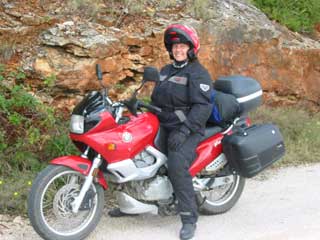
Thursday, July 4 we dropped the motorcycles off for shipment at Air Canada Cargo at the Calgary International Airport. Basically it was a matter of riding them into the warehouse and then having the Dangerous Goods specialist check them over. The gas tanks were less than one quarter full and batteries disconnected. We left the bikes there to be loaded into a container and then they would catch the Saturday evening flight to Frankfurt.
Audrey watches as Erwin Arnold prepares her bike for shipment on Air Canada Cargo.

Friday, July 5 Rob and Laura Billington from Regina dropped by with their sidecar outfit. The rear tire was pretty well bald so we jacked up the Honda Goldwing and went to Anderwerks for a new tire. While there Ekke recognised a motorcycle out back and found out that Susan and Grant Johnson were getting some service done on their bike. Susan and Grant are the ones to blame for our year leave of absence. At the BMW MOA National rally held in Missoula in 1998, Susan and Grant gave a seminar on their trip around the world. It was nice to meet them again and make them aware of the consequences of their seminar. They were off to the BMW MOA National Rally in Trenton, Ontario, probably to infect others.
Saturday, was the day that capped off one of the busiest two weeks either of us has ever had. A send off supper was held amidst our final packing and after the SAAB was put into storage. The Air Transat flight left about half an hour early (!) and three movies later we arrived in Frankfurt. Note for tall fellow travellers; legroom is a precious commodity and it would be worth the money to upgrade to the first class section ($150) or try to get an emergency exit seat ($15 advance booking). This must be done very early as we tried to do this when we booked the flight several months in advance but everything was already taken.
Arriving in Germany, love the Smart cars on the trailer!
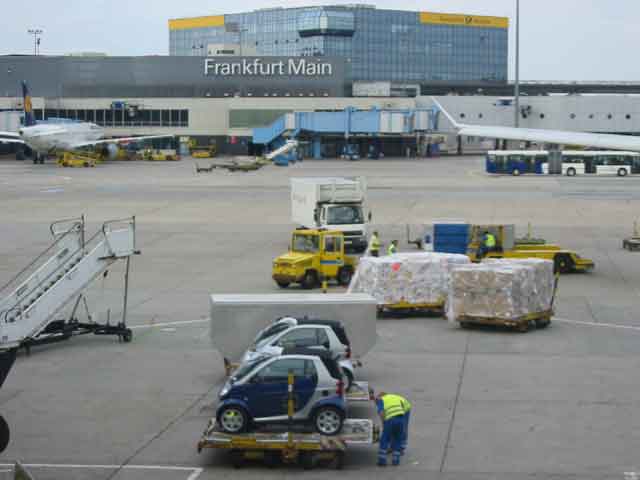
We had reserved a hotel in Frankfurt for two nights so that we could have a base to store our stuff before we could pick up the motorcycles on July 8. The Ibis hotel is located a four minute walk from the Hauptbahnhoff but it was a long walk carrying 30 kilograms of stuff in 27 C heat. Neither of us was used to the humidity so it was quite an exertion. After getting settled we went for a walk around downtown Frankfurt on a Sunday evening. We settled in at the Helium café for a light supper and some people watching. Frankfurt appears to be quite wealthy judging by the Porsches and Mercedes driving by.
A nice walk of about seven kilometres led to a BMW motorcycle dealership where a speedometer was waiting for Ekke’s bike. The old odometer had broken this Spring and based on recommendations from the BMW Tech mailing list was sent to Overseas Speedometer in May. Rick Borth estimated a three to four week turnaround time, leaving plenty of time to get the unit back from Austin, Texas before the bikes were shipped to Frankfurt. After four weeks Rick was called and he indicated that he had not started the work yet but would get to it in a couple of weeks. When told that the bikes were being shipped out in a little over two weeks he said he would start it right away. With a few days before the bikes were scheduled to be shipped the speedometer had still not arrived. Rick indicated he had not started it yet and of course now there would be no time to repair it and ship it back to Canada. So a friend in Germany offered to purchase a new speedometer and have it delivered to the Frankfurt BMW dealer. Hence the pleasant walk along the river Main on Monday morning. From there a combination of trains and trams took us to the ADAC (German Autoclub) office to purchase European motorcycle insurance. Back on the train and to the airport to find our bikes at Air Canada Cargo. A simple matter of showing the Customs agent the shipping forms and the insurance cleared our bikes. Back to Air Canada and there were our bikes in a container. Another BMW was sitting on a pallet with a California licence plate. Maybe we’ll meet them on the road somewhere! Since the cargo area is secure we had to clear a gate to get out of the terminal area. Our first ride in Germany included a section of sidewalk to get around the gate! Fuelling the bikes, which were on reserve, was quite a shock. Both bikes came to a total of about 40 Euro. That’s about $60 CDN. Perhaps we’ll be taking the quiet back lanes to keep the speeds down and the fuel economy up!
Uncrating the bikes at the airport

Hotel in Frankfurt
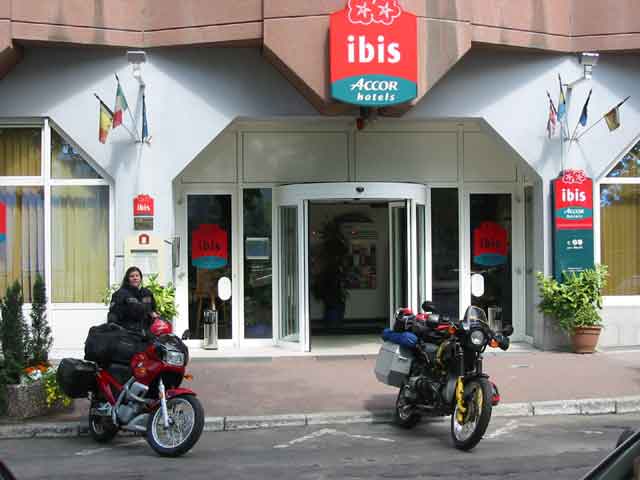
Tuesday, was our first real ride as we went from Frankfurt to Wartenberg, near Munich, a distance of around 400 km. This was done almost completely on the autobahn with only the last few kilometres on the little tiny backroads. Ekke had programmed Audrey’s sister’s house into the GPS back in Canada and it was off by only 10 metres. The 400 km was certainly not like riding back home where you can basically snooze on the highway. Here it was 100% attention at all times watching for trucks and campers going slowly ahead and the big Mercedes and BMWs coming up from behind at warp speed.
A stack of Smart cars

The Gruber's house
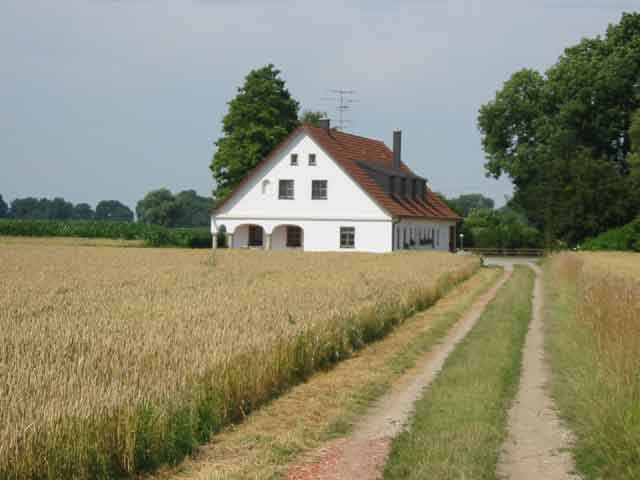
A family photo
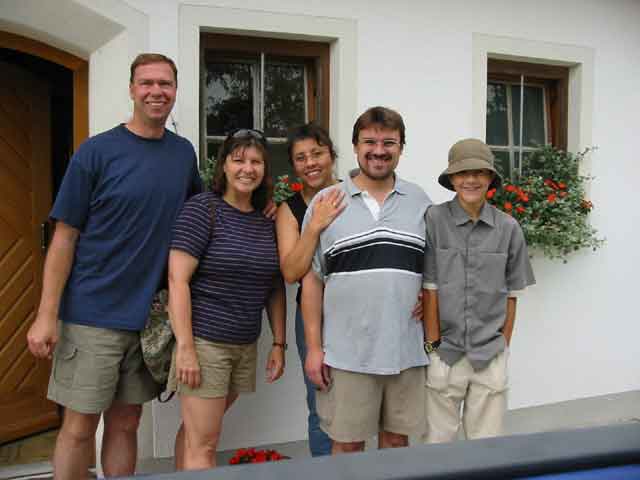
Map of the route from Frankfurt to the Gruber's house
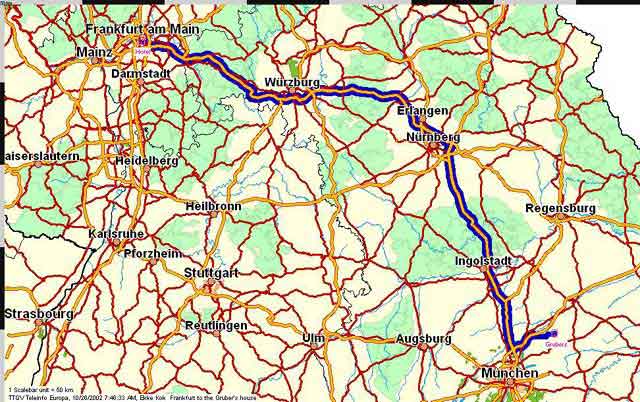
After arriving at the Gruber’s home we spent a couple of days getting organised. It was our first experience trying to get the laptop computer connected to the internet. Since the Gruber’s computer is a MacIntosh we could not copy files via floppy disks and since their phone line is digital we could not connect the laptop’s modem directly either. Eventually we went to a home with an analogue phone line and uploaded what little we had for the web site.
Saturday, 13 July, a barbeque was organised by the SPD political party that Michael belongs to. Fortunately the ideals of the party matched our political ideas so we did not feel too guilty enjoying the party. What incredible kuchen! Even the rain did not dampen the spirits and a good time was had by all. Sunday was an extra special event. The local villages and towns had a trockenfest (spelling?) where people dressed in their period clothing and had a judging and parade. This was strictly a festival put on by the locals for the locals. There were about 5,700 people participating in the event and I think we were the only tourists in the town of Dorfen that day. After the parade we went to Markus and Martine’s home for kuchen and kaffee.
Michael at the trockenfest in Dorfen
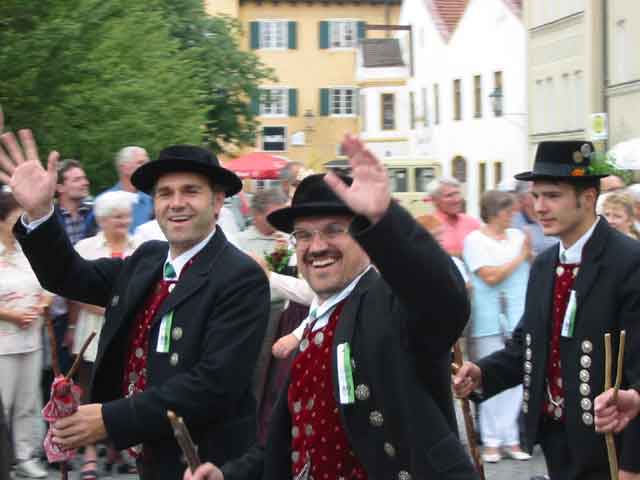
We had decided that a cell phone would be a good thing to have in case of an emergency or even to make local phone calls for reservations and such. Even if we got separated then the one without the phone could go to a pay phone and call the cell phone. So Monday was spent searching out a phone (or Handy as they are called here). The phone would be in stock the next day so we stayed another night with the Gruber’s and enjoyed their hospitality. Tuesday we picked up the Handy in Munich and then headed southeast in the direction of Hallstatt in Austria. Well, distances in Europe are definitely longer compared to Canada. We didn’t make it to Hallstatt but into southern Bavaria to Berchtesgaden, where we camped at Campingpalz Muhlleiten near the Konigssee. The next day we walked into Berchtesgaden and then to the Salzbergwerks salt mine. What an interesting tour. First we had to dress in miner’s clothes, a heavy cotton shirt and pants that went over our street clothes as well as a little leather apron. We took a train into the heart of the mountain and then a wooden slide (just two smooth rails) further down. It even included a ride on a boat across a brine pond deep underground. Fortunately the tour also included some English translations of the tour guide’s talk.
Thursday, 18 July, we broke camp and headed south to Zell am See in Austria. The route leaving Konigssee took an old pass road not much wider than a car and had almost no traffic on it. This was the kind of riding we were here to do. Connecting up with the main road south got us back into the traffic and also a few spells of rain. The crossing into Austria was a non-event and Ekke had to do a U-turn to find a welcome to Austria sign to take a picture. Seecamp was a beautiful campground on the lake but the ground was very hard. For some reason we did not pack a hammer (we brought everything else though!) and a fellow camper brought one over for us to borrow. We must look like we brought everything because while we were camped there everyone came to us and asked if we had a hammer they could borrow.
From the campground at Zell am See
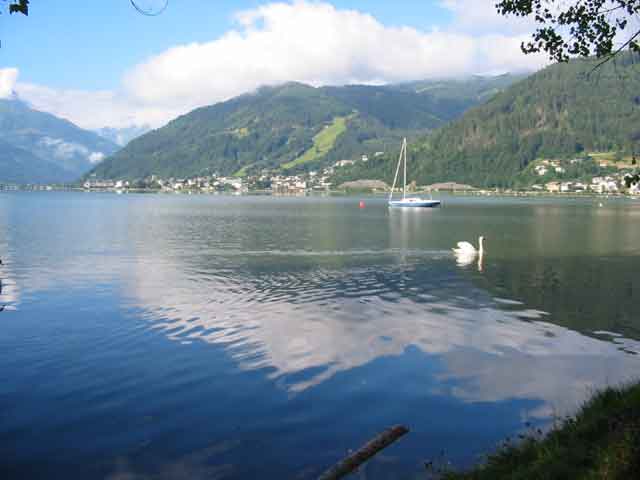
Finally, the first real ride in the Alps. We rode to the Grossglockner pass on Friday and it was spectacular, tight twisting roads, cobblestones and even jig-jags. At the high altitudes the bikes ran a little rough but still had enough power to blitz past cars. The drivers actually expect you to pass on a motorcycle and will move over a little. Soon we were passing in places that we would never have dreamed of back home. Then just for a little exercise we hiked down to the glacier at Franz-Joseph Hohe and back up again. Good thing we had fortified ourselves with a hearty lunch at the restaurant first.
At the top of Edelweiss Spitz

Audrey riding down from the Eidelweiss Spitz
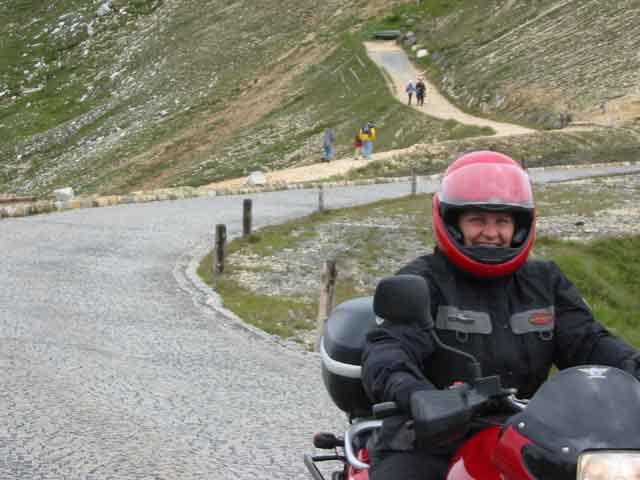
A hairpin on cobblestone road on the Grossglockner Pass
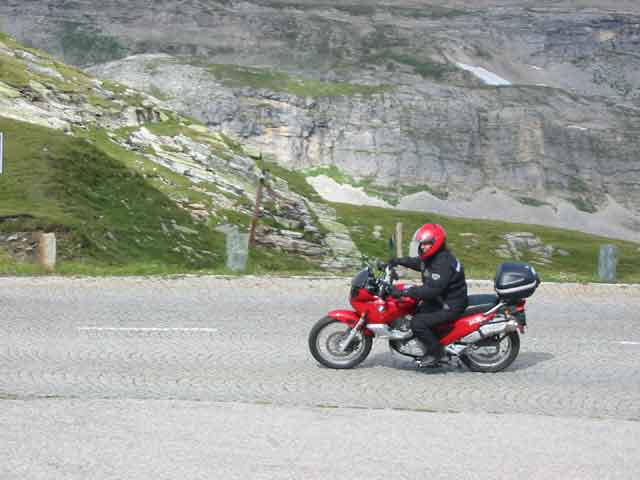
Our next base of operations was at Innsbruck. We went over the Gerlos Pass to get there from Zell am See. The campground at Kranebitten (just west of Innsbruck) was quite nice and we picked out a nice shady spot. The restaurant at the campground had an internet computer set up but they would not let us use a floppy disk to transfer stuff from the laptop and the internet software they had did not allow us to access our bank accounts either.
We enjoyed a nice walk through the city of Innsbruck and had the pleasure of watching and listening to a concert played under the Golden Roof while we were up in the Rathaus tower. One of the services provided by the tourism bureau of Innsbruck is a free guided hike. So one day we met the bus in downtown Innsbruck and rode up to the site of the 1964 and 1976 Olympic downhill skiing events. The guide led us over a small pass to a lovely café and then down to a little town on the other side where the bus came to pick us up. A great hike, except that the guide lost half the group (our half) when he took a shortcut with the other half. Our half waited for a half an hour for the slowpokes but they never showed up. So eventually we started hiking on our own and fortunately ended up in the village where the guide was waiting.
Musicians under the Golden Roof
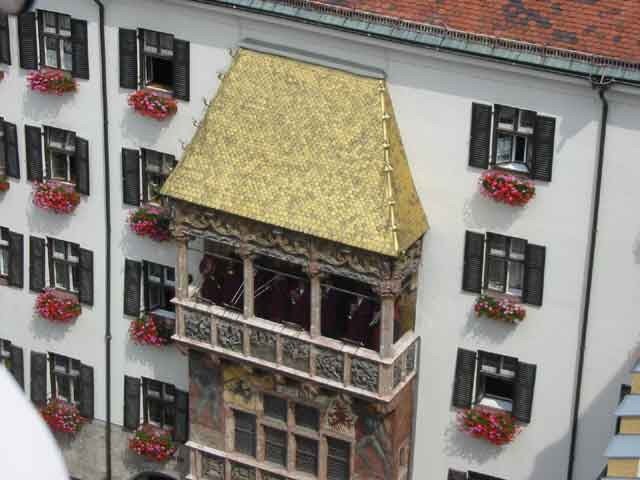
On the hike before the guide left us
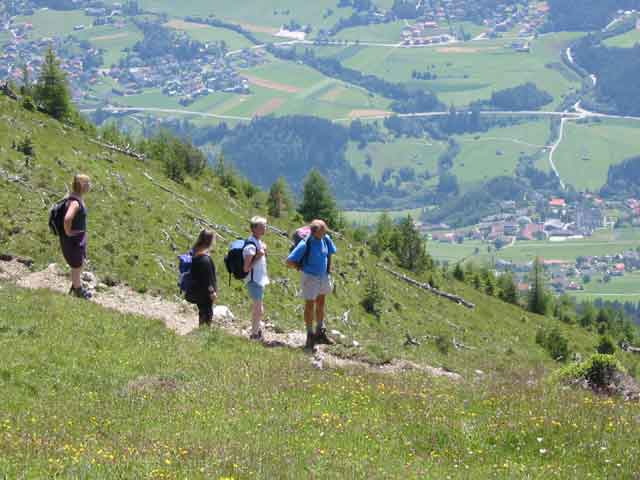
From Wartenberg to Innsbruck
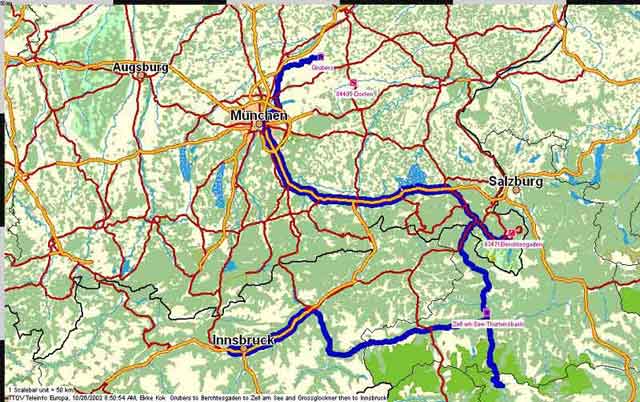
Europa Bridge leading to the Brenner Pass
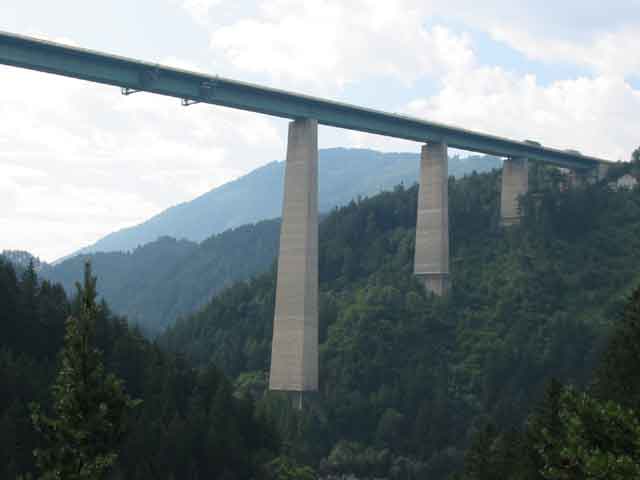
La Baita Campground in Sarnonico, Italy
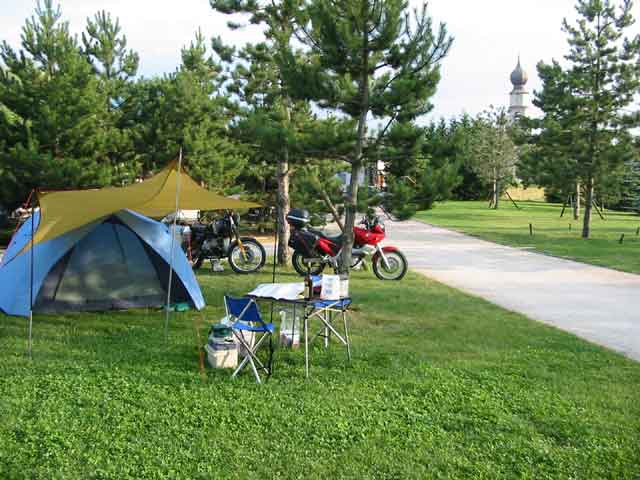
Our first day trip started north over the Gampenjoch and looped back south towards Revo. Halfway to Revo we stopped behind a line of trucks but the police officer at the front waved us on. They had stopped traffic for a bicycle race but must have decided that we were OK on the motorcycles. What fun and probably the only bicycle race we’ve come close to winning! Those bikes are tough to see in the unlit tunnels though. Turning off from the bicycle race we ended up on a one lane pass with almost no traffic on it and stopped for lunch beside a mountain stream. Further south we looped around on Passo Campo Carlo Magno back to camp.
Lunch at a quiet spot
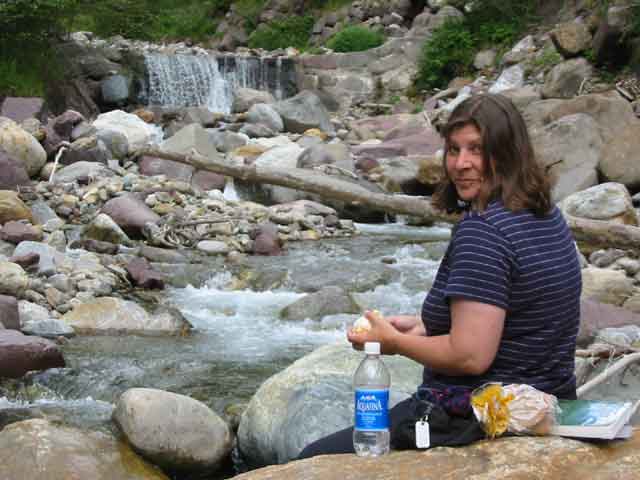
Ekke took a day trip by himself into the Dolomites and did nothing but ride, catching about half a dozen passes. The goal of the trip was just at the southern point of the Dolomites, about 90 kilometres north of Venice, where the road came down from the Passo di San Boldo with hairpins put inside tunnels. The road was so narrow that traffic signals allow one-way traffic up and then down the pass. Pretty audacious. A ride back through wine country ended up back at camp at about 1800. A 10.5 hour ride and only about 470 kilometres with no lunch break. An average speed of less than 50 kilometres per hour doesn’t seem like much to brag about but it sure was hard riding, with all those twists and turns. An interesting thing happened on the way back. Riding along there was a rather scantily clad young lady standing beside the road, near a vineyard. Ekke thought, “She’ll have no trouble catching a ride.” A couple of kilometres later was another young lady. Hmmm, what a coincidence seeing two attractive young female hitchhikers. Getting directions from an apple orchard farmer it turns out that they’re prostitutes.
After a nice quiet Saturday at camp we went for a daytrip to Lago di Garda. The Hotel Paridiso is perched on the edge of a cliff about 300 metres above the lake with a deck cantilevered out into space. What a spectacular view and the sundaes were great too! An attempt to ride Passo di Tremalzo didn’t go through as the road has been closed to motorcycles. This pass has been used to test the GS model BMWs so it was probably a good thing that it was closed. Ekke rode to Passo Nota though before a mountain biker said that the road was closed to motorcycles from there on. On the ride back we found that self serve gas stations don’t accept our Canadian credit cards and without an attendant on duty we couldn’t get gas. A nice slow ride to find a full serve station that was open got us some gas.
At the top of Passo di Rolle

Stacked switchbacks

Monday was a ride deep into the Dolomites towards Cortina where a number of passes are nicely arranged in a figure eight. By the time we got there though it was getting late in the day and we only did half of the figure eight. The Sella pass has some sheer cliffs that are apparently quite famous for climbers. Again a bicycle race took place on the road so we pulled over and had a nice lunch while watching the bikes whiz by downhill. With all the switchbacks our hands became quite tired going downhill using the brake and clutch so much. About then the starter motor quit on Ekke’s bike and it had to be push started a couple of times to get back to camp. A friend in Germany, Peter Aufderheide, who also helped with getting the speedometer for Ekke’s bike at the beginning of the trip, came into action again. He knew the dealership in Bolzano, only 34 kilometres away from Sarnonico. He also had a great tip: the showroom and service area are separate so don’t shut off the motor when you get to the shop. Sure enough, we were at the showroom and were given directions to the service centre, three kilometres away. In the Italian sunshine it wouldn’t be much fun push starting a 230 kilogram motorcycle so Ekke was happy that he had left the motor running. The foreman at the service shop said that they couldn’t do anything because he had a mechanic on vacation and they were very busy. Finally the service manager suggested we go to a café for a half an hour and he would see if he could find the problem. A nice cappuccino later they had found the problem with a failed relay and for 52 Euros we were on our way, on our way to Merano for a little sightseeing in the afternoon. What a beautiful small city with a commanding view of the valleys that converge there. A climb up the Pulverturm (for free!) was quite rewarding. Wednesday was a quiet day (we’re getting used to these quiet days!) in preparation for picking up camp and heading towards St. Moritz.
Innsbruck to Sarnonico and area of day rides

The ride through the orchards of Val di Non was beautiful to Passo del Tonale where we stopped for a cappuccino. For some reason the road signs had been pointing to this pass for about 60 kilometres but it wasn’t very spectacular. Perhaps it is more of a ski resort as there were a lot of ugly, modern apartment buildings that might be used as vacation condos. A few nice glaciers made the ride more pleasant. A ruin of an ancient fort would have been nice to stop at and investigate but it was not well signed and parking was just at the side of the road. We’ll have to come back for that!
We were really made to feel welcome in Switzerland with the flags flying and the fireworks celebrating Swiss National Day on August 1. Arriving in the afternoon at St. Moritz we headed for the Olympiaschantz campground, situated near the ski jumping facility from the Olympics. Walking into town to do the grocery shopping we found the stores closed for the holiday so we looked for an affordable restaurant. In St. Moritz? Not a chance. We got off fairly well paying about 35 Swiss Francs (about $34) for couple of personal pizzas and a couple of drinks at a little pizza joint. At this time it started to rain really heavily so we got a little wet on the walk back to camp but we were worried about the tent. We need not have worried though as everything was still nice and dry inside and under the awning.
Friday, Ekke rode the Maloja Pass, the Splugen Pass and the Albula Pass roads in a 180 kilometre loop. The switchbacks on the Splugen Pass on the Italian side were so tight that there really was no inside radius; they just came to a point. A few snowsheds and tunnels, with some switchbacks inside the tunnels, led to the top of a windswept pass. The houses were really sturdy with slate roofs. The roads on the Swiss side were in much better condition but the switchbacks were layered five or six deep at times. The Albula Pass was very rough pavement, which was quite a surprise since all the Swiss roads had been excellent up to this point. The railroad trestles for the Glacier Express train were quite impressive.
3 August we headed for the famous Stelvio Pass, first back south over the Bernina Pass and then after the pass, left into Italy and the Val di Livigno. Two more passes led to Bormio from where we could tackle the Stelvio. The ascent out of Bormio was fairly gradual at first but after we enjoyed a picnic lunch the climb steepened with an increasing number of switchbacks. A cappuccino at the top (2757 metres) was followed by a steep descent with 44 switchbacks. Our hands were tired from using the clutch and brake levers coming down that hill. It was so steep that a bicyclist kept up with us going down the hill (and looked like he was going to pass a couple of times). Returning to St. Moritz we went through a Swiss National Forest where there was finally a place without a house perched on every piece of land, very refreshing.
Cappucino at the top of Stelvio Pass

Sunday morning we had a leisurely breakfast of French Toast (would they just call it toast in France?), fried eggs, yoghurt, orange juice and coffee/tea. Being suitable fortified we went for a hike. From St. Moritz we hiked via the Heidi Hutte (the one used for the 1977 movie) to the midway station of the cogwheel train where we caught the train up to Corviglia, at an elevation of about 2500 metres. Because of the FIS World Cup ski championships being held on the hill in 2003 there was a lot of work going on and we could not hike to the top of Piz Nair. Instead, we went to Suvretta Pass and then back down to St. Moritz with an elevation drop of about 900 metres.
Hiking to Suvretta Pass
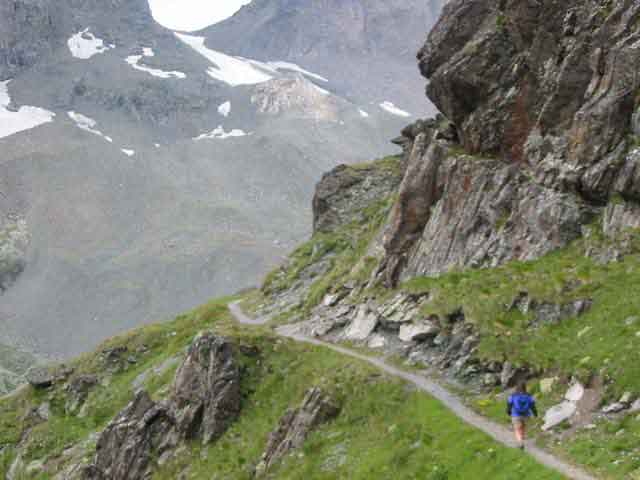
A peaceful moment before they started chasing us
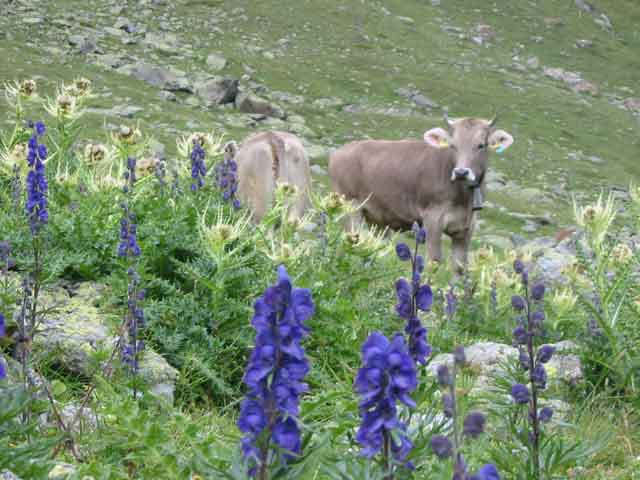
Packing up the next day, we went to Andermatt via the Julier Pass, Lenzerheide and the Oberalppass. The Oberalppass had some excellent sweeping corners with switchbacks dropping right down into Andermatt. We were not sure if there was a campground in Andermatt but we found one under the Gemsstock cable car. The tenting area was on the other side of the road leading out of town so we had to cross the road to use the showers but it was a nice spot and reasonably priced (about 10 Francs less than St. Moritz). With rain and fog the next day we decided to spend a quiet day in Andermatt so on Wednesday we rode some passes. Since it was still foggy and spitting rain we decided to ride passes that were not as well known for their scenery; Gotthard, Nufenen and back on the Furka pass. The Rhone Glacier was shrouded in fog so we did not pay to go into the Glacier.
Camp at Andermatt
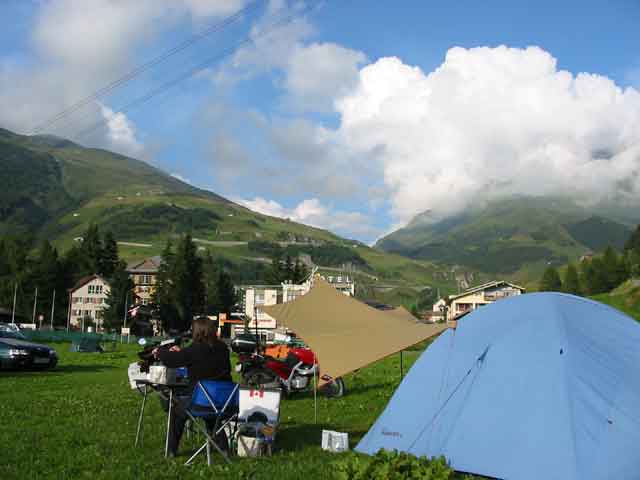
Thursday we rode what must be the most spectacular loop we have ever ridden, it was only about 110 kilometres over the Furka, Grimsel and Susten passes but it took all day. Going over the Furka pass we went the other direction from the day before to the Rhone Glacier (headwaters of the Rhone river which empties into the Mediterranean). For 5 Francs we could then go inside the glacier. What an experience to be inside that blue cave. We were glad that we had kept our waterproof motorcycle clothing on as it was rather chilly with ice water dripping from the ceiling. Going up the Grimsel pass we were passed by a bright yellow Buell motorcycle, which gathered quite a crowd at the top of the pass with everyone checking out the exotic machine, even the people from a tour bus checked it out. From the top of the Grimsel a one-way road (controlled by a stop light) led to a glacier 7 kilometres up the mountain. Those little stone blocks on the side of the road probably would not help much if you lost control and skidded off the road. It was about 300 metres straight down to Grimselsee. The Susten Pass road was another spectacular ride leading up to the pass surrounded by glaciers. By the time we started the descent we were on sensory overload so we took it easy down and then back up the Schollenen gorge to Andermatt. We will need to do that loop again just because it was so spectacular and because of the overload we must have missed some things. Maybe one loop for riding and then again for enjoying the scenery?
Descending the Gotthard Pass on the old road, watch the dropoff!
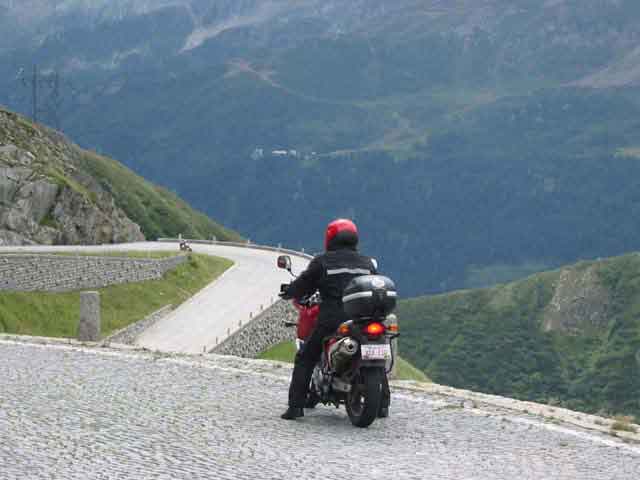
Furka pass on the left and the Grimsel pass on the right
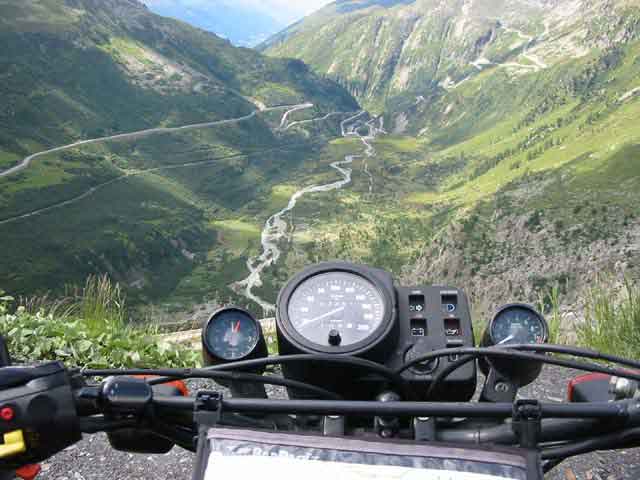
Inside the Rhone Glacier
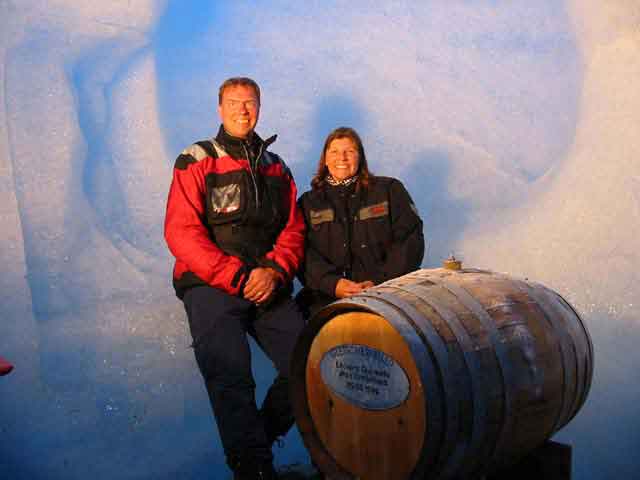
Oberaarsee road
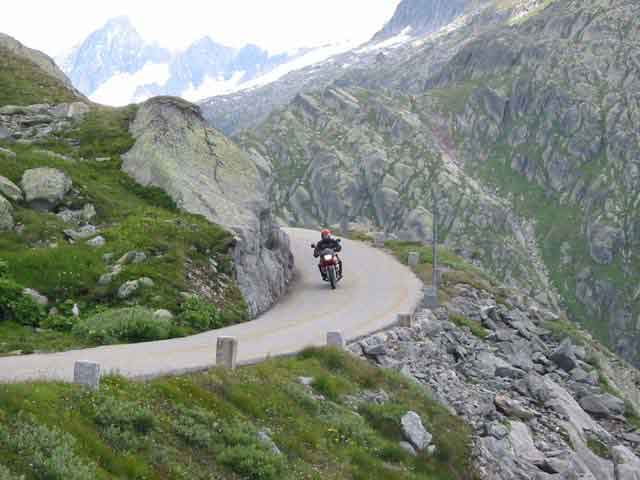
Susten Pass
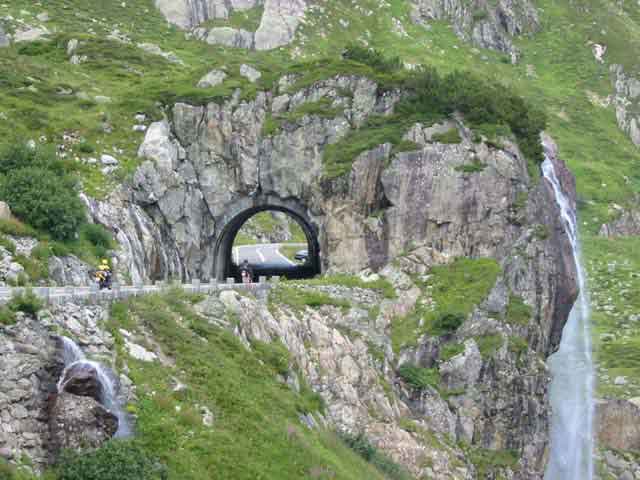
Sarnonico to St. Moritz to Andermatt

The next day the weather had still not improved, with continuous rain over the night, so it made sense to go swimming. The Switzerland Holiday Park provided an indoor pool and spa to entertain ourselves along with a waterslide and outdoor pool. We all came out of that nice and clean and of course a nice rinse in the rain afterwards. By the next day it still had not cleared up but the rain had petered out. We decided to go to the top of Pilatus, a mountain peak south of Lucerne that can be reached by cogwheel train (the steepest cogwheel train in the world at 48%) or via gondola and cable car. In our 1996 visit Ekke could not get himself down the cable car from the top because of his fear of heights so we worked out a plan that would see Ekke not using the cable car. At the top of the gondola there was a rodelbahn (basically a slide down the mountain on a sled) that looked like a lot of fun but because of the rain it was closed. So with a little cajoling Ekke was encouraged to ride the cable car up to Pilatus. It was frightening but Ekke just imagined that the swaying cable car was riding a metre above a nice grassy field and did not open his eyes. Unfortunately, Pilatus was stuck in the clouds and so the views were not very good. So Michael and Andrew headed down the cogwheel train while Audrey and Ekke stayed up in the clouds a little longer. The clouds parted a little to reveal an amazing view of the Vierwaldstattersee (so named because of the four forest cantons on the lake) but Michael and Andrew were enjoying delicious ice cream sundaes down below in compensation.
Michael and Andrew packed up on Tuesday morning and we toured the city of Lucerne. The lion monument honours the Swiss who fought in the French revolution and appears much larger in person than the photos show it to be. The medieval city wall still stands and we toured the wall and three of the towers on the wall. One of the towers had a clock in it and it was interesting to climb the stairs beside the moving clock mechanisms with the large swinging pendulum stopping only millimetres from the railing. The final tower provided a fine open-air view of the city where we could see that the Reuss river was very high from the recent rains. When we walked down to the Spreuerbrucke there were a couple of kayakers and a surfer playing in the fast flowing water on a standing wave.
Kappellbrucke in Lucern
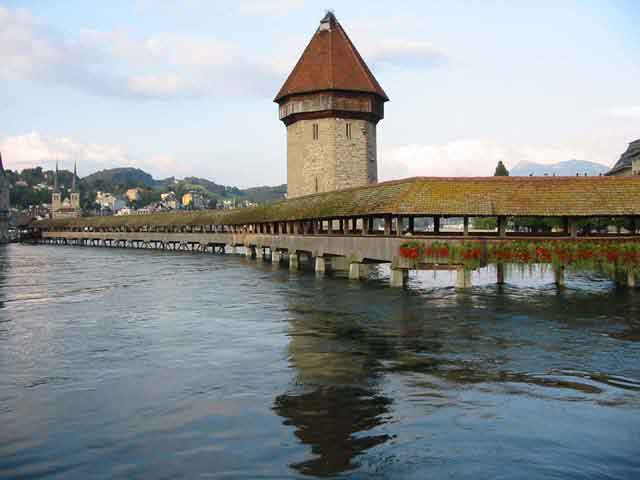
Spreuerbrucke from the watch tower
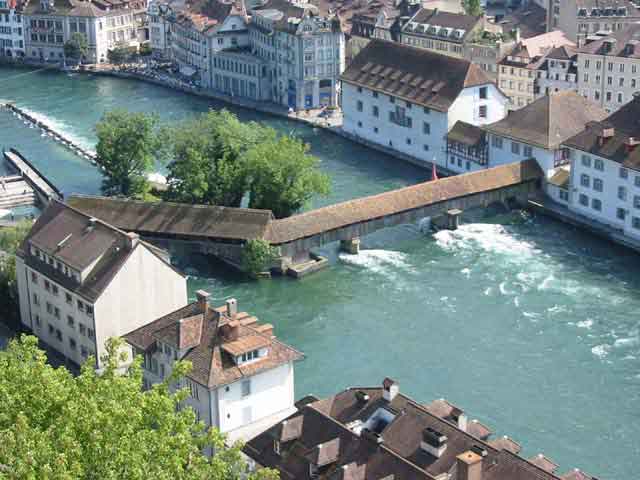
On 14 August, in beautiful sunshine, we also packed up from Camp Lido and headed south over the Brunig Pass to Interlaken, which is situated between the Thunersee and Briensersee. We had done the Brunig pass in the other direction on our 1996 bicycle trip and it was much easier on the motorcycles. After a bit of riding around Interlaken we found Jungfrau Camp and unlike our last trip we had a spectacular view of the Eiger, Monch and Jungfrau mountains from our tent. That evening a fellow motorcyclist, riding a BMW F650GS Dakar, camped beside us. He was from Newcastle in England so it was nice to speak English with a stranger! It turns out that David was planning to head to Greece so we made rough plans to meet again there. The next day David went on a mission into Interlaken to find the exact spot that a photo from his parent’s honeymoon had been taken (he was successful and found a postcard from the same spot). We walked around Interlaken watching the paragliders. That evening we attended an open-air William Tell theatre show. The show was excellent but we were glad that we had picked up a summary of the play that happened to have a short description of each scene in English. It was the story of how the three cantons joined together and stood up to their Austrian dictators. Especially impressive was the display of horsemanship as the actors rode through the set and William Tell’s marksmanship as he shot the apple off his son’s head.
View from the tent at Interlaken
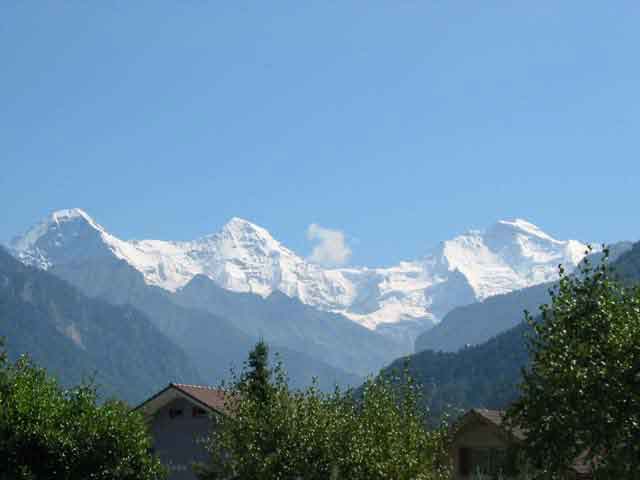
On Friday David packed up and headed south and we secured our motorcycles and all of our gear at the campground. Then we took the train from Interlaken to Meiringen, arriving at about 12:30 to start our holiday within a holiday. We planned to hike from Meiringen to Adelboden in about a week, staying at mountain hotels along the way. The route was laid out to cross the Grosse Scheidegg into Grindelwald and then over the Kleine Scheidegg into the Lauterbrunnen valley. A beautiful 100 year old funicular took us up several hundred metres to the Reichenbach Falls where the fictional Sherlock Holmes met his demise. A short lunch break and then we started hiking towards the top of the Grosse Scheidegg. Five hours later we had gained 1120 metres and reached Berghotel Grosse Scheidegg. The walk was mostly in the forest and usually quite a gentle grade. Upon reaching the summit of the pass we were greeted by a wonderful view of the Eiger and Grindelwald in the valley. There was room in the massenlager (a dorm), which was fortunate since the berghotel was the only place to stay within an hour’s walk. After cleaning up we had a delicious supper and watched the finish of a bicycle race at the top of the pass. The restaurant was soon full of bicycle racers as they had their award ceremonies and enjoyed a drink.
The Eiger from Grosse Scheidegg
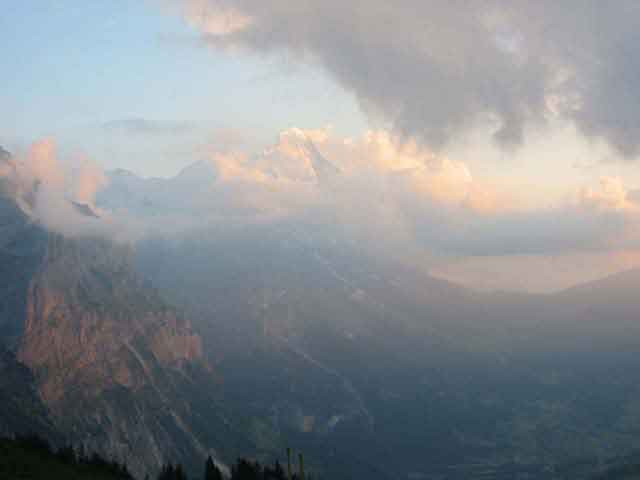
The next day, across the Grindelwald valley we could see the day’s destination; the Kleine Scheidegg. Breakfast is typically included in the price at berghotels so we ate enough to keep us going for a few hours. The breakfasts usually consisted of a choice of breads, cheeses, jams and then coffee and orange juice. Another bicycle race came down the pass as we walked to Grindelwald, dropping about 1 kilometre in elevation. Going up the Grosse Scheidegg and then down we were accompanied by the three-tone sound of the Post Bus horn as it honked whenever approaching a blind corner. The theory is that if you are driving and hear that horn you should get out of the way. No Post Bus went up the Kleine Scheidegg, so it was a little quieter. By 16:00 we had arrived at Berghaus Alpiglen, about 600 metres above Grindelwald and still a couple of hours from the summit of the Kleine Scheidegg so we took a break to assess the situation. The clear blue skies were great for enjoying the view of the north face of the Eiger while we hiked but it also meant we had a hot, tiring walk. So we used the Handy to phone the hotel at the top of the pass to inquire about room/massenlager availability and prices. It turned out that the rooms were all gone and the massenlager was 3 francs per person more than a room at Berghaus Alpiglen, so we stayed at the Berghaus. What a cozy room!
Walking into Grindelwald
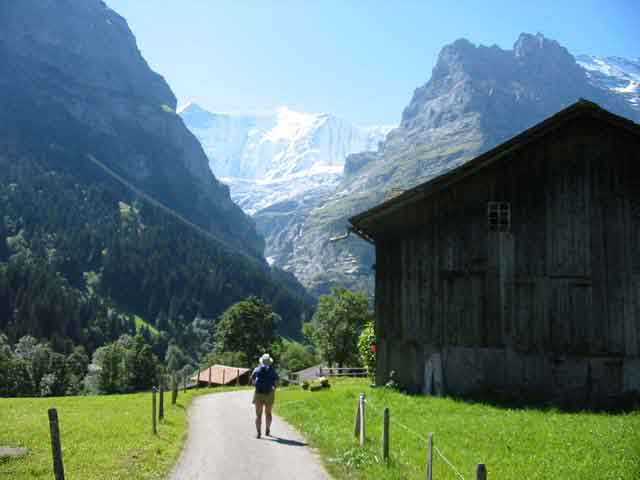
View from our room at Alpiglen looking over Grindelwald towards the Grosse Scheidegg
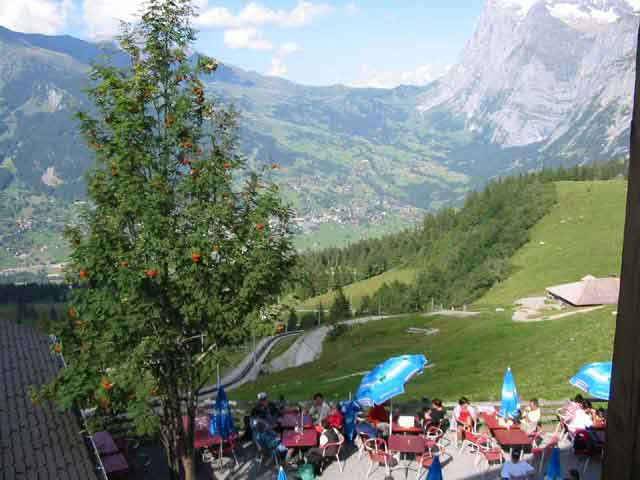
Rather than walking 2 hours to the top of the Kleine Scheidegg before boarding the special train to the Jungfraujoch we took a train from Alpiglen. The time was better spent on top of the mountain, especially while the clear blue skies prevailed. Words cannot describe how spectacular the view from the top of the Sphinx was. Even the pictures don’t do it justice. It is amazing that someone built not only the structures in such a hostile place but that a train runs up to it. The train runs through the Eiger (stopping inside for a quick view out of the north face and also the glacier) and then through the Monch to the saddle between the Monch and Jungfrau. We walked over to the Monchjochhutte crossing the glacier on a well-travelled path. People were going on glacier walks, dog-sledding and skiing, while others were climbing the surrounding peaks. Despite the number of people it was very beautiful. Taking the train back down to the Kleine Scheidegg we started our daily hike at about 4 PM, down towards Wengen, a drop of about 800 metres. Thank goodness the Edelweiss hotel was too expensive; otherwise Audrey would have been singing the song from The Sound of Music all night long. So the Baren (bears) Hotel worked out perfectly. Wengen is perched on top of a cliff overlooking the Lauterbrunnen valley and the only access for visitors is by walking up or by train. The town is car-free. :( It turns out that Wengen was started as a ski resort by the British, rather than the Swiss. That must explain the reason for the large number of British people we saw.
Alpiglen as seen from the North Face of the Eiger
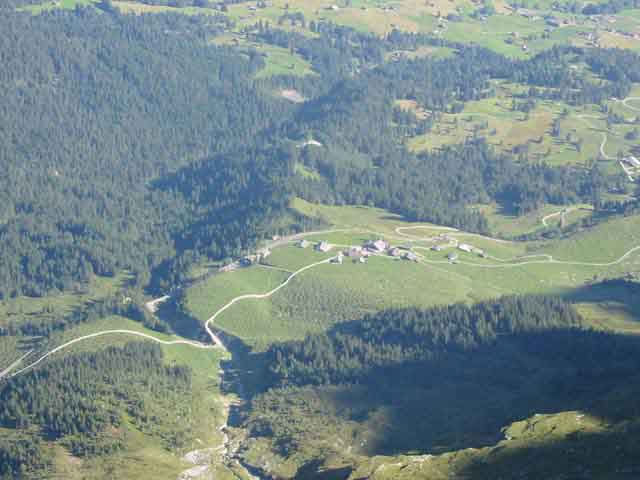
Eiger Glacier
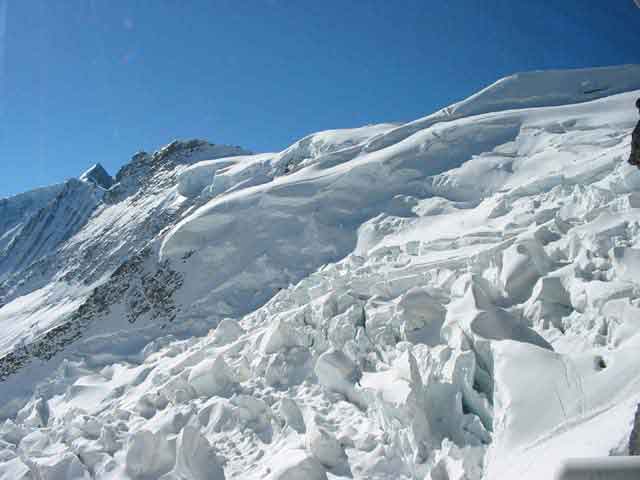
Glacier walk to Monchjoch Hutte
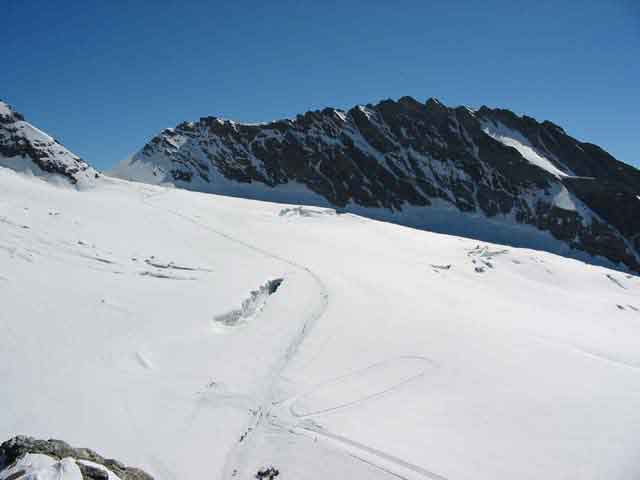
At the top of Europe on the Sphinx
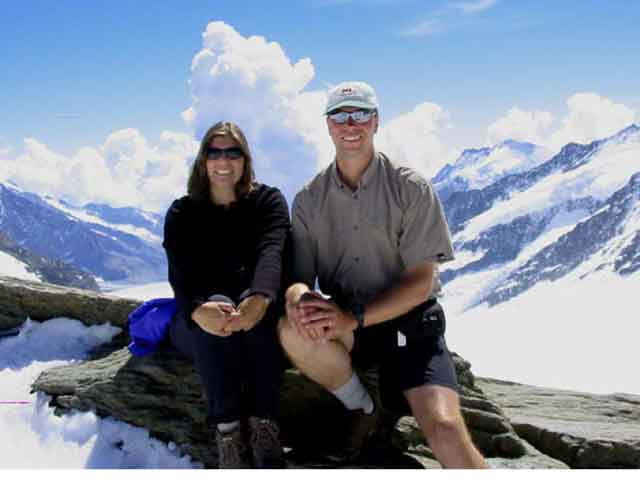
Looking down at the Lauterbrunnen valley from the Sphinx
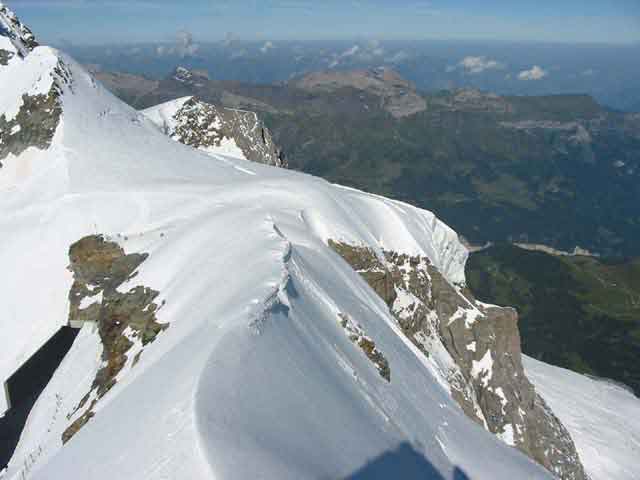
Looking back at the Monch

The hike took us across the Lauterbrunnen valley the next day, but with its steep cliffs we decided to take the funicular up the other side, gaining over 700 metres in just a few minutes. Then it was an almost level walk to Murren and a 300 metre drop down to Gimmelwald of Rick Steves’ fame. Unfortunately, the quaint little village was overrun by people who had watched Rick’s show (we missed him by two weeks) and everyone was speaking American rather than German. Even though it was getting late, we decided to leave Gimmelwald and head up the mountain towards the Seffinenfurgge, a pass at an elevation of about 2600 metres. An hour brought us to Spielbodenalp, a rustic berghotel on a farm. No electricity and no running water. We were the only guests and were served a nice supper outside.
Descending from Wengen a nice view of the Staubbachfalls
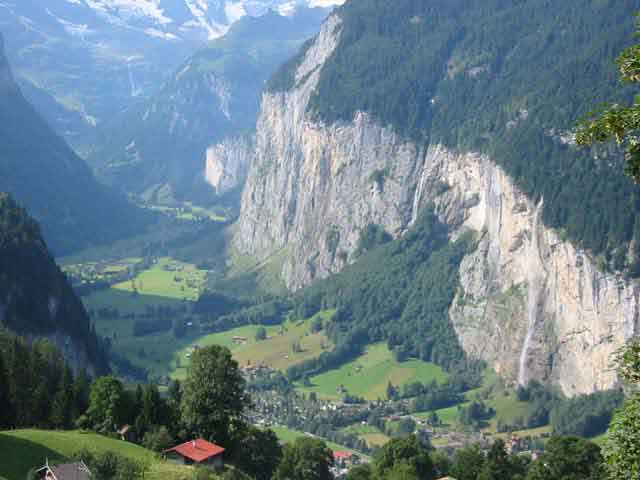
View from Spielbodenalp

The next day started with a very steep climb above Spielbodenalp. The switchbacks up the trail were sometimes rather exposed with the drop into the Lauterbrunnen valley being several hundred metres. If you slipped, your clothes would be out of style by the time you hit bottom! Fortunately after the initial height gain of two or three hundred metres it was then a comfortably level stroll to the Rotstockehutte where we stopped for a coffee break. From there the trail steepened gradually until the summit of the Seffinenfurgge where the trail was very steep on loose talus slopes. Looking over the top was not very confidence-inspiring as cables and steps were attached to the mountain to aid in the descent. After a lunch break we tackled the other side and it was not as bad as it looked. The weather started getting worse and by the time we got to the next alp hut Audrey had her rain jacket on. The rain really started to come down while we were enjoying a refreshment and all of a sudden a roaring sound could be heard, like a jet airplane flying overhead. We all went outside to find that the burbling brook had turned into a raging, black torrent the same colour as the rock of the pass. As the trail crossed the creek at that point, we were trapped until the water subsided, about an hour. Quite an adventure! We finally made it down to Griesalp where we stayed at the Nature’s Friend Hostel. The owner prepared a delicious set menu of cream of tomato soup, calf steak with buttered noodles followed by a fruit salad for dessert. We had an entire dorm to ourselves but because the hostel was listing rather heavily down the slope we did not sleep all that well. In the morning the owner explained that when he had purchased the property the building was listing by 35 centimetres and he had levelled it quite a bit. Unfortunately the morning was foggy so we decided to curtail the hike since we had no desire to climb the next pass and not be able to see anything. Besides we had experienced a wide cross-section of Swiss hiking, from the crowded, touristy areas around the Jungfrau to the rustic Spielbodenalp. The steepest Post Bus route in Switzerland (28%) brought us down to the train station where we caught a train to Interlaken to end our holiday within a holiday. Strangely enough, we were both looking forward to sleeping in our own beds again, in the tent!
Hiking towards the Rotstocke Hutte
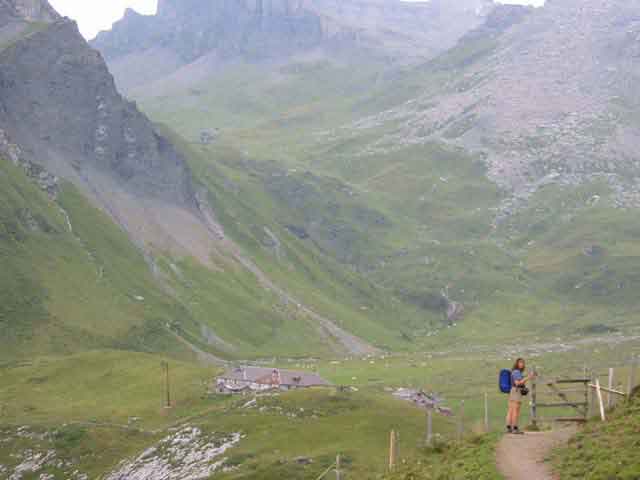
Andermatt to Luzern and Interlaken. Some hiking points shown as well.
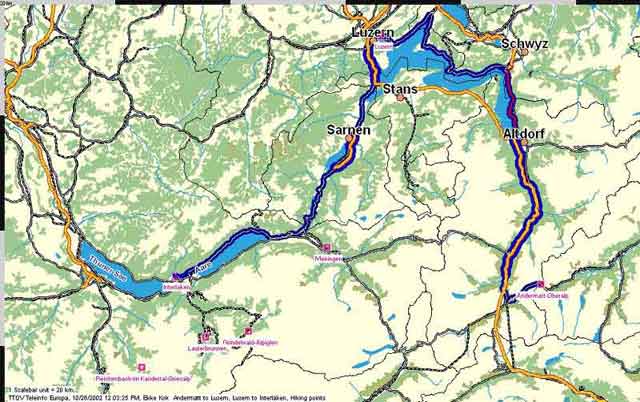
After a picnic lunch overlooking Bern we pulled into Camp Eichholz, adjacent to the Aare river. A walk along the river to Bern found many people floating down the Aare and then walking back upriver along the paved pathway to jump in again. Apparently on a truly hot day the river is jammed with swimmers. Later that evening a Japanese motorcyclist pulled in on a Honda XR400 piled to the rafters with stuff. He had shipped his bike to Russia and ridden across Siberia, with a side trip to Mongolia, then up to Nord Kapp in Norway and down through Europe. He too plans to be in Morocco in January so we exchanged e-mail addresses and hope to meet him there.
Hideki at Bern campground
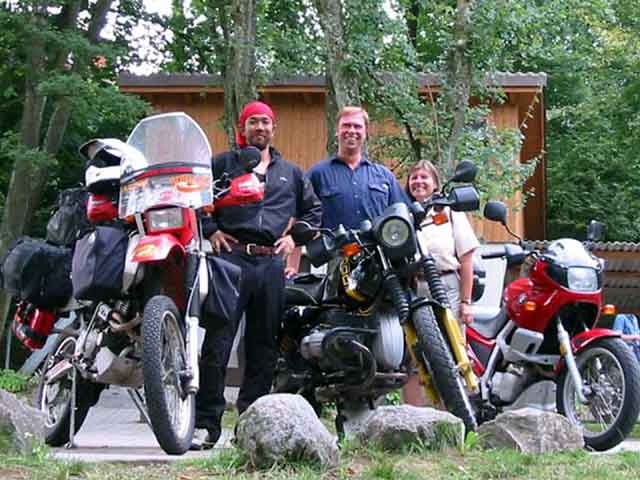
A walking tour of Bern on Friday showed us the old city, with its many fountains. The parliament buildings were having a 100 year anniversary so there was a line of people waiting to get in. We decided to skip it. Up from the old city centre are the rose gardens where we walked to next. The gardens were beautiful with some of the beds dating back to the 1930s. The gardens were started in the seventeen hundreds. Back down the hill led us to the famous Bear Pit of Bern. This pit also dates back hundreds of years. The legend is that one of the founding fathers of Bern was on a hunt and killed a bear. The city has been named in honour of that event and the bear pit is some kind of tribute to this. To be honest, the sight of the bears begging for scraps of food from the tourists was rather sad, especially when we know how magnificent and frightening these creatures are back at home.
Berchtold Herzog von ze Ringen Fountain
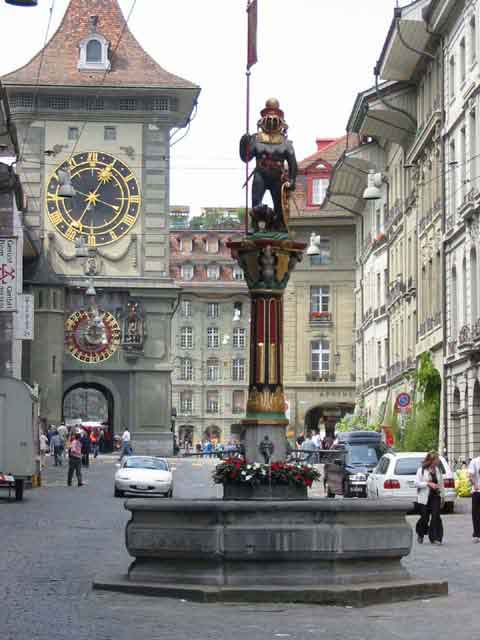
The Bear Pit in Bern
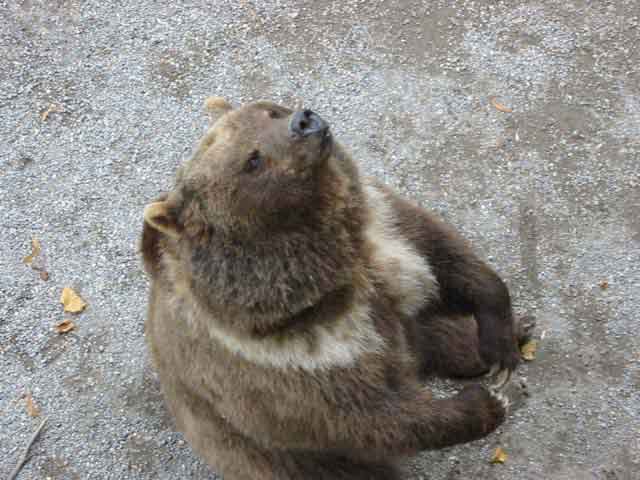
Rose garden is a couple of hundred years old
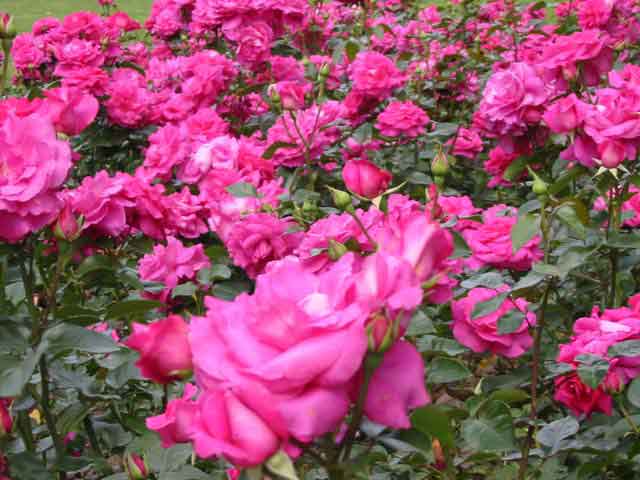
The next morning prior to packing up Ekke decided to emulate the local custom and go for a dip in the Aare. While the waters were not too cold, the current was quite strong. Very invigorating! We rode to Wettingen, north of Zurich, to visit Audrey's relatives; Martha and her sons Stephan and Martin. Stephan phoned the Zurich BMW dealer recommended by Thun Motocenter but it turned out that they were a financial services centre and closed on Saturday anyway. So Ekke and Stephan jumped into Stephan's Smart car to take a quick look at the local BMW dealer. They closed at 1600 (with Ekke and Stephan arriving at 1640) but the shop owner was out back. He led them inside and sure enough had a repair kit in stock. All that was necessary to repair the helmet now was a special Torx screwdriver…
Martha took us to Baden, just north of Wettingen, to visit the famous baths on Sunday morning, very relaxing and probably especially nice after a cold, wet motorcycle ride. Fortunately, the weather was nice and we had a great tour of Baden, the town, in the afternoon with its ruined castle on a hilltop. Monday saw Martha taking us to Zurich for another tour, first stopping at Audrey's grandmother's grave. She was a wonderful tour guide, knowing all the interesting places to see and some of the stories surrounding the sights. After Martin met us for lunch at the train station we went up to the Lindenplatz which allowed us extensive views of the city, including Grossmunster Cathedral and the medieval town below. None of the interesting places had a Torx screwdriver in the right size though. The day finished with a relaxing boat tour of the Zurichsee.
With Martha on top of a ruined castle in Baden
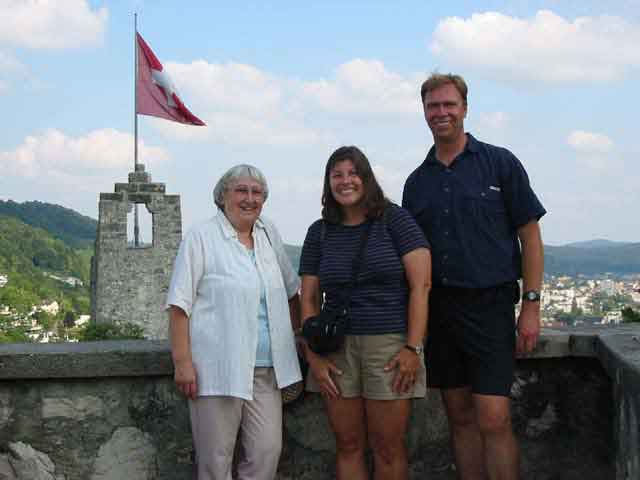
Grossmunster Cathedral in Zurich
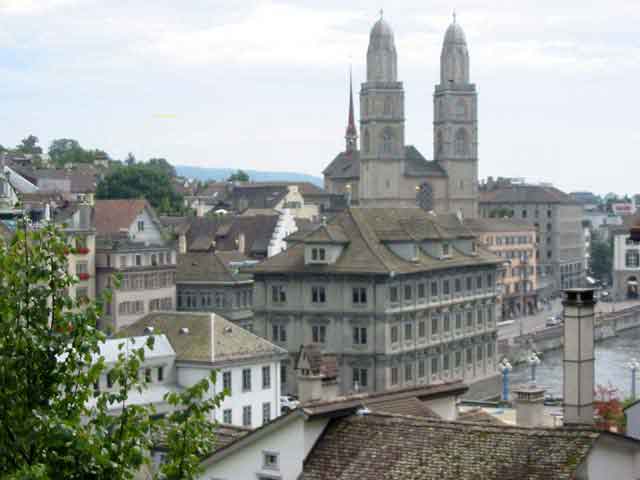
Taking a break from touring Zurich at the Schober cafe
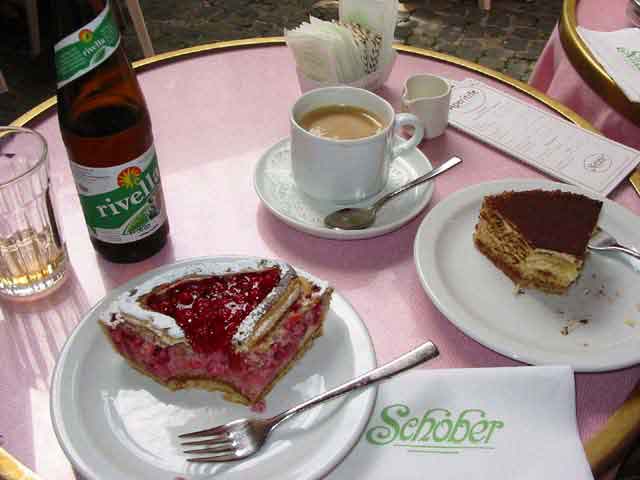
Accompanied by a light rain we left on Tuesday morning for Chateau de Chillon, the famous castle on Lac Leman. We found that we were really heading into a different part of Switzerland, not only was the architecture changing again, but the language spoken at the café where we stopped for a piece of pie was completely French. The riding in the Jura region was also different from the other regions of Switzerland. We climbed through thick forests, and fog, on small back roads. One road was like climbing a cliff in the Alps with a grade of 22% and switchbacks and the next was in open meadows. We set up camp a couple of kilometres from the castle.
Chateau de Chillon
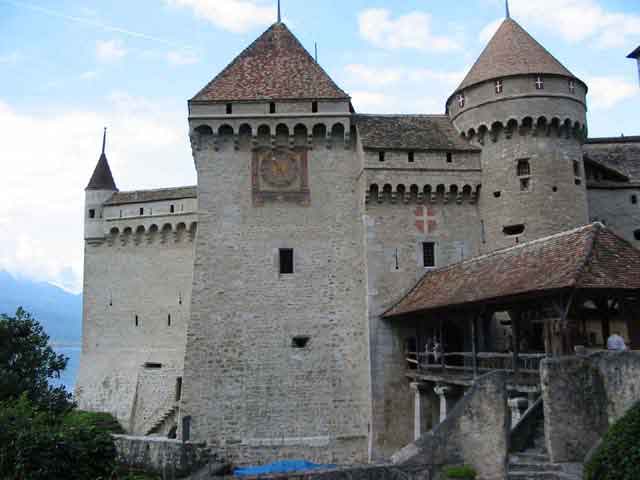
Courtyard of Chateau de Chillon

The next morning we toured the castle before the tour buses arrived and were glad that we did. Byron wrote a poem about the prisoner of Chillon who was chained in the dungeon for four years. The castle and its history were fascinating with displays of armour and descriptions of how the castle was constructed over the centuries. The castle occupied a strategic position along the lake leading to one of the passes over which trade flowed. That afternoon we visited another of Audrey's relatives; Susanne in Geneva. She took us out for a delicious meal at a local restaurant where the speciality was Mallakoffs which are essentially cheese pillows. Amazingly good. Then off to a concert in a park across town, an Acadian group! While it was nice to hear music from “home” we were probably closer to Acadia in Switzerland than in Calgary. The walk home at about 11 o'clock at night was interesting if only for the number of people out and about at that time of night in a city of such a small population. Susanne made an excellent tour guide of Geneva the next day (even finding the elusive Torx screwdriver) as she is very familiar with the city and has done a lot of travelling. Late in the afternoon we rode the short distance to Chamonix in France, famous as a ski resort. We must have become accustomed to the high prices in Switzerland because the prices seemed very reasonable here. The exception was the gasoline, where Switzerland and Austria have been the least expensive so far at about 85 to 90 Euro cents per litre (about $1.40 Canadian). France was at about 1.07 Euros per litre. We took a break from travelling and being a tourist for a couple of days in Chamonix. We did none of the gondolas or hikes in the area, rather we did the mundane things like laundry, getting caught up in our journals and repairing the helmet.
Jet d' eau comes out of the fountain at more than 200 km/h

Ramp used by horse messengers at the old city hall in Geneva

Interlaken to Zurich to Geneva and Chamonix
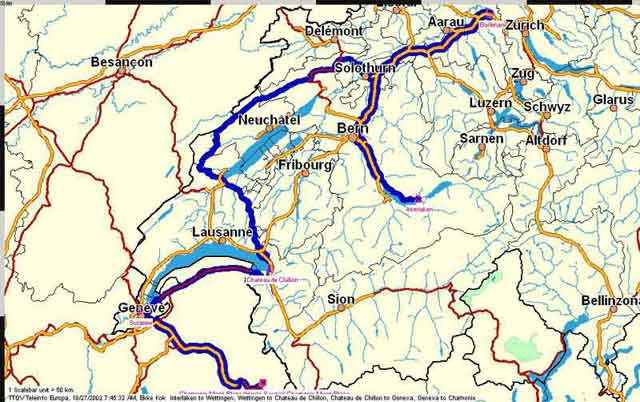
We wanted to be within easy striking distance of Paris the next day so rode to Provins on the little French backroads we had been dreaming of. The best roads were the ones that were not on our map. We even managed to find the source of the river Seine. Arriving early enough at the campground allowed us to take a walking tour of the medieval city before supper. Provins is a UNESCO world heritage site for having one of the most complete medieval towns. So on Wednesday morning we prepared ourselves for the ride in to Paris. Ekke used the laptop to download the route to the Bois de Bologne campground in case the streets of Paris were as confusing to ride as they looked on the map. They were. We were glad that we could concentrate on riding in the traffic more than route finding because the traffic was incredible. The motorcyclists were especially amazing. As we were riding along the Boulevard de Peripheque at 100 kph, keeping up with the cars, motorcycles would come flying by at warp speed, slaloming between the cars. They were friendly motorcyclists, waving by sticking their foot out so that they would not have to take their hand off the throttle. After a couple of false turns from a traffic circle we ended up at the campground plus or minus 10 metres according to the GPS. There had been no signs for the campground so were glad to have had the GPS.
Medieval gate to Provins

We thought that we would walk to the Arc de Triomphe to catch a double-decker tour bus on Thursday morning. The walk was a bit more than we had planned, about an hour. We took the Les Cars Rouges bus down to Notre Dame and walked into the Latin Quarter for lunch. Ekke should know better but he doesn't. He ordered a steak and fries, just like six years ago, and sure enough the steak was thin and tough, just like six years ago. Mental note: Don't have steak in Paris. Rejoining the bus tour we rode to the Orsay Museum, known for its collection of Impressionist works. We purchased a three day museum pass at the Orsay and then went in to enjoy works by Monet, Manet and Toulouse LaTrec. We then rode Les Cars Rouges back up to Arc de Triomphe but just missed the special bus that goes directly to the campground. So, despite Lonely Planet recommending against walking through Bois de Bologne at night, we did not wait for the next bus but walked into the gathering darkness. As it got darker we walked faster until we were almost at a race-walking pace. The prostitute showing us her “wares” didn't help our nerves any. An hour later we made it back safely but wiser for it. The next morning we bought a pack of camping bus tickets so that we wouldn't have to do that walk again!
Welcome sight after a long walk
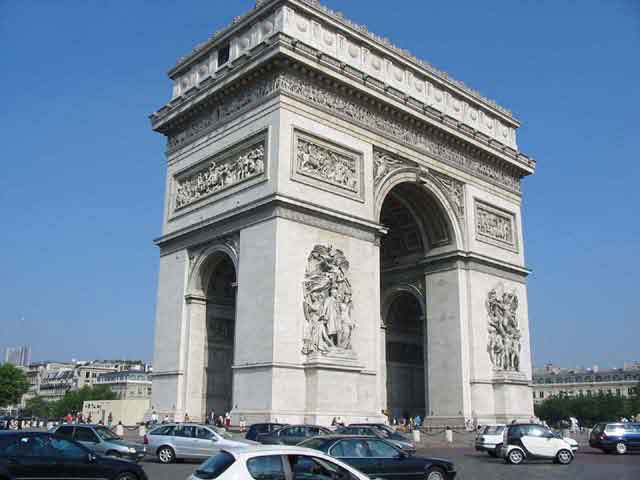
Orsay Museum a converted train station
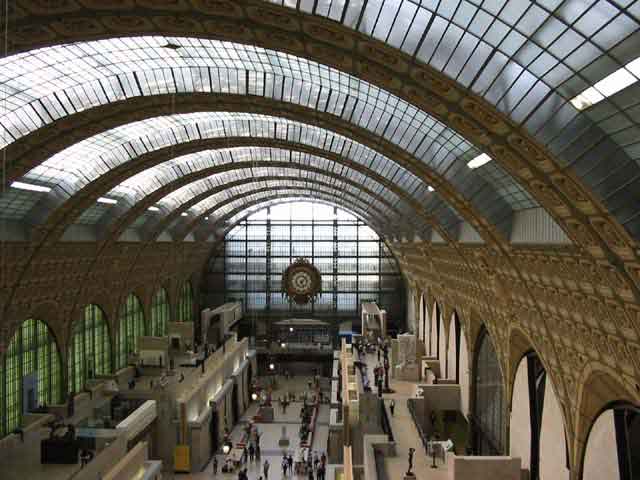
Taking the bus in to the Metro station was much easier than walking six or seven kilometres. We then took the Metro to the Rodin museum to see such famous sculptures as The Thinker, Wall to Hell and Balzac. After having crepes for lunch we went to the Louvre for a couple of hours. We used a book by Rick Steves, Mona Winks, to guide ourselves to some of the highlights of the museum. It was nice to be able to look at just a few of the important pieces from more than 300,000 works of art and then understand why a particular piece was important. At 4 PM we went outside to meet Judy Yu who had come in to Paris a few days earlier. Her friend Chris guided us to the Luxembourg Gardens and then for a stroll through the Latin Quarter. We ended up near the university for supper where Ekke managed to resist the temptation to have steak and fries. A quick Metro ride up to see Moulin Rouge in Pigalle and then back to camp for us while Judy and Chris went on. After Paris they went to Nice to spend another week together.
The Thinker and The Walker

Venus de Milo at the Louvre

High stepping dancers at Moulin Rouge
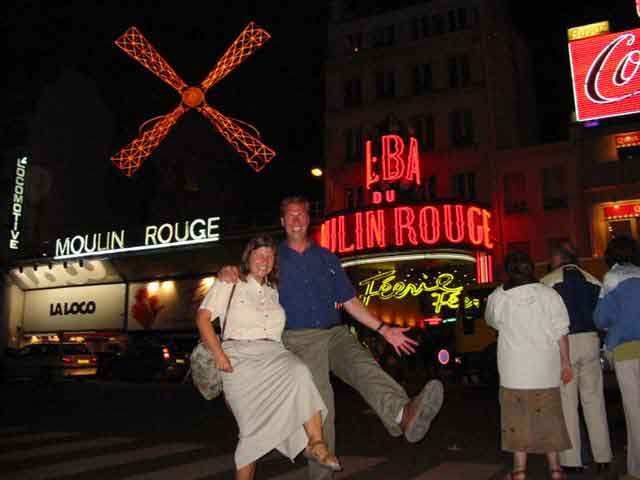
Saturday had us climbing the stairs up the Notre Dame tower and then after lunch on the windy terrace of the Samaritaine back to the Louvre. This time we took our time to look at individual works rather than seeing as much as possible. Still we managed to see a lot; from Roman artifacts to Napoleon III's apartments. The museum card allowed us entry to the top of the Arc de Triomphe so we climbed those stairs before heading back to camp. It was fascinating to watch the traffic from the top, while the initial impression was chaos, especially when the traffic police shut down Champs Elysees, it all seemed to work with a minimum of fuss. It even worked when a horse drawn wedding carriage went through! A Ferrari F40 was the last piece of art we saw that day. Sunday we enjoyed the area around Sacre Coeur having a great lunch outside a café on a square. The square had artists selling their paintings and crowds of people watching them paint. We ended up at the Seine under the Eiffel Tower after walking along Rue Claire and the Champs de Mars. Here we took a tour boat for a one and a half hour ride up and down the river.
Gargoyle on top of Notre Dame cathedral
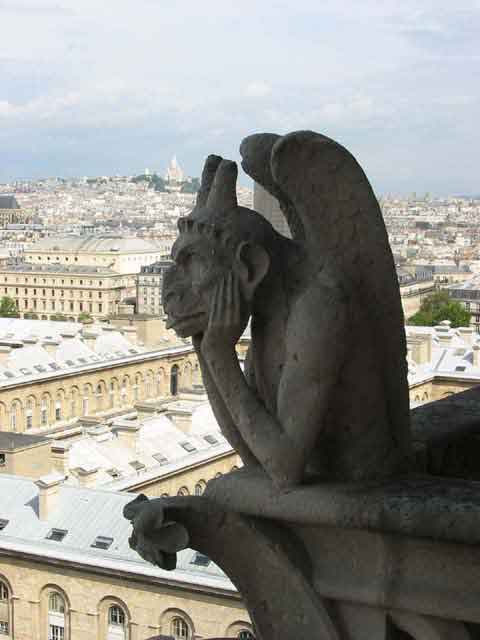
The crowning of Napoleon
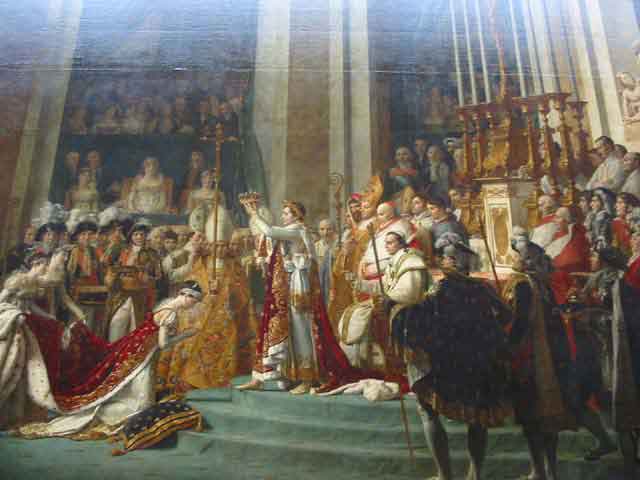
Napoleon III's apartments
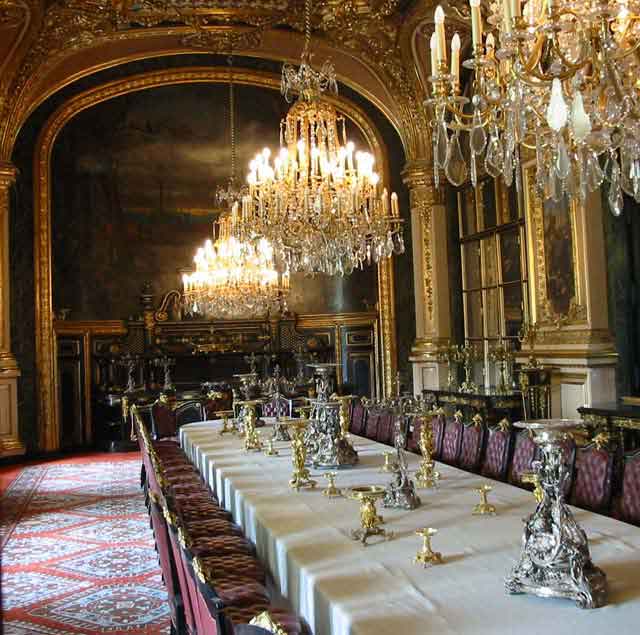

A SAAB convertible in the traffic circle around Arc de Triomphe
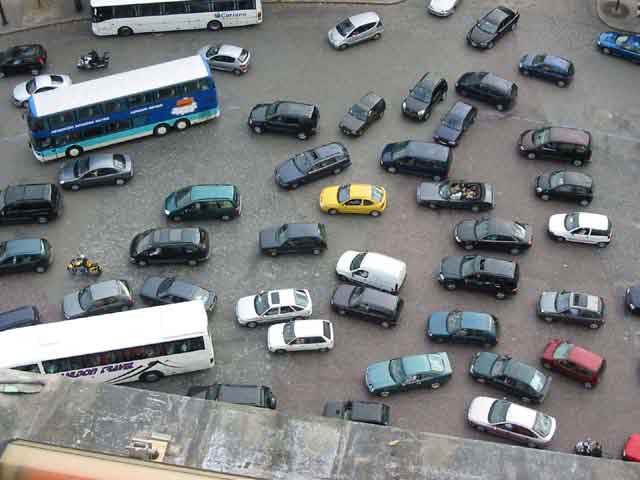
With a stiff wind blowing and spotty rain we rode out of Paris in the direction of the Normandy D-Day beaches. The weather was making the riding miserable and when we stopped to have a coffee break at the Comfort Inn we decided to stay in their warm, comfortable room and hope that the weather would improve for the next day. Sure enough, the following morning was sunny and the trees were not being blown around so the ride to Arromanches was very nice. Since we were there at a good time we went into Bayeux to look at the famous tapestry from the eleventh century. The tapestry depicts William the Conqueror going over to England and the battle of Hastings in 1066. Wednesday we had to get caught up with laundry and do some minor motorcycle maintenance. Late in the afternoon we went to a 360 degree cinema to see the battle on D-Day. From there we rode up to Juno Beach where the Canadians landed on June 6, 1944. The Canadian monument that will be built there looks like it will be beautiful judging from the artist’s rendering. At sunset we headed inland to the Canadian war cemetery with over 2,000 graves. It is so difficult for our generation to understand the horrors of war but we found that this beautifully kept cemetery in the French countryside at sunset was very moving.
At the Canadian War Cemetery
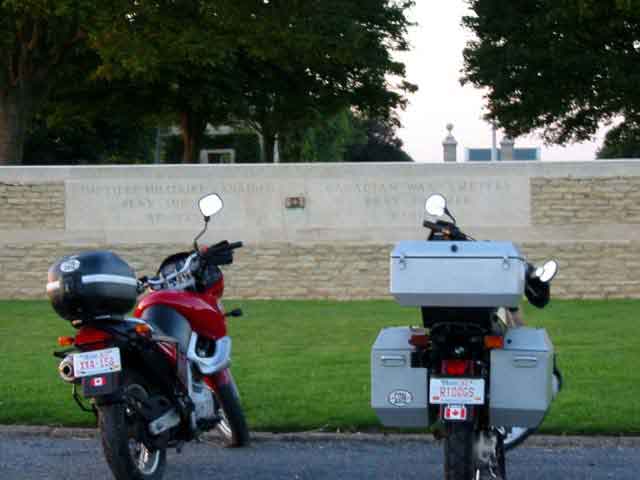
Taking the back roads we rode to Le Mont St Michel, an abbey and accompanying town built on a rock in the middle of a tidal flood plain. A two kilometre walk from the campground took us out along an “unfloodable” causeway to le Mont St. Michel. The parking lots are in the floodplain with signs indicating when high tide will make it difficult to get to your car. After a tour of the abbey and layers of churches, from thousand year old romanesque to more modern gothic we headed down into the town. The town was built up to cater to pilgrims coming to the church and was now doing a thriving trade catering to the tourist pilgrims. La Mere Poulard is famous for its omelets where you can see the cooks whisking the eggs and then cooking the omelets over a wood fire. Since they were the only establishment open at supper time, all the other restaurants had not opened yet, we went in despite the rather steep prices. To be honest it was a real disappointment to have a small omelet for 25 Euros. OK, so Margaret Thatcher and Allan Shepard ate there and had their pictures on the walls with dozens of other celebrities, forty bucks is a lot of money for an omelet! We then ran to the restaurant near the campground to have something to eat!
Le Mont St Michel
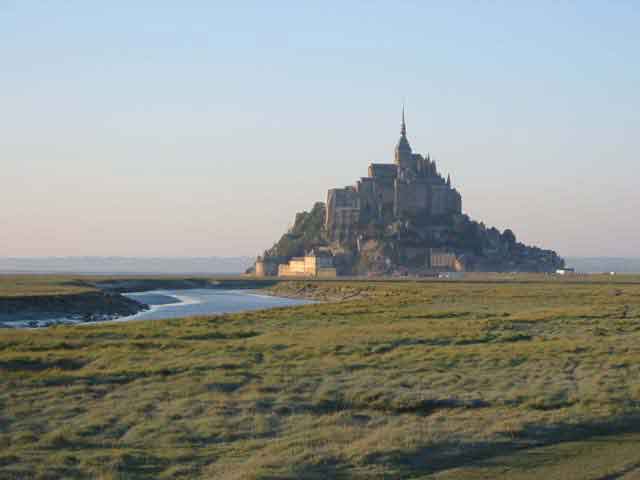
On the advice of Dave, whom we had met in Interlaken, we went to St. Malo for a day trip on Friday. Taking the small road along the ocean was a treat. St. Malo was seriously damaged in World War II and had been rebuilt in the style of the 17th and 18th centuries. We walked along the original ramparts and found a statue of Jacques Cartier dedicated by Pierre Elliot Trudeau. With the wonderful weather we walked down to the beautiful beach and then across a causeway to an adjacent island. It was running a little late to make it back to camp so we stayed in town and had a Gallete (savoury crepe) for supper. The Biniou Crepe Flambee with Calvados was especially good.
St. Malo on the French seaside

The ride on Saturday the 14th from Le Mont St. Michel to Blois in the Loire Valley was uninspiring. In Le Mans everyone was driving as if they were at...Le Mans! Overall the scenery was mostly flat and forested. The next day Ekke went for a short ride up and down the Loire Valley and Audrey took her bike chateaux hopping: Chateau Blois with four different architectural styles, beautifully furnished Chateau Cheverny, the fairytale turrets of Chateau Chenonceau and the famous Chateau de Chambord with its double helix staircase designed by Leonardo Di Vinci.
Chateau de Chambord

With the Intermot motorcycle show starting on Wednesday it was time to start riding east to Munich. Monday we rode from Blois to Montigny-le-Roi and Tuesday to Colmar, just on the west side of the Rhine separating France and Germany. An evening stroll around Colmar with its Alsatian architecture was beautiful but we were too late to go to the Unterlinden Museum and see the Issenheim Altarpiece. According to Lonely Planet it is “one of the most moving works of art ever created.” Oh well, maybe next time. Wednesday we crossed the Rhine into Germany and rode to Wartenberg.
Petit Venice in Colmar
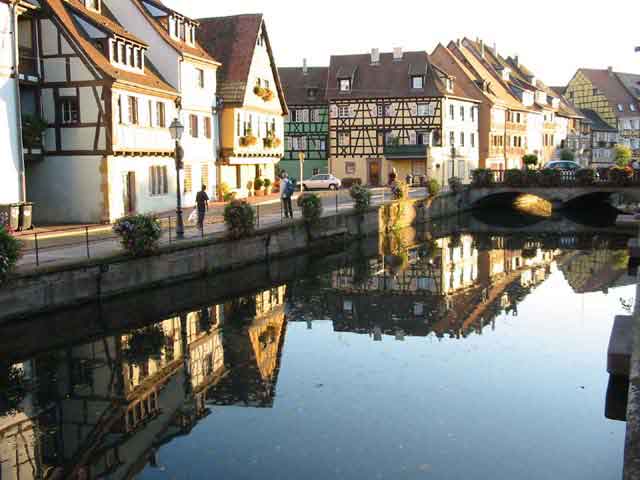
Our route through France

K1200GT
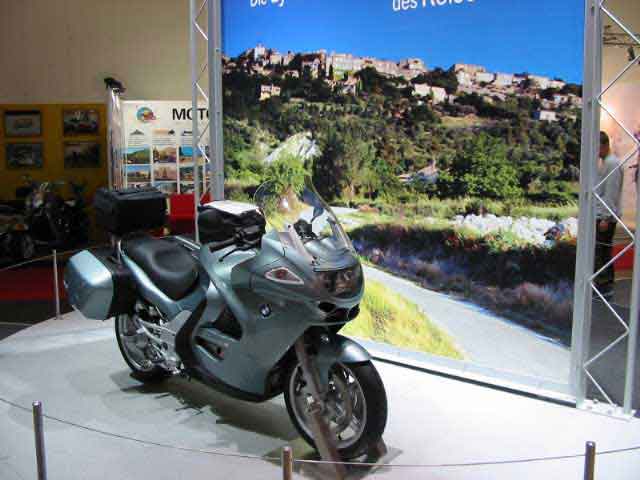
R1150R design study
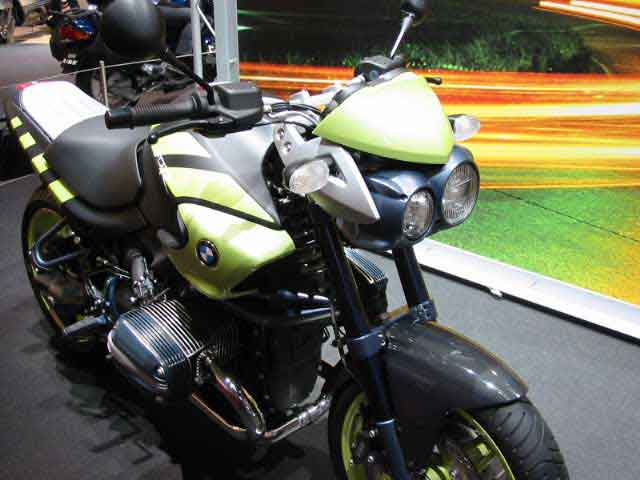
R1200CL
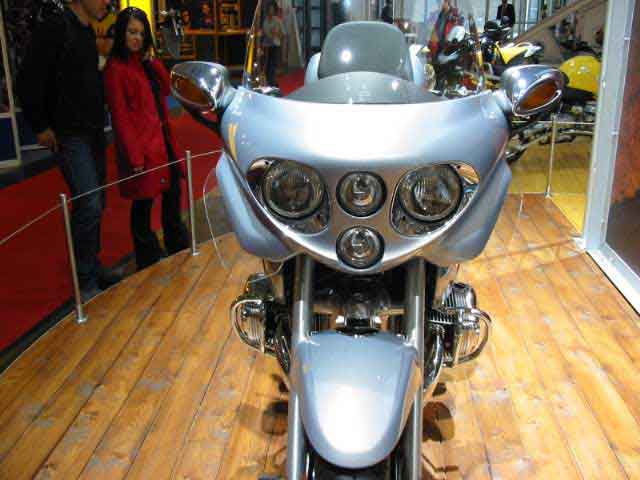
Gee, I look good!
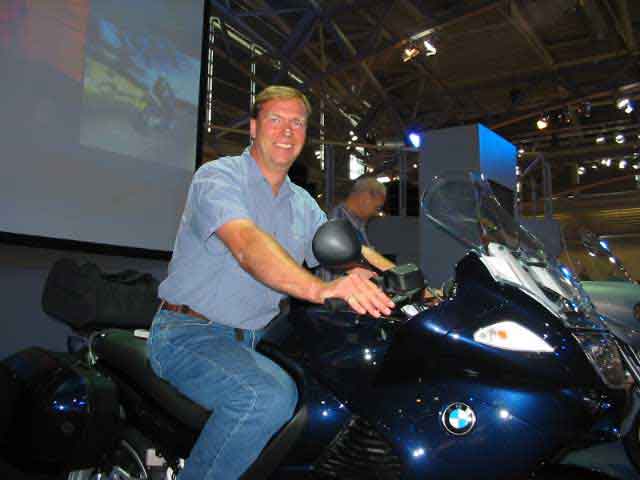
C1 scooter with sidecar
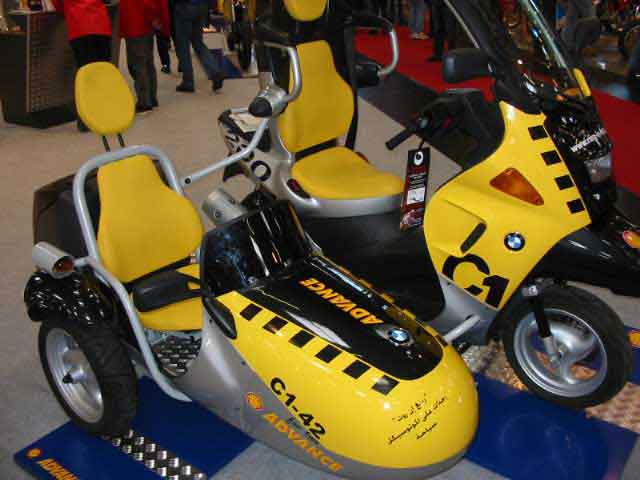
An airbag jacket
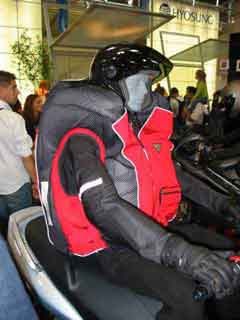
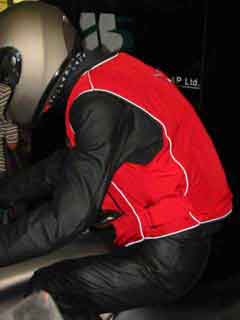
Wild stunt show
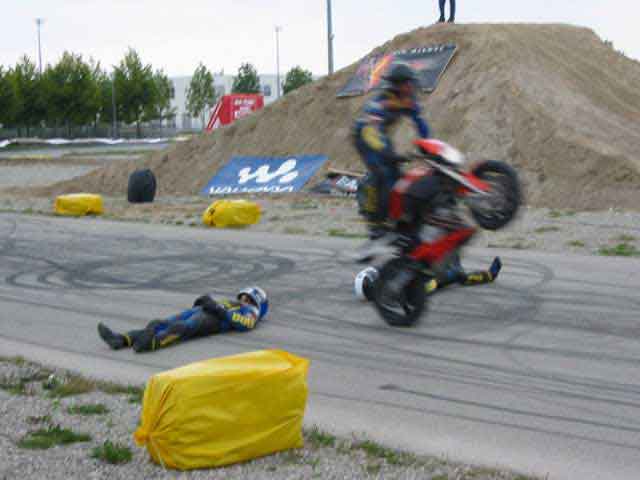
The German autoclub ,ADAC, had a Bikercup where you could borrow some gear (helmet, jacket, gloves) and then ride a BMW F650CS around a course to win a prize for the highest points of the day and an F650CS for highest points over the course of the show. Ekke thought he could do that since it looked pretty easy from the sidelines. After standing in various lines for an hour to give up the driver’s licence and then get the gear Ekke found that a written test was first required. In German. On German road rules. Hmmm, maybe this won’t be so easy! With the help of one of the ADAC personnel who could speak English, Ekke completed the written portion and headed out on the bike to weave through the cones and such. It turns out that the course is laid out in soft, deep gravel and was much more difficult than it looked. Needless to say, we did not receive a phone call to tell us to come pick up our prize. On the way home in the rain we stopped off at Karl Maier BMW and dropped Audrey’s bike off for new tires and made an appointment for the scheduled service on Ekke’s bike for Monday morning. Again we had excellent service as the shop closed at 1800 and we showed up at 1830 and they were more than happy to accommodate us.
Tuesday afternoon we went with Andrew to Oktoberfest, or as the locals call it, the Wiesn. We planned to meet Michael and Helena later to go to the beer tents. The area covered by the Wiesn was quite tremendous with large beer tents set up and every ride imaginable from giant roller coasters to haunted houses. It was raining pretty steadily by the time we got there but we were up for some fun and played some games and went on a few rides. The bumper cars were the best because they were under a roof and therefore dry. One ride had Andrew sitting in the rain for at least 10 minutes before the ride operator decided that he had waited long enough for other people to get on the ride and fired the ride up. We were all pretty much soaked so decided to call off our meeting with Michael and Helena and head home instead.
Helge Peterson's bike at the BMW museum in Munich

We gave the Wiesn another chance on Friday afternoon when Helena had the time off and after we did some shopping in downtown Munich. This time we were better prepared with everything from rain pants to Gore-Tex socks. Sure enough it rained pretty steadily again, at times quite hard. We did a few more rides, with Audrey going on the scary ones with Andrew, including the giant roller coaster with five loops in the shape of the Olympic rings. One ride was a really lame walk through a bit of a maze when we were confronted with The Rotor. Here you stood up on the inside of a cylinder and they spun it up to speed and then dropped the floor, leaving you plastered to the outside, hanging from the wall. It seemed innocent enough but Ekke was a little green around the gills for quite a while afterwards.
Rollercoaster at the Wiesn

We planned to head south on Sunday morning but spent too much time writing Chapter 7 so that it was early afternoon before we could have headed out. So we put our departure off for another day. That evening we went to a restaurant a few kilometres down the road to celebrate Michael’s upcoming birthday. We were very fortunate in that some local musicians gather at this restaurant once a month and this was the day. What a treat to dine on some of the best cuisine we had enjoyed in Bavaria with various musicians playing their accordions and trombones in a jam session. Waking up Monday morning showed a nice clear sky and a good layer of frost on the cars that had to be scraped off. A sure sign that it was time to head south.
Looking back towards our campsite on Lago di Caldonazzo from the cliffside road
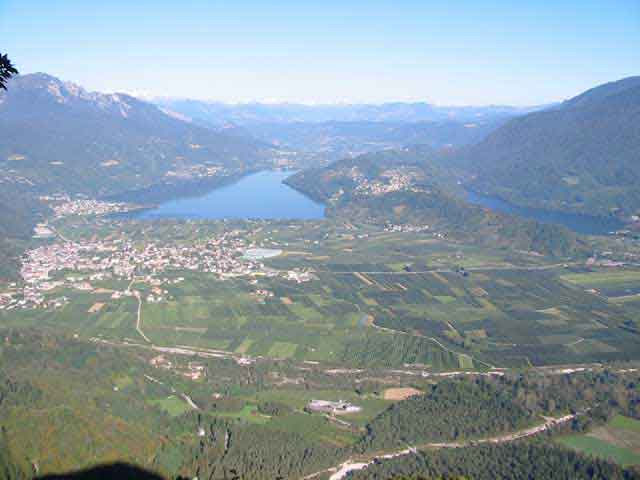
Camp on shipping route with view of Venice (behind the boat!)

We again took the boat into Venice on Wednesday the second of October and made sure we saw the appropriate tourist sites, such as Piazza San Marco. Unbelievably, the place was crowded in October. It must be jam-packed during the height of the tourist season. Venice was an absolute delight to walk around. The small back streets in the residential areas were especially attractive as there were almost no tourists. We soaked in the ambiance of Venice. We were enjoying the city so much that we stayed another day and got a day pass for the vaporetto, the local water taxi. We used the vaporettos to tour around the city a bit, getting off to walk whenever we felt like it, and then rode it out to Murano. The island of Murano is famous for its glass blowing factories but we opted for strolling the streets instead. There were far fewer tourists on this island so it was a very relaxing stroll.
Piazza San Marco in October

Quiet canal in Venice
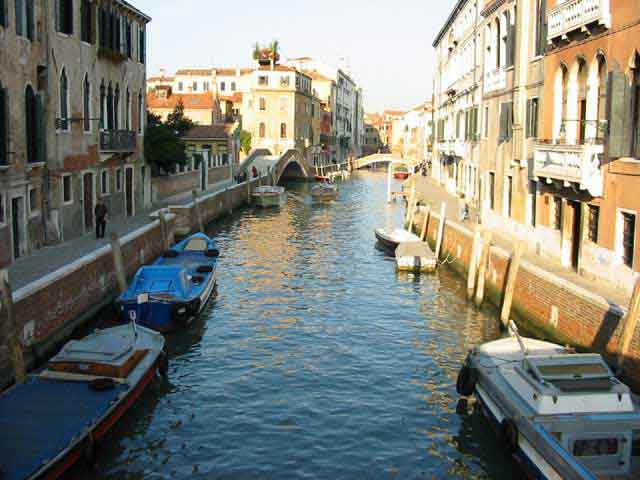
Rialto Bridge

Eventually we had to leave Venice and on Friday we rode off in the direction of Croatia (HVRATSKA in Croatian). At least that’s what we thought. Somehow we got all turned around in Trieste, Italy, and ended up leaving the city towards the north rather than the southeast. This put us into Slovenia late in the afternoon so we decided to find a campground. The roads in Slovenia were absolutely excellent and almost deserted so we made good time to Kozina. The campground portion of the campground/motel in Kozina was closed for the season but the motel room was 43 Euros, including breakfast. The ride to Pula, Croatia on Saturday showed us what a beautiful country Croatia is, with winding roads and castles on hilltops. Arriving in Pula we rode by a magnificent coliseum in the centre of the town. It was wonderful to see our first Roman ruin. At the campground we paid an extra 20% to have a spectacular site on the edge of a cliff overlooking the Adriatic and enjoyed sitting in the sun. The next day we took the bus into town and explored the coliseum and other Roman ruins. By about 8:00 PM we could see a massive thunderstorm from the campground with lightning flashes lighting up the whole sky. We were sure glad not to be under that! Of course by 10:30 we were right in it and it was the wildest electrical storm we had ever been in while camping. The tent held up for the hour we were pummelled by wind and rain with one pole coming down on the awning. Even at 2:00AM we could see the angry storm to the south.
Roman amphitheatre in Pula
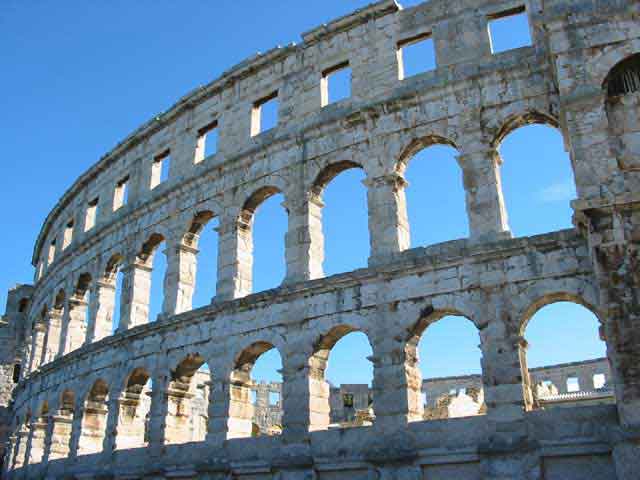
Morning dawned clear and beautiful as we packed up to head north up the Istra peninsula to Rijeka and then south down the coast. We arrived at Senj, on the coast, at about 1630, the right time to set up camp but all the campgrounds were closed. No hotels jumped out at us either so we decided to push on towards the Plitvice Lakes National Park, up into the hills. Away from the coast, and the main tourist route, we came across more and more bombed out houses. These definitely gave us an uncomfortable feeling, knowing that someone went out and destroyed these homes where people had lived for generations. We arrived at the campground at 1800 and were told the campground had closed officially the day before but we could put up the tent anyway for free. There were a few other campers taking advantage of the free camping but it was very quiet.
The Plitvice Lakes National Park is a series of 16 lakes joined by cascades and waterfalls. The mineral rich waters create new formations continually. We put on our walking gear and spent the day exploring the park. It was a popular place, even at the beginning of October, and we had to get off the main trails to get out of the tourist bus crowds. We started at the large waterfalls and then went upstream walking on board walks near the waterfalls crossing one of the large lakes on an electric boat. From the upper lake we took a bus back down to near the beginning and walked the rest of the way back. We realised that October 8th was our three month anniversary of travelling so we splurged for a restaurant dinner in the park, arriving back in camp after dark. Prices in Croatia were certainly less than the rest of Europe and with the exception of gasoline about on par with Canadian prices. Gasoline was amongst the least expensive of the trip so far at about 6.5 Kunas per litre or about 0.88 Euros or $1.25 Canadian.
Veliki Slap, the large waterfalls in Plitvice Lakes National Park
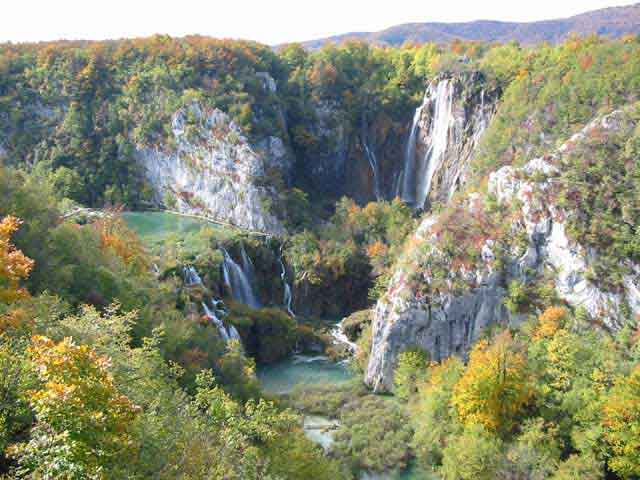
Boardwalk below the waterfalls between the lakes

Beautiful fall colours starting in Plitvice
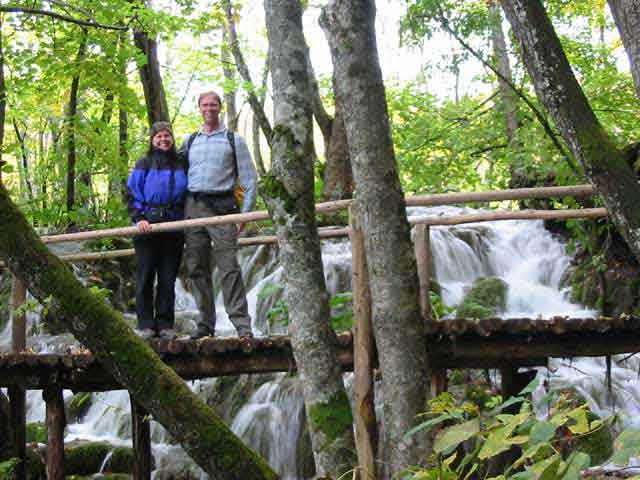
Wednesday we started out in the rain and cold of Plitvice and ended up in the sun and warmth of Split, 410 kilometres later. This time we passed through two entire villages that were bombed out and abandoned. Oddly enough both village names started with the name “Islam”. Again we had trouble finding a campground and ended up smack dab in the middle of Split looking lost. A merchant came out from his stall and chatted with us so we asked him for some directions to camping. This turned out to be a few kilometres further down the coast in someone’s back yard. We had a muddy spot under a palm tree right next to the rocky beach. So we dragged our table and chairs out to the beach and had our supper there while enjoying the sun setting over the Adriatic. Split achieved fame in the third century when Roman emperor Diocletian had his retirement palace built there. The palace is still being used today by the descendants of the Roman village of Salona which was abandoned in the seventh century. Hence there wasn’t much to see, except for the palace walls and other ruins. Nevertheless it was very interesting. We made arrangements to catch the ferry to Hvar island the next day and returned to camp. The ferry left at 2:00PM so we updated the website with Chapter 8 at an internet place where we could hook up the laptop and then caught the ferry. There was no camping at the medieval town of Hvar on the northern tip of Hvar island so we opted for a hotel. Our last hotel, in Kozina, Slovenia, had been a bit of a dive so we thought that we should go a little upmarket and went to a hotel where there were a number of tour buses out front. While it felt a little awkward to walk over their beautiful marble floors in our dirty motorcycle gear it was worth it with a nice clean room. We walked into town for a pizza on the main square opposite the harbour. The bill for the four star resort the next morning was 360 Kunas or about $70, not too bad.
Inside Diocletian's retirement palace, Split

The next morning we walked up to the old town fortress Spanjola, where a small museum was set up. The area had experienced many shipwrecks since antiquity and recent dives had uncovered interesting artifacts such as a boat load of tableware. We wanted to set up the tent to clean and dry it after the mud bath in Split so we made a short ride down the island. The road was very rough but with almost no traffic and with no visible bombed out houses on the island it was a very enjoyable ride. We had seen strange rock piles on the mainland and on the island we saw many more, sometimes arranged in neat lines or sometimes in haphazard piles. We had a few theories why someone had gone through all the trouble of making the rock piles but we could not come up with anything satisfactory. The campground at the end of the island was closed but again we could stay for free so that made up for our splurge at the hotel.
View of Hvar from Spanjola Fortress
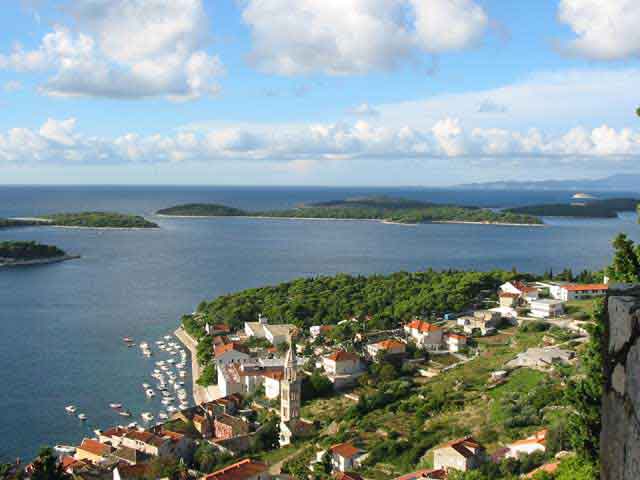
Strange rock piles

Free camping
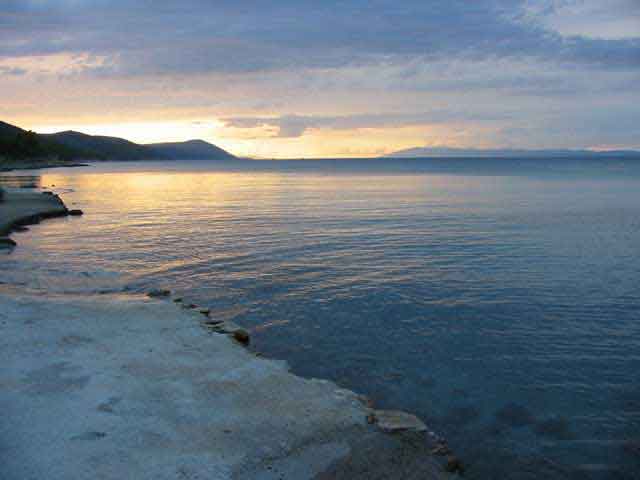
Sunday we rode to Dubrovnik after catching the 11:00AM ferry to the mainland. We did not know the ferry schedule from Dubrovnik to Italy but knew that it was infrequent so when we saw two large boats leaving the harbour as we pulled up we were worried that we had missed our chance for a week or two. Fortunately they were not the right boats and an overnight ferry left Dubrovnik on Tuesday evening at 11:00PM, giving us a couple of days to enjoy the city. What a beautiful city it was too. The old city walls enclose the city centre with its marble streets and we enjoyed an iced coffee sitting on a terrace on the sea side of the city wall. During the rest of our journey through Croatia we had not encountered too many tourists but now there were a lot. Dubrovnik must be a stop for the cruise lines because a couple of cruise ships were in the harbour and the streets were crowded with American and British tourists. Fans of CBC’s This Hour Has 22 Minutes will be familiar with Rick Mercer’s Talking to Americans segment. We had just as much fun listening to Americans. Walking along the city wall an American couple came towards us and we overheard him say, “How far to the next washroom?” and she replied with, “The last sign I saw said 300 ‘kilomilers’.” Boy, I hope he didn’t have to go too badly! Another American couple at the city gates were seen dropping some coins into a beggar’s tray. The beggar replied with “Hvala”, which means “Thank you” in Croatian. She said to her husband, “He said ‘Allah’, go take the money back!” Thank goodness he didn't, but it made us really appreciate being able to slowly assimilate a country on the motorcycle rather than being dropped off magically on a cruise ship; yesterday Venice, today Dubrovik, tomorrow Athens. You would never have time to learn anything about the country or even a simple phrase in the local language.
Iced coffee terrace outside city walls of Dubrovnik
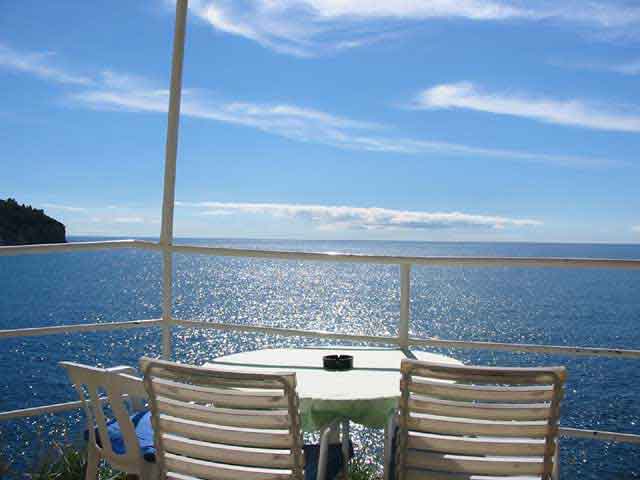
On the city walls
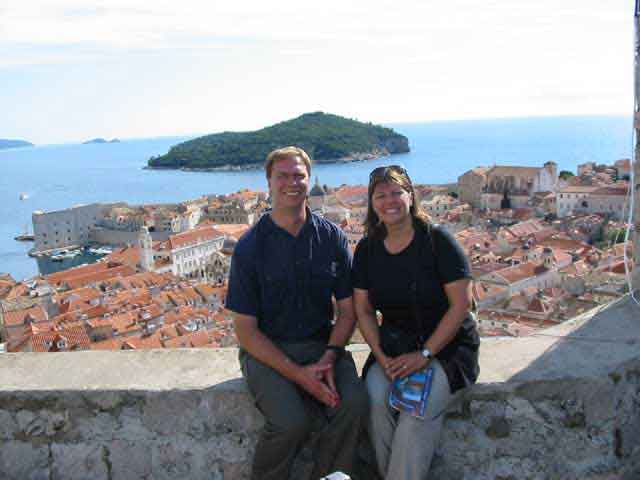
Festival cruise ship visiting Dubrovnik

Tuesday we took our time cleaning up at the campground, cleaning the tent from the mud yet again. Going to leave at about 4:30PM Audrey’s bike refused to start so we had visions of missing our weekly ferry. We push started it and rode straight to the ferry terminal. Diagnosis showed that the battery was nearly dry so we topped it up with distilled water and it worked just fine after that. Then we rode around the city looking for a place to have supper and ended up on a cliff side road with a spectacular view of Dubrovik and a colourful sunset. Finally we found a restaurant back at the harbour and spent our last Kunas. Overall we had been a little apprehensive about touring Croatia but it was really worth it. It was a beautiful country and while the parts off the main tourist trails were not quite ready for prime time we thought that soon they will be. We boarded the ferry at 10:00PM and set sail at 11:00PM in our tiny stateroom with bunkbeds. We would be in Bari, Italy at 8:00AM the next day looking for a way to get to Greece.
Sunset before leaving Croatia
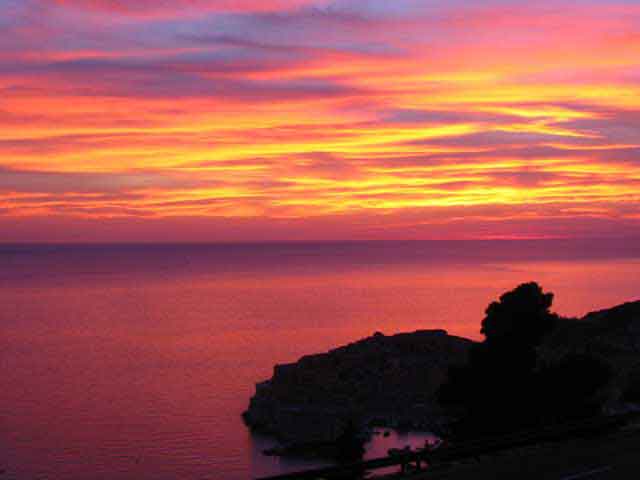
Map from Wartenberg to Venice and Triest. Sorry, no map of Croatia!
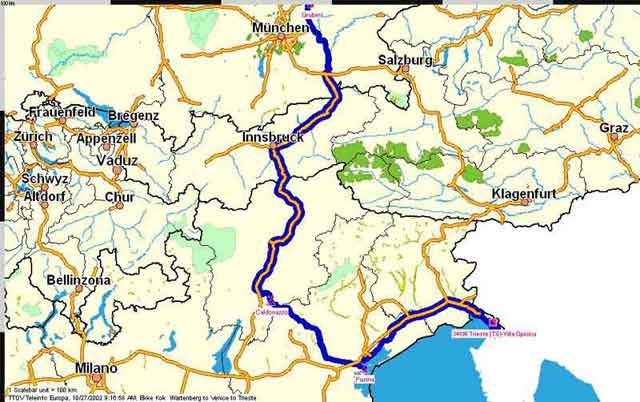
Click here to return to the top of the page
After the time change (Greece is two hours ahead of GMT) we arrived at 9:40 p.m. in Igoumenitsa, looking for a place to stay. The Hotel Aktaion provided a simple, clean room for only 45 Euros and just a few hundred metres from where the ferry docked. With our heads still spinning (weren’t we in Dubrovnik just a little while ago?) we rode off the next morning in a southerly direction. Again we had to acclimatise to a new way of riding. In Greece the road markings and signs seemed to be there for no apparent reasons. If the road had a shoulder then traffic would kind of drive half on the shoulder and then the middle of the road would be used for passing, whether there was a double solid line or not. This took a bit of getting used to! Also, perhaps because larger motorcycles are not as common in Greece, drivers expected us to ride on the shoulder, or at least that’s the way it seemed when they were tailgating. Of course all the road signs are in Greek so that didn’t help either! Then while we were lost in a small city Audrey nearly T-Boned a moped rider who flew through an intersection. Having to do emergency braking, she stopped a few millimetres shy of the other rider. We were glad that we didn’t have to find out how the Greek traffic laws work in case of an accident. With renewed caution we found our way out of the city and went to a campground near Patras. Unfortunately it was closed for the season. So we crossed on a ferry towards Patras (another adventure with everyone backing onto the boat) and rode south along the coast. Finally we found a small campground that was open. When we first saw the cats we thought they were kind of cute. However, when we were surrounded by 14 of them while eating supper it became a little weird.
Greek road signs will be interesting
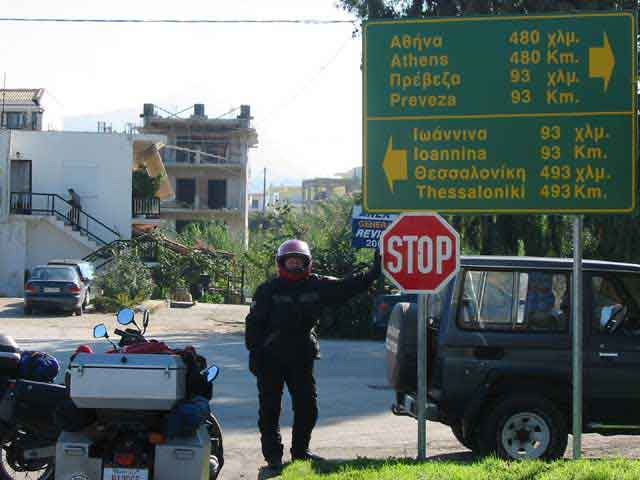
A few of the cats

Friday morning we awoke to find a cat curled up on the top of the tent, under the fly, and chickens on our table. After shooing all the animals away, at least for a little while, we had a quick breakfast and headed south towards Olympia. The Olympic flame is lit here and the torch carried to wherever the Games are being held. The original site was destroyed by imperial decree in 426 AD and later an earthquake finished the job. Still, with a little imagination, the site was magnificent, from the Temple of Zeus to the stadium. From Olympia we cut across the top of the Peloponnisos peninsula towards Tripoli on a tight, twisting back road. With almost no traffic it was a real joy to ride. Just north of Tripoli we got on to the toll highway leading to Athens where we made up the time lost to the fun road. From 60 kilometres out we could see the smog of Athens. If we thought the driving had been interesting earlier it got even more interesting the closer we got to Athens, but the trick is to try and ride like the locals as much as possible. Soon we started treating the road markings and road signs as advisory and riding between traffic whenever possible. With the bikes fully loaded we could not completely emulate a moped!
Destruction at Olympia

Camping Athens was a little tricky to find but after a U-turn on an eight lane road we got in to find they were partially open. Perhaps during the camping season they have more than 12 cats on duty. After a terrible night, with almost no sleep because of the traffic noise, we took a bus into the downtown core. There we went to a travel agency and made arrangements to rent an apartment on Crete for a week and then a hotel for a couple of nights on Santorini, including all the ferries. You would think that the Acropolis would be easy to find in Athens but you would be wrong. We wandered around and in the general direction of where we thought it was for quite a while before finally approaching it from behind. Reconstruction has been going on since 1986 but it seemed that an awful lot of scaffolding was up around the Parthenon. It appears that the Acropolis, and Athens in general, is preparing to host the 2004 Olympics with construction and renewal everywhere. Though one must wonder how the athletes will perform in air so thick that you can see it. Another noisy night at camp had us wishing for our earplugs and getting up a little groggy in the morning. Sunday found the Archeological Museum closed for renovation (in preparation for 2004?) This was a bit of a set back as the museum houses a great number of interesting artifacts from all over Greece. It looks like we will have to come back to Greece after the 2004 Olympic Games to see everything!
Scaffolding and tourists surround the Parthenon
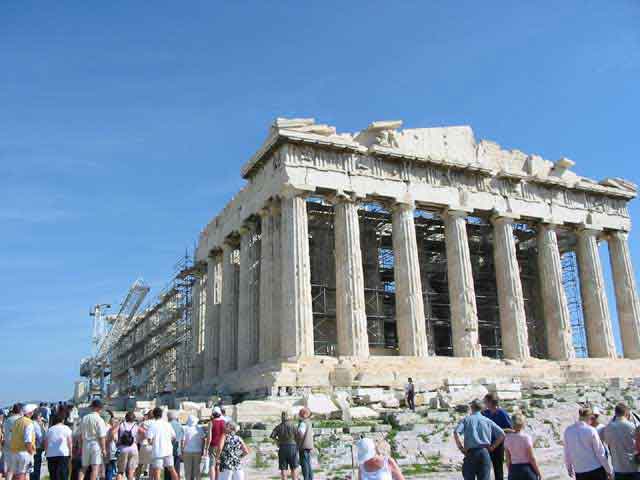
Temple of Erechthion on the Acropolis

The ferry to Crete left on Monday, October 21, at 8:30PM so we had most of the day to work on Chapter 9 of the website. Ekke’s mom was leaving for South America, to hike the Inca Trail to Machu Pichu and see the Galapagos Islands, on Tuesday so it was imperative that Chapter 9 be done before she left. (Wonder where Ekke gets the travel bug from?) The docks at Pireaus were really confusing but we were glad the travel agent had emphasised the name of the boat. That name is what we looked for and it helped us get on the correct boat. As our travel agent explained a lot of people came to vote in Athens as opposed to their current place of residence so the overnight boat to Crete was crowded with people, voters who had presumably just voted in Athens. Most of them had camped out on deck or slept in chairs so we were glad to be well rested after sleeping in our bunkbeds in the cabin before heading off in the dark at 6:00AM onto Crete. An attempt to find a café open to have breakfast and wait for daylight failed so we rode off into the pre-dawn light towards Panormos, along the north shore. We stopped for fuel and a snack just as the sun was coming up so that we could put on our sunglasses since we were headed directly into the sun. Gasoline in Greece has been the least expensive of the trip so far at about 79 eurocents per litre. By 9:00AM we arrived at the Villa Panorama in Panormos where Yannis greeted us and we had a proper breakfast in his taverna. Wednesday was a quiet day with some time spent on the beach and walking around Panormos. Thursday Ekke rode to an observatory on the top of a mountain in the middle of Crete. There he met three British riders who had rented dirt bikes for a week and were exploring the island. He asked if he could tag along to the other side of the island since they had a map and over the rough roads it is nice to have someone else around in case of trouble. They said, “No problem.” and off they went down the mountain. The track was initially very rough but smoothed out to merely rough and Ekke plodded along behind them on the big GS while they waited at intersections and such for him to catch up. Very nice chaps! In the meantime Audrey polished off another book while relaxing at the apartment.
French toast on the balcony of our apartment in Panormos
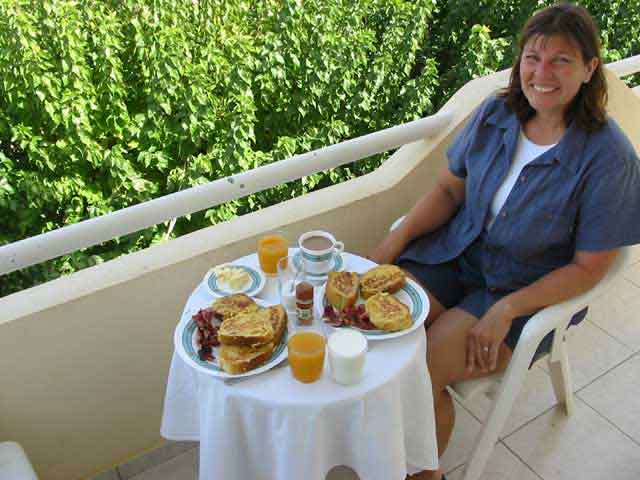
Riding the dirt tracks of Crete

Friday the 25th we rode East to Knossos, the site of an ancient Minoan palace. The palace was unearthed by Sir Arthur Evans in the early part of the 20th century and partially reconstructed. It was difficult for us to tell the difference between what was original and what was a reconstruction so we were never sure if something was built using the exact same methods as the Minoans or not. For example, did the Minoans use concrete back in 1700 BC? On the other hand, it was great to see parts of the palace as it might have been. On the ride back to Panormos Ekke took off at a good clip on the curvy road and soon we were separated. Audrey missed the exit to Panormos and spent some frustrating time in Rythimno getting turned around. On Saturday Audrey took a bus into Rythimno, having been traumatised by Friday’s motorcycle ride there, and Ekke worked on the website a bit. The weather on Sunday was rather blustery so we stayed around Panormos, walking and reading. Then on Monday we rode towards the south coast of the island to Phaestos (also spelled Festos, Phaistos and faistos, never mind any spelling using Greek letters, making the usual route finding challenging). Perched on a hilltop with wonderful views of the Mesara plain the ruins of the Minoan palace had not been reconstructed as at Knossos but there was evidence of modern concrete. We don’t know if the modern concrete (with date stamps ranging from 1933 to 1962) was made to the same standards as the original or if it was there only as a support for the precariously balanced remains of walls and doors. In any case the motorcycle ride on the twisting roads with a scarcity of traffic was a real treat. An interesting thing with Greek roads is that you cannot predict the road. Normally you can get into a rhythm of the road, knowing how sharp the curves will be and such but in Greece a wide, smooth road with gradual curves can turn into a narrow, rough track around a curve without warning. Very interesting and good for keeping you on your toes.
Knossos, ruins and restoration
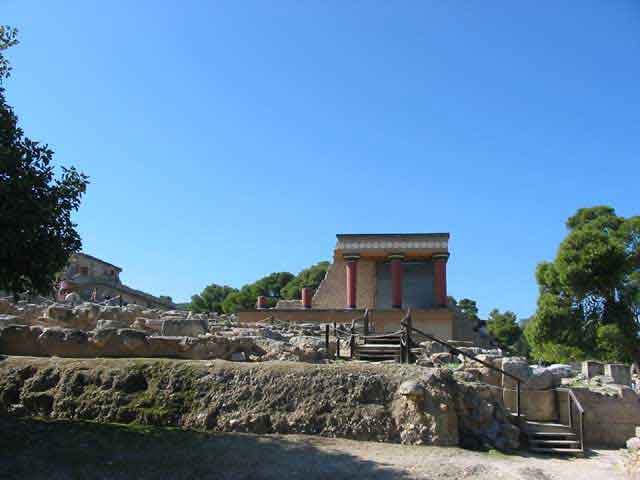
Phaestos
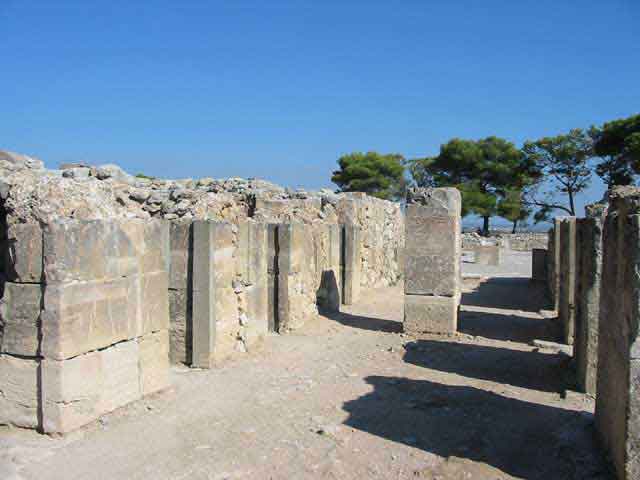
Tuesday the ferry to Santorini departed from Heraklion at 8:00PM so we asked Yannis for a late checkout, which was easily obliged because of the late season. This allowed us to send some parcels home, including a package of cookies for the Christmas cookie club. The mail was very expensive though, easily twice as much as the value of the contents. We wanted to get to the Heraklion Archeological Museum to see some of the prize finds that were found at the ancient sites we had visited on Crete such as the Phaistos disk and frescos from Knossos but the museum closed at 3:00PM and we were too late. We consoled ourselves with the best pizza we have enjoyed on the trip at the Napoli restaurant on the main square after a walk around the old town. As usual, the ferry departed a few minutes late and so we arrived on Santorini just after Midnight. (An interesting coincidence: as I sit writing this very sentence I see out of the window that the exact same ferry, the Daedalus of Minoan Lines, has pulled into port here at Paros, EK) A number of people and vehicles were waiting at the docks advertising lodging but no sign of the Hotel Lignos that we had signed up for. Finally someone stopped a van that was just leaving that said “Blue Sea Villas” on it and we were told to follow him to the hotel in Fira. Climbing the switchbacks out of the harbour in the dark following a line of vehicles was interesting to say the least. After a 12 kilometre ride we passed the Hotel Lignos and continued on to the Blue Sea Villas where we stood around in confusion until the driver of the van explained that he owned both hotels and this one had parking for the motorcycles so we could stay here. It certainly seemed a step up with a very large suite in a new, or recently renovated, hotel with a pool. We finally collapsed into bed at about 1:30AM.
The ferry from Crete to Santorini
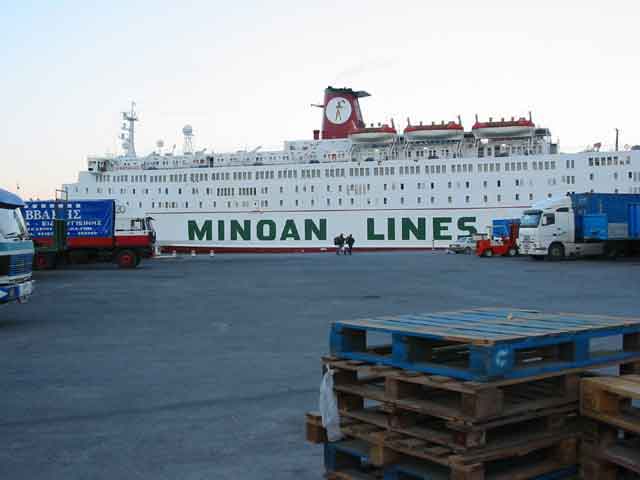
The hotel on Santorini
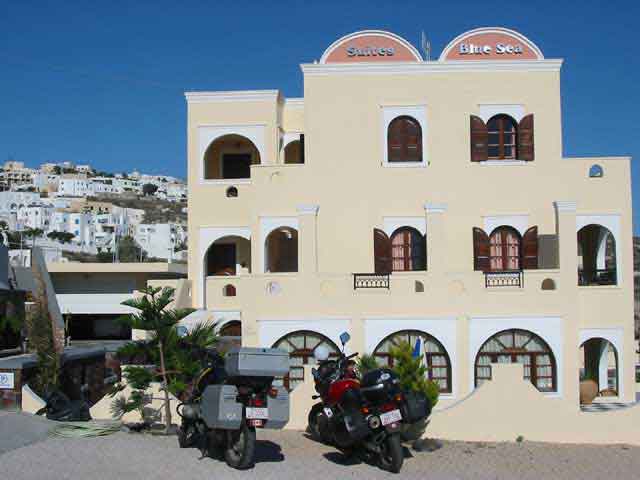
Getting up surprisingly early we walked into town and had a look in the daytime. The view of the caldera was amazing. Santorini is one of the islands left over after an enormous volcanic eruption blew apart the island in the 17th century BC. This corresponds approximately with the downfall of the Minoan civilisation and may have given rise to the legend of the lost continent of Atlantis. So there we stood on the rim of what once was a single island wondering what it must have been like 3,700 years ago when the volcano blew up. Yet people had come back and were living on the islands once again. In the centre of the ring of islands is the remnant of the centre of the volcano; apparently the cone is still active. Hopping on the bikes we rode to the far end of the island to visit the Akrotiri site where a Minoan village had been unearthed. To us this seemed the most impressive Minoan site because it had not been totally reconstructed. Unfortunately this site was undergoing extensive reconstruction of the shelter that protected the site, obstructing some of the views. It looks like eventually it will be covered by a clear span structure that will permit unobstructed viewing of the site. We walked to Red Beach for lunch and then rode to the other side of the island to see what there was to see. It turns out that Ia, the town at the other end, was one of the most beautiful towns we had ever seen and the light in the late afternoon was perfect. The town was built on the cliffs of the caldera in stunning white and pastel shades with colourful shutters and doors. We took so many pictures that there is a special page just for a few of those photos. The ride back to the hotel along the red volcanic cliffs at sunset was spectacular.
View of the caldera from Fira on Santorini and arguably a better spot for Venus
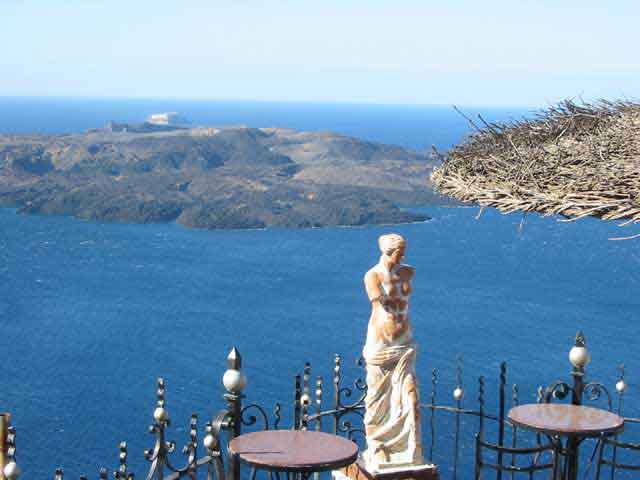
Collapsed stairs at Akrotiri

A classic postcard shot of Ia.
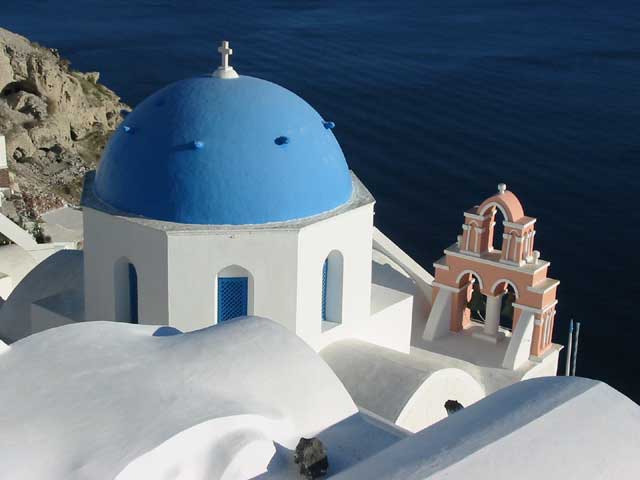
Halloween. What a thought. How could this warm, sunny day on a Greek island be Halloween? It didn’t feel like Halloween. Since the hotel life was making us rather lazy we decided to go for a good walk. We walked over the edge of the caldera and down to the port where the cruise ships let off their passengers. As we were going down this steep trail tourists on donkeys were riding up. Apparently they have the choice of riding the donkeys, walking or taking a gondola. This wasn’t too bad going down but when we turned around to go up we were going against the unloaded donkeys being herded as fast as possible down to pick up more tourists. 600 steps later and out of breath we had regained the top. After recuperating from the climb we went into town to arrange the next ferry. We wanted to get to Mykonos and then Turkey but the direct ferries to Mykonos stopped on October 31 so we needed to find an alternative and were told that ferries went to Mykonos from Paros. So we booked passage to Paros on the Blue Star ferry leaving at 7:30AM the next morning. We also tried to book passage from Paros to Samos in order to make our connection to Turkey but the travel agent’s computer was not working so we left that for later.
The steps down to the dock from Fira
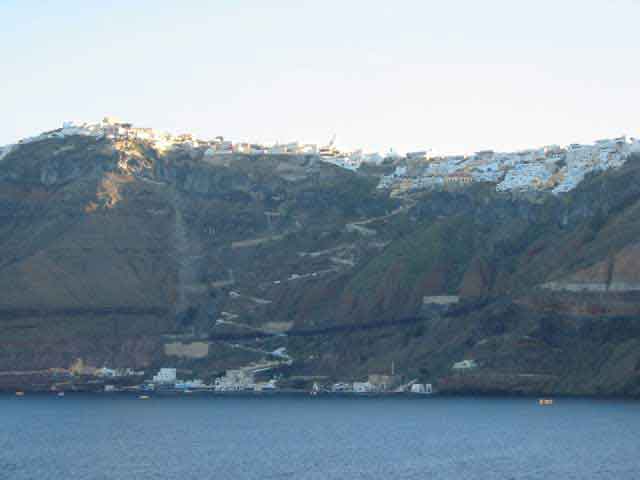
The brand new Blue Star Naxos was the first ferry of our trip to leave on time, just after sunrise. We cruised past the cinder cone in the middle and then past Ia out onto open water on a warm, sunny morning. Upon arrival on Paros we went to a travel agent who told us that the we could not get to Mykonos from Paros, those boats had stopped on October 31 but we could go via Syros on a daily boat. Also, there was a boat to Samos from Mykonos, so we decided to stay on Paros for Saturday and walk the Byzantine road and go riding. After the ride we stopped in at the travel agent and arranged the ferries from Paros to Syros, Syros to Mykonos and Mykonos to Samos. Sunday’s ferry to Syros was to depart at 5:45PM so we had some time for a good walk and to give the motorcycles a wash. Audrey even washed her own bike! The ferry was an hour and a half late so we ended up on Syros at about 9:00PM, looking for a place to stay. Ermoupoli, the main town, was quite lively, much more so than the other towns had been recently. Probably since it is the capital of the Cyclades it had a lot more local people as opposed to being dependent on the tourists. We found a loft for 30 euros and dragged our stuff upstairs. After a nice walk up the hill to the Catholic church on Monday morning we managed to check out and get to the high speed ferry a few minutes prior to departure. The high speed NEL lines ferry was laid out like an aircraft, with no outside decks and aircraft style seats. After a brief stop at Tynos we arrived on Mykonos at 11:30AM with an 11:05PM departure to Samos. This was plenty of time to explore the island on the bikes, having a picnic lunch on the beach, and then spending the evening wandering the main town. The Hellas ferry to Samos was about half an hour late and then we spent 20 minutes parking the motorcycles because some trucks had to be moved. Finally we got to our spacious cabin, without bunk beds this time, at about midnight.
Walking the Byzantine Road on Paros

The harbour at Ermoupoli on Syros
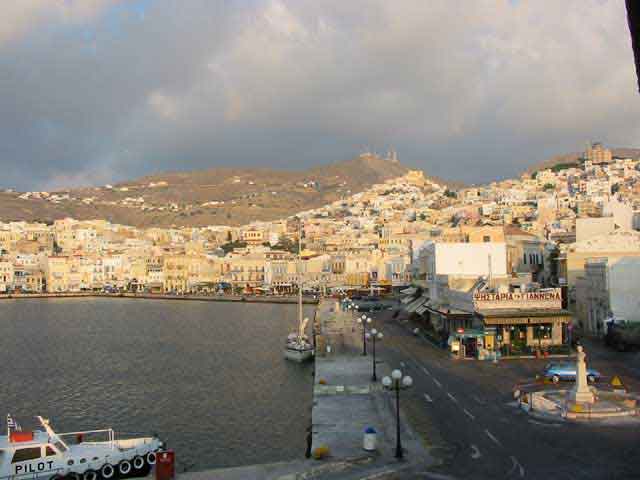
A beach on Mykonos

At 5:20AM a knock on the door woke us up to tell us we would be docking at Samos soon. Sitting on the harbour front at six in the morning we marvelled at how warm it was, stripping off our motorcycle jackets right away. At 8:00AM we went to a travel agent who told us we could not get the motorcycles from Samos to Turkey. So, time for another plan! The travel agent suggested we come back after 9:00AM and she would phone a travel agent on Chios to confirm whether the motorcycles could go from there to Turkey. The only place open for breakfast was a greasy spoon, the Marine Café so we had a couple of greasy omelets and passed the time wondering what we were going to do next. The travel agent confirmed that we could get our motorcycles to Turkey from Chios but the first boat to Chios left on Thursday morning at 4:00AM and the next available boat to Turkey left on Saturday morning, giving us a day and a half on Samos and also on Chios, all for a cost of 197 euros. So we booked a room for a couple of nights on Samos at the Hotel Emily. They didn’t go for the suggestion that we only needed one and a half nights since we had to leave at 3:30AM to catch the boat and therefore should get a discount. We also reconfirmed that we are not really well set up to do the hotelling thing. We had to drag all the items lashed to the outside of the bikes up four flights of stairs to get to the room. When camping, the motorcycles are right beside the tent for maximum convenience. The afternoon was spent trying to plan the next few weeks and watching a movie (Anna and the King in English with Greek subtitles) on TV. We also picked up a little shortwave radio and hoped to start catching the Radio Canada broadcasts.
Wednesday we rode around the island a little, exploring small roads and ending up at Pythagora. The Pythagorian Theorem may have been developed here but there were very few triangles in evidence. After a pizza back in Samos town we went to bed early to try and sleep, setting the alarm for 3:15AM. We woke up with the alarm and were at the docks at 3:45AM waiting for the ferry. It was an hour late, an hour we certainly could have used for sleeping. Upon arrival at Chios at 8:00AM we went to the Miniotis Lines ferry office and asked if there was a ferry departing for Turkey prior to Saturday’s 8:30AM boat. There was one leaving at 4:00PM that day! The bulk of the day was spent sitting in a coffee shop reading and writing with a motorcycle ride to go for lunch. We saw our boat pull into the harbour and dock right next to the main road. A ramp was lowered but because of the high swells it moved a lot, sometimes lifting the ramp right off the ground. How were we going to get the motorcycles onto something that was rolling and heaving that much? First we had to cross another hurdle, leaving Greece. At passport control the official asked where the stamps were in our passports indicating when we had arrived into the European Union. Our passports were completely blank because not a single border guard had stamped them, not when we arrived in Frankfurt, not when entering and exiting Switzerland, not going into and out of Slovenia, Bosnia-Herzegovina nor Croatia and not when we entered Italy at Bari. According to the official we needed to have stamps indicating how long we had spent in the EU, including our motorcycles, because after a cumulative total of 90 days we were required to have a residency permit. If the total exceeded 90 days we could be refused entry back into the EU. This seemed like a step backwards to us since it was possible to stay for three months in each of the EU countries before the union and now it was three months for all of them. In any case, he put an exit stamp into the passport and warned us to get stamps at all border crossings from now on. Another official then checked out all the papers for the motorcycles and logged that the bikes were leaving the EU into a big book. All this hassle made the boat 15 minutes late but they waited for us. We of course had more time to get nervous about that heaving ramp onto the boat. Audrey went first and had no trouble despite the boat rising almost a metre as she got on. Ekke went and also found it easier than it looked. The bikes were lashed down very securely because of the high seas and the small boat would of course move around a lot. Leaving harbour was not too bad but when on the open water it was very windy and there were some really large waves with spray cascading over the boat onto the open car deck. Fortunately the ride to Turkey was only an hour and we spent the time trying to figure out how we were going to make the rest of our trip work with a 90 day limit for the European Union.
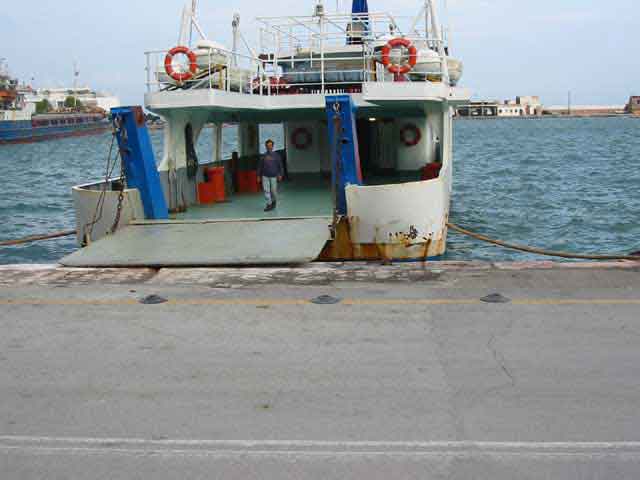
Map showing places visited in Greece
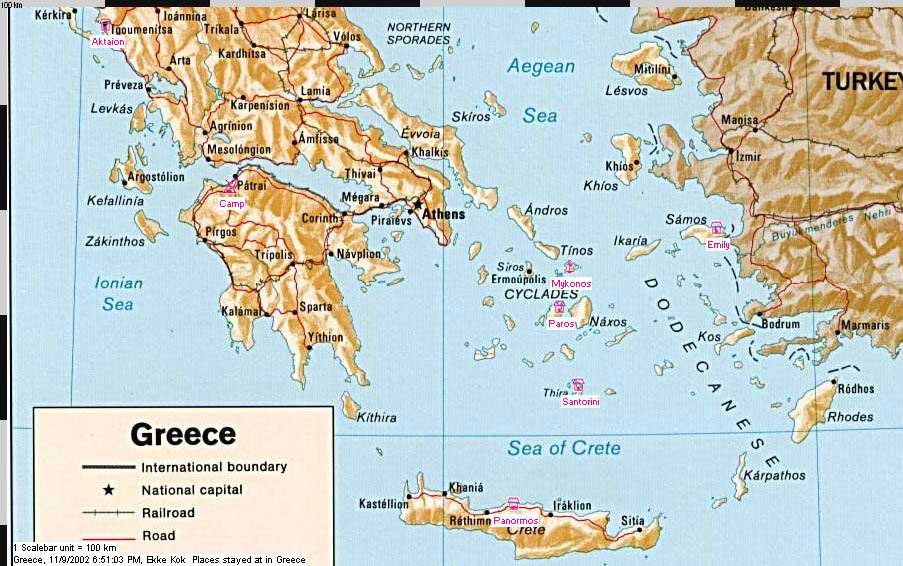
After a stormy night the power still wasn’t on and as a result we had no running water, but we did have a Turkish breakfast which consisted of bread, salty cheese, olives and honey. Then we were on our way to Selçuk and the Australia/New Zealand Pension where we had a reservation. The riding in Turkey was a real surprise with wide open roads and good road signs. Very little traffic made for good riding with the exception of a “short cut” through a construction zone which was 10 kilometres of slippery mud. We arrived in Selçuk covered in mud and with the help of a carpet salesman found the pension where 24 million lira included a double room with WC and shower, supper and breakfast. It had a real hostel atmosphere with travellers from all over the world. The proprietors were very friendly even though we arrived absolutely soaking wet from the ride in the rain. The pension also had a carpet shop and we were asked to come down and have a lecture on carpet buying, which we thought of doing later.
Ephesus was just three kilometres from town, so the next day we walked along a tree covered boulevard to get to the ruins. The ancient Roman city, which was the capital of Asia Minor, was abandoned when the harbour silted up. The ruined city was in very nice condition with the Library of Celsus being especially beautiful and the marble streets, with their underground sewer systems, were remarkably well preserved. We were even serenaded by a Japanese tour group testing the acoustics of the Great Theatre. While walking back to Selçuk we were caught in an awful lightning storm and were promptly soaked to the skin despite Audrey’s umbrella and Ekke’s little poncho. After supper we met Nick who was on his way to Syria and Israel on a KTM motorcycle. He was from Bozeman, Montana and had purchased the bike in Denmark all equipped for adventure touring. He regaled us with wonderful tales of his desert travels along with the story of a recent crash in Greece. He told us that the pavement had become extremely slippery when it got wet. When coming into a corner the rear wheel locked up, causing him and the bike to tumble down the road. A week of recuperation and he was alright again but we were made aware of how easy it is to have an accident, renewing our resolve to ride with caution.
The Great Theatre in Ephesus

Library of Celsus in Ephesus
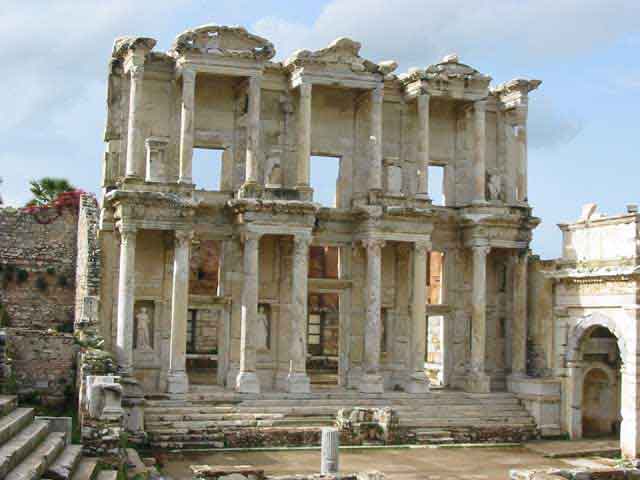
Sunday the 10th of November we tried uploading the Greece chapter of the website from ANZ’s computer but without success, leaving the website in a shambles. Because of the long time spent on the internet we were not able to have the carpet lecture either. As soon as we told the proprietors this, their veneer of friendliness promptly vanished. Leaving the hustlers of Selçuk we headed into the real countryside of Turkey towards Pamukkale. When stopping to pick up some lunch supplies at a small neighbourhood market we became instant celebrities with kids crowding around the bikes and the shop owners giving us free chocolate bars. Later we picked up some oranges at a roadside stand and were given extra oranges for free. After Selçuk, where we were constantly being harassed for everything, from buying a carpet or antique coin to shoe shines it was a pleasure to meet the real people of Turkey who were honestly friendly. When arriving in Pamukkale we had some idea of where to check for a hotel room based on Lonely Planet, but we were pursued by a scooter-riding maniac who owned a hotel. He said his rooms were 35 million lira and we told him that was too high so continued riding around town. He cut in front of us and forced us to stop whereupon his price came down to 25 million. We said that 20 million was our price and rode around him. He caught up to us again and said okay to 20 million. Unfortunately that night the mosquitos in the room were absolutely awful. It had never been this bad in the tent! Then at 3:15 AM the drums for Ramadan woke us up from a fitful sleep indicating that it was time to eat before the sun came up.
We decided to have the typical Turkish breakfast at a more reasonable time but we shunned the olives and the proprietor asked us why. We told him that we weren’t used to having olives for breakfast in Canada! When the rain let up we walked up the travertine terraces of Pamukkale and waded barefoot in the steaming pools. Then we swam in the hot pool amongst the ruins of ancient baths. That night we brought in our sleeping bags and zipped them up so that only our noses were poking out. Very claustrophobic and we still had mosquito bites all over our noses.
Steaming hot pools
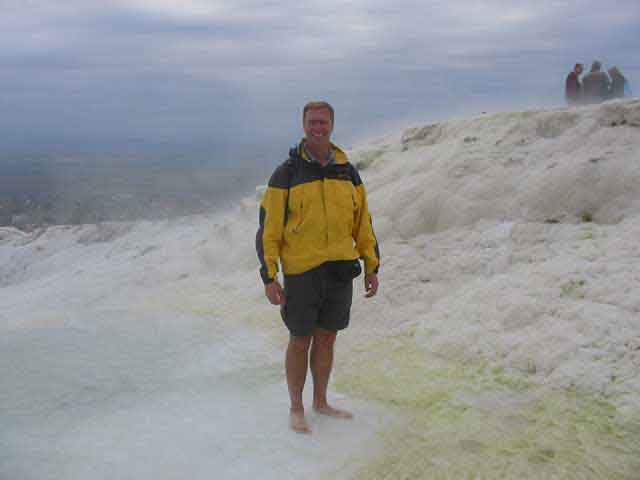
Swimming amongst the ancient ruins
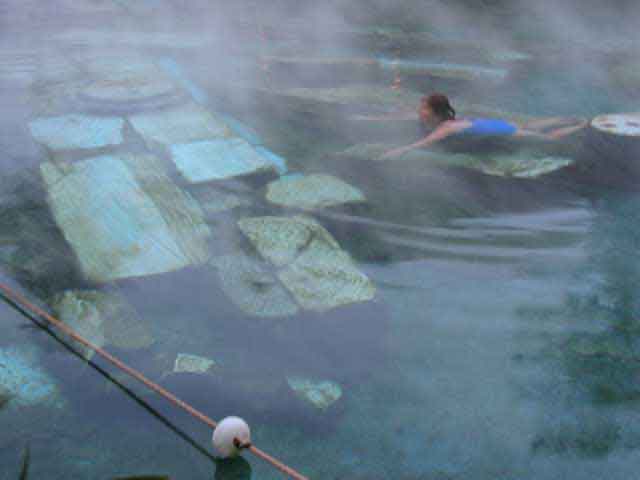
The travertine terraces of Pamukkale

The Ramadan drums let us sleep in until 4:00AM on Tuesday. We rode to Konya after breakfast, covering a distance of about 500 kilometres on the chilly, high interior plateau of Turkey, enjoying the wide open spaces. Those spaces became a little more crowded at one point when the luggage door of an approaching bus popped open. Out fell a sheep! The sheep pirouetted down the centre line of the road with the most stunned expression on its face as we rode by. Audrey watched in her mirrors and the sheep got up and looked okay, so we didn’t stop. Besides, what would we do with a sheep anyway? The driver of the car behind us must have known what to do because he turned around. Maybe he stuffed the sheep into the trunk of his car? How did the bus driver explain losing a sheep to the passenger? Was the passenger denied having the sheep as carry-on and therefore had to put it in as checked luggage? So many questions. Riding with an excess of renewed caution we descended into smoky Konya at dusk. The smoke was as thick as fog and made route finding even more challenging. No hotels appeared on the periphery so we headed into the centre of the large city. After looking at a few hotels we decided to opt for some luxury (after the mosquitos of the last two nights) and ended up at the three star Baykara for 75 million lira, including supper, breakfast and secure motorcycle parking.
A cool ride of about 270 kilometres took us to Göreme, in the centre of Cappadocia, the next day. The fairy chimneys, cones of volcanic tufa, looked absolutely stunning as we rode into town. We spent some time looking for a hotel or pension that had rooms cut into the rock. We ended up at the Sarihan Hotel in a cave room for 25 million lira, without breakfast, which was just as well as we were getting a little tired of salty cheese and olives. A trip to the market happily got us some Corn Flakes and milk.
Fairy chimneys of Göreme with rooms cut into the rock
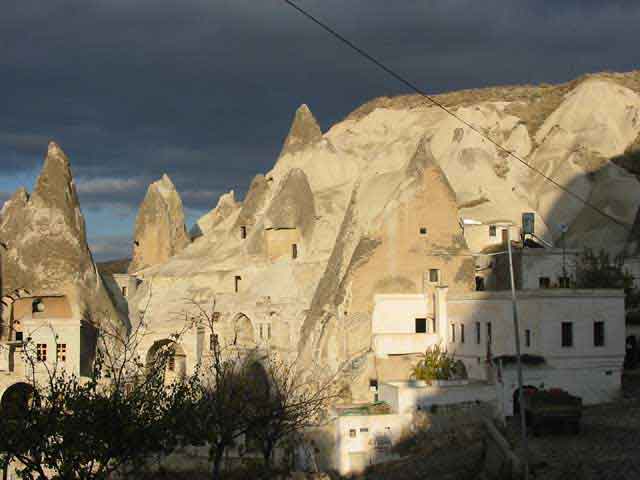
On Thursday we went to the open air museum with an entrance fee of 15 million lira. It had original cave dwellings and churches with their wal paintings on display. Early Christians had carved out the soft, volcanic tufa as places to hide from their persecutors. The Dark Church needed another 10 million lira entry fee which we declined, thereby missing the best preserved frescos. That afternoon we hiked up Pigeon Valley with its many cave dwellings. After taking a fork to the left we ended up in a box canyon which forced us back the way we came just as the sun was going down, drastically dropping the temperature.
A wall painting inside a church at the open air museum of Göreme

Fairy chimneys of Pigeon Valley
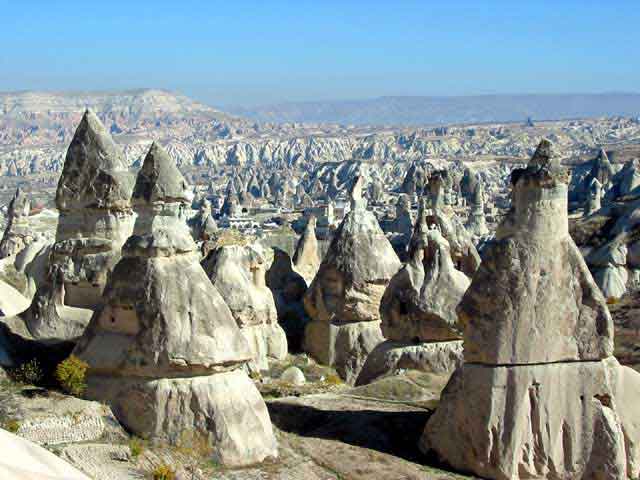
The next day we hiked Pigeon Valley again, attempting to get to the castle at Uçhisar. This time we took the fork to the right and met Mark, just out for a walk after an overnight bus ride from Istanbul. Originally from New Zealand, he was now working out of London where he made money for his travels as a Starbucks coffee trainer. We explored a number of box canyons before finally climbing out of the valley at a view point under the gaze of a tour bus group. We walked to the castle, carved out of a giant fairy chimney, and paid the 2 million lira to climb to the top, for a spectacular view of the area. After lunch in Uçhisar we thought we spotted a route back to Göreme through the valley. There were a few dead ends and sheer drop-offs but we managed to get back before dark. Mark was not able to join us for a hot chocolate because he had already lined up a night of all-you-can-eat-and-drink Turkish folk dancing.
We wanted to hike up the Ilhara valley, about 100 km away, but the prospect was a bit daunting as the mornings were too cold for riding and it was getting dark by 4:30 PM. While going out to get the day’s lunch supplies we asked at the front desk of the hotel about an organised tour and sure enough there was one leaving at 9:00AM by minibus. Once the price of gasoline and entry fees were added up it didn’t cost much more to take the tour, so we signed up. The minibus picked us up at the hotel and we were on our way. We stopped for a view of Pigeon Valley, though we had seen enough of it by then. From our guide, Serahp, we learned that the name Cappadocia means “beautiful horses” but we didn’t see any. Our next stop was the historic underground city of Kaymakli where people would live for months at a time if the village above ground was under siege. Ekke bumped his head three times and determined that underground life was not for him. He was brushing the tufa from his hair for the rest of the day. Arriving at the head of Ilhara gorge around noon we began a three kilometre hike along the valley floor. Churches carved out of the rock dotted the walls of the gorge. Some of the churches still had their original wall paintings. We climbed up more than 300 steps to have lunch at a restaurant perched on the edge of the gorge. Next we drove to Selime and the ruins of an ancient monastery carved out of the cliffs where we clambered around and enjoyed the views. On the way back towards Göreme we stopped at an old caravanserai on the silk road. The camel caravans would stop at the fortified caravanserai for protection from bandits and so the serais were spaced about 40 kilometres apart, the distance a camel could travel in a day. Smaller “hans” were built between the caravanserais in case a caravan got caught out after dark. We then boarded the bus to our final stop at a pottery making facility. After a demonstration of how the pottery was made one of our group had the opportunity to try his hand at it himself. Then the obligatory walk through the showroom, with only a little pressure to buy, before the bus ride back to Göreme. All in all a great day that would have been difficult to do on the motorcycles. Still, we prefer to leave the driving to ourselves as the bus driver gave us a few scares during the day, narrowly avoiding head-on collisions. That evening was spent boning up on our carpet buying strategy because a couple from the tour had told us that the best place to buy a carpet in Turkey was in fact in Göreme.
The tour group goes hiking in Ilhara Gorge

The next morning we headed to a carpet shop belonging to Mehmet, a fellow we had met in town a few times. We found a great carpet after looking at what seemed like hundreds, but it was wrinkled. Mehmet told us that it could be repaired but it would take a day. Since we were going to Istanbul anyway, he suggested that the carpet be sent there for our inspection before we bought it. The ride was very nice except for one homicidal truck driver who resented being passed and then tailgated Ekke. After Audrey passed him too we out-accelerated him and continued along the arid, gently rolling landscape. Finding an appropriate place for lunch was always challenging as it was Ramadan. We tried our best not to eat in public during the day in a country where 99% of the population is Muslim. But even when we had pulled far off the road three men in an old Renault came over to have a friendly chat with us while we were eating. After lunch we continued on to Ankara, the nation’s capital, which was even smokier than Konya. We were starting to pine for the clean air of Athens! Apparently most homes in Turkey are heated by wood stoves and even apartments were seen to be belching black smoke. Through the gloom we managed to find a hotel, near the centre of the city. 60 million lira got us into the Parliament Hotel whose glory years were probably a decade or two ago.
Monday morning we battled our way out through Ankara’s rush hour traffic onto the toll highway to Istanbul. The highway was even nicer than the autobahns of Germany. Great pavement and virtually no traffic had us cruising at a steady and comfortable 120 kph. It would have been great to have real road rockets instead of our overloaded touring bikes! A 2 million lira toll was very reasonable. We were looking at our map of Istanbul trying to find the best way into the Sultanahmet region, in the centre of the city, when a traffic policeman came over to offer his assistance. Since his English was as good as our Turkish his directions were of no help whatsoever, but at least he meant well. We ended up on a ring road around Istanbul crossing from Asia to Europe and when we had gone far enough around, we cut in. As can be imagined the traffic was pretty much insane. Audrey got cut off by a vehicle when she was only 2 metres behind Ekke! We made it to the waterfront and headed back towards Sultanahmet. Just a few minutes walk from the Blue Mosque we haggled with a desk clerk at the Albatros Hotel and got the price down to 45 million lira, including a buffet breakfast. The bikes were parked in front of the hotel, watched over by the staff, and we settled into a lovely corner room. We then took a stroll to the Blue Mosque and had the good fortune of being there at sundown just as people were breaking their daylong fast, sharing their picnics with one another in front of the mosque. Nearby, at the Hippodrome, booths had been set up with vendors selling everything from baklava and roasted chestnuts to copies of the Koran. There were rides set up for the kids and even a mechanical bull. It was great to be in this crowd, trying different foods, listening to music and just enjoying the atmosphere. This was the best part of visiting Turkey during Ramadan.
Breaking the fast on benches in front of the Blue Mosque at sunset

Tuesday we had planned to visit Topkapi palace but it was closed so we spent the day at the Grand Bazaar buying Christmas presents. Audrey was a fearsome haggler, saying “Allah!” whenever the prices were way too high and striking some good bargains. The next day we planned to visit Topkapi palace after a 10:35AM cruise on the Bosphorus. It turned out the cruise went all the way to the Black Sea where we were dropped off at about noon for an hour and a half. We had a nice walk up to a ruined castle on a hilltop after lunch. It was amazing how often we were getting “mistakes” on our bills. At lunch the bill included an extra salad and the prices for the Turkish pizzas were higher than on the menu. These “mistakes” happened with enough frequency that we were certain that it was just a gimmick to try and separate the tourists from their money. We learned to always check our bills before paying them. We returned to Sultanahmet at 4:30PM to find that Topkapi palace was of course closed, so we planned to go there for sure the next day. We wrapped Christmas presents in the hotel that evening.
A needed break from haggling at the Grand Bazaar
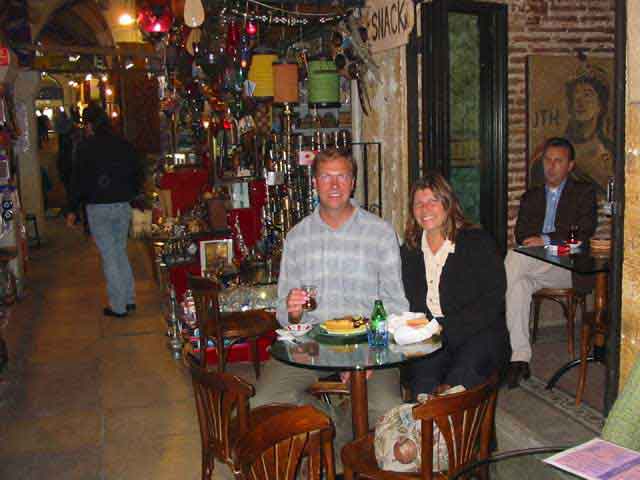
A cruise on the Bosphorus showing the bridge joining Europe and Asia

Thursday morning before heading to the palace we hunted down some boxes to mail the presents home and then packed them over a cup of coffee at McDonalds. The cost of mailing the parcels was actually less than the cost of the contents for a change. We tried to find the shop that Mehmet had sent our carpet to but it took a lot of walking up and down and phone calls to Göreme before we found it. The carpet looked good but of course the owner of this carpet shop had to try and sell us a carpet as well. By the time all was said and done it was 3:30PM so we headed straight for Topkapi palace, making it well before the 5:00PM closing time. The wealth of the Ottoman empire was amazing with beautiful buildings set amongst sprawling gardens with a view of the Bosphorus. A collection of priceless porcelain was housed in the former kitchens. Nearby were incredible gifts, such as a silver vase filled with silver sheafs of wheat and a large scale model of a temple in silver, given in celebration of the 25th anniversary of a sultan being in power. The staff started shutting the palace down at about 4:30 so we did not get to see all of the buildings before leaving at 5:00PM. We still had not been inside the Blue Mosque so we went there next. We were told by a “guide” at the front entrance that we could not go in because of Ramadan, but for 10 million lira we could go in if accompanied by him. Being slightly suspicious and not wanting to pay any lira we left him, went to the tourist entrance and sure enough the doors were closed. We decided to try and visit the mosque the next morning. Supper found us at the “world famous” Pudding Shop, apparently a hang out for hippies making the journey east to India in their VW vans a few decades ago.
Our carpet made it to Istanbul!

Inside one of the many buildings of Topkapi Palace

Before packing up the motorcycles at the Albatros Hotel we had a quick walk up to the Blue Mosque on Friday morning. We got in without a guide, saving a few million lira, and were amazed at the beauty of the building. We then packed up the bikes and headed west along the coast, out of Istanbul. Turkey had been an absolute delight to visit. The prices were reasonable and except for the gasoline, cheaper than Canada. The people were amazingly friendly and curious except when they were salesmen. The constant barrage of people trying to sell us something in the tourist places or in Istanbul was a bit wearing but we got used to it in the end. After all, we were viewed as the rich tourists with money to burn and relative to the locals we probably were rich.
Inside the Blue Mosque early in the morning
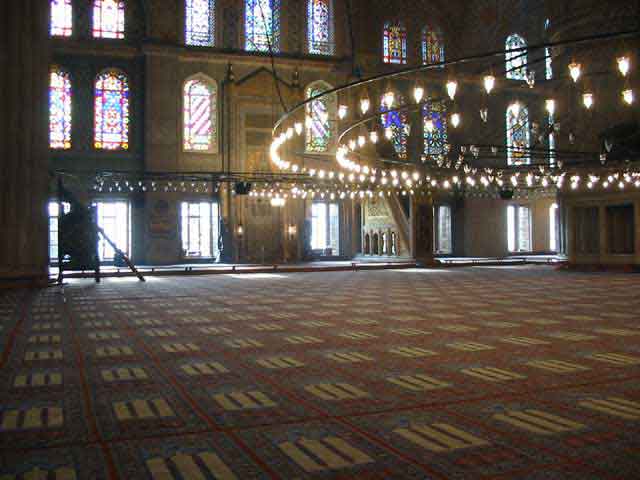
Map of our route through Turkey
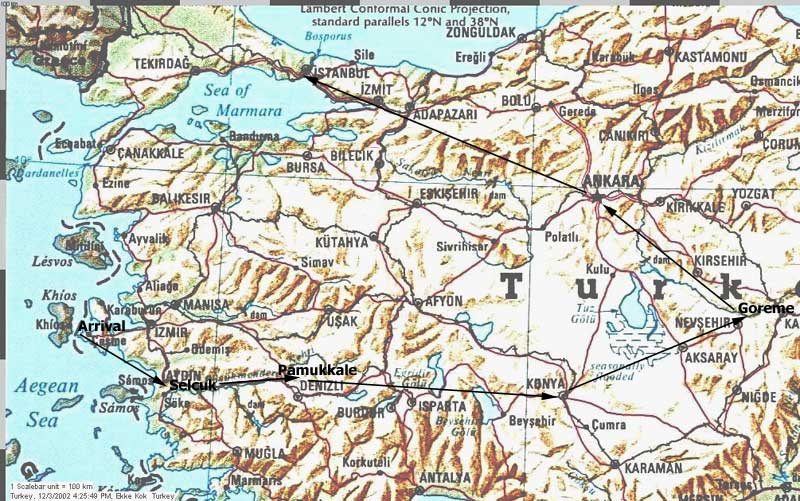
We got away early in the morning and tried to make good time on the road. Thessaloniki conspired against us though, since we got turned around for a bit in that city. South of Thessaloniki a toll highway allowed us to make up the time we had lost as we passed Mount Olympus. Ekke’s motorcycle had begun to run poorly at large throttle openings, such as used on the highway, so that was a bit unpleasant for him. In any case we made it to Kalambaka, near Meteora where Rizos Camping was open. On Sunday we visited some of the monasteries built on the wild rock formations around Meteora. The monasteries, built in the late 14th century, were precariously perched on top of sheer rock pinnacles. We rode to the Holy Monastery of Grand Meteoron and Monastery Varlaam and explored their frescoed chapels, historic kitchens and dusty wine cellars. Back on the bikes, we rode on the beautiful twisty roads looking at some of the other monasteries. Later Ekke tried repairing his bike with no success.
Monastery Varlaam
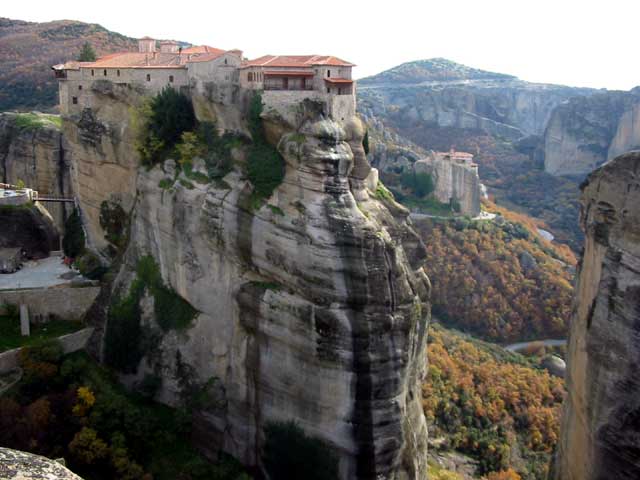
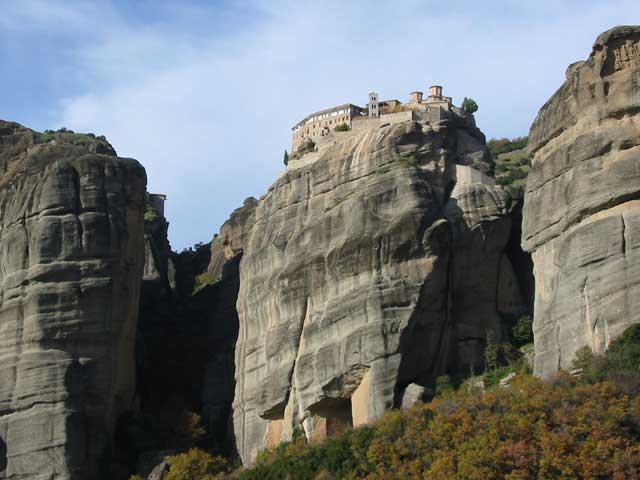
Since there was no ferry from Greece to Italy on Monday we stayed another day at Kalambaka, cleaning the bikes and trying to fix the GS. Tuesday we rode the mountain roads to Igoumenitsa to catch the overnight ferry to Brindisi, stopping for lunch in Ioannina. The road was terrific and Audrey even passed a police car over a double solid line, after he waved her on. The Blue Star ferry left at 11:30 P.M. but we managed to board at 9:30, weaving our way through the grid lock of trucks trying to load onto ferries. So we managed to get at least a little sleep in our cabin before getting out onto the high seas. Since we were the first to board the ship, our bikes were tucked into a far corner and we were the last to disembark. We took the autostrada from Brindisi, at the heel of the boot of Italy, to Taranto, at the arch, and then in a cold rain inland over the mountains near Potenza, to the shin at Sorrento. We checked out a campground west of Sorrento but they wanted 23 euros to pitch our tent in the mud so we left for Camping International I Pini where we found a grassy spot under a lemon tree.
At this time both of the bikes needed the regularly scheduled maintenance as well as some unscheduled repairs; Audrey’s F650 needed a chain and sprockets and Ekke’s bike still wasn’t running properly. On Thursday we phoned the BMW dealer in Naples and asked if we could bring the bikes in for service, but our Italian wasn’t good enough to determine if they could work on the bikes immediately. We decided to just ride over to the dealer and see. We rode along the coast of the Bay of Naples, past Pompeii, and into the most hair-raising traffic we have ever ridden in. From our map the motorcycle dealer was located near the waterfront on the other side of Naples so we were determined to ride along the harbour road as much as we could. We ended up in a massive traffic jam with cars and trucks crawling along taking up all the road space and scooters zipping through nonexistent gaps and on the sidewalk. We followed some vehicles onto the tramlines(!) running in the direction we wanted to go and ended up facing eight lanes of oncoming traffic at an intersection. What next? The few vehicles on the tramlines went straight across the intersection and continued driving down the middle of the road on the tramline so we followed. It was certainly strange to be riding beside people waiting for their tram! We made it to the dealer in one piece and very happy to have survived. With a bit of arm waving we communicated our service requirements to the staff and they agreed to perform the service by Friday afternoon, rather than the next week. After a terrific pizza at a restaurant near the waterfront, most of the afternoon was then spent getting back to the campground via the bus system in Naples and the Circumvesuviana train.
Friday we took the one hour train ride into Naples and strolled the narrow winding streets, looking for a book store. We were hoping to find an English language guide book to Tunisia since our Lonely Planet guide, Europe on a Shoestring, did not include it, but we had no luck. We went to the Museo Archeological Nazionale to view treasures from Pompeii, the Farnese collection of antiquities and the Secret Cabinet. The Secret Cabinet was available for showing only by reservation with a guide as it contained erotic Roman art. By the time we left the museum it had started to rain and it was getting dark, not ideal motorcycle riding conditions. Since riding in Naples was exciting enough without those two additional factors we decided to pick the bikes up on Saturday morning.
The Faun at the Museo Archeological Nazionale

Atlas

The next day we took the early train to Naples and rode from the dealership back across the city, in the direction of Pompeii. The ride was much easier on Saturday morning and the one-way waterfront road went in the right direction so we didn’t need to use the tramlines. Ekke’s bike was still not running properly, maybe even worse and Audrey’s saddlebag was hit by a scooter while in traffic. Fortunately the scooter’s passenger hit the saddlebag with her knee so Audrey’s bike was okay. We tried to avoid the toll autostrada but after riding for a couple of hours and only going 20 kilometres we were forced onto it anyway to get to the excavations at Pompeii. It took an afternoon to wander around the temples, theatres and bathhouses of the well-preserved Roman city. Villas filled with replicas of mosaics, frescoes and statues, much as they would have been 2,000 years ago, made it easy to imagine the grandeur that was Pompeii. While it was a privilege to see the original works of art in the museum, the replicas made the ancient city come alive. Pompeii’s sudden demise in 79 A.D. by the eruption of Mount Vesuvius must have been horrific as evidenced by the mummified remains of two people, their faces contorted in pain from the hot ash.
The Faun replica in Pompeii
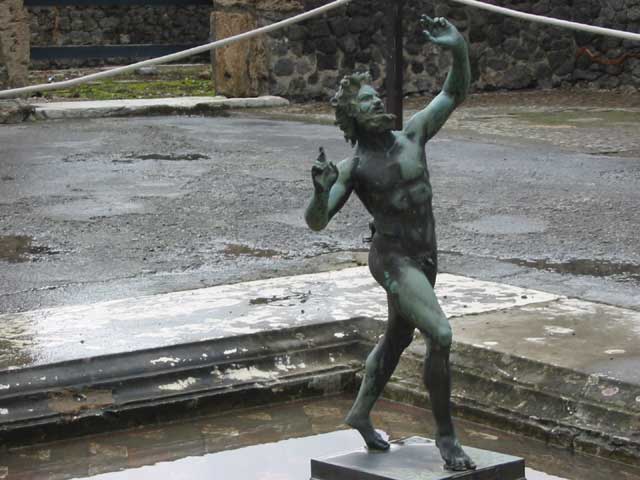
Mosaic floor at Pompeii
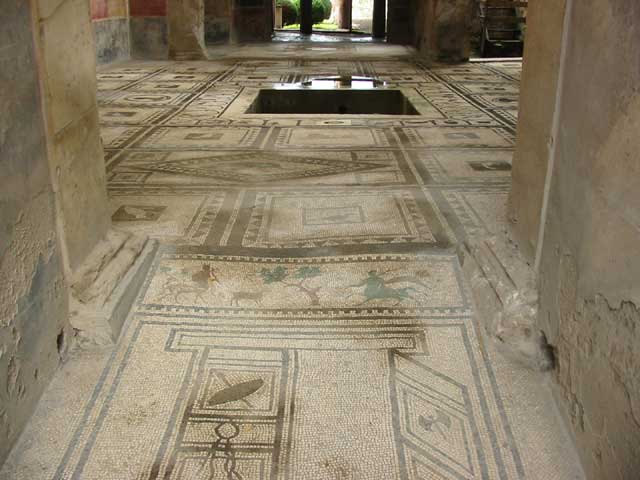
On Monday we rode along the Amalfi coast through Positano to Paestum. A helpful Moto Guzzi rider guided us through some of the confusing streets in Salerno. Paestum was the location of some of the most complete Greek temples in Europe. The temples were easily viewed from outside the fence so we didn’t go in and anyway there was only an hour to go before closing time. We wandered along the fence and then went to tourist information. They told us of the only open campground in the area, Villagio Dei Pini. We rode the short distance there and were pleasantly surprised by how nice the campground was and how close to the ocean it was too. We picked a good site under a light with a power outlet for the computer. Tuesday we stayed at the campground and worked on the Turkey chapter for the website. Heading south on Wednesday we got on the highway and were making fairly good time but it didn’t last very long. We were diverted from the autostrada by a construction detour which led us through a village and eventually to a bridge closed for construction! We turned around and followed another vehicle up into the hills where we picked up a road heading in the right direction. This road was actually very entertaining, meaning that it was slow and twisty, as it meandered through all the small villages. Back down to the coast the views were incredible and as dusk fell we entered Tropea, about 340 kilometres from Paestum. As usual, Italian villages are difficult to navigate and while we were pulled over to the side of the road, trying to figure out how to get to the campground, Francesco Stefanelli stopped by. He was the author of a guidebook for the area and wanted to help us out. After giving us an autographed copy of his book, we followed him to the campground, which was technically closed. Francesco talked with the owner and we were set up for the night, with our tent under the shelter of the closed restaurant, right on the beach.
Greek temples at Paestum
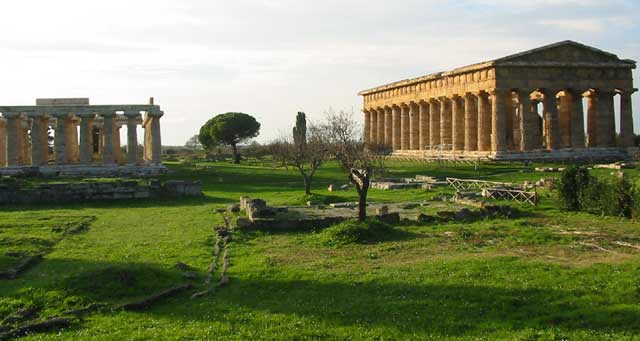
We left on December 5 after paying five euros for the camping and the owner of the campground showing us how dirty his car was from the ash of the Mt. Etna eruption. As we rode further south along the coast, we could sometimes see a black dust stirred up by another vehicle. Just a few kilometres from the port for the ferry to Sicily, without warning, the coast road was closed due to a mudslide. We had to backtrack several kilometres, up switchbacks through a large town and then take the autostrada to the ferry terminal. After paying five euros each we loaded onto a ferry for the half hour crossing to Messina. Our exit from the port city was very slow because of the heavy traffic and the lack of road signs. Not wishing to pay the toll on the autostrada, it took us a couple of hours to go down the coast to a camping spot near Giardinni Naxos. The closer we got to Mt. Etna, the thicker the black ash became, covering everything. Riding through Giardinni Naxos we could see people hosing down their cars and sweeping the sidewalks.
In the morning a thick layer of ash covered the tent and motorcycles. Sidewalks that had been swept clean the previous day were once again black with ash. Then it started to rain. The ash was like sand so that it didn’t absorb water and turn into mud but it made a mess nevertheless. As it was December 6, Ekke checked his shoes and he must have been good in the last year because Sinterklaas had left a jar of Nutella and a can of Fanta! In the afternoon we went into Giardinni Naxos to look for an internet place. While waiting for the internet shop to open after the usual afternoon siesta when most of Sicily shuts down, we went into a café and watched music videos. While we were there, a tremendous downpour soaked everything and the streets were running with ash from the roofs and sidewalks. After checking e-mail and doing our banking on the internet, we went for groceries and then back to camp. Riding in the dark and in the rain is challenging on a motorcycle at the best of times, as there aren’t any windshield wipers, but when the road is covered in black ash and you don’t want to wipe your faceshield for fear of scratching it, it becomes a nightmare. Fortunately it was only three kilometres back to camp and we made it safely.
The next day we got the laptop hooked up to the internet and downloaded the updates necessary to keep everything running smoothly on the computer as well as uploading the Turkey chapter of our website. Then we went into Taormina and visited a Greek theatre with what must be the most spectacular view of any theatre anywhere. The backdrop of the stage had been destroyed and the remnants of the backdrop framed the smoking Mt. Etna. That evening we watched Mt. Etna spew molten rock into the air from a nice safe distance of 25 kilometres, at our campground.
Mt. Etna from the theatre at Taormina
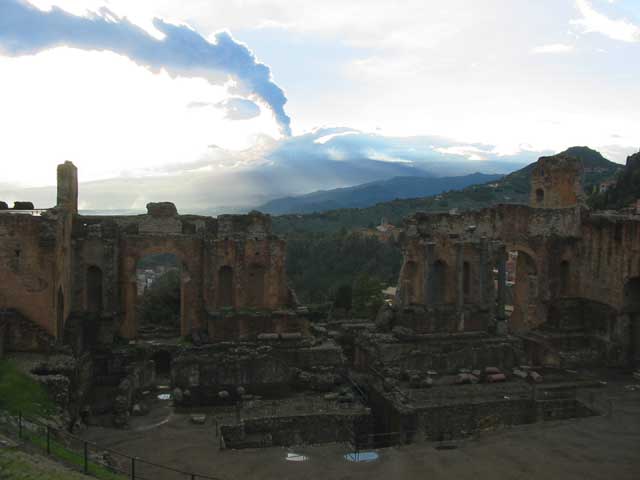
On Sunday we decided to get a little closer to the volcano. We intended to ride to Nicolosi, as far up the mountain as traffic was allowed to go with the recent eruptions. Somehow we got a little turned around and climbed the mountain from the other side, not finding Nicolosi. We continued up the mountain road, going higher and higher. The road had less and less traffic and more and more ash. Soon it became apparent that the ash was covering a layer of snow and ice as we had climbed above the snow line. About then it started to snow. The riding became very challenging, riding in the icy ruts, and Ekke almost dropped his bike. Somehow we made it to Rifugio Sapienza, as high as it was possible to go by road and where a cable car used to run further up the mountain. The cable car was shut down due to the eruptions. The road must have been opened very recently as the tourist office in Taormina had told us the day before that we could only go up to Nicolosi yet according to a sign Nicolosi was 19 kilometres away, down the other side of the mountain. When we parked the bikes, we noticed that steam was escaping from cracks in the rock. The ground was warm to the touch and along with the booming coming from higher up the mountain, it made us a bit nervous. There were quite a few people at the closed rifugio, some of them hiking past the “Dangerous to pass this limit, craters with unjareeable explosive activity” sign. We didn’t stick around too long, since it would be dark soon and riding a mountain road on a live volcano, in a snowstorm, on an ash-covered road, in the dark, might be pushing our luck just a little too far. We headed down the mountain in the direction of Nicolosi but stopped in the parking lot for a restaurant to see if the volcano was visible and it was. The road down this side of the mountain was much easier to ride, so we felt a little more comfortable waiting until dark to view the eruptions. When the clouds parted we knew we were very lucky to see the magma being hurled into the sky from a distance of only a couple of kilometres. The great sheets and pillars of fire were truly magnificent. We didn’t want to tear ourselves away from the scene in case we missed something, but we had to go back to camp. At least it had stopped snowing. After the usual confusion of riding through an Italian village in the dark we came down the mountain and it got warmer but the traffic got busier until we were stuck in a traffic jam, on a Sunday evening at 7 P.M. People were dressed in their fine clothes and walking the streets of the towns. It looked like they were doing their Christmas shopping, with all the stores open and the streets and shops decorated for the holidays.
Riding up Mt. Etna on snow and ice covered by ash
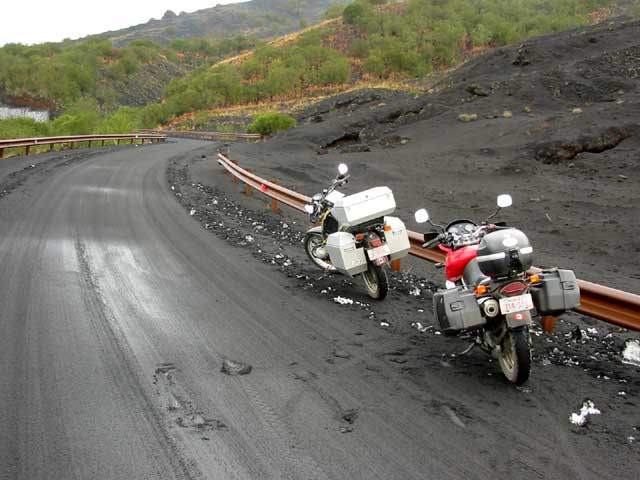
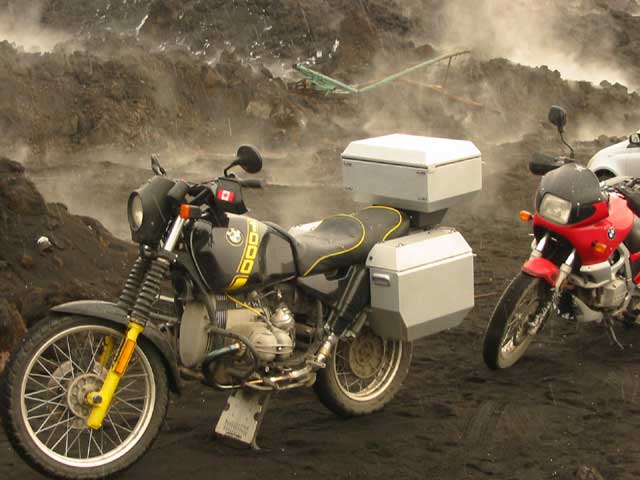
Riding down the volcano
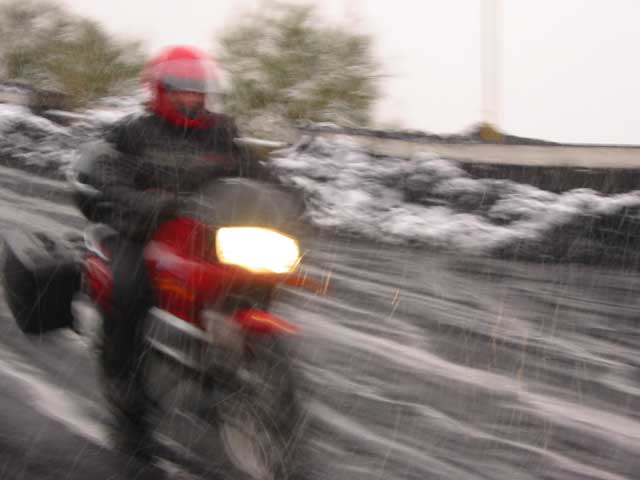
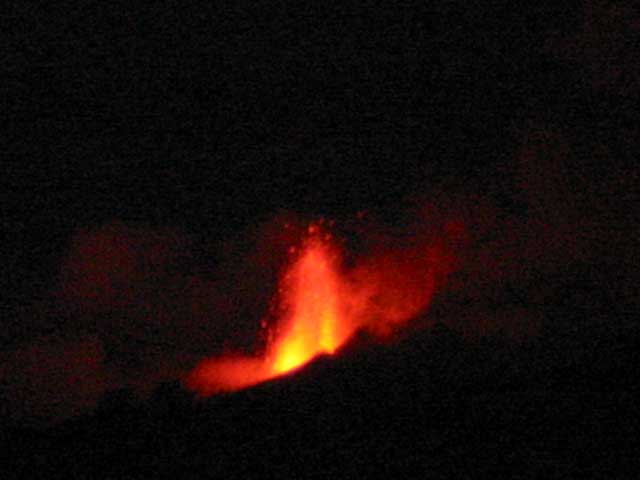
Monday we went looking for a travel agent to book our boat to Tunisia. When we finally found one that could help us we learned that the boat had left that morning from the other side of Sicily! The next boat was an overnight ferry on Saturday and the one after that left on the following Monday morning. Since the Monday boat was 100€ less expensive, we opted to stay on Sicily for a week. Back at camp we talked with our neighbours, Zoe and Francois, from Quebec. Zoe was a puppeteer in Canada and so was very interested in the traditional Sicilian puppet shows. She had found a place that was having a special showing on Tuesday and we invited ourselves along. The next morning we followed them to the Opera dei Pupi in Acireale. The show was incredible as it told the story of Charles the Great and his knight Roland doing heroic battle with barbarian giants, Arabs, serpents, and a smoking dragon. The puppets were about a metre tall and made of wood, operated by long metal rods. There were many fight scenes and the puppets were made to attack one-another with a terrible racket, a couple of the bad guys were even decapitated. This wasn’t exactly the puppet shows that we were used to at home with Rusty and the Friendly Giant or Casey and Finnigan. After the show, when the puppeteers came forward to demonstrate how it was done, they were covered in sweat. The puppets were quite heavy and the battles were hard work!
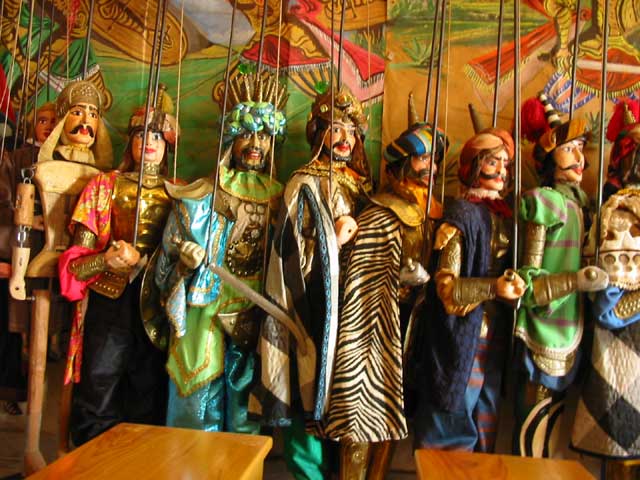
After saying goodbye to the other campers on Wednesday morning we got on the autostrada and headed toward the other side of the island. We rounded Mt. Etna and rode inland to Villa de Casale, a ruined Roman villa, at Piazza Armerina. Touring the villa, we were treated to the most amazing mosaics we had yet seen. They were very well preserved so that it was easy to imagine how the villa must have looked in its heyday. It was also a joy to be out of the ash of Mt. Etna and riding through the green fields of the interior! Since there were no campgrounds in the interior of Sicily we continued on to Palermo. We knew there was a campground open, 10 kilometres west of the city, in Sferracavallo. Stuck in a traffic jam at a construction site in Palermo we noticed a BMW dealer on the corner. Since Ekke’s bike still wasn’t running properly we decided to pay them a visit the next day.
Bikini Girls at Villa de Casale
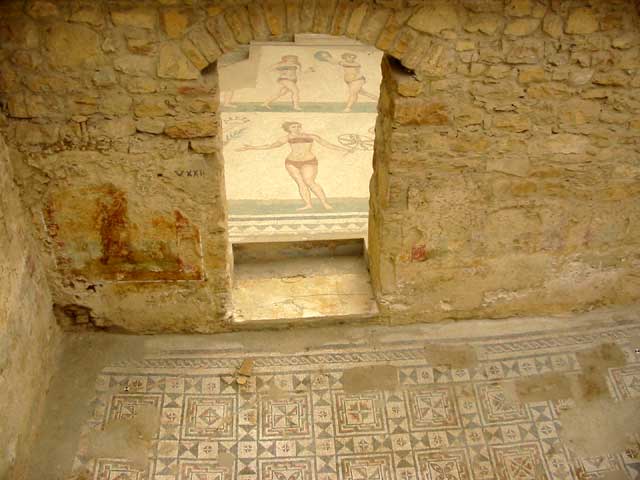
When we showed up at Elauto BMW Ekke tried to explain the problem with the bike using his hands since no one spoke English. To ascertain the problem a mechanic came from the back of the shop and, after strapping a “Prova” licence plate onto the GS, blasted out of the service area into the alley. He returned a few minutes later and indicated he knew what the problem was. He cleaned water out of the carburettor float bowls and pronounced the bike fixed. Since Ekke had already tried that, he didn’t believe the mechanic and suggested he take it out for another spin. After the mechanic came back again, he agreed that it wasn’t repaired and the shop foreman indicated the bike would be ready by 5 P.M. This communication was only possible because a Harley owner with a smattering of English from the shop next door came over and helped. We hopped on Audrey’s bike and headed back to camp. Ekke soon pronounced it unrideable because the steering head bearings were excessively worn so we returned to the shop and asked if they could fix the F650 too. They could have it repaired by Friday so we left the F650 there and walked around Palermo for the afternoon, returning at 5:30 P.M. The GS still wasn’t quite ready but we met a customer, Pierfrancesco, whose English was excellent and he helped with the translations. He also gave us some tips on things to see in the area as well as in Tunisia. He would soon be off to Peru to ride his motorcycle for a couple of weeks and visit Machu Picchu so we wished him well. Since we were now without transportation, we asked how to get to Sferracavallo by bus. It turned out that the mechanic from the Harley shop next door lived there and was more than willing to give us a ride when he finished work at six o’clock. We went straight from the shop into the traffic jam at the height of rush hour, crawling a hundred metres in a half hour accompanied by a cacophony of horns. When we cleared the jam, it was interesting to be riding with an Italian, even in a small station wagon, on the autostrada. Both of us hit imaginary brake pedals a couple of times on the ride home.
On Friday we took the bus in to Palermo and walked around the city, still looking for an English language edition of Lonely Planet’s Tunisia guidebook. We had no success with the book but Palermo was a fascinating city to walk around with its varied architecture and for us it was a real treat to be out in our shirtsleeves at Christmas time. The city was beautifully decorated for the holiday season. There was even a red carpet of Poinsettias leading up the steps of the opera house. We returned to Elauto BMW at 4:00 P.M., picked up the bikes and headed home. Unbelievably the GS was still not running properly! On Saturday morning we went straight to Elauto but the shop looked closed. Around back, the door was half open so we went in, where the foreman indicated the shop was indeed closed and they were just assembling F650 police bikes that day. Ekke told him that we were headed for Tunisia on Monday morning so the foreman got the mechanic from the back to have a look at the bike. After a test-ride the mechanic did a quick carburettor adjustment and pronounced it well and truly fixed this time. Ekke handed him a Milka chocolate bar for his troubles and we left, looking for somewhere that had internet access. In a few blocks Ekke could tell that his bike was finally running okay. We stopped at a computer shop to ask directions and the woman at the counter told him to wait for a minute while she consulted a colleague. Several minutes passed, with Audrey sitting in the middle of the street on her bike and Ekke waiting. Just as he was about to leave the woman said that the internet was almost set up, right upstairs! It turned out that they also did computer training and they put us in the classroom. Afterwards there wasn’t even a charge for the use of the internet so we bought some CD-Rs to at least give them some business.
A carpet of Poinsettias at the opera house in Palermo
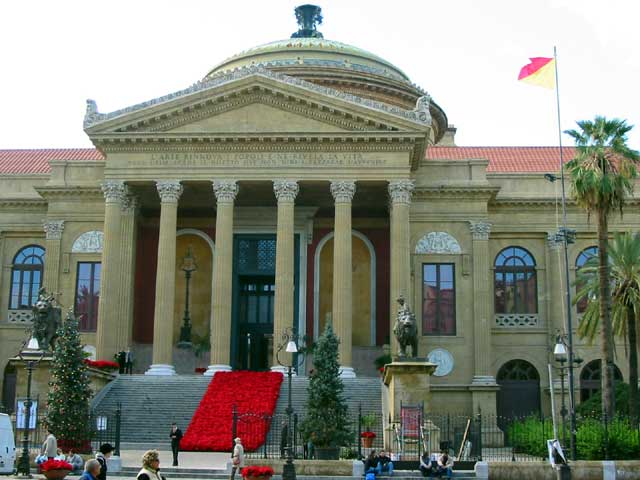
Sunday was spent preparing for our early Monday morning departure to Tunis. Ekke worked on the stove since it had been acting up lately and Audrey did a little sewing. The boat to Tunis was scheduled to leave Trapani, 100 kilometres away, on Monday at 10:00 A.M. but we were to check in at 8:00. Since it was pretty much autostradas the whole way, we thought 7:00 A.M. would be a reasonable departure time. We informed the campground host on Sunday evening of our plans and he indicated the camp gate, normally closed at night, could be opened by pressing a button. After a quick breakfast on Monday we pulled up to the gate at 7:10 A.M. but it was padlocked. We pressed the button he indicated but nothing happened so we started honking our horns. We really didn’t want to miss the once-a-week ferry! Finally the host came out and told us to relax while he took his time opening the gate. After that we made very good time on the autostrada and only got turned around in Trapani once, getting to the docks a little after 8:00 A.M.. We were glad that we had looked at the tickets to see what the name of our boat was, since we could not see any signs or directions near the docks. We saw the “Toscana” and just rode in the direction of the boat to find the check-in office. A little more confusion about getting the passports stamped and we finally got on the boat. The best part of waiting for a couple of hours prior to departure was seeing what Tunisians were bringing back from Italy. Cars had everything imaginable strapped to their roofs, from refrigerators and kitchen sinks to scooters. Twenty minutes past the scheduled departure time a rental van pulled into the parking lot and people started hauling all kinds of stuff onto the boat. They were rushing around and in their panic dropped a new scooter. To top it off, the customs officials demanded all the necessary paperwork for the scooter and did a full inspection of it. As a result, our boat left 45 minutes late.
Bringing supplies back home to Tunisia
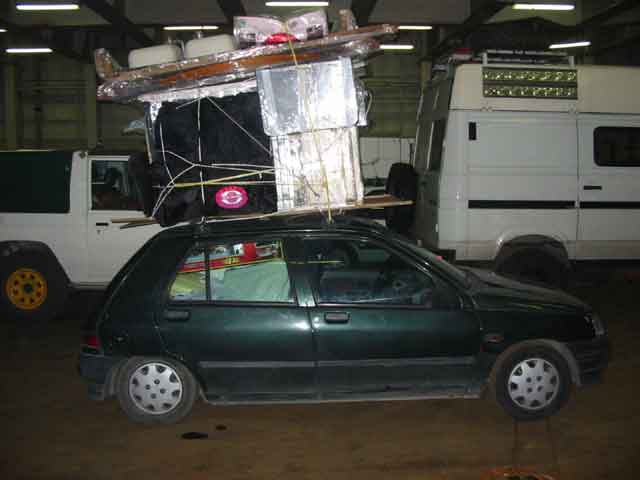
An uneventful eight hour cruise, most of it spent on an outside deck, had us landing in Africa at about 7:00 P.M. We tried to get ahead of most of the overloaded cars so that we wouldn’t have to wait in customs too long. This worked fairly well but the run-around getting all the proper paperwork stamped still took an hour. At one point we were directed to stand in a line at one side of a booth to get a stamp. When that was done, we were then told to line up at the other side of the same booth for more paperwork. Another confusing thing was that the officials in uniforms were not helping in any way but there were a large number of people in orange suits, which looked for all the world like prison outfits, who were very helpful. They directed us where to line up and we could see them unpacking cars and re-packing them too. After we were finished, the guys who had helped us came over and asked for a tip of 20 dinar while furtively looking over at the officials in uniforms. We had just converted 50 euros to about 70 dinar so knew that 20 was a lot of money. We offered one dinar which they refused to accept and went over to a motorhome with German licence plates instead. One more passport check where we turned in some of the papers we just had stamped and we were riding in Africa! Our friend from Palermo, Pierfrancesco, had suggested a couple of nice hotels in Tunis so we looked them up. They looked a bit above our budget, what with the four stars and everything, but the Conrad was full anyway. The doorman from the Conrad showed us to the Excel where a room was available for 70 dinar per night, including breakfast. We took it and after unloading the bikes and parking them in a secure parking lot we walked up Avenue Habib Bourguiba, having a bite to eat in a self-service café. The boulevard was beautiful with little traffic at this hour and the generous sidewalks were crowded with well-dressed people. The boulevard really reminded us of Ave des Champs Élysées in Paris. Returning to the hotel, we made plans for the next morning to go to the tourist information office as well as checking out some book stores for a Lonely Planet guide to Tunisia in English before heading south toward the Sahara.
Avenue Habib Bourguiba in Tunis

Istanbul to Tunis

Roman aqueduct outside Tunis
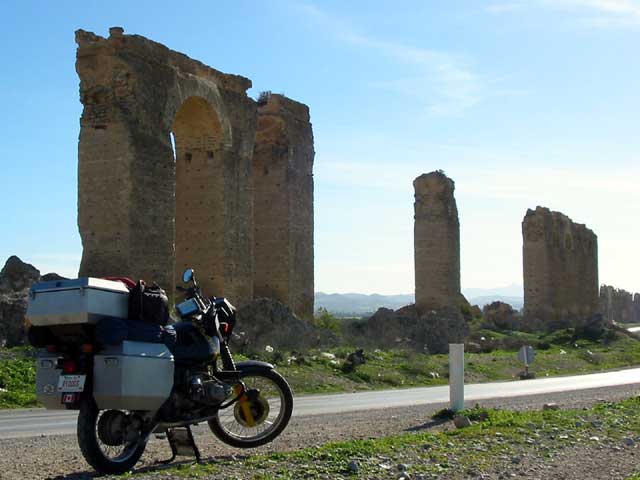
A French couple we had met in a campground near Dubrovnik had recommended a campground near Tozeur, at El Hamman de Jerid, called Desert Club so that was the day’s destination. The ride from Kairouan was great, with the landscape becoming progressively more arid as we rode south. Eventually we were riding through the desert, not too far out of Tozeur, when we saw a small herd of wild camels. They were just wandering beside the road, out in the middle of nowhere. At times like this we needed to pinch ourselves to confirm that we weren’t dreaming! When we arrived at Desert Club, we thought it a bit basic for 12 dinars per night but at least it had hot showers. The small town of El Hamman de Jerid was an oasis and we walked into town to get our supplies. There were no supermarkets of course, just small, hole-in-the-wall shops. We checked out each of the four stores, but the system for obtaining goods was not set up very efficiently for foreigners. The shopkeeper stood behind a counter with the goods on shelves behind him. We couldn't tell him what we wanted to buy, since we didn't speak Arabic, so we ended up pointing at a number of cans before getting our tomato paste and peas. After supper it was pleasant to sit out under the palm trees but it cooled off very quickly when the sun went down.
The desert near Tozeur
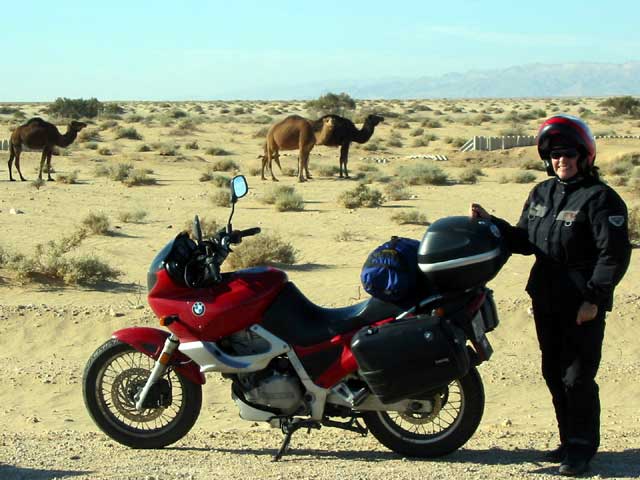
Desert Club camping

Thursday we rode the short distance into Tozeur and parked near the place where caleches were kept. We hired a caleche to give us a tour of the palmery as well as the medina. More than 200,000 palm trees make up the Tozeur palmery. The driver gave us a bit of an explanation of the palmery, how it was built and so on but his English was about as bad as our French and we didn’t get much out of it. He did take us to a group of workers picking dates, where we could watch them work and then sample some of the freshly picked dates. Next he took us to the old city centre, the medina, where another tour guide took over. Fortunately his English was reasonably good and we could understand the tour. Most fascinating, and probably not possible without a tour guide, was going into a house being renovated. The contractors were hard at work rebuilding the house so we could see the construction methods used here. After the caleche tour we looked at a tourist map and decided to walk to the botanical gardens in the palmery. Unfortunately, the map was not to scale and we walked for an hour when we had expected to walk for fifteen minutes. Many of the flowers were still in bloom, even some of the roses! Also, at the botanical gardens was a zoo of desert animals. Here were camels, ostriches and lions in small cages. There were guinea pigs as well, something we did not normally think of as wild animals, but they are apparently indigenous to the area. Audrey had the pleasure of having the zoo keeper put a lizard on her arm and head and then later a batch of snakes around her neck. Ekke opted out of this kind of fun. After this, we started, what we hoped, would be a shorter walk back to town around the other part of the loop. A caleche was waiting outside the botanical gardens, having given a ride to another couple visiting the garden, and the driver offered us a ride. We declined but he was persistent so we said we would pay five dinars for a ride with no tour. He scoffed at this low amount but when we walked away he chased after us and agreed to the five dinars. Since he wanted to get back to give the original couple a ride, he gave the horse the whip and we raced back to town. Even with the fast caleche ride it took quite a while to get back to where the motorcycles were parked. Being glad that we had not walked, we tipped the driver and told him to give the horse some extra oats. The poor creature was in a real sweat. We then rode out to a view point to watch the sun set and rode home in the dark. While cooking dinner, the stove quit and our attempts to repair it were unsuccessful. There always seems to be a challenge when travelling!
Caleche ride through palmery, statue of mathematician who devised the irrigation system
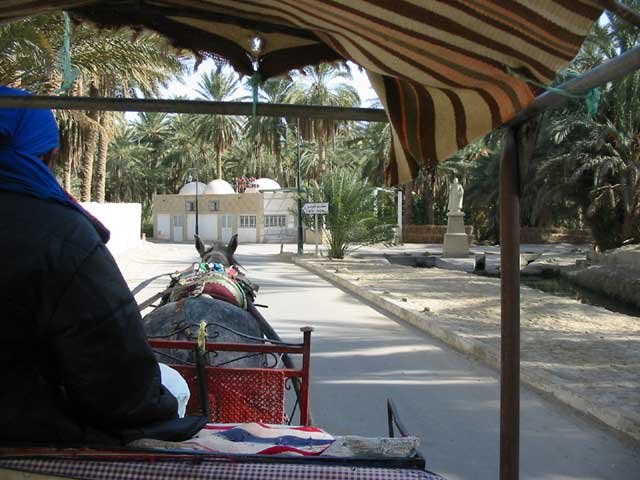
Lizard display
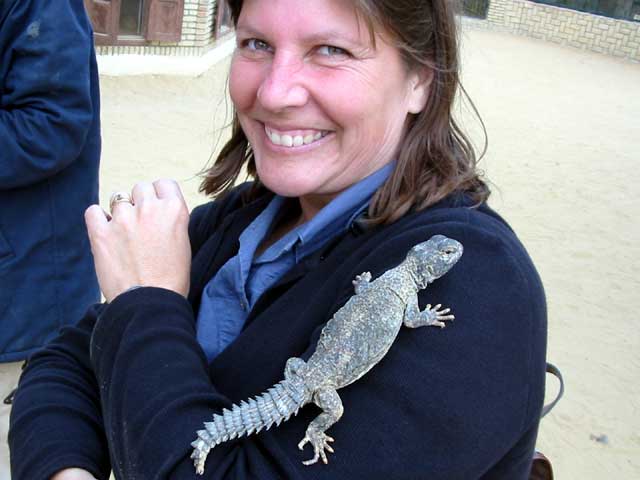
Snake charmer
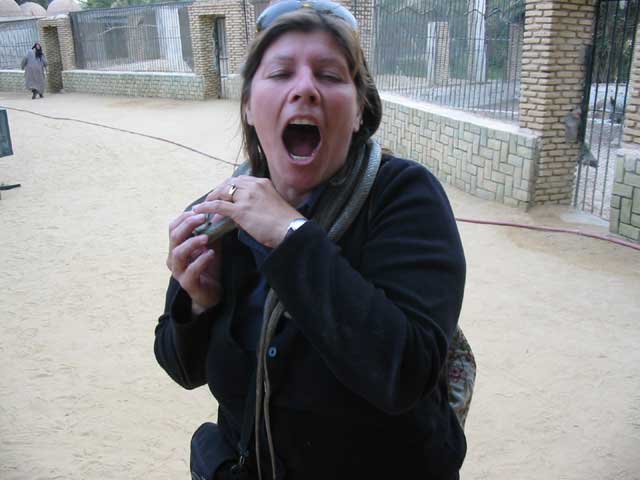
On Friday we headed across a dry lake, Chott el Djérid, to Douz. The road was arrow-straight for a forty-kilometre stretch and we imagined it would be terribly hot in the summer crossing the salt flats. Getting close to the small town of Douz, we found that there was more and more traffic because the International Festival du Sahara was taking place. It was really fortunate that the festival was on when we were there as it normally happens later in December. We found the campground, which was located on the edge of town, and that evening strolled around and looked for an inexpensive restaurant. This gave us the opportunity to try some of the local specialities, such as brik à l’ œuf, an egg wrapped in flaky pastry and ragoût, a hearty stew made with couscous.
Chott el Djérid

A parade was scheduled for 9:00 a.m. Saturday and despite wandering the main streets of Douz for half an hour and inquiring at the festival office, we didn't find it. We decided that this was then the perfect time to go for a camel ride in the desert. For ten dinars each we got a one hour ride into the dunes of the Grand Erg Oriental. It was a strange sensation to be bobbing around so high up in the air. Jimmy, Audrey’s camel, was entered in the endurance race on Sunday so she had to take it easy on the animal. In the afternoon we went to the stadium, outside of town, for the show. The place was very busy and crowds of people were waiting to get in. Oddly enough, a security guard took us to the front of the crowd and then ushered us in while everyone else was held back. We wondered if this was some form of favouritism shown to the European visitors. In any case, we spied a couple of places available at the top of the grandstand, with a perfect view of the events. After a short delay the show got under way with camel fighting, camel racing, folk dancing and a slugi demonstration, where a greyhound was set after a live rabbit. An announcer gave some commentary in French and English but another announcer shouted at the top of his lungs in Arabic over the loudspeaker system. This was truly deafening and of course we didn’t understand a thing. The camel racing was not as straightforward as we thought it would be. The camels were not very cooperative, so there were quite a few off-course excursions and the riders needed assistance from helpful bystanders to coax the unruly beasts across the finish line. Afterwards we went to a temporary souk set up for the festival and had magroudh, honey-soaked semolina pastries filled with date paste, and bought some souvenirs. We planned to go to the campground restaurant for supper but it turned out that it was necessary to make reservations, otherwise the restaurant would not be opened. It was a good thing we had some treats at the souk!
Jimmy takes a rest before the endurance race on Sunday
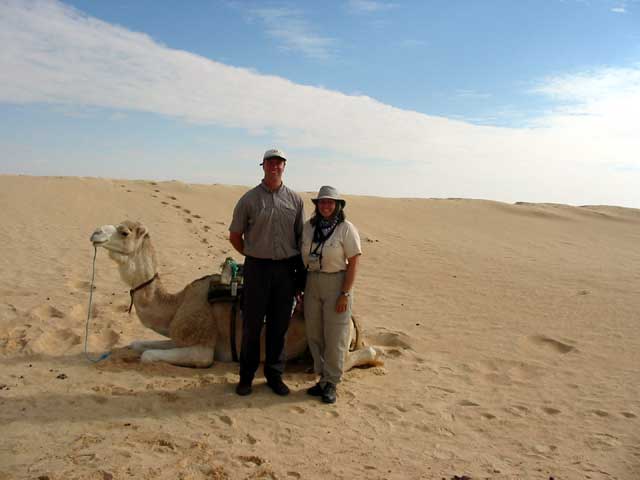
Camel racing with the Grand Erg Oriental in the background
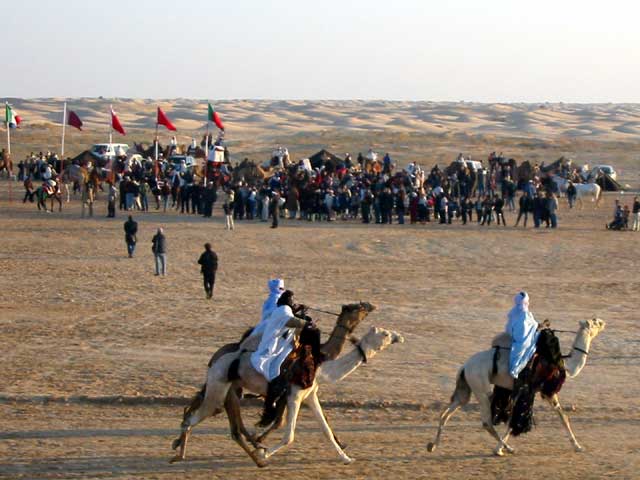
Folkloric dancing

Girls dressed for the traditional Tunisian wedding ceremony
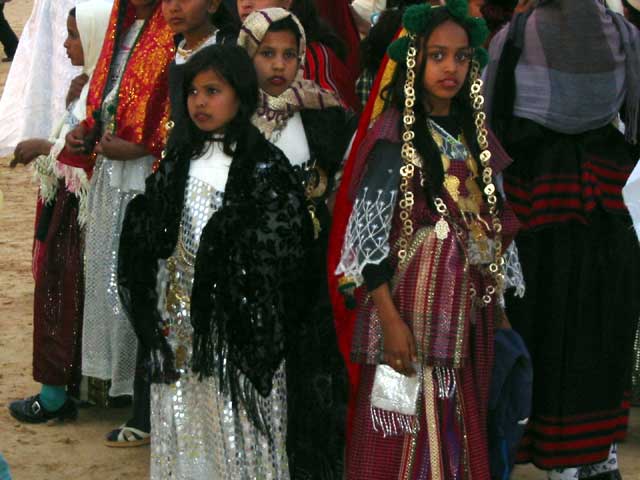
We had a choice of two ways to get to Matmata on Sunday; either we could take the short cut, over 96 kilometres of desert track or we could go over 200 kilometres of highway. Since Audrey’s bike was a street bike and Ekke’s bike was grossly overloaded we decided that the highway might be the safer route. On our next trip we will be better prepared for a true desert tour. We arrived in Matmata with plenty of time to tour the Star Wars film set and visit a Berber house. The Berber people had built their houses by digging down into the ground and then carving out rooms from the central pit. We toured a Berber home and were shown how couscous was ground and carpet woven. The homes were just like Uncle Owen’s house in Star Wars. Parts of the original film set were still up at the cantina. Apparently some of the scenery of the planet Tatooine was filmed in the area around Matmata so we hiked up a hill for a view and with a little imagination could pretend we were in a galaxy far, far away. It seemed that the creators of Star Wars must have spent a lot of time in Tunisia because many similarities to the movie were evident, including towns named Chebika and Tataouine and locals dressed in Jawa capes.
Some of the set from Star Wars still stands

We rode north to Mahdia on December 23 and arrived in plenty of time to explore the town. We were booked into the Magic Life all-inclusive resort with Audrey’s sister’s family starting on December 24, so when we saw the resort we dropped in and asked if we could come a day early. The desk clerk said that wouldn’t be a problem, we just had to pay 120 dinars for the night. This was a bit steep so we decided to ride around town, looking for a less expensive place. We didn’t see too many places that looked less expensive unless they were in some poorly lit neighbourhood. We were just puzzling over this when a gentleman came over and asked if he could help. He tried giving directions to an inexpensive place but gave up and told us to follow him, then hopped in his Mercedes. He led us to the youth hostel. We tried to explain that we weren’t exactly youths but he indicated that was okay. At the desk we were told it was five dinars each plus one dinar for secure motorcycle parking. Eleven dinars was certainly within our budget and it allowed us to experience Mahdia from two sides: the inexpensive youth hostel and the luxurious Magic Life resort. There was an internet place downstairs that allowed us to hook up the laptop computer. So after we checked into our rather austere room and went out for dinner we tried checking Hotmail. As we had found throughout Tunisia, it wasn’t possible to do that, even with the laptop. A helpful technician showed us a workaround using a proxy server but the Tunisian network was so slow that the extra layer of going through the proxy server made it unbearable. It took half an hour just to get to the inbox.
The next morning we skipped breakfast and rode straight to the Magic Life resort. Just as in Lucern when we met Michael and Andrew, the Grubers pulled into the resort at exactly the same time as us. As soon as we passed the security gate we essentially left Tunisia. The resort was like a cruise ship, totally isolated from its surroundings, with plenty of activities and food. For us it was a break from travelling, where there was something new every day. Also, since the clientele was predominantly Austrian and German, we had fewer cultural challenges as well. We were too late for breakfast but started our all-you-can-eat buffets at lunch time. The staff looked a little concerned as Ekke went up to the buffet and Magic Life profits probably took a dip for the week, but the food was delicious, lacking any of the ‘interesting’ spices found in Tunisian foods. Christmas Eve supper was a real treat with flaming baked Alaska being paraded in. The evening nativity pageant, with a live donkey and sheep, was interrupted by Santa Claus bringing gifts for the children.
Poolside at Magic Life Resort in Mahdia
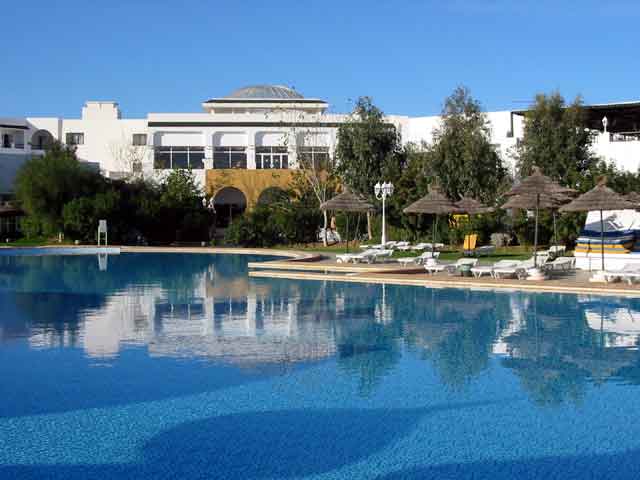
We lost Andrew to the teen club on our second full day at the resort and didn’t see him for the rest of the week. Once we had explored the resort we started doing some of the activities such as mountain biking and archery. We also had fun playing tennis and going for a dip in the indoor pool. Lying on the beach was okay but the water was a bit cold for swimming. The evening shows were put on by the people who coordinated the various programs, the animators. It was fun to see the people we had just gone mountain biking with, or took archery lessons from, up on the stage. On Saturday we took a bus tour to El Djem, site of one of the largest gladitorial amphitheatres in the Roman world. It was remarkably well preserved with some of the seating areas restored and others left as-is, showing how the amphitheatre was constructed. On Monday, Michael and Helena went for a camel ride and on Tuesday our magic week came to and end. The day of New Year’s Eve we thought we would only ride a short distance but we ended up in Hammamet after not finding a tourist office in Monastir or a reasonable hotel in Sousse. We took the toll highway from Sousse, encountering a severe rain storm, and entered Hammamet in the late afternoon. The map indicated a campground in the town and after riding around in dense traffic we ended up back near the highway where the campground was located in the courtyard of a hotel. We both were kind of tired from the ride and had no desire to head back into the chaotic traffic for supper. Instead we enjoyed some Christmas cake sent from Canada and went to bed early.
El Djem amphitheatre
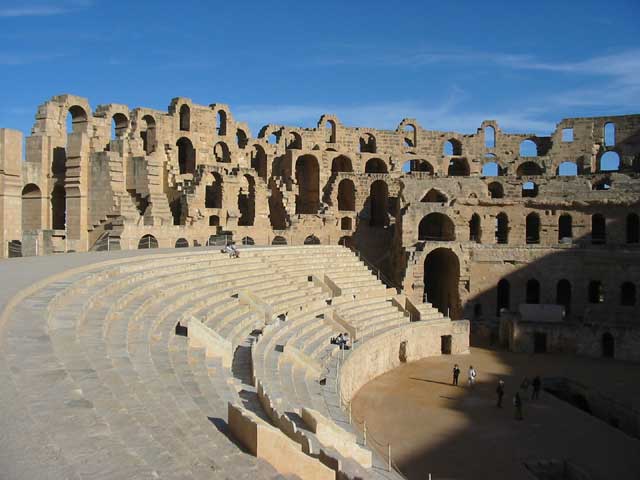
New Year’s celebrations didn't wake us during the night so we slept through into 2003. We made a quick phone call to Canada at midnight Alberta time and finished off the Christmas cake before riding off to Dougga. We arrived in the early afternoon after riding through beautiful hilly countryside but into a terrible headwind. Again a campground was indicated on the map but this time we could not find it. Since there was only one hotel in the area, at Téboursouk, about 10 kilometres from Dougga we headed there. The Hotel Thugga wanted only 59 dinars for the room including lunch (which we just caught before the restaurant closed), supper and breakfast. We spent a pleasant afternoon in the lounge, reading, playing on the computer and being entertained by a cat who seemed to be obsessed with its own reflection.
In the morning we went to the Roman ruins at Dougga. The ruins are the biggest and best-preserved in Africa. The theatre and the Capitoline temple were impressive but we enjoyed a pre-Roman artifact the most. The Mausoleum of Ateban was built in the third century B.C. and situated with a glorious view of green fields stretching to the mountains. We then rode the hundred or so kilometres to Tunis and to a campground located a few kilometres south of the city. Ekke pulled the in-line fuel filter out of the stove and remarkably the stove worked! We did grocery shopping for the first time in what seemed like weeks and cooked up our own supper.
Theatre at Dougga
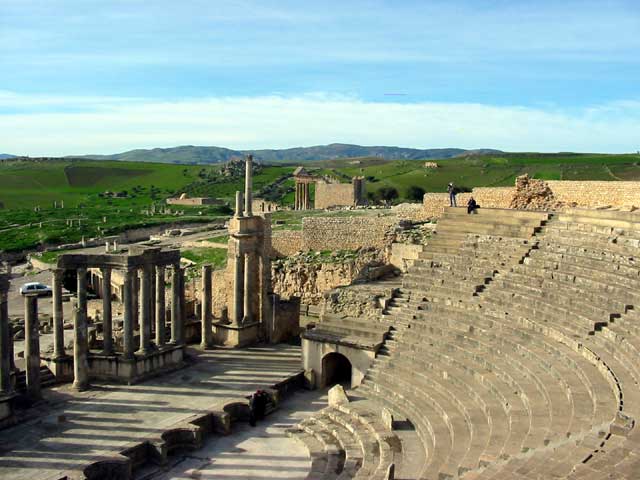
Mausoleum of Ateban

On Friday we went to the tourist office in Tunis and asked when the Paris-Dakar rally would be coming through the city. We were told that a parade was scheduled for 11:00 a.m. on Sunday. Next, we went to find a travel agency to book the ferry to Marseille. The agent told us the boat was full so we couldn’t get a cabin for the 22-hour journey! She did say that we could check back on Monday and maybe a cabin would have become available. In the meantime we had visions of stretching out our Thermarests and sleeping bags on the deck of the boat! Audrey got a chance to put her haggling expertise to work when we went into the medina to buy a birthday gift for her mother.
We decided to visit the Bardo museum in Tunis on Saturday but we had some difficulty finding it. We got turned around and ended up riding in the medina which certainly was an interesting experience as the narrow street was crowded with people. Then we ended up leaving the city and coming back to talk with a couple of traffic cops at an intersection. After suggesting that we should trade our motorcycles for their little dirt bike they then gave us directions and told us to do a U-turn over the median while they stopped traffic. Finally we got to the place where we thought the museum should be but there were no signs of any kind, so we just turned into a gate and asked someone if this was the museum. It was. One would have thought that the country’s national museum would be easier to find. The museum housed an extensive collection of mosaics and statuary, representative of Tunisian history from the Phoenicians, Romans, Vandals and Christians to the Arabs.
The Bardo National Museum
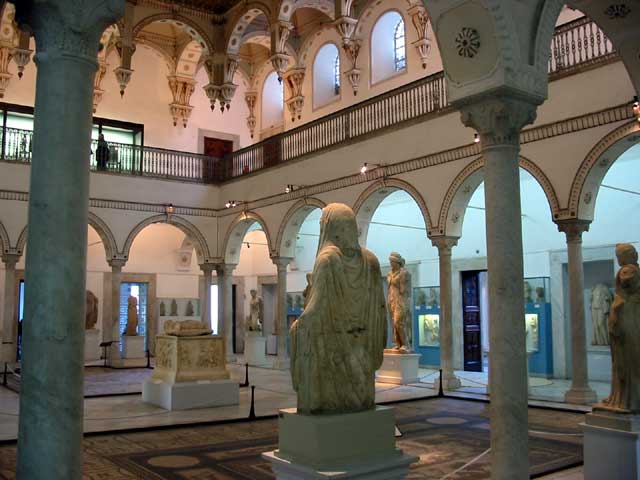
With the Paris-Dakar rally parade starting at 11:00 a.m. on Sunday, we decided to get there early for a good view of the event. As we were riding into Tunis at about 9:15, we could see and hear the race motorcycles going the other direction. We thought we had missed the parade! As we rode up Avenue Habib Bourguiba we found ourselves surrounded by a pack of race bikes and a quad at a stop light. The racers were being directed onto a cordoned-off portion of the road and a little further up a helpful police officer tried to wave us onto the course as well, mistaking Ekke’s bike for a race bike! After parking the bikes we went to the podium where the riders were being announced as they arrived. Standing just beyond the podium we heard them announce a Canadian rider! We started jumping up and down, waving our Canadian flag as Shawn Price came by, giving us a big grin and thumbs up. (According to www.dakar.com Shawn started 115th and finished the race in 80th position overall on January 17.) There was a break after the motorcycles went by which allowed us to go for coffee at a sidewalk café. When the cars came at 11:00 a.m. we went back to our spot near the podium but we didn’t hear any Canadian drivers mentioned. A man on a bicycle got a big round of applause when he accidentally ended up on the course! The biggest applause was reserved for a Tunisian driver who was then stopped for an interview with a TV crew. When most of the cars had gone by, we went back to the café for lunch and watched the race trucks rumble through. What a thrill it was to be this close to one of the most gruelling racing events in the world.
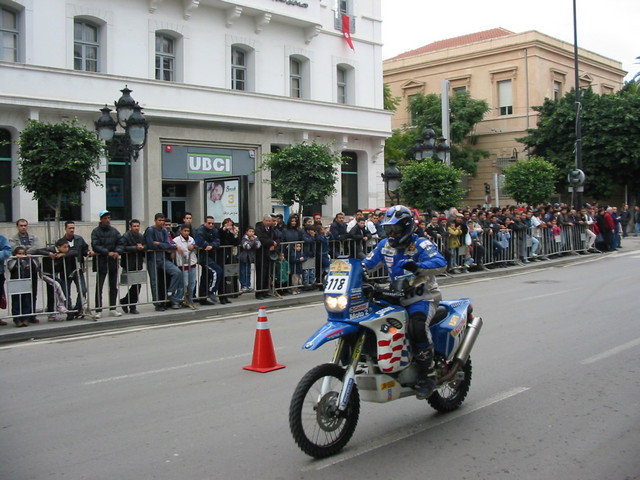

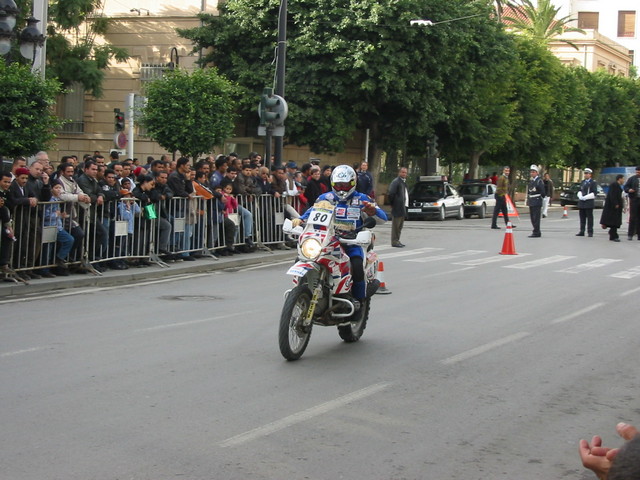
An extra round of applaus
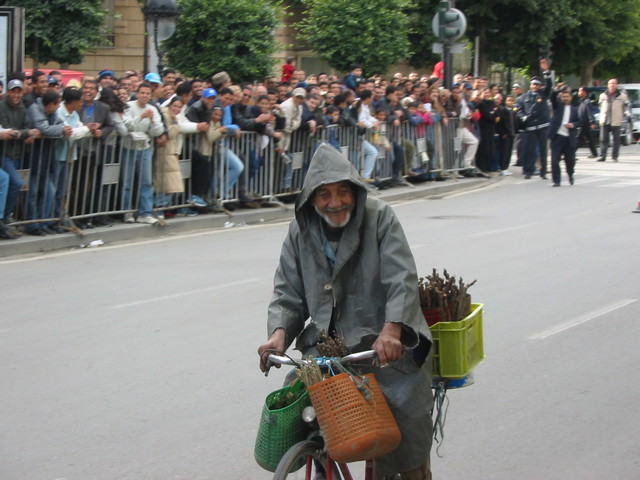
Monday we went to the travel agency to see if a cabin was available for Tuesday’s ferry. Now the same agent we had talked to on Friday told us that the boat was empty and we shouldn’t waste our money getting a cabin through the agency. Rather we should ask for a cabin when boarding and get it for a much lower price. We agreed to do this and then we went to Carthage, famous for its long history as a strategic location. The ancient city, founded in 814 B.C. by the Phoenicians, was mostly taken over by modern housing development. We visited the Baths of Antoninus, with nothing but foundations remaining, as well as a Punic site where row upon row of engraved stone slabs marked the location where it is rumoured that child sacrifices were performed. After walking through the picturesque town of Sidi Bou Saïd we returned to camp, to pack up for our early morning departure to Marseille.
Sidi Bou Saïd
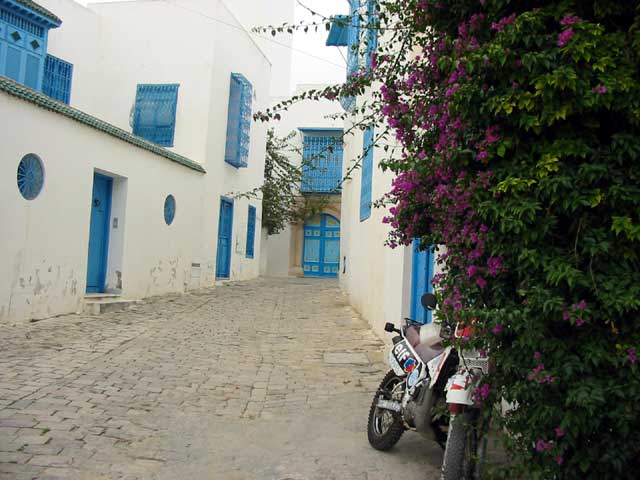
The travel agent suggested we should be at the port by 8:00 a.m. for the 11:15 sailing, so upon arrival, we were surprised that the customs gates didn’t even open until 9:00. Overall we can’t recommend Carthage Travel! We couldn’t take Tunisian currency out of the country so we had to find an exchange booth and change our paper money before our passports could be stamped. On board the boat we were told to wait in the bar until after departure to see if a room was available. A room was found for us and we saved about 20€ compared to buying it at the travel agency. We met Wim, the deputy mayor of a city in The Netherlands, who provided great company for the voyage. He had just completed a desert trek through the Sahara from Morocco but his companion had caught malaria, so was returning alone in the Land Cruiser. In the afternoon the seas became very rough and we took some motion sickness pills, left over from a sailing trip, but it was too late for Ekke, who became very sick. In the morning we were informed by Wim that because of the rough seas the boat had gone around the islands of Sardinia and Corsica for shelter and we were now going to be arriving in Marseille about seven hours late. The seas were considerably calmer than on the previous day and after thirty hours aboard the boat we arrived just as dusk was falling. There were virtually no customs formalities entering France, as we were deposited on the street after a construction maze and only one customs official. Since we were expecting to see more officials, we didn’t get our passports stamped for our return into the European Union. We hoped that wouldn’t create more headaches later. Compared to Tunisia, France was cold and miserable with a light rain falling in the growing darkness. We rode west out of Marseille and finally found Hotel Antara in Marignane. On the ride there we found the drivers to be courteous, staying in their lanes and using their signals. We didn’t get honked at once! The hotel was well-kept and comfortable and more importantly served delicious French cuisine. What a pleasure to be in western civilisation!
Waiting to board the ferry to Marseille

On January 9 we bundled up really well as the temperature was only 2 degrees. We plugged in our electric vests and had our heated grips on full blast, but it was still very cold riding on the highway. As we headed west, and inland, it seemed to get colder and soon there was snow in the fields and on the shoulder of the road. The autoroute looked wet but could have been icy so we kept the speeds down, which reduced the wind chill too. Because of the cold we had to stop frequently, going only about 300 kilometres that day, to Perpignan near the Spanish border. We walked the streets of the beautiful city that evening and then managed to find an internet location where could finally check our Hotmail and upload the latest chapter of our website.
We entered Spain the next day and tried to get our passports stamped but that couldn’t be done because we were already in the European Union. Continuing south on the Spanish autopista we were faced with tolls in excess of 20 euros for fairly short sections of highway. Staying on the autopista was turning out to be very expensive but it allowed us to travel at high and uninterrupted speeds so that we could get to Morocco quickly. Since campgrounds were not open, going slower would mean extra time and expense, staying in European hotels and eating at European restaurants. After yet another freezing cold day in the saddle, we stayed at a roadside motel, near Valencia, for 63 euros. As if we needed confirmation that it was awfully cold, we saw on BBC that this was the coldest week Europe had experienced in fifteen years, with crops being ruined near Marseille. The Spanish television channels showed lots of pictures of snow causing accidents and general mayhem throughout the country.
On Friday we rode a distance of about 550 kilometres to Almeria in cold sunshine, fortunately not seeing the snow from the previous day’s newscasts. There were many displays of public art along the highway, including herd of metal goats at an interchange. In Almeria we went straight to the port since we had read that it was possible to catch a ferry to a Spanish enclave in Morocco from there. An agent informed us that the boat would depart the next day at 11:00 p.m. but a boat to Nador, in Morocco, left that evening at 11:30. So we booked passage on the boat to Nador and went out to see downtown Almeria and get something to eat. There were an amazing number of fountains and sculptures in the vibrant city centre. At a McDonald’s, Ekke had his turn at celebrity status when he was approached by a woman wanting her picture taken with him. She apparently had never seen anyone that tall, and probably not dressed like that in full motorcycle gear either! A little after 10:00 p.m. we joined a line of vehicles to get on the boat and were surprised when we didn’t go through a Spanish customs check and consequently didn't get a passport stamp. On board we queued up with at least a hundred other people in one of the boat’s lounges. After an hour we finally got to the front and had our passports stamped and a “Welcome to Morocco.” Getting to our cabin we found it was similar to a train compartment with glass doors and fold down beds. We collapsed into our beds at about midnight after a rather long and eventful day.
Route from Tunisia to Morocco
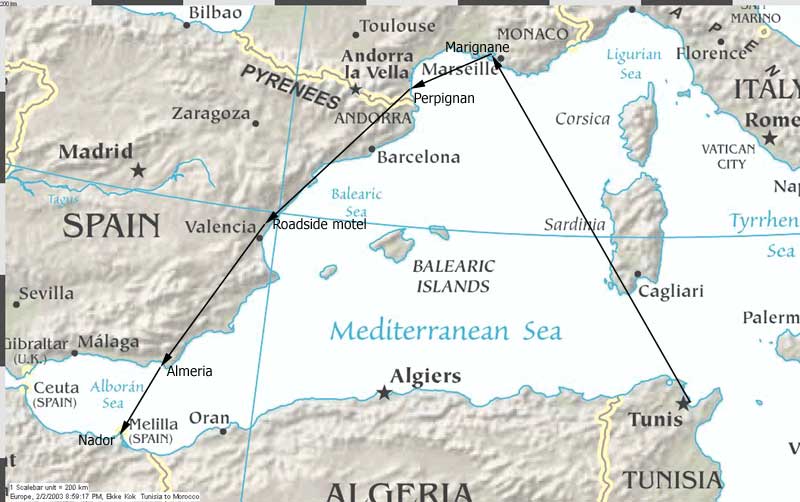
Map of Tunisia

From Nador into the Rif Mountains

We had to put a pile of covers on the bed that night because the heat didn’t work in the hotel, but we slept well. The room temperature was the same as the outside temperature, 14 degrees. On Monday morning the desk clerk gave us directions to a laundry facility but it turned out that it was a dry cleaner. Apparently there are very few, if any, self service laundromats in Morocco. It felt a bit odd to leave our underwear and socks with a dry cleaner but that is what we did after haggling the price down from 140 dirhams to 100. Still $16 was far too much for a load of laundry so we decided that we would be hand washing our clothes in Morocco. Through the hotel we arranged a guided tour of the medina and we met Salim, our guide, back at the hotel at noon. Rather than coming in through the main gate, Salim took us in through an entrance used by locals, straight into the heart of the medina. Our senses were overpowered by the sights, sounds and smells of this densely packed city centre. We wound our way through some of the 9,400 narrow streets and alleys with Salim providing a constant stream of information. He walked us through the daily lives of people going about their business; past fish stalls, produce markets, spice stalls and bakeries. People would make their bread dough at home, bring it to the bakery to have it put in the wood-fired oven and then pick it up later. We frequently saw children walk by with trays of dough or bread balanced on their heads. In the carpenter’s souq intricate designs were carved into the wood and then inlaid with bone. The Kairaouine mosque and medersa (university) were built in 859 A.D. but as non-Muslims we were not allowed to enter the intricately decorated buildings. From a wooden platform, high above countless vats, we watched workers in the tannery. They moved very quickly, taking the animal skins to the lye or to the rooftops to be dried or lashing the leather to the backs of overloaded donkeys. We had to be careful walking the narrow streets as the donkeys were driven with reckless abandon amid shouts of “barek,” meaning “look out!” In the brass maker’s souq we learned that the brass was polished using clay and in an herbalist’s shop we found a number of interesting curative mixtures. We took the safe course and only purchased a combination of spices for cooking and freshly ground cinnamon. A Berber craft shop had carpets for sale and a collection of interesting artifacts which could also be bought. Most fascinating was an Arab navigator’s astrolabe from the fourteenth century. After a taxi ride back to the hotel and then going out for dinner (pizza, lasagne, salad hawai [sic], sodas, creme caramel and a mint tea for only 125 dirhams) we collapsed into bed with our heads still spinning from visions of the medina.
Grocery shopping in the Fés medina
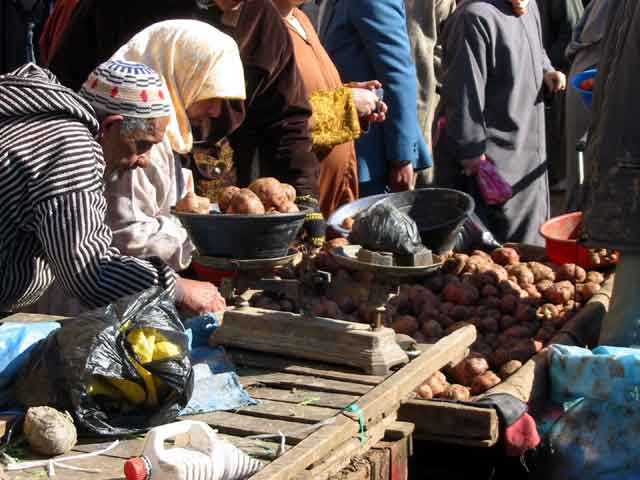
Spices for sale

Bread dough ready for the wood-fired oven
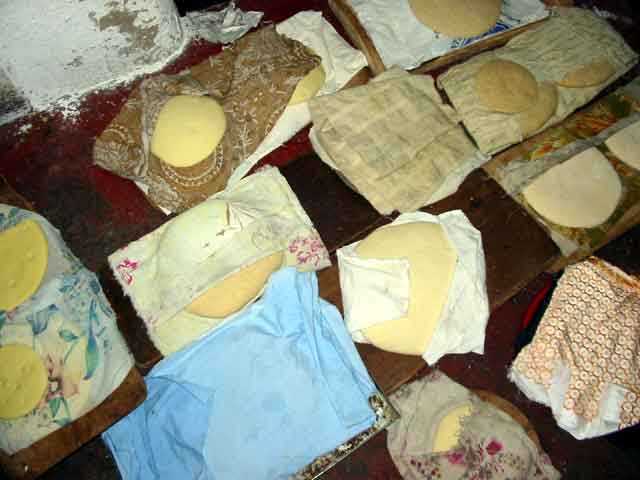
The tannery
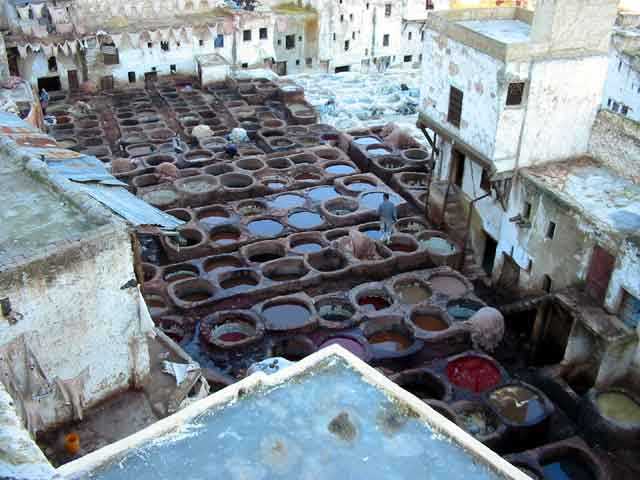
Tuesday we walked into the medina on our own, avoiding the faux guides near the entrance, in search of the Berber carpet shop. We happened upon Youssef, the salesperson from the shop, and he took us the rest of the way. After the obligatory glass of mint tea (known as Moroccan whisky), we tried to choose a carpet to buy but the selection was too great and we could only narrow it down to two. So we haggled the price of the two down to less than the price of the large one and bought them both. Youssef could see that Ekke was really interested in the astrolabe and offered that for 6,000 dirhams, probably a reasonable price, but we couldn’t part with a thousand dollars as we needed the money for our trip. The carpets were silk so they wrapped up into a small bundle that could easily be stuffed into a saddlebag until we could mail them home. We took the bundle back to the hotel, finding our way out of the medina without incident, and went out to try Moroccan food for dinner. Ekke had a pastilla, a mixture of pigeon meat and lemon-flavoured eggs plus almonds, cinnamon, saffron and sugar wrapped in a pastry sprinkled with icing sugar. Audrey tried the chicken tajine, a stew cooked in a shallow earthenware dish with a tall conical lid. Delicious!
One of the thousands of streets in the medina
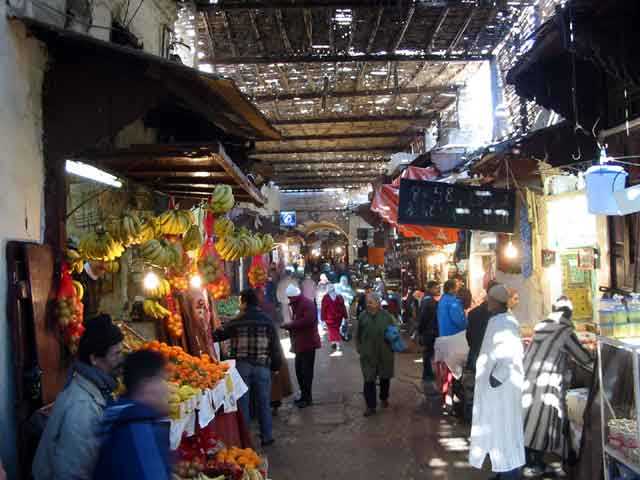
Treats for sale
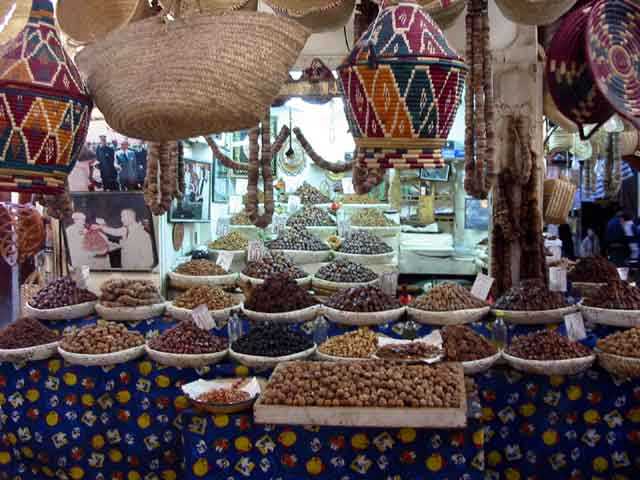
Audrey was a little under the weather on Wednesday and not up to riding so we decided to stay in Fés another day, despite a hotel room where the temperature never rose above 14 degrees. A search through the Lonely Planet book and on the Weather Underground website found Agadir, along the Atlantic coast, to be a resort town with a nice beach, sheltered from the worst of the wind and, most importantly, a warm weather forecast. Thursday dawned chilly but clear and Audrey felt a bit better so we packed our stuff onto the bikes and prepared to depart for Agadir. Unfortunately, the battery on the F650 was dead so we had to unload the bike and then push start it. Once out of Fés we fuelled the bikes at an “Afriqiua” gas station and rode a toll highway west to Rabat and then south to Casablanca. The tolls were about one tenth the cost of the Spanish and French tolls and the roads were excellent with little traffic. This happy situation ended at Casablanca and we were thrust back into the normal “dodge ‘em” traffic rules of Moroccan driving for the rest of the ride down the coast to El Jadida. Signage for the campground was sadly lacking and only through the vague description in Lonely Planet and some guesswork did we find it. A grassy spot for the tent and a restaurant for dinner made for a pleasant campsite despite the minaret a hundred metres away which we knew was going to announce a call to prayer quite early the next morning.
The call to prayer woke us at about 6:30 a.m. but we rolled over, back to sleep. Audrey’s bike again had a dead battery and after a couple of failed push starts a helpful French motorhome owner who had booster cables came to our rescue. We made it to Essaouira at lunch time but Audrey was still a little ill and tired so we decided to stay for the night, taking the afternoon off. The Palm Pilot, where we keep a diary, fuel log and a number of books, had died during the ride and required a full reset, losing all memory, so Ekke spent the afternoon figuring out how to restore it and cursing the cheap batteries that had shorted out. Late in the day we walked into town, visiting the medina and walking around the walls of the old city. The fishermen had returned from a day at sea and the harbour area was crowded with people selling everything from eels to bug-eyed, saucer fish. This didn’t do any good for Audrey’s already queasy stomach so we walked back along the shore to camp, stopping for comfort food, spaghetti and pizza, at a seaside restaurant and watched the sunset.
Essaouira harbour
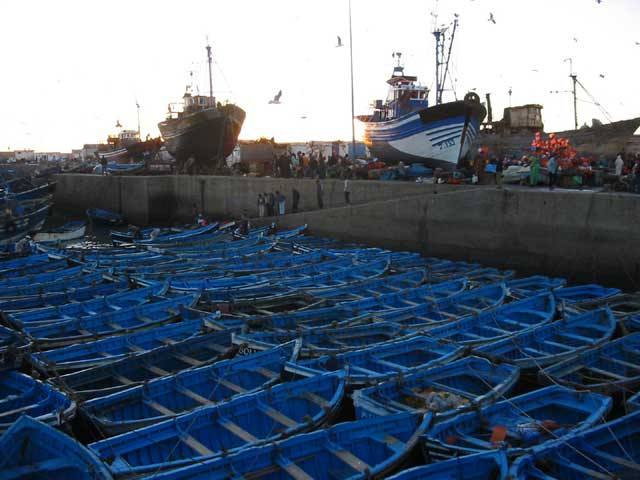
On Saturday morning we were again faced with the dead battery but when we got a boost from the neighbours we noticed that the fluid was low, just like in Dubrovnik. The neighbours jumped into action, boiling some water for the battery, apparently under the impression that the boiling process was like distillation. Fortunately, another neighbour came over with distilled water before we got too much into the battery. After the boost we rode south over curvy mountain roads to the coast under sunny skies with the temperature slowly rising as we neared Agadir. More and more motorhomes crowded the highway and it was just as much fun passing them in Morocco as it was at home. Some places seemed to be completely overrun with motorhomes, with at least a hundred of them parked near the sea. These free camping areas had no facilities, so while they were okay for the self-contained motorhomes, they would not suit our needs for more than one night. Not surprisingly, the campground in Agadir was very busy and the attendant suggested we try to find a spot before registering. We managed to squeeze our tent under a tree, where a motorhome could not fit, near the main street, Boulevard Mohammed V.
Noisy bus on Boulevard Mohammed V, company name not encouraging!
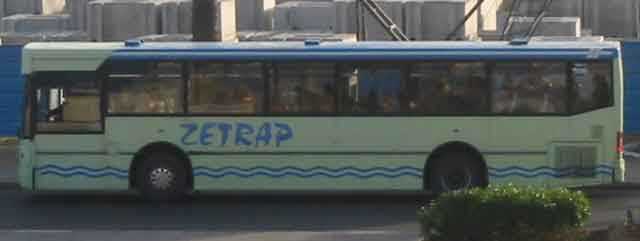
After a night without sleep because of the traffic noise we moved further in, near the restaurant/bar. The bar was used exclusively by locals, not the campers, and the music, shouting and drunk driving kept us awake until 2:00 a.m. Two nights of living next to the bar and a total of three nights without sleep had us irritable so we had to move again. The only place available was a concrete pad, surrounded by a flowering hibiscus hedge, that people were using to hang their laundry. Late in the day, after most of the laundry had come down, we collapsed the tent and dragged the whole mess over to the concrete pad. While we could still hear the bar that night, it wasn’t nearly as bad and we didn’t have to worry about the drunks knocking over the fence separating us from the parking lot. Finally a night of sleep!
Then a strange thing happened, something that neither of us predicted. We took a month-long break from travelling. Since Agadir was completely destroyed by an earthquake in 1960 there was no old city centre to visit or anything else of cultural significance. This meant that we had no need to do anything other than relaxing. We settled into our camp, surrounded by fellow snowbirds from Europe, going for one or two hour walks on the beach every morning, reading books and cleaning the motorcycles. We really enjoyed knowing where we were going to sleep every night, where we could buy groceries or even what groceries were available. Some predictability was put back into our lives after six months of travelling.
Walking on the beach at Agadir
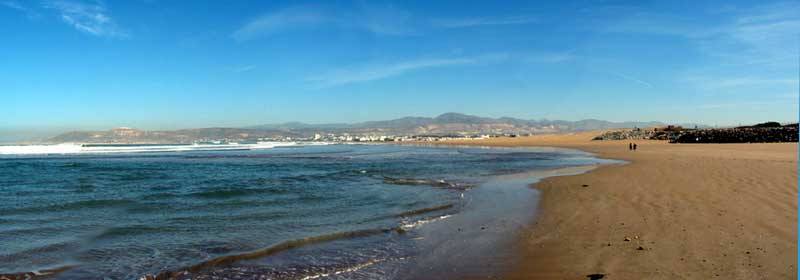
Via the Grubers in Germany we had a package sent from home containing some items that just weren’t available in Morocco or even Europe. Flashlight bulbs for our Maglites and a maintenance kit for our MSR stove were needed and the parcel arrived just as our last bulb burned out. We were put into a state of shock when we got the customs bill though. Moroccan customs wanted 1,400 dirhams to release the package and FedEx had made us sign a paper indicating we would pay whatever was needed. So $213 later we had about $20 worth of parts and a sweater from Tilley. Had we known, we would have bought new flashlights and a stove! The bulbs were nice to have since it was still dark at about 6:00 p.m., about the time we usually made supper, and the maintenance kit resolved the problems we had experienced with the stove since Tunisia, so in a sense it was worth it.
We did a couple of day trips from Agadir later in our month-long stay. One of our neighbours suggested a ride up the Paradise Valley, not too far from Agadir. We rode about 10 kilometres north and turned inland at a busy village. The road climbed into the dry coastal mountains and after a series of smooth curves we descended into a valley crowded with palm trees. The valley narrowed until it became a steep-walled canyon and the road was pushed to the side. We followed the rough, single-lane road at the base of the cliffs and then climbed the switchbacks at the head of the canyon for a view back the way we had come. On the trip back down we stopped beside the small river in the gorge and had a picnic lunch, sitting on a rock ledge in the sun.
A more ambitious day trip took us south to Tiznit and then east to Tafraout. After passing by the red mud walls of Tiznit the route took us up into the Anti Atlas Mountains. We came to a village packed with people for the market, and became stuck in a throng of shoppers wearing colourful djelabas and fés hats. Eventually the car in front of us just started bullying its way forward and we followed in its wake. Near Tafraout the rock formations took on a beautiful reddish hue that reminded us of Moab, Utah. We found a small store for a piece of bread and cheese for lunch but had to hurry as the first 200 kilometres had taken about four hours and at this rate we would have to ride in the dark before getting home. From Tafraout we descended to the Almond Valley with its beautiful blossoms, though we were a week or two early for the annual almond festival. Berber villages and kasbahs on the hilltops had us stopping for photos and videos every few minutes! Just as the sun was setting, we pulled into our campsite, avoiding the dangers of riding in the dark in Morocco.
Restored kasbah, now used as a hotel in the Anti Atlas Mountains
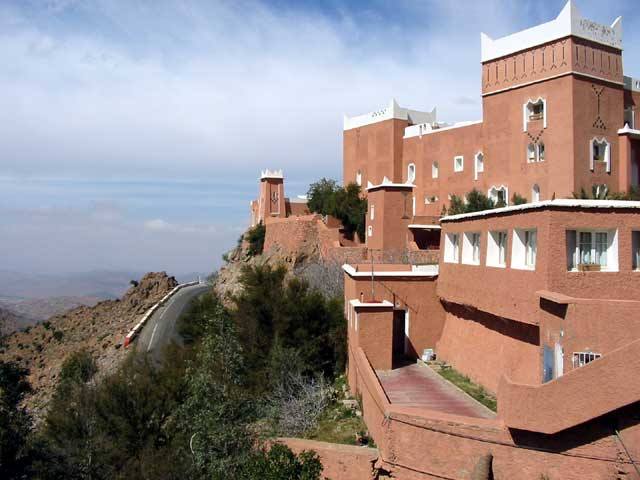
Kasbah on the hill, village in the distance and village in the mirror
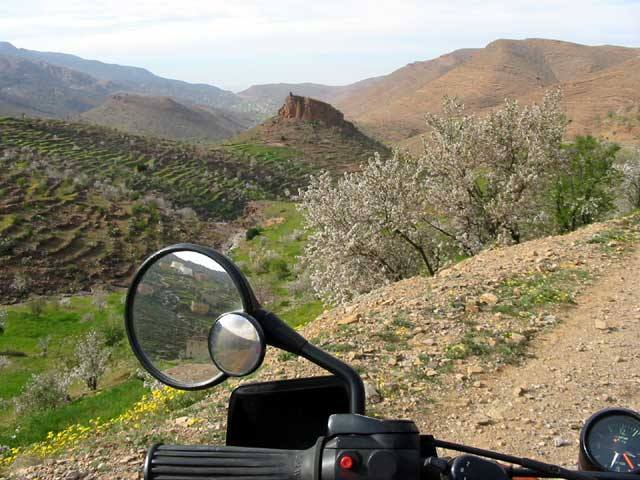
Ekke had found the daytrip to Tafraout fascinating but wanted to do some more exploring. One day, while Audrey went shopping in Agadir, he went out in the direction of Tafraout and, after visiting a Berber village near the highway, had a look at the map for an interesting return trip. The map showed a dotted line parallelling the highway with a Berber village up in the mountains that looked promising. The track was very rocky and, with the many switchbacks up and down the valley and over mountains, it took two and a half hours to go a straight line distance of only ten kilometres. Fortunately the map was wrong and the same road did not continue past the Berber village, instead a new, paved road on a different alignment had been built and the remaining ten kilometres back to the highway only took fifteen minutes with Ekke getting home at supper time.
Gone exploring
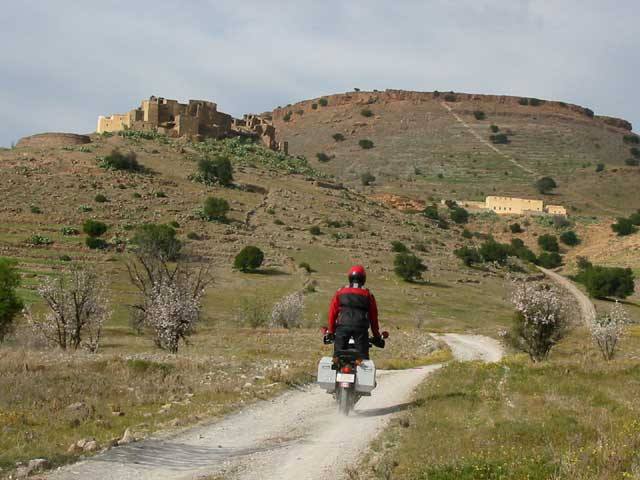
Berber village in the mountains

Our last outing before packing up was to the only historical structure left standing after the 1960 earthquake, the kasbah high on the hill overlooking the resort city. The hike up to the top of the hill was surprisingly easy, perhaps those walks on the beach had done some good! Not much of the kasbah survived the earthquake, everything but the walls was levelled and even some of the walls needed to be restored. From the top of the fortress, the view south over the city and down the coast was terrific.
Walking along a portion of the restored kasbah wall
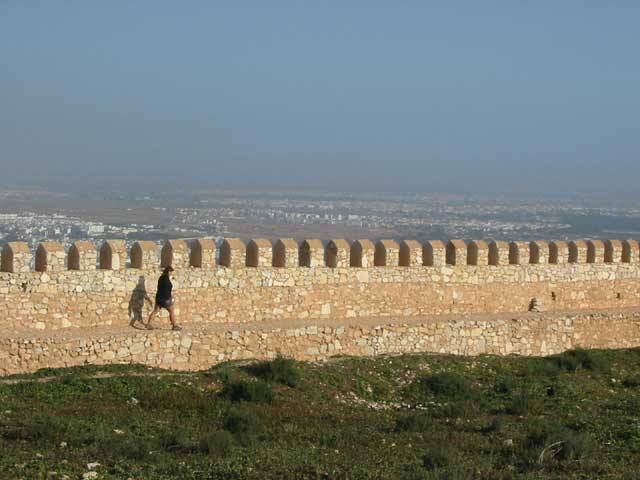
View of Agadir's sheltered beach from the kasbah
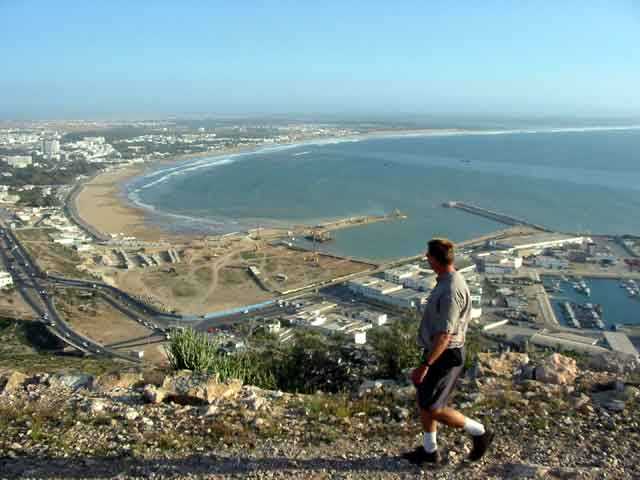
Finally, on Sunday, February 23rd,we said goodbye to our friends at the campground and headed for Marrakech. From Agadir the ride took us via a back road to Taroudant, whose medina was surrounded by beautiful red walls. We rode right through the heart of the medina, its narrow streets crowded with pedestrians. We rode about 30 kilometres northwest of Taroudant and turned off the main road onto the Tizi-n-Test pass road that would lead us to Marrakech. The road narrowed to one lane and started a steep climb towards the 2100 metre summit. It was difficult to pass the slow moving trucks with the narrow road and no straight sections so it was good that the traffic was light and the other drivers cooperative. Though when the truck drivers waved us past there wasn’t much room, only the width of the bike and then a cliff or a drop to doom. At the top of the pass we enjoyed omelettes for lunch and a spectacular view back towards the ocean. After the descent the road straightened out and we could pick up the speed a little so that we arrived in Marrakech just as the late afternoon sun was catching the red walls surrounding the city. After fuelling the bikes we rode straight to the Hotel Islane, recommended in Lonely Planet and by one of our neighbours in Agadir. The 360 dirhams per night included secure motorcycle parking inside the hotel and breakfast in the terrace restaurant overlooking the minaret of the Koutoubia mosque. After settling in we walked the short distance to Jema al Fna square where stalls were set up selling freshly squeezed orange juice (2.5 dirhams or 40 cents a glass!) and smoking grills emanated delicious aromas. We wandered amongst the snake charmers, musicians, story tellers and other performers towards the food stalls. A boy, who for all the world reminded us of Bart Simpson, jumped in front of us, twirled the tassel on his fez hat three times and stuck out his hand for money. We thought the lame performance didn’t warrant any money and so continued to a grill where Ekke had the best pastilla of the trip and Audrey had a piece of chicken and that other Moroccan favourite, cold french fries. We were happy to be on the road again, experiencing new and exciting things.
On the road to Marrakech
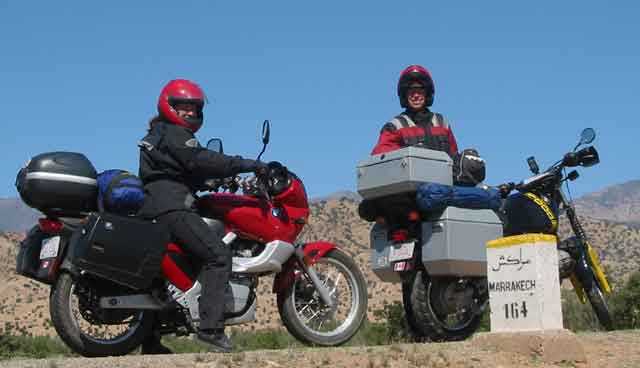
Tizi-n-Test pass with road snaking up the hill
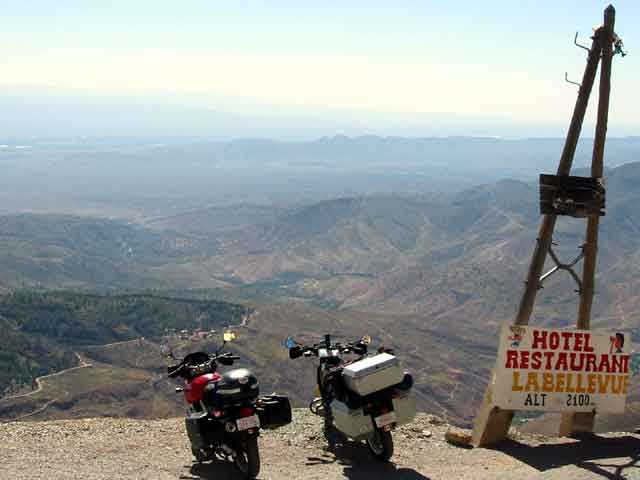
Monday we wandered through the city, looking for a battery and rear tire for Audrey’s bike. We had no luck finding either but did enjoy the walk through the medina. Overall, we found Marrakech to be the most hassle-free city we visited in Morocco. The people were friendly and if you indicated that you weren’t interested in whatever they were selling they left you alone. Tuesday was Audrey’s birthday so we made the day special, visiting palaces and taking a caleche ride. After supper at a terrace restaurant overlooking the Jema al Fna square we retired to the hotel to watch a DVD on the laptop. DVDs were not easy to find in Morocco so we didn’t have much choice as to what to buy but it was a lot of fun to watch a movie even if it was in French with English subtitles.
Audrey has Henna applied on her hand
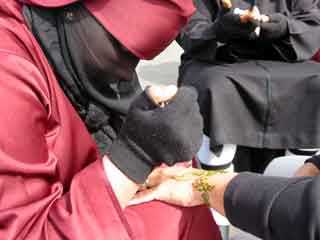
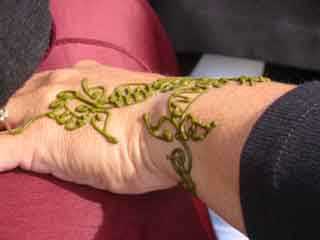

Jema el Fna square from the terrace restaurant
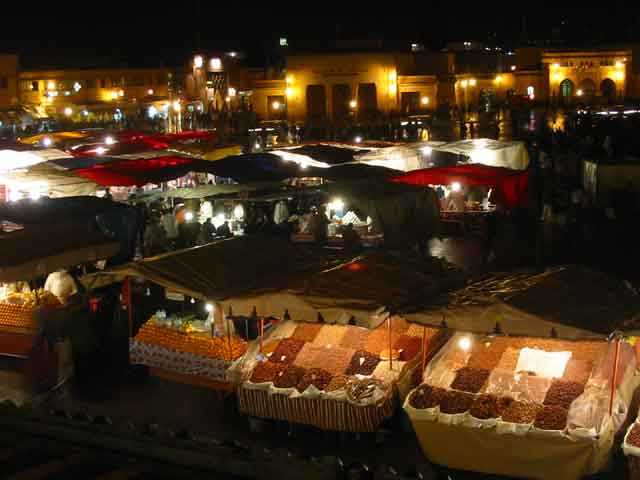
Koutoubia mosque from the Hotel Islane

The ride from Marrakech to Casablanca (doesn’t that sound exotic?) was on 245 kilometres of nicely paved road with gentle curves until we came to the plain approaching Casablanca. About 30 kilometres out from Morocco’s largest city the traffic got to be insane with tailgating, cutting off and driving two abreast in one lane being the norm. We had no luck finding the campground after riding around for an hour and finally asked at a gas station for directions. A couple at another pump knew the way but couldn’t explain it with our poor understanding of French, so offered to lead us there. When we got to the campground we explained to them that even if we were fluent in French or they fluent in English they couldn’t have given directions through the maze of Casablanca’s streets to get there! After setting up camp we went to an internet point and found an address for a mechanic in Casablanca on the Horizons Unlimited website. We hoped that he would have the battery and tire for the F650 and if not, then be able to direct us to a place that did.
On Thursday we hired a petit taxi to take us to the motorcycle shop. The mechanic looked through his selection of tires but could find nothing in the right size and he didn’t have a battery. He gave the taxi driver the address of another shop and we drove there. We ended up at five different shops with the cab driver, who spoke a little English, helping us out. We were even at the BMW dealer, which sold both cars and bikes, and they had a tire in the right size but with an off-road tread pattern for 3,000 dirhams ($500!). We returned to the campground, had a late lunch and then hailed another cab to take us to the Hassan II mosque. We arrived too late for the last tour of the day so could only look at the outside of one of the largest mosques in the world and take a stroll along the shoreline.
Hassan II mosque in Casablanca

The F650 did not start on Friday when we planned to ride to Meknes so after fellow campers helped push start the bike we tried to find the BMW dealer again so that they could match up a battery. We really should have taken the GPS along on Thursday’s taxi ride because we couldn’t find the dealer. Eventually we asked a cop but the directions were rather confusing so we hailed a cab and the cop gave the driver directions. We then followed the cab to the BMW dealer. It didn’t seem like the cabbie drove slow enough for us to follow, as he ducked through tiny gaps and generally drove as if he was trying to lose us. Using the power of the bikes to keep the cab in sight we arrived at the dealer without mishap. After an hour the dealer could find no battery that matched and we declined the offer to purchase the 3,000 dirham tire. Even though it was after noon we decided to ride to Meknes anyway since we knew it was a good toll highway the whole way. After an uneventful ride into a headwind we arrived in Meknes and tried to find the campground. We rode through the medina, in the direction Lonely Planet indicated but didn’t see any signs until we came out of the medina. We followed the signs but ended up at other signs pointing back the way we came. Thus we rode around Meknes until we took a turn through a gate to find a beautiful campground hidden just outside the city walls.
Working on the website at camp in Meknes
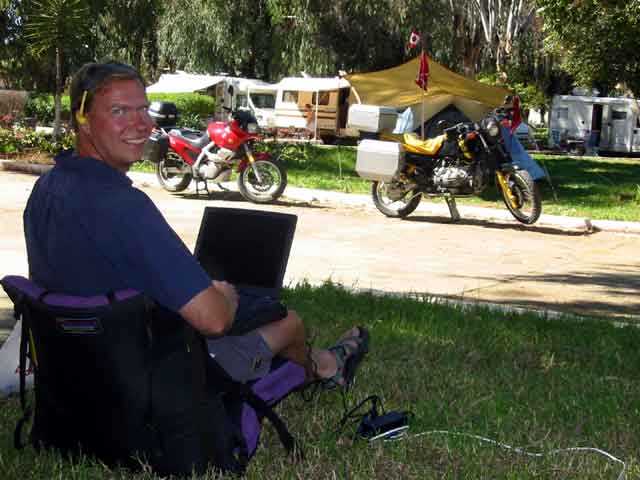
On Saturday we visited museums in Meknes but the Dar Jamai was under renovation and just displaying a carpet collection. The ticket was also good for two other museums, so we visited the Bab Mansour displaying even more carpets and then the Koubbat as_Sufara' where we saw some beautiful... carpets. This ambassadors pavilion was used for visiting dignitaries and legend has it that the granaries underground housed thousands of Christian prisoners captured during the reign of Moulay Ismail in the seventeenth century. Across the street the Mausoleum of Moulay Ismail was open, but normally the inner sanctuary was not accessible to non-Muslims. We made a donation of 20 dirhams and hence could go in to see the tomb. This was, for us, one of the most impressive sights in Morocco. The mausoleum was kept in a good state of repair and the inner sanctuary was beautifully ornate.
The sanctuary of Moulay Ismail's mausoleum lies behind the simple courtyard
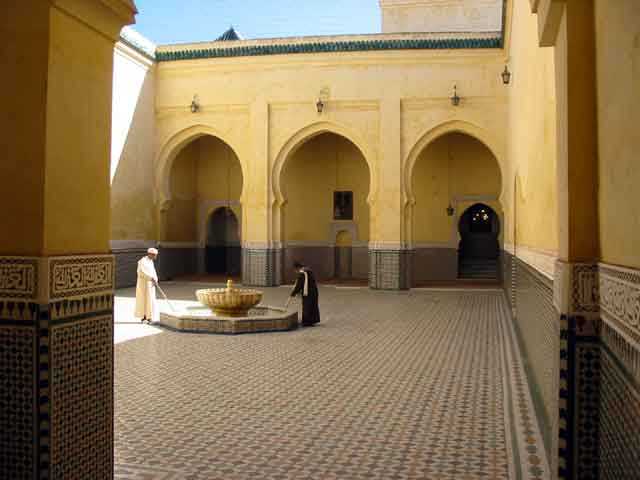
The next day we rode the short distance north of Meknes to Volubilis, the site of Roman ruins. Volubilis was situated on a hill overlooking green fields with the Rif mountains in the background. Considering that the mosaics on the floors of the villas had been exposed to the elements, unlike Piazza Armerina on Sicily, they were in good condition. It was a beautiful, warm day, just right for wandering among the ruins of the ancient basilica, triumphal arch and lavish villas and imagining what life was like two thousand years ago.
Four Seasons mosaic in villa at Volubilis
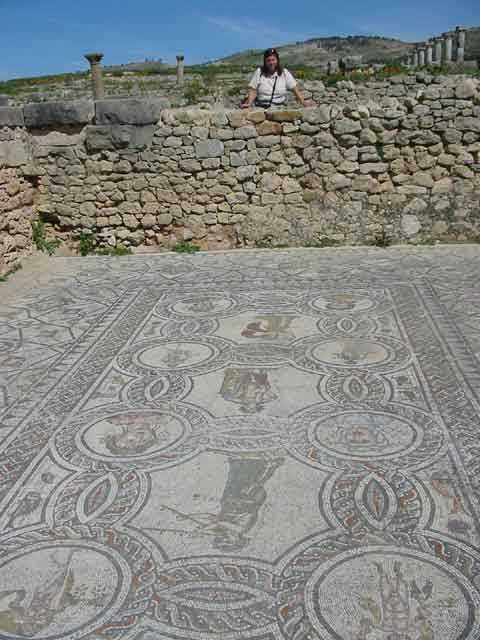
Monday had us leaving the grassy campground in Meknes and riding north, past Volubilis, to Chefchaouen through the Rif mountains. Apparently this area is one of the largest marijuana growing areas on the planet and it was recommended that we not stop for anyone along the road as they might plant drugs on tourists heading out of the country. We kept our eyes open as we rode through the mountains on a road that was too rough to really enjoy. When we got to Chefchaouen, high in the mountains, we went to the Madrid Hotel but they were in the midst of renovating and the rooms smelled of paint. While standing outside the hotel discussing what to do, a person came up and suggested another hotel for less money and secure motorcycle parking. Ekke went with him to have a look while Audrey stayed with the bikes. The Sevilla Hotel looked fine and when Ekke came back we decided to take it. Audrey said that another man had come up to her while she was waiting and told her that we should watch ourselves as the guy Ekke went away with was a drug dealer! With visions of a Moroccan jail dancing in our heads we made sure the bikes were locked up tight inside the padlocked garage, hoping that no-one would plant any drugs on them. A walk around the medina had us at the central square for supper where we enjoyed one of the best meals we had in Morocco, with a thick vegetable soup, brochettes le kefta (lamb) and a chicken tajine followed by sliced oranges sprinkled with sugar and cinnamon.
Negotiating roundabouts is tricky in Morocco as the entering traffic has the right of way
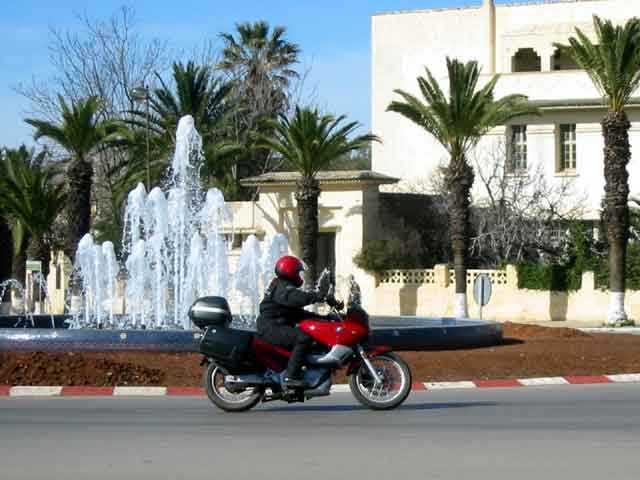
Leaving Meknes we need to consult the map
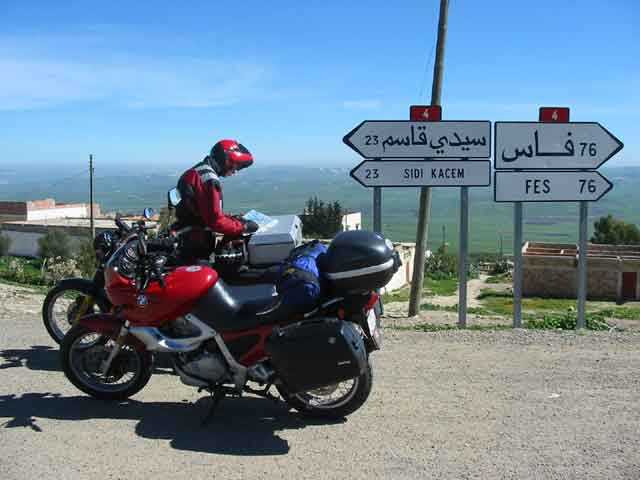
In the morning we tried to get an early start so that we could get to the border at Ceuta with enough time to locate a tire and battery in the afternoon. The road was still too rough to enjoy but we arrived at the border with Spain before noon. The usual hassles at the border were complicated when Ekke asked a customs official for a refund on the taxes paid for the FedEx parcel received in Agadir! The official seemed to get quite upset and found a guide to translate from English to Arabic. This didn’t help and a refund was flatly refused though we could write to the government in Rabat if we wanted to follow up on it. Going through Spanish customs was straight forward but it was not possible to get a stamp for our passports without going back to another lineup so we rode on through, back into the European Union. Ceuta was a tax-free haven and gasoline was cheap at 55 euro cents per litre, about the same as in Canada. After gassing up we went to a motorcycle shop, hoping that we could finally get a battery and tire. We still had no luck, as the only battery that fit had the poles reversed and the only tire that fit was an off-road tire. After finding the Hostal Central, a two star hotel in the middle of Ceuta for €40, we walked around this Spanish enclave on the northern tip of Africa looking for a light supper. The colonial architecture and wealth of the people, not to mention the tidiness of it all, was a real shock to our system after almost two months in Morocco. The cost of things was a real shock too, with a trip to the grocery store costing more than double what an equivalent trip in Morocco would have cost.
Ferries to Algeciras, Spain in Europe ran hourly, so we left the hotel fairly early on Wednesday morning in the hope that we would be able to make it to a motorcycle shop before it closed for the afternoon siesta. The 10:45 EuroFerrys boat left exactly on time as we came up from the car deck. The first announcement we heard as we entered the passenger deck was that no smoking was allowed anywhere on the boat. Then we looked around. The boat was new, sparkling clean and absolutely beautiful, complete with a gleaming dolphin sculpture. Now we had left Morocco for sure! We were rather disappointed that this was a fast ferry and the crossing would be completed in only forty minutes! Looking out of the large windows we saw the southern Pillar of Hercules slip away and we said goodbye to Africa.
Pillar of Hercules matches the rock of Gibraltar
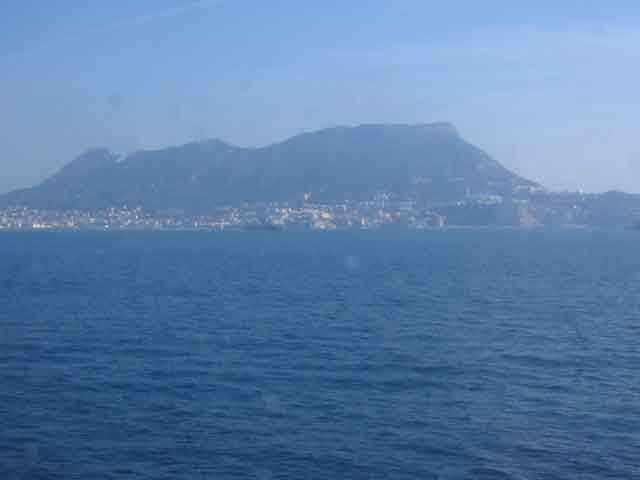
Map of Morocco
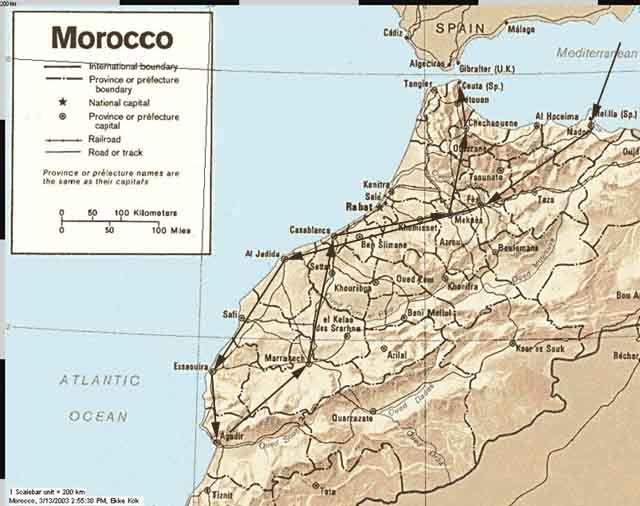
On Thursday the 6th we rode the short distance to Gibraltar, Audrey finally having a new tire on the bike and a fresh battery. At the border we queued up behind a long line of cars but a person behind us beeped his horn and waved us on, indicating that we should just ride around the cars and go straight to the front. What an advantage to be on bikes! Following signs to the Upper Rock we stopped to take a photo of a mosque overlooking the Straights of Gibraltar. After the photo-op the GS refused to start, only giving a pitiful “click” from the relay, just like it had done in Italy near the beginning of the trip. Since it was a faulty relay at that time, we push started the bike and rode around Gibralter to various bike shops looking for a relay, never shutting the bike off. Ending up at a junk yard to sort through hundreds of relays, Ekke shut the bike off (OK, he stalled it) and let it cool off. We didn’t find the correct relay but the bike started when we came out so we decided to see Gibraltar, riding to the Upper Rock and only stopping near the top of hills. The first stop was a plaque describing the Pillars of Hercules where we could just make out the hill in Ceuta on the other side of the Straight. The Cave of St. Michael had amazing stalactites that took thousands of years to form and were now highlighted by coloured lamps. After lunch at the café we rode to the Apes’ Den where Barbary Apes were to be found. Truth be told, they found us, jumping onto the motorcycles as soon as we got off. This was cute until the macaques took a liking to the seat on the GS. They pulled at the existing rips in the saddle and started chewing on the material! So while one of us stood guard by the bikes, the other went to see the Apes’ Den, but almost all the apes were by the bikes. Audrey’s Spanish-influenced strategy of waving a red tea towel in the face of an ape did nothing to dissuade it from continuing to enjoy the taste of vinyl. Ekke shooed the offending ape away and then a short ride around the rock took us to the Great Siege tunnels built in the Eighteenth Century. The view over the isthmus towards Spain from the cliff face was terrific, showing how this was an ideal location for the cannon emplacements. The isthmus is only 1.6 kilometres across and an airstrip took up almost all of that distance. This meant that access to Gibraltar by road had to be built across the runway with signal lights. A sign at the crossing warns pedestrians to, “please cross quickly!”
Gibraltar
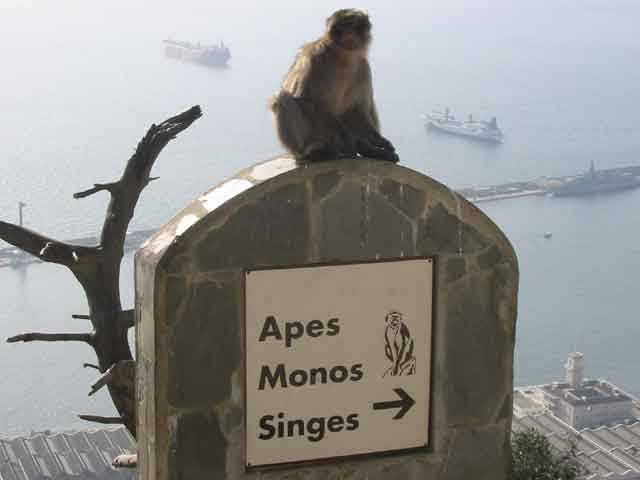
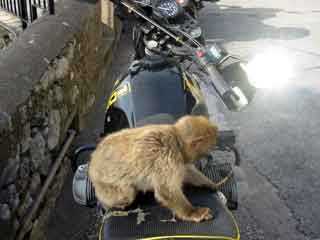
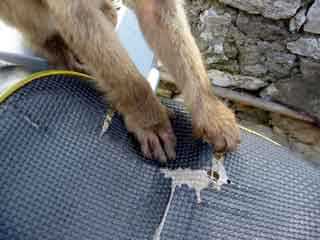
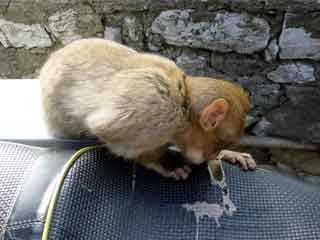
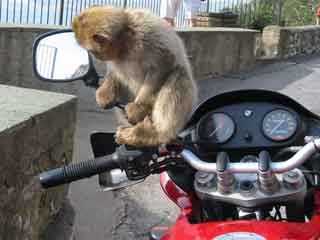
Notice the street crossing the runway on the left
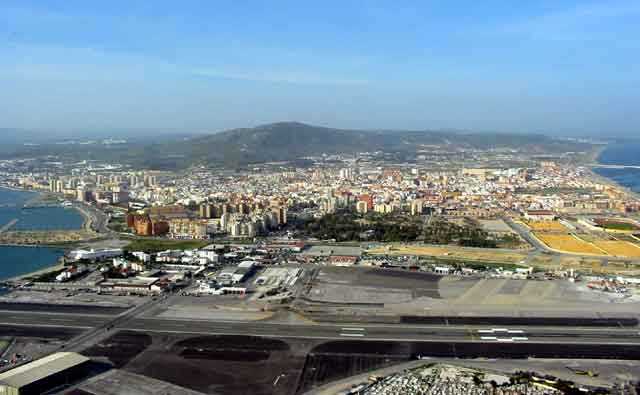
The GS started okay whenever it was cool so we had no trouble heading to Seville on Friday. The road had smooth asphalt and sweeping curves as it climbed from the coast, making for a pleasant ride. The drivers in Spain, on the whole, were the best drivers we had encountered on our trip, being polite, skilful and not very aggressive. We arrived in Camp Oromana, situated about 15 kilometres south of Seville, at 4:00 p.m. and found a quiet spot at the edge of the campground. Saturday was relaxing except for the discovery that we had camped next to a paintball field. It was fun for a little while until the paintballs started coming through the fence and splattering everything with red dots. Fortunately the paint just wiped off but hiding behind the tent to eat and keeping a low profile while moving about got to be a bit tiring. We left the camp on Sunday to visit Seville, hoping that the paintballers would not be active. We rode right through the centre of town, with its narrow streets, past a market and then towards the giant cathedral. The GS would not restart after getting hot on the slow ride in town and we decided to park a few blocks from the, appropriately named, Catedral. First we walked through the Alcázar, the residence of Seville’s royalty for many centuries. The palace was decorated in Moorish style with intricate carvings and colourful tiles. It was certainly much better preserved than the buildings in Morocco and as a result we thought it the best example of Moorish architecture we had seen. It was a delight to walk around the gardens to compare and contrast the eclectic styles of Muslim and Christian features. Nearby, the Catedral, reputed to be the largest church in the world, had a Sunday service going so we could not wander amongst its massive pillars, just along the perimeter. After a lunch of paella at a street side café we walked back to the bike via the quaint Barrio de Santa Cruz, the old Jewish quarter. The bike started easily enough, probably because it had cooled off, and we rode to the site of Expo ‘92, across the river. The site was now used as a research centre/office park and was very quiet on a Sunday afternoon so that we could admire the modern architecture in peace. Returning to camp we were pleased to find that there had been no paintball activity and therefore no mess to clean up.
Better preserved Moorish architecture than in Morocco

Across the Rio Guadalquiver to Expo '92
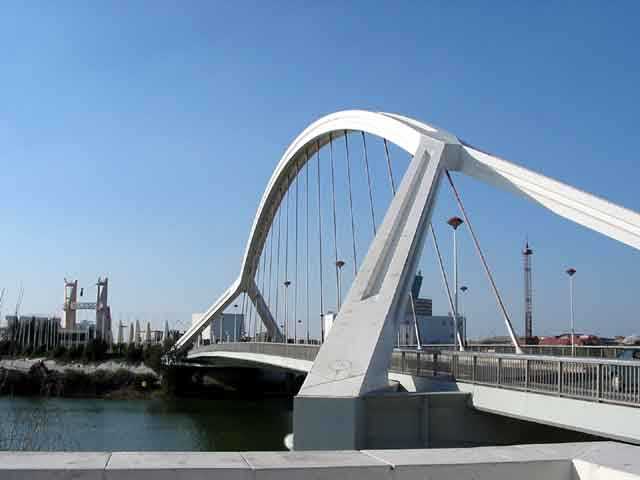
The ride on March 10 from Seville to Lisbon, about 400 kilometres, was pleasant enough in Spain but the road deteriorated as soon as we crossed the border to Portugal, becoming narrow and potholed. The GPS got us to the approximate area of the campground in Parque Florestal de Monsanto in Lisbon but when we followed signs to the camp we ended up at a “Do Not Enter” road. After circling around we decided to just take the road and hope for the best. Sure enough, we could see a beautiful campground just on the other side of the fence, even with picnic tables, the first we had seen in a European campground. We got back onto a public road and managed to get to the front gate but we had to ask ourselves, “Why are campgrounds so hard to find?” Obviously we are not cut out to be motorhome drivers since we could never manage to do all the U-turns required to get to camp! Sadly the picnic table sites were for motorhomes and caravans, the tents were placed in a grassy field amongst the trees. We asked if we could pay the extra amount for a motorhome spot but were told that we would also have to pay an additional fee for the second motorcycle. We were floored. A car towing a trailer or a motorhome would pay less for the same site than we would! Even though the €17.70 was actually a fairly reasonable price, we refused to take it on principle alone, opting for the tenting area.
On Tuesday morning Ekke disassembled the starter motor on the GS, cleaning it in the hope that it would solve the hot starting problem. In the afternoon we rode to a magnificent monastery near the waterfront. The Mosteiro dos Jerónimos, built late in the fifteenth century, was open to the public so we could see the church and then for a small fee, the cloister. A ten minute walk along the waterfront towards the Atlantic brought us to the Torre de Belém, one of Lisbon’s, if not Portugal’s, most famous icons. We climbed the old watchtower that guarded the inlet to Lisbon’s harbour for a terrific view on this clear, sunny day.
Mosteiro dos Jerónimos

Torre de Belém
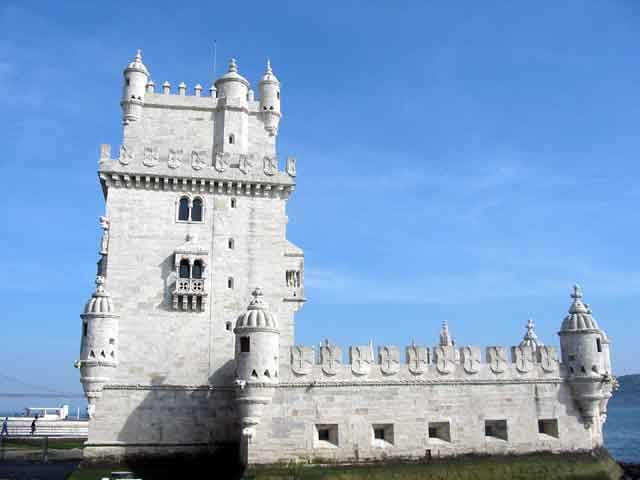
Monument to Portugal's explorers
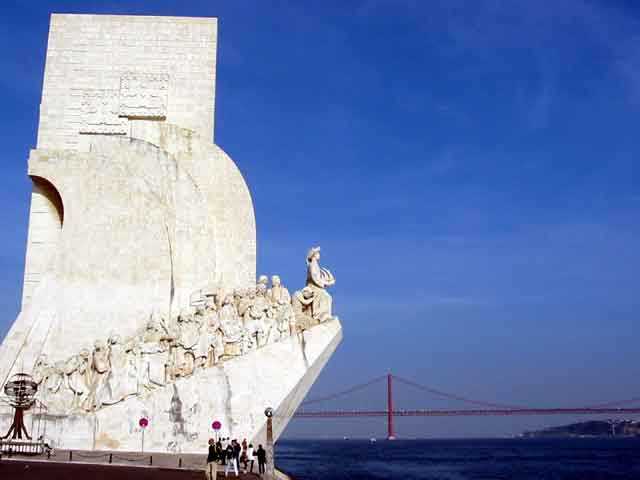
Wednesday was not as sunny as we took the bus and tram to the downtown section of Lisbon. We climbed to the castle on the hill anyway and while the distance was hazy, the view down to the city centre was enchanting, with its squares and fountains and narrow streets. A ride on the Metro took us to the Oriente station, near the site of Expo ‘98 and the Oceanarium. The Oceanarium had a giant tank in the centre, filled with fish of every description. Then four smaller tanks were joined to it, representing the Atlantic, Pacific, Indian and Antarctic oceans, with two levels; above water and below. In the Pacific tank a piece of North American shoreline was recreated and was so realistic that it had us remembering a backpacking trip on the West Coast Trail on Vancouver Island. The shear variety of sea life was astounding, from a flat fish with both of its eyes on one side of its head, like a Picasso painting come to life, to a leafy dragon that couldn’t be discerned from its surroundings.
Overlooking Lisbon from Castello de São Jorge
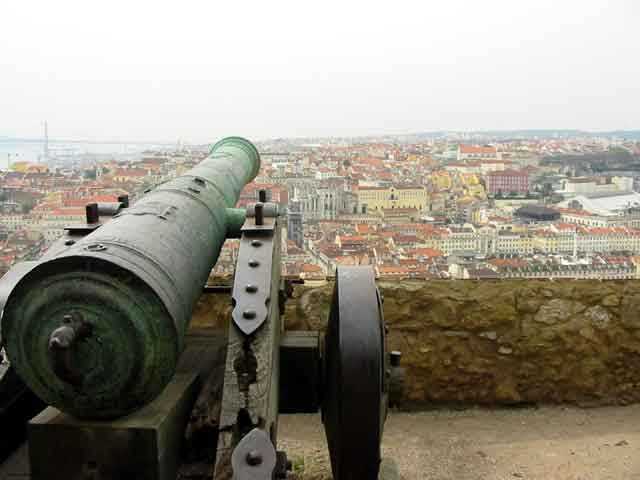
Viewing inside the Oceanarium
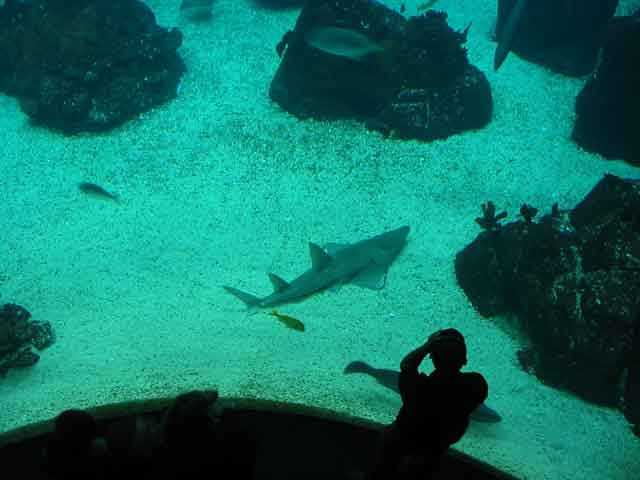
Inspiration for Picasso?
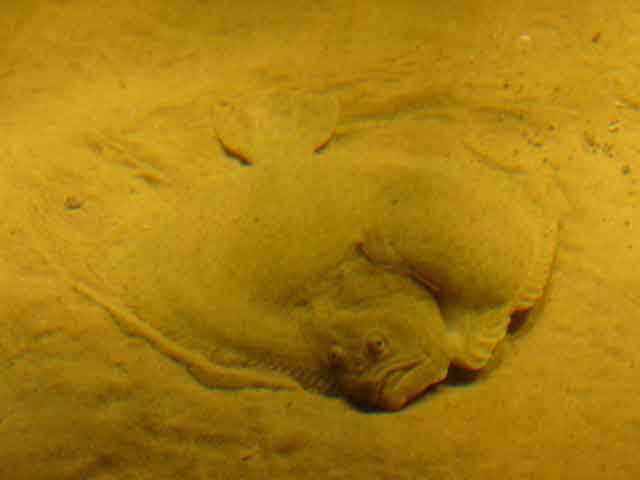
Leafy Dragon
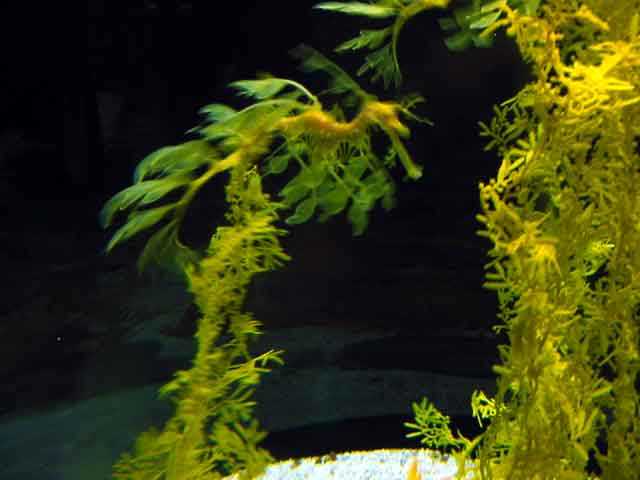
Thursday was a maintenance day; working on the bikes, sewing and writing up the Morocco chapter of the website. A very short ride on Friday to Évora allowed us to set up camp and then walk into the ancient medieval town. Smack dab in the middle of the town was a Roman temple, surrounded by medieval buildings and some of those even had Moorish influences. Evora was just the right size for exploring in an afternoon, not as overwhelming as bigger cities. On the 15th we rode to Madrid, a fairly long day of 520 kilometres, hampered only by the early morning fog but it was a four-lane autopista (free in Spain, toll in Portugal) almost the whole way. Again we used the GPS to get us to the approximate area of the campsite and then only had to do one U-turn to get to it. At camp a Swiss woman on a Yamaha said that she was just finishing a month long trip around Spain and last year had completed a two and a half year journey from India on a Royal Enfield. That sounded like quite an adventure!
Évora, looking through Temple of Diana to Sé Cathedral
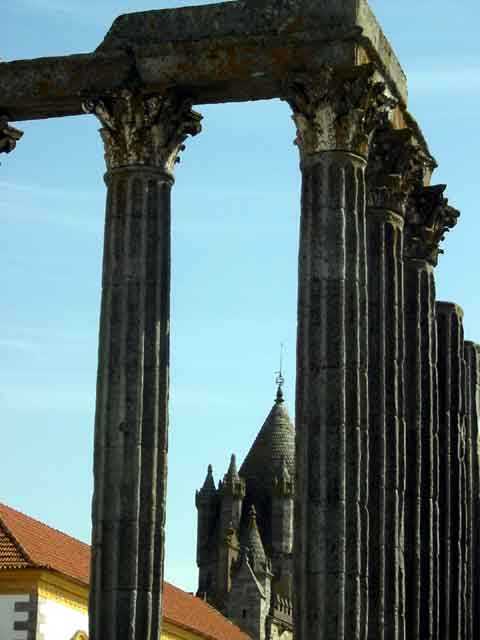
On Sunday the museums in Madrid did not charge admission, so we took advantage; visiting the Museo del Prado and Centro de Arte Reina Sofia. The Prado displayed not only Spanish masters’ works (Velázquez, El Greco, Goya) but also a fine collection of Flemish (Bosch and Rubens) and Italian (Tintoreto, Titian and Raphael) paintings. A special exhibit of Vermeer’s works on loan from the Netherlands had a 45 minute queue to enter so we decided to see Dutch works when we visited Holland in May. Instead we walked a few blocks south to the Reina Sofia and tried to figure out what modern art was all about. The most famous work on display was Picasso’s Guernica, a Spanish civil war painting from 1937, which seemed quite appropriate on the eve of a war with Iraq. Salvador Dali’s surrealistic work occupied an entire hall. Ekke, being a simple engineer, thought the only emotion aroused by many of these modern works of art was “ack!” Audrey could have mistaken some of the artwork for one of her Grade 3 class projects. Maybe we won’t be giving up our day jobs to become art critics! A stroll around Madrid in the afternoon garnered more excitement than we had bargained for. First, illegal street vendors, alerted to the presence of the police, gathered up their blankets of ripoff DVDs and Gucci handbags and made a mad dash to escape detection. In the melee Audrey could feel her small backpack being pulled away but fortunately she had both straps over her shoulders so retained possession of it. Ekke felt something brushing by his legs and looked down to see someone scrambling by his feet. Since Ekke’s wallet was in the cargo pocket of his pants, he grabbed the guy by the scruff of the neck and hauled him upright. It turned out that in the fracas the vendor had dropped some change and was trying to get it back. Not more than a couple of minutes later, we were standing in a square watching Latin American musicians when Ekke felt something brush his leg again and unconsciously reached down to the cargo pocket. Looking down he saw someone’s hand pulling out the CD for the website and his wallet! Ekke yanked the hand away and grabbed the guy by the shirt. Audrey yelled for the police and Ekke gave the pickpocket a shove before the would-be thief melted into the crowd. After a break to unwind at a café on Plaza Mayor, we continued our walking tour of Madrid, a little more wary of the people around us.
Ayuntamiento (City Hall) on Plaza de la Villa, Madrid
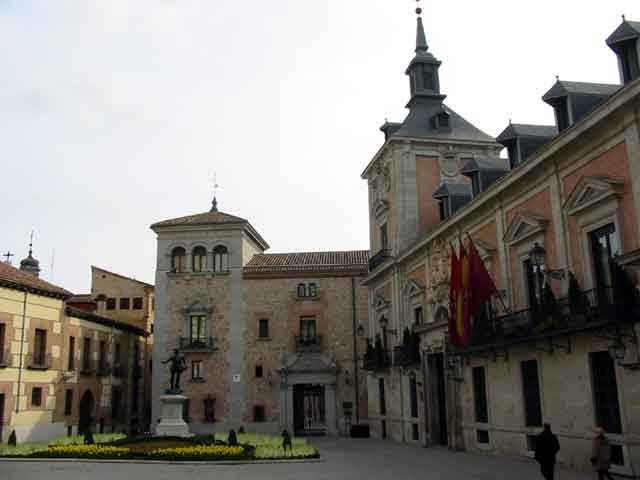
We packed up on Monday and rode past distant snowy peaks and hilltop castles to Zaragoza, halfway to Barcelona. All we had for campground information was that it was called Camping Casablanca and on the map there was a suburb of Zaragoza named Casablanca. Logically enough we went straight to the suburb and rode around in the hope that a sign would catch our eyes. To no-one’s surprise we didn’t find the campground so we rode into the centre of the city looking for a tourist office and when we couldn’t find that either we rode around the outskirts of the city, looking for any kind of camping sign. When we stopped to look at the map and contemplate alternatives we saw a motorcycle police officer setting up at an intersection to monitor traffic. We went over to ask for assistance. He knew the campground but didn’t know if it was open, so he radioed headquarters and asked them to phone the campground. There was no answer at the campground but he gave us directions anyway so that we could check it out for sure. While we were talking over the directions, the police officer came over and said that he got his partner to cover for him and that we could just follow him. He hopped on his Honda and zipped through the rush hour traffic, with us barely keeping up. After a ten minute ride we got to the campground but it was closed. We asked if he knew of any good, cheap hotels and he responded by asking if we wanted the bathroom shared or ensuite. We said, “Ensuite please” and he thought for a moment, then said, “Follow me!” Straight into the heart of the city we went, at the height of rush hour. The cop honked his horn when riding through amber lights and motioned for us to follow, waving at other traffic to stop. We were even using contra-flow bus-only lanes, pedestrians gawking at our mini-parade. Finally we ended up in front of the Hotel Avenida where he said, “I will go in and ask how much it costs” while we just sat on the bikes with stupid grins on our faces. He came back and said “52 euros, including tax,” so we said we would take it. The officer stopped traffic on the busy thoroughfare so that we could bring the bikes across and then explained to us where to park them on the sidewalk. After we thanked him profusely, he got on his bike and headed back into Zaragoza’s traffic. The desk clerk seemed nonplussed at our police escort so maybe he had this happen all the time. Later that evening, because we were not camped on the outskirts, we walked through the city centre at dusk. Zaragoza had a magnificent cathedral, the Basilica Delpilar, set on a quiet pedestrian mall. We enjoyed dinner, in a restaurant decorated with NASA memorabilia, opposite the massive church.
Giant bull statues are scattered all across Spain
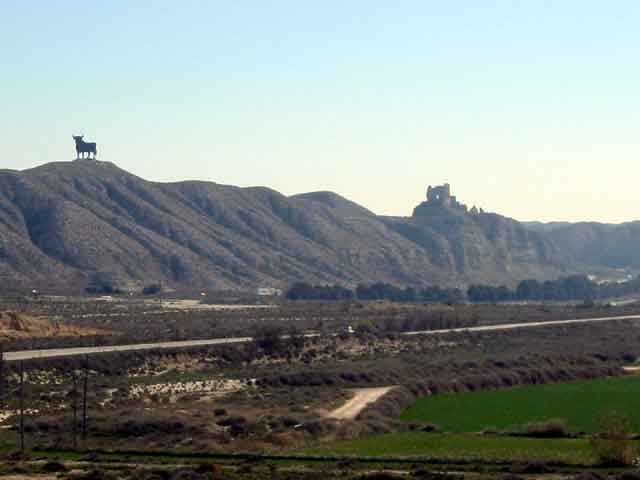
Basilica Delpilar
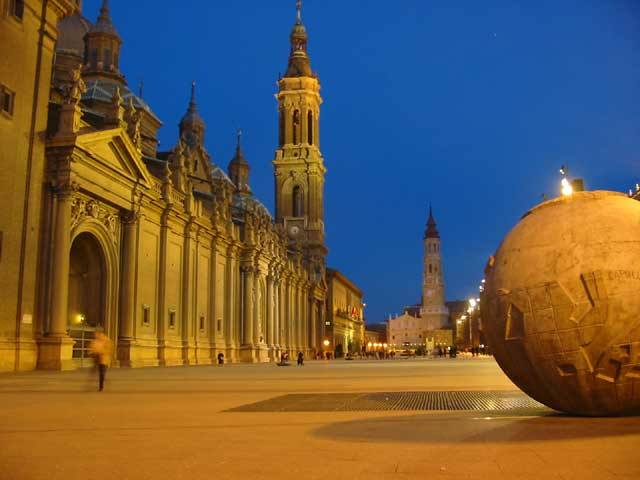
The ride to Barcelona on Tuesday was straight forward enough but once we arrived we set a new record for the length of time required to find a campground: three hours. Lonely Planet indicated which bus to take and on what road and in which town the campgrounds were located but we looked along the road and in the town to no avail. At one point we even thought of going into the centre of Barcelona to a bus stop for the L95 and following it out. It probably would have been faster than riding around in ever increasing circles. At one point we followed a motorhome for awhile but when they stopped to do a U-turn we asked them if they knew where they were going, but they were as lost as we were. Finally getting to a campground, accessing the expressway directly, we were told that it was closed but a campground back on the expressway was open. This led to the longest U-turn route we’d ever taken: because of the interchanges it was about ten kilometres to go back a kilometre. It was a pleasant campground on the beach and, a few minutes after we registered, the French couple in the motorhome we had followed for awhile showed up, shaking their heads in frustration but still smiling.
We took the L95 bus to the centre of Barcelona on Wednesday. The bus stopped near the Plaça de Catalunya, where the main tourist office was located. Here we purchased tickets for the open double decker bus tour that would take us to the sites we wanted to visit and allow us to hop on and off at will. The red bus took us north to La Sagrada Família, perhaps Barcelona’s most famous landmark, and the work of Antoni Gaudí. The garish, unfinished church took up an entire city block and was so completely covered in detail work that one could spend hours just examining the edifice. We had a pastry and cappuccino in a café across the street from the church and watched the construction workers scamper on the scaffolding. Hopping back on the red bus we rode to Park Güell, where Gaudí had turned his hand to landscape architecture and where the house in which he lived from 1906 until his death in 1926 had been turned into a museum. Again it was easy to be absorbed by the details of Gaudí’s work as we wandered through the gardens. An unexplained delay of the bus had us waiting at the curbside for over an hour but then we continued our tour of the northern portion of Barcelona. At the transfer point to the blue bus we popped into a Pans for submarine sandwiches before taking the southern tour. After a short wait we got on a blue bus and rode around the southern section of Barcelona. We rode past several of the venues for the 1992 Olympics and the vibrant Port Vell.
La Sagrada Família
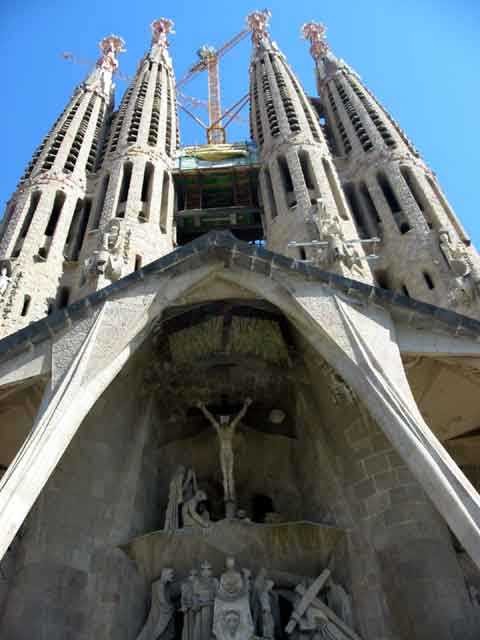
Olympic and Gaudí tower

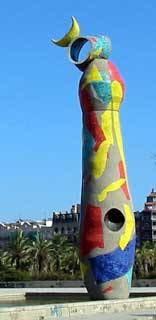
Ever since finishing up the Morocco chapter of the website we had been looking for an internet point to upload it. Neither in Portugal or Spain had we found a place that would accept a CD or allow us to hook up the laptop. So on March 20th we rode to Perpignan in France, where we had uploaded Chapter 13. This time we didn’t stay at the Mondial Hotel but rather at a campground just south of the city. While Audrey did the grocery shopping in the small village near the campground, Ekke went into the city with the laptop. We wish that we could have spent more time in Spain and Portugal, as each country was so beautiful in its own way, but we were finding that a year to tour Europe wasn’t enough. The friendly people (except for the pickpocket in Madrid) only helped to make us want to come back soon. For now, we were off in the direction of Rome.
The route

On Saturday, we asked at the hotel reception if they knew of a place to rent a truck to transport the bike. The hotel owner offered the use of a van. He got the cook, Michel, to help lift the bike into the Mercedes Vito minivan, after serving us breakfast. Michel then drove Ekke and the disabled bike to Nîmes while Audrey followed on her F650. He didn’t accept any money for this service, not even to pay the toll on the autoroute. At Sport Moto they confirmed the diagnosis of a broken driveshaft and said they could have a new one by Tuesday. They suggested a campground south of town so we rode the F650 the five kilometres there, taking the tent along. While Audrey set up the tent, Ekke returned to the dealership to pick up the remainder of the luggage.
Mercedes Vito van is bigger than it looks
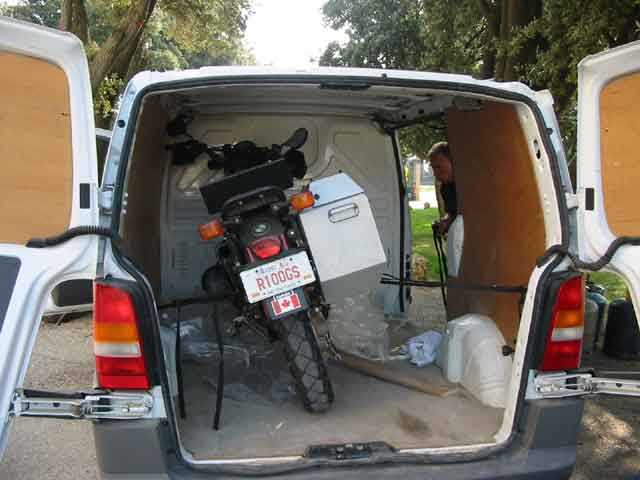
How not to pack for that round the world trip

The F650 was sorely overtaxed by having to carry both of us, bottoming out over every bump, so we did not want to do any day trips. Nîmes was home to a Roman temple and amphitheatre so we visited them both during our forced weekend off. A problem with the delivery truck at Sport Moto meant that no parts arrived on Tuesday and when the driveshaft did arrive on Wednesday, the shop was very busy getting caught up on all their other work. Finally the GS was ready at noon on Thursday so we dropped off the F650 for its regularly scheduled service and then rode the GS out to Pont du Gard. The large Roman aqueduct crossed the Gard river 25 kilometres northwest of Nîmes. The flooding in October had done a lot of damage to the river valley, knocking over trees and sending them downstream. Work was being done on the aqueduct to shore up the foundations, so perhaps damage had been done there as well. Afterwards we rode to Avignon to explore the medieval city centre. A peace rally was just breaking up in front of the Palais de Papes (Palace of the Popes) as we arrived. In Spain there had been many banners hung from houses saying “No a la Guerra” and the French also seemed to be very strongly against the war. We wandered amongst the departing protesters to the Bridge of Avignon, where only four of the twenty-two original piers remained standing. Back in Nîmes we picked up the F650 from Sport Moto at 6:00 p.m. and were ready to continue our journey the next day.
Roman temple in the heart of modern Nîmes

Pont du Gard: the flood waters were up to the top of the lower arches in October

Palais de Papes in Avignon
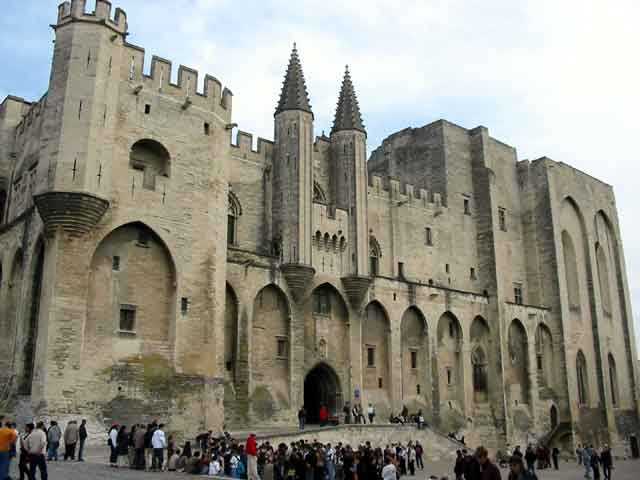
Bridge of Avignon used to connect the Palace of the Popes with France
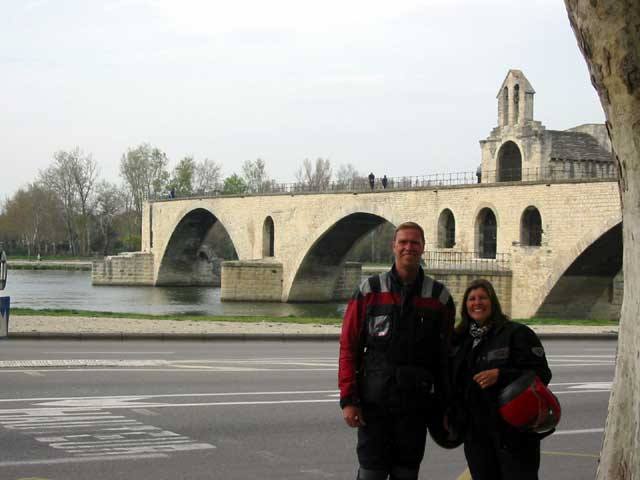
March 28 we stopped off in Arles to look at the Roman ruins of a theatre and an amphitheatre on the way to Antibes. The Aranes D’Arles had been restored and covered so that it could be used for modern sporting events. A bull fight was scheduled for April 13! Passing through Cannes we stopped off at the BMW dealer there to have a new front tire mounted on the GS (a rear had already been installed at Sport Moto and the F650 had a new front tire installed there as well to match its rear). Only 15 minutes later we were on our way to the campground near Antibes, 10 kilometres further up the road. What luxury to have a covered, heated swimming pool at a campground! So on Saturday we worked on the website and went for a swim. In need of a walk later on, we rode back to Cannes, and strolled up and down the famous promenade of the film-festival town, enjoying the blue Mediterranean and sandy beaches. The small harbour was packed with multi-million dollar yachts, and we walked around, gaping unabashedly at the lavish vessels. The streets also held Ekke’s interest where Porsches were a dime a dozen, accompanied by Rolls Royces and Bentleys, and even a bright red Ferrari daringly parked in the middle of the road.
A few of the magnificent yachts in the Cannes harbour

Yeah, just leave it there Tony!

Sunday, Ekke went for a ride, breaking in the new driveshaft and tires, on portions of the Monte Carlo Rally course, in the Maritime Alps above Nice and Monaco. He found some really twisty roads and only a little snow at the top of the higher passes. While Audrey knew she would be missing some great riding, she decided to visit the principality of Monaco instead, and get her fill of royalty and riches. Monaco certainly did not disappoint, with beautiful palaces, cathedrals and gardens aplenty. The changing of the guard was definitely a spectacle, but mostly because of the hundreds of tourists jostling for the best position. Cathedrale de Monaco was also busy, with people lined up to view the tomb of Princess Grace, former Hollywood film star and wife of Prince Rainier III. A small tourist train wound around the streets of Monaco, tracing part of the Grand Prix racecourse on its way to Monte Carlo. The casino cost money just to walk through the door, so Audrey settled for admiring the Porsches in the parking lot, and watching well-heeled tourists on their way to lose their money.
Fresh snow in the Maritime Alps

Porsche Cayenne Turbo and a selection of Bentleys and Rolls Royces in front of the Monte Carlo Casino

We headed along the Mediterranean coast to Deiva Marina on Monday morning because a campground there, listed in our “Magic Europe” camping brochure, claimed that they were only 15 minutes away from the Cinque Terre by train. We stayed on the small coastal road until Genoa where we decided that getting on the toll autostrada would be worth the saving in time, rather than fighting our way through the big city. The next day we rode the short distance to the train station from the campground and boarded the 8:45 a.m. train to the southern most of the five villages, Riomaggiore. We started hiking back north along the trail that hugged the cliffs. As the Cinque Terre is another of Rick Steves’ favourite spots we expected there to be a fair number of American tourists but we weren’t prepared for a tour group of young people from a bible college. Rather than hike with that boisterous group we stopped at the next village, Manarola, for a cappuccino break and let them get ahead. This let a vivacious group of Italian schoolgirls, that we had shared a train car with, catch up but we soon outpaced them and enjoyed a reasonably quiet walk. Vernazza came into view at lunch time so we went down to the harbour and found a small bar/café where we could take away pizzas and then sit on the dock. These idyllic villages perched on the cliffs had originally been built here so that they were easy to defend from attackers. Now tourists by the thousands came to enjoy their beauty, yet the villages had not lost their charm. Suitably refuelled, we climbed out of Vernazza, toward Monterosso al Mare. The view back down the coast, with Vernazza’s harbour below and the other three villages disappearing into the haze, was splendid. We had originally planned to catch the 16:45 train but so far our hiking speed seemed to be a bit faster than what the guidebooks indicated. The schedule showed a 15:33 train going to Deiva Marina so we thought we would shoot for that. We had to pick up the pace a bit towards the end of the trail but we got to the train station at 15:32, and of course Italian trains are never on time, are they? Well this one was. Just as we put the money into the ticket machine the train pulled in. The machine printed the tickets but no change came out, printing a credit slip instead. Rather than puzzle over that, we rushed out of the station and jumped on the train just as the doors closed. According to a friendly police officer in Deiva Marina we had to present the credit slip at a ticket agent at a train station to get the money and of course there was no ticket office at the Deiva Marina station! Thinking that we had just lost €7.40, we went back to camp where we found that the receptionist could use the credit to go to her university classes in Genoa.
Walking along the Cinque Terre
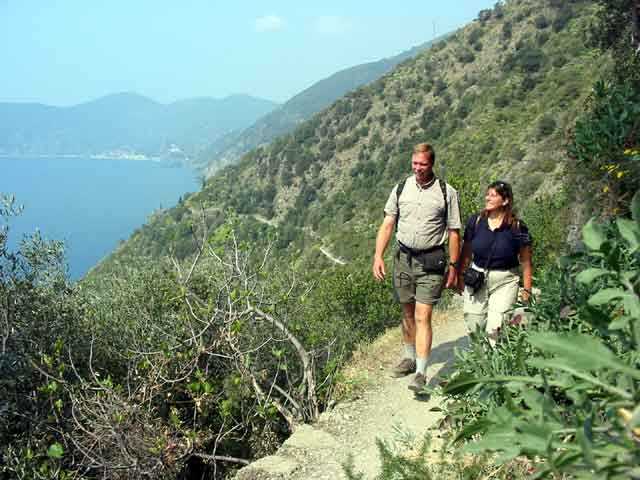
Vernazza
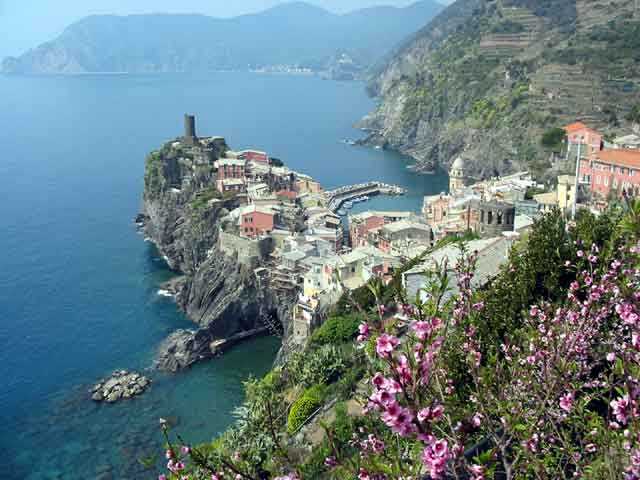
Wednesday we hoped to go to Siena via a short stop at Pisa. Leaving the coast was slow going in the fog and rain on the curvy roads and then leaving La Spezia the industrial traffic and frequent traffic signals made for even slower going. This type of riding, combined with the use of the heated grips and electric vest, killed the battery on the F650 so after push starting it we went to the autostrada. It cost us €1.40 each to travel the very short distance to Pisa but at least the battery got charged. Cold and wet, we decided to take a break in a McDonalds on the outskirts of Pisa. A mixup behind the counter meant we did not get our hot apple pies so they gave us a couple of doughnuts instead. When the apple pies came they gave us those too! Great service! Riding into the centre of Pisa we caught our first glimpse of the infamous leaning tower through a city gate. We did a quick U-turn and because we were on motorcycles we were able to park near the tower. Even with the cold, wet and windy weather there were a lot of tourists around. Some hustlers selling cheap trinkets were as pushy as those in Morocco and we naturally lapsed into Arabic, saying “La, shokran” (no, thanks) when approached. On the way to Siena the rain became heavier so we decided to shorten the distance and go to San Gimignano instead. The GS would run on only one cylinder when very wet because of a sparkplug wire shorting out. This made the ride even more miserable and we had to stop every few kilometres to dry out the wire. The rain let up a little when we got to San Gimignano and we rode around the walled town centre looking for a hotel. We had no luck and the rooms for rent had phone numbers to call rather than a reception. Despite being soaked and cold we thought we would try the campground, just out of town. The gate was open but the campground appeared to be in disarray, as apparently they were in the midst of renovating. Back toward San Gimignano was a small sign pointing to an old stone farmhouse, saying “Casale Gregoriano.” This appeared to be a hotel and we went in. We found one of the nicest, no, the nicest hotel, we have ever had the pleasure of staying in. The original building had been constructed in the sixteen hundreds and was recently renovated to accommodate five suites. Our beautifully decorated suite had a kitchenette thus dispelling our biggest complaint with staying in hotels; having to go out to restaurants for all of our meals. The €65 was already a reasonable price considering the spectacular room but the kitchenette put the icing on the cake. It was really a shame that we had to spread everything we owned all over the place to dry, putting the heated towel rack (!) to good use. Not many of our things had dried overnight so we decided to stay another day. We walked into town where we explored the medieval centre and climbed La Torre Grossa for a great view over the Tuscan countryside. We could even see Casale Gregoriano across the valley.
Audrey does her part for the tower stabilisation program
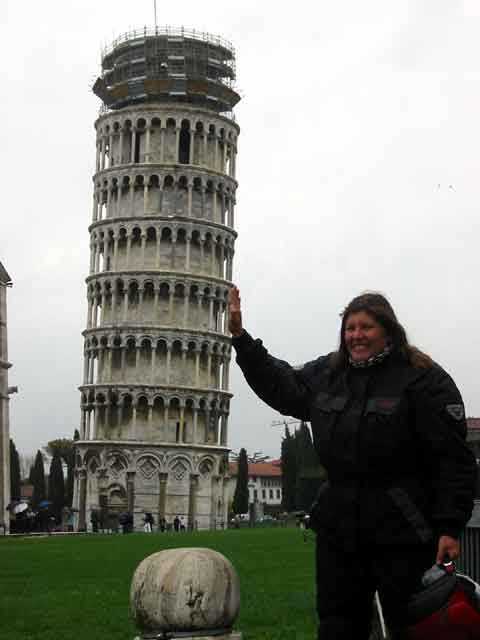
Casale Gregoriano was constructed in the 17th century
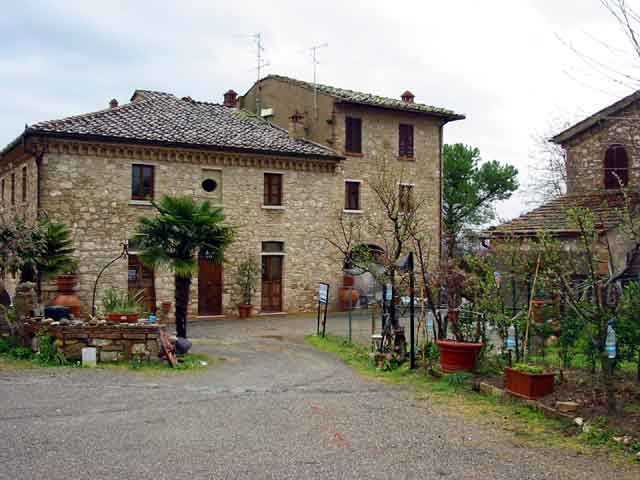
Looking out over the rooftops of San Gimignano from La Torre Grossa

The ride on Friday, April 4, was still cold and very windy but at least the rain had stopped. The views from the ridge top roads of the Tuscan countryside were tremendous, with beautiful villages scattered amongst the hills and magnificent villas surrounded by farmland. Finally after visiting Roman ruins along our route, from the amphitheatre in Pula, Croatia, to Ephesus in Turkey, Dougga in Tunisia, Volubilis in Morocco and most recently the aqueduct at Pont du Gard and the amphitheatre in Arles we reached the centre of the Roman Empire, Rome itself. Our campground was at the northern edge of the city, a short shuttle-bus ride from the metro station, perfect for exploring Rome without having to ride the bikes into the chaos of Roman traffic.
The Tuscan countryside

On Saturday morning, after moving our tent away from the bungalows that sports teams rent when visiting Rome (very noisy!), we took the bus and train to the Spanish Steps. From there we wandered through the small streets and the piazzas of Rome. Finally we had some art that Ekke could appreciate: the dome of the Pantheon. Yes, the Romans were more engineers than they were artists, but what an amazing feeling to be under a 2,000 year old dome. The walls were six metres thick at the base, tapering toward the top, and using lighter volcanic rock until at the very top was a hole that provided the only light for the building as there were no windows. We made our way to Trevi Fountain, jammed with tourists, and threw in our coins. The first coin, thrown backwards over the shoulder, indicates that you will come back to Rome and the second was for a wish. A visit to the Trastevere area at sunset was wonderful as the piazzas came to life with the diminishing daylight. Unfortunately all the tabacci shops were closed so we couldn’t buy a bus ticket to take us to a metro station. We got off the beaten path on a dead end street that made us feel rather uncomfortable in the darkness but we eventually walked to the metro station near Circus Maximus. There the ticket machine was out of order and the security guard indicated we could just get on the train. As we transferred to the train that would take us out to the suburbs we again couldn’t get a ticket so we spent the entire journey making sure we had our story straight if a ticket inspector came along. We didn’t have to use our story and were very thankful to see the campground shuttle bus at the station as we hadn’t phoned for it and didn’t relish the thought of walking along the country road in the dark.
Pantheon
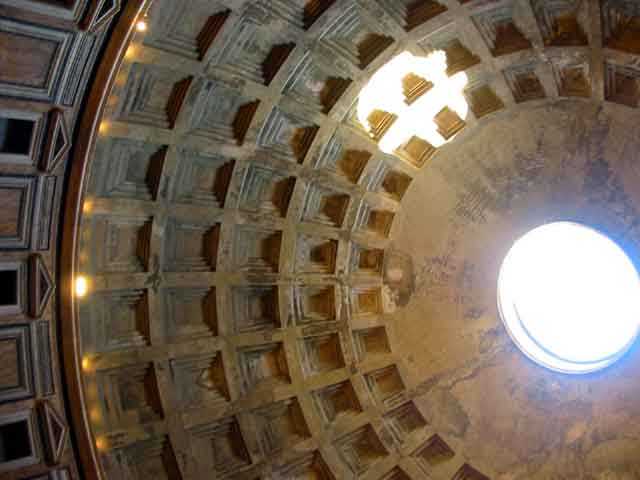
Trastevere area at sunset
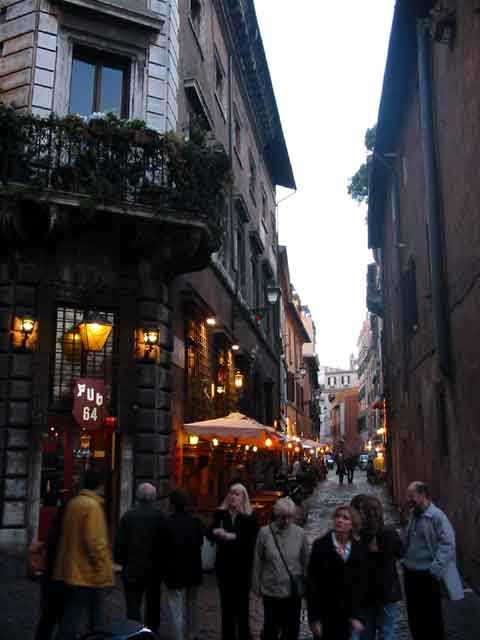
Sunday was a big day, visiting the Coliseum, Forum, Palatine Hill, Circus Maximus and Capitoline Hill. Our first stop was at the Coliseum, which was twice as large as the largest amphitheatre we had seen to date, El Jem in Tunisia which could only hold 25,000 people. For some reason the Coliseum was not as spectacular as we had anticipated it to be. Perhaps the other amphitheatres we had seen were better preserved, or even partially restored and so looked a bit nicer. In any case, the magic of the history of the place thrilled us. This is where Julius Caesar presided over gladiatorial combats! We clambered amongst the remains of the colossal stadium, imagining what it must have been like almost 2,000 years ago during one of the many spectacles held here. What was strange was that it used to be free to get into a nice, new Coliseum (senators would sponsor the events looking for votes) and now we had to pay to get into the ruins. That’s progress? Next we walked to the Forum, where the senate and hall of justice were located and the ruins of temples lay scattered. As the Forum was mostly ruins, excavated within the last couple of hundred years, we had to use a lot of imagination to see the buildings as they would have been. A walk up the Palatine hill, where the ruins of palaces lay amongst the gardens, afforded a view of Circus Maximus. This chariot racing venue could hold 300,000 spectators. Apparently at one event, wooden stands collapsed, killing 13,000. Back across the Forum we climbed the Capitoline hill, past a statue of a she-wolf suckling the legendary founders of Rome, Romulus and Remus. The piazza at the top of the hill, designed by Michelangelo, framed Rome's city hall. A leisurely stroll through the streets of Rome took us back to the metro.
Coliseum is jammed with tourists

The Forum was excavated less than 200 years ago
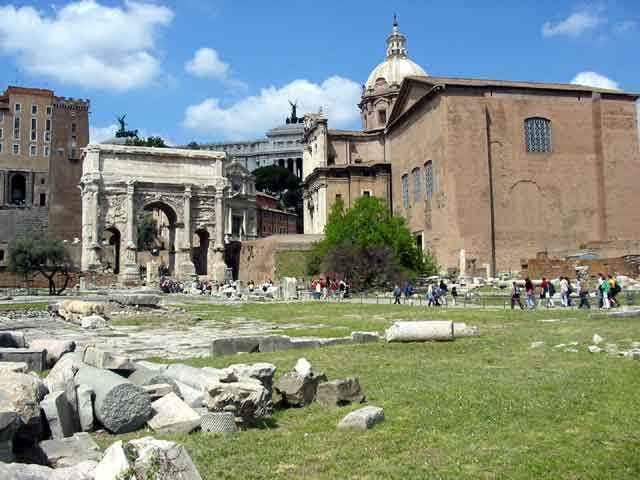
Circus Maximus

We saved Vatican City for Monday as the Museo Vaticano was closed on Sunday. A fifteen minute walk from the metro station got us to St. Peter’s Basilica. We walked through the magnificent church looking for the entrance to the museum but couldn’t find it. After asking two separate guards we were finally directed back outside and around the walls of the city to a museum entrance where a queue of people was wrapped around the block. Just as most other people, we marched through the museum, straight to the Sistine Chapel. The chapel was probably the most crowded facility to which we have been on this trip. People were standing shoulder to shoulder, all staring at the ceiling. With the help of Rick Steves’ book, Mona Winks, we also stood and appreciated the work of Michelangelo. It was interesting to note how Michelangelo, truly an amazing sculptor, painted his characters as if they were statues, with muscular, balanced forms. The long march back to the exit went through the other half of the museum and we paused only shortly at some of the more interesting works.
Swiss guard at the entrance to Vatican City
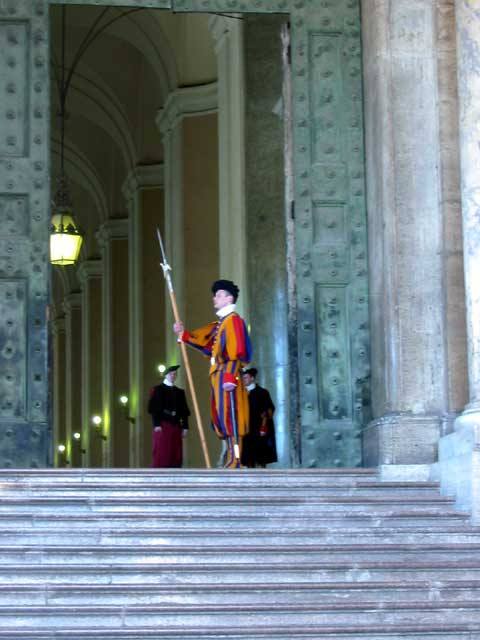
Rome was an amazing city, more for its history than anything else, and we were happy to have finally come to the centre of the Roman Empire after seeing so many Roman ruins scattered far and wide. While all roads may lead to Rome, for us, at least on this trip, all roads seem to lead to Wartenberg. We wanted to be with the Grubers for Easter so we turned north on April 8.
Our route
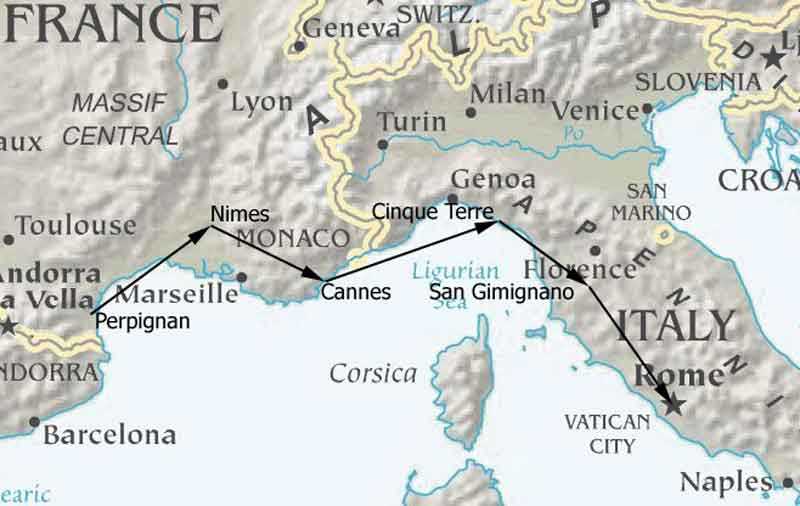
Civita di Bagnoregio: The climb warmed us up!
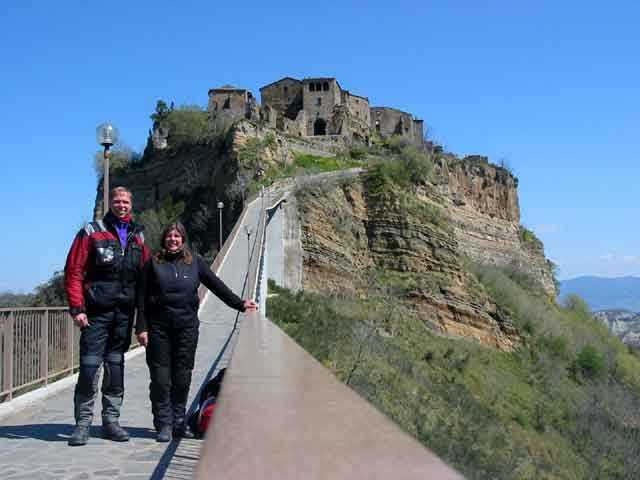
After plugging in the electric vests and turning the heated grips back on we hit the road to the north again, following small, twisting back roads until we rejoined the main highway. Next stop Siena. As we were pressed for time we rode the bikes right into the heart of the city. We figured that if scooters could ride in pedestrian zones then we could too on the motorcycles. Getting the occasional glance from pedestrians (mostly other tourists who were probably just jealous) we parked the bikes near the main square, Piazza del Campo, and then strolled around. This is where the famous horse race, Il Palio, is held every year with teams from 10 of the 17 districts of the city competing for the honour of being the fastest around the piazza. Choosing a café on the edge of the square we purchased one of the most expensive cappuccinos of the trip at five euros each. But what a bargain, as it included a view of the burnt-sienna coloured architecture and great people-watching opportunities under the warm Tuscan sun. In the late afternoon we took the autostrada to Florence and found Camping Michelangelo at about six o’clock. The tent looked great, with a terrific view of Florence in the background and the city’s skyline framed by the surrounding hills.
Siena: Piazza del Campo
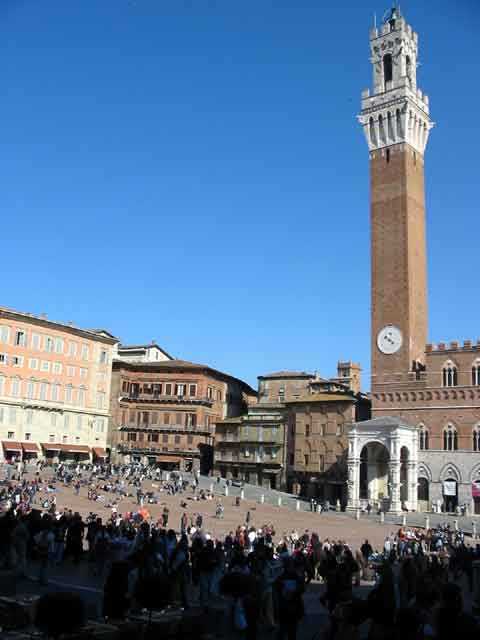
Miserable Weather in Florence

Wednesday dawned with a miserable looking steely grey sky. We walked into the city, first stopping off at Piazzale Michelangelo, where a copy of Michelangelo’s David stood, and then down the hill and across the Arno river. The first stop was at the church of Santa Croce to peruse frescoes and paintings and look at tombs of famous locals such as Michaelangelo, Dante, and Galileo. The weather really improved as we walked through Florence’s medieval streets, getting a closer look at Brunelleschi’s dome and the Galleria dell’Accademia. This gallery houses Michelangelo’s original David, a sculpture that was absolutely mesmerizing in its beauty and, erm... size.
David
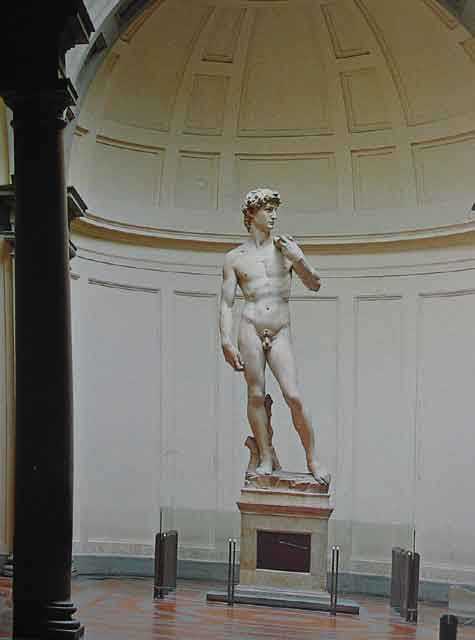
Florence’s famous Uffizi gallery was on our list for Thursday. The gallery was very nicely laid out in chronological order, which allowed us to see the progression in skills and style through the Renaissance. Our favourite work was Leonardo da Vinci’s Annunciation with amazing detail that seemed totally natural. That enigmatic smile looked familiar too, reminiscent of Mona Lisa. Michelangelo’s only easel painting was also on display and it was interesting to see how the famous sculptor’s painting looked a lot like his statues with strong, muscular forms. Later in the afternoon we were forced to duck into a small, hole-in-the-wall restaurant to get out of the pouring rain. A nice lunch was followed by an absolutely terrific tiramisu. A check in at an internet place confirmed that the weather in Florence wouldn’t improve until next week sometime.
Pont de Vechio
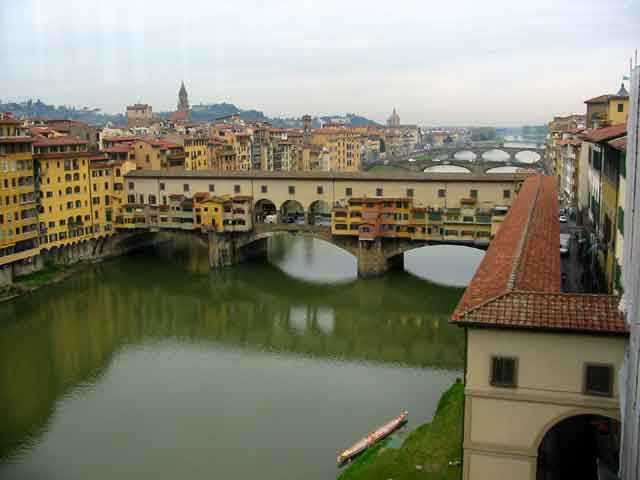
We decided to stay one more day in Florence so on Friday Audrey went to the Bargello museum, a medieval palace housing sculptures by Donatello and Cellini. Ekke updated the website and then went to a BMW dealer to pick up a couple of bike parts. Ekke also picked up some BMW winter gloves since our current gloves were not 100% waterproof any longer and were not insulated. After Ekke installed the new parts on his bike and adjusted the carburettors, the GS finally ran perfectly for the first time since Istanbul. Hurray!
We were grateful for the new gloves on Saturday after we packed up a muddy, wet tent and rode into the Tuscan hills. It was cold and wet with patches of fog to slow things down even further. A couple of new Ferraris on the road (we were near Modena) lightened the mood a little but despite the terrific road (that is tight and twisty) we were not enjoying the ride that much. We finally called it quits in Bologna. Bologna is a town that hosts a lot of conferences and as a result most hotels rooms are booked early and are expensive. We ended up at Pensione Marconi for €70 in a rather spartan room. At least it was dry! Walking to the tourist office we found that the Ducati museum was closed on Saturdays. Drat!
Because of the miserable distance covered on Saturday we needed to put on a few extra kilometres on Sunday. Our hope was to get to Füssen in Germany. What a difference a day makes! It was sunny with hardly a breath of wind so the riding was easy heading north. We used a combination of Autostradas and surface roads to maximise the speed and keep the costs under control since the Autostradas are toll. It looked like every motorcyclist was out enjoying this perfect day. Riding past Verona and on to Trento the scenery became quite familiar. We had spent a week just up into the mountains at Sarnonico last summer. We dropped down from the Brenner pass to Innsbruck again enjoying a familiar sight. There was little snow at the top of the pass but nothing on the roads. We then took the Fernpass out of Austria to Füssen and the snow was a bit more prevalent but still not on the roads. The 550 kilometre ride had been easy and really enjoyable. What great fun to be back in the Alps! The five star campground recommended in our guide (a motorcycle touring guide) did not take tents, which we found kind of baffling. A campground without tents?!? And this campground was recommended in a motorcycle guide?!? How did they expect motorcyclists to camp? Anyway, the host was very friendly and directed us to a campground on the other side of Füssen which turned out to be closer to Neuschwanstein. The tent sites were situated on a small hillock that afforded a spectacular view of the Alps, Neuschwanstein and Hohenschwangau. The camp was very new and the facilities were amongst the finest anywhere with good hot showers and even Star Trek sliding doors.
Snowy ride through Austria

A nice hilltop camp spot near Neuschwanstein
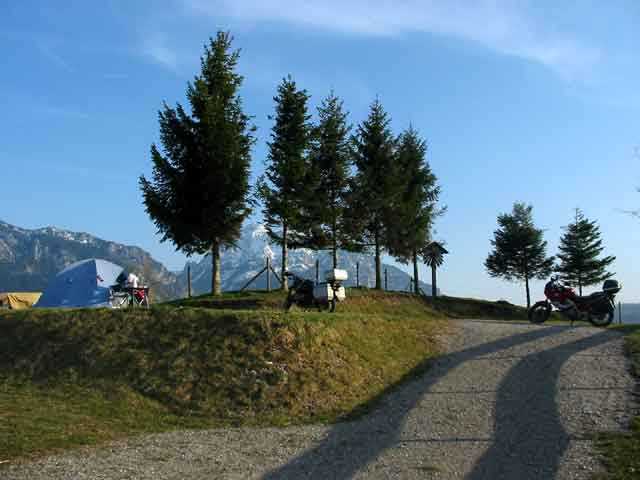
The next couple of days were spent visiting the area. At Neuschwanstein there is a bridge over a gorge so that you can view the castle from behind. It is a very high bridge and the last time we had visited in 1996 Ekke had refused to go out onto the bridge, not only because of the height, but also because just at that time an army unit was crossing. Any first year engineer will tell you that harmonic vibration stresses are the most dangerous and that an army marching in lockstep is the perfect example of harmonic vibration. So it was with some pride that Ekke managed to cross the Marienbrücke this time. On Tuesday Audrey took a tour of the interior of Neuschwanstein and Hohenschwangau and she was amazed by the opulence. In the meantime Ekke climbed Tegelberg behind Neuschwanstein, after crossing the Marienbrücke again, for a spectacular, birds-eye view of the region. Wednesday morning was so cold that there was a thick layer of ice on our water container. It warmed up nicely in the sunshine and we took a daytrip over to Linderhof, another of King Ludwig’s castles. The exterior of the castle was completely shrouded by scaffolding as renovations were being done, but the interior was completely stunning in totally over-the-top decor. As Ludwig preferred to be alone he had a special table constructed. This table was lowered through the floor down to a room below where it was set for dinner. Then, like an elevator, the table was raised back upstairs so that the king could eat without having to have seen anyone. Spring had not yet sprung on the palace grounds so a walk through the gardens was not as enticing as it could have been but we enjoyed ourselves nevertheless. Three motorcycles pulled into the parking lot as we were suiting up and we chatted with the German teachers who were out for a ride. Amazing how Alberta plates will attract attention when you’re in Europe!
Neuschwanstein and Hohenschwangau from Tegelberg
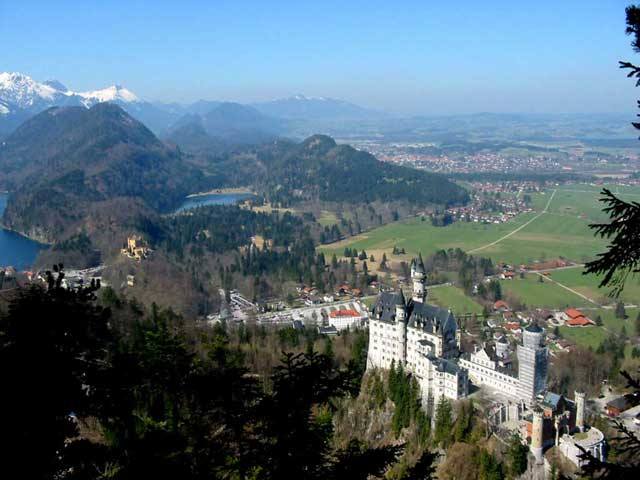
Frosty morning
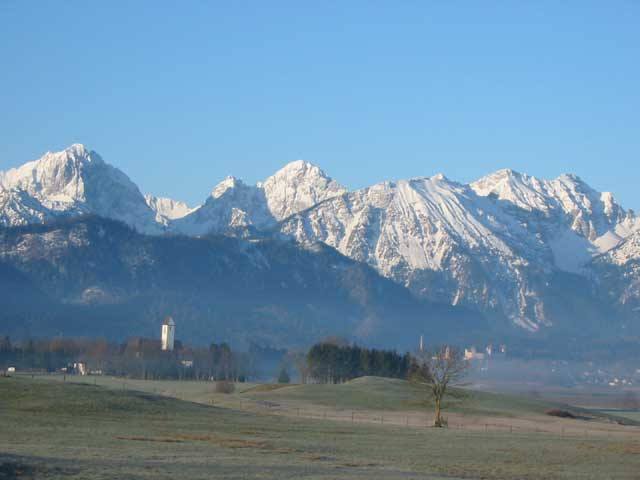
Linderhof
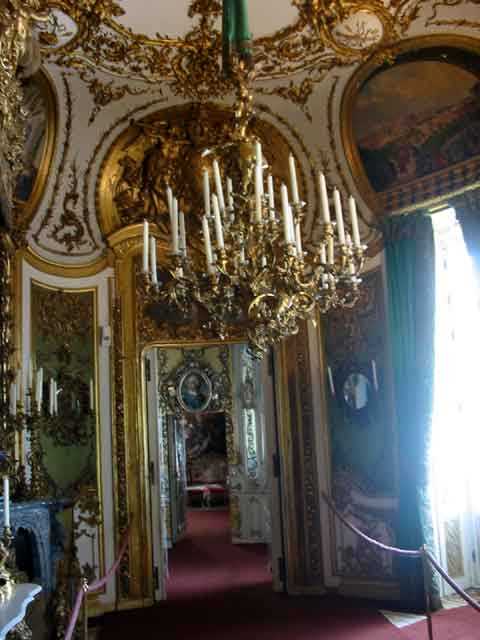
After another day of enjoying the area around Füssen we took the Romantic Road to Rothenberg on Friday, April 18th. The road was created as a tourist attraction, so that people would come to visit along the route. Perhaps our definition of a romantic road is a little different from those who created the road. We thought we would enjoy a pleasant ride through the German countryside, puttering through little villages and stopping for lunch in a little café. It wouldn’t be a fast road but it would be narrow and lined with trees. The reality was a wide, fast road that didn’t go through any romantic villages and was clogged with high-speed traffic. We accidentally got away from the Romantic Road and right away were immersed in the countryside we had dreamed of, stopping for a picnic near a small river. At least Rothenberg was a beautiful, romantic town. The walls surrounding the mediaeval town centre were mostly intact from the middle ages. That night we joined George, the nightwatchman of Rothenberg, on his rounds as he gave a guided tour of the town. He regaled our small group with stories of the town’s history, pointing out interesting sights along his route. One such sight was a cage suspended above a small pool of water. If you had purchased a loaf of bread and found that it was smaller than it was supposed to be, you had recourse to the town magistrate who could mete out punishment to the offending baker. The baker would be put in the cage and dunked in the water!
The face on the wall at Rothenberg was used to pour hot pitch on to invaders
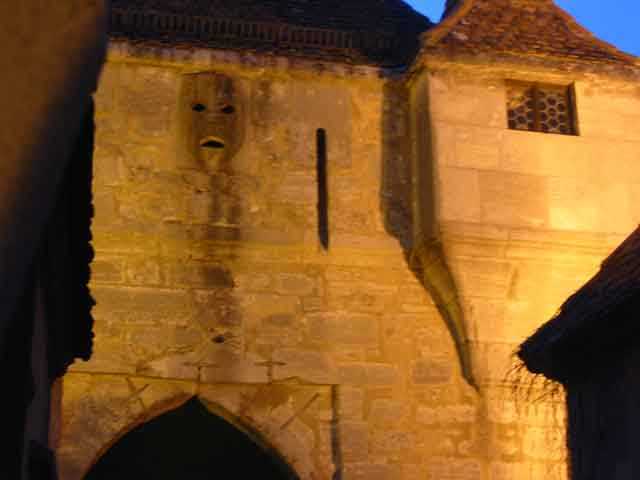
From Rothenberg we had an uneventful ride to Wartenberg to enjoy the Gruber’s hospitality over Easter. We were getting to know the way to Wartenberg so well that we didn’t even need the map or the GPS! This gave us an opportunity to do some much-needed maintenance on the bikes and also go through the mountain of things we had left with them rather than pack along. We ended up shipping four large boxes of stuff back home. After mailing the boxes on Thursday, April 24th we left Wartenberg for the last time, heading in the direction of Vienna.
Nice Easter treats at the Grubers
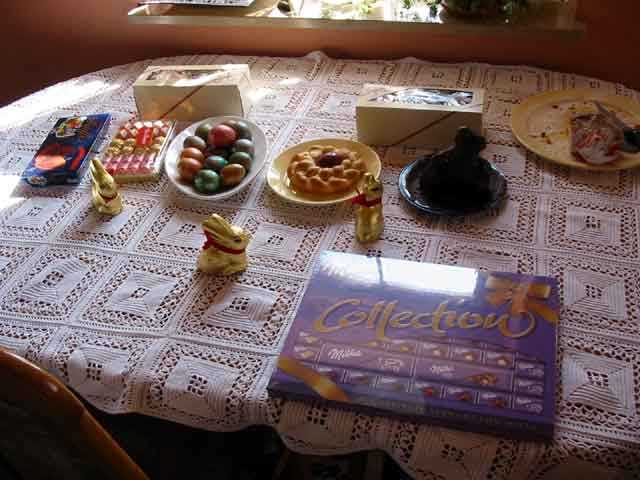
Map for April 8 to April 24
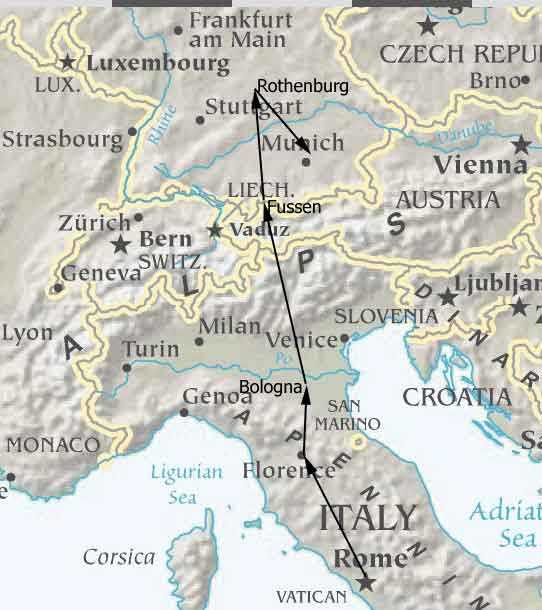
A boat ride across the Chiemsee took us to the castle island
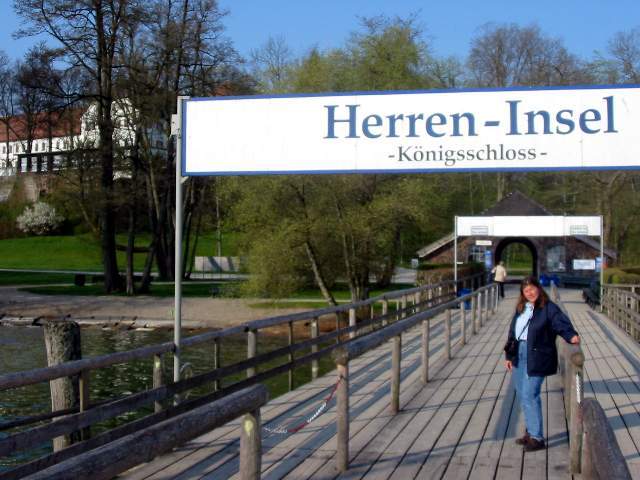
Inside Herrenchiemsee
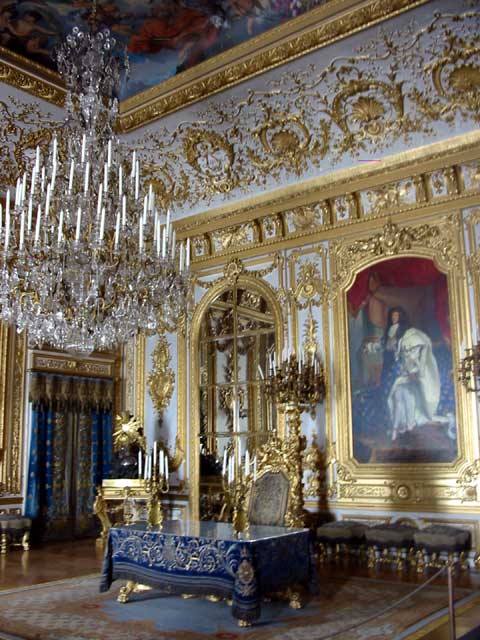
Jumping on the autobahn, we headed in the direction of Vienna, planning to visit that beautiful city for a few days and then turning north to Berlin via Prague. The plan went awry just east of Salzburg. Audrey’s F650 died beside the highway with a dead battery. We disconnected the headlight and rode back to Salzburg to find the nearest BMW dealer. We don’t know if the reason that the new regulator was so expensive because that is the normal price or because the BMW dealer in Salzburg is also the Ferrari dealer! In any case we waited almost a week for the bike to be repaired and enjoyed our time in Salzburg.
Beautiful Salzburg
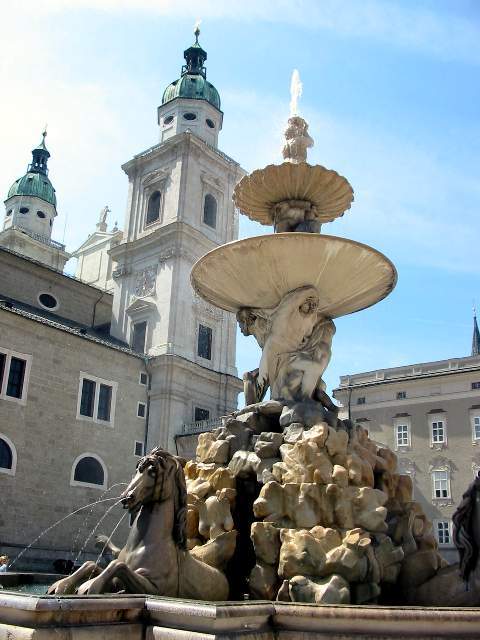
We used the opportunity to purchase a new tent as our faithful Mountain Equipment Coop tent had become brittle from overexposure to the sun. It was a bit of a sad moment after purchasing a McKinley Ranger 5 and setting both of the tents up side by side that we had to toss the MEC tent into the dumpster.
The old and new tents
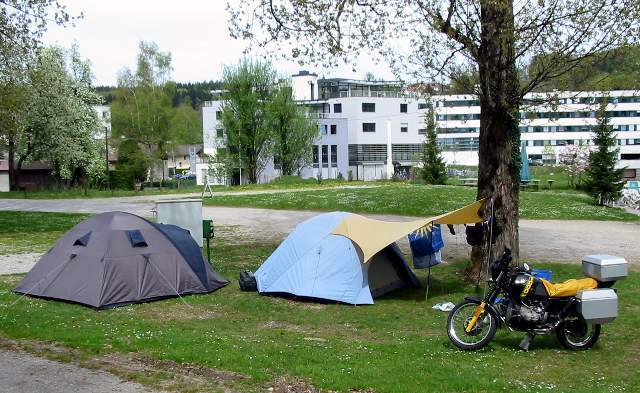
As Ekke had made an arrangement to tour the BMW motorcycle factory at a specific time in Berlin the time to visit Vienna and Prague had evaporated. We thus rode the autobahn from Salzburg to Potsdam, just outside Berlin, in one day.
Ekke's bike back at its birthplace, the Spandau motorcycle factory in Berlin
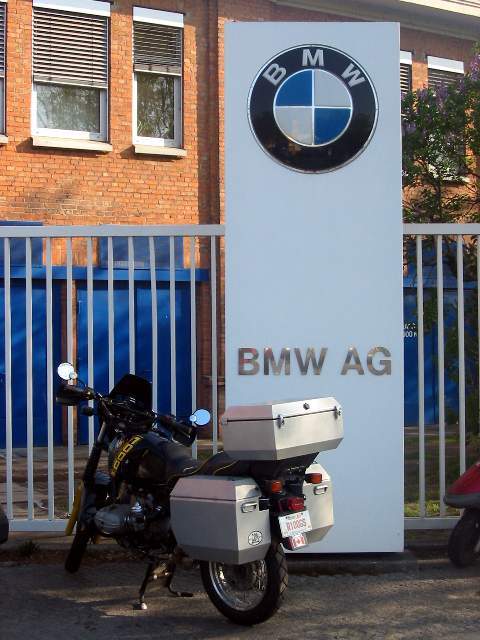
The gardens in Potsdam

Potsdam

The best view of the Brandenburg Gate in Berlin is from inside the Starbucks
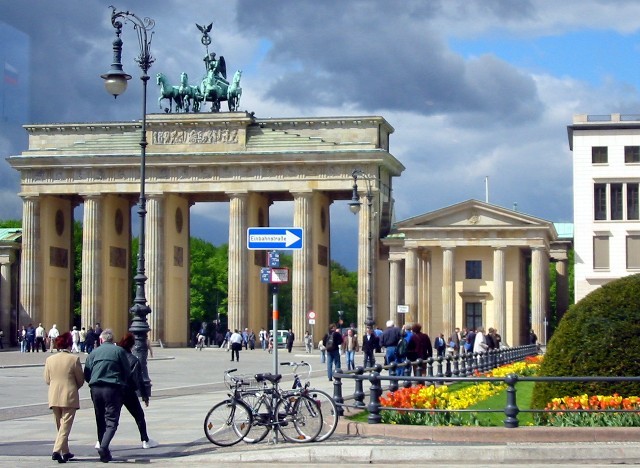
Mayday celebrations in Berlin
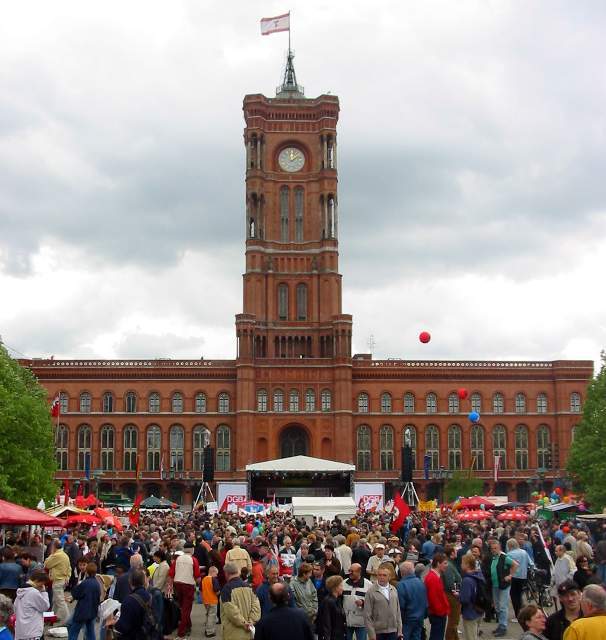
From Berlin we rode west to Bielefeld to visit our friends Peter and Inge. Our friends’ motorcycle club owns a property in the Eiffel region, only a few kilometres from the famous Nürburgring race track, so we rode the 300 kilometres there together. We camped there for a few days, taking day trips around the countryside. The roads were just as much fun as those in the Alps, tight and twisty. For only a few euros we took Ekke’s bike on the Nürburgring, riding two up. Needless to say we got passed like we were standing still! A Rhine cruise and visiting castles finished up our time in Germany.
Bielefeld's castle on the hill
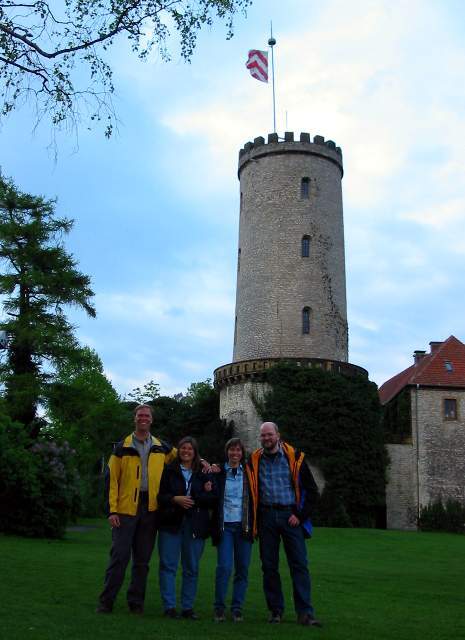
On the road to the Nürburgring
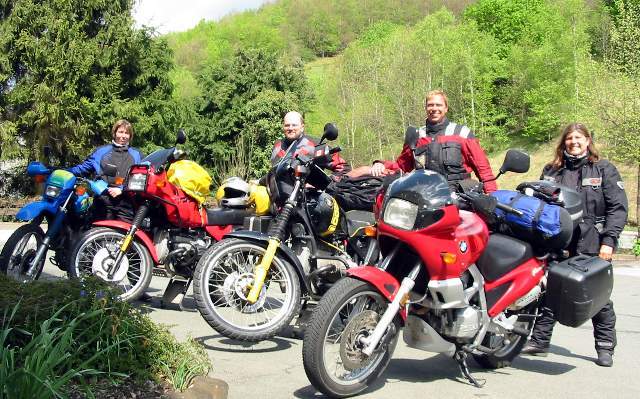
A Porsche at speed on the Nürburgring

A spectacular castle in the German countryside: Berg Elz

Riding down to the Rhine
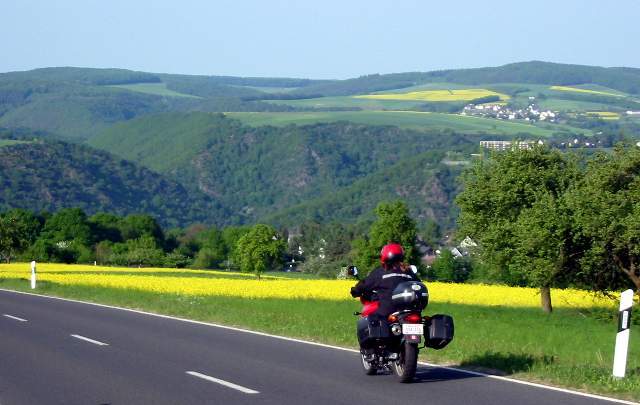
On the Rhine cruise
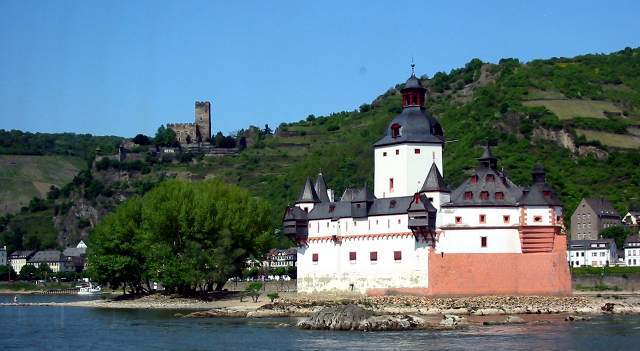
Castles are plentiful along the Rhine
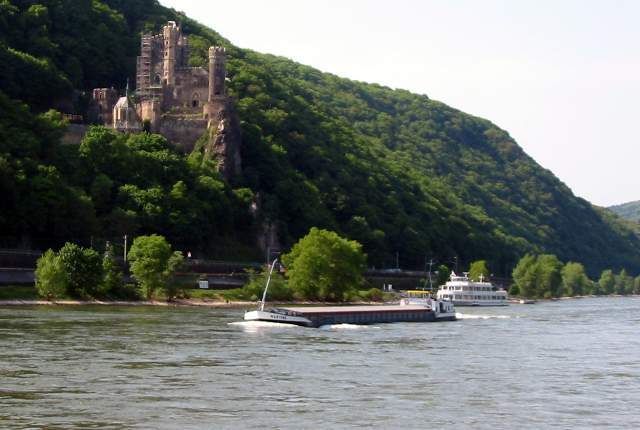
Springtime
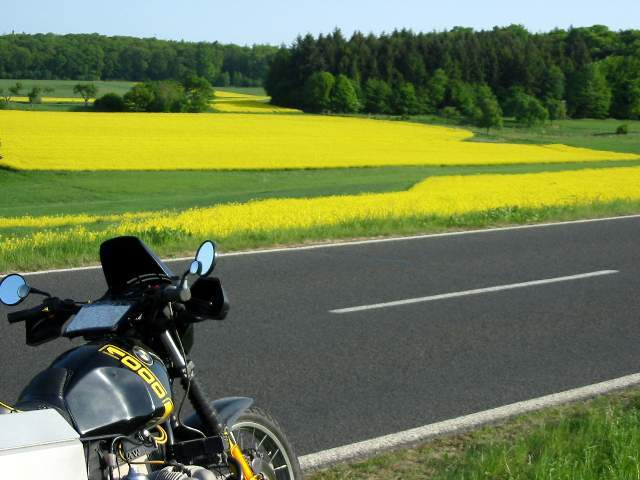
Leaving our camp near the Nürburgring and heading for Luxembourg
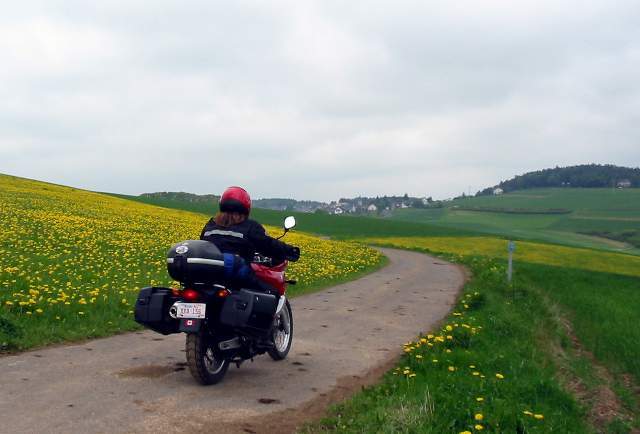
After Easter we left Munich for Vienna and Prague but ended up going to Berlin from Salzburg

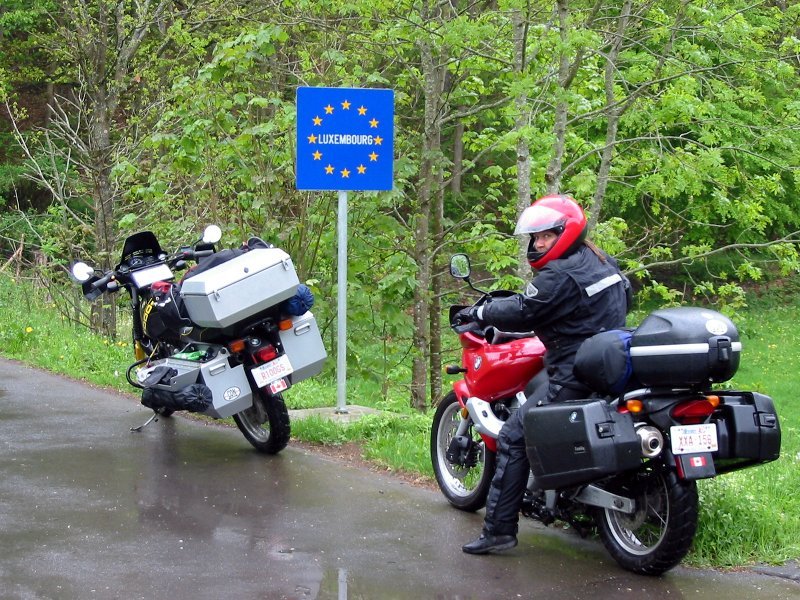
The next day we caught a bus downtown. Happening upon a market, we enjoyed our usual cheese, bread and fruit lunch, overlooking a sunken garden. Views in Luxembourg were spectacular as we made our way along the city wall, taking in the history of the place. It lived up to its reputation as Europe's `most beautiful balcony'. Our walk took us past the royal palace, protected by a very stern looking guard.

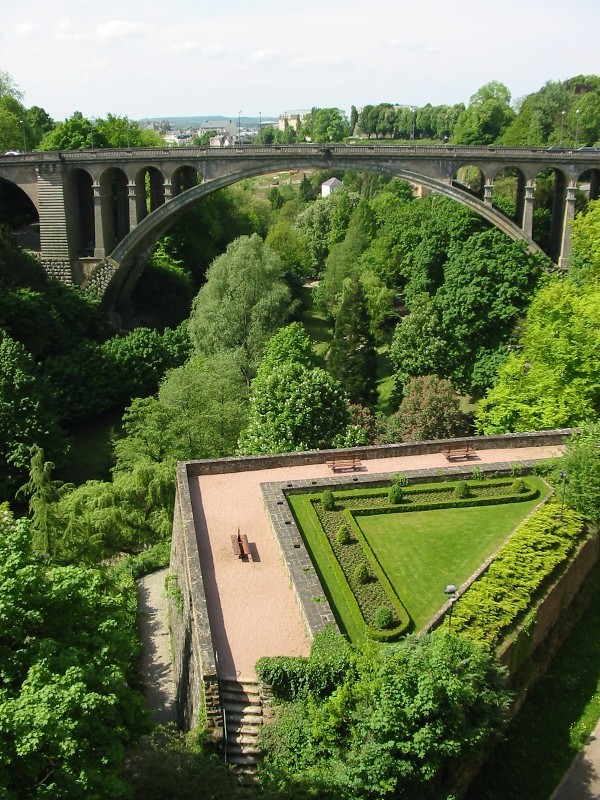

Did you know that the best waffles in Europe are in Luxembourg? Good thing we did all that walking.
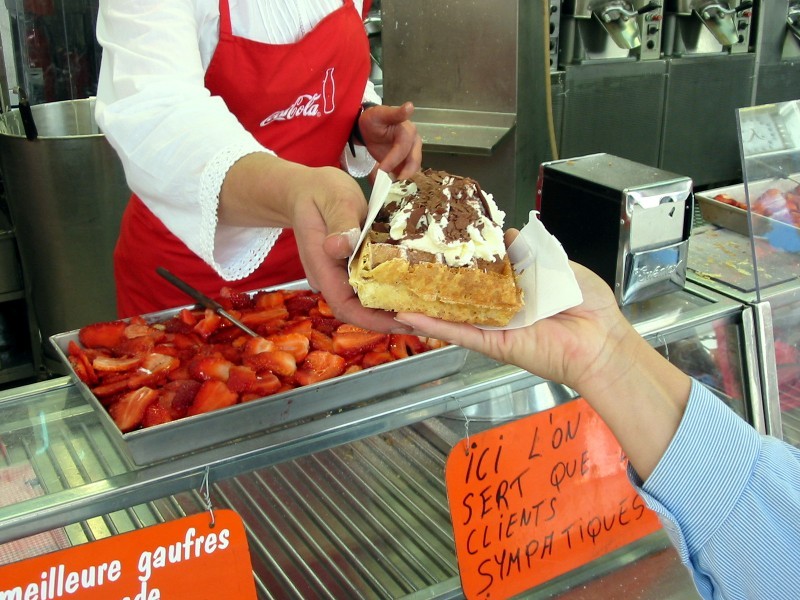
Ekke always seems to photograph a few vehicles along the way, and Luxembourg was no exception.
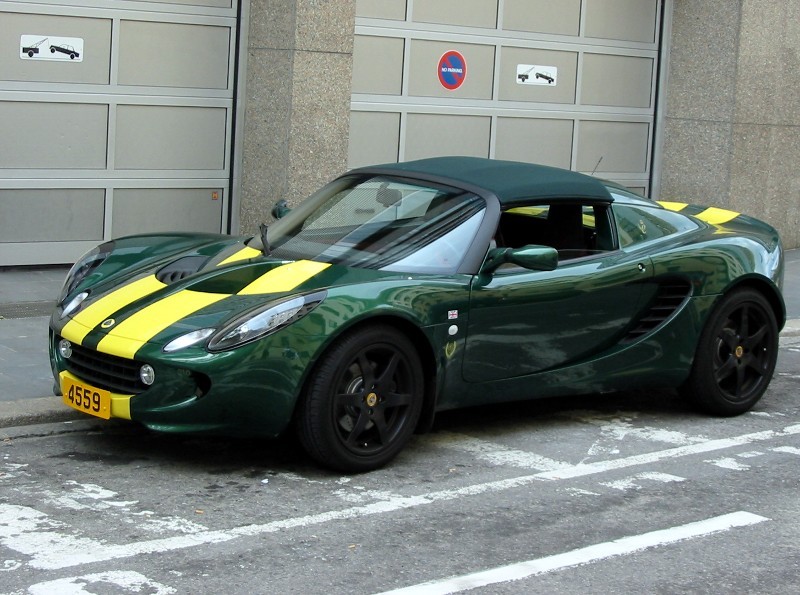
A ride along the Mosel River the next day, a region famous for its Riesling wines, took us back into Germany, to the city of Trier. Greeting us was the Porta Nigra, or Black Gate, which was built by the Romans, with their usual flawless engineering. Walking down a wide, cobble stoned street, we came upon a cathedral, built by the emperor Constantine. It's said that Helena, his mother, brought Christ's robe there to give the place some credibility, and supposedly it's housed in a box in the cathedral. We got a good look at the box. A ride back to camp on some twisty little roads capped off our day.
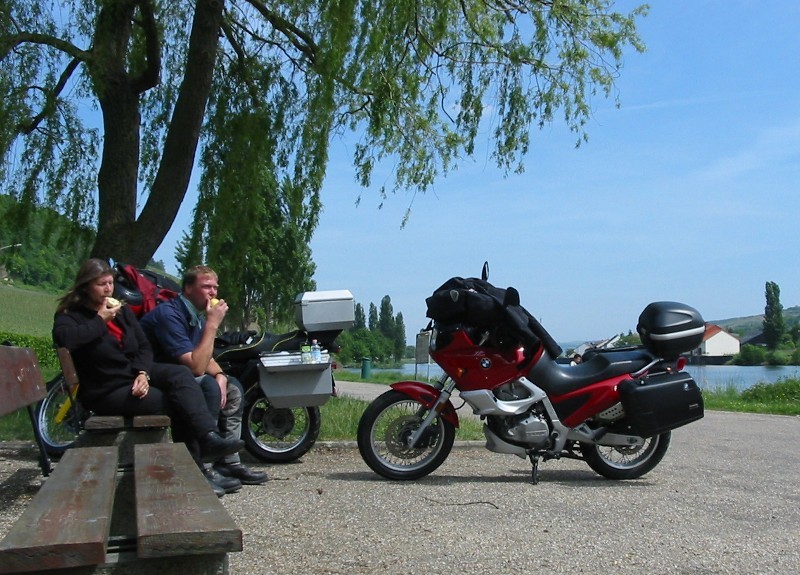
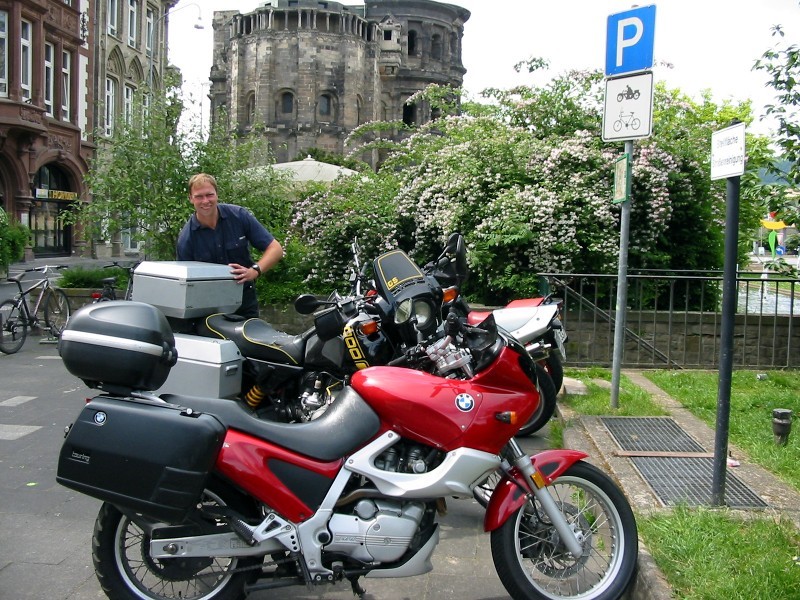

It was a rainy ride into Belgium, and if we hadn't seen the "Belgium" sign, we'd hardly realize we were in a new country. Although our destination was Bruges, Audrey needed to stop in Brussels to see Manneken-Pis. It was so tiny (the statue!), we weren't sure what all the fuss was about. Apparently people send little costumes for `Pis' to wear, and through the window of the museum we were sure we saw `Elvis-Pis' in a white beaded jumpsuit. The Grand-Place, lined with guildhouses, was adequately guilded and elegant, so our 30 minute trip to Brussels was a success.

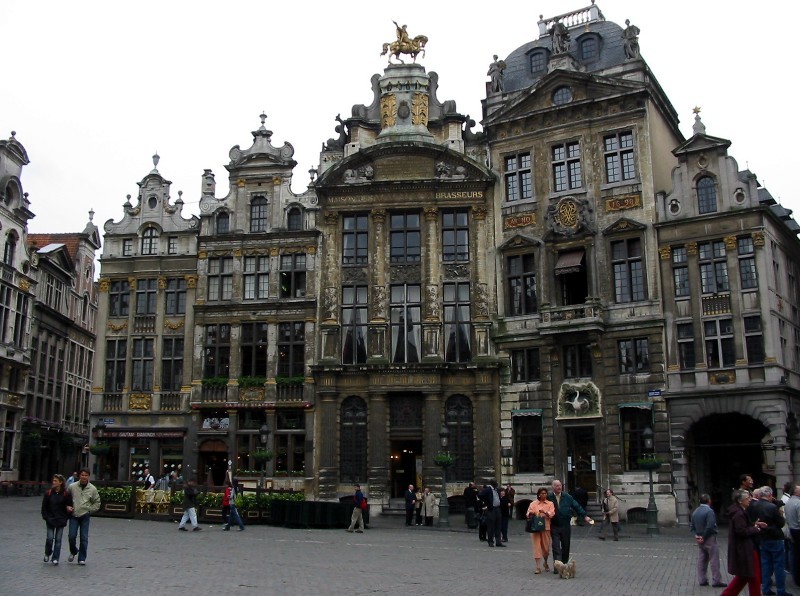
Did you know that the best French Fries are in Belgium?

Europe is very motorcycle friendly and so motos are allowed to split lanes. This is frowned upon and illegal in most of North America, but here we could drive right between lines of cars that were waiting to move ahead. Not a problem if you're on Ekke's R100GS with very compact Jesse bags, but Audrey found it a challenge as her wide BMW bags gently touched vehicles on both sides. It wasn't so bad when vehicles were stopped, but when the traffic started moving, in the rain, it got a little nerve wracking. Another lane splitter, on a BMW R1100RT, came up behind us at about 100kph. Ekke tried to keep up with him but found it way too scary blowing past cars like they were standing still. We eventually made it into Bruges, safe and sound, though Audrey's saddlebags had a hint of Mercedes blue on the left and a dash of Fiat red on the right.
As it was raining the next day it would have been easy just to sit in the tent, reading and sipping hot Belgian chocolate, but we hauled ourselves out to go explore Bruges. The sun made an appearance and we thoroughly enjoyed the preserved medieval city. Bruges, an important port and prosperous cloth manufacturing town, became obsolete with the silting of the Zwin River. As a result the architecture remained unchanged through the centuries. The town had everything a tourist could want - a Michelangelo statue in the Church of our Lady, canals with boat tours, step-gabled 13th century buildings and, best of all, an internet café with complimentary cake and chocolate with the tea.
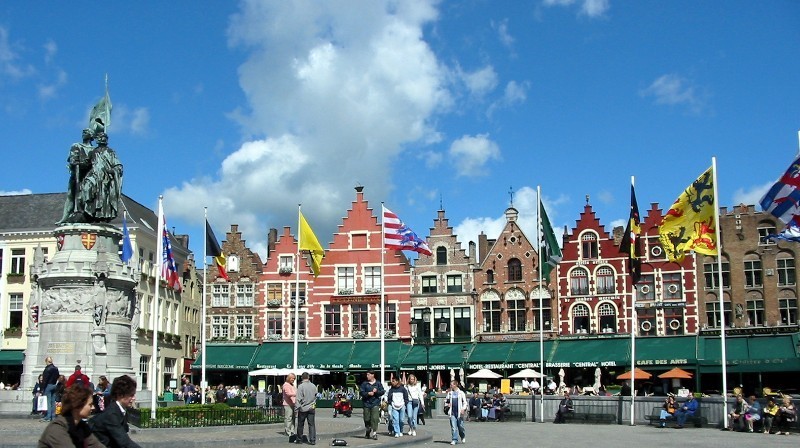


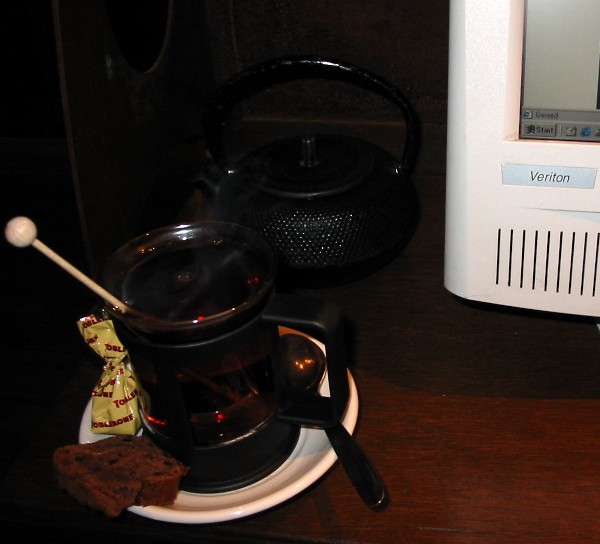
We did succumb to the idea of relaxing in the tent on Wednesday, sipping hot Belgian chocolate, but on Thursday, May 15th, we packed up the tent, said goodbye to the French fries of Belgium and the Belgian waffles of Luxembourg, and set off to find what culinary delights awaited us in the Netherlands.
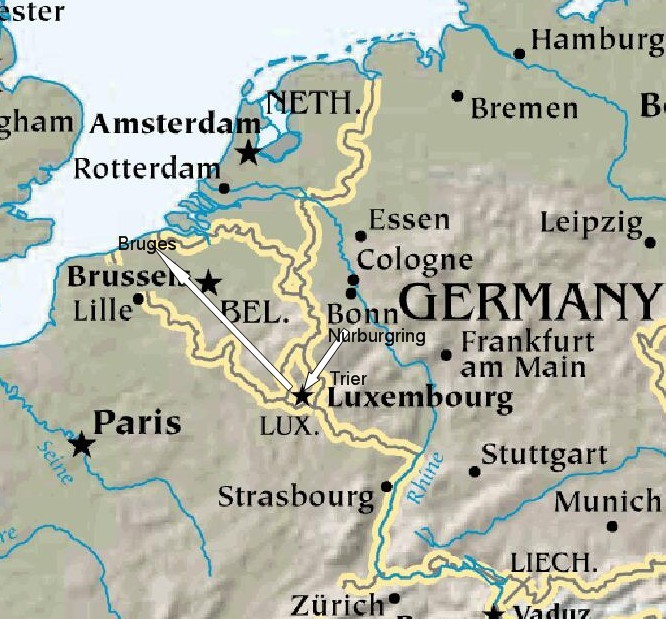
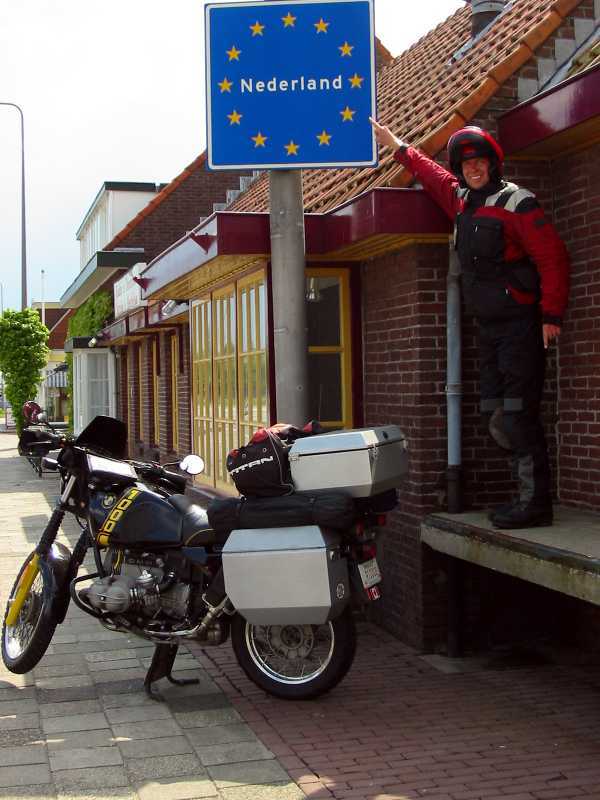
We rode our bikes out of Belgium in the middle of May and entered Ekke's homeland, The Netherlands. A tunnel took us under the Westerschelde and then on to the Delta Works, a massive arrangement of locks, dams and surge barriers to control the North Sea. The project was started in 1950 but took on extra urgency after the severe flooding of 1953. From Rotterdam to Amsterdam the Autobahn was bumper to bumper traffic and we had to be on our toes for any traffic disruptions. We found our way to Diemen, just outside Amsterdam, and the home of Ekke's uncle Alle. Alle took us for a walk in the neighbourhood the next day so that we could familiarise ourselves since he was taking a holiday and we could enjoy the use of his apartment while visiting in The Netherlands. We took him to Schiphol airport on Saturday in his car and then picked up tune-up supplies at the BMW dealer. That evening Ekke's mom, Magda, arrived at Schiphol so we borrowed Alle's car again to pick her up.
Going for a walk near Diemen with oom Alle
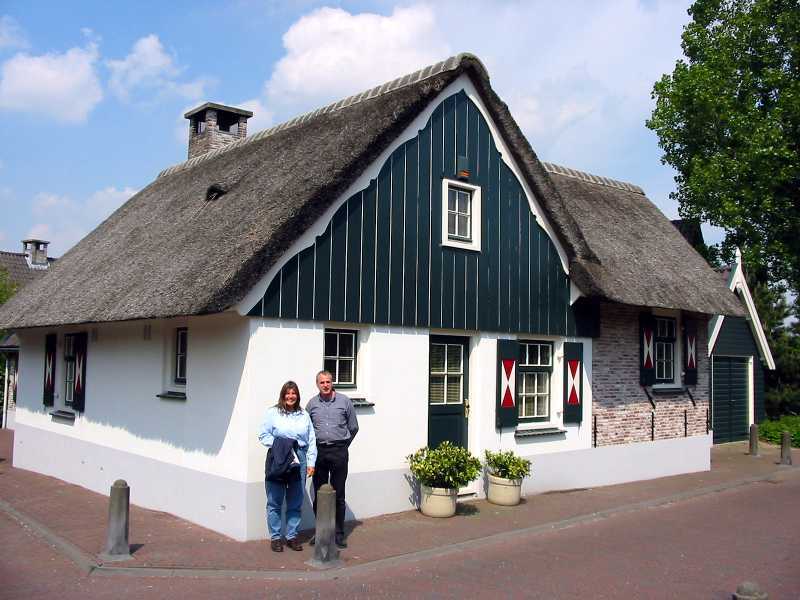
Oom Alle goes on vacation
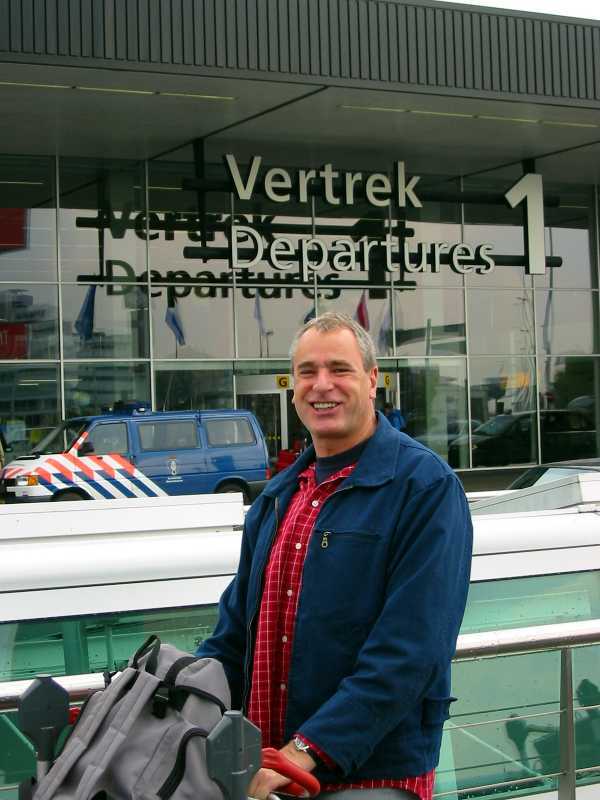
What was the name of the Dutch airline again? Oh yeah...
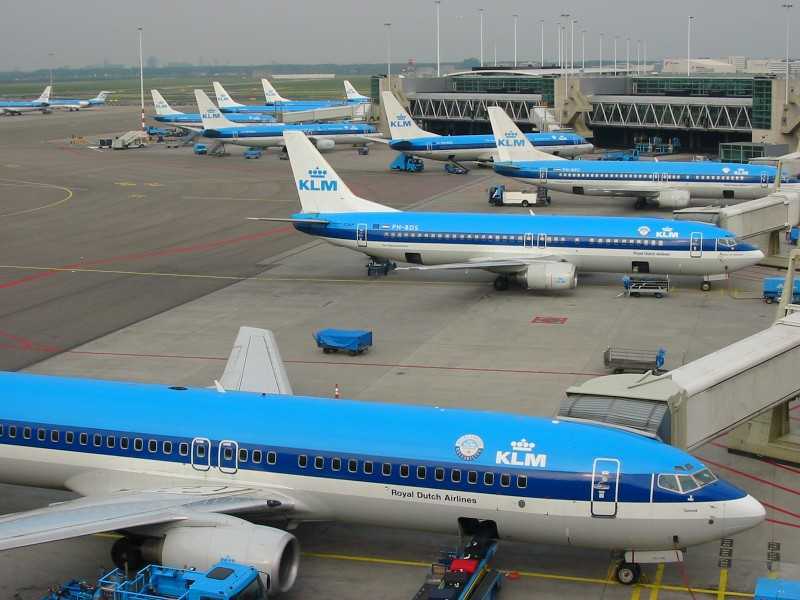
Ekke's mom, Magda, arrives at Schiphol Airport
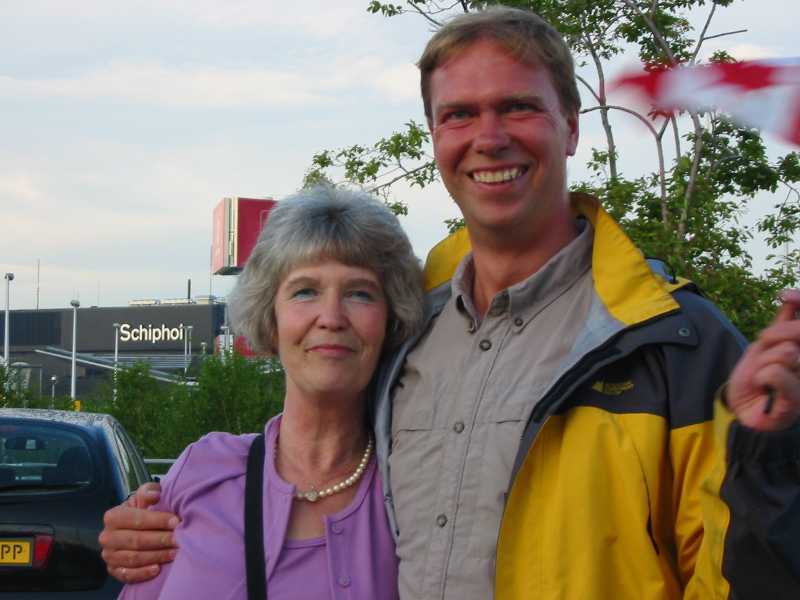
Sunday we went with Magda to the Van Gogh museum in Amsterdam. The public transportation system in Amsterdam is convenient and easy to use. At the museum we were really impressed by the special exhibit that had Van Gogh works side by side with Rembrandt, Rubens and Monet. Amsterdam was a delight to walk around as we explored the old city centre. The next day Magda took Alle's Toyota Yaris and went travelling; we would meet up with her at various locations in the coming weeks. The first place would be at Ekke's uncle and aunt, Ronald and Dinie in Zwolle. We rode there on Tuesday, taking all the back roads, going through Lelystad over the polder along the IJssel Meer. Too bad about the heavy rain, as we arrived completely soaked and had to throw our motorcycle gear somewhere to dry out. It was great visiting with the relatives!
Strolling in Amsterdam
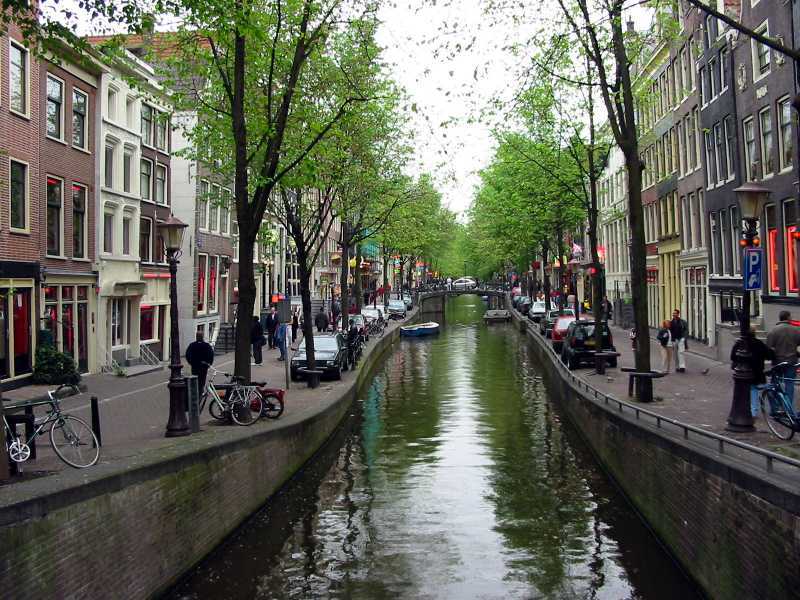
Visiting with oom Ronald and tante Diny in Zwolle

Wednesday we packed our things onto the bikes and prepared to ride to Emmen to visit Ekke's aunt Rini but when Ekke turned the ignition on for his bike smoke started to pour out from underneath the gas tank. Certainly not a good sign! Uncle Ronald called the ANWB (the Dutch auto club) and five minutes later a gentleman arrived in a small orange station wagon full of tools. In another 15 minutes he had repaired the wire that had shorted out and all we had to do was show him our CAA card! Wow, what service. We didn't expect that we could keep our appointment with aunt Rini when the smoke first appeared but with a delay of only 20 minutes we could still make it. Aunt Rini's hospitality was very welcome, especially as we showed up in soaking wet motorcycle clothes again. We threw the clothes into the bathtub so as not to make a mess of the house and enjoyed a terrific lunch before heading back to our temporary home at Alle's apartment.
ANWB comes to repair Ekke's bike
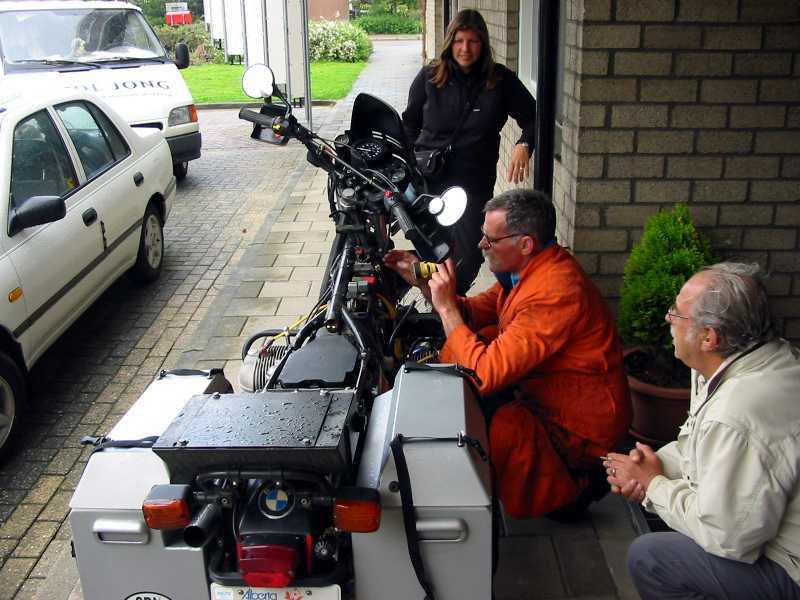
The repairman's well-stocked van
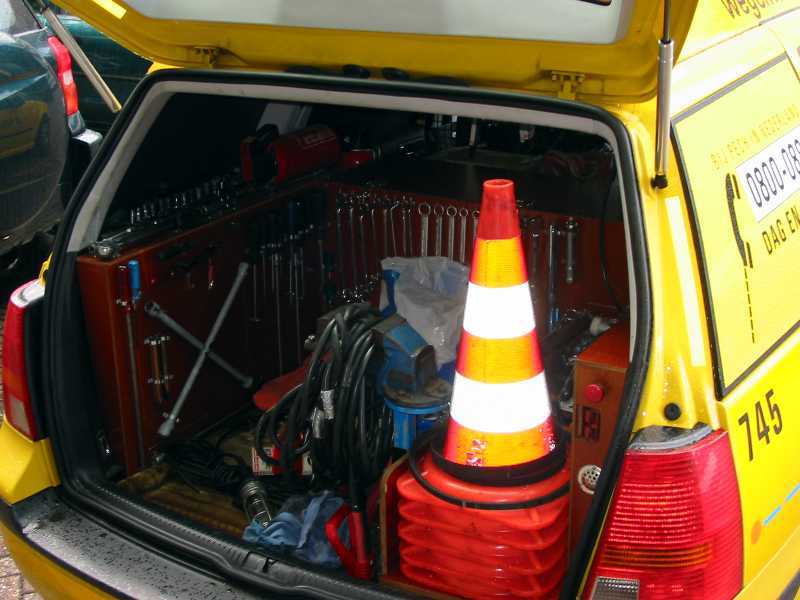
Tante Rini in Emmen
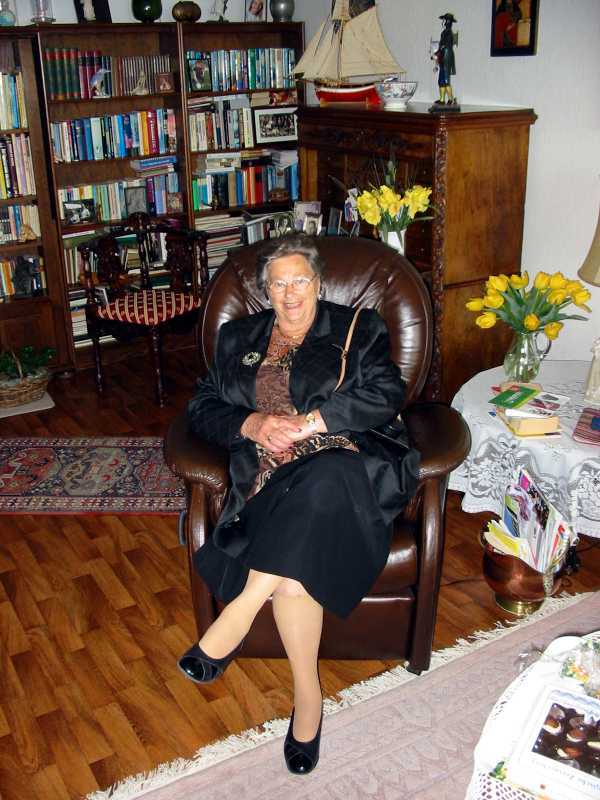
Ekke spent Thursday recovering from a bad cold and then on Friday we rode to Bielefeld in Germany to meet our friends Peter and Inge. We had stayed at their motorcycle club's house in the Eiffel near the Nurburgring and now the club put on a rally for the weekend of the 24th. Audrey entered the Tourist class and for some reason Ekke entered the Professional class. Both are navigational rallies using "tulip" diagrams but the "Profi" class had a more challenging section at the beginning that was timed. A 1:50,000 scale map was used and the level of detail was incredible for someone coming from Western Canada, a.k.a. "The Wide Open Spaces." Some of the roads used would have been small for a bike path back home. After Ekke muddled his way through the Profi section (way behind time) he found Audrey on the Tourist section going back and forth. So we completed the rest of the rally together. We each won a prize! Audrey got third place in the Tourist Class and Ekke got a "sonderpokal" special prize for effort. Sunday we rode back to our "home" in Amsterdam with Ekke doubling his mom on his bike for the first little bit as Peter and Inge accompanied us out to the Autobahn.
A crowd of rally goers gathers

More intersections in 10 km than in a 1,000 km at home (some only 40 metres apart!)
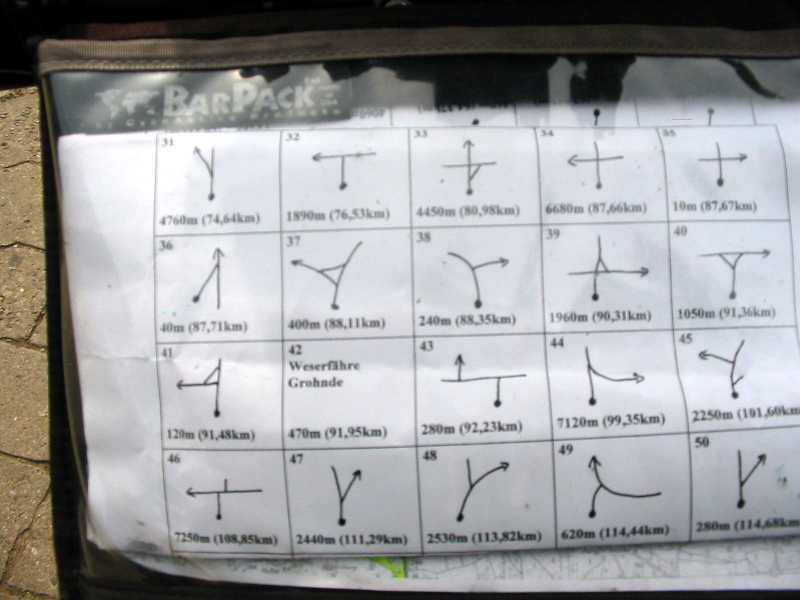
One of the bigger roads on the rally
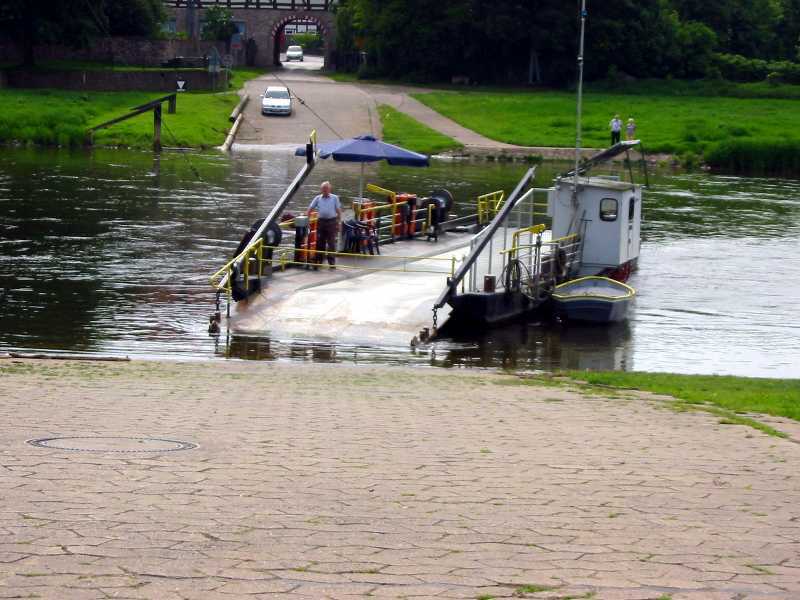
Writing down the first letter of every town we passed through

The "Sonderpokal" prize balanced on Ekke's bike
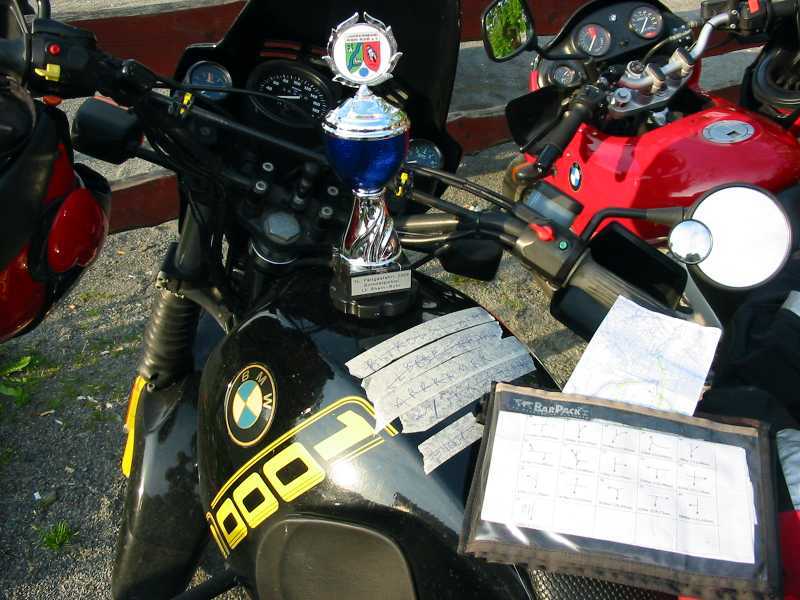
Audrey, Magda and Inge visited the local zoo (better to see bears here than in their natural habitat at home!)

Cute Marderhund couple (normally found in China and Japan - and we did in 2012 in Japan!)
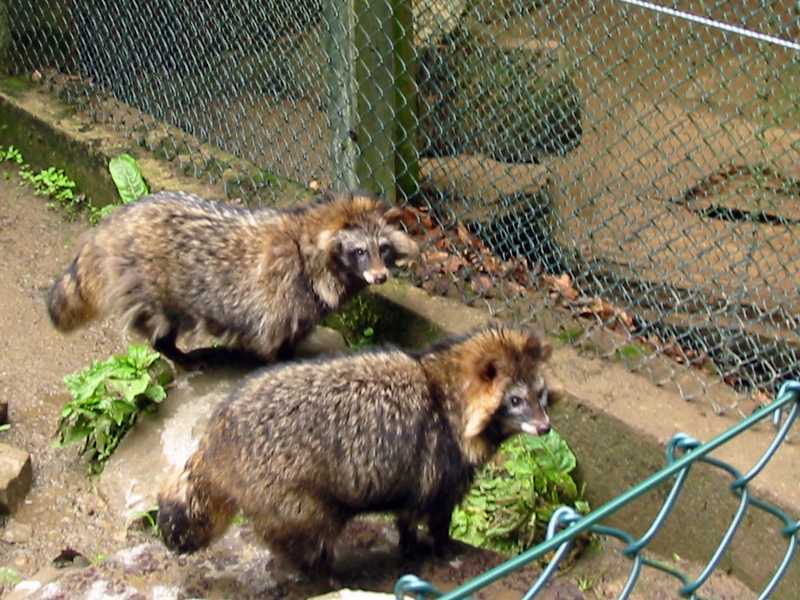
Meanwhile, Peter and Ekke do a tune-up on Ekke's bike
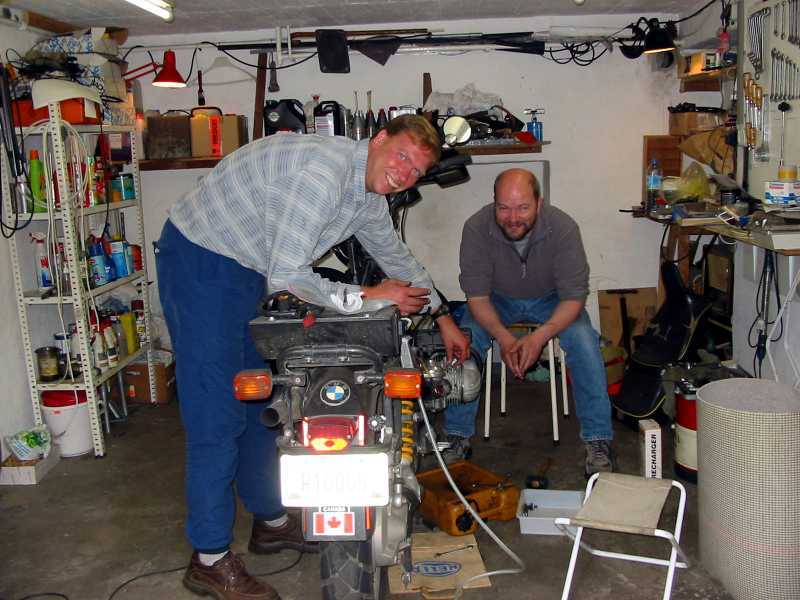
Ekke's mom gets a ride on Ekke's bike

Monday, May 26th was our 13th wedding anniversary so we made a special day of it. First we visited the Rijksmuseum where renovations because of asbestos had forced the museum to put all the important works in one large gallery. Since the museum was so limited they only charged a five euro admission fee including an audio guide. Actually it was very convenient having all the good stuff concentrated in one area! Out in the city we wandered the small streets and found a painter displaying some beautiful watercolours so we purchased a nice painting of the Singen canal. Dinnertime found us at an Indonesian restaurant enjoying a 16 item rijstafel. Every single item was simply delicious.
"The Milkmaid" by Johannes Vermeer
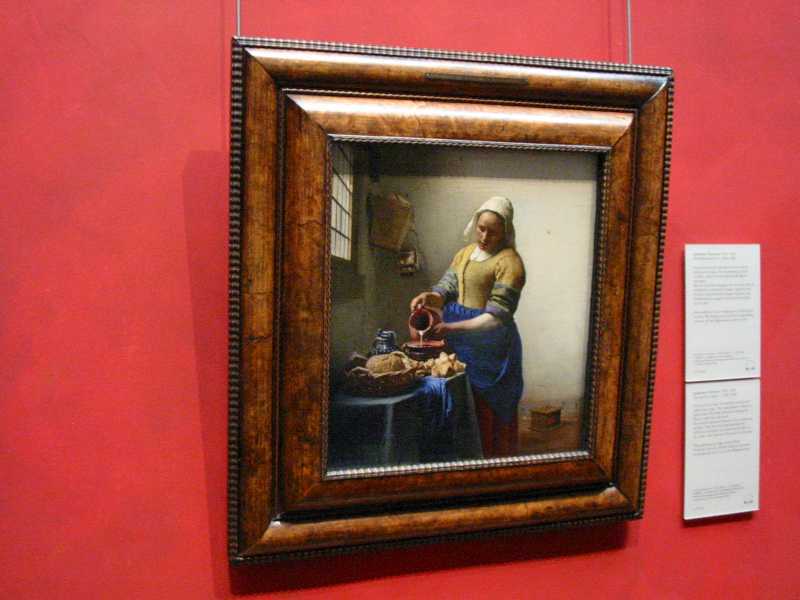
Preparing to enjoy the rijstafel on our anniversary

The video camera had been acting up for a while (since Rome!) and we took this opportunity in Amsterdam to find a JVC service centre. Ekke dropped it off on Tuesday but ran into some difficulty on the return trip. His bike became stuck in second gear! Fortunately it was almost rush hour and traffic on the ring road was moving slowly at times. The next day we rode together, through the centre of Amsterdam, so as to keep the speeds down to something that could be handled in second gear, to the motorcycle shop where we had picked up the tune-up supplies. There we were informed that they could look at the bike but it would take about a week to repair. Ekke's hopes were raised when the shop offered to rent a new BMW to him during the down time but they were dashed when he was told he needed a Dutch driver's licence. Drat. This breakdown did a couple of things for us. First it meant that we had the opportunity to use the Dutch rail system to get to Limburg for Ekke's aunt and uncle's wedding anniversary and secondly the dream of attending the TT races at the Isle of Mann had to be put aside since there was no way to make it in time.
Strolling around Amsterdam

On May 30 we took the train from Amsterdam to Roermond, Limburg in the south-western part of The Netherlands where Ekke was born. The train system seems to have deteriorated since we last rode the rails in 1996. At the train station Tiny and Gene picked us up in their son's Mercedes E320D, what a car. Diesels certainly have improved over the years as this car wasn't noisy or smelly yet provided excellent fuel economy and power. They dropped us off at Pietje and Irene's house, the uncle and aunt celebrating their 40th wedding anniversary. That evening arrangements had been made at a local restaurant to provide a fabulous buffet dinner for the party. What was unbelievable was that the quality of the food was incredible; like going to an expensive restaurant but then as a buffet. Neither of us had ever tasted food that good from a buffet. One of the specialities at the restaurant was Varkenshaas which literally translated means pig-rabbit. No rabbits were harmed in the making of the pork tenderloins but they were nevertheless delicious and worth a good laugh once we told everyone the English translation.
Reunited siblings, Christel and Magda (Canada) and Gerd and Irene (The Netherlands)
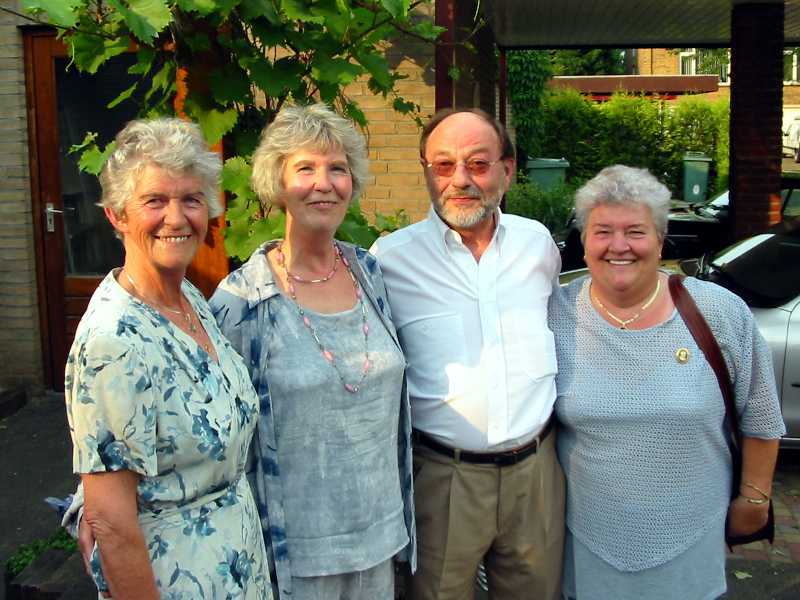
Everyone is ready for the Varkenshaas
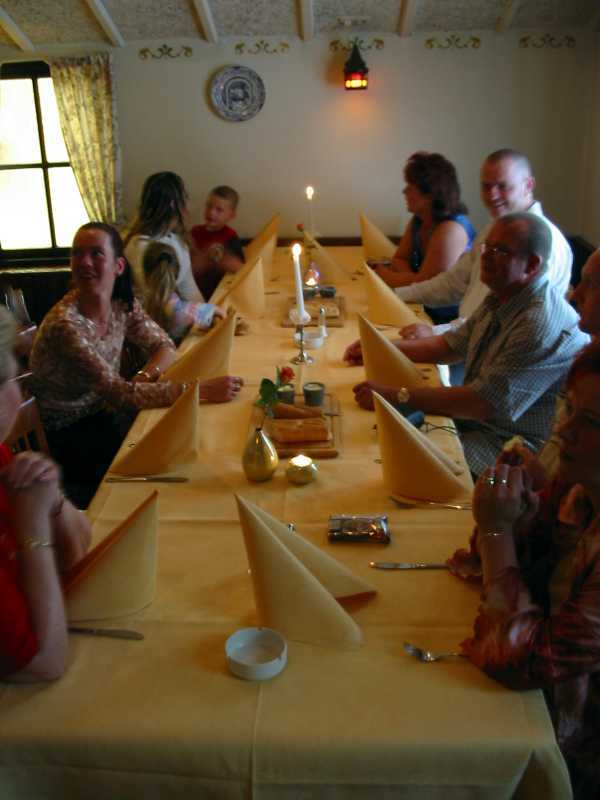
Piet and Irene (Anniversary Couple) with Ekke (Arnold Schwarzenegger) and Paul-Jurgen (Kevin Costner)

The next day we did a little more visiting, going to Gerd and Leentje's house in Neeritter with Magda and Christel. We went for a nice walk in the country (well, two countries really since we crossed into Belgium!) and visited the mill house where Leentje was born. Matt and Desiree dropped by in the afternoon with their cute children, Mica and Chrissie. It had been quite some time since we had seen Ekke's cousin Desiree and Matt so it was nice to get caught up. For dinner that evening we enjoyed a rare treat of white asparagus and for desert a vlaai made by an award-winning baker. Vlaai is a speciality not just of The Netherlands but specifically Limburg; it looks a bit like a flan but tastes completely different. The next morning we visited with Gerd and Leentje again and this time Karen and Johan came to visit with their young son, Pim. In the afternoon we went on a short bicycle ride (hey, at least it was two wheels!) to see the trucking company that Piet and Irene's son Marcel now runs. One of the newer Mercedes trucks had a radar system linked to the brakes, a camera to assist with staying between the lines, a 16-speed automatic transmission and a voice navigation system. Wow, what amazing technology, it was like being in the space shuttle! Piet and Irene gave us a ride in their motorhome (also equipped with voice navigation) to the train station and they too commented on how the Dutch rail system had really deteriorated since the privatisation.
Leentje at the mill house where she was born

Award winning vlaai

Pim and Magda, both having fun
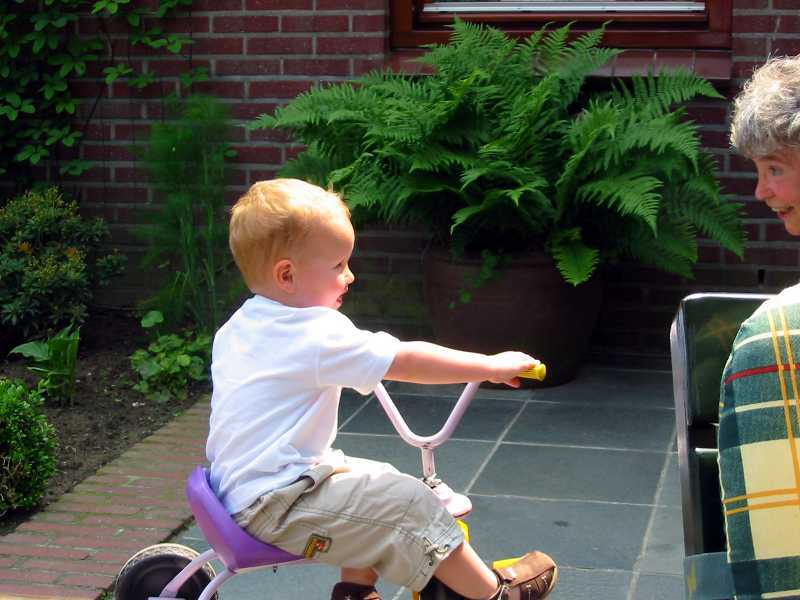
Ekke's great grandfather posed as Moses for a painting in the local church
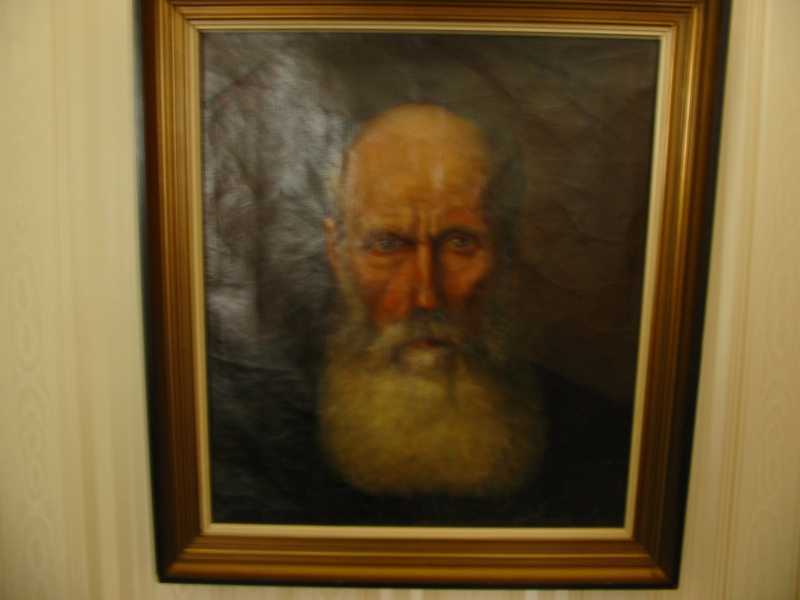
Back in our home away from home the R100GS was still not fixed but the video camera was ready to be picked up. We took public transit in to pick up the video camera and then did a little shopping, finding a great camping store. Ekke got his birthday present (a titanium cup) and we picked up a book on walking the Cotswold trail in preparation for the jump across the Channel. The next day we picked up the motorcycle: the good news was that the return spring in the transmission was only 63 euro cents, the bad news was that they had to take apart the transmission to get to it and that cost 300 euros. Alle was surprised to see us still in his apartment when he returned from vacation but he took it quite well. June 5 we left Diemen to catch the ferry at Calais for 110 euros each, including the bikes. When we landed in Dover we found one of the easiest border crossings to date because the border guards spoke perfect English.
Fixing a tail light bulb when picking up Ekke's bike after the transmission repair
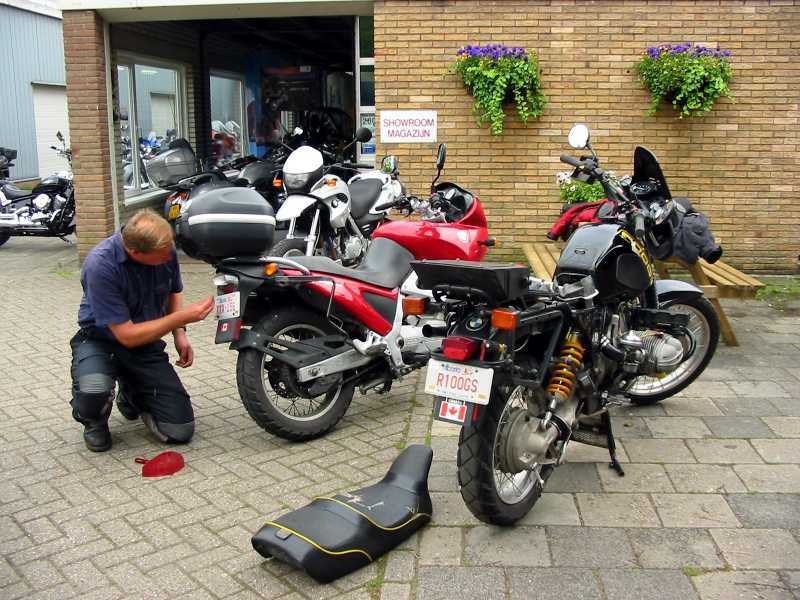
The $1 spring that broke inside the transmission
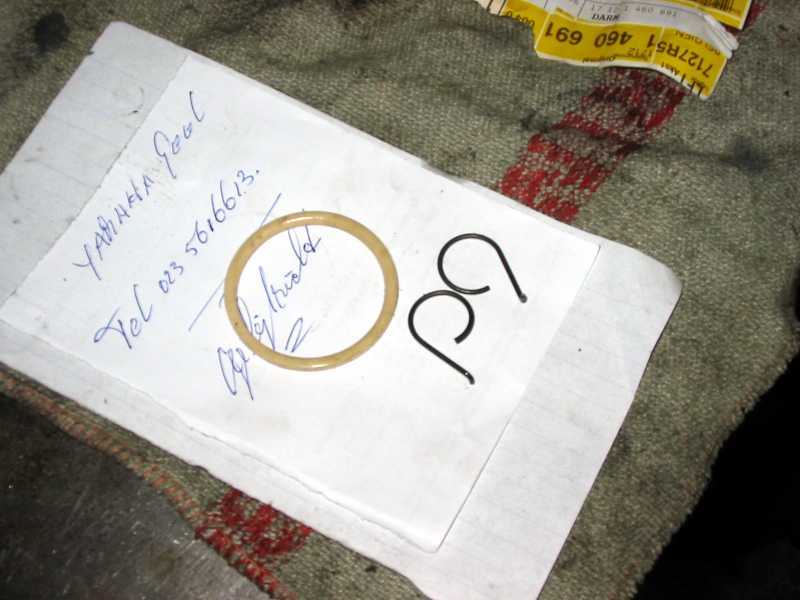
Another in the series of Ekke and short doors (or cars)
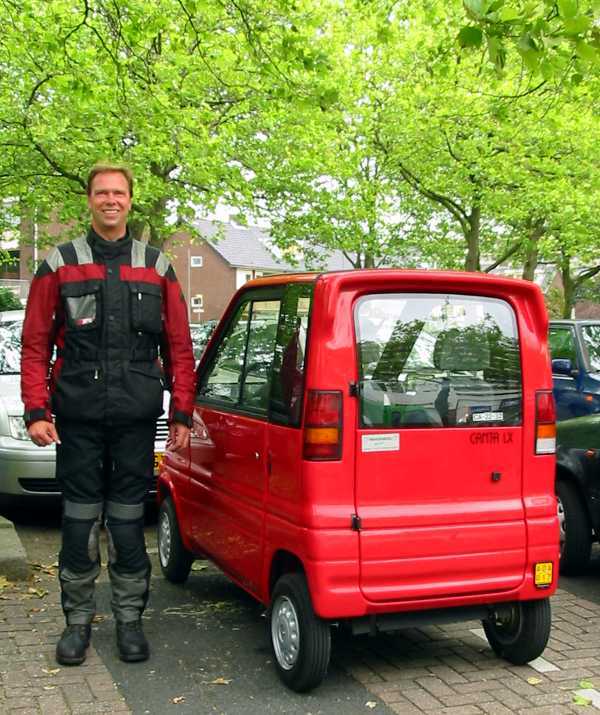
On the ferry to England
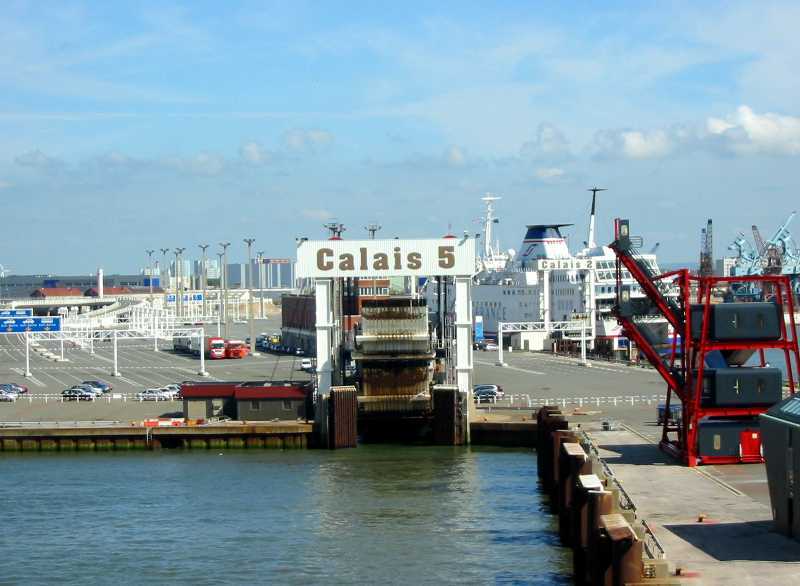
Map of our travels throughout the Netherlands with a home base near Amsterdam
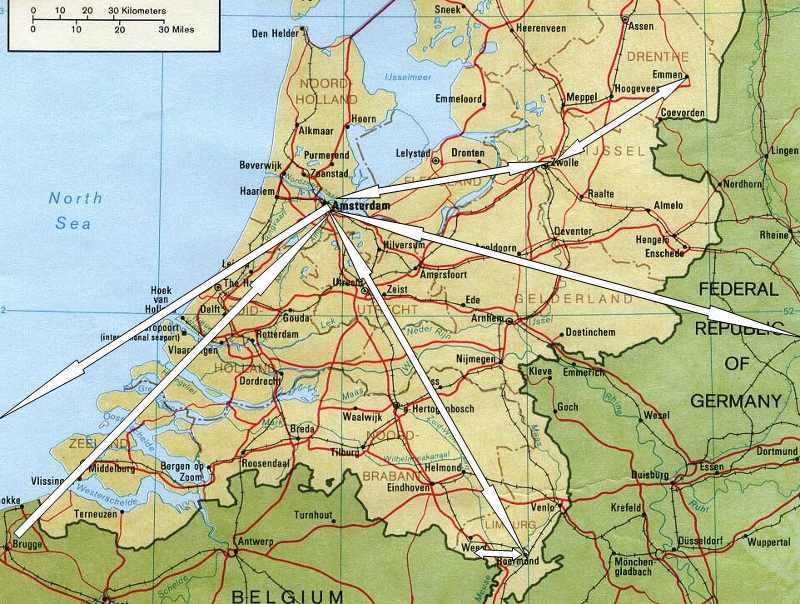
"KEEP LEFT!" read the hand drawn sign on Ekke's mapcase. As we left the Dover ferry station on June 5th, there were more signs to remind us to ride on the left side of the road. And so our UK adventure began. We found a pleasant campground at Folkestone, a few kilometres down the coast, and were thankful that the local convenience store took Euros so that we could have a can of Heinz Baked Beans for dinner. The next day we meandered our way to Bath via Hastings and Battle. As we are notorious for not wanting to pay for sights we can see from the roadside, we declined the £5 entry fee, hoping to catch a glimpse of the field where King Harold was conquered by William in 1066. We saw plenty of fields, so we were quite satisfied as we rode on to Brighton. As a famous seaside resort, it was suitably tacky, with a pier full of amusements and rides, beachside arcades and chip shops, and Royal Brighton Pavilion, a Moorish structure. We stopped just long enough to walk on a pebbled beach and eat some of the greasiest fish and chips ever. As we rode on through forested areas, we could see Salisbury Cathedral from many kilometres outside the city. It was a beautiful sight but we couldn't stop as we wanted to get to Bath where we were to meet Ekke's mom and aunt. Audrey kept getting some weird petrol fume smells all day, blaming them on the fact that, riding on the left side of the road, Ekke's exhaust now pointed directly at her bike, but Ekke wasn't buying it. Oh well. We rolled into town and found the hostel, a former Bathstone mansion, and Magda (Ekke's mom) and Christel (his aunt) arrived later.
White Cliffs of Dover
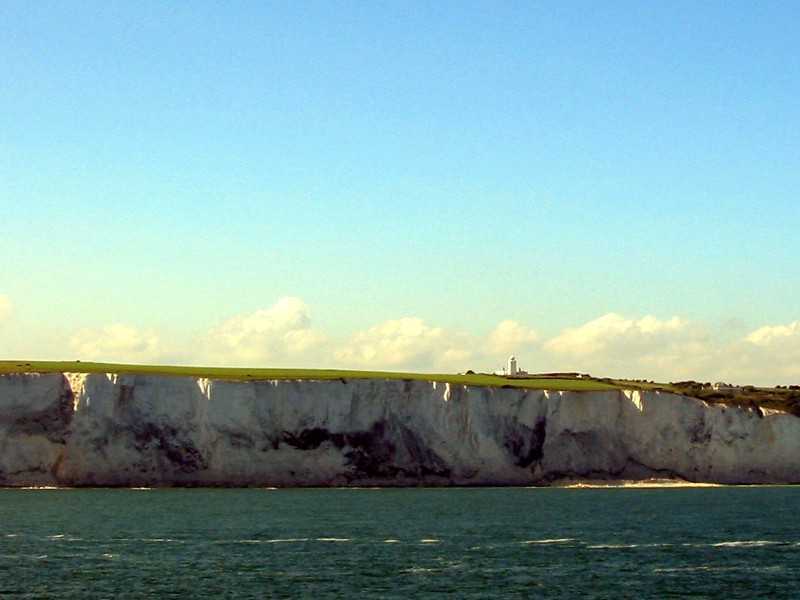
Ekke's Mapcase

Brighton
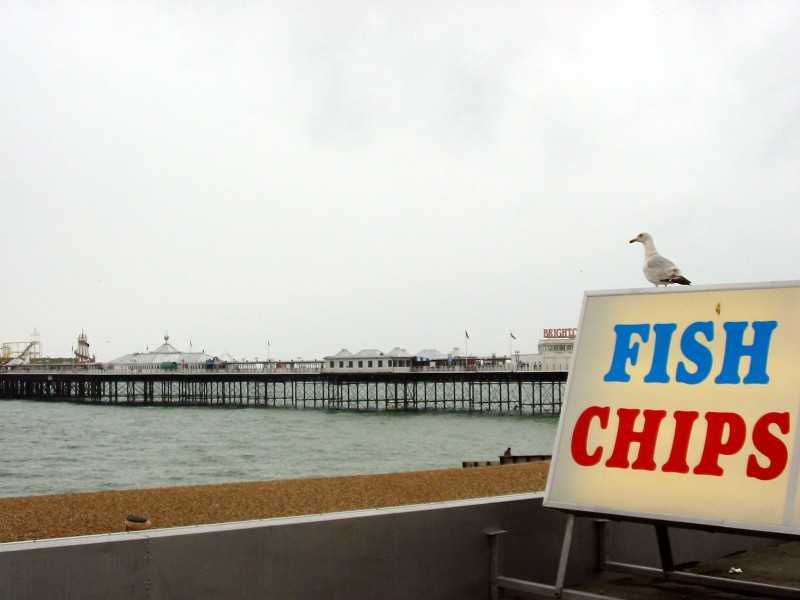
Magda and Christel join us at the hostel in Bath

Beautiful Georgian architecture and Roman ruins have made Bath a UNESCO World Heritage Site, and we explored it thoroughly the next day. We started with the Roman Baths, named Aquae Sulis by the Romans in 44 A.D., with a museum displaying the excavated artefacts and mosaics. The water was said to have special healing powers, so we all tried a glass in the Pump Room, where snooty 19th century aristocrats used to meet to drink mineral water and discuss the latest fashions. We bought a picnic lunch, found a park, and enjoyed the sunny day. Magda and Christel then caught a bus tour, Ekke found an internet place, and Audrey went on the Jane Austen walking tour. There were many Persuasion and Northanger Abbey sites featured on the tour, from both the novels and films. Thackeray's Vanity Fair was being filmed in Bath, and as a result, some of the lampposts had been changed to look less 21st century. We all regrouped at the Assembly Rooms which housed a costume museum, and enjoyed looking at court dresses from the 1600's, Greek Classical fashions of Jane Austen's era, and the evolution of clothing right up to modern times. After a walk by the Circus and Royal Crescent apartments, we shopped for groceries and cooked supper at the hostel.
Bath Abbey
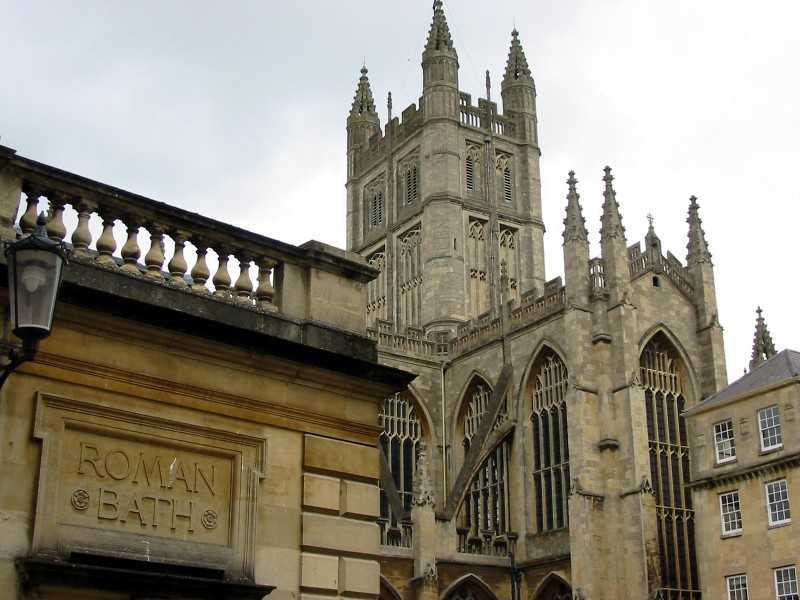
Roman Baths

Magda and Christel caught a taxi to Stowe-On-The-Wold, where we had booked another hostel as a base for some Cotswolds walks. We decided to ride by Stonehenge on the way, and once again avoided the entrance fees by just looking at it through the fence. It was quite remarkable that people had moved these 50 ton rocks here 5000 years ago, and that they were aligned with the rising and setting of the sun. Avebury was also impressive and even though the rocks were smaller than at Stonehenge, its stone circle was so big it enclosed a town within it. Riding around on tiny country roads was a joy, and we stopped in a few towns including Burford and Snowshill, which had particularly quaint stone cottages. Our hostel in Stowe was also made of the same yellow oolitic limestone blocks.
Famous Bunch 'o Rocks
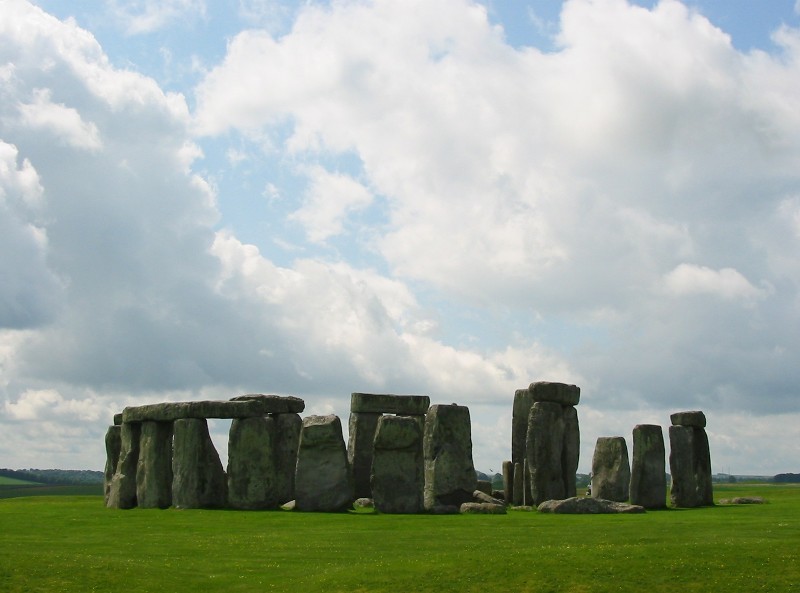
Country Road
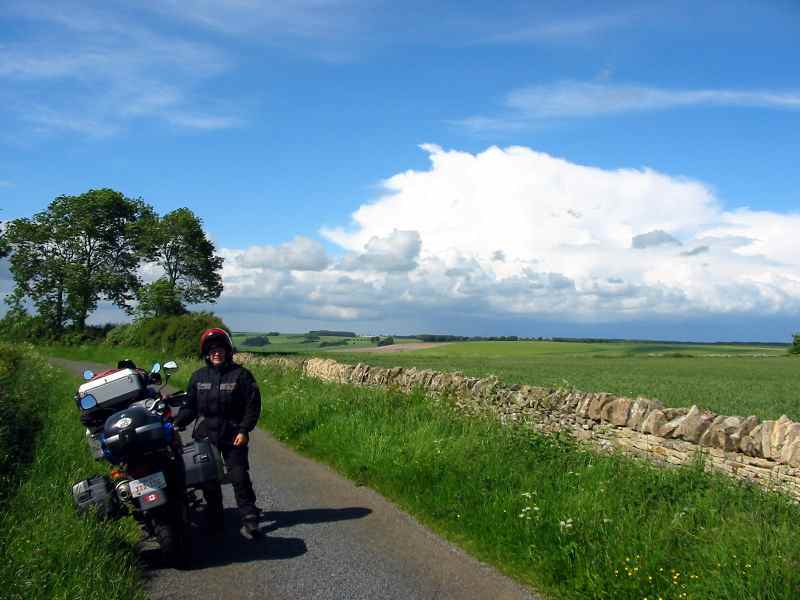
Avebury Stone Circle
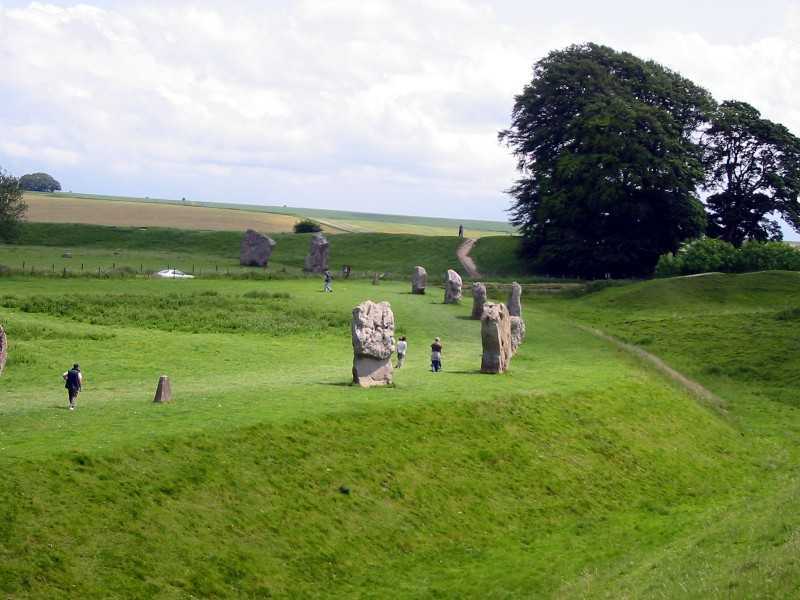
In the village of Snowshill
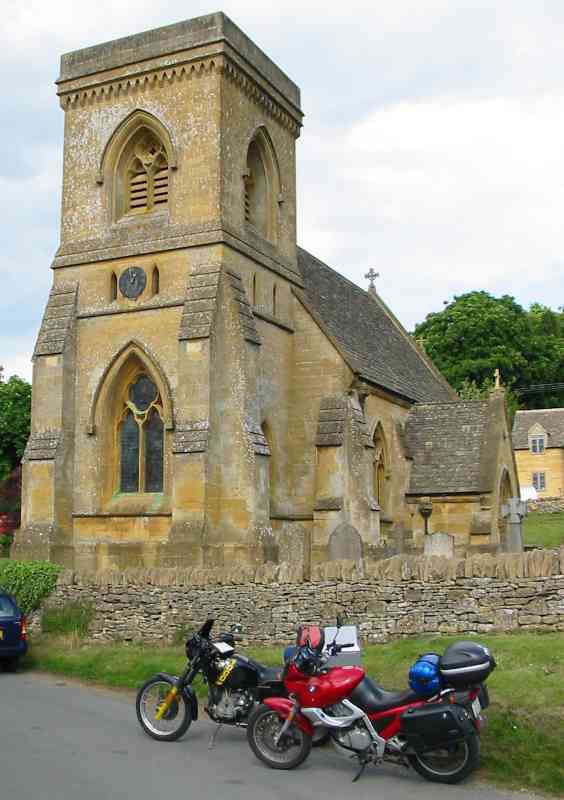
On June 9th, our first day of Cotswold walking, we got some maps from tourist info and went to Bourton-On-The-Water via Upper and Lower Slaughter, named after the sloe trees in the area. The pleasant walk took us past hedgerows and kissing gates, water wheels, stone bridges and the odd manure pile. On our Canadian hikes we would have had to make a lot of noise so the bears would, hopefully, avoid us. The only wildlife here was a bunch of enthusiastic cows who tried to chase us out of their field, with success. We enjoyed our first English cream tea in Bourton, with Cotswolds Cottage Cream on scones. Good thing we were doing all that walking.
A day hike in the Cotswolds
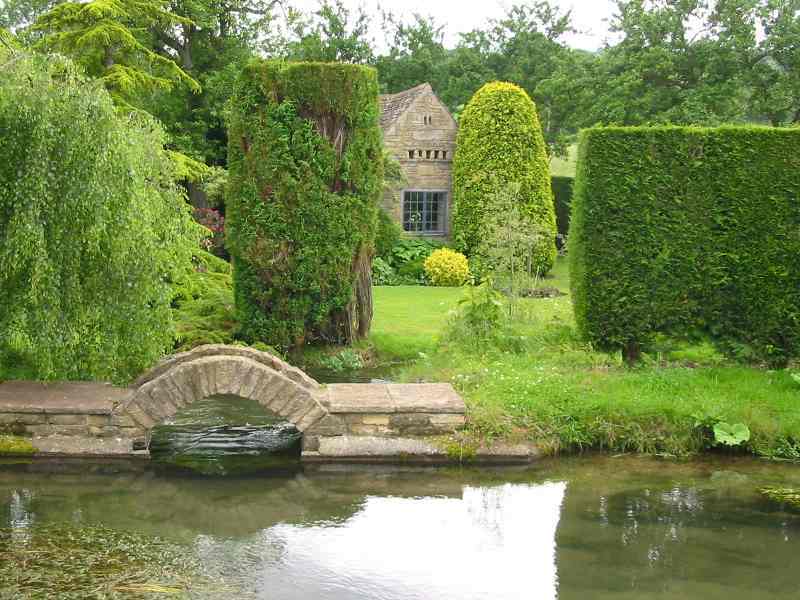
Outside the automobile museum in Bourton-on-the-Water
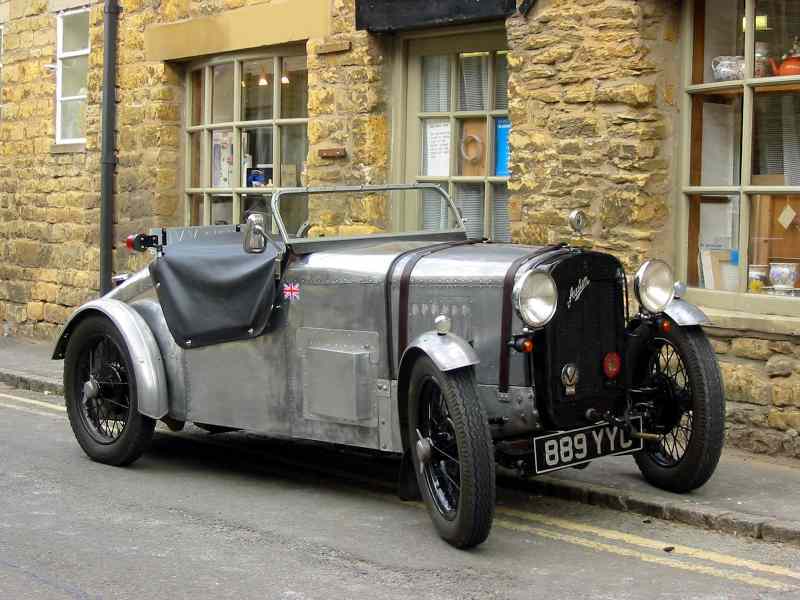
The wild cows of the Cotswolds
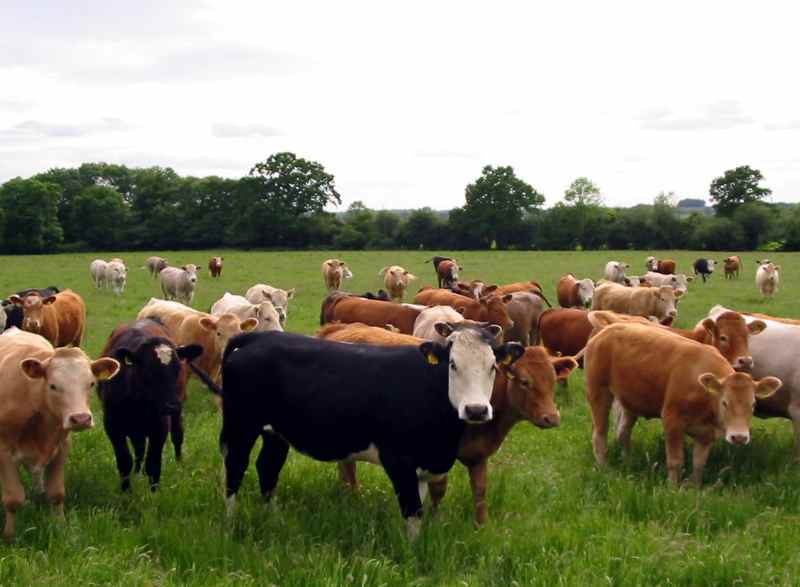
Low clearance
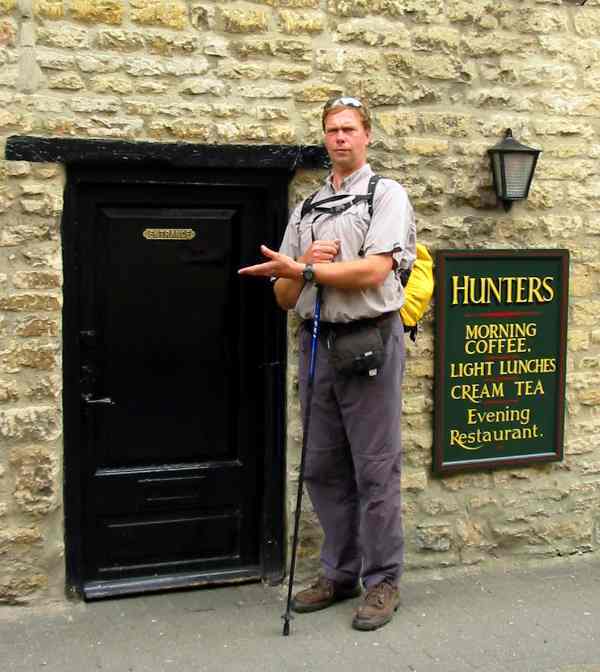
To officially start the Cotswold Trail hike, we each packed a daypack with enough clothes for a few days and stored our excess baggage and motorbikes at the hostel. We then took a bus to Moreton-in-Marsh where we had time to check out the outdoor market. Magda bought some lovely cheddar blue cheese, and Audrey found some really inexpensive and totally useless rain pants. Here we caught a connecting bus to Chipping Campden, where we toured St. James Church, a remnant of the rich wool trade days. Walking past old almshouses and stone cottages with thatched roofs was a delight. Okay, the scenery wasn't the Canadian Rockies, but the architecture and quaintness of everything almost made up for it. From Dover Hill we could see the sprawling Vale of Evesham, and then it was on through the rolling countryside to Broadway Tower, a folly built in the 1800's. Black-faced lambs frolicked around the hills with us, as we climbed over stiles, through wooden gates and over stone walls. The town of Broadway was, well, quaint, and we found a great tea spot. A long climb up a big hill took us past fields of poppies, ancient settlements and a few wild bunnies. The skies opened up and torrential rains poured down and we were all soaked as we scrambled, too late, into our raingear. There was room at The Vine B&B in Stanton, complete with canopied beds and velvet curtains, for £29 per person. Supper at a local pub consisted of cottage (meat, vegetable and mashed potato) pie, and apple pork burgers.
Start of the trail

Broadway Tower
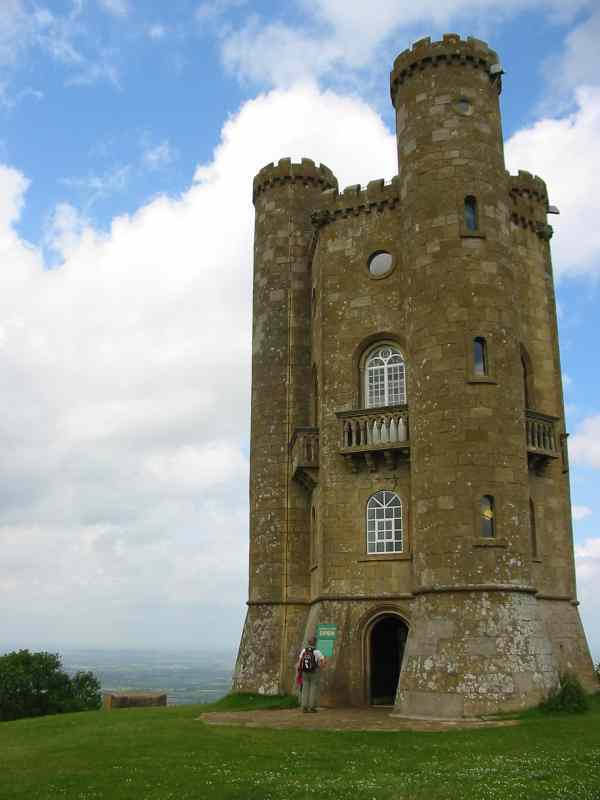
The next morning, which just happened to be June 11th, Ekke's birthday, we experienced our first full English breakfast which included fried tomatoes, fried eggs, fried ham, fried sausages, fried mushrooms, and, of course, fried toast. We had a lot of walking ahead of us, thank goodness, and made our way through town, where we stopped to watch a cottage having its roof freshly thatched. Cotswold villages like Stanway and Wood Stanway were so well kept and untouched, it was as if we were walking through history. Sheep were being herded by a couple of dogs, who waited for whistled signals from their masters, and a girl was practising English riding on her horse. Over a ladder stile and then up another hill took us to Haile's Abbey, a 13th century ruined structure, formerly a pilgrimage destination for visitors from all over Europe. Arriving in Winchcombe in the early afternoon we found Gower House, a lovely B&B with a huge English garden. After a walk around town and the usual cream tea, which we were really getting used to, we had some down time at the B&B, and then we went for a special supper to celebrate Ekke's birthday. What a surprise to have fabulous Indian cuisine in the English countryside!
Full English Breakfast!
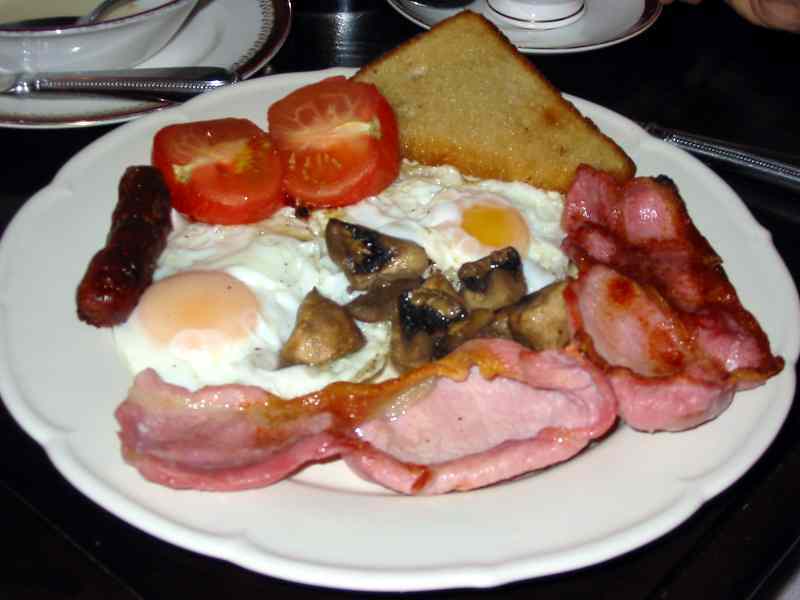
The Vine Bed & Breakfast
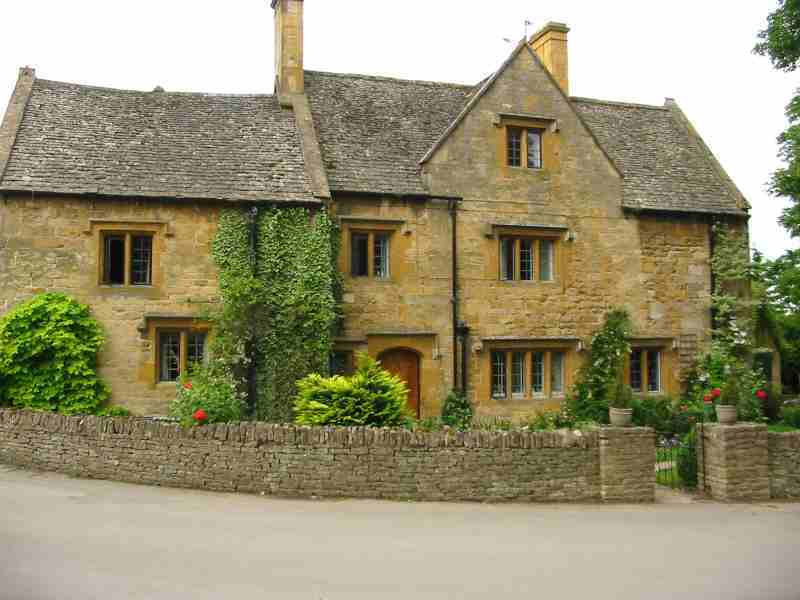
An English rose garden

June 12th, Christel's birthday, was a beautiful blue sky day, and we started out by viewing the town church, St. Peter's, known for its interesting gargoyles. More walking took us to Sudeley Castle, home and burial place of Henry XIII's last wife, Catherine Parr. There was a great display of wax figures of all of Henry's unfortunate wives most of which he either divorced or had executed. The castle was surrounded by vegetable and wildflower gardens, the Tithe Barn Garden, Secret Garden, Queen's Garden and Knot Garden. When leaving the castle, Ekke offered to carry Christel's pack as a special treat for her birthday, and he looked quite balanced with packs both front and back. We got a little lost trying to find the Cotswold Trail again, and ended up bushwacking through some thick brush. Eventually the trail was found, and we walked through a forested area near the site of a Roman Villa, but all we could see of it was a stand of trees in the middle of the field. We stopped for lunch in a pasture on a hillside, and Magda, Christel, and Ekke enjoyed the lovely market cheese, but Audrey found it a bit too strong and almost went into a fit of hysterics after trying it. So, she thought that maybe it was a good day to just have sandwich spread on a piece of bread. After lunch we walked up to Belas Knap, an ancient burial mound from 2500 B.C., then further on up to Cleeve Hill, and over turf pastures where we saw the fluffiest sheep ever. Staying at Beryl Bye's B&B in Bishop's Cleeve was quite enjoyable, and we had a cup of tea on the garden patio while we played ball with Meg, the dog. After a walk into town, we found a pub for dinner, to celebrate Christel's birthday. Ekke tried the crocodile, which tasted like chicken. The rest of us had chicken, which also tasted like chicken, but was much cheaper. We finished a great day with birthday cake from Sainsbury's grocery store, back at the B&B.
Christel climbing down a stile
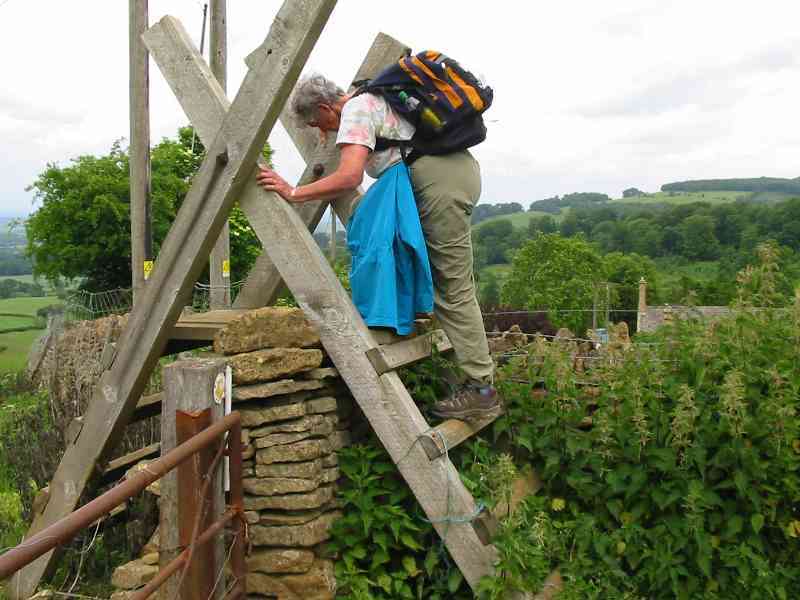
Sudeley Castle

Belas Knap burial mound
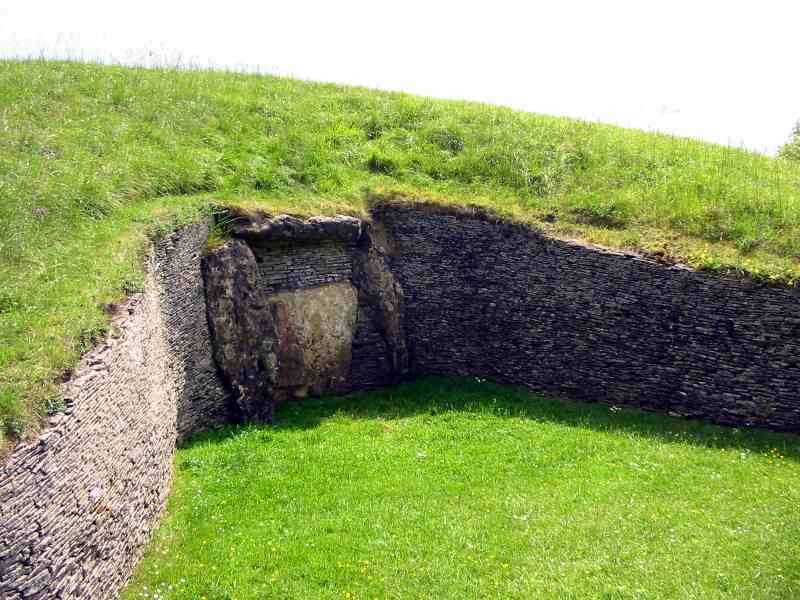
Where is a Bounce sheet?
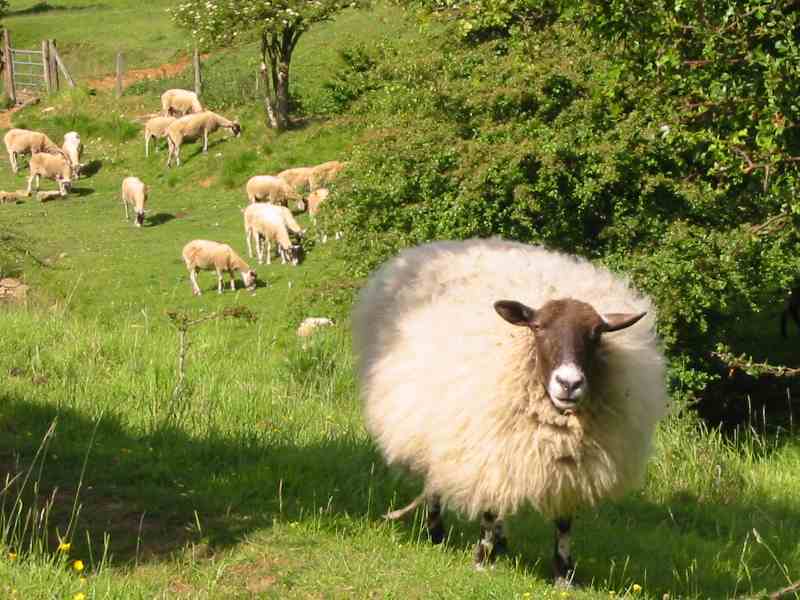
Beryl gave us a lightened up version of the full English breakfast, and she sent us off with some bagged lunches for our hike. We walked through some woods and past a group of gypsies who were camped in the trees. Although the Cotswold Trail is fairly well marked, we still managed to go the wrong direction, over a stone stile, down a steep hill, which had plenty of thistles and stinging nettles. It eventually occurred to us to ask directions, so Magda wandered through a field to a farmhouse, discovered we were off course, and walked back to tell us. She was not aware that an enthusiastic horse had followed her and just as she got back to us, Ekke said, "Who's your new friend?" in a deadpan tone. Magda glanced over her shoulder and was suitably startled, being face to face with the huge horse. We all had a good laugh until the horse followed Christel and Ekke, nipping at their backpacks. We escaped over a stile and eventually found our way back to the trail. It was really a hot day, so the walk through cool Limewood Forest was very pleasant. We debated about going up to Leckhampton Hill, as it was getting late and didn't know if we could phone for a taxi up there or not. Good thing we chose the hill, as the views of Cheltenham and Cleeve Hill were quite spectacular. We found a golf club, where luckily a taxi had just dropped off some customers, asked if they could drive us to Stowe-On-The-Wold, and arrived back at the hostel in the early evening. Some greasy fish and chips for supper capped off another day in the Cotswolds.
Walking the Cotswold Trail
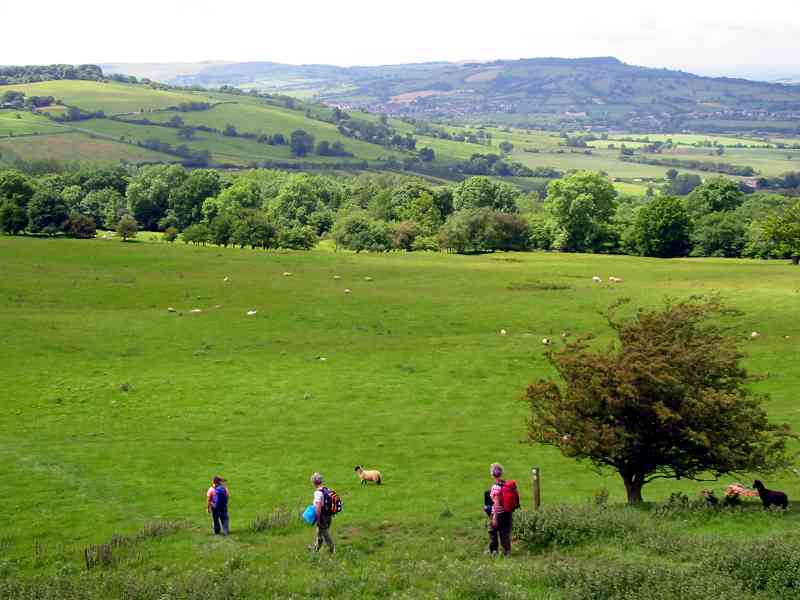
Cleeve Hill near the end of the trail
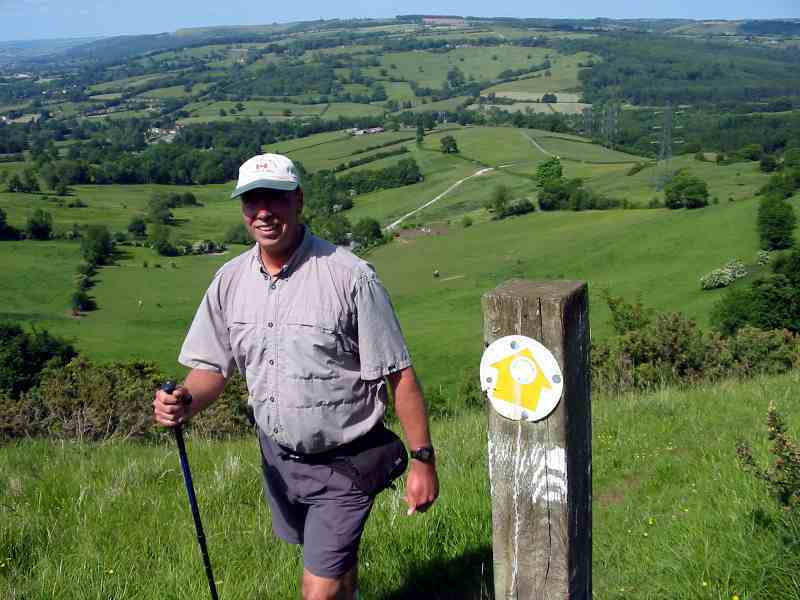
We had one more day to explore the area, so we took a bus to Bapsfield Arboretum, a collection of trees and gardens near Bapsfield Manor. Highlights included a statue of Daphne, a Japanese rest house, Buddah, Syrian Cypress, ponds, bridges, and lakes with black swans. Audrey nearly missed the bus after a slight miscommunication about where to meet, but it all worked out in the end. Back at Stowe, we said goodbye to Magda and Christel who caught the 5:00 PM bus, via Oxford, to London, where they would fly home to Canada. For us, it was back on the bikes, which started right away after having sat for a few days, and after a pleasant ride to Stratford-Upon-Avon, we camped about a kilometre outside of town. The great thing about motorcycle camping is that there's always room at the campground, even on a busy weekend.
Magda and Christel at the Bapsfield Arboretum
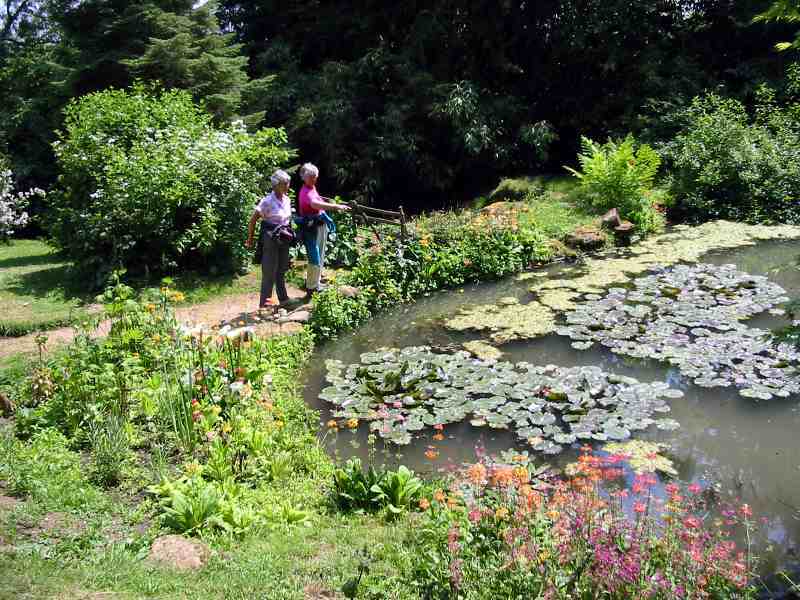
A couple of relaxing days in Stratford were just what we needed. We sat around reading and were quite surprised that we both developed a bit of sunburn - in England! Stratford was a fun town to walk around in, to see Shakespeare's birthplace, and enjoy the architecture. There were also a few housekeeping items to take care of, such as a haircut and shopping, and, of course, our afternoon cup of tea. At the internet café, we discovered there was a message from Audrey's future principal, needing a few interview questions answered for the assistant principal. She wrote the answers on the laptop back at camp, and downloaded them at the internet café back in town.
Stratford-upon-Avon

On June 17th, we rode about 50 kilometres to Warwick Castle, a beautiful stone structure on the site where William the Conqueror had built a wooden fort in the 11th century. It was quite enjoyable to wander around the castle wall, look at medieval torture devices in the dungeon, and, at the Kingmaker exhibit, see where soldiers prepared for the 1471 A.D. battle. A lavish 19th century Royal Party was set up in several rooms of the castle apartments, complete with Tussaud wax figures of the Earl of Warwick, a young Winston Churchill, the Prince of Wales and various other guests. On our ride home, we stopped by Anne Hathaway's cottage, which was closed, but as we were sitting there, a family drove up beside us. They were Canadians, working in England and were just touring the countryside when they noticed our Alberta licence plates. It was great to have a chat about English idiosincracies, how they say 'boot' and 'bonnet' for trunk and hood, drive on the left, and speak with such a diversity of accents.
Warwick Castle

Edward Prince of Wales (on the right) and Lord Curzon
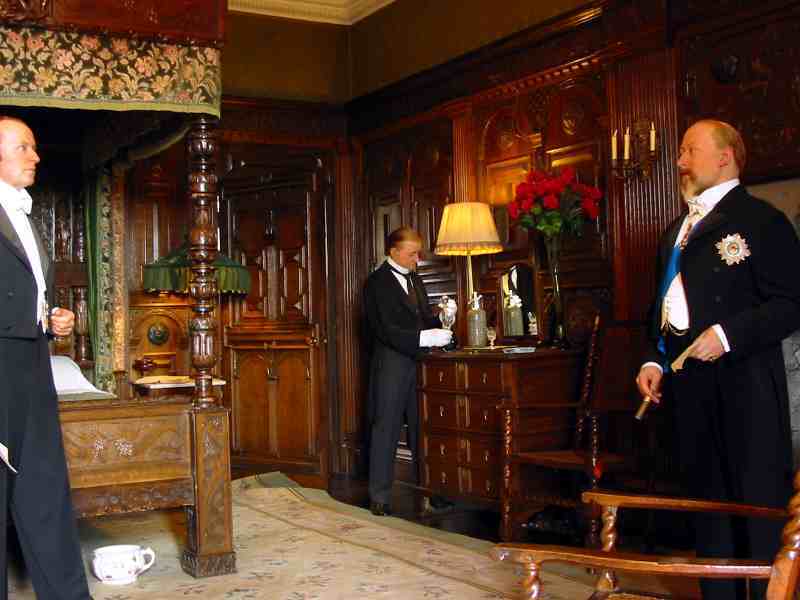
Ekke takes part in the interactive exhibit
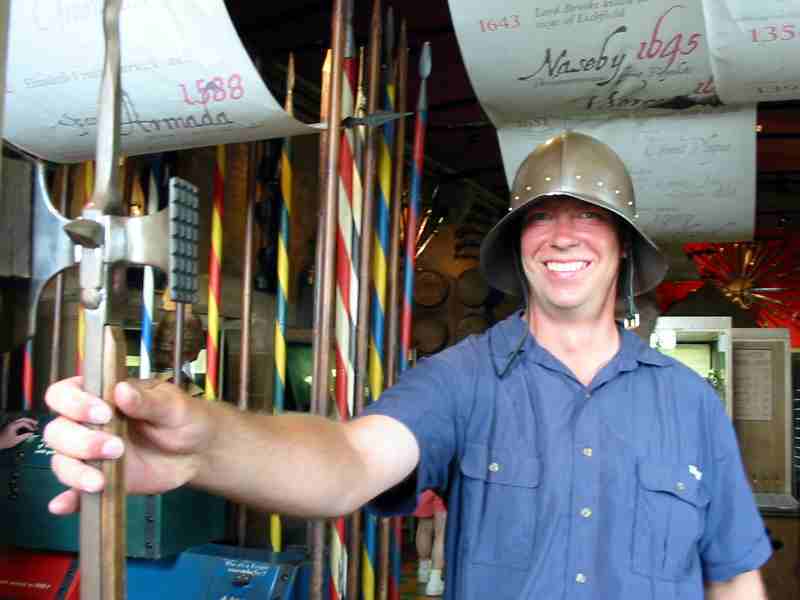
Another ride through the rolling English countryside, the next day, took us to Ironbridge Gorge, the birthplace of the Industrial Revolution. Iron ore was smelted with coke in 1709, and the bridge was built in 1779, quite a feat of engineering. The Gorge Museum was interesting, with a scale model of the whole area in its heyday. The region is a UNESCO World Heritage Site, with its valley full of industrial era relics.
Iron Bridge

On June 19th we packed up and said goodbye to our neighbours, a family from Oregon who were travelling through England, France and Germany. We rode east toward Wales, past Worcester (of sauce fame), and the countryside got noticeably wilder as we crossed the border. There was only a bit of traffic excitement on the way as a queue came to a sudden halt on the highway, causing Ekke to apply his brakes, which didn't work quite as well as he had hoped. He ended up demonstrating his emergency riding technique, veering to the side, coming to a stop right beside the vehicle that had been in front of him. Phew! We made it safely to Prestywyn where we found Nant Mill Camping for £10 per night. A fellow camper was struggling to get his new tent up, so we went over to help. Ronnie, from Liverpool, was camping for the first time in 20 years, so we were able to offer some of our tent-raising expertise.
Being so close to Liverpool, we decided to pay it a visit, so on Saturday, June 21st we rode to the ferry station to cross the wide-mouthed Mersey River. Yes, they played the familiar tune Ferry Cross The Mersey, on the boat trip and Audrey had the song in her head for the entire day. Liverpool had a lot of Victorian architecture visible from the boat, and when the annoying song wasn't playing, there was a bit of commentary explaining the history. We walked to Albert Dock, where old warehouses were converted to trendy shops and restaurants. The Tate Gallery was free, so we had a quick look at some modern art, including pieces by Matisse and Picasso. Walking past the yellow submarine, we found our way to downtown Liverpool, which had a lot of picturesque historical buildings housing Marks and Spencer and American fast food places. It turned out to be the first day of the launch of J.K. Rowling's book, Harry Potter and the Order of the Phoenix, and we saw a few little wizards and witches walking about. After a lunch of fish and chips, complete with mushy peas, we walked to the Cavern Club area, legendary as the place where the Beatles were discovered. The whole street was devoted to music, but we were disappointed in not being able to find a Ringo Starr keychain anywhere. We stopped at the Maritime Museum, which had an informative exhibit on the merchant navy, on the way back to the ferry. Supper at the campground was great - takeout curry from the local supermarket!
On the Mersey
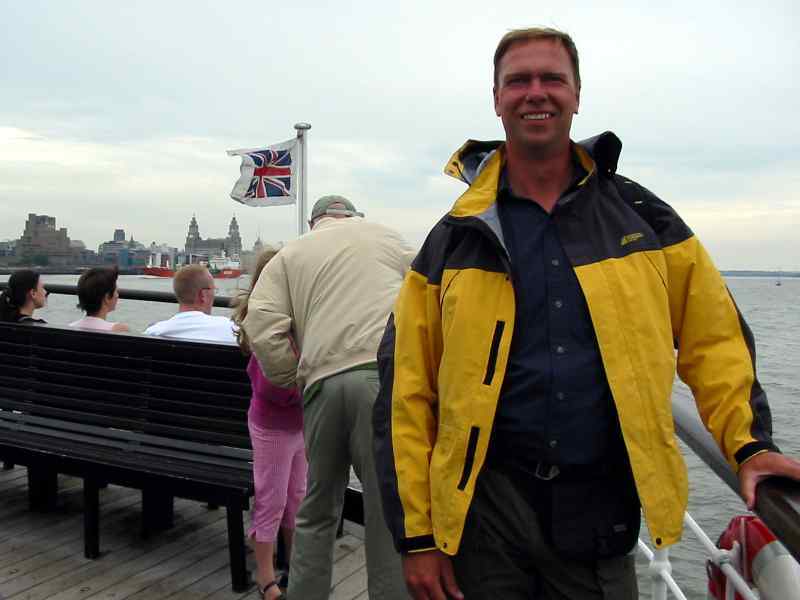
We all live in a...
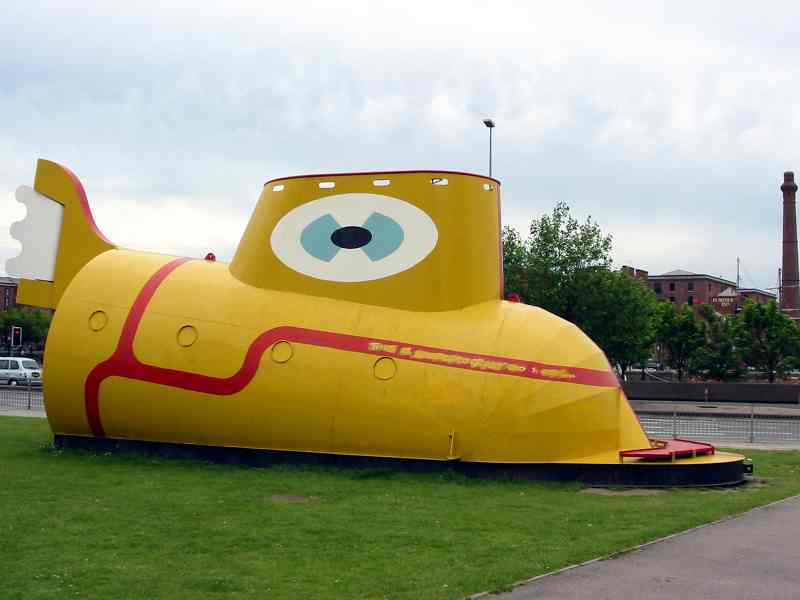
A castle tour of Wales was next on the agenda. Well, actually we wanted to climb Mt. Snowdon, but at a hiking base at Pen-y-Pass, the posted forecast said there would be cool, wet weather at the top. Instead, we rode through the mountainous, rugged countryside on small, twisty roads to Harlech, Caernarfon, Beaumaris and Conwy castles, all UNESCO World Heritage Sites. They were all beautiful and interesting, but the day was really about the incredible riding through many different parts of Wales. The coastline was rocky and hilly and suitably curvy - lots of fun for motorcyclists. Back at camp, our neighbour, Ronnie came over to borrow a corkscrew, and then shared some wine with us. He told stories about life in Liverpool and was really interested in hearing about Canada. The next day, upon leaving, he gave us a cassette tape of music he had made for us, and we gave him a Canadian pin.
A foggy ride in Wales at Pen-y-Pass
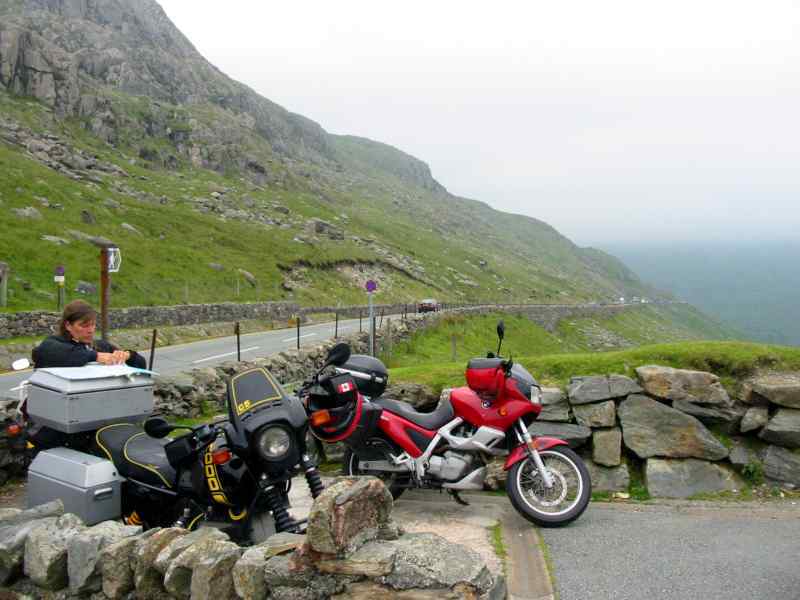
Beaumaris
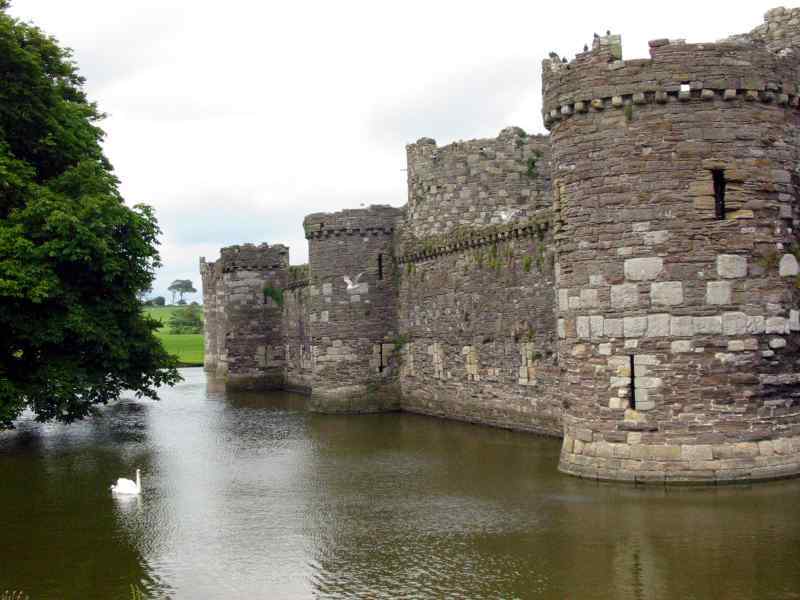
Road signs in Wales had English translations

We left Wales on June 24th, and wanted to avoid the huge city of Manchester so we did a bit of riding on the motorway, and saw lots of industrial areas. In our guidebook we noticed that the town of Howarth was on our way to York, so we stopped for a while at the place where the Bronte sisters lived and wrote. In the sunshine, the moors didn't look quite as daunting as they would have in Wuthering Heights, but we had a great ride through the countryside nonetheless. The campground was outside of York, and, to keep the bikes safe, we left them there and took the bus into the city the next day. Ekke needed some motorcycle pants repaired, so we found a shop to do it. We walked through a fruit and vegetable market, and then through the Shambles, a medieval street with crooked, half-timbered houses with the top floors jutting out into the street. The huge York Minster stood in the centre of town, and we enjoyed a £1.45 ($3.30!) cup of tea in an outdoor café nearby. The city is mostly surrounded by a medieval wall, with intermittent gates, or 'bars', and it made for some great walking. The National Railway Museum was free, which was just in our price range, and it turned out to be an unexpected treat. Audrey really enjoyed the lavishly furnished royal train cars which had been designed for Queen Victoria and Kings Edward and George and Ekke was impressed by the enormous steam train, "Mallard", that set the world speed record of 126 miles per hour in 1938. A turntable demonstration was given, and we saw a Japanese high-speed train and a European TGV (Train de Grande Vitesse).
Howarth
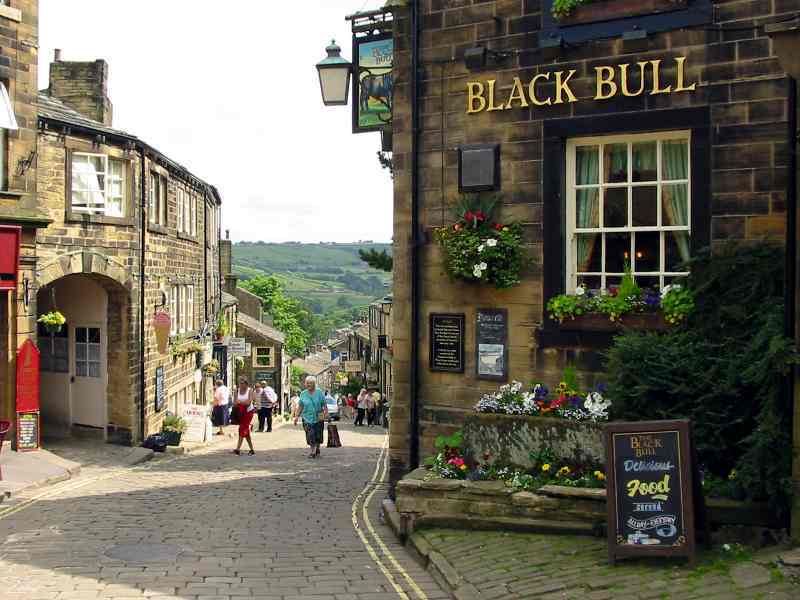
"Mallard"
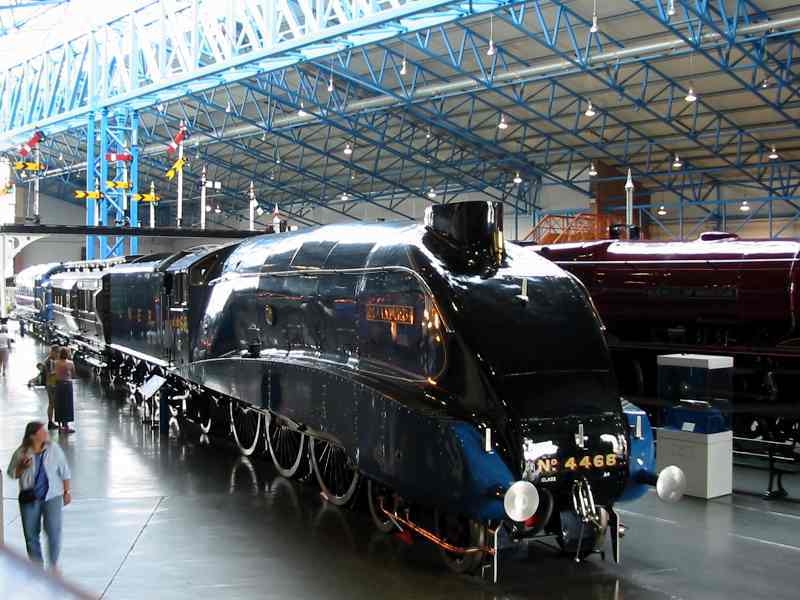
The next day we wanted to get into York early to visit Jorvic, a reconstruction of a viking village from 986 A.D. It was all displayed underground, on the original archaeological site, and we rode in a kind of horizontal chairlift which was attached to a track on the ceiling above. The sights, sounds and even smells of the Viking settlement were recreated, including cooking, woodcarving and leather-working. Later, we found a park with the ruins of an abbey and ancient guesthouse, and just strolled around the beautiful gardens. Back at the campground we chatted with our neighbours, a family from Norway. Their main purpose for visiting the area was to see the set of a television series called Heartbeat, a cop show which took place in the Yorkshire Dales. They had a booklet of all the show's characters and storylines, and explained that the program was very popular in Norway. Maybe they had nothing better to do on those long Norwegian winter evenings?
Monk Bar
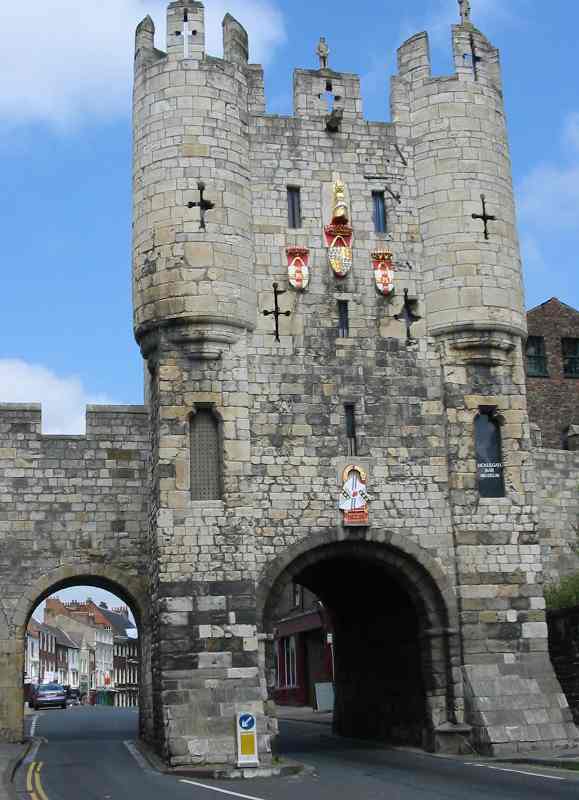
Riding in the direction of Nottingham, we passed through Sherwood Forest, which was really just a forest like any other. There was however a nice bush which had to be used in lieu of other facilities that we dubbed "Little John." Our destination was Somercotes, and the 2003 Horizons Unlimited Motorcycle Travellers Meeting. Grant Johnson was there to greet us. He developed a website, www.horizonsunlimited.com, where motorcycle world travellers could share stories and information. He and his wife Susan, both Canadians, had travelled around the world on their BMW R80 G/S, and gave slideshows about their travels. The meeting site was in a town pub, which had an adjoining field of grass that looked like it hadn't been mowed in several years, for camping. It was soon flattened by all the motorcycle traffic, as over 100 bikes rolled in for the meeting. We set up our tarp, table and chairs and enjoyed a delicious dinner while the rain poured down all around. Later, in the adjoining pub, we watched several interesting slideshows. Sam Manicom, author of Into Africa, talked about his eight year trip around the world. He said it took eight years because he got lost! Jasper, dressed in an authentic gelaba, a type of robe seen in Africa, showed slides of his trip to the deserts and mountains of Morocco. Austin Vince, a mild-mannered English school teacher, showed a film made on one of his trips around the world called Terra Circa. The clips featured the Zilov Gap, which, at that time, was barely a track through the heart of Russia, generally impassable to traffic. Vince and his companions were the first to make it through on motorbikes.
Sherwood Forest
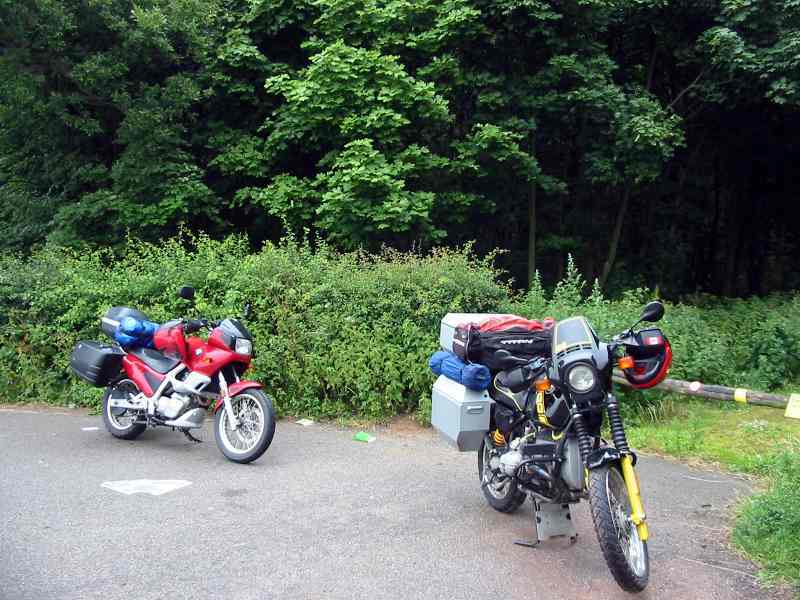
Camping at the Horizons Unlimited Travellers Meeting

Motorcycle rallies are all about riding, and this one was no different. Ekke joined a group for a ride in the rough Derbyshire countryside, while Audrey rode 50 km to Chatsworth, the seat of the Duke of Devonshire. The estate included a huge mansion with frescoed ceilings, lavish furnishings, and Greek statues. An intricate maze was the centrepiece of the gardens, which also included caves, rock features, waterfalls, and lakes. Audrey only got lost once on the way back to the rally, which she was quite proud of, considering the abundance of traffic circles to contend with. Grant Johnson was just giving his slideshow on how to travel around the world, which we had seen in Missoula in 1998, but which we still found informative and entertaining. Chris Scott, author of Adventure Motorcycling Handbook, talked about his trips through the Sahara.
A roundup of Round-the-World Travellers: Ted, Ellen, Sam, Birgit, Bernd, Manou
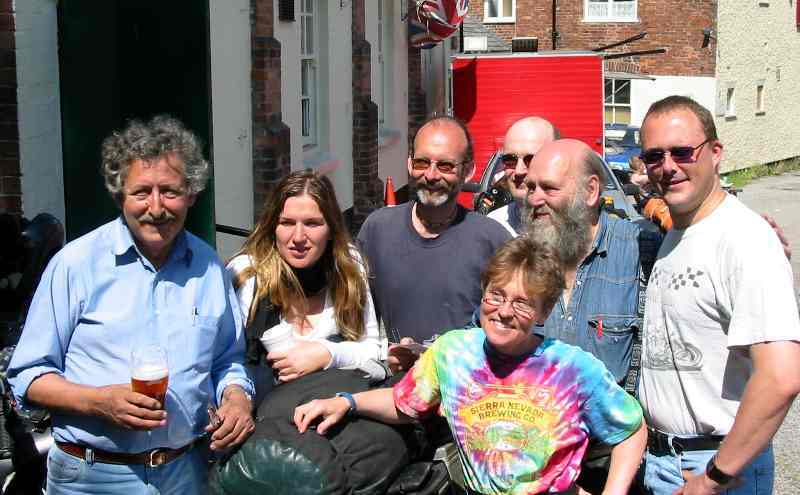
After packing up on the morning of Sunday, June 29th, we chatted with Andy Miller of the U.K., and his friend Heidi from Switzerland, and then with Manou and Ellen, authors of One Year on the Road. We were very lucky to meet Ted Simon, who is legendary in motorcycling circles for his trip around the world in the 1970's, and for his subsequent book, Jupiter's Travels. Ted was supposed to have arrived by motorbike the previous day, but a parked car had pulled out and hit him on a street in London. He was not seriously injured, but his bike needed fixing. Before we left, Grant made us promise to do a slideshow of our adventures, at the Western Canada Horizons Unlimited Meeting in Revelstoke in September.
The next day, we rode to Beamish, near Newcastle, where we had been invited for tea by Dave, a fellow BMW rider whom we had met in Switzerland the previous summer. He showed us great hospitality, and we were treated to some native English cuisine, beans on toast. We spent a couple of hours just sharing travel stories, but, alas, the road was calling. Hadrian's Wall was next on our list, and we saw several kilometres of the Roman structure, originally built to keep the barbarians of the north out of the 'civilized' Roman empire. Dave had mentioned that Alnwick Castle was on our route, so we stopped by to see the place where Harry Potter had been filmed. The courtyard really resembled Hogwarts, and we could just picture Harry, Ron and Hermione lined up on the lawn, ready for flying lessons. Later, we rode on through pleasant countryside, and finished our day at a campground just outside of Edinburgh, Scotland.
Dave!
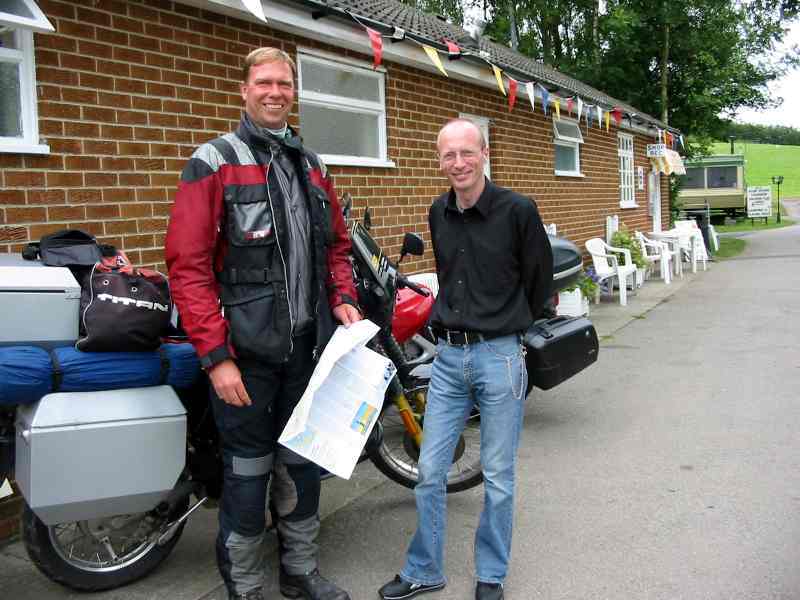
The northern terminus of the Holy Roman Empire: Hadrian's Wall

Ready for flying lessons (well, we're dressed for it anyway)

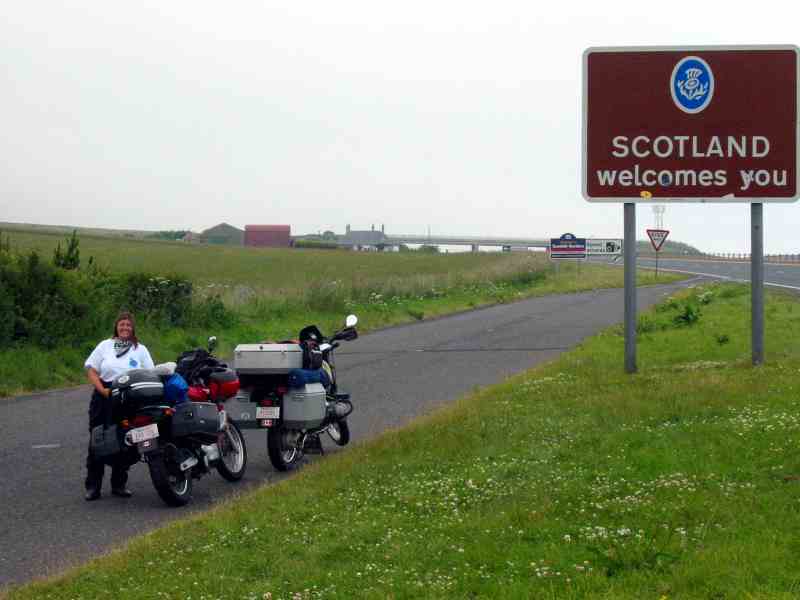
Our route through England and Wales
Hadrian's Wall
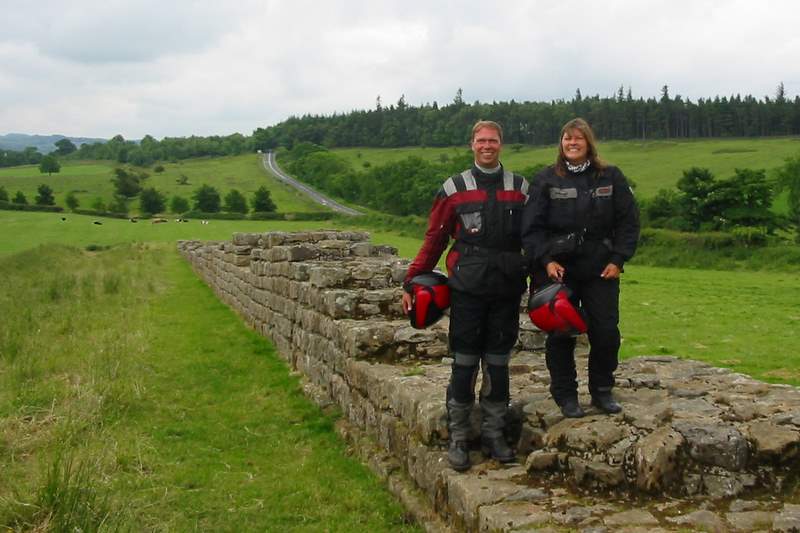
Edinburgh Castle
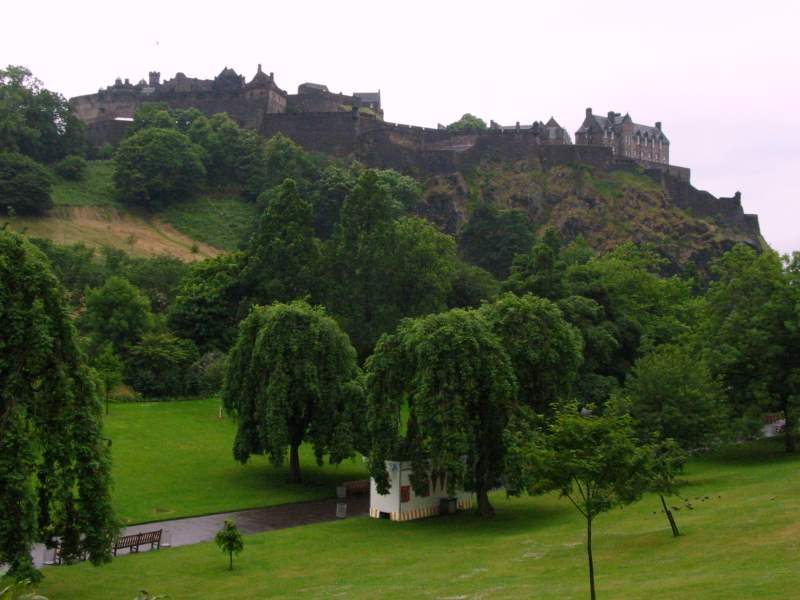
Construction site of the new Scottish Parliament
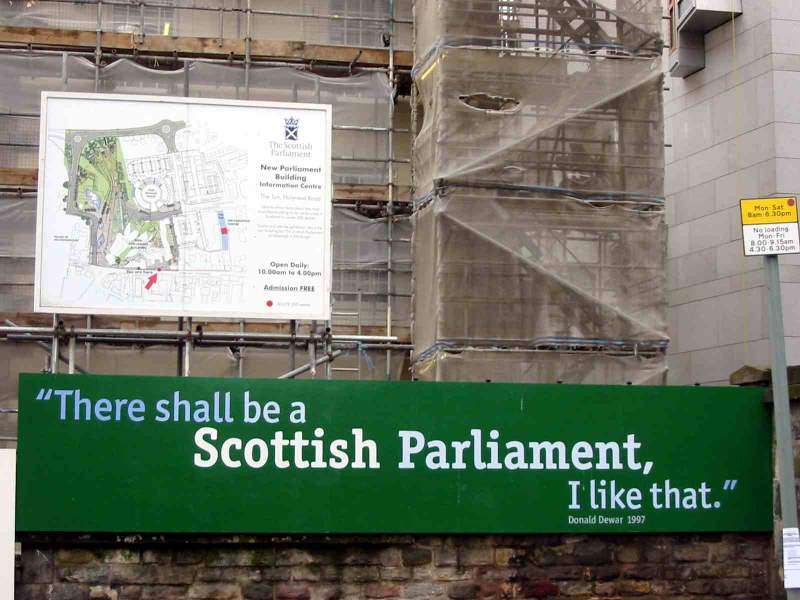
Walking the "Mile" in Edinburgh
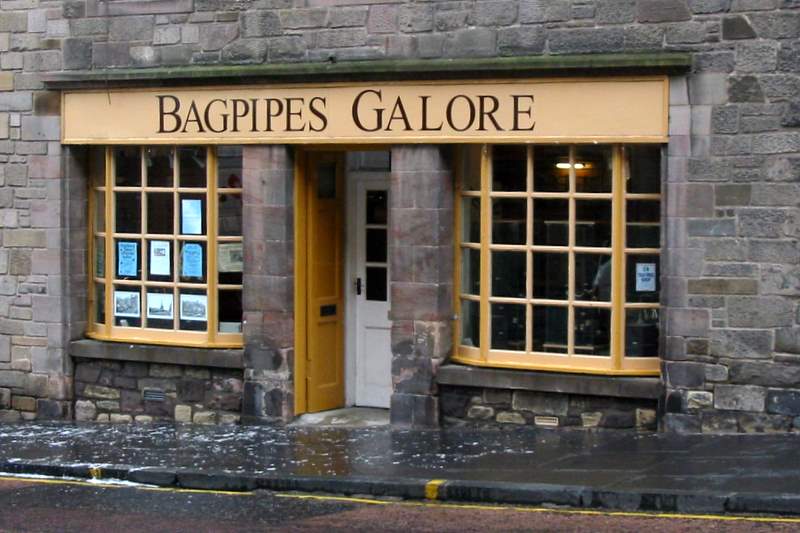
On July 2nd, we packed up and rode to Stirling via two towns of personal significance. Carstairs, Alberta, Audrey's home town, is named after Carstairs, Scotland, so we thought we should pay it a visit. It was a delightful town, with an historic church and inn. While eating lunch in a small café we indicated to the servers where we were from, and they immediately made us feel welcome. One of the girls brought us an email from the town hall bulletin board that was from Carstairs, Alberta, inviting people in Carstairs, Scotland to send postcards for its 100th anniversary as a town. The kids were really interested in our motorcycles and they gave us a quick tour of the place. After our pleasant visit, we rode to Airdrie, Scotland which was somewhat different than where Ekke's folks live, Airdrie, Alberta. He phoned them, and they were quite surprised to hear that he was in Airdrie! We found camping at Witches' Craig, near Stirling, where we had magnificent views of the William Wallace (aka 'Braveheart') monument.
Home?
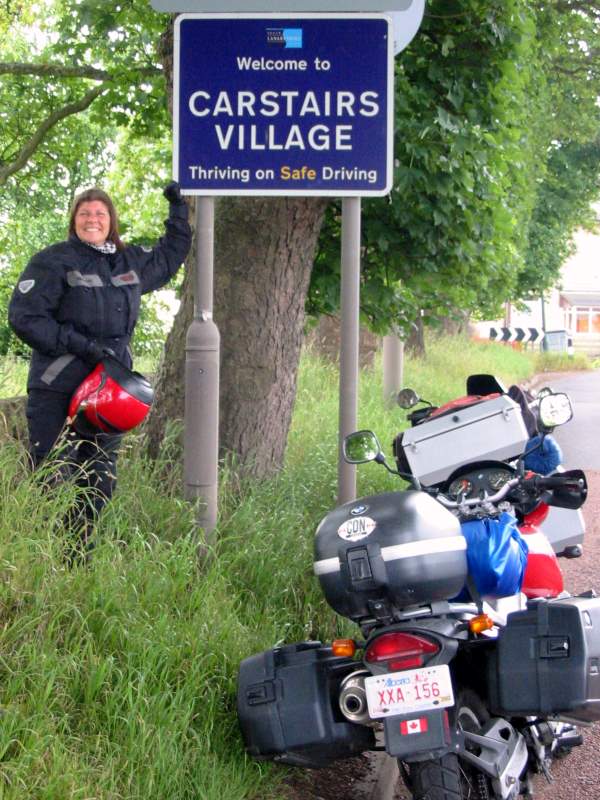
The friendly children of Carstairs
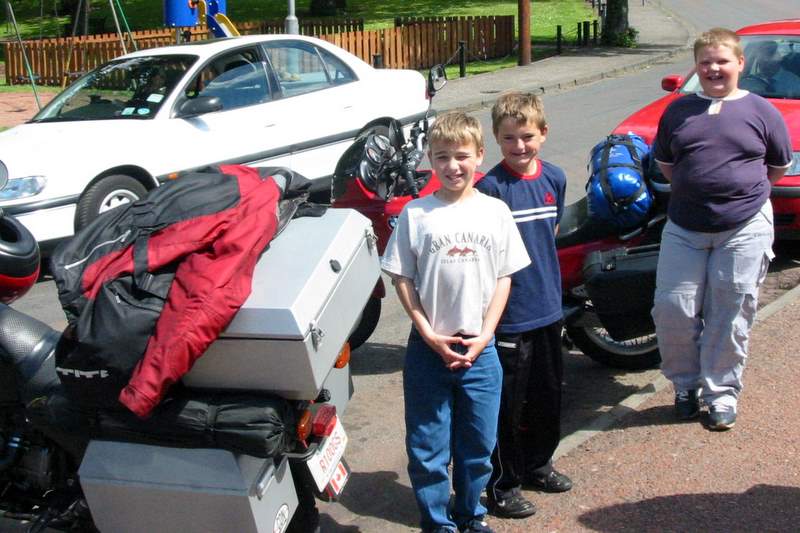
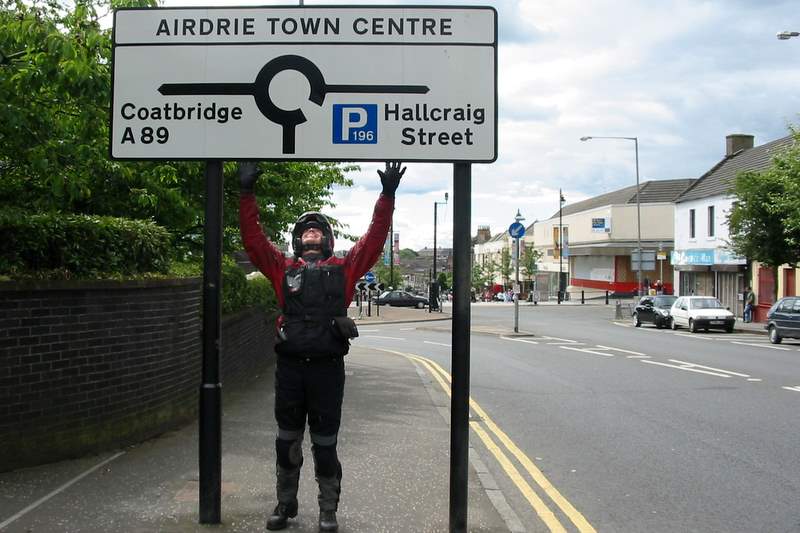
Witches' Craig Campground
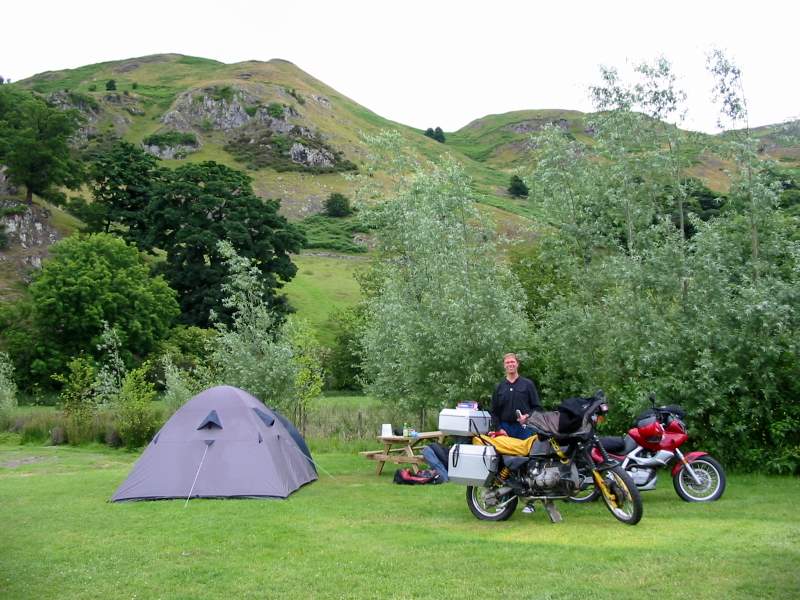
View of Braveheart's tower from campground
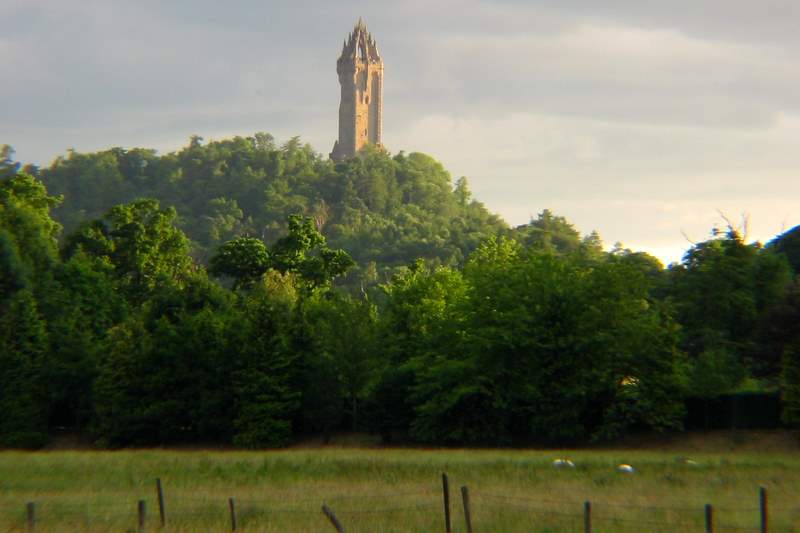
Before packing up camp for an 11:00 a.m. departure, we took in a couple of local sights. William Wallace Tower was perched on a hill, and the walkway wound around several times before reaching the top. Ekke urged Audrey to knock on the big door of the tower for a photo op, and it was quite embarrassing when some people answered. There was a clear view of Stirling Castle, residence of the Stuart monarchs and our next destination, on the other side of the valley. After a short ride there, we caught a formal tour of the medieval castle, where we saw royal apartments, the Great Hall and throne room, kitchens, gatehouse and chapel. A barbarian/actor dressed as Robert the Bruce demonstrated the use of weapons that would have been used at Bannockburn, the last battle where the Scots beat the English. He showed us a broad sword, dirk, bow and arrows, axe, and some chainmail. After lifting the chainmail, we both agreed that the weight alone would have knocked us off a horse! He then gave another demo where he put a large piece of plaid on the floor, pleated it, folded it, wrapped it on an unsuspecting tourist, and called it a kilt. Part of it could be pulled up and used as an upper body covering in bad weather. After packing up camp, we rode on some narrow, twisty roads to Glen Nevis (valley), in sight of Ben Nevis (mountain).
Stirling Castle

Audrey: Queen of Scots
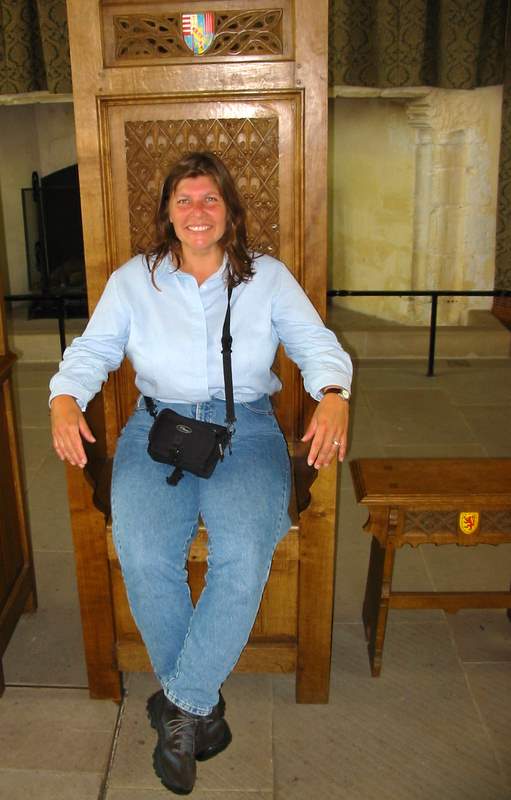
The making of a kilt:
Putting in the pleats
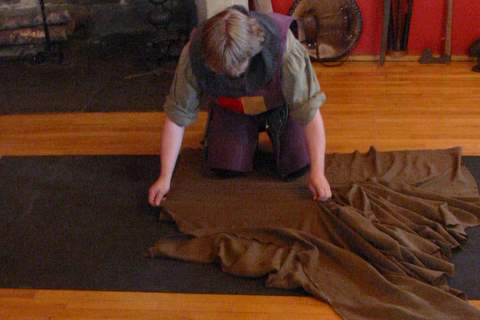
Finding an unsuspecting tourist
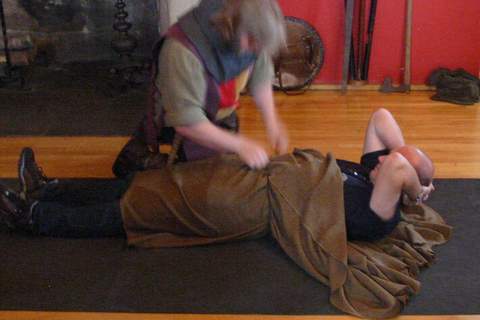
The basic kilt
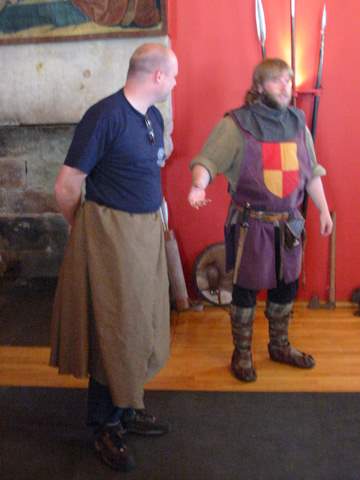
With pockets
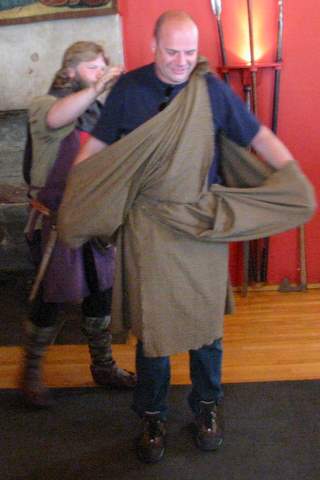
And in cool weather

On July 4th, we did a day ride in the direction of Inverness, via Loch Ness. Although we sat and watched the lake for at least 5 minutes, we did not catch a glimpse of the infamous Loch Ness Monster. Maybe there was more to be seen of 'Nessie' on the touristy side of the lake, but we chose the quieter route and were rewarded with beautiful scenery. Our destination for the day was Culloden, site of the 1746 battle of the Jacobites and the English. The battle site was featured in the novel Highlander, so Audrey had to have a look. It was a touching place, as thousands of Scots had died in the battle trying to help Bonnie Prince Charlie reclaim the throne. Markers were set up to show the battle lines, and apparently the Scots were defeated in just over an hour by the Redcoats. Our route back to camp took us through the Scottish highlands which were a delight to ride in. Many roads were twisty and narrow, and there were regular 'Passing Places', little roadside pullouts so vehicles could pass one another on the narrow roads. The skies remained grey but it only added to the atmosphere of the desolate countryside. Little 'lochs' (lakes) filled the valleys, and were surrounded by bleak, rocky 'mountains' (hills). A few ruined castles could be seen from the road, and Eilean Donan Castle was especially striking.
Enjoying the ride
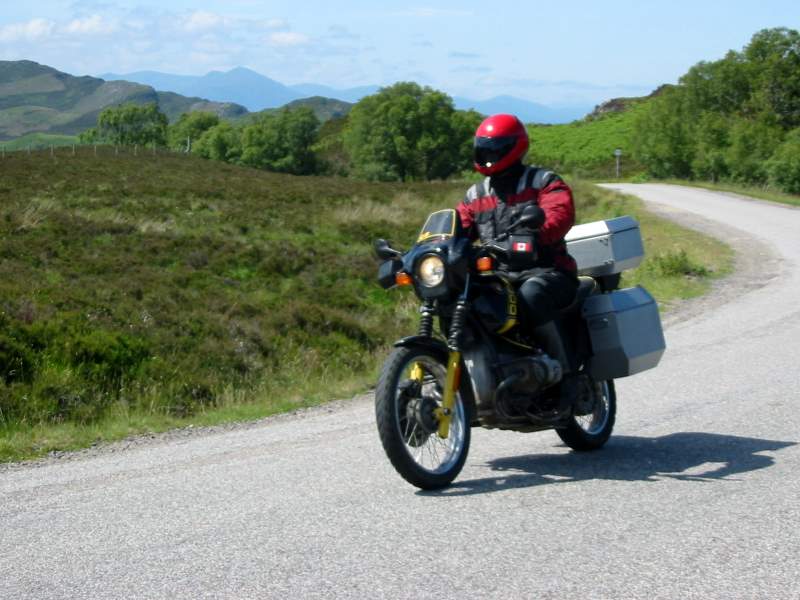
A break at Loch Ness

Culloden Battlefield
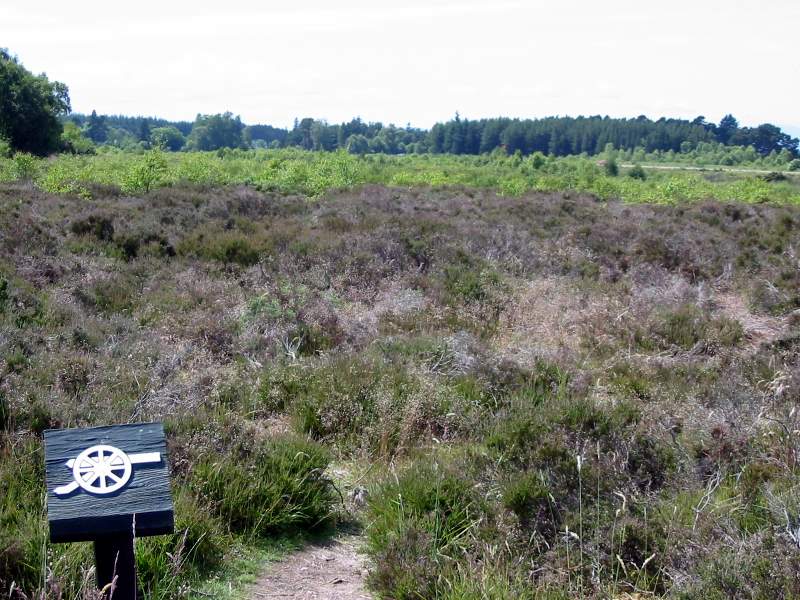
Scottish Highlands
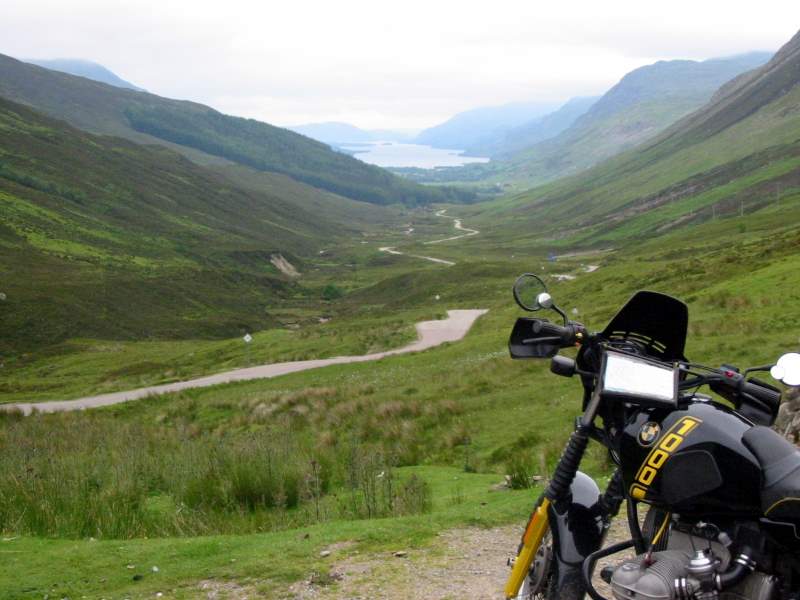
Now that's a narrow road

Eilean Donan Castle
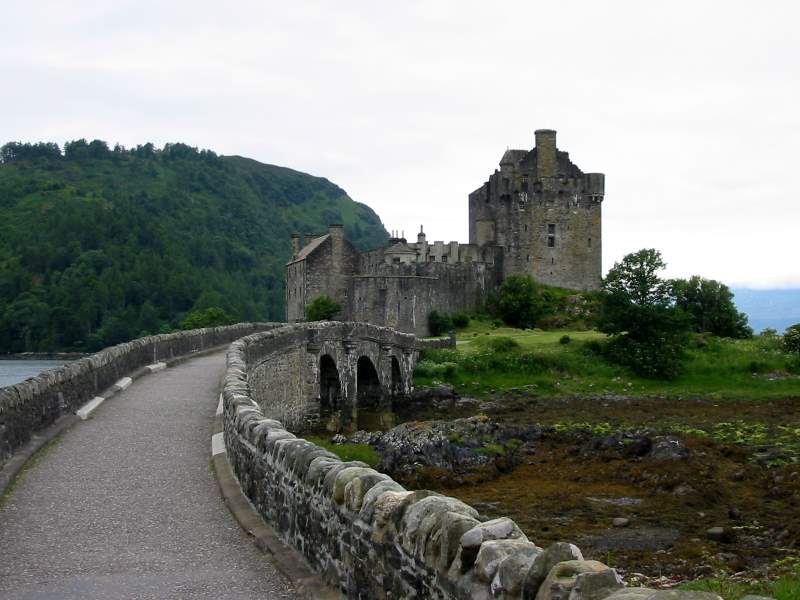
The next day, we packed up, rode by Loch Lomond and Glasgow, and caught a ferry at Cairnryan to Larne, Northern Ireland. On the ferry, we talked with a fellow motorcyclist who was on a Kawasaki (but we won't hold that against him) about our route through Ireland. He suggested going north instead of south, as there was more to see along that coast. We camped north of Belfast, in a campground adjoining a park, and had a great walk after dinner, getting lost in a hedgerow maze, and marvelling at sculptures of various sundials. The next morning we decided to ride north and were glad we did as we saw several ruined castles perched on cliffs on the edge of the ocean. Our first authentic Irish pub looked quite promising, and we felt very at home, especially since the music being played was none other than k.d. lang , a fellow Albertan! The pub quickly lost most of its charm as about 30 tourists piled off a bus and quickly invaded. Oh well. Off we rode, happy to have the option to just leave, and the road hugged the coast as we spent a pleasant hour winding our way west. Our next stop was Giant's Causeway, a UNESCO World Heritage Site. A sure sign that a place is very special is when it's swarming with tourists, and the Giant's Causeway was very popular. This volcanic phenomenon was really quite remarkable to see. Thousands of basalt hexagonal pillars looked like they'd been placed there on purpose, presumably by, well… giants! A hike down for a closer look rewarded us with a great scramble among the pillars and tourists. Our day ended further up the coast, where we camped in the rain. We were beginning to understand why Ireland was so green!
Ruined castles dotted the Irish coast

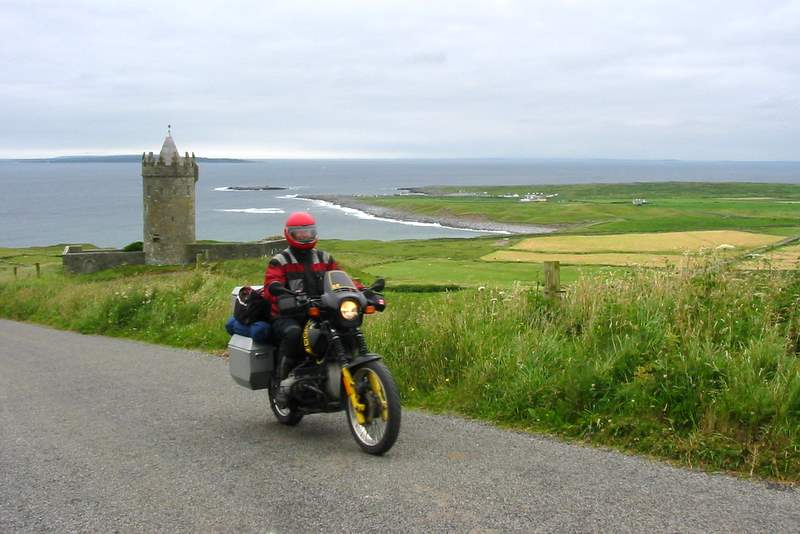
Giant's Causeway

Riding the small, scenic, and often potholed roads was entertaining as we headed south, past seaside communities, sandy beaches and rocky islands. We camped near Galway, at Salthill, an old-fashioned beach resort on the Atlantic. It was so windy and rainy that our Heptawing tarp ripped. It had served us well for a year, so we weren't too disappointed. After a leisurely French toast breakfast the next morning, we went into Galway, a great place to just wander. Colourful houses and boats lined the coast, and stone buildings clustered around cobblestone streets. We had some lunch, did some internet banking, and after a bit more wandering, bought supper supplies and went back to camp. The weather had cleared up nicely, so we strolled along the boardwalk, past an amusement park and people swimming.
The Irish coast
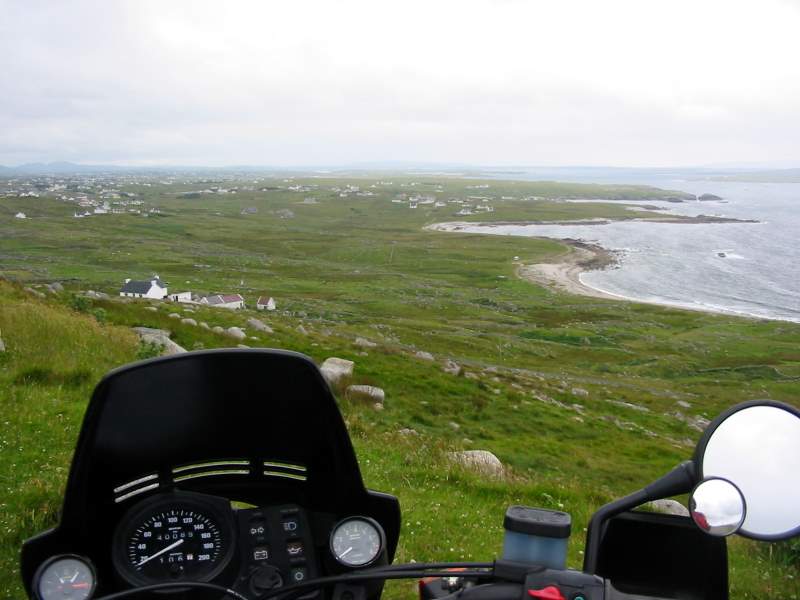
Galway
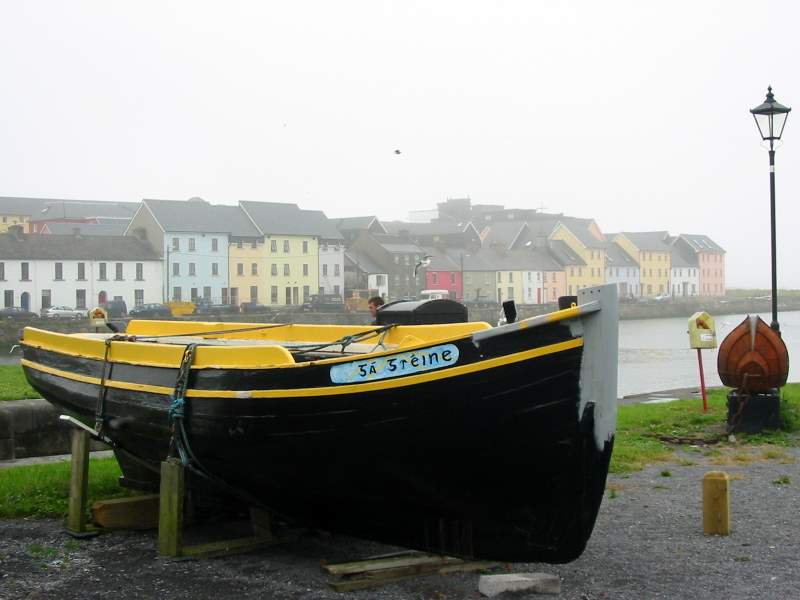
The next day we travelled through an area called the Burren, in County Clare, which was very barren and rocky. At the Cliffs of Moher, we avoided paying €4 each for parking by putting the bikes on the sidewalk near the gate, and walking over to look at the towering cliffs. People wandered everywhere, including right on the edge of the protruding cliffs, but we stuck to the designated pathways, often catching our breath as we watched another tourist walk out to the edge. The sheer cliffs were topped with brilliant green turf, and it was very picturesque with the dark blue waves crashing below. We rode further south and caught the Shannon ferry where we chatted with some American tourists. They thought we were pretty adventurous, riding our motorcycles around Ireland. Well, not quite as adventurous as the tourists on the edge of the Cliffs of Moher! We camped at Tralee, within shooting distance of the Dingle Peninsula.
Peeking over the edge...
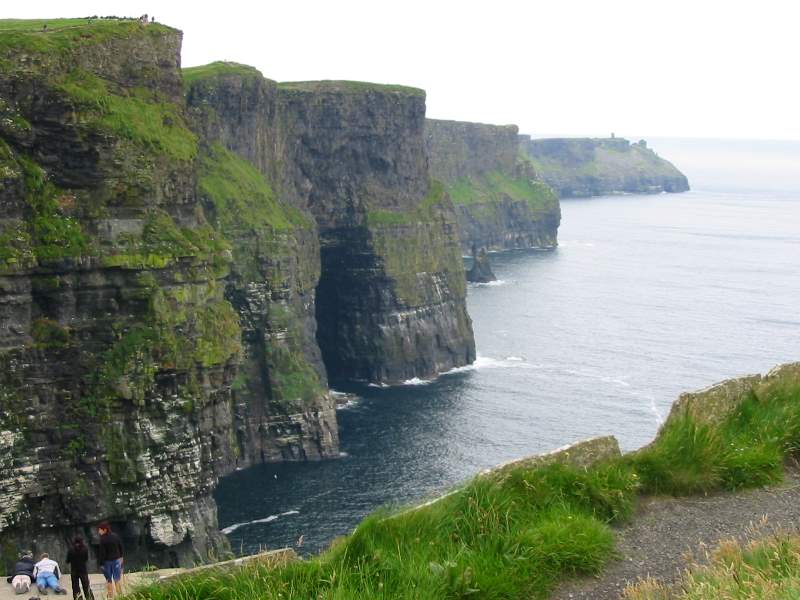
Or just standing on the edge, both looked pretty scary
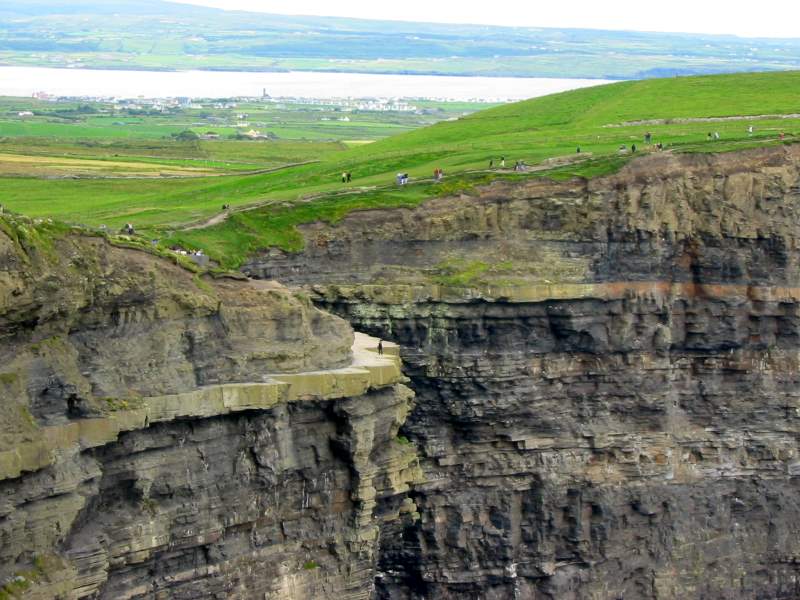
Our day ride to the Dingle, over Connor Pass, was breathtaking. It was a lovely day, with intermittent clouds, but everything looked so green. We hiked up to a little lake, nestled in the cliffs above the road, and took in the scenery. Lunch was at the quaint Dingle Pub where we tried fish and chips and shepherd's pie, and then visited several places suggested by Rick Steves in his guide book. This started with the B&B that Robert Mitchum stayed at when filming Ryan's Daughter. Unfortunately, the only place to pull over was by a little stone fence, which leapt out and bit Ekke's crash bar. He got away with just a scratch on it. We rode by a ring fort from Celtic times, and by ancient Beehive houses made of stone. Supposedly the house where Tom Cruise and Nicole Kidman stayed in during the filming of Far and Away was visible, but we only saw the trees surrounding it. The peninsula scenery was amazing, with waves crashing up on sheer cliffs, sandy beaches and abandoned farmland on hillsides, which had seen the potato famine years. We caught a glimpse of the island that boasted the end of the first transatlantic cable, by Western Union. The other end is in Newfoundland. We also saw the westernmost point of Europe and the highest 'mountain' in Ireland, apparently the first piece of land seen by Charles Lindberg on his transatlantic flight. The ride back was through orderly farmlands and green, rolling hills of the Dingle.
Great lunch spot
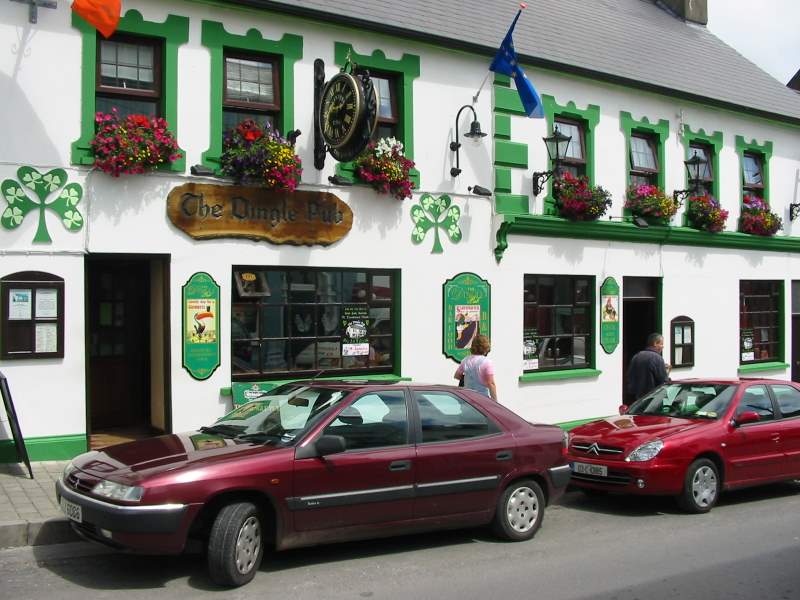
The "Upside Down Bridge" of the Dingle Peninsula
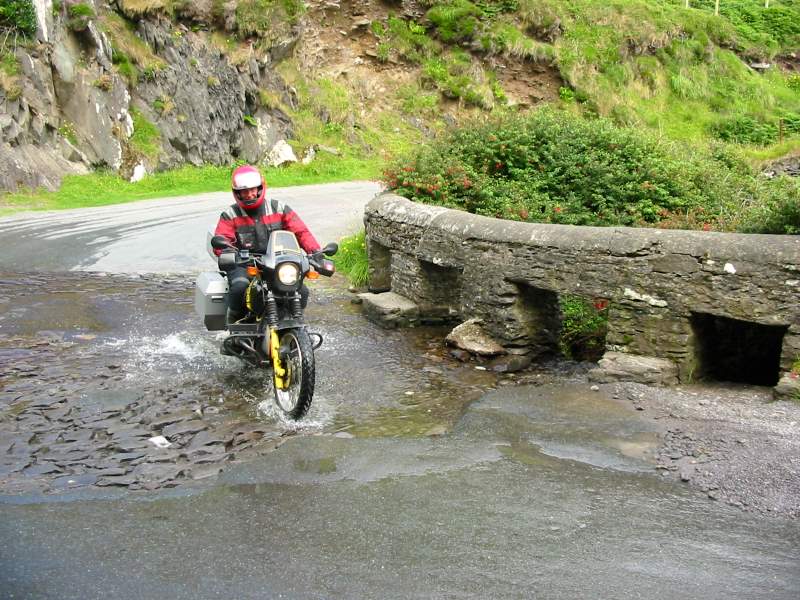
Beehive stone houses
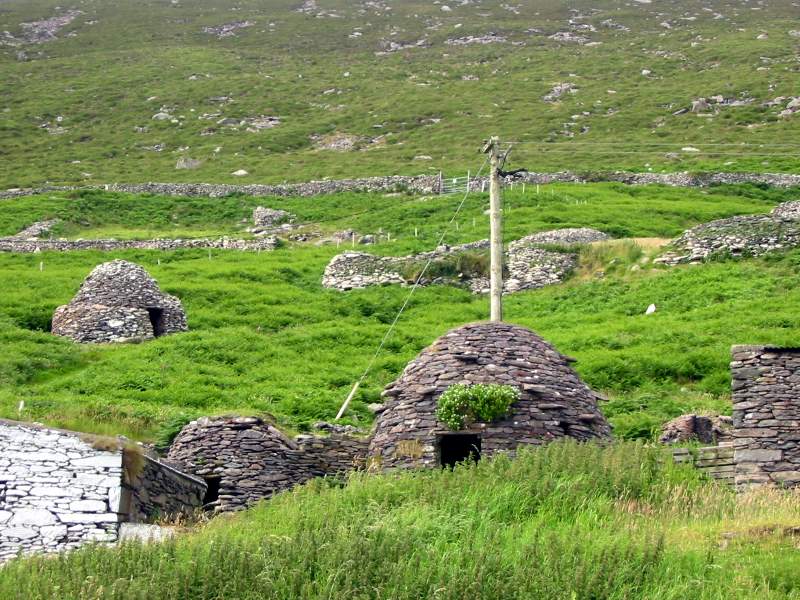
A beautiful sight for Charles Lindeberg
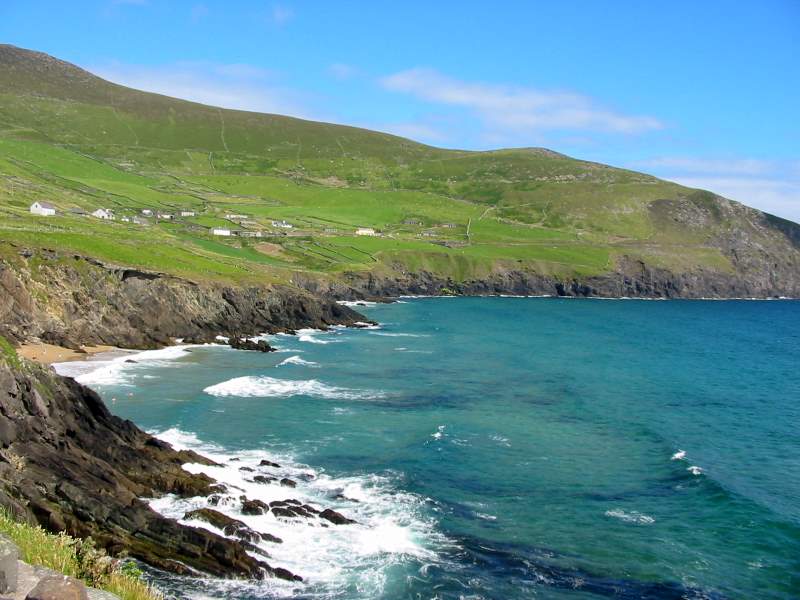
The next morning we took the long way to Killarney via the Ring of Kerry. This is the more famous of the peninsulas, but in our opinion, the Dingle came out on top in terms of rugged scenery and ancient sights. It did have its share of cliffs and sweeping, sandy beaches, but the best scenery was Killarney National Park. It was pleasant riding through the thick forest, encountering some beautiful lakes, and a bumpy road winding its way down a hillside. Of course, we had to get a photo in the town of Killarney, as Audrey would be working at its namesake, Killarney School, in Calgary, later in the year. It was an unremarkable town, but apparently had won some flower competitions. Our ride took us through many lovely little towns, and we stopped at Tipperary, agreeing that it was a long way to get there. A lady in a grocery store directed us to Ballincourty House, a combined restaurant, inn and campground in an historic barn complex with a flowered courtyard. Kids played soccer all around our tent, and thankfully stopped as soon as the biting midges came out.
Preparing for school
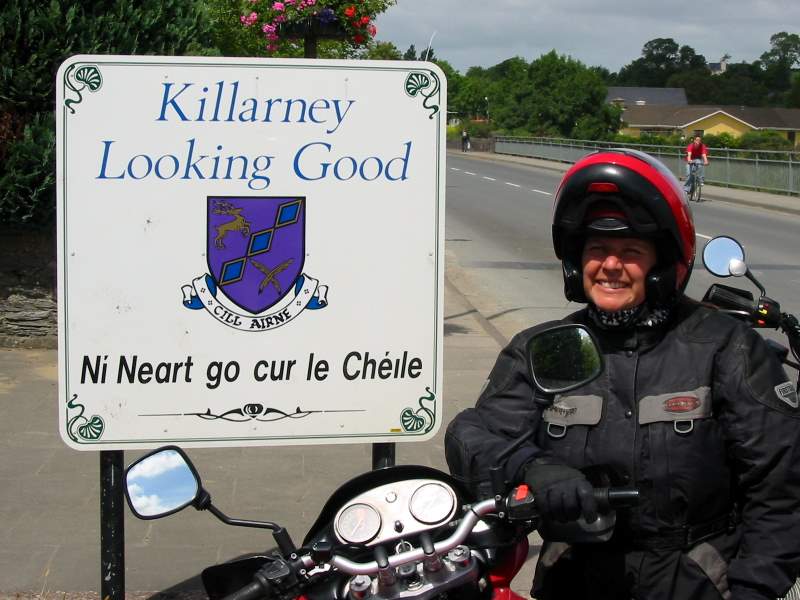
Enjoying sugar free peas at camp
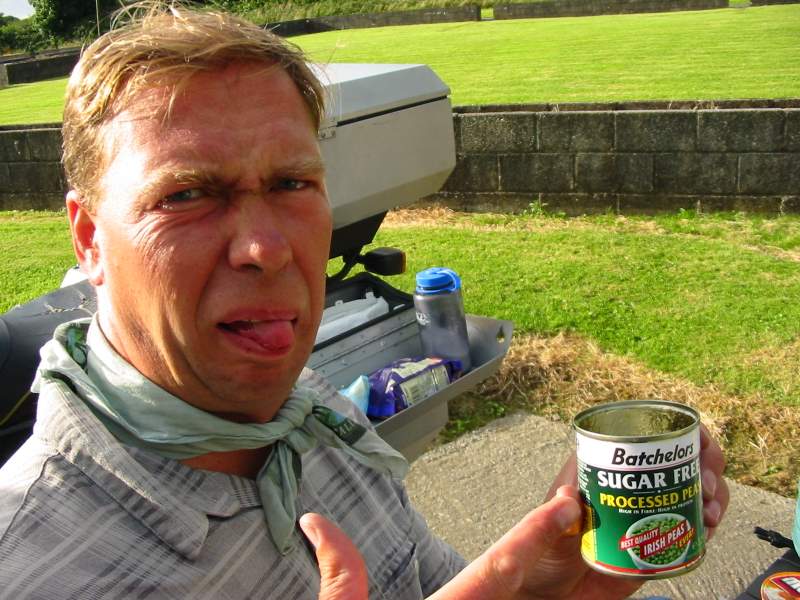
On July 12th, we rode among rolling farmlands, and stared in awe at the Rock of Cashel, an impressive complex which included an abbey, Romanesque Cathedral a round tower and other medieval structures, all perched on a rocky hill. Further along, in Kilkenny, we bought some lunch and sat in a park, within view of Kilkenny Castle. Riding further east, we came to a place we wanted to have a closer look at, Glendalough (pronounced 'glenda-lock') a monastery founded by a monk, St. Kevin, in the 6th century. Many buildings were intact, including the only monastic gateway in Ireland, and the slate roofs were especially impressive. The monks used to hide up in the round tower during Viking raids or the English incursion. It was a beautiful sunny day and we had a pleasant walk to some little lakes. Glendalough literally means 'two lakes'. We camped near Dublin in an RV park, and there were plenty of other tenters there.
Rock of Cashel
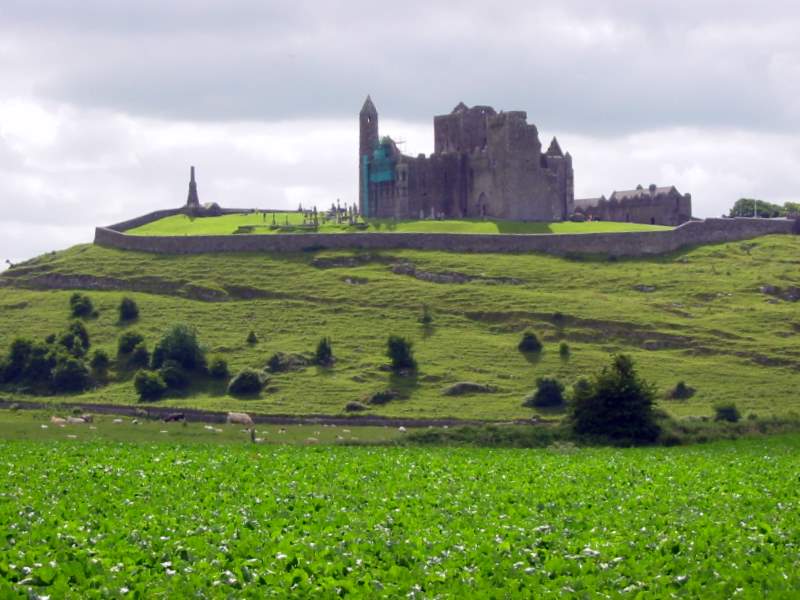
Kilkenny Castle

Glendalough
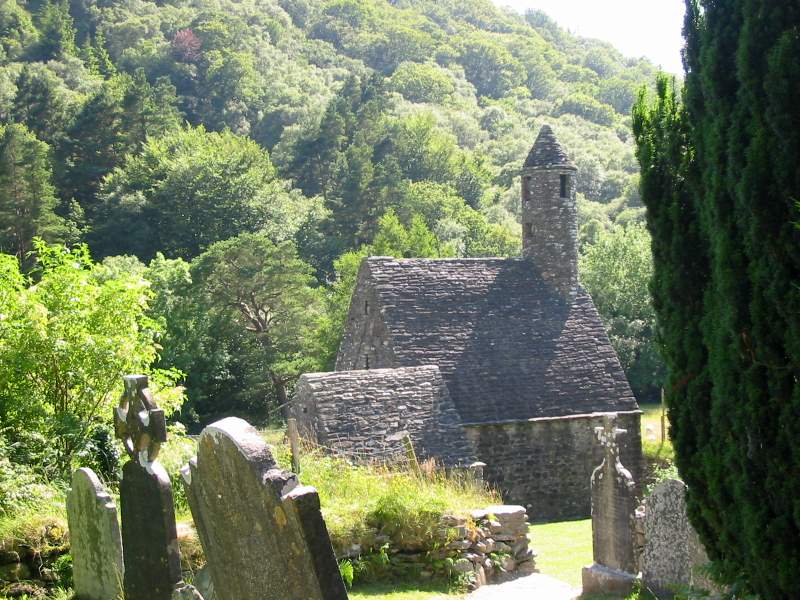
The next day, we caught a bus into Dublin and left the bikes in the safety of the fenced campground. The tourist office was housed in the de-sanctified St. Andrew's church, and we procured a pop-up map and made plans for the day. We made our way down Grafton Street, a pedestrian area lined with stores housed in what were previously Georgian mansions. A beautiful old shopping centre with wrought iron railings stood at the end of the street, just in time for lunch, and we settled on some sandwiches from one of its stores. It was a beautiful day, so we sat in St. Stephen's Green, a lovely park with people strolling and students studying. Manicured lawns and colourful flower gardens abounded. There were many monuments, and one statue was a 'thank-you' from Germany for support Dubliners gave to children after WWII.
Ha'penny Bridge in Dublin
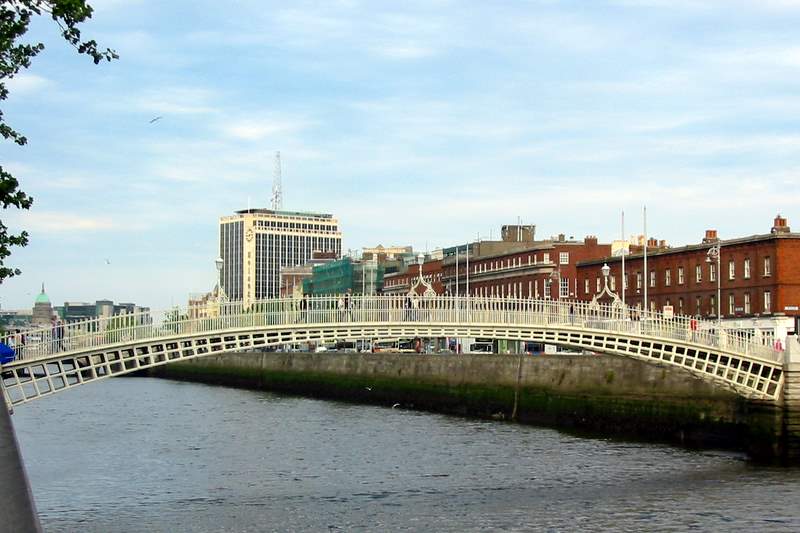
One of the oldest known books in existence is the Book of Kells, from around 800 A.D., and we were able to see it in the library of Trinity College. There was a great display set up, showing how the monks made the illuminated manuscript, from the making of the vellum from calfskin to the colours used for the ink using various exotic minerals such as lapus lazuli. Pages were ruled by cutting lines in with a knife, and the calligraphy was written between the lines. Apparently the monks who did the manuscript travelled from far and wide, including St. Gallen, Switzerland where some of Audrey's ancestors came from. They kept art and literature alive during the dark ages (the monks, not the ancestors). The walls were covered with enlarged pages of the book, with explanations of the artwork and symbols. The end of the tour was the book itself, enclosed in a glass case, and this ancient artefact was a wonder to behold. Further on was the long hall of the library, housing 200 000 volumes of historical books such as court proceedings at Versailles or drawings of old Amsterdam. Ekke was quite impressed when he saw the oldest harp in Ireland. A walk around the grounds at Trinity College was charming, and we saw cricketers practising for their next test match. They were really batting well, and it was surprising how many wickets were hit. Since we know nothing about cricket, of course, we are making most of this up. What a confusing game. The statue of Oscar Wilde, looking smug as he reclined in his colourful smoking jacket, was across from his former residence. Engraved on stone tablets nearby were several of his witty quotes such as "I can resist everything except temptation", and "Thought is not catching" and "I drink to keep body and soul apart". A walk by a statue of Molly Malone, down Grafton Street took us to the Temple Bar district. We actually tried a pint of Guinness and agreed that it was smooth, creamy, and very flavourful. Apparently they give it to people in hospital to speed their recovery.
Excellent batting!
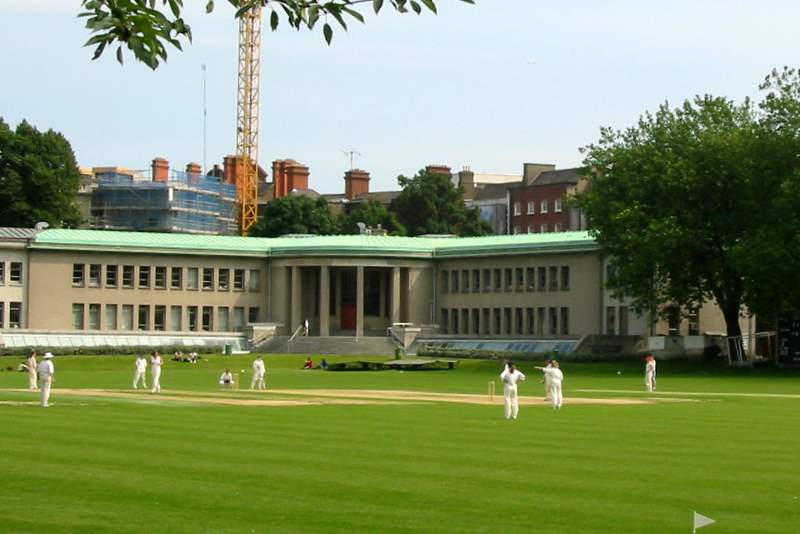
Oscar Wilde

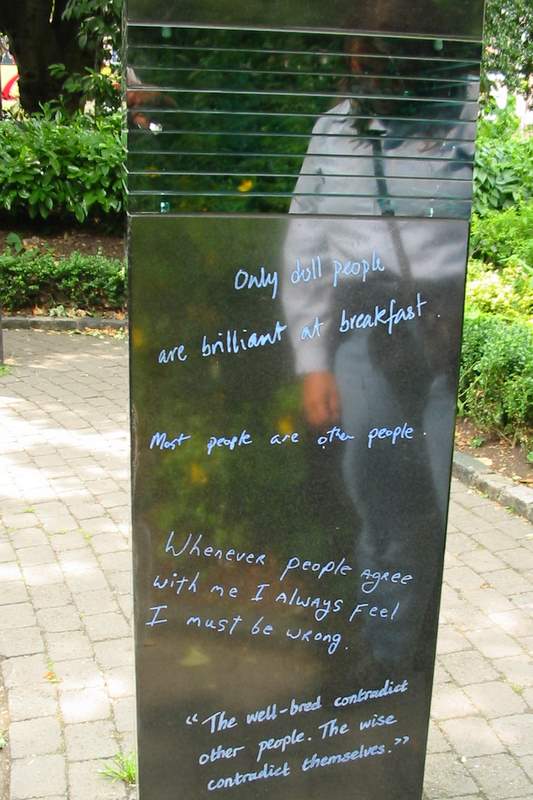
Our plan was to catch the 1:15 p.m. ferry to Wales the next day, but it was late and didn't leave until about 3:00 p.m. All we could do was hang out in the ferry station, and the only food nearby was a sandwich from a gas station convenience store. Then, right after we got on the boat, we were offered a hot meal, for free, which, of course, we couldn't say 'no' to. We read and wrote during the 6 ½ hour journey and got another complimentary hot meal just before we got off the boat. Since we arrived so late, we decided to ride straight down the coast to the campground in Prestywyn, where we knew, from our previous stay, that the back gate would be open all night. We had memorized the code to unlock the bathroom door, so that was very handy. The tent was finally up at 10:30 p.m., and we paid the campground fee the next morning. Our next destination was London, where we would spend a week visiting the city and arrange to have the bikes flown home. Although we were excited at the prospect of seeing London, we could feel the trip winding down, and it was often a difficult concept to be faced with.
We won't be seeing these at home...

Our route through Scotland and Ireland
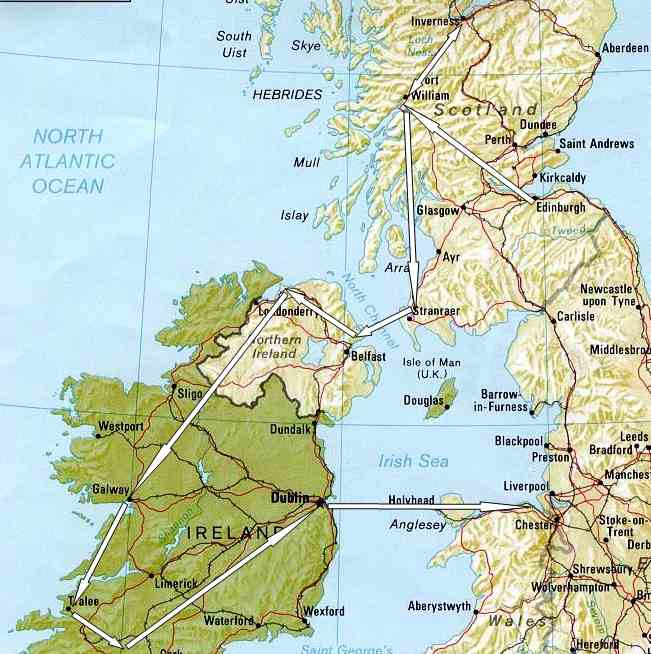
The Romans called it `Londinium' and the Saxons, `Lundenwic', but for us, London was just `fun'. We camped outside of the city, in Edmonton, though it looked like a continuation of London itself. It had only taken about 4 hours to ride from Prestywyn, Wales on June 15th, 2003, all via the motorway, and we had needed to stop a few times to rehydrate because of the heat. With no desire to ride into downtown London, we bought a transit pass the next day and left the bikes in the relative safety of the campground. A train and then the `Underground' took us to Victoria Station, where we were able to walk to Buckingham Palace and catch a glimpse of the Queen's digs. The lack of a flag flying meant she wasn't there, so, with no chance of being invited for tea, we didn't hang around too long. St. James Park was nearby, so we walked through beautiful gardens with an abundance of birdlife in the ponds, and had lunch at the Cake Café which was sadly lacking in cake. The weather was extremely hot and muggy, and it rained a few times in the course of the day. This didn't dampen our enthusiasm as we walked by sights we had always heard about and were anxious to see: Big Ben, Parliament, Downing Street, and Trafalgar Square. They all exceeded our expectations, especially the statue of Nelson high upon his pillar with lion statues at his feet, and we just sat and took it all in. Apparently the sculptor of the lions had never seen lion paws, so modelled them after his dog. The square was surrounded by various buildings, including Canada House, St. Martin-In-The-Field church, and the National Gallery. Behind it was the National Portrait Gallery, where we stared at paintings of famous big-shots from medieval times to present day. Highlights included Henry VIII, Anne Boelyn, Elizabeth I, and, of course, David Beckham (no Posh Spice, though). The portrait that Andy Warhol had done of Queen Elizabeth II was especially interesting and I was surprised that the conservative Queen had allowed the modern painting. The train back to camp, through pleasant industrial areas, took about an hour.
Parliament and Big Ben across the Thames
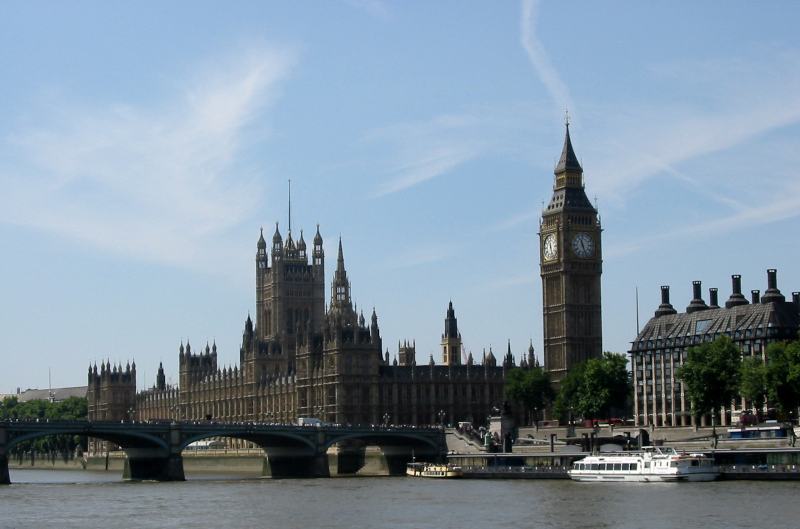
Trafalgar Square
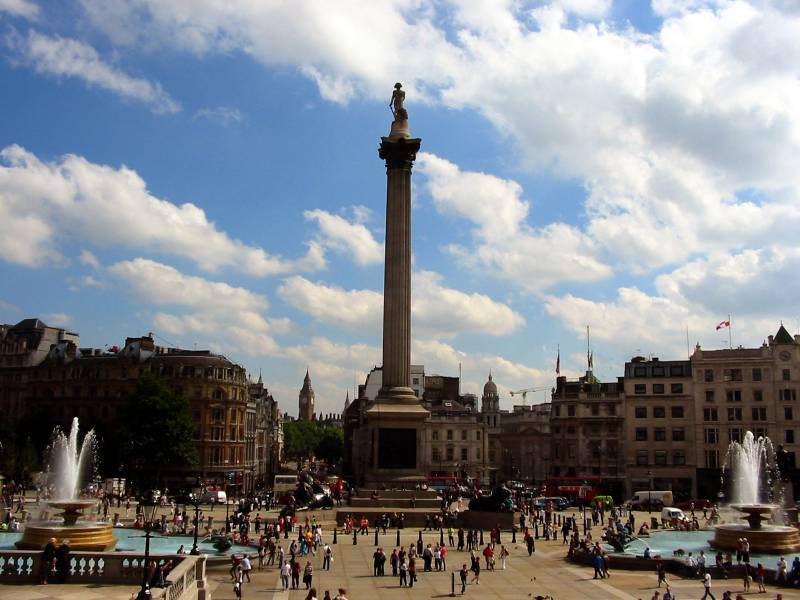
Audrey gets a kick out of the Lion's paws

A bright and early start the next day got us to the Tower of London in good time, and we spent many hours wandering amongst the intriguing structures. It started with a tour by a Yeoman Warder, who was irritated when we tourists had put up our umbrellas while he talked, and insisted that a little light drizzle wouldn't hurt us. The Warders, or `Beefeaters' lived on site, and it was a position of prestige, given by the Queen to former members of the military of England. He told several stories, such as when Henry VIII was annoyed when Anne Boelyn requested that her execution be with a sword instead of the usual axe. Henry had to pay a French executioner £28 to do the job! The Warders had a great sense of humour, and we heard a tourist ask one, “Where's the Bloody Tower?” He replied in a gruff tone, as only the English can get away with, “Down the bloody road!” Two young princes were killed in that tower, apparently by their uncle, Richard III. The White Tower was the original one built by William the Conqueror, and it housed many displays of armour and weaponry. The crown jewels were magnificent, and in the queue we saw films of various royals wearing them, including the coronation of Elizabeth I. A sliding walkway made sure that we were moved alongside the jewels in good time but we found we could hop-on / hop-off for a longer jewel viewing experience. The Traitor's Gate was near the Thames River, and prisoners were just floated into the tower complex by boat - very convenient! Walking around the perimeter wall, we got a good view of the execution grounds, and we could just imagine the crowds of Londoners witnessing the gruesome events. From just outside the wall, we had a look at the Tower Bridge, often mistakenly called `London Bridge'. A walk up the Thames afforded views of the London Eye and several modern architectural wonders.
Yeoman Warder gives a great tour

The convenient Traitor's Gate
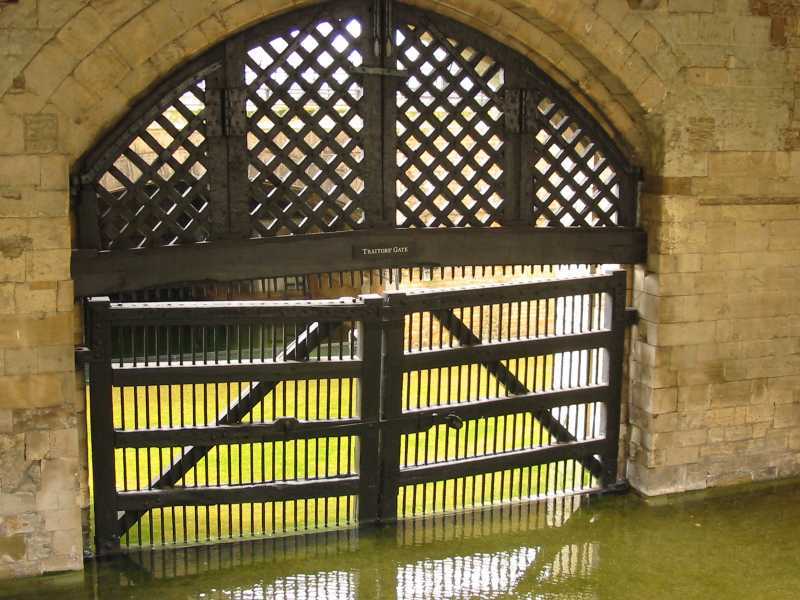
Tower Bridge
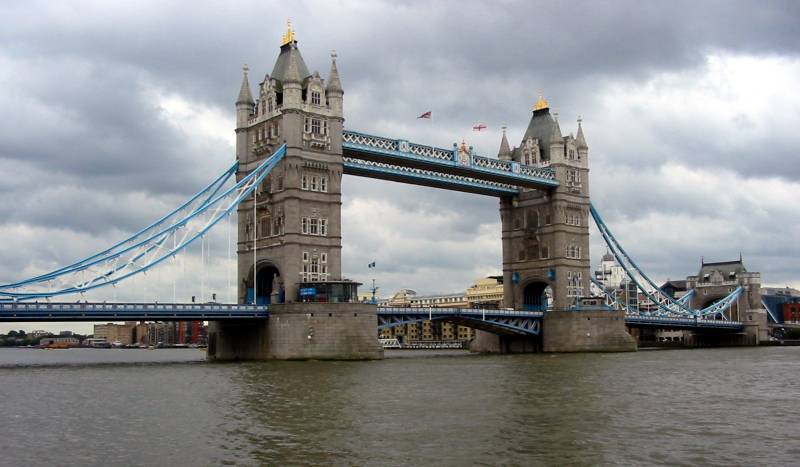
After such a full day at the tower, we decided to just visit the National Gallery the next day. It was so extensive, it was like all the museums we'd seen, rolled into one, except for free. We were taken back to Italy when we looked at some Leonardos, Raphaels, and Boticellis. There was a lecture on Bachus and Ariadne, and it made the viewing of Titian's paintings all the more interesting. Several Dutch painters, such as Van Gogh, Vermeer, Van Ruisdael and Rembrandt were represented, and English artists included Turner and Gainsborough. Some Monet and Degas works reminded us of the Orsay in Paris. The gift store had a Van Gogh poster that we purchased for Ekke's mom, as well as a few souvenirs. We stopped in at the National Portrait Gallery again because we had forgotten to look at a painting of James, Duke of Monmouth who'd had his portrait done after being executed. They had to sew his head back on to do it, but no one wanted to pay the artist because the likeness was not `lifelike' enough for them. The portrait was in storage, so that explains why we didn't see it before and why we couldn't see it now.
The 19th of July was a beautiful blue-sky day, so we decided to take a boat tour down the Thames from Westminster Pier to Greenwich. The London skyline was very attractive from the boat, and the tour commentary explained much of the interesting architecture. The first view of Greenwich was of the clipper ship, Cutty Sark as it sat in dry dock. (Note: The Cutty Sark has since burned down, hopefully not beyond restoration). It had been involved in the tea and wool trade and we were able to climb aboard and explore the ship, looking at the way sailors lived in the 1800's. A walk through the park took us up to the observatory where Ekke got a thrill straddling the prime meridian, with a foot in both the Eastern and Western hemispheres at the same time. He also got to fulfill his dream of pretending to be an architect as he was picked to play Christopher Wren in a presentation on longitude. He didn't think he should quit his day job to take up acting, though. At 1 p.m. we watched as the red ball on top of the Royal Observatory dropped. The idea was that seagoing vessels could see it from the Thames and set their clocks by it. The observatory housed some very interesting displays of astronomy and timekeeping, and we set our watches to GMT, Greenwich Mean Time. It was fascinating to see the timepieces that were mentioned in Dava Sobel's book, Longitude. A statue of General Wolfe stood nearby (interesting for us Canadians) commemorating his victory in Quebec. A hike down the hill took us along the harbour, via King William's Walk, past the old Royal Naval College, Royal Maritime Museum, and Queen's House. We had a look at the Gypsy Moth II, a small boat that Chichester sailed single-handedly around the world. After a walk through the open air market, the tube took us right back to downtown London, where we caught a train back to the campground.
Cutty Sark in Greenwich
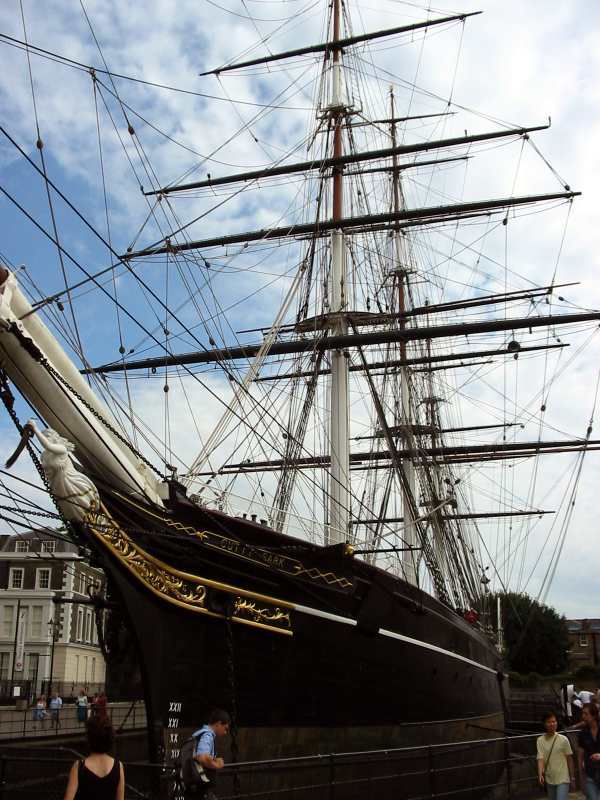
Straddling the Prime Meridian
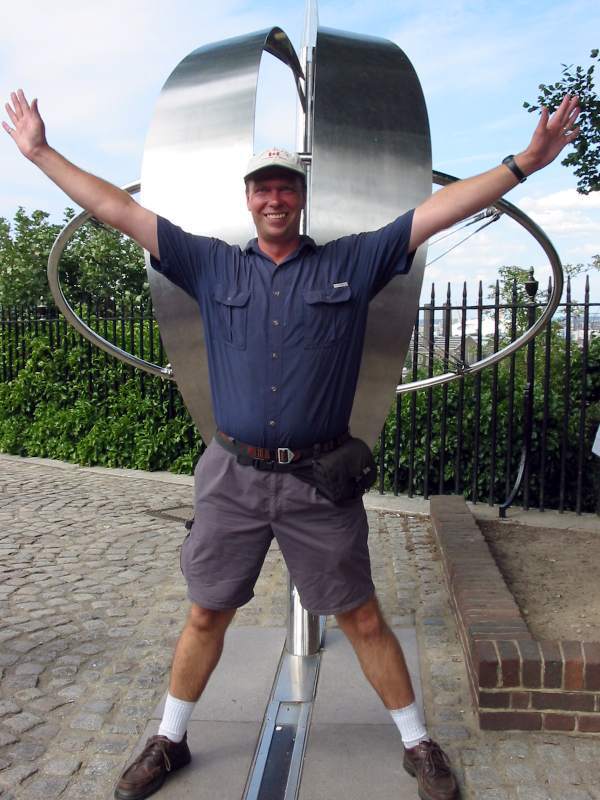
Exactly 1:00 PM and the ball drops
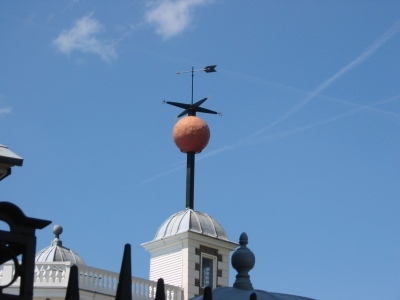
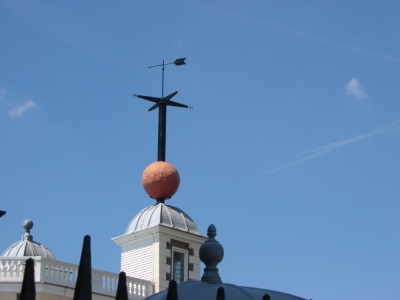
After spending most of Saturday outside, we were ready for the air conditioning of the Museum of London, which turned out to be one of our favourite museums. There was so much to see in this spectacular journey through the history of the city, with displays from prehistoric, Roman, Viking, Medieval, Tudor and Industrial eras. A whole street was set up, complete with shops, in the style of the Charles Dickens time period. We didn't realize how much Roman history there was in the city until we laid eyes on hundreds of Roman artefacts. The tube took us to the British Library, where we listened to Beatles “I Wanna Hold Your Hand” on headphones while looking at the original lyrics written in John and Paul's handwriting. Leonardo's notebook was fascinating, as well as Galileo's first published work, original sketches and text of Alice In Wonderland, and the Magna Carta. I was thrilled to see Jane Austen's writing desk. Sunday afternoon was a great time to visit Camden Market, a quaint area chock-a-block with any goods imaginable, and hoards of tourists. It was easy to find souvenirs for everyone back home, and we even found a Coldplay cd for my brother. At the Camden locks, a long, narrow holiday boat was just coming through, which was quite interesting to see.
Audrey on the way to the British Library to see original Beatles lyrics
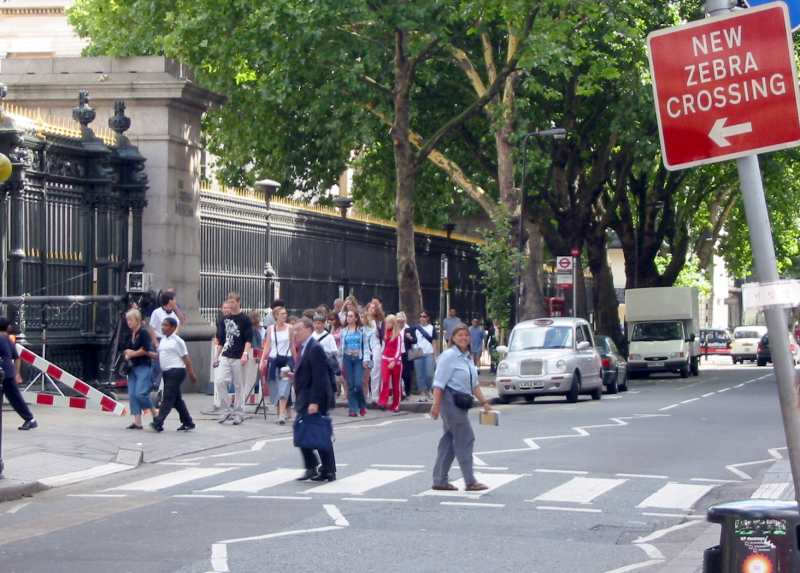
Camden Market
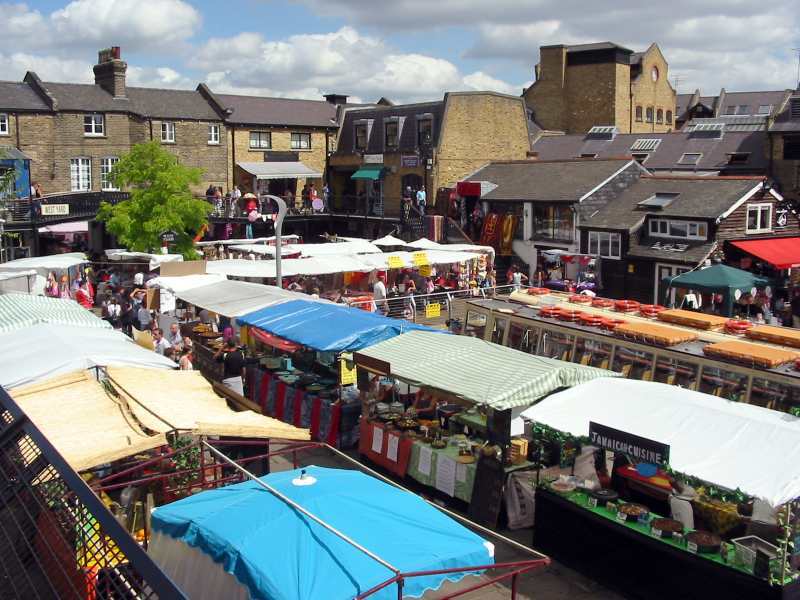
You'd think we'd be all museumed out by now but we still hadn't seen a real `biggie', the British Museum, so we made that our goal for the next day. Just like the National Gallery had taken us back to all the museums we'd seen, the British Museum took us back to Greece and Rome. A highlight was the Elgin Marbles, the frieze that graced the Parthenon in Greece before Lord Elgin decided they'd look nicer in Britain. Perhaps he actually saved them from deterioration in the smog of Athens, but I don't know if the Greeks would agree. The Egyptian artefacts were quite stunning, and it was really something to be face to face with the Rosetta Stone, which helped decipher hieroglyphs. We only saw a fraction of the museum, not because of time, but because it was so huge. Later on, we took a stroll past Piccadilly Circus and then Leicester Square. We saw them setting up for a big T3 (Terminator) London premiere. A quick visit to the Transport Museum giftshop, and then a stroll through Covent Garden made for another very full day.
Spectacular Egyptian exhibit in the British Museum
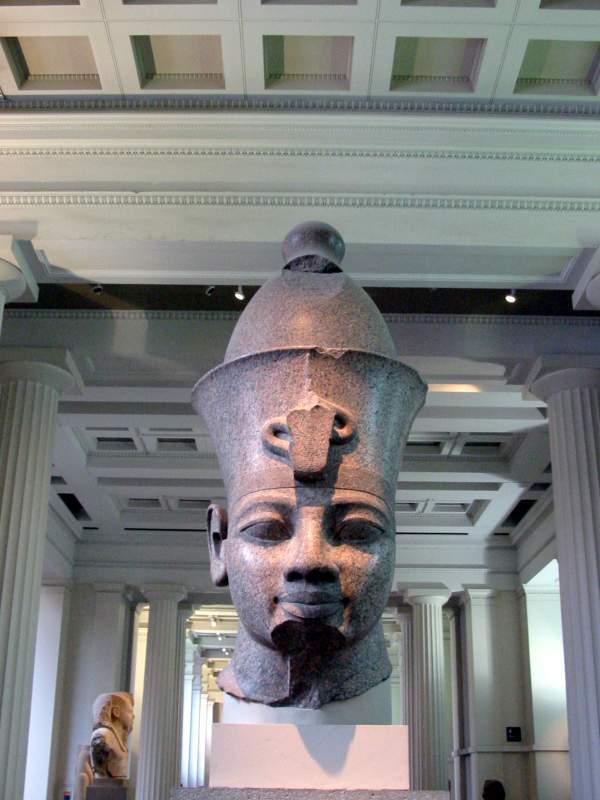
Love the cat in the upper right corner of this Egyptian tapestry!
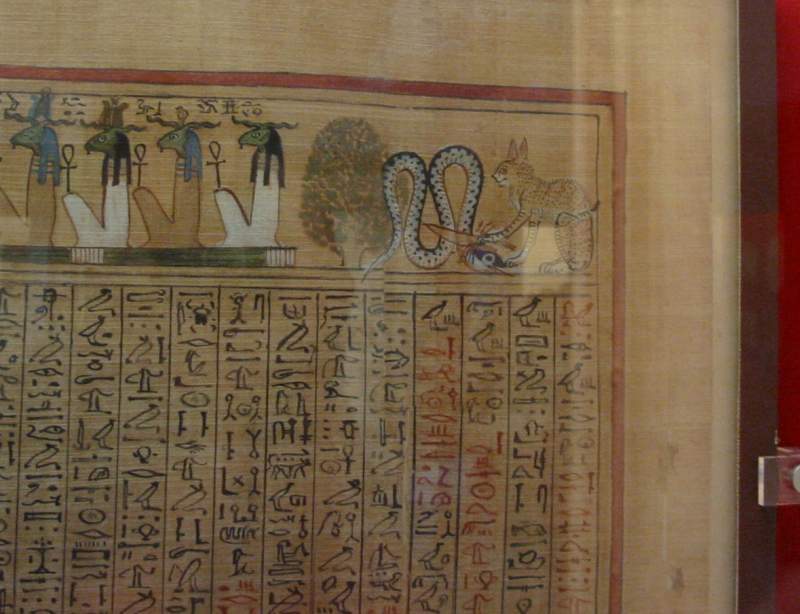
The Rosetta Stone used by scholars to decipher Egyptian hieroglyphics
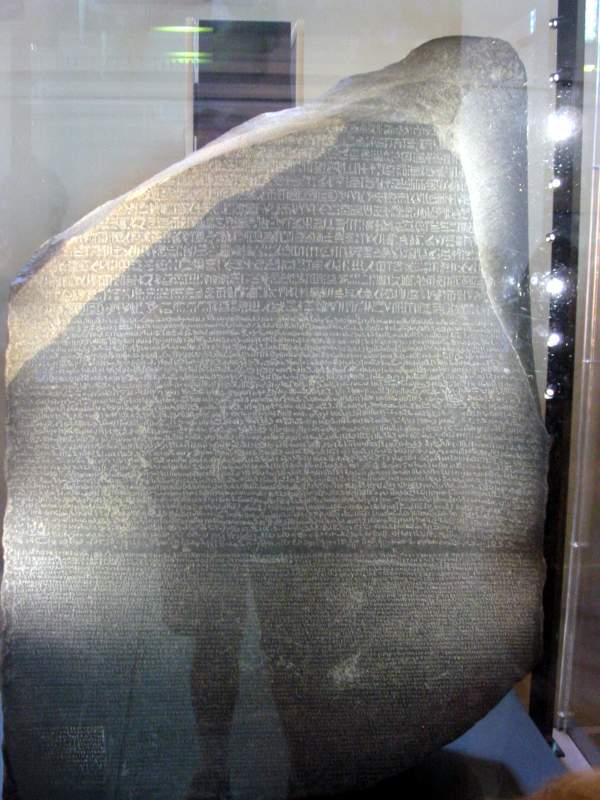
On July 21st, we packed up and rode to Air Canada Cargo at Heathrow Airport. We had made plans to drop the bikes off, and with a little paperwork, it was as easy as rolling the bikes into a warehouse and disconnecting my battery. Ekke's drycell did not need to be disconnected. His GS weighed 290 kg and my F650 weighed 220 kg though we didn't pay by weight, instead purchasing an entire pallet. It was sad to say goodbye to the bikes, knowing that we'd also be flying home in a couple of days. The cargo area wasn't really for tourists on foot, so it was a bit tricky trying to find some transportation out. A bus driver whose job it was to transport employees stopped for us and after we told her our plight, she said, in a very demanding tone, “Get on my bus!”, so we did. She took us to the Underground for free. From there, we rode to Victoria Station and the Cherry Court Hotel which we had found in one of Rick Steves' guidebooks. It was a simple Bed and Breakfast, in an old Georgian house, and it had everything we needed, including free internet.
Air Canada Cargo at Heathrow
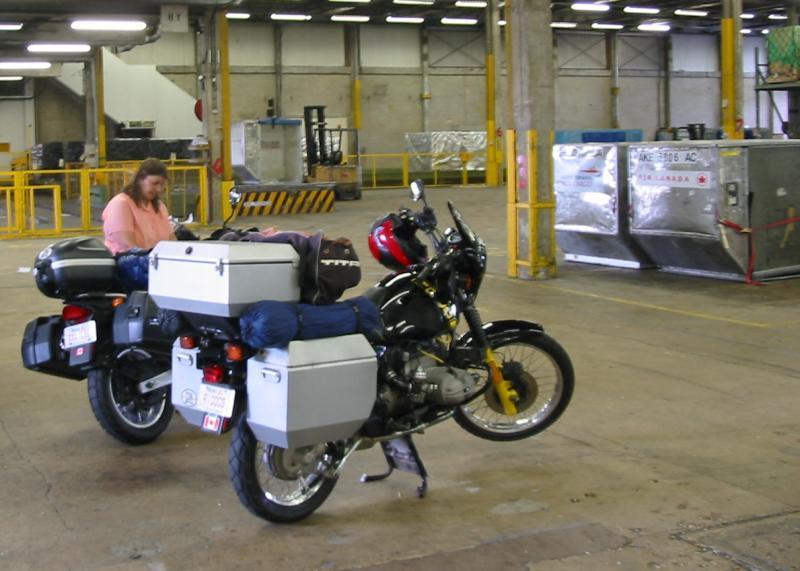
Home for a couple of days
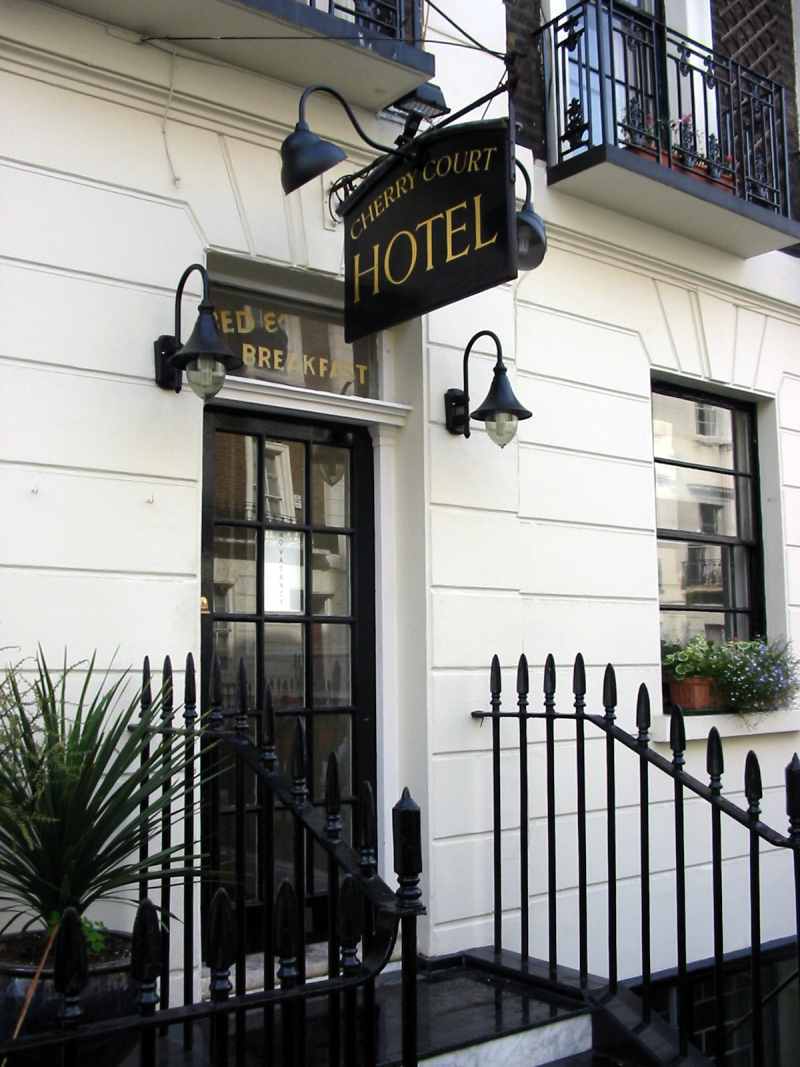
With one full day left in London, we spent our time just poking about. I wanted to see Paddington Station so we caught a double-decker bus to the place where the stuffed bear from Peru was found by the Brown family (children's book, Paddington). The Ritz Hotel and Harrod's looked quite stuffy, and nearby was a SAAB dealership where Ekke couldn't resist sitting in a bright orange convertible 9-3. We enjoyed tea in Notting Hill (no Hugh Grant sightings), and wandered by St. Paul's Cathedral and over the Millenium Bridge to the Tate Modern. The museum was very open, being housed in a converted Power Station. After taking in a few galleries displaying Monets, Picassos, Dalis and Warhols, we had lunch in the restaurant, which afforded fabulous views of the city. Shakespeare's Globe was nearby, or, at least the recently rebuilt version. At one of the city theatres we saw a crowd forming and soon realized they were waiting for Reese Witherspoon, who was there for the London Premiere of Legally Blonde II. Not wanting to get caught in the crush of young fans all dressed in pink, we went to Leicester Square and got tickets to a London theatre production, Stones In His Pocket. The play was inevitably very well done, all performed by two really versatile actors playing many different roles. The story was set on the Dingle Peninsula in Ireland and was about the invasion of an American movie crew and how their presence upset the locals. After the play and a walk through SoHo, it was back to the Cherry Court Hotel.
Paddington train station and the famous bear

Crossing the Millenium Bridge to the Tate Modern museum

St. Paul's Cathedral and the Millenium Bridge from the restaurant in the Tate Modern
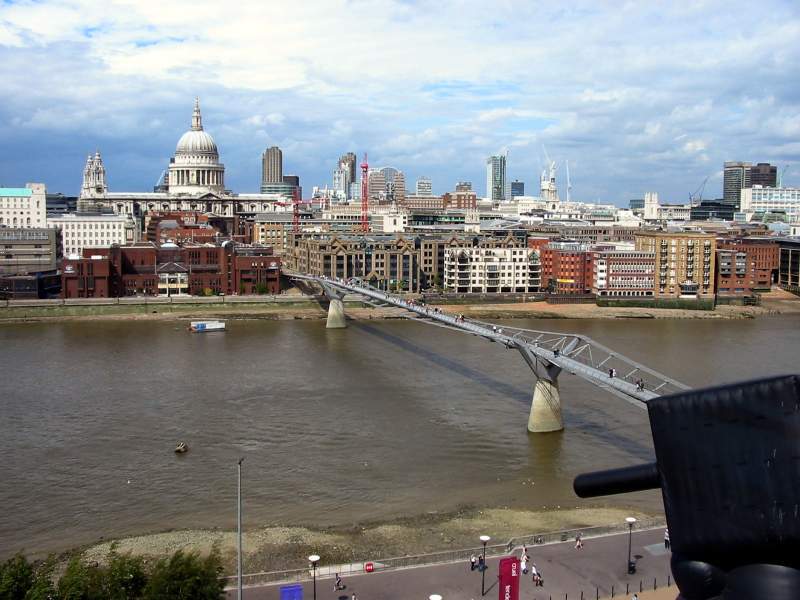
Yes, it really is a converted power station
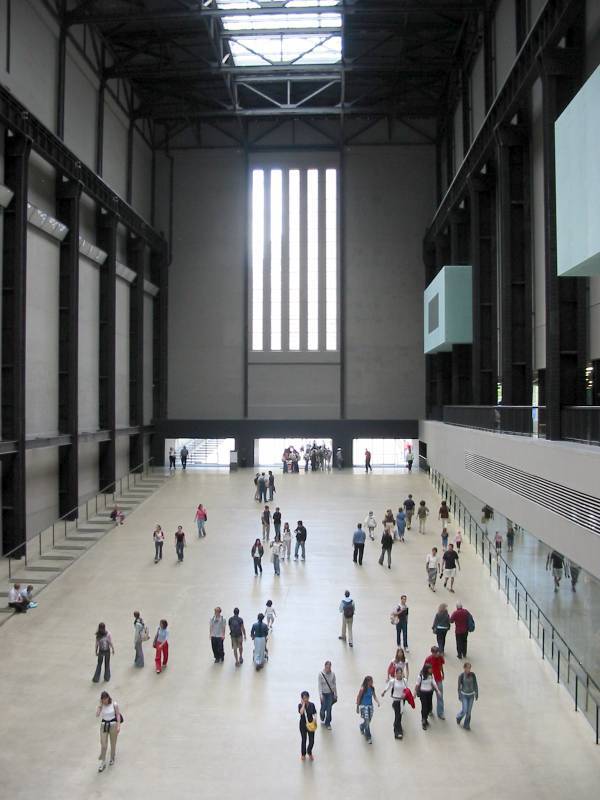
A reconstructed Globe Theatre
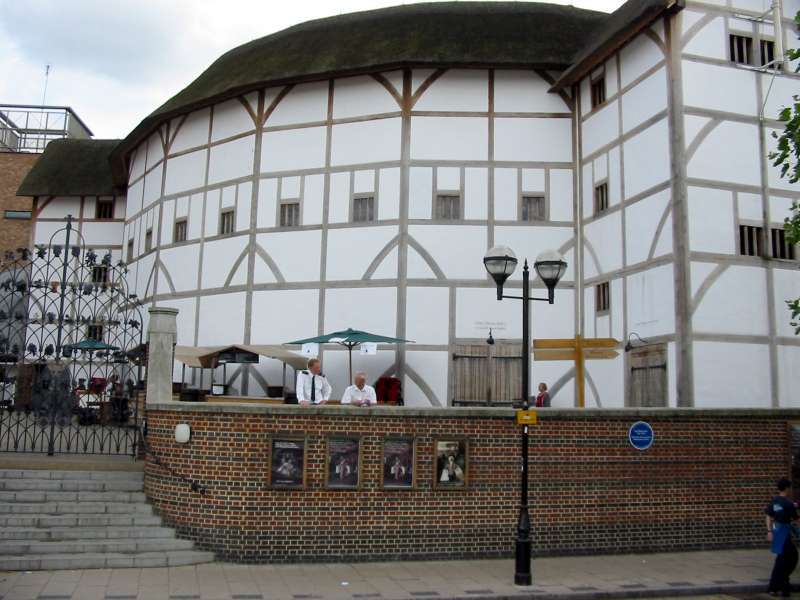
The next day, the last of our trip, we caught a train from Victoria Station, just around the corner from our hotel, to Gatwick Airport. We had to walk out onto the tarmac to catch the flight, and as we were filming and photographing, a security guard came over and asked us to stop. Good thing she didn't confiscate our cameras! Ekke had booked some seats at the main entrance of the plane so we had some great legroom for the eight hour flight. Our parents were there to greet us, and there we were, back in Canada.
Ask for Row 10 on Air Transat's Airbus 330 for legroom!
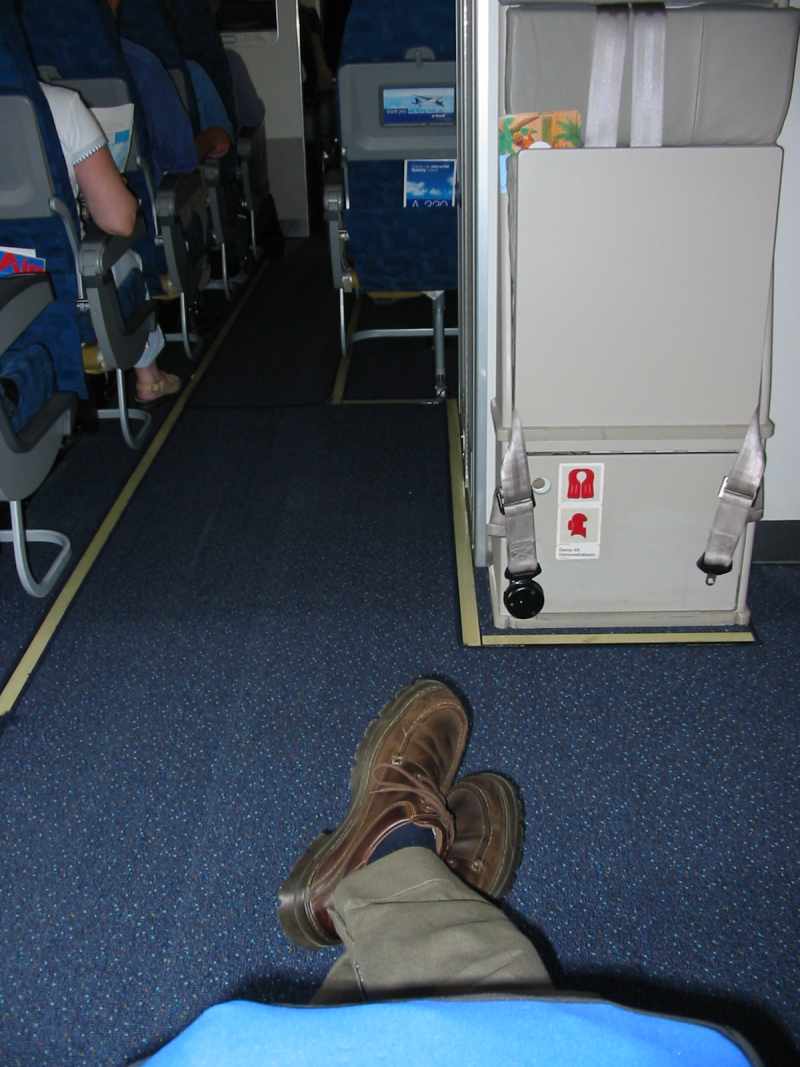
Two Ekkes watch as the R100GS unstrapped from the pallet
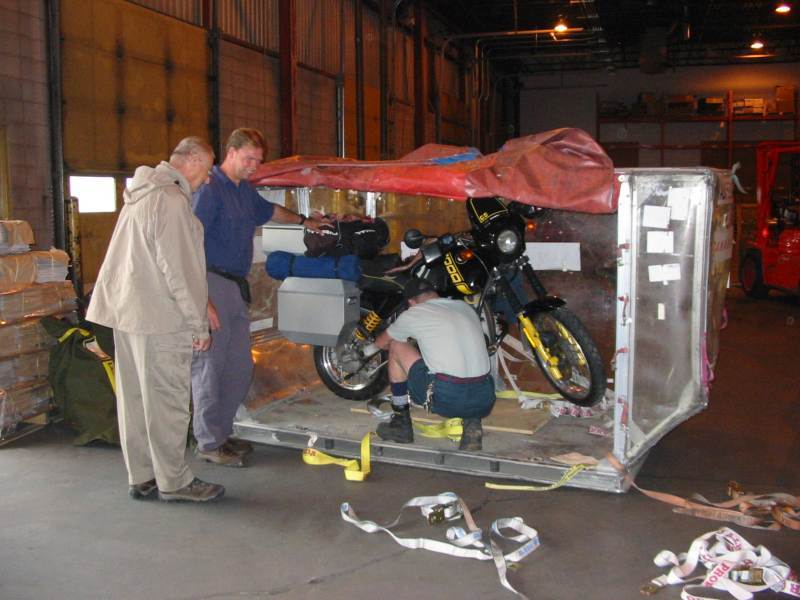
Wide open spaces of Western Canada
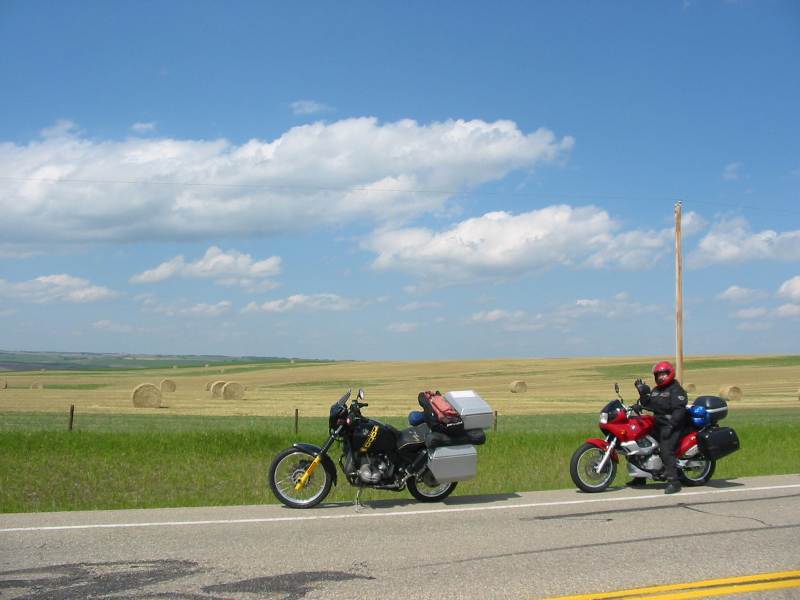
Epilogue:
Well, we've been back in Canada for over three years, and are well into the planning of our next trip, Longitudinal Way Round. It was fairly devastating for this trip to be over and get back into the predictable, everyday life that we had last seen 13 months prior. We look at our pictures regularly, and the incredible moments of the journey come back to us. We think we can remember every day of the year, every place we stayed at, every museum or church we visited, although our lazy beach days in Agadir, Morocco sometimes are a blur. One fantastic discovery, is that people are friendly and helpful everywhere, no matter where. We met them in cities, in the country, in hotels or campgrounds. From the cook who put Ekke's disabled bike into the back of his Mercedes van to the people in Turkey who gave us free oranges and chocolate bars at the roadside stands, to the gentleman who offered us sweets as the sun went down during Ramadan, friends are always there to be made. We encountered very few people who were out to rip us off compared to the ones who truly just wanted to meet us. There were Roman ruins wherever we went, from Ephesus in Turkey to Dougga in Tunisia to Hadrian's Wall in Northern England and it really reinforced how huge and sophisticated their empire had been. We loved following the growth of art through the ages, from early cave drawings to religious sculpture to the Renaissance of Michelangelo and his David to Rodin's beautiful sculptures.
We've spent summers travelling to Yellowstone and Grand Teton National Parks, Utah and Colorado, and Inuvik via the Dempster Highway, soon, (July 1st, 2007) we will embark on the next adventure, Longitudinal Way Round. Having just had immunizations for Hep A and B, tetanus, typhoid, yellow fever, diphtheria, polio and rabies has really brought home the fact that we're going to be in some interesting places. See you there!
We are planning our next year-long trip. We'll leave Calgary on August 1, 2007 and return in August of 2008. The plan is to head south through Central America and along the western coast of South America to Ushuaia in Argentina, as far south as possible in time for Christmas. Then turn north, riding along the eastern coast to Buenos Aires. From there we'll fly the motorcycles to Cape Town in South Africa. Then through Namimbia, Botswana, Zimbabwe, Mozambique, Tanzania and Kenya. At the time of this writing (February 2005) it is a bit of a challenge going north of Ethiopia through Sudan and Egypt so we've tentatively planned to fly from Nairobi to Europe. Plans can (will!) change so we might be able to ride this portion come Spring (or Fall if we're still south of the equator) of 2008. Below are a few maps with our planned route. Arrows in white are riding and arrows in blue are flying or perhaps boating.
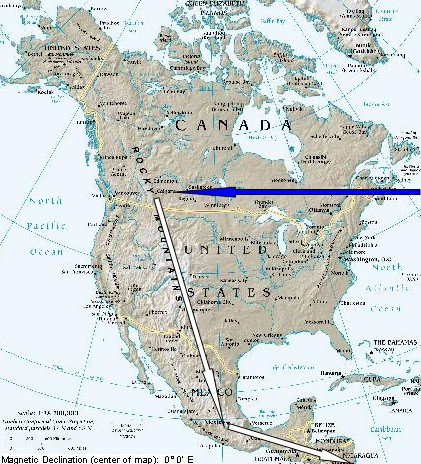
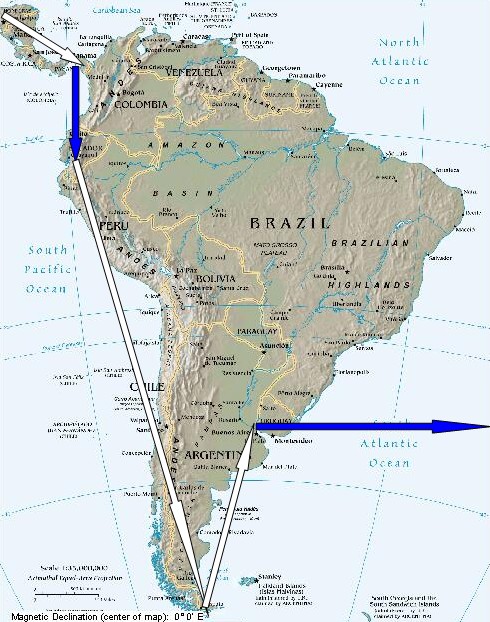
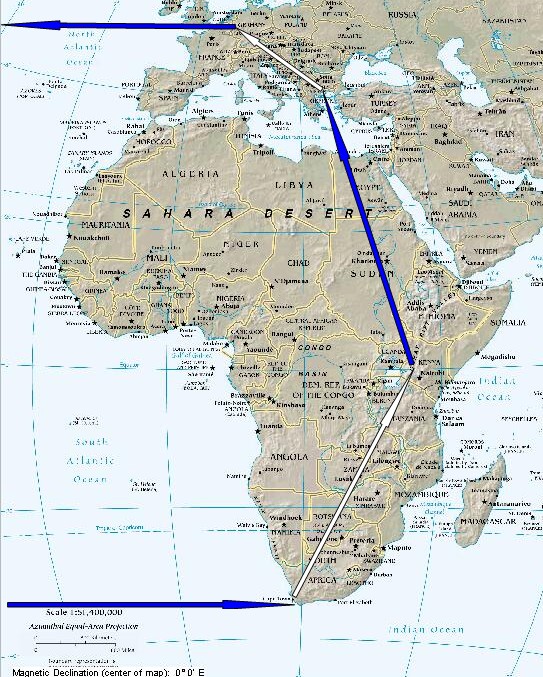
Home / Europe | 2002-2003
Europe | 2002-2003
How did we get the idea to do this trip?In 1998 we went attended the BMWMOA National Rally held in Missoula, Montana. At this rally, attended by about 4,000 BMW motorcycle enthusiasts, a number of seminars were put on; everything from how to do an oil change on your bike to how to travel around the world. We attended two excellent seminars that got us thinking. The first was by Helge Peterson, a photographer from Norway, who travelled around the world on his BMW R80G/S for 10 years and presented a wonderful, multi-media slide show. The pictures were amazing and the stories even better. Ekke ended up buying his book, Ten Years on Two Wheels. The second seminar was put on by Susan and Grant Johnson of Victoria, B.C. who also had travelled around the world but two-up on a BMW R80G/S. While their presentation wasn’t quite as slick as Helge’s it certainly got us thinking.
Back Home
With visions of world travel dancing in our heads we dreamed of perhaps doing it ourselves one day. However, both Helge and the Johnsons had made an incredible commitment by selling everything they owned to finance their trips and then work abroad while on their journeys. We didn’t think that we could make a commitment like that since we both had jobs that we really enjoyed and lived in a beautiful home just west of Calgary, Alberta. It sure is nice to have the security of a pension plan!
Possibilities
Later that year we both found that our respective employers, the Calgary Board of Education for Audrey and the City of Calgary for Ekke, offered a self-funded leave of absence plan. With the plan the employer deducts a certain amount from your salary before taxes and puts it into a trust account. Then during your leave you are paid out from the trust account and you have a job waiting for you when you get back. Plus you can buy back your pension. All of a sudden we had the opportunity to indulge in our dream trip without making the incredible sacrifices that the others had made. We could even rent out our house to cover the cost of the mortgage and not lose any equity while we travelled.
Where to?
While a trip around the world would sure be exciting it did sound a little daunting. To dip our toes into the exciting world of motorcycle world travel we decided to go somewhere reasonably civilised; Europe. There are so many things to see and do in Europe that we knew that we could easily fill a year of adventure. Europe is also close to Africa and Asia if we need more adventure.
Favourite Links
www.horizonsunlimited.com Grant and Susan Johnson’s invaluable resource for world motorcycle travellers
www.globeriders.com Helge Peterson’s home page
www.ultimatejourney.com Chris and Erin Rattay were inspired at the same BMW rally as us but have taken the big leap into world travel
www.bmwmoa.org The home page for the BMW Motorcycle Owners of America club
Contact Information
Please write! We would love to hear from you. No guarantees when we’ll be able to respond but we hope to make it to an internet café on a regular basis.
Ekke61@Hotmail.com for Ekke
ATAllenspach@Hotmail.com for Audrey (no longer active)
Who Are We?
Audrey is a teacher in the Calgary public board of education and before the leave of absence was teaching a grade 2/3 split. She has been teaching for about twelve years. Ekke has been a transportation engineer with the City of Calgary for about twelve years, working in the Development Section of Transportation Planning before the leave of absence.
The Motorcycles
Ekke’s bike is a 1989 BMW R100GS

Audrey on her bike, a 1999 BMW F650ST

Chapter 1: Arrival in Europe
The last couple of weeks were very hectic, finishing off work on June 28 and having the house rented out with people moving in on June 29. Then a week of final preparations including getting the International Driving Permit and the necessary vaccinations capped off by our flight out at Midnight on Saturday, July 6.Thursday, July 4 we dropped the motorcycles off for shipment at Air Canada Cargo at the Calgary International Airport. Basically it was a matter of riding them into the warehouse and then having the Dangerous Goods specialist check them over. The gas tanks were less than one quarter full and batteries disconnected. We left the bikes there to be loaded into a container and then they would catch the Saturday evening flight to Frankfurt.
Audrey watches as Erwin Arnold prepares her bike for shipment on Air Canada Cargo.

Friday, July 5 Rob and Laura Billington from Regina dropped by with their sidecar outfit. The rear tire was pretty well bald so we jacked up the Honda Goldwing and went to Anderwerks for a new tire. While there Ekke recognised a motorcycle out back and found out that Susan and Grant Johnson were getting some service done on their bike. Susan and Grant are the ones to blame for our year leave of absence. At the BMW MOA National rally held in Missoula in 1998, Susan and Grant gave a seminar on their trip around the world. It was nice to meet them again and make them aware of the consequences of their seminar. They were off to the BMW MOA National Rally in Trenton, Ontario, probably to infect others.
Saturday, was the day that capped off one of the busiest two weeks either of us has ever had. A send off supper was held amidst our final packing and after the SAAB was put into storage. The Air Transat flight left about half an hour early (!) and three movies later we arrived in Frankfurt. Note for tall fellow travellers; legroom is a precious commodity and it would be worth the money to upgrade to the first class section ($150) or try to get an emergency exit seat ($15 advance booking). This must be done very early as we tried to do this when we booked the flight several months in advance but everything was already taken.
Arriving in Germany, love the Smart cars on the trailer!

We had reserved a hotel in Frankfurt for two nights so that we could have a base to store our stuff before we could pick up the motorcycles on July 8. The Ibis hotel is located a four minute walk from the Hauptbahnhoff but it was a long walk carrying 30 kilograms of stuff in 27 C heat. Neither of us was used to the humidity so it was quite an exertion. After getting settled we went for a walk around downtown Frankfurt on a Sunday evening. We settled in at the Helium café for a light supper and some people watching. Frankfurt appears to be quite wealthy judging by the Porsches and Mercedes driving by.
A nice walk of about seven kilometres led to a BMW motorcycle dealership where a speedometer was waiting for Ekke’s bike. The old odometer had broken this Spring and based on recommendations from the BMW Tech mailing list was sent to Overseas Speedometer in May. Rick Borth estimated a three to four week turnaround time, leaving plenty of time to get the unit back from Austin, Texas before the bikes were shipped to Frankfurt. After four weeks Rick was called and he indicated that he had not started the work yet but would get to it in a couple of weeks. When told that the bikes were being shipped out in a little over two weeks he said he would start it right away. With a few days before the bikes were scheduled to be shipped the speedometer had still not arrived. Rick indicated he had not started it yet and of course now there would be no time to repair it and ship it back to Canada. So a friend in Germany offered to purchase a new speedometer and have it delivered to the Frankfurt BMW dealer. Hence the pleasant walk along the river Main on Monday morning. From there a combination of trains and trams took us to the ADAC (German Autoclub) office to purchase European motorcycle insurance. Back on the train and to the airport to find our bikes at Air Canada Cargo. A simple matter of showing the Customs agent the shipping forms and the insurance cleared our bikes. Back to Air Canada and there were our bikes in a container. Another BMW was sitting on a pallet with a California licence plate. Maybe we’ll meet them on the road somewhere! Since the cargo area is secure we had to clear a gate to get out of the terminal area. Our first ride in Germany included a section of sidewalk to get around the gate! Fuelling the bikes, which were on reserve, was quite a shock. Both bikes came to a total of about 40 Euro. That’s about $60 CDN. Perhaps we’ll be taking the quiet back lanes to keep the speeds down and the fuel economy up!
Uncrating the bikes at the airport

Hotel in Frankfurt

Tuesday, was our first real ride as we went from Frankfurt to Wartenberg, near Munich, a distance of around 400 km. This was done almost completely on the autobahn with only the last few kilometres on the little tiny backroads. Ekke had programmed Audrey’s sister’s house into the GPS back in Canada and it was off by only 10 metres. The 400 km was certainly not like riding back home where you can basically snooze on the highway. Here it was 100% attention at all times watching for trucks and campers going slowly ahead and the big Mercedes and BMWs coming up from behind at warp speed.
A stack of Smart cars

The Gruber's house

A family photo

Map of the route from Frankfurt to the Gruber's house

Chapter 2: Festivals and Getting on the Road
MapAfter arriving at the Gruber’s home we spent a couple of days getting organised. It was our first experience trying to get the laptop computer connected to the internet. Since the Gruber’s computer is a MacIntosh we could not copy files via floppy disks and since their phone line is digital we could not connect the laptop’s modem directly either. Eventually we went to a home with an analogue phone line and uploaded what little we had for the web site.
Saturday, 13 July, a barbeque was organised by the SPD political party that Michael belongs to. Fortunately the ideals of the party matched our political ideas so we did not feel too guilty enjoying the party. What incredible kuchen! Even the rain did not dampen the spirits and a good time was had by all. Sunday was an extra special event. The local villages and towns had a trockenfest (spelling?) where people dressed in their period clothing and had a judging and parade. This was strictly a festival put on by the locals for the locals. There were about 5,700 people participating in the event and I think we were the only tourists in the town of Dorfen that day. After the parade we went to Markus and Martine’s home for kuchen and kaffee.
Michael at the trockenfest in Dorfen

We had decided that a cell phone would be a good thing to have in case of an emergency or even to make local phone calls for reservations and such. Even if we got separated then the one without the phone could go to a pay phone and call the cell phone. So Monday was spent searching out a phone (or Handy as they are called here). The phone would be in stock the next day so we stayed another night with the Gruber’s and enjoyed their hospitality. Tuesday we picked up the Handy in Munich and then headed southeast in the direction of Hallstatt in Austria. Well, distances in Europe are definitely longer compared to Canada. We didn’t make it to Hallstatt but into southern Bavaria to Berchtesgaden, where we camped at Campingpalz Muhlleiten near the Konigssee. The next day we walked into Berchtesgaden and then to the Salzbergwerks salt mine. What an interesting tour. First we had to dress in miner’s clothes, a heavy cotton shirt and pants that went over our street clothes as well as a little leather apron. We took a train into the heart of the mountain and then a wooden slide (just two smooth rails) further down. It even included a ride on a boat across a brine pond deep underground. Fortunately the tour also included some English translations of the tour guide’s talk.
Thursday, 18 July, we broke camp and headed south to Zell am See in Austria. The route leaving Konigssee took an old pass road not much wider than a car and had almost no traffic on it. This was the kind of riding we were here to do. Connecting up with the main road south got us back into the traffic and also a few spells of rain. The crossing into Austria was a non-event and Ekke had to do a U-turn to find a welcome to Austria sign to take a picture. Seecamp was a beautiful campground on the lake but the ground was very hard. For some reason we did not pack a hammer (we brought everything else though!) and a fellow camper brought one over for us to borrow. We must look like we brought everything because while we were camped there everyone came to us and asked if we had a hammer they could borrow.
From the campground at Zell am See

Finally, the first real ride in the Alps. We rode to the Grossglockner pass on Friday and it was spectacular, tight twisting roads, cobblestones and even jig-jags. At the high altitudes the bikes ran a little rough but still had enough power to blitz past cars. The drivers actually expect you to pass on a motorcycle and will move over a little. Soon we were passing in places that we would never have dreamed of back home. Then just for a little exercise we hiked down to the glacier at Franz-Joseph Hohe and back up again. Good thing we had fortified ourselves with a hearty lunch at the restaurant first.
At the top of Edelweiss Spitz

Audrey riding down from the Eidelweiss Spitz

A hairpin on cobblestone road on the Grossglockner Pass

Our next base of operations was at Innsbruck. We went over the Gerlos Pass to get there from Zell am See. The campground at Kranebitten (just west of Innsbruck) was quite nice and we picked out a nice shady spot. The restaurant at the campground had an internet computer set up but they would not let us use a floppy disk to transfer stuff from the laptop and the internet software they had did not allow us to access our bank accounts either.
We enjoyed a nice walk through the city of Innsbruck and had the pleasure of watching and listening to a concert played under the Golden Roof while we were up in the Rathaus tower. One of the services provided by the tourism bureau of Innsbruck is a free guided hike. So one day we met the bus in downtown Innsbruck and rode up to the site of the 1964 and 1976 Olympic downhill skiing events. The guide led us over a small pass to a lovely café and then down to a little town on the other side where the bus came to pick us up. A great hike, except that the guide lost half the group (our half) when he took a shortcut with the other half. Our half waited for a half an hour for the slowpokes but they never showed up. So eventually we started hiking on our own and fortunately ended up in the village where the guide was waiting.
Musicians under the Golden Roof

On the hike before the guide left us

From Wartenberg to Innsbruck

Chapter 3: Italia, Sud Tirol
On Wednesday, 24 July we headed south to Italy over the Brennerpass. The autobahn is a toll highway and it would take just a few minutes to get to Bolzano in Italy (well maybe an hour and a half) but we took the old highway with its curves and twists, and of course it’s free! We got a great view of the Europa Bridge from underneath. We rode around Bolzano in the heat for a while looking for a campground without any luck. So we headed into the hills and ended up at Sarnonico and the La Baita campground, which surprisingly was even nicer than the one we left in Innsbruck. We planned to stay a night or two since at 26 Euros it was a bit expensive ($36 Canadian) but we ended up staying a week and making some day trips from Sarnonico.Europa Bridge leading to the Brenner Pass

La Baita Campground in Sarnonico, Italy

Our first day trip started north over the Gampenjoch and looped back south towards Revo. Halfway to Revo we stopped behind a line of trucks but the police officer at the front waved us on. They had stopped traffic for a bicycle race but must have decided that we were OK on the motorcycles. What fun and probably the only bicycle race we’ve come close to winning! Those bikes are tough to see in the unlit tunnels though. Turning off from the bicycle race we ended up on a one lane pass with almost no traffic on it and stopped for lunch beside a mountain stream. Further south we looped around on Passo Campo Carlo Magno back to camp.
Lunch at a quiet spot

Ekke took a day trip by himself into the Dolomites and did nothing but ride, catching about half a dozen passes. The goal of the trip was just at the southern point of the Dolomites, about 90 kilometres north of Venice, where the road came down from the Passo di San Boldo with hairpins put inside tunnels. The road was so narrow that traffic signals allow one-way traffic up and then down the pass. Pretty audacious. A ride back through wine country ended up back at camp at about 1800. A 10.5 hour ride and only about 470 kilometres with no lunch break. An average speed of less than 50 kilometres per hour doesn’t seem like much to brag about but it sure was hard riding, with all those twists and turns. An interesting thing happened on the way back. Riding along there was a rather scantily clad young lady standing beside the road, near a vineyard. Ekke thought, “She’ll have no trouble catching a ride.” A couple of kilometres later was another young lady. Hmmm, what a coincidence seeing two attractive young female hitchhikers. Getting directions from an apple orchard farmer it turns out that they’re prostitutes.
After a nice quiet Saturday at camp we went for a daytrip to Lago di Garda. The Hotel Paridiso is perched on the edge of a cliff about 300 metres above the lake with a deck cantilevered out into space. What a spectacular view and the sundaes were great too! An attempt to ride Passo di Tremalzo didn’t go through as the road has been closed to motorcycles. This pass has been used to test the GS model BMWs so it was probably a good thing that it was closed. Ekke rode to Passo Nota though before a mountain biker said that the road was closed to motorcycles from there on. On the ride back we found that self serve gas stations don’t accept our Canadian credit cards and without an attendant on duty we couldn’t get gas. A nice slow ride to find a full serve station that was open got us some gas.
At the top of Passo di Rolle

Stacked switchbacks

Monday was a ride deep into the Dolomites towards Cortina where a number of passes are nicely arranged in a figure eight. By the time we got there though it was getting late in the day and we only did half of the figure eight. The Sella pass has some sheer cliffs that are apparently quite famous for climbers. Again a bicycle race took place on the road so we pulled over and had a nice lunch while watching the bikes whiz by downhill. With all the switchbacks our hands became quite tired going downhill using the brake and clutch so much. About then the starter motor quit on Ekke’s bike and it had to be push started a couple of times to get back to camp. A friend in Germany, Peter Aufderheide, who also helped with getting the speedometer for Ekke’s bike at the beginning of the trip, came into action again. He knew the dealership in Bolzano, only 34 kilometres away from Sarnonico. He also had a great tip: the showroom and service area are separate so don’t shut off the motor when you get to the shop. Sure enough, we were at the showroom and were given directions to the service centre, three kilometres away. In the Italian sunshine it wouldn’t be much fun push starting a 230 kilogram motorcycle so Ekke was happy that he had left the motor running. The foreman at the service shop said that they couldn’t do anything because he had a mechanic on vacation and they were very busy. Finally the service manager suggested we go to a café for a half an hour and he would see if he could find the problem. A nice cappuccino later they had found the problem with a failed relay and for 52 Euros we were on our way, on our way to Merano for a little sightseeing in the afternoon. What a beautiful small city with a commanding view of the valleys that converge there. A climb up the Pulverturm (for free!) was quite rewarding. Wednesday was a quiet day (we’re getting used to these quiet days!) in preparation for picking up camp and heading towards St. Moritz.
Innsbruck to Sarnonico and area of day rides

Chapter 4: St. Moritz and Andermatt
Leaving La Baita campground was difficult since it was such a beautiful spot. Excellent laundry facilities, clean bathrooms and a swimming pool were all instrumental in making the campground very comfortable. It was nice to stay in a spot for a week and get to know the surroundings and some of the local shopkeepers. But, there were more roads to explore in the Alps so we headed for St. Moritz in Switzerland on Thursday, August 1.The ride through the orchards of Val di Non was beautiful to Passo del Tonale where we stopped for a cappuccino. For some reason the road signs had been pointing to this pass for about 60 kilometres but it wasn’t very spectacular. Perhaps it is more of a ski resort as there were a lot of ugly, modern apartment buildings that might be used as vacation condos. A few nice glaciers made the ride more pleasant. A ruin of an ancient fort would have been nice to stop at and investigate but it was not well signed and parking was just at the side of the road. We’ll have to come back for that!
We were really made to feel welcome in Switzerland with the flags flying and the fireworks celebrating Swiss National Day on August 1. Arriving in the afternoon at St. Moritz we headed for the Olympiaschantz campground, situated near the ski jumping facility from the Olympics. Walking into town to do the grocery shopping we found the stores closed for the holiday so we looked for an affordable restaurant. In St. Moritz? Not a chance. We got off fairly well paying about 35 Swiss Francs (about $34) for couple of personal pizzas and a couple of drinks at a little pizza joint. At this time it started to rain really heavily so we got a little wet on the walk back to camp but we were worried about the tent. We need not have worried though as everything was still nice and dry inside and under the awning.
Friday, Ekke rode the Maloja Pass, the Splugen Pass and the Albula Pass roads in a 180 kilometre loop. The switchbacks on the Splugen Pass on the Italian side were so tight that there really was no inside radius; they just came to a point. A few snowsheds and tunnels, with some switchbacks inside the tunnels, led to the top of a windswept pass. The houses were really sturdy with slate roofs. The roads on the Swiss side were in much better condition but the switchbacks were layered five or six deep at times. The Albula Pass was very rough pavement, which was quite a surprise since all the Swiss roads had been excellent up to this point. The railroad trestles for the Glacier Express train were quite impressive.
3 August we headed for the famous Stelvio Pass, first back south over the Bernina Pass and then after the pass, left into Italy and the Val di Livigno. Two more passes led to Bormio from where we could tackle the Stelvio. The ascent out of Bormio was fairly gradual at first but after we enjoyed a picnic lunch the climb steepened with an increasing number of switchbacks. A cappuccino at the top (2757 metres) was followed by a steep descent with 44 switchbacks. Our hands were tired from using the clutch and brake levers coming down that hill. It was so steep that a bicyclist kept up with us going down the hill (and looked like he was going to pass a couple of times). Returning to St. Moritz we went through a Swiss National Forest where there was finally a place without a house perched on every piece of land, very refreshing.
Cappucino at the top of Stelvio Pass

Sunday morning we had a leisurely breakfast of French Toast (would they just call it toast in France?), fried eggs, yoghurt, orange juice and coffee/tea. Being suitable fortified we went for a hike. From St. Moritz we hiked via the Heidi Hutte (the one used for the 1977 movie) to the midway station of the cogwheel train where we caught the train up to Corviglia, at an elevation of about 2500 metres. Because of the FIS World Cup ski championships being held on the hill in 2003 there was a lot of work going on and we could not hike to the top of Piz Nair. Instead, we went to Suvretta Pass and then back down to St. Moritz with an elevation drop of about 900 metres.
Hiking to Suvretta Pass

A peaceful moment before they started chasing us

Packing up the next day, we went to Andermatt via the Julier Pass, Lenzerheide and the Oberalppass. The Oberalppass had some excellent sweeping corners with switchbacks dropping right down into Andermatt. We were not sure if there was a campground in Andermatt but we found one under the Gemsstock cable car. The tenting area was on the other side of the road leading out of town so we had to cross the road to use the showers but it was a nice spot and reasonably priced (about 10 Francs less than St. Moritz). With rain and fog the next day we decided to spend a quiet day in Andermatt so on Wednesday we rode some passes. Since it was still foggy and spitting rain we decided to ride passes that were not as well known for their scenery; Gotthard, Nufenen and back on the Furka pass. The Rhone Glacier was shrouded in fog so we did not pay to go into the Glacier.
Camp at Andermatt

Thursday we rode what must be the most spectacular loop we have ever ridden, it was only about 110 kilometres over the Furka, Grimsel and Susten passes but it took all day. Going over the Furka pass we went the other direction from the day before to the Rhone Glacier (headwaters of the Rhone river which empties into the Mediterranean). For 5 Francs we could then go inside the glacier. What an experience to be inside that blue cave. We were glad that we had kept our waterproof motorcycle clothing on as it was rather chilly with ice water dripping from the ceiling. Going up the Grimsel pass we were passed by a bright yellow Buell motorcycle, which gathered quite a crowd at the top of the pass with everyone checking out the exotic machine, even the people from a tour bus checked it out. From the top of the Grimsel a one-way road (controlled by a stop light) led to a glacier 7 kilometres up the mountain. Those little stone blocks on the side of the road probably would not help much if you lost control and skidded off the road. It was about 300 metres straight down to Grimselsee. The Susten Pass road was another spectacular ride leading up to the pass surrounded by glaciers. By the time we started the descent we were on sensory overload so we took it easy down and then back up the Schollenen gorge to Andermatt. We will need to do that loop again just because it was so spectacular and because of the overload we must have missed some things. Maybe one loop for riding and then again for enjoying the scenery?
Descending the Gotthard Pass on the old road, watch the dropoff!

Furka pass on the left and the Grimsel pass on the right

Inside the Rhone Glacier

Oberaarsee road

Susten Pass

Sarnonico to St. Moritz to Andermatt

Chapter 5: Lucern and Interlaken
On 9 August a short ride from Andermatt north got us to Camp Lido in Lucerne where we arrived at the same time as Michael and Andrew Gruber who were on vacation. They drove straight from their home northeast of Munich. Unfortunately the weather had not improved and it rained for a couple of days straight. There were reports of extensive flooding throughout Europe. With the terrible weather we decided to do an indoor activity. Next door to the campground is the Verkehrshaus, a communication and transportation museum. With Ekke being a transportation engineer it was pretty obvious that we had to go there! Blue Planet was showing at the IMAX and none of us had seen it so we toured the museum a little and then went to see the show, where they were kind enough to hand out handheld speakers with an English translation. The communication area had a lot of wonderful hands-on activities, everything from Morse code demonstrations to a TV studio. Three other sections focussed on automobiles and motorcycles, aircraft and trains. The place was large enough to require two days to thoroughly explore all of its contents.The next day the weather had still not improved, with continuous rain over the night, so it made sense to go swimming. The Switzerland Holiday Park provided an indoor pool and spa to entertain ourselves along with a waterslide and outdoor pool. We all came out of that nice and clean and of course a nice rinse in the rain afterwards. By the next day it still had not cleared up but the rain had petered out. We decided to go to the top of Pilatus, a mountain peak south of Lucerne that can be reached by cogwheel train (the steepest cogwheel train in the world at 48%) or via gondola and cable car. In our 1996 visit Ekke could not get himself down the cable car from the top because of his fear of heights so we worked out a plan that would see Ekke not using the cable car. At the top of the gondola there was a rodelbahn (basically a slide down the mountain on a sled) that looked like a lot of fun but because of the rain it was closed. So with a little cajoling Ekke was encouraged to ride the cable car up to Pilatus. It was frightening but Ekke just imagined that the swaying cable car was riding a metre above a nice grassy field and did not open his eyes. Unfortunately, Pilatus was stuck in the clouds and so the views were not very good. So Michael and Andrew headed down the cogwheel train while Audrey and Ekke stayed up in the clouds a little longer. The clouds parted a little to reveal an amazing view of the Vierwaldstattersee (so named because of the four forest cantons on the lake) but Michael and Andrew were enjoying delicious ice cream sundaes down below in compensation.
Michael and Andrew packed up on Tuesday morning and we toured the city of Lucerne. The lion monument honours the Swiss who fought in the French revolution and appears much larger in person than the photos show it to be. The medieval city wall still stands and we toured the wall and three of the towers on the wall. One of the towers had a clock in it and it was interesting to climb the stairs beside the moving clock mechanisms with the large swinging pendulum stopping only millimetres from the railing. The final tower provided a fine open-air view of the city where we could see that the Reuss river was very high from the recent rains. When we walked down to the Spreuerbrucke there were a couple of kayakers and a surfer playing in the fast flowing water on a standing wave.
Kappellbrucke in Lucern

Spreuerbrucke from the watch tower

On 14 August, in beautiful sunshine, we also packed up from Camp Lido and headed south over the Brunig Pass to Interlaken, which is situated between the Thunersee and Briensersee. We had done the Brunig pass in the other direction on our 1996 bicycle trip and it was much easier on the motorcycles. After a bit of riding around Interlaken we found Jungfrau Camp and unlike our last trip we had a spectacular view of the Eiger, Monch and Jungfrau mountains from our tent. That evening a fellow motorcyclist, riding a BMW F650GS Dakar, camped beside us. He was from Newcastle in England so it was nice to speak English with a stranger! It turns out that David was planning to head to Greece so we made rough plans to meet again there. The next day David went on a mission into Interlaken to find the exact spot that a photo from his parent’s honeymoon had been taken (he was successful and found a postcard from the same spot). We walked around Interlaken watching the paragliders. That evening we attended an open-air William Tell theatre show. The show was excellent but we were glad that we had picked up a summary of the play that happened to have a short description of each scene in English. It was the story of how the three cantons joined together and stood up to their Austrian dictators. Especially impressive was the display of horsemanship as the actors rode through the set and William Tell’s marksmanship as he shot the apple off his son’s head.
View from the tent at Interlaken

On Friday David packed up and headed south and we secured our motorcycles and all of our gear at the campground. Then we took the train from Interlaken to Meiringen, arriving at about 12:30 to start our holiday within a holiday. We planned to hike from Meiringen to Adelboden in about a week, staying at mountain hotels along the way. The route was laid out to cross the Grosse Scheidegg into Grindelwald and then over the Kleine Scheidegg into the Lauterbrunnen valley. A beautiful 100 year old funicular took us up several hundred metres to the Reichenbach Falls where the fictional Sherlock Holmes met his demise. A short lunch break and then we started hiking towards the top of the Grosse Scheidegg. Five hours later we had gained 1120 metres and reached Berghotel Grosse Scheidegg. The walk was mostly in the forest and usually quite a gentle grade. Upon reaching the summit of the pass we were greeted by a wonderful view of the Eiger and Grindelwald in the valley. There was room in the massenlager (a dorm), which was fortunate since the berghotel was the only place to stay within an hour’s walk. After cleaning up we had a delicious supper and watched the finish of a bicycle race at the top of the pass. The restaurant was soon full of bicycle racers as they had their award ceremonies and enjoyed a drink.
The Eiger from Grosse Scheidegg

The next day, across the Grindelwald valley we could see the day’s destination; the Kleine Scheidegg. Breakfast is typically included in the price at berghotels so we ate enough to keep us going for a few hours. The breakfasts usually consisted of a choice of breads, cheeses, jams and then coffee and orange juice. Another bicycle race came down the pass as we walked to Grindelwald, dropping about 1 kilometre in elevation. Going up the Grosse Scheidegg and then down we were accompanied by the three-tone sound of the Post Bus horn as it honked whenever approaching a blind corner. The theory is that if you are driving and hear that horn you should get out of the way. No Post Bus went up the Kleine Scheidegg, so it was a little quieter. By 16:00 we had arrived at Berghaus Alpiglen, about 600 metres above Grindelwald and still a couple of hours from the summit of the Kleine Scheidegg so we took a break to assess the situation. The clear blue skies were great for enjoying the view of the north face of the Eiger while we hiked but it also meant we had a hot, tiring walk. So we used the Handy to phone the hotel at the top of the pass to inquire about room/massenlager availability and prices. It turned out that the rooms were all gone and the massenlager was 3 francs per person more than a room at Berghaus Alpiglen, so we stayed at the Berghaus. What a cozy room!
Walking into Grindelwald

View from our room at Alpiglen looking over Grindelwald towards the Grosse Scheidegg

Rather than walking 2 hours to the top of the Kleine Scheidegg before boarding the special train to the Jungfraujoch we took a train from Alpiglen. The time was better spent on top of the mountain, especially while the clear blue skies prevailed. Words cannot describe how spectacular the view from the top of the Sphinx was. Even the pictures don’t do it justice. It is amazing that someone built not only the structures in such a hostile place but that a train runs up to it. The train runs through the Eiger (stopping inside for a quick view out of the north face and also the glacier) and then through the Monch to the saddle between the Monch and Jungfrau. We walked over to the Monchjochhutte crossing the glacier on a well-travelled path. People were going on glacier walks, dog-sledding and skiing, while others were climbing the surrounding peaks. Despite the number of people it was very beautiful. Taking the train back down to the Kleine Scheidegg we started our daily hike at about 4 PM, down towards Wengen, a drop of about 800 metres. Thank goodness the Edelweiss hotel was too expensive; otherwise Audrey would have been singing the song from The Sound of Music all night long. So the Baren (bears) Hotel worked out perfectly. Wengen is perched on top of a cliff overlooking the Lauterbrunnen valley and the only access for visitors is by walking up or by train. The town is car-free. :( It turns out that Wengen was started as a ski resort by the British, rather than the Swiss. That must explain the reason for the large number of British people we saw.
Alpiglen as seen from the North Face of the Eiger

Eiger Glacier

Glacier walk to Monchjoch Hutte

At the top of Europe on the Sphinx

Looking down at the Lauterbrunnen valley from the Sphinx

Looking back at the Monch

The hike took us across the Lauterbrunnen valley the next day, but with its steep cliffs we decided to take the funicular up the other side, gaining over 700 metres in just a few minutes. Then it was an almost level walk to Murren and a 300 metre drop down to Gimmelwald of Rick Steves’ fame. Unfortunately, the quaint little village was overrun by people who had watched Rick’s show (we missed him by two weeks) and everyone was speaking American rather than German. Even though it was getting late, we decided to leave Gimmelwald and head up the mountain towards the Seffinenfurgge, a pass at an elevation of about 2600 metres. An hour brought us to Spielbodenalp, a rustic berghotel on a farm. No electricity and no running water. We were the only guests and were served a nice supper outside.
Descending from Wengen a nice view of the Staubbachfalls

View from Spielbodenalp

The next day started with a very steep climb above Spielbodenalp. The switchbacks up the trail were sometimes rather exposed with the drop into the Lauterbrunnen valley being several hundred metres. If you slipped, your clothes would be out of style by the time you hit bottom! Fortunately after the initial height gain of two or three hundred metres it was then a comfortably level stroll to the Rotstockehutte where we stopped for a coffee break. From there the trail steepened gradually until the summit of the Seffinenfurgge where the trail was very steep on loose talus slopes. Looking over the top was not very confidence-inspiring as cables and steps were attached to the mountain to aid in the descent. After a lunch break we tackled the other side and it was not as bad as it looked. The weather started getting worse and by the time we got to the next alp hut Audrey had her rain jacket on. The rain really started to come down while we were enjoying a refreshment and all of a sudden a roaring sound could be heard, like a jet airplane flying overhead. We all went outside to find that the burbling brook had turned into a raging, black torrent the same colour as the rock of the pass. As the trail crossed the creek at that point, we were trapped until the water subsided, about an hour. Quite an adventure! We finally made it down to Griesalp where we stayed at the Nature’s Friend Hostel. The owner prepared a delicious set menu of cream of tomato soup, calf steak with buttered noodles followed by a fruit salad for dessert. We had an entire dorm to ourselves but because the hostel was listing rather heavily down the slope we did not sleep all that well. In the morning the owner explained that when he had purchased the property the building was listing by 35 centimetres and he had levelled it quite a bit. Unfortunately the morning was foggy so we decided to curtail the hike since we had no desire to climb the next pass and not be able to see anything. Besides we had experienced a wide cross-section of Swiss hiking, from the crowded, touristy areas around the Jungfrau to the rustic Spielbodenalp. The steepest Post Bus route in Switzerland (28%) brought us down to the train station where we caught a train to Interlaken to end our holiday within a holiday. Strangely enough, we were both looking forward to sleeping in our own beds again, in the tent!
Hiking towards the Rotstocke Hutte

Andermatt to Luzern and Interlaken. Some hiking points shown as well.

Chapter 6: Big City Switzerland
22 August saw us making the short ride from Interlaken to Bern. We rode along the Thunersee and stopped off at BMW Motocenter Thun to see about a repair for Ekke's helmet. The faceshield would not stay up because a simple plastic piece on the helmet had broken. So the theory was that a simple replacement part could be purchased and installed. It turned out that the helmet liner needed to be cut to replace the piece and the shop was not willing to do that. They suggested going back to our dealer to have it done. That was not much of an option so their next suggestion was to go to the BMW distributor for Switzerland in Zurich and they could do it. In the meantime a British motorcyclist came by and overheard our plight. He indicated that he had done his own helmet with about two hours worth of fiddly work. Thun Motocenter did not have the parts in stock anyway so that would have to wait until Zurich.After a picnic lunch overlooking Bern we pulled into Camp Eichholz, adjacent to the Aare river. A walk along the river to Bern found many people floating down the Aare and then walking back upriver along the paved pathway to jump in again. Apparently on a truly hot day the river is jammed with swimmers. Later that evening a Japanese motorcyclist pulled in on a Honda XR400 piled to the rafters with stuff. He had shipped his bike to Russia and ridden across Siberia, with a side trip to Mongolia, then up to Nord Kapp in Norway and down through Europe. He too plans to be in Morocco in January so we exchanged e-mail addresses and hope to meet him there.
Hideki at Bern campground

A walking tour of Bern on Friday showed us the old city, with its many fountains. The parliament buildings were having a 100 year anniversary so there was a line of people waiting to get in. We decided to skip it. Up from the old city centre are the rose gardens where we walked to next. The gardens were beautiful with some of the beds dating back to the 1930s. The gardens were started in the seventeen hundreds. Back down the hill led us to the famous Bear Pit of Bern. This pit also dates back hundreds of years. The legend is that one of the founding fathers of Bern was on a hunt and killed a bear. The city has been named in honour of that event and the bear pit is some kind of tribute to this. To be honest, the sight of the bears begging for scraps of food from the tourists was rather sad, especially when we know how magnificent and frightening these creatures are back at home.
Berchtold Herzog von ze Ringen Fountain

The Bear Pit in Bern

Rose garden is a couple of hundred years old

The next morning prior to packing up Ekke decided to emulate the local custom and go for a dip in the Aare. While the waters were not too cold, the current was quite strong. Very invigorating! We rode to Wettingen, north of Zurich, to visit Audrey's relatives; Martha and her sons Stephan and Martin. Stephan phoned the Zurich BMW dealer recommended by Thun Motocenter but it turned out that they were a financial services centre and closed on Saturday anyway. So Ekke and Stephan jumped into Stephan's Smart car to take a quick look at the local BMW dealer. They closed at 1600 (with Ekke and Stephan arriving at 1640) but the shop owner was out back. He led them inside and sure enough had a repair kit in stock. All that was necessary to repair the helmet now was a special Torx screwdriver…
Martha took us to Baden, just north of Wettingen, to visit the famous baths on Sunday morning, very relaxing and probably especially nice after a cold, wet motorcycle ride. Fortunately, the weather was nice and we had a great tour of Baden, the town, in the afternoon with its ruined castle on a hilltop. Monday saw Martha taking us to Zurich for another tour, first stopping at Audrey's grandmother's grave. She was a wonderful tour guide, knowing all the interesting places to see and some of the stories surrounding the sights. After Martin met us for lunch at the train station we went up to the Lindenplatz which allowed us extensive views of the city, including Grossmunster Cathedral and the medieval town below. None of the interesting places had a Torx screwdriver in the right size though. The day finished with a relaxing boat tour of the Zurichsee.
With Martha on top of a ruined castle in Baden

Grossmunster Cathedral in Zurich

Taking a break from touring Zurich at the Schober cafe

Accompanied by a light rain we left on Tuesday morning for Chateau de Chillon, the famous castle on Lac Leman. We found that we were really heading into a different part of Switzerland, not only was the architecture changing again, but the language spoken at the café where we stopped for a piece of pie was completely French. The riding in the Jura region was also different from the other regions of Switzerland. We climbed through thick forests, and fog, on small back roads. One road was like climbing a cliff in the Alps with a grade of 22% and switchbacks and the next was in open meadows. We set up camp a couple of kilometres from the castle.
Chateau de Chillon

Courtyard of Chateau de Chillon

The next morning we toured the castle before the tour buses arrived and were glad that we did. Byron wrote a poem about the prisoner of Chillon who was chained in the dungeon for four years. The castle and its history were fascinating with displays of armour and descriptions of how the castle was constructed over the centuries. The castle occupied a strategic position along the lake leading to one of the passes over which trade flowed. That afternoon we visited another of Audrey's relatives; Susanne in Geneva. She took us out for a delicious meal at a local restaurant where the speciality was Mallakoffs which are essentially cheese pillows. Amazingly good. Then off to a concert in a park across town, an Acadian group! While it was nice to hear music from “home” we were probably closer to Acadia in Switzerland than in Calgary. The walk home at about 11 o'clock at night was interesting if only for the number of people out and about at that time of night in a city of such a small population. Susanne made an excellent tour guide of Geneva the next day (even finding the elusive Torx screwdriver) as she is very familiar with the city and has done a lot of travelling. Late in the afternoon we rode the short distance to Chamonix in France, famous as a ski resort. We must have become accustomed to the high prices in Switzerland because the prices seemed very reasonable here. The exception was the gasoline, where Switzerland and Austria have been the least expensive so far at about 85 to 90 Euro cents per litre (about $1.40 Canadian). France was at about 1.07 Euros per litre. We took a break from travelling and being a tourist for a couple of days in Chamonix. We did none of the gondolas or hikes in the area, rather we did the mundane things like laundry, getting caught up in our journals and repairing the helmet.
Jet d' eau comes out of the fountain at more than 200 km/h

Ramp used by horse messengers at the old city hall in Geneva

Interlaken to Zurich to Geneva and Chamonix

Chapter 7: France
The first day of September saw us leaving the peace and quiet of Chamonix and getting back to riding. We used this opportunity to catch a few passes that we had not ridden before. While the straight-line distance from Chamonix to Annecy is not much more than 50 kilometres we took a whole day and went over the St. Bernard passes (Grand and Petite). We left France for Switzerland over the Col des Montets and the Col de la Forclaz then into Italy over the Grand St. Bernard (famous for the dogs) and the Petite St. Bernard got us back into France. Then one of our favourite passes of the trip went over Cormet de Roselend. While it wasn't terribly high it was a small road with very little traffic and the curves were not too blind so that you could get a good speed up. Ekke was glad he had spent the money on the Ohlins shock because the road was quite rough. We arrived in Annecy fairly late and the campground was difficult to find. The main campground was closed and only the small area across the street was open. A little boy from the neighbouring camper came over with a drawing he had made of our Canadian flag while we were having our supper. The only reason that we were in Annecy at all was because Audrey had read a terrible spy novel that made Annecy sound really interesting so the next morning we walked into central Annecy to have a look. It truly was a beautiful old city. We had a pastry there for breakfast (Ekke had a raisin bun the size of a small pizza) and walked back to break up camp. By the time we got to Dijon that afternoon it was hot and the traffic was insane. This was our first experience with the French traffic circles in cities. Our first impression was not favourable! Eventually we found the campground and were greeted by the same woman who was operating the campground six years ago. She was still as surly but the campground was nicer than we remembered, probably because it wasn't as crowded as before. So far we have been to Dijon twice and each time it was not a great experience. Maybe we'll have to try a third time?We wanted to be within easy striking distance of Paris the next day so rode to Provins on the little French backroads we had been dreaming of. The best roads were the ones that were not on our map. We even managed to find the source of the river Seine. Arriving early enough at the campground allowed us to take a walking tour of the medieval city before supper. Provins is a UNESCO world heritage site for having one of the most complete medieval towns. So on Wednesday morning we prepared ourselves for the ride in to Paris. Ekke used the laptop to download the route to the Bois de Bologne campground in case the streets of Paris were as confusing to ride as they looked on the map. They were. We were glad that we could concentrate on riding in the traffic more than route finding because the traffic was incredible. The motorcyclists were especially amazing. As we were riding along the Boulevard de Peripheque at 100 kph, keeping up with the cars, motorcycles would come flying by at warp speed, slaloming between the cars. They were friendly motorcyclists, waving by sticking their foot out so that they would not have to take their hand off the throttle. After a couple of false turns from a traffic circle we ended up at the campground plus or minus 10 metres according to the GPS. There had been no signs for the campground so were glad to have had the GPS.
Medieval gate to Provins

We thought that we would walk to the Arc de Triomphe to catch a double-decker tour bus on Thursday morning. The walk was a bit more than we had planned, about an hour. We took the Les Cars Rouges bus down to Notre Dame and walked into the Latin Quarter for lunch. Ekke should know better but he doesn't. He ordered a steak and fries, just like six years ago, and sure enough the steak was thin and tough, just like six years ago. Mental note: Don't have steak in Paris. Rejoining the bus tour we rode to the Orsay Museum, known for its collection of Impressionist works. We purchased a three day museum pass at the Orsay and then went in to enjoy works by Monet, Manet and Toulouse LaTrec. We then rode Les Cars Rouges back up to Arc de Triomphe but just missed the special bus that goes directly to the campground. So, despite Lonely Planet recommending against walking through Bois de Bologne at night, we did not wait for the next bus but walked into the gathering darkness. As it got darker we walked faster until we were almost at a race-walking pace. The prostitute showing us her “wares” didn't help our nerves any. An hour later we made it back safely but wiser for it. The next morning we bought a pack of camping bus tickets so that we wouldn't have to do that walk again!
Welcome sight after a long walk

Orsay Museum a converted train station

Taking the bus in to the Metro station was much easier than walking six or seven kilometres. We then took the Metro to the Rodin museum to see such famous sculptures as The Thinker, Wall to Hell and Balzac. After having crepes for lunch we went to the Louvre for a couple of hours. We used a book by Rick Steves, Mona Winks, to guide ourselves to some of the highlights of the museum. It was nice to be able to look at just a few of the important pieces from more than 300,000 works of art and then understand why a particular piece was important. At 4 PM we went outside to meet Judy Yu who had come in to Paris a few days earlier. Her friend Chris guided us to the Luxembourg Gardens and then for a stroll through the Latin Quarter. We ended up near the university for supper where Ekke managed to resist the temptation to have steak and fries. A quick Metro ride up to see Moulin Rouge in Pigalle and then back to camp for us while Judy and Chris went on. After Paris they went to Nice to spend another week together.
The Thinker and The Walker

Venus de Milo at the Louvre

High stepping dancers at Moulin Rouge

Saturday had us climbing the stairs up the Notre Dame tower and then after lunch on the windy terrace of the Samaritaine back to the Louvre. This time we took our time to look at individual works rather than seeing as much as possible. Still we managed to see a lot; from Roman artifacts to Napoleon III's apartments. The museum card allowed us entry to the top of the Arc de Triomphe so we climbed those stairs before heading back to camp. It was fascinating to watch the traffic from the top, while the initial impression was chaos, especially when the traffic police shut down Champs Elysees, it all seemed to work with a minimum of fuss. It even worked when a horse drawn wedding carriage went through! A Ferrari F40 was the last piece of art we saw that day. Sunday we enjoyed the area around Sacre Coeur having a great lunch outside a café on a square. The square had artists selling their paintings and crowds of people watching them paint. We ended up at the Seine under the Eiffel Tower after walking along Rue Claire and the Champs de Mars. Here we took a tour boat for a one and a half hour ride up and down the river.
Gargoyle on top of Notre Dame cathedral

The crowning of Napoleon

Napoleon III's apartments


A SAAB convertible in the traffic circle around Arc de Triomphe

With a stiff wind blowing and spotty rain we rode out of Paris in the direction of the Normandy D-Day beaches. The weather was making the riding miserable and when we stopped to have a coffee break at the Comfort Inn we decided to stay in their warm, comfortable room and hope that the weather would improve for the next day. Sure enough, the following morning was sunny and the trees were not being blown around so the ride to Arromanches was very nice. Since we were there at a good time we went into Bayeux to look at the famous tapestry from the eleventh century. The tapestry depicts William the Conqueror going over to England and the battle of Hastings in 1066. Wednesday we had to get caught up with laundry and do some minor motorcycle maintenance. Late in the afternoon we went to a 360 degree cinema to see the battle on D-Day. From there we rode up to Juno Beach where the Canadians landed on June 6, 1944. The Canadian monument that will be built there looks like it will be beautiful judging from the artist’s rendering. At sunset we headed inland to the Canadian war cemetery with over 2,000 graves. It is so difficult for our generation to understand the horrors of war but we found that this beautifully kept cemetery in the French countryside at sunset was very moving.
At the Canadian War Cemetery

Taking the back roads we rode to Le Mont St Michel, an abbey and accompanying town built on a rock in the middle of a tidal flood plain. A two kilometre walk from the campground took us out along an “unfloodable” causeway to le Mont St. Michel. The parking lots are in the floodplain with signs indicating when high tide will make it difficult to get to your car. After a tour of the abbey and layers of churches, from thousand year old romanesque to more modern gothic we headed down into the town. The town was built up to cater to pilgrims coming to the church and was now doing a thriving trade catering to the tourist pilgrims. La Mere Poulard is famous for its omelets where you can see the cooks whisking the eggs and then cooking the omelets over a wood fire. Since they were the only establishment open at supper time, all the other restaurants had not opened yet, we went in despite the rather steep prices. To be honest it was a real disappointment to have a small omelet for 25 Euros. OK, so Margaret Thatcher and Allan Shepard ate there and had their pictures on the walls with dozens of other celebrities, forty bucks is a lot of money for an omelet! We then ran to the restaurant near the campground to have something to eat!
Le Mont St Michel

On the advice of Dave, whom we had met in Interlaken, we went to St. Malo for a day trip on Friday. Taking the small road along the ocean was a treat. St. Malo was seriously damaged in World War II and had been rebuilt in the style of the 17th and 18th centuries. We walked along the original ramparts and found a statue of Jacques Cartier dedicated by Pierre Elliot Trudeau. With the wonderful weather we walked down to the beautiful beach and then across a causeway to an adjacent island. It was running a little late to make it back to camp so we stayed in town and had a Gallete (savoury crepe) for supper. The Biniou Crepe Flambee with Calvados was especially good.
St. Malo on the French seaside

The ride on Saturday the 14th from Le Mont St. Michel to Blois in the Loire Valley was uninspiring. In Le Mans everyone was driving as if they were at...Le Mans! Overall the scenery was mostly flat and forested. The next day Ekke went for a short ride up and down the Loire Valley and Audrey took her bike chateaux hopping: Chateau Blois with four different architectural styles, beautifully furnished Chateau Cheverny, the fairytale turrets of Chateau Chenonceau and the famous Chateau de Chambord with its double helix staircase designed by Leonardo Di Vinci.
Chateau de Chambord

With the Intermot motorcycle show starting on Wednesday it was time to start riding east to Munich. Monday we rode from Blois to Montigny-le-Roi and Tuesday to Colmar, just on the west side of the Rhine separating France and Germany. An evening stroll around Colmar with its Alsatian architecture was beautiful but we were too late to go to the Unterlinden Museum and see the Issenheim Altarpiece. According to Lonely Planet it is “one of the most moving works of art ever created.” Oh well, maybe next time. Wednesday we crossed the Rhine into Germany and rode to Wartenberg.
Petit Venice in Colmar

Our route through France

Chapter 8: Intermot and Oktoberfest
We were warmly greeted when we arrived at the Grubers on Wednesday the 18th of October after a day of cruising the autobahns and then skirting Munich by using the backroads to get to Wartenberg. We wanted to attend the motorcycle show, Intermot, on a weekday in order to minimise the crowds so we left Wartenberg to get to the Messe at a fairly early hour on Thursday. The Messe is the old Munich airport converted to a convention facility. The motorcycle show took up twelve halls, each hall about the size of the Roundup Centre, and an outdoor area which had demo rides and a race track. We went straight to the BMW area in Hall B3 and got a look at a couple of new bikes, the R1200CL and the K1200GT. The CL is as hideous in real as it is in pictures while the GT is an RS with some touring appointments such as the saddlebags and comfort seat in addition to an electric windshield. We then checked out some of the accessory manufacturers such as Touratech and Wunderlich but were disappointed to find that they did not have anything there to sell. Rather the show is more of a trade show and you could contact the vendors at their regular offices to purchase merchandise. BMW had a fashion show at the top of the hour and it was quite a lot of fun with some rap artists singing in English. Outside at the racetrack a stunt show was held with various wheelies and stoppies being performed in front of an enthralled audience. The commentator also rode the bikes and would make comments while performing some amazing stunts on a Buell, fortunately for us he was British and we could understand the commentary.K1200GT

R1150R design study

R1200CL

Gee, I look good!

C1 scooter with sidecar

An airbag jacket


Wild stunt show

The German autoclub ,ADAC, had a Bikercup where you could borrow some gear (helmet, jacket, gloves) and then ride a BMW F650CS around a course to win a prize for the highest points of the day and an F650CS for highest points over the course of the show. Ekke thought he could do that since it looked pretty easy from the sidelines. After standing in various lines for an hour to give up the driver’s licence and then get the gear Ekke found that a written test was first required. In German. On German road rules. Hmmm, maybe this won’t be so easy! With the help of one of the ADAC personnel who could speak English, Ekke completed the written portion and headed out on the bike to weave through the cones and such. It turns out that the course is laid out in soft, deep gravel and was much more difficult than it looked. Needless to say, we did not receive a phone call to tell us to come pick up our prize. On the way home in the rain we stopped off at Karl Maier BMW and dropped Audrey’s bike off for new tires and made an appointment for the scheduled service on Ekke’s bike for Monday morning. Again we had excellent service as the shop closed at 1800 and we showed up at 1830 and they were more than happy to accommodate us.
Tuesday afternoon we went with Andrew to Oktoberfest, or as the locals call it, the Wiesn. We planned to meet Michael and Helena later to go to the beer tents. The area covered by the Wiesn was quite tremendous with large beer tents set up and every ride imaginable from giant roller coasters to haunted houses. It was raining pretty steadily by the time we got there but we were up for some fun and played some games and went on a few rides. The bumper cars were the best because they were under a roof and therefore dry. One ride had Andrew sitting in the rain for at least 10 minutes before the ride operator decided that he had waited long enough for other people to get on the ride and fired the ride up. We were all pretty much soaked so decided to call off our meeting with Michael and Helena and head home instead.
Helge Peterson's bike at the BMW museum in Munich

We gave the Wiesn another chance on Friday afternoon when Helena had the time off and after we did some shopping in downtown Munich. This time we were better prepared with everything from rain pants to Gore-Tex socks. Sure enough it rained pretty steadily again, at times quite hard. We did a few more rides, with Audrey going on the scary ones with Andrew, including the giant roller coaster with five loops in the shape of the Olympic rings. One ride was a really lame walk through a bit of a maze when we were confronted with The Rotor. Here you stood up on the inside of a cylinder and they spun it up to speed and then dropped the floor, leaving you plastered to the outside, hanging from the wall. It seemed innocent enough but Ekke was a little green around the gills for quite a while afterwards.
Rollercoaster at the Wiesn

We planned to head south on Sunday morning but spent too much time writing Chapter 7 so that it was early afternoon before we could have headed out. So we put our departure off for another day. That evening we went to a restaurant a few kilometres down the road to celebrate Michael’s upcoming birthday. We were very fortunate in that some local musicians gather at this restaurant once a month and this was the day. What a treat to dine on some of the best cuisine we had enjoyed in Bavaria with various musicians playing their accordions and trombones in a jam session. Waking up Monday morning showed a nice clear sky and a good layer of frost on the cars that had to be scraped off. A sure sign that it was time to head south.
Chapter 9: Venezia and Hvratska
After the Grubers had scraped the frost off their cars and left for the day we packed our bikes and headed south, taking the autobahns to speed our journey. We made it to just east of Trento, Italy, on the afternoon of September 30. A number of campgrounds in the area were closed but the one we had in mind indicated a closure date of October 5. It was open but there were only a few people at the site. From the camp it was a fairly short ride to Venice the next morning, but leaving the valley the road climbed a cliff face to Montorovere. It really reminded us of the summer we had spent riding the Alps, with its narrow, winding roads. What great riding! Then over Passo di Venezza and down into Bassano where we enjoyed some really great Chinese food. This seemed odd at first, to be eating great Chinese food in Italy, but then we remembered that Marco Polo had gone to China from Italy. We arrived in Venice early in the afternoon and after setting up camp took a boat into Venice to stroll around a bit. Getting thoroughly lost was a great way to explore the city. Beside us in the campground was a teacher on a leave of absence from Mayland Heights school in Calgary! He was on his bicycle and had been on the road for a couple of weeks starting in Milan. We found that the campground is located on the main shipping route to Mestre and enjoyed watching the large freighters passing by a few metres from the tent.Looking back towards our campsite on Lago di Caldonazzo from the cliffside road

Camp on shipping route with view of Venice (behind the boat!)

We again took the boat into Venice on Wednesday the second of October and made sure we saw the appropriate tourist sites, such as Piazza San Marco. Unbelievably, the place was crowded in October. It must be jam-packed during the height of the tourist season. Venice was an absolute delight to walk around. The small back streets in the residential areas were especially attractive as there were almost no tourists. We soaked in the ambiance of Venice. We were enjoying the city so much that we stayed another day and got a day pass for the vaporetto, the local water taxi. We used the vaporettos to tour around the city a bit, getting off to walk whenever we felt like it, and then rode it out to Murano. The island of Murano is famous for its glass blowing factories but we opted for strolling the streets instead. There were far fewer tourists on this island so it was a very relaxing stroll.
Piazza San Marco in October

Quiet canal in Venice

Rialto Bridge

Eventually we had to leave Venice and on Friday we rode off in the direction of Croatia (HVRATSKA in Croatian). At least that’s what we thought. Somehow we got all turned around in Trieste, Italy, and ended up leaving the city towards the north rather than the southeast. This put us into Slovenia late in the afternoon so we decided to find a campground. The roads in Slovenia were absolutely excellent and almost deserted so we made good time to Kozina. The campground portion of the campground/motel in Kozina was closed for the season but the motel room was 43 Euros, including breakfast. The ride to Pula, Croatia on Saturday showed us what a beautiful country Croatia is, with winding roads and castles on hilltops. Arriving in Pula we rode by a magnificent coliseum in the centre of the town. It was wonderful to see our first Roman ruin. At the campground we paid an extra 20% to have a spectacular site on the edge of a cliff overlooking the Adriatic and enjoyed sitting in the sun. The next day we took the bus into town and explored the coliseum and other Roman ruins. By about 8:00 PM we could see a massive thunderstorm from the campground with lightning flashes lighting up the whole sky. We were sure glad not to be under that! Of course by 10:30 we were right in it and it was the wildest electrical storm we had ever been in while camping. The tent held up for the hour we were pummelled by wind and rain with one pole coming down on the awning. Even at 2:00AM we could see the angry storm to the south.
Roman amphitheatre in Pula

Morning dawned clear and beautiful as we packed up to head north up the Istra peninsula to Rijeka and then south down the coast. We arrived at Senj, on the coast, at about 1630, the right time to set up camp but all the campgrounds were closed. No hotels jumped out at us either so we decided to push on towards the Plitvice Lakes National Park, up into the hills. Away from the coast, and the main tourist route, we came across more and more bombed out houses. These definitely gave us an uncomfortable feeling, knowing that someone went out and destroyed these homes where people had lived for generations. We arrived at the campground at 1800 and were told the campground had closed officially the day before but we could put up the tent anyway for free. There were a few other campers taking advantage of the free camping but it was very quiet.
The Plitvice Lakes National Park is a series of 16 lakes joined by cascades and waterfalls. The mineral rich waters create new formations continually. We put on our walking gear and spent the day exploring the park. It was a popular place, even at the beginning of October, and we had to get off the main trails to get out of the tourist bus crowds. We started at the large waterfalls and then went upstream walking on board walks near the waterfalls crossing one of the large lakes on an electric boat. From the upper lake we took a bus back down to near the beginning and walked the rest of the way back. We realised that October 8th was our three month anniversary of travelling so we splurged for a restaurant dinner in the park, arriving back in camp after dark. Prices in Croatia were certainly less than the rest of Europe and with the exception of gasoline about on par with Canadian prices. Gasoline was amongst the least expensive of the trip so far at about 6.5 Kunas per litre or about 0.88 Euros or $1.25 Canadian.
Veliki Slap, the large waterfalls in Plitvice Lakes National Park

Boardwalk below the waterfalls between the lakes

Beautiful fall colours starting in Plitvice

Wednesday we started out in the rain and cold of Plitvice and ended up in the sun and warmth of Split, 410 kilometres later. This time we passed through two entire villages that were bombed out and abandoned. Oddly enough both village names started with the name “Islam”. Again we had trouble finding a campground and ended up smack dab in the middle of Split looking lost. A merchant came out from his stall and chatted with us so we asked him for some directions to camping. This turned out to be a few kilometres further down the coast in someone’s back yard. We had a muddy spot under a palm tree right next to the rocky beach. So we dragged our table and chairs out to the beach and had our supper there while enjoying the sun setting over the Adriatic. Split achieved fame in the third century when Roman emperor Diocletian had his retirement palace built there. The palace is still being used today by the descendants of the Roman village of Salona which was abandoned in the seventh century. Hence there wasn’t much to see, except for the palace walls and other ruins. Nevertheless it was very interesting. We made arrangements to catch the ferry to Hvar island the next day and returned to camp. The ferry left at 2:00PM so we updated the website with Chapter 8 at an internet place where we could hook up the laptop and then caught the ferry. There was no camping at the medieval town of Hvar on the northern tip of Hvar island so we opted for a hotel. Our last hotel, in Kozina, Slovenia, had been a bit of a dive so we thought that we should go a little upmarket and went to a hotel where there were a number of tour buses out front. While it felt a little awkward to walk over their beautiful marble floors in our dirty motorcycle gear it was worth it with a nice clean room. We walked into town for a pizza on the main square opposite the harbour. The bill for the four star resort the next morning was 360 Kunas or about $70, not too bad.
Inside Diocletian's retirement palace, Split

The next morning we walked up to the old town fortress Spanjola, where a small museum was set up. The area had experienced many shipwrecks since antiquity and recent dives had uncovered interesting artifacts such as a boat load of tableware. We wanted to set up the tent to clean and dry it after the mud bath in Split so we made a short ride down the island. The road was very rough but with almost no traffic and with no visible bombed out houses on the island it was a very enjoyable ride. We had seen strange rock piles on the mainland and on the island we saw many more, sometimes arranged in neat lines or sometimes in haphazard piles. We had a few theories why someone had gone through all the trouble of making the rock piles but we could not come up with anything satisfactory. The campground at the end of the island was closed but again we could stay for free so that made up for our splurge at the hotel.
View of Hvar from Spanjola Fortress

Strange rock piles

Free camping

Sunday we rode to Dubrovnik after catching the 11:00AM ferry to the mainland. We did not know the ferry schedule from Dubrovnik to Italy but knew that it was infrequent so when we saw two large boats leaving the harbour as we pulled up we were worried that we had missed our chance for a week or two. Fortunately they were not the right boats and an overnight ferry left Dubrovnik on Tuesday evening at 11:00PM, giving us a couple of days to enjoy the city. What a beautiful city it was too. The old city walls enclose the city centre with its marble streets and we enjoyed an iced coffee sitting on a terrace on the sea side of the city wall. During the rest of our journey through Croatia we had not encountered too many tourists but now there were a lot. Dubrovnik must be a stop for the cruise lines because a couple of cruise ships were in the harbour and the streets were crowded with American and British tourists. Fans of CBC’s This Hour Has 22 Minutes will be familiar with Rick Mercer’s Talking to Americans segment. We had just as much fun listening to Americans. Walking along the city wall an American couple came towards us and we overheard him say, “How far to the next washroom?” and she replied with, “The last sign I saw said 300 ‘kilomilers’.” Boy, I hope he didn’t have to go too badly! Another American couple at the city gates were seen dropping some coins into a beggar’s tray. The beggar replied with “Hvala”, which means “Thank you” in Croatian. She said to her husband, “He said ‘Allah’, go take the money back!” Thank goodness he didn't, but it made us really appreciate being able to slowly assimilate a country on the motorcycle rather than being dropped off magically on a cruise ship; yesterday Venice, today Dubrovik, tomorrow Athens. You would never have time to learn anything about the country or even a simple phrase in the local language.
Iced coffee terrace outside city walls of Dubrovnik

On the city walls

Festival cruise ship visiting Dubrovnik

Tuesday we took our time cleaning up at the campground, cleaning the tent from the mud yet again. Going to leave at about 4:30PM Audrey’s bike refused to start so we had visions of missing our weekly ferry. We push started it and rode straight to the ferry terminal. Diagnosis showed that the battery was nearly dry so we topped it up with distilled water and it worked just fine after that. Then we rode around the city looking for a place to have supper and ended up on a cliff side road with a spectacular view of Dubrovik and a colourful sunset. Finally we found a restaurant back at the harbour and spent our last Kunas. Overall we had been a little apprehensive about touring Croatia but it was really worth it. It was a beautiful country and while the parts off the main tourist trails were not quite ready for prime time we thought that soon they will be. We boarded the ferry at 10:00PM and set sail at 11:00PM in our tiny stateroom with bunkbeds. We would be in Bari, Italy at 8:00AM the next day looking for a way to get to Greece.
Sunset before leaving Croatia

Map from Wartenberg to Venice and Triest. Sorry, no map of Croatia!

Click here to return to the top of the page
Chapter 10: Greece
Ekke woke up on the ferry from Dubrovnik at about 6:00 a.m. wondering why he was awake. Then it struck him that it was very quiet; the engines weren’t going. A quick look out of the porthole confirmed that we were not moving but the Italian shore was in view. We went up for breakfast at 7:00 a.m. as the boat resumed its course. At the docks in Bari the ramp was lowered and everyone was in or on their vehicles ready to go but the ship’s personnel kept everyone waiting until exactly 8:00 a.m., the scheduled arrival time. Finally getting off the ferry and in Italy we went looking for a travel agent but the ticket office did not open until 9:00 a.m. So we decided to just start riding towards Brindisi since a lot of ferries went from there to Greece. Somehow we ended up on the Autostrada and got to Brindisi at about 10:00 a.m. Following the signs for the ferries we came across a ticket office proclaiming “Tickets to Greece” so we stopped in to find that a ferry left at 11:00 a.m. and we could just board immediately. Perfect! What a perfect cruise too, with beautiful sunny weather and calm seas.After the time change (Greece is two hours ahead of GMT) we arrived at 9:40 p.m. in Igoumenitsa, looking for a place to stay. The Hotel Aktaion provided a simple, clean room for only 45 Euros and just a few hundred metres from where the ferry docked. With our heads still spinning (weren’t we in Dubrovnik just a little while ago?) we rode off the next morning in a southerly direction. Again we had to acclimatise to a new way of riding. In Greece the road markings and signs seemed to be there for no apparent reasons. If the road had a shoulder then traffic would kind of drive half on the shoulder and then the middle of the road would be used for passing, whether there was a double solid line or not. This took a bit of getting used to! Also, perhaps because larger motorcycles are not as common in Greece, drivers expected us to ride on the shoulder, or at least that’s the way it seemed when they were tailgating. Of course all the road signs are in Greek so that didn’t help either! Then while we were lost in a small city Audrey nearly T-Boned a moped rider who flew through an intersection. Having to do emergency braking, she stopped a few millimetres shy of the other rider. We were glad that we didn’t have to find out how the Greek traffic laws work in case of an accident. With renewed caution we found our way out of the city and went to a campground near Patras. Unfortunately it was closed for the season. So we crossed on a ferry towards Patras (another adventure with everyone backing onto the boat) and rode south along the coast. Finally we found a small campground that was open. When we first saw the cats we thought they were kind of cute. However, when we were surrounded by 14 of them while eating supper it became a little weird.
Greek road signs will be interesting

A few of the cats

Friday morning we awoke to find a cat curled up on the top of the tent, under the fly, and chickens on our table. After shooing all the animals away, at least for a little while, we had a quick breakfast and headed south towards Olympia. The Olympic flame is lit here and the torch carried to wherever the Games are being held. The original site was destroyed by imperial decree in 426 AD and later an earthquake finished the job. Still, with a little imagination, the site was magnificent, from the Temple of Zeus to the stadium. From Olympia we cut across the top of the Peloponnisos peninsula towards Tripoli on a tight, twisting back road. With almost no traffic it was a real joy to ride. Just north of Tripoli we got on to the toll highway leading to Athens where we made up the time lost to the fun road. From 60 kilometres out we could see the smog of Athens. If we thought the driving had been interesting earlier it got even more interesting the closer we got to Athens, but the trick is to try and ride like the locals as much as possible. Soon we started treating the road markings and road signs as advisory and riding between traffic whenever possible. With the bikes fully loaded we could not completely emulate a moped!
Destruction at Olympia

Camping Athens was a little tricky to find but after a U-turn on an eight lane road we got in to find they were partially open. Perhaps during the camping season they have more than 12 cats on duty. After a terrible night, with almost no sleep because of the traffic noise, we took a bus into the downtown core. There we went to a travel agency and made arrangements to rent an apartment on Crete for a week and then a hotel for a couple of nights on Santorini, including all the ferries. You would think that the Acropolis would be easy to find in Athens but you would be wrong. We wandered around and in the general direction of where we thought it was for quite a while before finally approaching it from behind. Reconstruction has been going on since 1986 but it seemed that an awful lot of scaffolding was up around the Parthenon. It appears that the Acropolis, and Athens in general, is preparing to host the 2004 Olympics with construction and renewal everywhere. Though one must wonder how the athletes will perform in air so thick that you can see it. Another noisy night at camp had us wishing for our earplugs and getting up a little groggy in the morning. Sunday found the Archeological Museum closed for renovation (in preparation for 2004?) This was a bit of a set back as the museum houses a great number of interesting artifacts from all over Greece. It looks like we will have to come back to Greece after the 2004 Olympic Games to see everything!
Scaffolding and tourists surround the Parthenon

Temple of Erechthion on the Acropolis

The ferry to Crete left on Monday, October 21, at 8:30PM so we had most of the day to work on Chapter 9 of the website. Ekke’s mom was leaving for South America, to hike the Inca Trail to Machu Pichu and see the Galapagos Islands, on Tuesday so it was imperative that Chapter 9 be done before she left. (Wonder where Ekke gets the travel bug from?) The docks at Pireaus were really confusing but we were glad the travel agent had emphasised the name of the boat. That name is what we looked for and it helped us get on the correct boat. As our travel agent explained a lot of people came to vote in Athens as opposed to their current place of residence so the overnight boat to Crete was crowded with people, voters who had presumably just voted in Athens. Most of them had camped out on deck or slept in chairs so we were glad to be well rested after sleeping in our bunkbeds in the cabin before heading off in the dark at 6:00AM onto Crete. An attempt to find a café open to have breakfast and wait for daylight failed so we rode off into the pre-dawn light towards Panormos, along the north shore. We stopped for fuel and a snack just as the sun was coming up so that we could put on our sunglasses since we were headed directly into the sun. Gasoline in Greece has been the least expensive of the trip so far at about 79 eurocents per litre. By 9:00AM we arrived at the Villa Panorama in Panormos where Yannis greeted us and we had a proper breakfast in his taverna. Wednesday was a quiet day with some time spent on the beach and walking around Panormos. Thursday Ekke rode to an observatory on the top of a mountain in the middle of Crete. There he met three British riders who had rented dirt bikes for a week and were exploring the island. He asked if he could tag along to the other side of the island since they had a map and over the rough roads it is nice to have someone else around in case of trouble. They said, “No problem.” and off they went down the mountain. The track was initially very rough but smoothed out to merely rough and Ekke plodded along behind them on the big GS while they waited at intersections and such for him to catch up. Very nice chaps! In the meantime Audrey polished off another book while relaxing at the apartment.
French toast on the balcony of our apartment in Panormos

Riding the dirt tracks of Crete

Friday the 25th we rode East to Knossos, the site of an ancient Minoan palace. The palace was unearthed by Sir Arthur Evans in the early part of the 20th century and partially reconstructed. It was difficult for us to tell the difference between what was original and what was a reconstruction so we were never sure if something was built using the exact same methods as the Minoans or not. For example, did the Minoans use concrete back in 1700 BC? On the other hand, it was great to see parts of the palace as it might have been. On the ride back to Panormos Ekke took off at a good clip on the curvy road and soon we were separated. Audrey missed the exit to Panormos and spent some frustrating time in Rythimno getting turned around. On Saturday Audrey took a bus into Rythimno, having been traumatised by Friday’s motorcycle ride there, and Ekke worked on the website a bit. The weather on Sunday was rather blustery so we stayed around Panormos, walking and reading. Then on Monday we rode towards the south coast of the island to Phaestos (also spelled Festos, Phaistos and faistos, never mind any spelling using Greek letters, making the usual route finding challenging). Perched on a hilltop with wonderful views of the Mesara plain the ruins of the Minoan palace had not been reconstructed as at Knossos but there was evidence of modern concrete. We don’t know if the modern concrete (with date stamps ranging from 1933 to 1962) was made to the same standards as the original or if it was there only as a support for the precariously balanced remains of walls and doors. In any case the motorcycle ride on the twisting roads with a scarcity of traffic was a real treat. An interesting thing with Greek roads is that you cannot predict the road. Normally you can get into a rhythm of the road, knowing how sharp the curves will be and such but in Greece a wide, smooth road with gradual curves can turn into a narrow, rough track around a curve without warning. Very interesting and good for keeping you on your toes.
Knossos, ruins and restoration

Phaestos

Tuesday the ferry to Santorini departed from Heraklion at 8:00PM so we asked Yannis for a late checkout, which was easily obliged because of the late season. This allowed us to send some parcels home, including a package of cookies for the Christmas cookie club. The mail was very expensive though, easily twice as much as the value of the contents. We wanted to get to the Heraklion Archeological Museum to see some of the prize finds that were found at the ancient sites we had visited on Crete such as the Phaistos disk and frescos from Knossos but the museum closed at 3:00PM and we were too late. We consoled ourselves with the best pizza we have enjoyed on the trip at the Napoli restaurant on the main square after a walk around the old town. As usual, the ferry departed a few minutes late and so we arrived on Santorini just after Midnight. (An interesting coincidence: as I sit writing this very sentence I see out of the window that the exact same ferry, the Daedalus of Minoan Lines, has pulled into port here at Paros, EK) A number of people and vehicles were waiting at the docks advertising lodging but no sign of the Hotel Lignos that we had signed up for. Finally someone stopped a van that was just leaving that said “Blue Sea Villas” on it and we were told to follow him to the hotel in Fira. Climbing the switchbacks out of the harbour in the dark following a line of vehicles was interesting to say the least. After a 12 kilometre ride we passed the Hotel Lignos and continued on to the Blue Sea Villas where we stood around in confusion until the driver of the van explained that he owned both hotels and this one had parking for the motorcycles so we could stay here. It certainly seemed a step up with a very large suite in a new, or recently renovated, hotel with a pool. We finally collapsed into bed at about 1:30AM.
The ferry from Crete to Santorini

The hotel on Santorini

Getting up surprisingly early we walked into town and had a look in the daytime. The view of the caldera was amazing. Santorini is one of the islands left over after an enormous volcanic eruption blew apart the island in the 17th century BC. This corresponds approximately with the downfall of the Minoan civilisation and may have given rise to the legend of the lost continent of Atlantis. So there we stood on the rim of what once was a single island wondering what it must have been like 3,700 years ago when the volcano blew up. Yet people had come back and were living on the islands once again. In the centre of the ring of islands is the remnant of the centre of the volcano; apparently the cone is still active. Hopping on the bikes we rode to the far end of the island to visit the Akrotiri site where a Minoan village had been unearthed. To us this seemed the most impressive Minoan site because it had not been totally reconstructed. Unfortunately this site was undergoing extensive reconstruction of the shelter that protected the site, obstructing some of the views. It looks like eventually it will be covered by a clear span structure that will permit unobstructed viewing of the site. We walked to Red Beach for lunch and then rode to the other side of the island to see what there was to see. It turns out that Ia, the town at the other end, was one of the most beautiful towns we had ever seen and the light in the late afternoon was perfect. The town was built on the cliffs of the caldera in stunning white and pastel shades with colourful shutters and doors. We took so many pictures that there is a special page just for a few of those photos. The ride back to the hotel along the red volcanic cliffs at sunset was spectacular.
View of the caldera from Fira on Santorini and arguably a better spot for Venus

Collapsed stairs at Akrotiri

A classic postcard shot of Ia.

Halloween. What a thought. How could this warm, sunny day on a Greek island be Halloween? It didn’t feel like Halloween. Since the hotel life was making us rather lazy we decided to go for a good walk. We walked over the edge of the caldera and down to the port where the cruise ships let off their passengers. As we were going down this steep trail tourists on donkeys were riding up. Apparently they have the choice of riding the donkeys, walking or taking a gondola. This wasn’t too bad going down but when we turned around to go up we were going against the unloaded donkeys being herded as fast as possible down to pick up more tourists. 600 steps later and out of breath we had regained the top. After recuperating from the climb we went into town to arrange the next ferry. We wanted to get to Mykonos and then Turkey but the direct ferries to Mykonos stopped on October 31 so we needed to find an alternative and were told that ferries went to Mykonos from Paros. So we booked passage to Paros on the Blue Star ferry leaving at 7:30AM the next morning. We also tried to book passage from Paros to Samos in order to make our connection to Turkey but the travel agent’s computer was not working so we left that for later.
The steps down to the dock from Fira

The brand new Blue Star Naxos was the first ferry of our trip to leave on time, just after sunrise. We cruised past the cinder cone in the middle and then past Ia out onto open water on a warm, sunny morning. Upon arrival on Paros we went to a travel agent who told us that the we could not get to Mykonos from Paros, those boats had stopped on October 31 but we could go via Syros on a daily boat. Also, there was a boat to Samos from Mykonos, so we decided to stay on Paros for Saturday and walk the Byzantine road and go riding. After the ride we stopped in at the travel agent and arranged the ferries from Paros to Syros, Syros to Mykonos and Mykonos to Samos. Sunday’s ferry to Syros was to depart at 5:45PM so we had some time for a good walk and to give the motorcycles a wash. Audrey even washed her own bike! The ferry was an hour and a half late so we ended up on Syros at about 9:00PM, looking for a place to stay. Ermoupoli, the main town, was quite lively, much more so than the other towns had been recently. Probably since it is the capital of the Cyclades it had a lot more local people as opposed to being dependent on the tourists. We found a loft for 30 euros and dragged our stuff upstairs. After a nice walk up the hill to the Catholic church on Monday morning we managed to check out and get to the high speed ferry a few minutes prior to departure. The high speed NEL lines ferry was laid out like an aircraft, with no outside decks and aircraft style seats. After a brief stop at Tynos we arrived on Mykonos at 11:30AM with an 11:05PM departure to Samos. This was plenty of time to explore the island on the bikes, having a picnic lunch on the beach, and then spending the evening wandering the main town. The Hellas ferry to Samos was about half an hour late and then we spent 20 minutes parking the motorcycles because some trucks had to be moved. Finally we got to our spacious cabin, without bunk beds this time, at about midnight.
Walking the Byzantine Road on Paros

The harbour at Ermoupoli on Syros

A beach on Mykonos

At 5:20AM a knock on the door woke us up to tell us we would be docking at Samos soon. Sitting on the harbour front at six in the morning we marvelled at how warm it was, stripping off our motorcycle jackets right away. At 8:00AM we went to a travel agent who told us we could not get the motorcycles from Samos to Turkey. So, time for another plan! The travel agent suggested we come back after 9:00AM and she would phone a travel agent on Chios to confirm whether the motorcycles could go from there to Turkey. The only place open for breakfast was a greasy spoon, the Marine Café so we had a couple of greasy omelets and passed the time wondering what we were going to do next. The travel agent confirmed that we could get our motorcycles to Turkey from Chios but the first boat to Chios left on Thursday morning at 4:00AM and the next available boat to Turkey left on Saturday morning, giving us a day and a half on Samos and also on Chios, all for a cost of 197 euros. So we booked a room for a couple of nights on Samos at the Hotel Emily. They didn’t go for the suggestion that we only needed one and a half nights since we had to leave at 3:30AM to catch the boat and therefore should get a discount. We also reconfirmed that we are not really well set up to do the hotelling thing. We had to drag all the items lashed to the outside of the bikes up four flights of stairs to get to the room. When camping, the motorcycles are right beside the tent for maximum convenience. The afternoon was spent trying to plan the next few weeks and watching a movie (Anna and the King in English with Greek subtitles) on TV. We also picked up a little shortwave radio and hoped to start catching the Radio Canada broadcasts.
Wednesday we rode around the island a little, exploring small roads and ending up at Pythagora. The Pythagorian Theorem may have been developed here but there were very few triangles in evidence. After a pizza back in Samos town we went to bed early to try and sleep, setting the alarm for 3:15AM. We woke up with the alarm and were at the docks at 3:45AM waiting for the ferry. It was an hour late, an hour we certainly could have used for sleeping. Upon arrival at Chios at 8:00AM we went to the Miniotis Lines ferry office and asked if there was a ferry departing for Turkey prior to Saturday’s 8:30AM boat. There was one leaving at 4:00PM that day! The bulk of the day was spent sitting in a coffee shop reading and writing with a motorcycle ride to go for lunch. We saw our boat pull into the harbour and dock right next to the main road. A ramp was lowered but because of the high swells it moved a lot, sometimes lifting the ramp right off the ground. How were we going to get the motorcycles onto something that was rolling and heaving that much? First we had to cross another hurdle, leaving Greece. At passport control the official asked where the stamps were in our passports indicating when we had arrived into the European Union. Our passports were completely blank because not a single border guard had stamped them, not when we arrived in Frankfurt, not when entering and exiting Switzerland, not going into and out of Slovenia, Bosnia-Herzegovina nor Croatia and not when we entered Italy at Bari. According to the official we needed to have stamps indicating how long we had spent in the EU, including our motorcycles, because after a cumulative total of 90 days we were required to have a residency permit. If the total exceeded 90 days we could be refused entry back into the EU. This seemed like a step backwards to us since it was possible to stay for three months in each of the EU countries before the union and now it was three months for all of them. In any case, he put an exit stamp into the passport and warned us to get stamps at all border crossings from now on. Another official then checked out all the papers for the motorcycles and logged that the bikes were leaving the EU into a big book. All this hassle made the boat 15 minutes late but they waited for us. We of course had more time to get nervous about that heaving ramp onto the boat. Audrey went first and had no trouble despite the boat rising almost a metre as she got on. Ekke went and also found it easier than it looked. The bikes were lashed down very securely because of the high seas and the small boat would of course move around a lot. Leaving harbour was not too bad but when on the open water it was very windy and there were some really large waves with spray cascading over the boat onto the open car deck. Fortunately the ride to Turkey was only an hour and we spent the time trying to figure out how we were going to make the rest of our trip work with a 90 day limit for the European Union.

Map showing places visited in Greece

Chapter 11: Turkey
We arrived in Çesme, Turkey, just as dusk fell. The people from the three other cars on the ferry were ahead of us in line to get the proper documentation to drive in Turkey. After some debate about how to enter a diplomat’s Mercedes into the country we had our turn. We needed to purchase visas (45 euros each) and then a special form (7 euros) for each motorcycle saying that we would not sell the bikes in Turkey. The form would then have to be handed over when we left the country. The customs inspector came out and tried to verify the motorcycle serial numbers in the dark with little success and then we were free to go. We rode around Çesme looking for a hotel that was open since we did not want to ride in the dark to the place in Selçuk where we had made reservations. We had spotted a hotel from the boat and that is where we ended up just as the town experienced a power failure. We rode our bikes onto a marble plaza and walked into the darkened Ertan Oteli. For forty million lira we could have a double room, including breakfast. At the exchange rate that worked out to about $40 so we took it. Of course with the elevators out of commission we had our exercise hauling our bags up five flights of stairs in the dark.After a stormy night the power still wasn’t on and as a result we had no running water, but we did have a Turkish breakfast which consisted of bread, salty cheese, olives and honey. Then we were on our way to Selçuk and the Australia/New Zealand Pension where we had a reservation. The riding in Turkey was a real surprise with wide open roads and good road signs. Very little traffic made for good riding with the exception of a “short cut” through a construction zone which was 10 kilometres of slippery mud. We arrived in Selçuk covered in mud and with the help of a carpet salesman found the pension where 24 million lira included a double room with WC and shower, supper and breakfast. It had a real hostel atmosphere with travellers from all over the world. The proprietors were very friendly even though we arrived absolutely soaking wet from the ride in the rain. The pension also had a carpet shop and we were asked to come down and have a lecture on carpet buying, which we thought of doing later.
Ephesus was just three kilometres from town, so the next day we walked along a tree covered boulevard to get to the ruins. The ancient Roman city, which was the capital of Asia Minor, was abandoned when the harbour silted up. The ruined city was in very nice condition with the Library of Celsus being especially beautiful and the marble streets, with their underground sewer systems, were remarkably well preserved. We were even serenaded by a Japanese tour group testing the acoustics of the Great Theatre. While walking back to Selçuk we were caught in an awful lightning storm and were promptly soaked to the skin despite Audrey’s umbrella and Ekke’s little poncho. After supper we met Nick who was on his way to Syria and Israel on a KTM motorcycle. He was from Bozeman, Montana and had purchased the bike in Denmark all equipped for adventure touring. He regaled us with wonderful tales of his desert travels along with the story of a recent crash in Greece. He told us that the pavement had become extremely slippery when it got wet. When coming into a corner the rear wheel locked up, causing him and the bike to tumble down the road. A week of recuperation and he was alright again but we were made aware of how easy it is to have an accident, renewing our resolve to ride with caution.
The Great Theatre in Ephesus

Library of Celsus in Ephesus

Sunday the 10th of November we tried uploading the Greece chapter of the website from ANZ’s computer but without success, leaving the website in a shambles. Because of the long time spent on the internet we were not able to have the carpet lecture either. As soon as we told the proprietors this, their veneer of friendliness promptly vanished. Leaving the hustlers of Selçuk we headed into the real countryside of Turkey towards Pamukkale. When stopping to pick up some lunch supplies at a small neighbourhood market we became instant celebrities with kids crowding around the bikes and the shop owners giving us free chocolate bars. Later we picked up some oranges at a roadside stand and were given extra oranges for free. After Selçuk, where we were constantly being harassed for everything, from buying a carpet or antique coin to shoe shines it was a pleasure to meet the real people of Turkey who were honestly friendly. When arriving in Pamukkale we had some idea of where to check for a hotel room based on Lonely Planet, but we were pursued by a scooter-riding maniac who owned a hotel. He said his rooms were 35 million lira and we told him that was too high so continued riding around town. He cut in front of us and forced us to stop whereupon his price came down to 25 million. We said that 20 million was our price and rode around him. He caught up to us again and said okay to 20 million. Unfortunately that night the mosquitos in the room were absolutely awful. It had never been this bad in the tent! Then at 3:15 AM the drums for Ramadan woke us up from a fitful sleep indicating that it was time to eat before the sun came up.
We decided to have the typical Turkish breakfast at a more reasonable time but we shunned the olives and the proprietor asked us why. We told him that we weren’t used to having olives for breakfast in Canada! When the rain let up we walked up the travertine terraces of Pamukkale and waded barefoot in the steaming pools. Then we swam in the hot pool amongst the ruins of ancient baths. That night we brought in our sleeping bags and zipped them up so that only our noses were poking out. Very claustrophobic and we still had mosquito bites all over our noses.
Steaming hot pools

Swimming amongst the ancient ruins

The travertine terraces of Pamukkale

The Ramadan drums let us sleep in until 4:00AM on Tuesday. We rode to Konya after breakfast, covering a distance of about 500 kilometres on the chilly, high interior plateau of Turkey, enjoying the wide open spaces. Those spaces became a little more crowded at one point when the luggage door of an approaching bus popped open. Out fell a sheep! The sheep pirouetted down the centre line of the road with the most stunned expression on its face as we rode by. Audrey watched in her mirrors and the sheep got up and looked okay, so we didn’t stop. Besides, what would we do with a sheep anyway? The driver of the car behind us must have known what to do because he turned around. Maybe he stuffed the sheep into the trunk of his car? How did the bus driver explain losing a sheep to the passenger? Was the passenger denied having the sheep as carry-on and therefore had to put it in as checked luggage? So many questions. Riding with an excess of renewed caution we descended into smoky Konya at dusk. The smoke was as thick as fog and made route finding even more challenging. No hotels appeared on the periphery so we headed into the centre of the large city. After looking at a few hotels we decided to opt for some luxury (after the mosquitos of the last two nights) and ended up at the three star Baykara for 75 million lira, including supper, breakfast and secure motorcycle parking.
A cool ride of about 270 kilometres took us to Göreme, in the centre of Cappadocia, the next day. The fairy chimneys, cones of volcanic tufa, looked absolutely stunning as we rode into town. We spent some time looking for a hotel or pension that had rooms cut into the rock. We ended up at the Sarihan Hotel in a cave room for 25 million lira, without breakfast, which was just as well as we were getting a little tired of salty cheese and olives. A trip to the market happily got us some Corn Flakes and milk.
Fairy chimneys of Göreme with rooms cut into the rock

On Thursday we went to the open air museum with an entrance fee of 15 million lira. It had original cave dwellings and churches with their wal paintings on display. Early Christians had carved out the soft, volcanic tufa as places to hide from their persecutors. The Dark Church needed another 10 million lira entry fee which we declined, thereby missing the best preserved frescos. That afternoon we hiked up Pigeon Valley with its many cave dwellings. After taking a fork to the left we ended up in a box canyon which forced us back the way we came just as the sun was going down, drastically dropping the temperature.
A wall painting inside a church at the open air museum of Göreme

Fairy chimneys of Pigeon Valley

The next day we hiked Pigeon Valley again, attempting to get to the castle at Uçhisar. This time we took the fork to the right and met Mark, just out for a walk after an overnight bus ride from Istanbul. Originally from New Zealand, he was now working out of London where he made money for his travels as a Starbucks coffee trainer. We explored a number of box canyons before finally climbing out of the valley at a view point under the gaze of a tour bus group. We walked to the castle, carved out of a giant fairy chimney, and paid the 2 million lira to climb to the top, for a spectacular view of the area. After lunch in Uçhisar we thought we spotted a route back to Göreme through the valley. There were a few dead ends and sheer drop-offs but we managed to get back before dark. Mark was not able to join us for a hot chocolate because he had already lined up a night of all-you-can-eat-and-drink Turkish folk dancing.
We wanted to hike up the Ilhara valley, about 100 km away, but the prospect was a bit daunting as the mornings were too cold for riding and it was getting dark by 4:30 PM. While going out to get the day’s lunch supplies we asked at the front desk of the hotel about an organised tour and sure enough there was one leaving at 9:00AM by minibus. Once the price of gasoline and entry fees were added up it didn’t cost much more to take the tour, so we signed up. The minibus picked us up at the hotel and we were on our way. We stopped for a view of Pigeon Valley, though we had seen enough of it by then. From our guide, Serahp, we learned that the name Cappadocia means “beautiful horses” but we didn’t see any. Our next stop was the historic underground city of Kaymakli where people would live for months at a time if the village above ground was under siege. Ekke bumped his head three times and determined that underground life was not for him. He was brushing the tufa from his hair for the rest of the day. Arriving at the head of Ilhara gorge around noon we began a three kilometre hike along the valley floor. Churches carved out of the rock dotted the walls of the gorge. Some of the churches still had their original wall paintings. We climbed up more than 300 steps to have lunch at a restaurant perched on the edge of the gorge. Next we drove to Selime and the ruins of an ancient monastery carved out of the cliffs where we clambered around and enjoyed the views. On the way back towards Göreme we stopped at an old caravanserai on the silk road. The camel caravans would stop at the fortified caravanserai for protection from bandits and so the serais were spaced about 40 kilometres apart, the distance a camel could travel in a day. Smaller “hans” were built between the caravanserais in case a caravan got caught out after dark. We then boarded the bus to our final stop at a pottery making facility. After a demonstration of how the pottery was made one of our group had the opportunity to try his hand at it himself. Then the obligatory walk through the showroom, with only a little pressure to buy, before the bus ride back to Göreme. All in all a great day that would have been difficult to do on the motorcycles. Still, we prefer to leave the driving to ourselves as the bus driver gave us a few scares during the day, narrowly avoiding head-on collisions. That evening was spent boning up on our carpet buying strategy because a couple from the tour had told us that the best place to buy a carpet in Turkey was in fact in Göreme.
The tour group goes hiking in Ilhara Gorge

The next morning we headed to a carpet shop belonging to Mehmet, a fellow we had met in town a few times. We found a great carpet after looking at what seemed like hundreds, but it was wrinkled. Mehmet told us that it could be repaired but it would take a day. Since we were going to Istanbul anyway, he suggested that the carpet be sent there for our inspection before we bought it. The ride was very nice except for one homicidal truck driver who resented being passed and then tailgated Ekke. After Audrey passed him too we out-accelerated him and continued along the arid, gently rolling landscape. Finding an appropriate place for lunch was always challenging as it was Ramadan. We tried our best not to eat in public during the day in a country where 99% of the population is Muslim. But even when we had pulled far off the road three men in an old Renault came over to have a friendly chat with us while we were eating. After lunch we continued on to Ankara, the nation’s capital, which was even smokier than Konya. We were starting to pine for the clean air of Athens! Apparently most homes in Turkey are heated by wood stoves and even apartments were seen to be belching black smoke. Through the gloom we managed to find a hotel, near the centre of the city. 60 million lira got us into the Parliament Hotel whose glory years were probably a decade or two ago.
Monday morning we battled our way out through Ankara’s rush hour traffic onto the toll highway to Istanbul. The highway was even nicer than the autobahns of Germany. Great pavement and virtually no traffic had us cruising at a steady and comfortable 120 kph. It would have been great to have real road rockets instead of our overloaded touring bikes! A 2 million lira toll was very reasonable. We were looking at our map of Istanbul trying to find the best way into the Sultanahmet region, in the centre of the city, when a traffic policeman came over to offer his assistance. Since his English was as good as our Turkish his directions were of no help whatsoever, but at least he meant well. We ended up on a ring road around Istanbul crossing from Asia to Europe and when we had gone far enough around, we cut in. As can be imagined the traffic was pretty much insane. Audrey got cut off by a vehicle when she was only 2 metres behind Ekke! We made it to the waterfront and headed back towards Sultanahmet. Just a few minutes walk from the Blue Mosque we haggled with a desk clerk at the Albatros Hotel and got the price down to 45 million lira, including a buffet breakfast. The bikes were parked in front of the hotel, watched over by the staff, and we settled into a lovely corner room. We then took a stroll to the Blue Mosque and had the good fortune of being there at sundown just as people were breaking their daylong fast, sharing their picnics with one another in front of the mosque. Nearby, at the Hippodrome, booths had been set up with vendors selling everything from baklava and roasted chestnuts to copies of the Koran. There were rides set up for the kids and even a mechanical bull. It was great to be in this crowd, trying different foods, listening to music and just enjoying the atmosphere. This was the best part of visiting Turkey during Ramadan.
Breaking the fast on benches in front of the Blue Mosque at sunset

Tuesday we had planned to visit Topkapi palace but it was closed so we spent the day at the Grand Bazaar buying Christmas presents. Audrey was a fearsome haggler, saying “Allah!” whenever the prices were way too high and striking some good bargains. The next day we planned to visit Topkapi palace after a 10:35AM cruise on the Bosphorus. It turned out the cruise went all the way to the Black Sea where we were dropped off at about noon for an hour and a half. We had a nice walk up to a ruined castle on a hilltop after lunch. It was amazing how often we were getting “mistakes” on our bills. At lunch the bill included an extra salad and the prices for the Turkish pizzas were higher than on the menu. These “mistakes” happened with enough frequency that we were certain that it was just a gimmick to try and separate the tourists from their money. We learned to always check our bills before paying them. We returned to Sultanahmet at 4:30PM to find that Topkapi palace was of course closed, so we planned to go there for sure the next day. We wrapped Christmas presents in the hotel that evening.
A needed break from haggling at the Grand Bazaar

A cruise on the Bosphorus showing the bridge joining Europe and Asia

Thursday morning before heading to the palace we hunted down some boxes to mail the presents home and then packed them over a cup of coffee at McDonalds. The cost of mailing the parcels was actually less than the cost of the contents for a change. We tried to find the shop that Mehmet had sent our carpet to but it took a lot of walking up and down and phone calls to Göreme before we found it. The carpet looked good but of course the owner of this carpet shop had to try and sell us a carpet as well. By the time all was said and done it was 3:30PM so we headed straight for Topkapi palace, making it well before the 5:00PM closing time. The wealth of the Ottoman empire was amazing with beautiful buildings set amongst sprawling gardens with a view of the Bosphorus. A collection of priceless porcelain was housed in the former kitchens. Nearby were incredible gifts, such as a silver vase filled with silver sheafs of wheat and a large scale model of a temple in silver, given in celebration of the 25th anniversary of a sultan being in power. The staff started shutting the palace down at about 4:30 so we did not get to see all of the buildings before leaving at 5:00PM. We still had not been inside the Blue Mosque so we went there next. We were told by a “guide” at the front entrance that we could not go in because of Ramadan, but for 10 million lira we could go in if accompanied by him. Being slightly suspicious and not wanting to pay any lira we left him, went to the tourist entrance and sure enough the doors were closed. We decided to try and visit the mosque the next morning. Supper found us at the “world famous” Pudding Shop, apparently a hang out for hippies making the journey east to India in their VW vans a few decades ago.
Our carpet made it to Istanbul!

Inside one of the many buildings of Topkapi Palace

Before packing up the motorcycles at the Albatros Hotel we had a quick walk up to the Blue Mosque on Friday morning. We got in without a guide, saving a few million lira, and were amazed at the beauty of the building. We then packed up the bikes and headed west along the coast, out of Istanbul. Turkey had been an absolute delight to visit. The prices were reasonable and except for the gasoline, cheaper than Canada. The people were amazingly friendly and curious except when they were salesmen. The constant barrage of people trying to sell us something in the tourist places or in Istanbul was a bit wearing but we got used to it in the end. After all, we were viewed as the rich tourists with money to burn and relative to the locals we probably were rich.
Inside the Blue Mosque early in the morning

Map of our route through Turkey

Chapter 12: Istanbul to Tunis
Friday, November 22, we visited the Hippodrome and the Blue Mosque before loading the bikes up at the Albatros Hotel. We headed west along the coast road with no troubles in Istanbul’s traffic. After clearing the big city we started making some fairly good speeds and were at the border with Greece, spending our last Turkish money on lunch in a café by noon. The border station on the Turkish side was being renovated with gleaming new buildings and fresh asphalt. After clearing the passport check, we rode past a building under construction where we were stopped in our tracks by shouts from officials for another check. Two more passport checks and we were in no-man’s land on the bridge to Greece. A Greek border guard, who couldn’t have been much older than 12, in full military fatigues stopped us on the other side of the bridge and demanded to see our passports. As he was inspecting them, we heard the familiar sound of a BMW GS. Coming toward us was a fully loaded bike. The rider stopped, with the guard between us, and asked where we were from. He was amazed we were from Canada and said he was from Germany, on his way to Bagdad. Since we didn’t feel comfortable holding a conversation with the guard and his machine gun between us, we wished each other a good journey and moved on. A final passport check to get our entry stamp in the European Union and we were back in Greece. The road was a new four-lane divided highway with no traffic so we kept up a good pace until it degenerated to the more common two-lane with a bit of a shoulder. Since we were in Greece we had to adapt to the style of driving on the shoulder so that we wouldn’t hit vehicles passing from the other direction and so that others could pass us. This driving style seemed really crazy to us. Why have road markings like double solid lines? People passed whenever they wished, Ekke even being passed while on the entrance ramp to the highway, nearly getting sideswiped. Would a delay of two seconds have made any difference in their journey? Toward dusk we came upon a campground in Kavala and went in. They were open and we could even set up our table and chairs on the covered patio of the closed restaurant. Finally camping again! It had been a month since we last camped, in Athens.We got away early in the morning and tried to make good time on the road. Thessaloniki conspired against us though, since we got turned around for a bit in that city. South of Thessaloniki a toll highway allowed us to make up the time we had lost as we passed Mount Olympus. Ekke’s motorcycle had begun to run poorly at large throttle openings, such as used on the highway, so that was a bit unpleasant for him. In any case we made it to Kalambaka, near Meteora where Rizos Camping was open. On Sunday we visited some of the monasteries built on the wild rock formations around Meteora. The monasteries, built in the late 14th century, were precariously perched on top of sheer rock pinnacles. We rode to the Holy Monastery of Grand Meteoron and Monastery Varlaam and explored their frescoed chapels, historic kitchens and dusty wine cellars. Back on the bikes, we rode on the beautiful twisty roads looking at some of the other monasteries. Later Ekke tried repairing his bike with no success.
Monastery Varlaam


Since there was no ferry from Greece to Italy on Monday we stayed another day at Kalambaka, cleaning the bikes and trying to fix the GS. Tuesday we rode the mountain roads to Igoumenitsa to catch the overnight ferry to Brindisi, stopping for lunch in Ioannina. The road was terrific and Audrey even passed a police car over a double solid line, after he waved her on. The Blue Star ferry left at 11:30 P.M. but we managed to board at 9:30, weaving our way through the grid lock of trucks trying to load onto ferries. So we managed to get at least a little sleep in our cabin before getting out onto the high seas. Since we were the first to board the ship, our bikes were tucked into a far corner and we were the last to disembark. We took the autostrada from Brindisi, at the heel of the boot of Italy, to Taranto, at the arch, and then in a cold rain inland over the mountains near Potenza, to the shin at Sorrento. We checked out a campground west of Sorrento but they wanted 23 euros to pitch our tent in the mud so we left for Camping International I Pini where we found a grassy spot under a lemon tree.
At this time both of the bikes needed the regularly scheduled maintenance as well as some unscheduled repairs; Audrey’s F650 needed a chain and sprockets and Ekke’s bike still wasn’t running properly. On Thursday we phoned the BMW dealer in Naples and asked if we could bring the bikes in for service, but our Italian wasn’t good enough to determine if they could work on the bikes immediately. We decided to just ride over to the dealer and see. We rode along the coast of the Bay of Naples, past Pompeii, and into the most hair-raising traffic we have ever ridden in. From our map the motorcycle dealer was located near the waterfront on the other side of Naples so we were determined to ride along the harbour road as much as we could. We ended up in a massive traffic jam with cars and trucks crawling along taking up all the road space and scooters zipping through nonexistent gaps and on the sidewalk. We followed some vehicles onto the tramlines(!) running in the direction we wanted to go and ended up facing eight lanes of oncoming traffic at an intersection. What next? The few vehicles on the tramlines went straight across the intersection and continued driving down the middle of the road on the tramline so we followed. It was certainly strange to be riding beside people waiting for their tram! We made it to the dealer in one piece and very happy to have survived. With a bit of arm waving we communicated our service requirements to the staff and they agreed to perform the service by Friday afternoon, rather than the next week. After a terrific pizza at a restaurant near the waterfront, most of the afternoon was then spent getting back to the campground via the bus system in Naples and the Circumvesuviana train.
Friday we took the one hour train ride into Naples and strolled the narrow winding streets, looking for a book store. We were hoping to find an English language guide book to Tunisia since our Lonely Planet guide, Europe on a Shoestring, did not include it, but we had no luck. We went to the Museo Archeological Nazionale to view treasures from Pompeii, the Farnese collection of antiquities and the Secret Cabinet. The Secret Cabinet was available for showing only by reservation with a guide as it contained erotic Roman art. By the time we left the museum it had started to rain and it was getting dark, not ideal motorcycle riding conditions. Since riding in Naples was exciting enough without those two additional factors we decided to pick the bikes up on Saturday morning.
The Faun at the Museo Archeological Nazionale

Atlas

The next day we took the early train to Naples and rode from the dealership back across the city, in the direction of Pompeii. The ride was much easier on Saturday morning and the one-way waterfront road went in the right direction so we didn’t need to use the tramlines. Ekke’s bike was still not running properly, maybe even worse and Audrey’s saddlebag was hit by a scooter while in traffic. Fortunately the scooter’s passenger hit the saddlebag with her knee so Audrey’s bike was okay. We tried to avoid the toll autostrada but after riding for a couple of hours and only going 20 kilometres we were forced onto it anyway to get to the excavations at Pompeii. It took an afternoon to wander around the temples, theatres and bathhouses of the well-preserved Roman city. Villas filled with replicas of mosaics, frescoes and statues, much as they would have been 2,000 years ago, made it easy to imagine the grandeur that was Pompeii. While it was a privilege to see the original works of art in the museum, the replicas made the ancient city come alive. Pompeii’s sudden demise in 79 A.D. by the eruption of Mount Vesuvius must have been horrific as evidenced by the mummified remains of two people, their faces contorted in pain from the hot ash.
The Faun replica in Pompeii

Mosaic floor at Pompeii

On Monday we rode along the Amalfi coast through Positano to Paestum. A helpful Moto Guzzi rider guided us through some of the confusing streets in Salerno. Paestum was the location of some of the most complete Greek temples in Europe. The temples were easily viewed from outside the fence so we didn’t go in and anyway there was only an hour to go before closing time. We wandered along the fence and then went to tourist information. They told us of the only open campground in the area, Villagio Dei Pini. We rode the short distance there and were pleasantly surprised by how nice the campground was and how close to the ocean it was too. We picked a good site under a light with a power outlet for the computer. Tuesday we stayed at the campground and worked on the Turkey chapter for the website. Heading south on Wednesday we got on the highway and were making fairly good time but it didn’t last very long. We were diverted from the autostrada by a construction detour which led us through a village and eventually to a bridge closed for construction! We turned around and followed another vehicle up into the hills where we picked up a road heading in the right direction. This road was actually very entertaining, meaning that it was slow and twisty, as it meandered through all the small villages. Back down to the coast the views were incredible and as dusk fell we entered Tropea, about 340 kilometres from Paestum. As usual, Italian villages are difficult to navigate and while we were pulled over to the side of the road, trying to figure out how to get to the campground, Francesco Stefanelli stopped by. He was the author of a guidebook for the area and wanted to help us out. After giving us an autographed copy of his book, we followed him to the campground, which was technically closed. Francesco talked with the owner and we were set up for the night, with our tent under the shelter of the closed restaurant, right on the beach.
Greek temples at Paestum

We left on December 5 after paying five euros for the camping and the owner of the campground showing us how dirty his car was from the ash of the Mt. Etna eruption. As we rode further south along the coast, we could sometimes see a black dust stirred up by another vehicle. Just a few kilometres from the port for the ferry to Sicily, without warning, the coast road was closed due to a mudslide. We had to backtrack several kilometres, up switchbacks through a large town and then take the autostrada to the ferry terminal. After paying five euros each we loaded onto a ferry for the half hour crossing to Messina. Our exit from the port city was very slow because of the heavy traffic and the lack of road signs. Not wishing to pay the toll on the autostrada, it took us a couple of hours to go down the coast to a camping spot near Giardinni Naxos. The closer we got to Mt. Etna, the thicker the black ash became, covering everything. Riding through Giardinni Naxos we could see people hosing down their cars and sweeping the sidewalks.
In the morning a thick layer of ash covered the tent and motorcycles. Sidewalks that had been swept clean the previous day were once again black with ash. Then it started to rain. The ash was like sand so that it didn’t absorb water and turn into mud but it made a mess nevertheless. As it was December 6, Ekke checked his shoes and he must have been good in the last year because Sinterklaas had left a jar of Nutella and a can of Fanta! In the afternoon we went into Giardinni Naxos to look for an internet place. While waiting for the internet shop to open after the usual afternoon siesta when most of Sicily shuts down, we went into a café and watched music videos. While we were there, a tremendous downpour soaked everything and the streets were running with ash from the roofs and sidewalks. After checking e-mail and doing our banking on the internet, we went for groceries and then back to camp. Riding in the dark and in the rain is challenging on a motorcycle at the best of times, as there aren’t any windshield wipers, but when the road is covered in black ash and you don’t want to wipe your faceshield for fear of scratching it, it becomes a nightmare. Fortunately it was only three kilometres back to camp and we made it safely.
The next day we got the laptop hooked up to the internet and downloaded the updates necessary to keep everything running smoothly on the computer as well as uploading the Turkey chapter of our website. Then we went into Taormina and visited a Greek theatre with what must be the most spectacular view of any theatre anywhere. The backdrop of the stage had been destroyed and the remnants of the backdrop framed the smoking Mt. Etna. That evening we watched Mt. Etna spew molten rock into the air from a nice safe distance of 25 kilometres, at our campground.
Mt. Etna from the theatre at Taormina

On Sunday we decided to get a little closer to the volcano. We intended to ride to Nicolosi, as far up the mountain as traffic was allowed to go with the recent eruptions. Somehow we got a little turned around and climbed the mountain from the other side, not finding Nicolosi. We continued up the mountain road, going higher and higher. The road had less and less traffic and more and more ash. Soon it became apparent that the ash was covering a layer of snow and ice as we had climbed above the snow line. About then it started to snow. The riding became very challenging, riding in the icy ruts, and Ekke almost dropped his bike. Somehow we made it to Rifugio Sapienza, as high as it was possible to go by road and where a cable car used to run further up the mountain. The cable car was shut down due to the eruptions. The road must have been opened very recently as the tourist office in Taormina had told us the day before that we could only go up to Nicolosi yet according to a sign Nicolosi was 19 kilometres away, down the other side of the mountain. When we parked the bikes, we noticed that steam was escaping from cracks in the rock. The ground was warm to the touch and along with the booming coming from higher up the mountain, it made us a bit nervous. There were quite a few people at the closed rifugio, some of them hiking past the “Dangerous to pass this limit, craters with unjareeable explosive activity” sign. We didn’t stick around too long, since it would be dark soon and riding a mountain road on a live volcano, in a snowstorm, on an ash-covered road, in the dark, might be pushing our luck just a little too far. We headed down the mountain in the direction of Nicolosi but stopped in the parking lot for a restaurant to see if the volcano was visible and it was. The road down this side of the mountain was much easier to ride, so we felt a little more comfortable waiting until dark to view the eruptions. When the clouds parted we knew we were very lucky to see the magma being hurled into the sky from a distance of only a couple of kilometres. The great sheets and pillars of fire were truly magnificent. We didn’t want to tear ourselves away from the scene in case we missed something, but we had to go back to camp. At least it had stopped snowing. After the usual confusion of riding through an Italian village in the dark we came down the mountain and it got warmer but the traffic got busier until we were stuck in a traffic jam, on a Sunday evening at 7 P.M. People were dressed in their fine clothes and walking the streets of the towns. It looked like they were doing their Christmas shopping, with all the stores open and the streets and shops decorated for the holidays.
Riding up Mt. Etna on snow and ice covered by ash


Riding down the volcano


Monday we went looking for a travel agent to book our boat to Tunisia. When we finally found one that could help us we learned that the boat had left that morning from the other side of Sicily! The next boat was an overnight ferry on Saturday and the one after that left on the following Monday morning. Since the Monday boat was 100€ less expensive, we opted to stay on Sicily for a week. Back at camp we talked with our neighbours, Zoe and Francois, from Quebec. Zoe was a puppeteer in Canada and so was very interested in the traditional Sicilian puppet shows. She had found a place that was having a special showing on Tuesday and we invited ourselves along. The next morning we followed them to the Opera dei Pupi in Acireale. The show was incredible as it told the story of Charles the Great and his knight Roland doing heroic battle with barbarian giants, Arabs, serpents, and a smoking dragon. The puppets were about a metre tall and made of wood, operated by long metal rods. There were many fight scenes and the puppets were made to attack one-another with a terrible racket, a couple of the bad guys were even decapitated. This wasn’t exactly the puppet shows that we were used to at home with Rusty and the Friendly Giant or Casey and Finnigan. After the show, when the puppeteers came forward to demonstrate how it was done, they were covered in sweat. The puppets were quite heavy and the battles were hard work!

After saying goodbye to the other campers on Wednesday morning we got on the autostrada and headed toward the other side of the island. We rounded Mt. Etna and rode inland to Villa de Casale, a ruined Roman villa, at Piazza Armerina. Touring the villa, we were treated to the most amazing mosaics we had yet seen. They were very well preserved so that it was easy to imagine how the villa must have looked in its heyday. It was also a joy to be out of the ash of Mt. Etna and riding through the green fields of the interior! Since there were no campgrounds in the interior of Sicily we continued on to Palermo. We knew there was a campground open, 10 kilometres west of the city, in Sferracavallo. Stuck in a traffic jam at a construction site in Palermo we noticed a BMW dealer on the corner. Since Ekke’s bike still wasn’t running properly we decided to pay them a visit the next day.
Bikini Girls at Villa de Casale

When we showed up at Elauto BMW Ekke tried to explain the problem with the bike using his hands since no one spoke English. To ascertain the problem a mechanic came from the back of the shop and, after strapping a “Prova” licence plate onto the GS, blasted out of the service area into the alley. He returned a few minutes later and indicated he knew what the problem was. He cleaned water out of the carburettor float bowls and pronounced the bike fixed. Since Ekke had already tried that, he didn’t believe the mechanic and suggested he take it out for another spin. After the mechanic came back again, he agreed that it wasn’t repaired and the shop foreman indicated the bike would be ready by 5 P.M. This communication was only possible because a Harley owner with a smattering of English from the shop next door came over and helped. We hopped on Audrey’s bike and headed back to camp. Ekke soon pronounced it unrideable because the steering head bearings were excessively worn so we returned to the shop and asked if they could fix the F650 too. They could have it repaired by Friday so we left the F650 there and walked around Palermo for the afternoon, returning at 5:30 P.M. The GS still wasn’t quite ready but we met a customer, Pierfrancesco, whose English was excellent and he helped with the translations. He also gave us some tips on things to see in the area as well as in Tunisia. He would soon be off to Peru to ride his motorcycle for a couple of weeks and visit Machu Picchu so we wished him well. Since we were now without transportation, we asked how to get to Sferracavallo by bus. It turned out that the mechanic from the Harley shop next door lived there and was more than willing to give us a ride when he finished work at six o’clock. We went straight from the shop into the traffic jam at the height of rush hour, crawling a hundred metres in a half hour accompanied by a cacophony of horns. When we cleared the jam, it was interesting to be riding with an Italian, even in a small station wagon, on the autostrada. Both of us hit imaginary brake pedals a couple of times on the ride home.
On Friday we took the bus in to Palermo and walked around the city, still looking for an English language edition of Lonely Planet’s Tunisia guidebook. We had no success with the book but Palermo was a fascinating city to walk around with its varied architecture and for us it was a real treat to be out in our shirtsleeves at Christmas time. The city was beautifully decorated for the holiday season. There was even a red carpet of Poinsettias leading up the steps of the opera house. We returned to Elauto BMW at 4:00 P.M., picked up the bikes and headed home. Unbelievably the GS was still not running properly! On Saturday morning we went straight to Elauto but the shop looked closed. Around back, the door was half open so we went in, where the foreman indicated the shop was indeed closed and they were just assembling F650 police bikes that day. Ekke told him that we were headed for Tunisia on Monday morning so the foreman got the mechanic from the back to have a look at the bike. After a test-ride the mechanic did a quick carburettor adjustment and pronounced it well and truly fixed this time. Ekke handed him a Milka chocolate bar for his troubles and we left, looking for somewhere that had internet access. In a few blocks Ekke could tell that his bike was finally running okay. We stopped at a computer shop to ask directions and the woman at the counter told him to wait for a minute while she consulted a colleague. Several minutes passed, with Audrey sitting in the middle of the street on her bike and Ekke waiting. Just as he was about to leave the woman said that the internet was almost set up, right upstairs! It turned out that they also did computer training and they put us in the classroom. Afterwards there wasn’t even a charge for the use of the internet so we bought some CD-Rs to at least give them some business.
A carpet of Poinsettias at the opera house in Palermo

Sunday was spent preparing for our early Monday morning departure to Tunis. Ekke worked on the stove since it had been acting up lately and Audrey did a little sewing. The boat to Tunis was scheduled to leave Trapani, 100 kilometres away, on Monday at 10:00 A.M. but we were to check in at 8:00. Since it was pretty much autostradas the whole way, we thought 7:00 A.M. would be a reasonable departure time. We informed the campground host on Sunday evening of our plans and he indicated the camp gate, normally closed at night, could be opened by pressing a button. After a quick breakfast on Monday we pulled up to the gate at 7:10 A.M. but it was padlocked. We pressed the button he indicated but nothing happened so we started honking our horns. We really didn’t want to miss the once-a-week ferry! Finally the host came out and told us to relax while he took his time opening the gate. After that we made very good time on the autostrada and only got turned around in Trapani once, getting to the docks a little after 8:00 A.M.. We were glad that we had looked at the tickets to see what the name of our boat was, since we could not see any signs or directions near the docks. We saw the “Toscana” and just rode in the direction of the boat to find the check-in office. A little more confusion about getting the passports stamped and we finally got on the boat. The best part of waiting for a couple of hours prior to departure was seeing what Tunisians were bringing back from Italy. Cars had everything imaginable strapped to their roofs, from refrigerators and kitchen sinks to scooters. Twenty minutes past the scheduled departure time a rental van pulled into the parking lot and people started hauling all kinds of stuff onto the boat. They were rushing around and in their panic dropped a new scooter. To top it off, the customs officials demanded all the necessary paperwork for the scooter and did a full inspection of it. As a result, our boat left 45 minutes late.
Bringing supplies back home to Tunisia

An uneventful eight hour cruise, most of it spent on an outside deck, had us landing in Africa at about 7:00 P.M. We tried to get ahead of most of the overloaded cars so that we wouldn’t have to wait in customs too long. This worked fairly well but the run-around getting all the proper paperwork stamped still took an hour. At one point we were directed to stand in a line at one side of a booth to get a stamp. When that was done, we were then told to line up at the other side of the same booth for more paperwork. Another confusing thing was that the officials in uniforms were not helping in any way but there were a large number of people in orange suits, which looked for all the world like prison outfits, who were very helpful. They directed us where to line up and we could see them unpacking cars and re-packing them too. After we were finished, the guys who had helped us came over and asked for a tip of 20 dinar while furtively looking over at the officials in uniforms. We had just converted 50 euros to about 70 dinar so knew that 20 was a lot of money. We offered one dinar which they refused to accept and went over to a motorhome with German licence plates instead. One more passport check where we turned in some of the papers we just had stamped and we were riding in Africa! Our friend from Palermo, Pierfrancesco, had suggested a couple of nice hotels in Tunis so we looked them up. They looked a bit above our budget, what with the four stars and everything, but the Conrad was full anyway. The doorman from the Conrad showed us to the Excel where a room was available for 70 dinar per night, including breakfast. We took it and after unloading the bikes and parking them in a secure parking lot we walked up Avenue Habib Bourguiba, having a bite to eat in a self-service café. The boulevard was beautiful with little traffic at this hour and the generous sidewalks were crowded with well-dressed people. The boulevard really reminded us of Ave des Champs Élysées in Paris. Returning to the hotel, we made plans for the next morning to go to the tourist information office as well as checking out some book stores for a Lonely Planet guide to Tunisia in English before heading south toward the Sahara.
Avenue Habib Bourguiba in Tunis

Istanbul to Tunis

Chapter 13: Tunisia
We woke up to a warm, sunny December 17 in Tunis and after breakfast at the hotel went in search of a bookstore. We had been trying to locate an English language version of Lonely Planet for Tunisia since Naples and this was our last chance. After going to the tourist information office and getting a few brochures on Tunisia, we wandered around the city for the rest of the morning. Surprisingly we had no luck getting the book and eventually settled for a Berlitz pocket guidebook. We checked out, got our bikes from the secure parking lot and rode into Africa. The roads were very badly rutted from heavy trucks and not much fun to ride on. Conditions improved as we got further from Tunis and then we were struck by an amazing sight in the country, a giant aqueduct. We followed the ancient Roman ruin for several kilometres until it veered from the road and disappeared into the distance. Green fields stretched out in front of us, over the gently rolling countryside as we rode south. In El Fahs we stopped at a small store to pick up lunch supplies. When we got back to the bikes, Audrey was an instant celebrity, as a man wanted to take a picture of her and his son, in front of the motorcycle. As usual we had to adapt to the local driving style but on the whole, Tunisian drivers were not nearly as aggressive as the Italians we had just left behind in Sicily. In the towns and cities the driving was a bit more chaotic but as long as we kept our eyes open we were fine. We arrived in Kairouan, looking for a hotel, and after riding by the mosque and stopping at the tourist office ended up at the four star Continental Hotel. They wanted 60 dinars for the night including breakfast, or about $70, which was more than we wanted to spend. When we went to leave, the desk clerk came out to the parking lot and agreed to our 30 dinar offer but without breakfast. Later, we walked to a public internet place, PubliNet, and found that Hotmail could not be accessed. So we did a little surfing and then we stopped by a restaurant for pizzas on the way back to the Continental.Roman aqueduct outside Tunis

A French couple we had met in a campground near Dubrovnik had recommended a campground near Tozeur, at El Hamman de Jerid, called Desert Club so that was the day’s destination. The ride from Kairouan was great, with the landscape becoming progressively more arid as we rode south. Eventually we were riding through the desert, not too far out of Tozeur, when we saw a small herd of wild camels. They were just wandering beside the road, out in the middle of nowhere. At times like this we needed to pinch ourselves to confirm that we weren’t dreaming! When we arrived at Desert Club, we thought it a bit basic for 12 dinars per night but at least it had hot showers. The small town of El Hamman de Jerid was an oasis and we walked into town to get our supplies. There were no supermarkets of course, just small, hole-in-the-wall shops. We checked out each of the four stores, but the system for obtaining goods was not set up very efficiently for foreigners. The shopkeeper stood behind a counter with the goods on shelves behind him. We couldn't tell him what we wanted to buy, since we didn't speak Arabic, so we ended up pointing at a number of cans before getting our tomato paste and peas. After supper it was pleasant to sit out under the palm trees but it cooled off very quickly when the sun went down.
The desert near Tozeur

Desert Club camping

Thursday we rode the short distance into Tozeur and parked near the place where caleches were kept. We hired a caleche to give us a tour of the palmery as well as the medina. More than 200,000 palm trees make up the Tozeur palmery. The driver gave us a bit of an explanation of the palmery, how it was built and so on but his English was about as bad as our French and we didn’t get much out of it. He did take us to a group of workers picking dates, where we could watch them work and then sample some of the freshly picked dates. Next he took us to the old city centre, the medina, where another tour guide took over. Fortunately his English was reasonably good and we could understand the tour. Most fascinating, and probably not possible without a tour guide, was going into a house being renovated. The contractors were hard at work rebuilding the house so we could see the construction methods used here. After the caleche tour we looked at a tourist map and decided to walk to the botanical gardens in the palmery. Unfortunately, the map was not to scale and we walked for an hour when we had expected to walk for fifteen minutes. Many of the flowers were still in bloom, even some of the roses! Also, at the botanical gardens was a zoo of desert animals. Here were camels, ostriches and lions in small cages. There were guinea pigs as well, something we did not normally think of as wild animals, but they are apparently indigenous to the area. Audrey had the pleasure of having the zoo keeper put a lizard on her arm and head and then later a batch of snakes around her neck. Ekke opted out of this kind of fun. After this, we started, what we hoped, would be a shorter walk back to town around the other part of the loop. A caleche was waiting outside the botanical gardens, having given a ride to another couple visiting the garden, and the driver offered us a ride. We declined but he was persistent so we said we would pay five dinars for a ride with no tour. He scoffed at this low amount but when we walked away he chased after us and agreed to the five dinars. Since he wanted to get back to give the original couple a ride, he gave the horse the whip and we raced back to town. Even with the fast caleche ride it took quite a while to get back to where the motorcycles were parked. Being glad that we had not walked, we tipped the driver and told him to give the horse some extra oats. The poor creature was in a real sweat. We then rode out to a view point to watch the sun set and rode home in the dark. While cooking dinner, the stove quit and our attempts to repair it were unsuccessful. There always seems to be a challenge when travelling!
Caleche ride through palmery, statue of mathematician who devised the irrigation system

Lizard display

Snake charmer

On Friday we headed across a dry lake, Chott el Djérid, to Douz. The road was arrow-straight for a forty-kilometre stretch and we imagined it would be terribly hot in the summer crossing the salt flats. Getting close to the small town of Douz, we found that there was more and more traffic because the International Festival du Sahara was taking place. It was really fortunate that the festival was on when we were there as it normally happens later in December. We found the campground, which was located on the edge of town, and that evening strolled around and looked for an inexpensive restaurant. This gave us the opportunity to try some of the local specialities, such as brik à l’ œuf, an egg wrapped in flaky pastry and ragoût, a hearty stew made with couscous.
Chott el Djérid

A parade was scheduled for 9:00 a.m. Saturday and despite wandering the main streets of Douz for half an hour and inquiring at the festival office, we didn't find it. We decided that this was then the perfect time to go for a camel ride in the desert. For ten dinars each we got a one hour ride into the dunes of the Grand Erg Oriental. It was a strange sensation to be bobbing around so high up in the air. Jimmy, Audrey’s camel, was entered in the endurance race on Sunday so she had to take it easy on the animal. In the afternoon we went to the stadium, outside of town, for the show. The place was very busy and crowds of people were waiting to get in. Oddly enough, a security guard took us to the front of the crowd and then ushered us in while everyone else was held back. We wondered if this was some form of favouritism shown to the European visitors. In any case, we spied a couple of places available at the top of the grandstand, with a perfect view of the events. After a short delay the show got under way with camel fighting, camel racing, folk dancing and a slugi demonstration, where a greyhound was set after a live rabbit. An announcer gave some commentary in French and English but another announcer shouted at the top of his lungs in Arabic over the loudspeaker system. This was truly deafening and of course we didn’t understand a thing. The camel racing was not as straightforward as we thought it would be. The camels were not very cooperative, so there were quite a few off-course excursions and the riders needed assistance from helpful bystanders to coax the unruly beasts across the finish line. Afterwards we went to a temporary souk set up for the festival and had magroudh, honey-soaked semolina pastries filled with date paste, and bought some souvenirs. We planned to go to the campground restaurant for supper but it turned out that it was necessary to make reservations, otherwise the restaurant would not be opened. It was a good thing we had some treats at the souk!
Jimmy takes a rest before the endurance race on Sunday

Camel racing with the Grand Erg Oriental in the background

Folkloric dancing

Girls dressed for the traditional Tunisian wedding ceremony

We had a choice of two ways to get to Matmata on Sunday; either we could take the short cut, over 96 kilometres of desert track or we could go over 200 kilometres of highway. Since Audrey’s bike was a street bike and Ekke’s bike was grossly overloaded we decided that the highway might be the safer route. On our next trip we will be better prepared for a true desert tour. We arrived in Matmata with plenty of time to tour the Star Wars film set and visit a Berber house. The Berber people had built their houses by digging down into the ground and then carving out rooms from the central pit. We toured a Berber home and were shown how couscous was ground and carpet woven. The homes were just like Uncle Owen’s house in Star Wars. Parts of the original film set were still up at the cantina. Apparently some of the scenery of the planet Tatooine was filmed in the area around Matmata so we hiked up a hill for a view and with a little imagination could pretend we were in a galaxy far, far away. It seemed that the creators of Star Wars must have spent a lot of time in Tunisia because many similarities to the movie were evident, including towns named Chebika and Tataouine and locals dressed in Jawa capes.
Some of the set from Star Wars still stands

We rode north to Mahdia on December 23 and arrived in plenty of time to explore the town. We were booked into the Magic Life all-inclusive resort with Audrey’s sister’s family starting on December 24, so when we saw the resort we dropped in and asked if we could come a day early. The desk clerk said that wouldn’t be a problem, we just had to pay 120 dinars for the night. This was a bit steep so we decided to ride around town, looking for a less expensive place. We didn’t see too many places that looked less expensive unless they were in some poorly lit neighbourhood. We were just puzzling over this when a gentleman came over and asked if he could help. He tried giving directions to an inexpensive place but gave up and told us to follow him, then hopped in his Mercedes. He led us to the youth hostel. We tried to explain that we weren’t exactly youths but he indicated that was okay. At the desk we were told it was five dinars each plus one dinar for secure motorcycle parking. Eleven dinars was certainly within our budget and it allowed us to experience Mahdia from two sides: the inexpensive youth hostel and the luxurious Magic Life resort. There was an internet place downstairs that allowed us to hook up the laptop computer. So after we checked into our rather austere room and went out for dinner we tried checking Hotmail. As we had found throughout Tunisia, it wasn’t possible to do that, even with the laptop. A helpful technician showed us a workaround using a proxy server but the Tunisian network was so slow that the extra layer of going through the proxy server made it unbearable. It took half an hour just to get to the inbox.
The next morning we skipped breakfast and rode straight to the Magic Life resort. Just as in Lucern when we met Michael and Andrew, the Grubers pulled into the resort at exactly the same time as us. As soon as we passed the security gate we essentially left Tunisia. The resort was like a cruise ship, totally isolated from its surroundings, with plenty of activities and food. For us it was a break from travelling, where there was something new every day. Also, since the clientele was predominantly Austrian and German, we had fewer cultural challenges as well. We were too late for breakfast but started our all-you-can-eat buffets at lunch time. The staff looked a little concerned as Ekke went up to the buffet and Magic Life profits probably took a dip for the week, but the food was delicious, lacking any of the ‘interesting’ spices found in Tunisian foods. Christmas Eve supper was a real treat with flaming baked Alaska being paraded in. The evening nativity pageant, with a live donkey and sheep, was interrupted by Santa Claus bringing gifts for the children.
Poolside at Magic Life Resort in Mahdia

We lost Andrew to the teen club on our second full day at the resort and didn’t see him for the rest of the week. Once we had explored the resort we started doing some of the activities such as mountain biking and archery. We also had fun playing tennis and going for a dip in the indoor pool. Lying on the beach was okay but the water was a bit cold for swimming. The evening shows were put on by the people who coordinated the various programs, the animators. It was fun to see the people we had just gone mountain biking with, or took archery lessons from, up on the stage. On Saturday we took a bus tour to El Djem, site of one of the largest gladitorial amphitheatres in the Roman world. It was remarkably well preserved with some of the seating areas restored and others left as-is, showing how the amphitheatre was constructed. On Monday, Michael and Helena went for a camel ride and on Tuesday our magic week came to and end. The day of New Year’s Eve we thought we would only ride a short distance but we ended up in Hammamet after not finding a tourist office in Monastir or a reasonable hotel in Sousse. We took the toll highway from Sousse, encountering a severe rain storm, and entered Hammamet in the late afternoon. The map indicated a campground in the town and after riding around in dense traffic we ended up back near the highway where the campground was located in the courtyard of a hotel. We both were kind of tired from the ride and had no desire to head back into the chaotic traffic for supper. Instead we enjoyed some Christmas cake sent from Canada and went to bed early.
El Djem amphitheatre

New Year’s celebrations didn't wake us during the night so we slept through into 2003. We made a quick phone call to Canada at midnight Alberta time and finished off the Christmas cake before riding off to Dougga. We arrived in the early afternoon after riding through beautiful hilly countryside but into a terrible headwind. Again a campground was indicated on the map but this time we could not find it. Since there was only one hotel in the area, at Téboursouk, about 10 kilometres from Dougga we headed there. The Hotel Thugga wanted only 59 dinars for the room including lunch (which we just caught before the restaurant closed), supper and breakfast. We spent a pleasant afternoon in the lounge, reading, playing on the computer and being entertained by a cat who seemed to be obsessed with its own reflection.
In the morning we went to the Roman ruins at Dougga. The ruins are the biggest and best-preserved in Africa. The theatre and the Capitoline temple were impressive but we enjoyed a pre-Roman artifact the most. The Mausoleum of Ateban was built in the third century B.C. and situated with a glorious view of green fields stretching to the mountains. We then rode the hundred or so kilometres to Tunis and to a campground located a few kilometres south of the city. Ekke pulled the in-line fuel filter out of the stove and remarkably the stove worked! We did grocery shopping for the first time in what seemed like weeks and cooked up our own supper.
Theatre at Dougga

Mausoleum of Ateban

On Friday we went to the tourist office in Tunis and asked when the Paris-Dakar rally would be coming through the city. We were told that a parade was scheduled for 11:00 a.m. on Sunday. Next, we went to find a travel agency to book the ferry to Marseille. The agent told us the boat was full so we couldn’t get a cabin for the 22-hour journey! She did say that we could check back on Monday and maybe a cabin would have become available. In the meantime we had visions of stretching out our Thermarests and sleeping bags on the deck of the boat! Audrey got a chance to put her haggling expertise to work when we went into the medina to buy a birthday gift for her mother.
We decided to visit the Bardo museum in Tunis on Saturday but we had some difficulty finding it. We got turned around and ended up riding in the medina which certainly was an interesting experience as the narrow street was crowded with people. Then we ended up leaving the city and coming back to talk with a couple of traffic cops at an intersection. After suggesting that we should trade our motorcycles for their little dirt bike they then gave us directions and told us to do a U-turn over the median while they stopped traffic. Finally we got to the place where we thought the museum should be but there were no signs of any kind, so we just turned into a gate and asked someone if this was the museum. It was. One would have thought that the country’s national museum would be easier to find. The museum housed an extensive collection of mosaics and statuary, representative of Tunisian history from the Phoenicians, Romans, Vandals and Christians to the Arabs.
The Bardo National Museum

With the Paris-Dakar rally parade starting at 11:00 a.m. on Sunday, we decided to get there early for a good view of the event. As we were riding into Tunis at about 9:15, we could see and hear the race motorcycles going the other direction. We thought we had missed the parade! As we rode up Avenue Habib Bourguiba we found ourselves surrounded by a pack of race bikes and a quad at a stop light. The racers were being directed onto a cordoned-off portion of the road and a little further up a helpful police officer tried to wave us onto the course as well, mistaking Ekke’s bike for a race bike! After parking the bikes we went to the podium where the riders were being announced as they arrived. Standing just beyond the podium we heard them announce a Canadian rider! We started jumping up and down, waving our Canadian flag as Shawn Price came by, giving us a big grin and thumbs up. (According to www.dakar.com Shawn started 115th and finished the race in 80th position overall on January 17.) There was a break after the motorcycles went by which allowed us to go for coffee at a sidewalk café. When the cars came at 11:00 a.m. we went back to our spot near the podium but we didn’t hear any Canadian drivers mentioned. A man on a bicycle got a big round of applause when he accidentally ended up on the course! The biggest applause was reserved for a Tunisian driver who was then stopped for an interview with a TV crew. When most of the cars had gone by, we went back to the café for lunch and watched the race trucks rumble through. What a thrill it was to be this close to one of the most gruelling racing events in the world.



An extra round of applaus

Monday we went to the travel agency to see if a cabin was available for Tuesday’s ferry. Now the same agent we had talked to on Friday told us that the boat was empty and we shouldn’t waste our money getting a cabin through the agency. Rather we should ask for a cabin when boarding and get it for a much lower price. We agreed to do this and then we went to Carthage, famous for its long history as a strategic location. The ancient city, founded in 814 B.C. by the Phoenicians, was mostly taken over by modern housing development. We visited the Baths of Antoninus, with nothing but foundations remaining, as well as a Punic site where row upon row of engraved stone slabs marked the location where it is rumoured that child sacrifices were performed. After walking through the picturesque town of Sidi Bou Saïd we returned to camp, to pack up for our early morning departure to Marseille.
Sidi Bou Saïd

The travel agent suggested we should be at the port by 8:00 a.m. for the 11:15 sailing, so upon arrival, we were surprised that the customs gates didn’t even open until 9:00. Overall we can’t recommend Carthage Travel! We couldn’t take Tunisian currency out of the country so we had to find an exchange booth and change our paper money before our passports could be stamped. On board the boat we were told to wait in the bar until after departure to see if a room was available. A room was found for us and we saved about 20€ compared to buying it at the travel agency. We met Wim, the deputy mayor of a city in The Netherlands, who provided great company for the voyage. He had just completed a desert trek through the Sahara from Morocco but his companion had caught malaria, so was returning alone in the Land Cruiser. In the afternoon the seas became very rough and we took some motion sickness pills, left over from a sailing trip, but it was too late for Ekke, who became very sick. In the morning we were informed by Wim that because of the rough seas the boat had gone around the islands of Sardinia and Corsica for shelter and we were now going to be arriving in Marseille about seven hours late. The seas were considerably calmer than on the previous day and after thirty hours aboard the boat we arrived just as dusk was falling. There were virtually no customs formalities entering France, as we were deposited on the street after a construction maze and only one customs official. Since we were expecting to see more officials, we didn’t get our passports stamped for our return into the European Union. We hoped that wouldn’t create more headaches later. Compared to Tunisia, France was cold and miserable with a light rain falling in the growing darkness. We rode west out of Marseille and finally found Hotel Antara in Marignane. On the ride there we found the drivers to be courteous, staying in their lanes and using their signals. We didn’t get honked at once! The hotel was well-kept and comfortable and more importantly served delicious French cuisine. What a pleasure to be in western civilisation!
Waiting to board the ferry to Marseille

On January 9 we bundled up really well as the temperature was only 2 degrees. We plugged in our electric vests and had our heated grips on full blast, but it was still very cold riding on the highway. As we headed west, and inland, it seemed to get colder and soon there was snow in the fields and on the shoulder of the road. The autoroute looked wet but could have been icy so we kept the speeds down, which reduced the wind chill too. Because of the cold we had to stop frequently, going only about 300 kilometres that day, to Perpignan near the Spanish border. We walked the streets of the beautiful city that evening and then managed to find an internet location where could finally check our Hotmail and upload the latest chapter of our website.
We entered Spain the next day and tried to get our passports stamped but that couldn’t be done because we were already in the European Union. Continuing south on the Spanish autopista we were faced with tolls in excess of 20 euros for fairly short sections of highway. Staying on the autopista was turning out to be very expensive but it allowed us to travel at high and uninterrupted speeds so that we could get to Morocco quickly. Since campgrounds were not open, going slower would mean extra time and expense, staying in European hotels and eating at European restaurants. After yet another freezing cold day in the saddle, we stayed at a roadside motel, near Valencia, for 63 euros. As if we needed confirmation that it was awfully cold, we saw on BBC that this was the coldest week Europe had experienced in fifteen years, with crops being ruined near Marseille. The Spanish television channels showed lots of pictures of snow causing accidents and general mayhem throughout the country.
On Friday we rode a distance of about 550 kilometres to Almeria in cold sunshine, fortunately not seeing the snow from the previous day’s newscasts. There were many displays of public art along the highway, including herd of metal goats at an interchange. In Almeria we went straight to the port since we had read that it was possible to catch a ferry to a Spanish enclave in Morocco from there. An agent informed us that the boat would depart the next day at 11:00 p.m. but a boat to Nador, in Morocco, left that evening at 11:30. So we booked passage on the boat to Nador and went out to see downtown Almeria and get something to eat. There were an amazing number of fountains and sculptures in the vibrant city centre. At a McDonald’s, Ekke had his turn at celebrity status when he was approached by a woman wanting her picture taken with him. She apparently had never seen anyone that tall, and probably not dressed like that in full motorcycle gear either! A little after 10:00 p.m. we joined a line of vehicles to get on the boat and were surprised when we didn’t go through a Spanish customs check and consequently didn't get a passport stamp. On board we queued up with at least a hundred other people in one of the boat’s lounges. After an hour we finally got to the front and had our passports stamped and a “Welcome to Morocco.” Getting to our cabin we found it was similar to a train compartment with glass doors and fold down beds. We collapsed into our beds at about midnight after a rather long and eventful day.
Route from Tunisia to Morocco

Map of Tunisia

Chapter 14: Morocco
At 5:45 a.m. on Sunday the 12th of January there was a sharp knock on the glass door of our cabin aboard the boat to Nador, Morocco. Then again a few minutes later. The cleaning staff wanted the room key! The attempt to get us out of our room didn’t work, however, and they had to knock again at 6:45 to tell us to get out. The boat docked in the darkness and we rode out into a customs inspection area. As was becoming usual for us, the mountain of paperwork and running from official to official looking for stamps had us rather befuddled. After clearing the inspection we went to a booth selling insurance, since our Green Card did not cover us in Morocco. They wanted 800 dirhams for each bike, or about $250 total. This seemed a bit excessive so we decided to wait until getting to the town of Nador to see if there was a less expensive insurer. We rode about 10 kilometres to town and found almost everything closed. Over a breakfast of toast and coffee/tea we discussed whether to wait in Nador and get the insurance on Monday or head straight to Fés. Since we had managed to avoid falling sheep in Turkey and wild camels in Tunisia we decided to risk Morocco without insurance too and we rode the 335 kilometres to Fés. Moroccan roads were not too bad, in fact a bit better than in Tunisia, and the ride over the Rif Mountains was an entertaining mix of curvy roads and open spaces. We arrived in Fés after riding through a light, cold rain the last few kilometres and were promptly harassed by a moped riding hustler wanting to help us find a hotel. He followed us right to the centre of the city where we did our best to brush him off. Using the Lonely Planet guide for Morocco we investigated a few hotels and eventually settled on the Hotel Amor for 190 dirhams per night.From Nador into the Rif Mountains

We had to put a pile of covers on the bed that night because the heat didn’t work in the hotel, but we slept well. The room temperature was the same as the outside temperature, 14 degrees. On Monday morning the desk clerk gave us directions to a laundry facility but it turned out that it was a dry cleaner. Apparently there are very few, if any, self service laundromats in Morocco. It felt a bit odd to leave our underwear and socks with a dry cleaner but that is what we did after haggling the price down from 140 dirhams to 100. Still $16 was far too much for a load of laundry so we decided that we would be hand washing our clothes in Morocco. Through the hotel we arranged a guided tour of the medina and we met Salim, our guide, back at the hotel at noon. Rather than coming in through the main gate, Salim took us in through an entrance used by locals, straight into the heart of the medina. Our senses were overpowered by the sights, sounds and smells of this densely packed city centre. We wound our way through some of the 9,400 narrow streets and alleys with Salim providing a constant stream of information. He walked us through the daily lives of people going about their business; past fish stalls, produce markets, spice stalls and bakeries. People would make their bread dough at home, bring it to the bakery to have it put in the wood-fired oven and then pick it up later. We frequently saw children walk by with trays of dough or bread balanced on their heads. In the carpenter’s souq intricate designs were carved into the wood and then inlaid with bone. The Kairaouine mosque and medersa (university) were built in 859 A.D. but as non-Muslims we were not allowed to enter the intricately decorated buildings. From a wooden platform, high above countless vats, we watched workers in the tannery. They moved very quickly, taking the animal skins to the lye or to the rooftops to be dried or lashing the leather to the backs of overloaded donkeys. We had to be careful walking the narrow streets as the donkeys were driven with reckless abandon amid shouts of “barek,” meaning “look out!” In the brass maker’s souq we learned that the brass was polished using clay and in an herbalist’s shop we found a number of interesting curative mixtures. We took the safe course and only purchased a combination of spices for cooking and freshly ground cinnamon. A Berber craft shop had carpets for sale and a collection of interesting artifacts which could also be bought. Most fascinating was an Arab navigator’s astrolabe from the fourteenth century. After a taxi ride back to the hotel and then going out for dinner (pizza, lasagne, salad hawai [sic], sodas, creme caramel and a mint tea for only 125 dirhams) we collapsed into bed with our heads still spinning from visions of the medina.
Grocery shopping in the Fés medina

Spices for sale

Bread dough ready for the wood-fired oven

The tannery

Tuesday we walked into the medina on our own, avoiding the faux guides near the entrance, in search of the Berber carpet shop. We happened upon Youssef, the salesperson from the shop, and he took us the rest of the way. After the obligatory glass of mint tea (known as Moroccan whisky), we tried to choose a carpet to buy but the selection was too great and we could only narrow it down to two. So we haggled the price of the two down to less than the price of the large one and bought them both. Youssef could see that Ekke was really interested in the astrolabe and offered that for 6,000 dirhams, probably a reasonable price, but we couldn’t part with a thousand dollars as we needed the money for our trip. The carpets were silk so they wrapped up into a small bundle that could easily be stuffed into a saddlebag until we could mail them home. We took the bundle back to the hotel, finding our way out of the medina without incident, and went out to try Moroccan food for dinner. Ekke had a pastilla, a mixture of pigeon meat and lemon-flavoured eggs plus almonds, cinnamon, saffron and sugar wrapped in a pastry sprinkled with icing sugar. Audrey tried the chicken tajine, a stew cooked in a shallow earthenware dish with a tall conical lid. Delicious!
One of the thousands of streets in the medina

Treats for sale

Audrey was a little under the weather on Wednesday and not up to riding so we decided to stay in Fés another day, despite a hotel room where the temperature never rose above 14 degrees. A search through the Lonely Planet book and on the Weather Underground website found Agadir, along the Atlantic coast, to be a resort town with a nice beach, sheltered from the worst of the wind and, most importantly, a warm weather forecast. Thursday dawned chilly but clear and Audrey felt a bit better so we packed our stuff onto the bikes and prepared to depart for Agadir. Unfortunately, the battery on the F650 was dead so we had to unload the bike and then push start it. Once out of Fés we fuelled the bikes at an “Afriqiua” gas station and rode a toll highway west to Rabat and then south to Casablanca. The tolls were about one tenth the cost of the Spanish and French tolls and the roads were excellent with little traffic. This happy situation ended at Casablanca and we were thrust back into the normal “dodge ‘em” traffic rules of Moroccan driving for the rest of the ride down the coast to El Jadida. Signage for the campground was sadly lacking and only through the vague description in Lonely Planet and some guesswork did we find it. A grassy spot for the tent and a restaurant for dinner made for a pleasant campsite despite the minaret a hundred metres away which we knew was going to announce a call to prayer quite early the next morning.
The call to prayer woke us at about 6:30 a.m. but we rolled over, back to sleep. Audrey’s bike again had a dead battery and after a couple of failed push starts a helpful French motorhome owner who had booster cables came to our rescue. We made it to Essaouira at lunch time but Audrey was still a little ill and tired so we decided to stay for the night, taking the afternoon off. The Palm Pilot, where we keep a diary, fuel log and a number of books, had died during the ride and required a full reset, losing all memory, so Ekke spent the afternoon figuring out how to restore it and cursing the cheap batteries that had shorted out. Late in the day we walked into town, visiting the medina and walking around the walls of the old city. The fishermen had returned from a day at sea and the harbour area was crowded with people selling everything from eels to bug-eyed, saucer fish. This didn’t do any good for Audrey’s already queasy stomach so we walked back along the shore to camp, stopping for comfort food, spaghetti and pizza, at a seaside restaurant and watched the sunset.
Essaouira harbour

On Saturday morning we were again faced with the dead battery but when we got a boost from the neighbours we noticed that the fluid was low, just like in Dubrovnik. The neighbours jumped into action, boiling some water for the battery, apparently under the impression that the boiling process was like distillation. Fortunately, another neighbour came over with distilled water before we got too much into the battery. After the boost we rode south over curvy mountain roads to the coast under sunny skies with the temperature slowly rising as we neared Agadir. More and more motorhomes crowded the highway and it was just as much fun passing them in Morocco as it was at home. Some places seemed to be completely overrun with motorhomes, with at least a hundred of them parked near the sea. These free camping areas had no facilities, so while they were okay for the self-contained motorhomes, they would not suit our needs for more than one night. Not surprisingly, the campground in Agadir was very busy and the attendant suggested we try to find a spot before registering. We managed to squeeze our tent under a tree, where a motorhome could not fit, near the main street, Boulevard Mohammed V.
Noisy bus on Boulevard Mohammed V, company name not encouraging!

After a night without sleep because of the traffic noise we moved further in, near the restaurant/bar. The bar was used exclusively by locals, not the campers, and the music, shouting and drunk driving kept us awake until 2:00 a.m. Two nights of living next to the bar and a total of three nights without sleep had us irritable so we had to move again. The only place available was a concrete pad, surrounded by a flowering hibiscus hedge, that people were using to hang their laundry. Late in the day, after most of the laundry had come down, we collapsed the tent and dragged the whole mess over to the concrete pad. While we could still hear the bar that night, it wasn’t nearly as bad and we didn’t have to worry about the drunks knocking over the fence separating us from the parking lot. Finally a night of sleep!
Then a strange thing happened, something that neither of us predicted. We took a month-long break from travelling. Since Agadir was completely destroyed by an earthquake in 1960 there was no old city centre to visit or anything else of cultural significance. This meant that we had no need to do anything other than relaxing. We settled into our camp, surrounded by fellow snowbirds from Europe, going for one or two hour walks on the beach every morning, reading books and cleaning the motorcycles. We really enjoyed knowing where we were going to sleep every night, where we could buy groceries or even what groceries were available. Some predictability was put back into our lives after six months of travelling.
Walking on the beach at Agadir

Via the Grubers in Germany we had a package sent from home containing some items that just weren’t available in Morocco or even Europe. Flashlight bulbs for our Maglites and a maintenance kit for our MSR stove were needed and the parcel arrived just as our last bulb burned out. We were put into a state of shock when we got the customs bill though. Moroccan customs wanted 1,400 dirhams to release the package and FedEx had made us sign a paper indicating we would pay whatever was needed. So $213 later we had about $20 worth of parts and a sweater from Tilley. Had we known, we would have bought new flashlights and a stove! The bulbs were nice to have since it was still dark at about 6:00 p.m., about the time we usually made supper, and the maintenance kit resolved the problems we had experienced with the stove since Tunisia, so in a sense it was worth it.
We did a couple of day trips from Agadir later in our month-long stay. One of our neighbours suggested a ride up the Paradise Valley, not too far from Agadir. We rode about 10 kilometres north and turned inland at a busy village. The road climbed into the dry coastal mountains and after a series of smooth curves we descended into a valley crowded with palm trees. The valley narrowed until it became a steep-walled canyon and the road was pushed to the side. We followed the rough, single-lane road at the base of the cliffs and then climbed the switchbacks at the head of the canyon for a view back the way we had come. On the trip back down we stopped beside the small river in the gorge and had a picnic lunch, sitting on a rock ledge in the sun.
A more ambitious day trip took us south to Tiznit and then east to Tafraout. After passing by the red mud walls of Tiznit the route took us up into the Anti Atlas Mountains. We came to a village packed with people for the market, and became stuck in a throng of shoppers wearing colourful djelabas and fés hats. Eventually the car in front of us just started bullying its way forward and we followed in its wake. Near Tafraout the rock formations took on a beautiful reddish hue that reminded us of Moab, Utah. We found a small store for a piece of bread and cheese for lunch but had to hurry as the first 200 kilometres had taken about four hours and at this rate we would have to ride in the dark before getting home. From Tafraout we descended to the Almond Valley with its beautiful blossoms, though we were a week or two early for the annual almond festival. Berber villages and kasbahs on the hilltops had us stopping for photos and videos every few minutes! Just as the sun was setting, we pulled into our campsite, avoiding the dangers of riding in the dark in Morocco.
Restored kasbah, now used as a hotel in the Anti Atlas Mountains

Kasbah on the hill, village in the distance and village in the mirror

Ekke had found the daytrip to Tafraout fascinating but wanted to do some more exploring. One day, while Audrey went shopping in Agadir, he went out in the direction of Tafraout and, after visiting a Berber village near the highway, had a look at the map for an interesting return trip. The map showed a dotted line parallelling the highway with a Berber village up in the mountains that looked promising. The track was very rocky and, with the many switchbacks up and down the valley and over mountains, it took two and a half hours to go a straight line distance of only ten kilometres. Fortunately the map was wrong and the same road did not continue past the Berber village, instead a new, paved road on a different alignment had been built and the remaining ten kilometres back to the highway only took fifteen minutes with Ekke getting home at supper time.
Gone exploring

Berber village in the mountains

Our last outing before packing up was to the only historical structure left standing after the 1960 earthquake, the kasbah high on the hill overlooking the resort city. The hike up to the top of the hill was surprisingly easy, perhaps those walks on the beach had done some good! Not much of the kasbah survived the earthquake, everything but the walls was levelled and even some of the walls needed to be restored. From the top of the fortress, the view south over the city and down the coast was terrific.
Walking along a portion of the restored kasbah wall

View of Agadir's sheltered beach from the kasbah

Finally, on Sunday, February 23rd,we said goodbye to our friends at the campground and headed for Marrakech. From Agadir the ride took us via a back road to Taroudant, whose medina was surrounded by beautiful red walls. We rode right through the heart of the medina, its narrow streets crowded with pedestrians. We rode about 30 kilometres northwest of Taroudant and turned off the main road onto the Tizi-n-Test pass road that would lead us to Marrakech. The road narrowed to one lane and started a steep climb towards the 2100 metre summit. It was difficult to pass the slow moving trucks with the narrow road and no straight sections so it was good that the traffic was light and the other drivers cooperative. Though when the truck drivers waved us past there wasn’t much room, only the width of the bike and then a cliff or a drop to doom. At the top of the pass we enjoyed omelettes for lunch and a spectacular view back towards the ocean. After the descent the road straightened out and we could pick up the speed a little so that we arrived in Marrakech just as the late afternoon sun was catching the red walls surrounding the city. After fuelling the bikes we rode straight to the Hotel Islane, recommended in Lonely Planet and by one of our neighbours in Agadir. The 360 dirhams per night included secure motorcycle parking inside the hotel and breakfast in the terrace restaurant overlooking the minaret of the Koutoubia mosque. After settling in we walked the short distance to Jema al Fna square where stalls were set up selling freshly squeezed orange juice (2.5 dirhams or 40 cents a glass!) and smoking grills emanated delicious aromas. We wandered amongst the snake charmers, musicians, story tellers and other performers towards the food stalls. A boy, who for all the world reminded us of Bart Simpson, jumped in front of us, twirled the tassel on his fez hat three times and stuck out his hand for money. We thought the lame performance didn’t warrant any money and so continued to a grill where Ekke had the best pastilla of the trip and Audrey had a piece of chicken and that other Moroccan favourite, cold french fries. We were happy to be on the road again, experiencing new and exciting things.
On the road to Marrakech

Tizi-n-Test pass with road snaking up the hill

Monday we wandered through the city, looking for a battery and rear tire for Audrey’s bike. We had no luck finding either but did enjoy the walk through the medina. Overall, we found Marrakech to be the most hassle-free city we visited in Morocco. The people were friendly and if you indicated that you weren’t interested in whatever they were selling they left you alone. Tuesday was Audrey’s birthday so we made the day special, visiting palaces and taking a caleche ride. After supper at a terrace restaurant overlooking the Jema al Fna square we retired to the hotel to watch a DVD on the laptop. DVDs were not easy to find in Morocco so we didn’t have much choice as to what to buy but it was a lot of fun to watch a movie even if it was in French with English subtitles.
Audrey has Henna applied on her hand



Jema el Fna square from the terrace restaurant

Koutoubia mosque from the Hotel Islane

The ride from Marrakech to Casablanca (doesn’t that sound exotic?) was on 245 kilometres of nicely paved road with gentle curves until we came to the plain approaching Casablanca. About 30 kilometres out from Morocco’s largest city the traffic got to be insane with tailgating, cutting off and driving two abreast in one lane being the norm. We had no luck finding the campground after riding around for an hour and finally asked at a gas station for directions. A couple at another pump knew the way but couldn’t explain it with our poor understanding of French, so offered to lead us there. When we got to the campground we explained to them that even if we were fluent in French or they fluent in English they couldn’t have given directions through the maze of Casablanca’s streets to get there! After setting up camp we went to an internet point and found an address for a mechanic in Casablanca on the Horizons Unlimited website. We hoped that he would have the battery and tire for the F650 and if not, then be able to direct us to a place that did.
On Thursday we hired a petit taxi to take us to the motorcycle shop. The mechanic looked through his selection of tires but could find nothing in the right size and he didn’t have a battery. He gave the taxi driver the address of another shop and we drove there. We ended up at five different shops with the cab driver, who spoke a little English, helping us out. We were even at the BMW dealer, which sold both cars and bikes, and they had a tire in the right size but with an off-road tread pattern for 3,000 dirhams ($500!). We returned to the campground, had a late lunch and then hailed another cab to take us to the Hassan II mosque. We arrived too late for the last tour of the day so could only look at the outside of one of the largest mosques in the world and take a stroll along the shoreline.
Hassan II mosque in Casablanca

The F650 did not start on Friday when we planned to ride to Meknes so after fellow campers helped push start the bike we tried to find the BMW dealer again so that they could match up a battery. We really should have taken the GPS along on Thursday’s taxi ride because we couldn’t find the dealer. Eventually we asked a cop but the directions were rather confusing so we hailed a cab and the cop gave the driver directions. We then followed the cab to the BMW dealer. It didn’t seem like the cabbie drove slow enough for us to follow, as he ducked through tiny gaps and generally drove as if he was trying to lose us. Using the power of the bikes to keep the cab in sight we arrived at the dealer without mishap. After an hour the dealer could find no battery that matched and we declined the offer to purchase the 3,000 dirham tire. Even though it was after noon we decided to ride to Meknes anyway since we knew it was a good toll highway the whole way. After an uneventful ride into a headwind we arrived in Meknes and tried to find the campground. We rode through the medina, in the direction Lonely Planet indicated but didn’t see any signs until we came out of the medina. We followed the signs but ended up at other signs pointing back the way we came. Thus we rode around Meknes until we took a turn through a gate to find a beautiful campground hidden just outside the city walls.
Working on the website at camp in Meknes

On Saturday we visited museums in Meknes but the Dar Jamai was under renovation and just displaying a carpet collection. The ticket was also good for two other museums, so we visited the Bab Mansour displaying even more carpets and then the Koubbat as_Sufara' where we saw some beautiful... carpets. This ambassadors pavilion was used for visiting dignitaries and legend has it that the granaries underground housed thousands of Christian prisoners captured during the reign of Moulay Ismail in the seventeenth century. Across the street the Mausoleum of Moulay Ismail was open, but normally the inner sanctuary was not accessible to non-Muslims. We made a donation of 20 dirhams and hence could go in to see the tomb. This was, for us, one of the most impressive sights in Morocco. The mausoleum was kept in a good state of repair and the inner sanctuary was beautifully ornate.
The sanctuary of Moulay Ismail's mausoleum lies behind the simple courtyard

The next day we rode the short distance north of Meknes to Volubilis, the site of Roman ruins. Volubilis was situated on a hill overlooking green fields with the Rif mountains in the background. Considering that the mosaics on the floors of the villas had been exposed to the elements, unlike Piazza Armerina on Sicily, they were in good condition. It was a beautiful, warm day, just right for wandering among the ruins of the ancient basilica, triumphal arch and lavish villas and imagining what life was like two thousand years ago.
Four Seasons mosaic in villa at Volubilis

Monday had us leaving the grassy campground in Meknes and riding north, past Volubilis, to Chefchaouen through the Rif mountains. Apparently this area is one of the largest marijuana growing areas on the planet and it was recommended that we not stop for anyone along the road as they might plant drugs on tourists heading out of the country. We kept our eyes open as we rode through the mountains on a road that was too rough to really enjoy. When we got to Chefchaouen, high in the mountains, we went to the Madrid Hotel but they were in the midst of renovating and the rooms smelled of paint. While standing outside the hotel discussing what to do, a person came up and suggested another hotel for less money and secure motorcycle parking. Ekke went with him to have a look while Audrey stayed with the bikes. The Sevilla Hotel looked fine and when Ekke came back we decided to take it. Audrey said that another man had come up to her while she was waiting and told her that we should watch ourselves as the guy Ekke went away with was a drug dealer! With visions of a Moroccan jail dancing in our heads we made sure the bikes were locked up tight inside the padlocked garage, hoping that no-one would plant any drugs on them. A walk around the medina had us at the central square for supper where we enjoyed one of the best meals we had in Morocco, with a thick vegetable soup, brochettes le kefta (lamb) and a chicken tajine followed by sliced oranges sprinkled with sugar and cinnamon.
Negotiating roundabouts is tricky in Morocco as the entering traffic has the right of way

Leaving Meknes we need to consult the map

In the morning we tried to get an early start so that we could get to the border at Ceuta with enough time to locate a tire and battery in the afternoon. The road was still too rough to enjoy but we arrived at the border with Spain before noon. The usual hassles at the border were complicated when Ekke asked a customs official for a refund on the taxes paid for the FedEx parcel received in Agadir! The official seemed to get quite upset and found a guide to translate from English to Arabic. This didn’t help and a refund was flatly refused though we could write to the government in Rabat if we wanted to follow up on it. Going through Spanish customs was straight forward but it was not possible to get a stamp for our passports without going back to another lineup so we rode on through, back into the European Union. Ceuta was a tax-free haven and gasoline was cheap at 55 euro cents per litre, about the same as in Canada. After gassing up we went to a motorcycle shop, hoping that we could finally get a battery and tire. We still had no luck, as the only battery that fit had the poles reversed and the only tire that fit was an off-road tire. After finding the Hostal Central, a two star hotel in the middle of Ceuta for €40, we walked around this Spanish enclave on the northern tip of Africa looking for a light supper. The colonial architecture and wealth of the people, not to mention the tidiness of it all, was a real shock to our system after almost two months in Morocco. The cost of things was a real shock too, with a trip to the grocery store costing more than double what an equivalent trip in Morocco would have cost.
Ferries to Algeciras, Spain in Europe ran hourly, so we left the hotel fairly early on Wednesday morning in the hope that we would be able to make it to a motorcycle shop before it closed for the afternoon siesta. The 10:45 EuroFerrys boat left exactly on time as we came up from the car deck. The first announcement we heard as we entered the passenger deck was that no smoking was allowed anywhere on the boat. Then we looked around. The boat was new, sparkling clean and absolutely beautiful, complete with a gleaming dolphin sculpture. Now we had left Morocco for sure! We were rather disappointed that this was a fast ferry and the crossing would be completed in only forty minutes! Looking out of the large windows we saw the southern Pillar of Hercules slip away and we said goodbye to Africa.
Pillar of Hercules matches the rock of Gibraltar

Map of Morocco

Chapter 15: Spain and Portugal
The boat from Ceuta docked in Algeciras and the staff had to force us off the luxurious ship, but get off we did and promptly headed for the centre of town to find a motorcycle shop recommended by a fellow in Ceuta. We rode around for a while and did not find the shop, so asked a motorcyclist at a stop light if he knew the way. He indicated that he did and to follow him. The shop had a battery that fit the F650 and a tire as well, even though it was an enduro tire that was good for road and trail. The tire had to be mounted at another shop and by now it was time for the afternoon siesta so we went to a campground fifteen kilometres east of the city before returning at 4:00 p.m.On Thursday the 6th we rode the short distance to Gibraltar, Audrey finally having a new tire on the bike and a fresh battery. At the border we queued up behind a long line of cars but a person behind us beeped his horn and waved us on, indicating that we should just ride around the cars and go straight to the front. What an advantage to be on bikes! Following signs to the Upper Rock we stopped to take a photo of a mosque overlooking the Straights of Gibraltar. After the photo-op the GS refused to start, only giving a pitiful “click” from the relay, just like it had done in Italy near the beginning of the trip. Since it was a faulty relay at that time, we push started the bike and rode around Gibralter to various bike shops looking for a relay, never shutting the bike off. Ending up at a junk yard to sort through hundreds of relays, Ekke shut the bike off (OK, he stalled it) and let it cool off. We didn’t find the correct relay but the bike started when we came out so we decided to see Gibraltar, riding to the Upper Rock and only stopping near the top of hills. The first stop was a plaque describing the Pillars of Hercules where we could just make out the hill in Ceuta on the other side of the Straight. The Cave of St. Michael had amazing stalactites that took thousands of years to form and were now highlighted by coloured lamps. After lunch at the café we rode to the Apes’ Den where Barbary Apes were to be found. Truth be told, they found us, jumping onto the motorcycles as soon as we got off. This was cute until the macaques took a liking to the seat on the GS. They pulled at the existing rips in the saddle and started chewing on the material! So while one of us stood guard by the bikes, the other went to see the Apes’ Den, but almost all the apes were by the bikes. Audrey’s Spanish-influenced strategy of waving a red tea towel in the face of an ape did nothing to dissuade it from continuing to enjoy the taste of vinyl. Ekke shooed the offending ape away and then a short ride around the rock took us to the Great Siege tunnels built in the Eighteenth Century. The view over the isthmus towards Spain from the cliff face was terrific, showing how this was an ideal location for the cannon emplacements. The isthmus is only 1.6 kilometres across and an airstrip took up almost all of that distance. This meant that access to Gibraltar by road had to be built across the runway with signal lights. A sign at the crossing warns pedestrians to, “please cross quickly!”
Gibraltar





Notice the street crossing the runway on the left

The GS started okay whenever it was cool so we had no trouble heading to Seville on Friday. The road had smooth asphalt and sweeping curves as it climbed from the coast, making for a pleasant ride. The drivers in Spain, on the whole, were the best drivers we had encountered on our trip, being polite, skilful and not very aggressive. We arrived in Camp Oromana, situated about 15 kilometres south of Seville, at 4:00 p.m. and found a quiet spot at the edge of the campground. Saturday was relaxing except for the discovery that we had camped next to a paintball field. It was fun for a little while until the paintballs started coming through the fence and splattering everything with red dots. Fortunately the paint just wiped off but hiding behind the tent to eat and keeping a low profile while moving about got to be a bit tiring. We left the camp on Sunday to visit Seville, hoping that the paintballers would not be active. We rode right through the centre of town, with its narrow streets, past a market and then towards the giant cathedral. The GS would not restart after getting hot on the slow ride in town and we decided to park a few blocks from the, appropriately named, Catedral. First we walked through the Alcázar, the residence of Seville’s royalty for many centuries. The palace was decorated in Moorish style with intricate carvings and colourful tiles. It was certainly much better preserved than the buildings in Morocco and as a result we thought it the best example of Moorish architecture we had seen. It was a delight to walk around the gardens to compare and contrast the eclectic styles of Muslim and Christian features. Nearby, the Catedral, reputed to be the largest church in the world, had a Sunday service going so we could not wander amongst its massive pillars, just along the perimeter. After a lunch of paella at a street side café we walked back to the bike via the quaint Barrio de Santa Cruz, the old Jewish quarter. The bike started easily enough, probably because it had cooled off, and we rode to the site of Expo ‘92, across the river. The site was now used as a research centre/office park and was very quiet on a Sunday afternoon so that we could admire the modern architecture in peace. Returning to camp we were pleased to find that there had been no paintball activity and therefore no mess to clean up.
Better preserved Moorish architecture than in Morocco

Across the Rio Guadalquiver to Expo '92

The ride on March 10 from Seville to Lisbon, about 400 kilometres, was pleasant enough in Spain but the road deteriorated as soon as we crossed the border to Portugal, becoming narrow and potholed. The GPS got us to the approximate area of the campground in Parque Florestal de Monsanto in Lisbon but when we followed signs to the camp we ended up at a “Do Not Enter” road. After circling around we decided to just take the road and hope for the best. Sure enough, we could see a beautiful campground just on the other side of the fence, even with picnic tables, the first we had seen in a European campground. We got back onto a public road and managed to get to the front gate but we had to ask ourselves, “Why are campgrounds so hard to find?” Obviously we are not cut out to be motorhome drivers since we could never manage to do all the U-turns required to get to camp! Sadly the picnic table sites were for motorhomes and caravans, the tents were placed in a grassy field amongst the trees. We asked if we could pay the extra amount for a motorhome spot but were told that we would also have to pay an additional fee for the second motorcycle. We were floored. A car towing a trailer or a motorhome would pay less for the same site than we would! Even though the €17.70 was actually a fairly reasonable price, we refused to take it on principle alone, opting for the tenting area.
On Tuesday morning Ekke disassembled the starter motor on the GS, cleaning it in the hope that it would solve the hot starting problem. In the afternoon we rode to a magnificent monastery near the waterfront. The Mosteiro dos Jerónimos, built late in the fifteenth century, was open to the public so we could see the church and then for a small fee, the cloister. A ten minute walk along the waterfront towards the Atlantic brought us to the Torre de Belém, one of Lisbon’s, if not Portugal’s, most famous icons. We climbed the old watchtower that guarded the inlet to Lisbon’s harbour for a terrific view on this clear, sunny day.
Mosteiro dos Jerónimos

Torre de Belém

Monument to Portugal's explorers

Wednesday was not as sunny as we took the bus and tram to the downtown section of Lisbon. We climbed to the castle on the hill anyway and while the distance was hazy, the view down to the city centre was enchanting, with its squares and fountains and narrow streets. A ride on the Metro took us to the Oriente station, near the site of Expo ‘98 and the Oceanarium. The Oceanarium had a giant tank in the centre, filled with fish of every description. Then four smaller tanks were joined to it, representing the Atlantic, Pacific, Indian and Antarctic oceans, with two levels; above water and below. In the Pacific tank a piece of North American shoreline was recreated and was so realistic that it had us remembering a backpacking trip on the West Coast Trail on Vancouver Island. The shear variety of sea life was astounding, from a flat fish with both of its eyes on one side of its head, like a Picasso painting come to life, to a leafy dragon that couldn’t be discerned from its surroundings.
Overlooking Lisbon from Castello de São Jorge

Viewing inside the Oceanarium

Inspiration for Picasso?

Leafy Dragon

Thursday was a maintenance day; working on the bikes, sewing and writing up the Morocco chapter of the website. A very short ride on Friday to Évora allowed us to set up camp and then walk into the ancient medieval town. Smack dab in the middle of the town was a Roman temple, surrounded by medieval buildings and some of those even had Moorish influences. Evora was just the right size for exploring in an afternoon, not as overwhelming as bigger cities. On the 15th we rode to Madrid, a fairly long day of 520 kilometres, hampered only by the early morning fog but it was a four-lane autopista (free in Spain, toll in Portugal) almost the whole way. Again we used the GPS to get us to the approximate area of the campsite and then only had to do one U-turn to get to it. At camp a Swiss woman on a Yamaha said that she was just finishing a month long trip around Spain and last year had completed a two and a half year journey from India on a Royal Enfield. That sounded like quite an adventure!
Évora, looking through Temple of Diana to Sé Cathedral

On Sunday the museums in Madrid did not charge admission, so we took advantage; visiting the Museo del Prado and Centro de Arte Reina Sofia. The Prado displayed not only Spanish masters’ works (Velázquez, El Greco, Goya) but also a fine collection of Flemish (Bosch and Rubens) and Italian (Tintoreto, Titian and Raphael) paintings. A special exhibit of Vermeer’s works on loan from the Netherlands had a 45 minute queue to enter so we decided to see Dutch works when we visited Holland in May. Instead we walked a few blocks south to the Reina Sofia and tried to figure out what modern art was all about. The most famous work on display was Picasso’s Guernica, a Spanish civil war painting from 1937, which seemed quite appropriate on the eve of a war with Iraq. Salvador Dali’s surrealistic work occupied an entire hall. Ekke, being a simple engineer, thought the only emotion aroused by many of these modern works of art was “ack!” Audrey could have mistaken some of the artwork for one of her Grade 3 class projects. Maybe we won’t be giving up our day jobs to become art critics! A stroll around Madrid in the afternoon garnered more excitement than we had bargained for. First, illegal street vendors, alerted to the presence of the police, gathered up their blankets of ripoff DVDs and Gucci handbags and made a mad dash to escape detection. In the melee Audrey could feel her small backpack being pulled away but fortunately she had both straps over her shoulders so retained possession of it. Ekke felt something brushing by his legs and looked down to see someone scrambling by his feet. Since Ekke’s wallet was in the cargo pocket of his pants, he grabbed the guy by the scruff of the neck and hauled him upright. It turned out that in the fracas the vendor had dropped some change and was trying to get it back. Not more than a couple of minutes later, we were standing in a square watching Latin American musicians when Ekke felt something brush his leg again and unconsciously reached down to the cargo pocket. Looking down he saw someone’s hand pulling out the CD for the website and his wallet! Ekke yanked the hand away and grabbed the guy by the shirt. Audrey yelled for the police and Ekke gave the pickpocket a shove before the would-be thief melted into the crowd. After a break to unwind at a café on Plaza Mayor, we continued our walking tour of Madrid, a little more wary of the people around us.
Ayuntamiento (City Hall) on Plaza de la Villa, Madrid

We packed up on Monday and rode past distant snowy peaks and hilltop castles to Zaragoza, halfway to Barcelona. All we had for campground information was that it was called Camping Casablanca and on the map there was a suburb of Zaragoza named Casablanca. Logically enough we went straight to the suburb and rode around in the hope that a sign would catch our eyes. To no-one’s surprise we didn’t find the campground so we rode into the centre of the city looking for a tourist office and when we couldn’t find that either we rode around the outskirts of the city, looking for any kind of camping sign. When we stopped to look at the map and contemplate alternatives we saw a motorcycle police officer setting up at an intersection to monitor traffic. We went over to ask for assistance. He knew the campground but didn’t know if it was open, so he radioed headquarters and asked them to phone the campground. There was no answer at the campground but he gave us directions anyway so that we could check it out for sure. While we were talking over the directions, the police officer came over and said that he got his partner to cover for him and that we could just follow him. He hopped on his Honda and zipped through the rush hour traffic, with us barely keeping up. After a ten minute ride we got to the campground but it was closed. We asked if he knew of any good, cheap hotels and he responded by asking if we wanted the bathroom shared or ensuite. We said, “Ensuite please” and he thought for a moment, then said, “Follow me!” Straight into the heart of the city we went, at the height of rush hour. The cop honked his horn when riding through amber lights and motioned for us to follow, waving at other traffic to stop. We were even using contra-flow bus-only lanes, pedestrians gawking at our mini-parade. Finally we ended up in front of the Hotel Avenida where he said, “I will go in and ask how much it costs” while we just sat on the bikes with stupid grins on our faces. He came back and said “52 euros, including tax,” so we said we would take it. The officer stopped traffic on the busy thoroughfare so that we could bring the bikes across and then explained to us where to park them on the sidewalk. After we thanked him profusely, he got on his bike and headed back into Zaragoza’s traffic. The desk clerk seemed nonplussed at our police escort so maybe he had this happen all the time. Later that evening, because we were not camped on the outskirts, we walked through the city centre at dusk. Zaragoza had a magnificent cathedral, the Basilica Delpilar, set on a quiet pedestrian mall. We enjoyed dinner, in a restaurant decorated with NASA memorabilia, opposite the massive church.
Giant bull statues are scattered all across Spain

Basilica Delpilar

The ride to Barcelona on Tuesday was straight forward enough but once we arrived we set a new record for the length of time required to find a campground: three hours. Lonely Planet indicated which bus to take and on what road and in which town the campgrounds were located but we looked along the road and in the town to no avail. At one point we even thought of going into the centre of Barcelona to a bus stop for the L95 and following it out. It probably would have been faster than riding around in ever increasing circles. At one point we followed a motorhome for awhile but when they stopped to do a U-turn we asked them if they knew where they were going, but they were as lost as we were. Finally getting to a campground, accessing the expressway directly, we were told that it was closed but a campground back on the expressway was open. This led to the longest U-turn route we’d ever taken: because of the interchanges it was about ten kilometres to go back a kilometre. It was a pleasant campground on the beach and, a few minutes after we registered, the French couple in the motorhome we had followed for awhile showed up, shaking their heads in frustration but still smiling.
We took the L95 bus to the centre of Barcelona on Wednesday. The bus stopped near the Plaça de Catalunya, where the main tourist office was located. Here we purchased tickets for the open double decker bus tour that would take us to the sites we wanted to visit and allow us to hop on and off at will. The red bus took us north to La Sagrada Família, perhaps Barcelona’s most famous landmark, and the work of Antoni Gaudí. The garish, unfinished church took up an entire city block and was so completely covered in detail work that one could spend hours just examining the edifice. We had a pastry and cappuccino in a café across the street from the church and watched the construction workers scamper on the scaffolding. Hopping back on the red bus we rode to Park Güell, where Gaudí had turned his hand to landscape architecture and where the house in which he lived from 1906 until his death in 1926 had been turned into a museum. Again it was easy to be absorbed by the details of Gaudí’s work as we wandered through the gardens. An unexplained delay of the bus had us waiting at the curbside for over an hour but then we continued our tour of the northern portion of Barcelona. At the transfer point to the blue bus we popped into a Pans for submarine sandwiches before taking the southern tour. After a short wait we got on a blue bus and rode around the southern section of Barcelona. We rode past several of the venues for the 1992 Olympics and the vibrant Port Vell.
La Sagrada Família

Olympic and Gaudí tower


Ever since finishing up the Morocco chapter of the website we had been looking for an internet point to upload it. Neither in Portugal or Spain had we found a place that would accept a CD or allow us to hook up the laptop. So on March 20th we rode to Perpignan in France, where we had uploaded Chapter 13. This time we didn’t stay at the Mondial Hotel but rather at a campground just south of the city. While Audrey did the grocery shopping in the small village near the campground, Ekke went into the city with the laptop. We wish that we could have spent more time in Spain and Portugal, as each country was so beautiful in its own way, but we were finding that a year to tour Europe wasn’t enough. The friendly people (except for the pickpocket in Madrid) only helped to make us want to come back soon. For now, we were off in the direction of Rome.
The route

Chapter 16: All Roads Lead to Rome
Ekke felt a severe vibration through the footpegs of his bike and heard an ominous clunking sound. It was Friday, the first day of Spring, and we had left Perpignan that morning riding in the direction of Avignon. While passing cars on an uphill section of road, about 20 kilometres out of Avignon, the GS rolled to a stop at the side of the road. Ekke’s particular model of bike has an infamous driveshaft problem, where the U-joints fail and this is exactly how it sounded. We tried riding slowly on the side of the road but the sound got worse so we decided to stop. About 100 metres down the road was a small French country hotel where we checked in and afterwards rode the F650 to the BMW dealer in Avignon. We were told that they couldn’t even look at the GS until next week, never mind actually working on it! The service staff phoned the BMW dealer in Nîmes. Sport Moto in Nîmes said they could look at the bike the very next day if we could only get it there. We tried phoning the CAA to see if they could put us in touch with the French automobile club to transport the GS to Nîmes. It seemed that the phone number they gave us was to the national office for the French auto club, rather than emergency roadside assistance, and they were closed for the day.On Saturday, we asked at the hotel reception if they knew of a place to rent a truck to transport the bike. The hotel owner offered the use of a van. He got the cook, Michel, to help lift the bike into the Mercedes Vito minivan, after serving us breakfast. Michel then drove Ekke and the disabled bike to Nîmes while Audrey followed on her F650. He didn’t accept any money for this service, not even to pay the toll on the autoroute. At Sport Moto they confirmed the diagnosis of a broken driveshaft and said they could have a new one by Tuesday. They suggested a campground south of town so we rode the F650 the five kilometres there, taking the tent along. While Audrey set up the tent, Ekke returned to the dealership to pick up the remainder of the luggage.
Mercedes Vito van is bigger than it looks

How not to pack for that round the world trip

The F650 was sorely overtaxed by having to carry both of us, bottoming out over every bump, so we did not want to do any day trips. Nîmes was home to a Roman temple and amphitheatre so we visited them both during our forced weekend off. A problem with the delivery truck at Sport Moto meant that no parts arrived on Tuesday and when the driveshaft did arrive on Wednesday, the shop was very busy getting caught up on all their other work. Finally the GS was ready at noon on Thursday so we dropped off the F650 for its regularly scheduled service and then rode the GS out to Pont du Gard. The large Roman aqueduct crossed the Gard river 25 kilometres northwest of Nîmes. The flooding in October had done a lot of damage to the river valley, knocking over trees and sending them downstream. Work was being done on the aqueduct to shore up the foundations, so perhaps damage had been done there as well. Afterwards we rode to Avignon to explore the medieval city centre. A peace rally was just breaking up in front of the Palais de Papes (Palace of the Popes) as we arrived. In Spain there had been many banners hung from houses saying “No a la Guerra” and the French also seemed to be very strongly against the war. We wandered amongst the departing protesters to the Bridge of Avignon, where only four of the twenty-two original piers remained standing. Back in Nîmes we picked up the F650 from Sport Moto at 6:00 p.m. and were ready to continue our journey the next day.
Roman temple in the heart of modern Nîmes

Pont du Gard: the flood waters were up to the top of the lower arches in October

Palais de Papes in Avignon

Bridge of Avignon used to connect the Palace of the Popes with France

March 28 we stopped off in Arles to look at the Roman ruins of a theatre and an amphitheatre on the way to Antibes. The Aranes D’Arles had been restored and covered so that it could be used for modern sporting events. A bull fight was scheduled for April 13! Passing through Cannes we stopped off at the BMW dealer there to have a new front tire mounted on the GS (a rear had already been installed at Sport Moto and the F650 had a new front tire installed there as well to match its rear). Only 15 minutes later we were on our way to the campground near Antibes, 10 kilometres further up the road. What luxury to have a covered, heated swimming pool at a campground! So on Saturday we worked on the website and went for a swim. In need of a walk later on, we rode back to Cannes, and strolled up and down the famous promenade of the film-festival town, enjoying the blue Mediterranean and sandy beaches. The small harbour was packed with multi-million dollar yachts, and we walked around, gaping unabashedly at the lavish vessels. The streets also held Ekke’s interest where Porsches were a dime a dozen, accompanied by Rolls Royces and Bentleys, and even a bright red Ferrari daringly parked in the middle of the road.
A few of the magnificent yachts in the Cannes harbour

Yeah, just leave it there Tony!

Sunday, Ekke went for a ride, breaking in the new driveshaft and tires, on portions of the Monte Carlo Rally course, in the Maritime Alps above Nice and Monaco. He found some really twisty roads and only a little snow at the top of the higher passes. While Audrey knew she would be missing some great riding, she decided to visit the principality of Monaco instead, and get her fill of royalty and riches. Monaco certainly did not disappoint, with beautiful palaces, cathedrals and gardens aplenty. The changing of the guard was definitely a spectacle, but mostly because of the hundreds of tourists jostling for the best position. Cathedrale de Monaco was also busy, with people lined up to view the tomb of Princess Grace, former Hollywood film star and wife of Prince Rainier III. A small tourist train wound around the streets of Monaco, tracing part of the Grand Prix racecourse on its way to Monte Carlo. The casino cost money just to walk through the door, so Audrey settled for admiring the Porsches in the parking lot, and watching well-heeled tourists on their way to lose their money.
Fresh snow in the Maritime Alps

Porsche Cayenne Turbo and a selection of Bentleys and Rolls Royces in front of the Monte Carlo Casino

We headed along the Mediterranean coast to Deiva Marina on Monday morning because a campground there, listed in our “Magic Europe” camping brochure, claimed that they were only 15 minutes away from the Cinque Terre by train. We stayed on the small coastal road until Genoa where we decided that getting on the toll autostrada would be worth the saving in time, rather than fighting our way through the big city. The next day we rode the short distance to the train station from the campground and boarded the 8:45 a.m. train to the southern most of the five villages, Riomaggiore. We started hiking back north along the trail that hugged the cliffs. As the Cinque Terre is another of Rick Steves’ favourite spots we expected there to be a fair number of American tourists but we weren’t prepared for a tour group of young people from a bible college. Rather than hike with that boisterous group we stopped at the next village, Manarola, for a cappuccino break and let them get ahead. This let a vivacious group of Italian schoolgirls, that we had shared a train car with, catch up but we soon outpaced them and enjoyed a reasonably quiet walk. Vernazza came into view at lunch time so we went down to the harbour and found a small bar/café where we could take away pizzas and then sit on the dock. These idyllic villages perched on the cliffs had originally been built here so that they were easy to defend from attackers. Now tourists by the thousands came to enjoy their beauty, yet the villages had not lost their charm. Suitably refuelled, we climbed out of Vernazza, toward Monterosso al Mare. The view back down the coast, with Vernazza’s harbour below and the other three villages disappearing into the haze, was splendid. We had originally planned to catch the 16:45 train but so far our hiking speed seemed to be a bit faster than what the guidebooks indicated. The schedule showed a 15:33 train going to Deiva Marina so we thought we would shoot for that. We had to pick up the pace a bit towards the end of the trail but we got to the train station at 15:32, and of course Italian trains are never on time, are they? Well this one was. Just as we put the money into the ticket machine the train pulled in. The machine printed the tickets but no change came out, printing a credit slip instead. Rather than puzzle over that, we rushed out of the station and jumped on the train just as the doors closed. According to a friendly police officer in Deiva Marina we had to present the credit slip at a ticket agent at a train station to get the money and of course there was no ticket office at the Deiva Marina station! Thinking that we had just lost €7.40, we went back to camp where we found that the receptionist could use the credit to go to her university classes in Genoa.
Walking along the Cinque Terre

Vernazza

Wednesday we hoped to go to Siena via a short stop at Pisa. Leaving the coast was slow going in the fog and rain on the curvy roads and then leaving La Spezia the industrial traffic and frequent traffic signals made for even slower going. This type of riding, combined with the use of the heated grips and electric vest, killed the battery on the F650 so after push starting it we went to the autostrada. It cost us €1.40 each to travel the very short distance to Pisa but at least the battery got charged. Cold and wet, we decided to take a break in a McDonalds on the outskirts of Pisa. A mixup behind the counter meant we did not get our hot apple pies so they gave us a couple of doughnuts instead. When the apple pies came they gave us those too! Great service! Riding into the centre of Pisa we caught our first glimpse of the infamous leaning tower through a city gate. We did a quick U-turn and because we were on motorcycles we were able to park near the tower. Even with the cold, wet and windy weather there were a lot of tourists around. Some hustlers selling cheap trinkets were as pushy as those in Morocco and we naturally lapsed into Arabic, saying “La, shokran” (no, thanks) when approached. On the way to Siena the rain became heavier so we decided to shorten the distance and go to San Gimignano instead. The GS would run on only one cylinder when very wet because of a sparkplug wire shorting out. This made the ride even more miserable and we had to stop every few kilometres to dry out the wire. The rain let up a little when we got to San Gimignano and we rode around the walled town centre looking for a hotel. We had no luck and the rooms for rent had phone numbers to call rather than a reception. Despite being soaked and cold we thought we would try the campground, just out of town. The gate was open but the campground appeared to be in disarray, as apparently they were in the midst of renovating. Back toward San Gimignano was a small sign pointing to an old stone farmhouse, saying “Casale Gregoriano.” This appeared to be a hotel and we went in. We found one of the nicest, no, the nicest hotel, we have ever had the pleasure of staying in. The original building had been constructed in the sixteen hundreds and was recently renovated to accommodate five suites. Our beautifully decorated suite had a kitchenette thus dispelling our biggest complaint with staying in hotels; having to go out to restaurants for all of our meals. The €65 was already a reasonable price considering the spectacular room but the kitchenette put the icing on the cake. It was really a shame that we had to spread everything we owned all over the place to dry, putting the heated towel rack (!) to good use. Not many of our things had dried overnight so we decided to stay another day. We walked into town where we explored the medieval centre and climbed La Torre Grossa for a great view over the Tuscan countryside. We could even see Casale Gregoriano across the valley.
Audrey does her part for the tower stabilisation program

Casale Gregoriano was constructed in the 17th century

Looking out over the rooftops of San Gimignano from La Torre Grossa

The ride on Friday, April 4, was still cold and very windy but at least the rain had stopped. The views from the ridge top roads of the Tuscan countryside were tremendous, with beautiful villages scattered amongst the hills and magnificent villas surrounded by farmland. Finally after visiting Roman ruins along our route, from the amphitheatre in Pula, Croatia, to Ephesus in Turkey, Dougga in Tunisia, Volubilis in Morocco and most recently the aqueduct at Pont du Gard and the amphitheatre in Arles we reached the centre of the Roman Empire, Rome itself. Our campground was at the northern edge of the city, a short shuttle-bus ride from the metro station, perfect for exploring Rome without having to ride the bikes into the chaos of Roman traffic.
The Tuscan countryside

On Saturday morning, after moving our tent away from the bungalows that sports teams rent when visiting Rome (very noisy!), we took the bus and train to the Spanish Steps. From there we wandered through the small streets and the piazzas of Rome. Finally we had some art that Ekke could appreciate: the dome of the Pantheon. Yes, the Romans were more engineers than they were artists, but what an amazing feeling to be under a 2,000 year old dome. The walls were six metres thick at the base, tapering toward the top, and using lighter volcanic rock until at the very top was a hole that provided the only light for the building as there were no windows. We made our way to Trevi Fountain, jammed with tourists, and threw in our coins. The first coin, thrown backwards over the shoulder, indicates that you will come back to Rome and the second was for a wish. A visit to the Trastevere area at sunset was wonderful as the piazzas came to life with the diminishing daylight. Unfortunately all the tabacci shops were closed so we couldn’t buy a bus ticket to take us to a metro station. We got off the beaten path on a dead end street that made us feel rather uncomfortable in the darkness but we eventually walked to the metro station near Circus Maximus. There the ticket machine was out of order and the security guard indicated we could just get on the train. As we transferred to the train that would take us out to the suburbs we again couldn’t get a ticket so we spent the entire journey making sure we had our story straight if a ticket inspector came along. We didn’t have to use our story and were very thankful to see the campground shuttle bus at the station as we hadn’t phoned for it and didn’t relish the thought of walking along the country road in the dark.
Pantheon

Trastevere area at sunset

Sunday was a big day, visiting the Coliseum, Forum, Palatine Hill, Circus Maximus and Capitoline Hill. Our first stop was at the Coliseum, which was twice as large as the largest amphitheatre we had seen to date, El Jem in Tunisia which could only hold 25,000 people. For some reason the Coliseum was not as spectacular as we had anticipated it to be. Perhaps the other amphitheatres we had seen were better preserved, or even partially restored and so looked a bit nicer. In any case, the magic of the history of the place thrilled us. This is where Julius Caesar presided over gladiatorial combats! We clambered amongst the remains of the colossal stadium, imagining what it must have been like almost 2,000 years ago during one of the many spectacles held here. What was strange was that it used to be free to get into a nice, new Coliseum (senators would sponsor the events looking for votes) and now we had to pay to get into the ruins. That’s progress? Next we walked to the Forum, where the senate and hall of justice were located and the ruins of temples lay scattered. As the Forum was mostly ruins, excavated within the last couple of hundred years, we had to use a lot of imagination to see the buildings as they would have been. A walk up the Palatine hill, where the ruins of palaces lay amongst the gardens, afforded a view of Circus Maximus. This chariot racing venue could hold 300,000 spectators. Apparently at one event, wooden stands collapsed, killing 13,000. Back across the Forum we climbed the Capitoline hill, past a statue of a she-wolf suckling the legendary founders of Rome, Romulus and Remus. The piazza at the top of the hill, designed by Michelangelo, framed Rome's city hall. A leisurely stroll through the streets of Rome took us back to the metro.
Coliseum is jammed with tourists

The Forum was excavated less than 200 years ago

Circus Maximus

We saved Vatican City for Monday as the Museo Vaticano was closed on Sunday. A fifteen minute walk from the metro station got us to St. Peter’s Basilica. We walked through the magnificent church looking for the entrance to the museum but couldn’t find it. After asking two separate guards we were finally directed back outside and around the walls of the city to a museum entrance where a queue of people was wrapped around the block. Just as most other people, we marched through the museum, straight to the Sistine Chapel. The chapel was probably the most crowded facility to which we have been on this trip. People were standing shoulder to shoulder, all staring at the ceiling. With the help of Rick Steves’ book, Mona Winks, we also stood and appreciated the work of Michelangelo. It was interesting to note how Michelangelo, truly an amazing sculptor, painted his characters as if they were statues, with muscular, balanced forms. The long march back to the exit went through the other half of the museum and we paused only shortly at some of the more interesting works.
Swiss guard at the entrance to Vatican City

Rome was an amazing city, more for its history than anything else, and we were happy to have finally come to the centre of the Roman Empire after seeing so many Roman ruins scattered far and wide. While all roads may lead to Rome, for us, at least on this trip, all roads seem to lead to Wartenberg. We wanted to be with the Grubers for Easter so we turned north on April 8.
Our route

Chapter 17: All Roads Lead to Wartenberg
After our remarkable visit to ancient Rome, we left the campground on April 8 and headed north. While it was still early in the season and there was a chance of snow in the mountains we wanted to be with the Grubers for Easter. Our goal for the day was Florence, a few hundred kilometres north. Retracing our route of a few days earlier made the travelling easier as we didn’t need to consult the map as frequently. While in the hill country north of Rome we had hoped to visit one of the hill towns and our opportunity came close to lunch time as we stopped at Civita di Bagnoregio. As the road to the base of the hill was very narrow there were no tour buses. After parking the bikes we climbed the long pedestrian bridge by ourselves. It was quite cool and we kept our motorcycle clothes on for the climb. Inside the town walls the streets were delightfully empty of tourists. After exploring the town for a while we went into a snack bar and were told that the only place to get food was at a small restaurant on the main street. We found a wine cellar with a small eating area attached. Inside was a fireplace so we chose a table as close as possible to the flames. The only item to eat were bruschetta; toasted, open-face sandwiches. Once the bread was toasted over the coals of the fire, tomatoes (pomadoris) and thin slices of meat (prosciuttos) were layered on with a bit of mozzarella. Delicious!Civita di Bagnoregio: The climb warmed us up!

After plugging in the electric vests and turning the heated grips back on we hit the road to the north again, following small, twisting back roads until we rejoined the main highway. Next stop Siena. As we were pressed for time we rode the bikes right into the heart of the city. We figured that if scooters could ride in pedestrian zones then we could too on the motorcycles. Getting the occasional glance from pedestrians (mostly other tourists who were probably just jealous) we parked the bikes near the main square, Piazza del Campo, and then strolled around. This is where the famous horse race, Il Palio, is held every year with teams from 10 of the 17 districts of the city competing for the honour of being the fastest around the piazza. Choosing a café on the edge of the square we purchased one of the most expensive cappuccinos of the trip at five euros each. But what a bargain, as it included a view of the burnt-sienna coloured architecture and great people-watching opportunities under the warm Tuscan sun. In the late afternoon we took the autostrada to Florence and found Camping Michelangelo at about six o’clock. The tent looked great, with a terrific view of Florence in the background and the city’s skyline framed by the surrounding hills.
Siena: Piazza del Campo

Miserable Weather in Florence

Wednesday dawned with a miserable looking steely grey sky. We walked into the city, first stopping off at Piazzale Michelangelo, where a copy of Michelangelo’s David stood, and then down the hill and across the Arno river. The first stop was at the church of Santa Croce to peruse frescoes and paintings and look at tombs of famous locals such as Michaelangelo, Dante, and Galileo. The weather really improved as we walked through Florence’s medieval streets, getting a closer look at Brunelleschi’s dome and the Galleria dell’Accademia. This gallery houses Michelangelo’s original David, a sculpture that was absolutely mesmerizing in its beauty and, erm... size.
David

Florence’s famous Uffizi gallery was on our list for Thursday. The gallery was very nicely laid out in chronological order, which allowed us to see the progression in skills and style through the Renaissance. Our favourite work was Leonardo da Vinci’s Annunciation with amazing detail that seemed totally natural. That enigmatic smile looked familiar too, reminiscent of Mona Lisa. Michelangelo’s only easel painting was also on display and it was interesting to see how the famous sculptor’s painting looked a lot like his statues with strong, muscular forms. Later in the afternoon we were forced to duck into a small, hole-in-the-wall restaurant to get out of the pouring rain. A nice lunch was followed by an absolutely terrific tiramisu. A check in at an internet place confirmed that the weather in Florence wouldn’t improve until next week sometime.
Pont de Vechio

We decided to stay one more day in Florence so on Friday Audrey went to the Bargello museum, a medieval palace housing sculptures by Donatello and Cellini. Ekke updated the website and then went to a BMW dealer to pick up a couple of bike parts. Ekke also picked up some BMW winter gloves since our current gloves were not 100% waterproof any longer and were not insulated. After Ekke installed the new parts on his bike and adjusted the carburettors, the GS finally ran perfectly for the first time since Istanbul. Hurray!
We were grateful for the new gloves on Saturday after we packed up a muddy, wet tent and rode into the Tuscan hills. It was cold and wet with patches of fog to slow things down even further. A couple of new Ferraris on the road (we were near Modena) lightened the mood a little but despite the terrific road (that is tight and twisty) we were not enjoying the ride that much. We finally called it quits in Bologna. Bologna is a town that hosts a lot of conferences and as a result most hotels rooms are booked early and are expensive. We ended up at Pensione Marconi for €70 in a rather spartan room. At least it was dry! Walking to the tourist office we found that the Ducati museum was closed on Saturdays. Drat!
Because of the miserable distance covered on Saturday we needed to put on a few extra kilometres on Sunday. Our hope was to get to Füssen in Germany. What a difference a day makes! It was sunny with hardly a breath of wind so the riding was easy heading north. We used a combination of Autostradas and surface roads to maximise the speed and keep the costs under control since the Autostradas are toll. It looked like every motorcyclist was out enjoying this perfect day. Riding past Verona and on to Trento the scenery became quite familiar. We had spent a week just up into the mountains at Sarnonico last summer. We dropped down from the Brenner pass to Innsbruck again enjoying a familiar sight. There was little snow at the top of the pass but nothing on the roads. We then took the Fernpass out of Austria to Füssen and the snow was a bit more prevalent but still not on the roads. The 550 kilometre ride had been easy and really enjoyable. What great fun to be back in the Alps! The five star campground recommended in our guide (a motorcycle touring guide) did not take tents, which we found kind of baffling. A campground without tents?!? And this campground was recommended in a motorcycle guide?!? How did they expect motorcyclists to camp? Anyway, the host was very friendly and directed us to a campground on the other side of Füssen which turned out to be closer to Neuschwanstein. The tent sites were situated on a small hillock that afforded a spectacular view of the Alps, Neuschwanstein and Hohenschwangau. The camp was very new and the facilities were amongst the finest anywhere with good hot showers and even Star Trek sliding doors.
Snowy ride through Austria

A nice hilltop camp spot near Neuschwanstein

The next couple of days were spent visiting the area. At Neuschwanstein there is a bridge over a gorge so that you can view the castle from behind. It is a very high bridge and the last time we had visited in 1996 Ekke had refused to go out onto the bridge, not only because of the height, but also because just at that time an army unit was crossing. Any first year engineer will tell you that harmonic vibration stresses are the most dangerous and that an army marching in lockstep is the perfect example of harmonic vibration. So it was with some pride that Ekke managed to cross the Marienbrücke this time. On Tuesday Audrey took a tour of the interior of Neuschwanstein and Hohenschwangau and she was amazed by the opulence. In the meantime Ekke climbed Tegelberg behind Neuschwanstein, after crossing the Marienbrücke again, for a spectacular, birds-eye view of the region. Wednesday morning was so cold that there was a thick layer of ice on our water container. It warmed up nicely in the sunshine and we took a daytrip over to Linderhof, another of King Ludwig’s castles. The exterior of the castle was completely shrouded by scaffolding as renovations were being done, but the interior was completely stunning in totally over-the-top decor. As Ludwig preferred to be alone he had a special table constructed. This table was lowered through the floor down to a room below where it was set for dinner. Then, like an elevator, the table was raised back upstairs so that the king could eat without having to have seen anyone. Spring had not yet sprung on the palace grounds so a walk through the gardens was not as enticing as it could have been but we enjoyed ourselves nevertheless. Three motorcycles pulled into the parking lot as we were suiting up and we chatted with the German teachers who were out for a ride. Amazing how Alberta plates will attract attention when you’re in Europe!
Neuschwanstein and Hohenschwangau from Tegelberg

Frosty morning

Linderhof

After another day of enjoying the area around Füssen we took the Romantic Road to Rothenberg on Friday, April 18th. The road was created as a tourist attraction, so that people would come to visit along the route. Perhaps our definition of a romantic road is a little different from those who created the road. We thought we would enjoy a pleasant ride through the German countryside, puttering through little villages and stopping for lunch in a little café. It wouldn’t be a fast road but it would be narrow and lined with trees. The reality was a wide, fast road that didn’t go through any romantic villages and was clogged with high-speed traffic. We accidentally got away from the Romantic Road and right away were immersed in the countryside we had dreamed of, stopping for a picnic near a small river. At least Rothenberg was a beautiful, romantic town. The walls surrounding the mediaeval town centre were mostly intact from the middle ages. That night we joined George, the nightwatchman of Rothenberg, on his rounds as he gave a guided tour of the town. He regaled our small group with stories of the town’s history, pointing out interesting sights along his route. One such sight was a cage suspended above a small pool of water. If you had purchased a loaf of bread and found that it was smaller than it was supposed to be, you had recourse to the town magistrate who could mete out punishment to the offending baker. The baker would be put in the cage and dunked in the water!
The face on the wall at Rothenberg was used to pour hot pitch on to invaders

From Rothenberg we had an uneventful ride to Wartenberg to enjoy the Gruber’s hospitality over Easter. We were getting to know the way to Wartenberg so well that we didn’t even need the map or the GPS! This gave us an opportunity to do some much-needed maintenance on the bikes and also go through the mountain of things we had left with them rather than pack along. We ended up shipping four large boxes of stuff back home. After mailing the boxes on Thursday, April 24th we left Wartenberg for the last time, heading in the direction of Vienna.
Nice Easter treats at the Grubers

Map for April 8 to April 24

Chapter 18: Germany
We left Wartenburg and headed east towards Vienna stopping first at another one of King Ludwig’s castles, Chiemsee.A boat ride across the Chiemsee took us to the castle island

Inside Herrenchiemsee

Jumping on the autobahn, we headed in the direction of Vienna, planning to visit that beautiful city for a few days and then turning north to Berlin via Prague. The plan went awry just east of Salzburg. Audrey’s F650 died beside the highway with a dead battery. We disconnected the headlight and rode back to Salzburg to find the nearest BMW dealer. We don’t know if the reason that the new regulator was so expensive because that is the normal price or because the BMW dealer in Salzburg is also the Ferrari dealer! In any case we waited almost a week for the bike to be repaired and enjoyed our time in Salzburg.
Beautiful Salzburg

We used the opportunity to purchase a new tent as our faithful Mountain Equipment Coop tent had become brittle from overexposure to the sun. It was a bit of a sad moment after purchasing a McKinley Ranger 5 and setting both of the tents up side by side that we had to toss the MEC tent into the dumpster.
The old and new tents

As Ekke had made an arrangement to tour the BMW motorcycle factory at a specific time in Berlin the time to visit Vienna and Prague had evaporated. We thus rode the autobahn from Salzburg to Potsdam, just outside Berlin, in one day.
Ekke's bike back at its birthplace, the Spandau motorcycle factory in Berlin

The gardens in Potsdam

Potsdam

The best view of the Brandenburg Gate in Berlin is from inside the Starbucks

Mayday celebrations in Berlin

From Berlin we rode west to Bielefeld to visit our friends Peter and Inge. Our friends’ motorcycle club owns a property in the Eiffel region, only a few kilometres from the famous Nürburgring race track, so we rode the 300 kilometres there together. We camped there for a few days, taking day trips around the countryside. The roads were just as much fun as those in the Alps, tight and twisty. For only a few euros we took Ekke’s bike on the Nürburgring, riding two up. Needless to say we got passed like we were standing still! A Rhine cruise and visiting castles finished up our time in Germany.
Bielefeld's castle on the hill

On the road to the Nürburgring

A Porsche at speed on the Nürburgring

A spectacular castle in the German countryside: Berg Elz

Riding down to the Rhine

On the Rhine cruise

Castles are plentiful along the Rhine

Springtime

Leaving our camp near the Nürburgring and heading for Luxembourg

After Easter we left Munich for Vienna and Prague but ended up going to Berlin from Salzburg

Chapter 19: Luxembourg and Belgium
Luxembourg was a fabulous place to ride, and we had the inside scoop on some great roads. In Adenau, Germany, as we were getting Audrey's chain fixed, Ekke noticed an organized ride being advertised by the BMW dealership. Unfortunately we couldn't make the dates, but the dealer gave us a map of the route that they were taking, so on May 9th off to Luxembourg we went. The countryside was very green and lush with some narrow, twisty roads through the hills and we camped just outside the city of Luxembourg.
The next day we caught a bus downtown. Happening upon a market, we enjoyed our usual cheese, bread and fruit lunch, overlooking a sunken garden. Views in Luxembourg were spectacular as we made our way along the city wall, taking in the history of the place. It lived up to its reputation as Europe's `most beautiful balcony'. Our walk took us past the royal palace, protected by a very stern looking guard.



Did you know that the best waffles in Europe are in Luxembourg? Good thing we did all that walking.

Ekke always seems to photograph a few vehicles along the way, and Luxembourg was no exception.

A ride along the Mosel River the next day, a region famous for its Riesling wines, took us back into Germany, to the city of Trier. Greeting us was the Porta Nigra, or Black Gate, which was built by the Romans, with their usual flawless engineering. Walking down a wide, cobble stoned street, we came upon a cathedral, built by the emperor Constantine. It's said that Helena, his mother, brought Christ's robe there to give the place some credibility, and supposedly it's housed in a box in the cathedral. We got a good look at the box. A ride back to camp on some twisty little roads capped off our day.



It was a rainy ride into Belgium, and if we hadn't seen the "Belgium" sign, we'd hardly realize we were in a new country. Although our destination was Bruges, Audrey needed to stop in Brussels to see Manneken-Pis. It was so tiny (the statue!), we weren't sure what all the fuss was about. Apparently people send little costumes for `Pis' to wear, and through the window of the museum we were sure we saw `Elvis-Pis' in a white beaded jumpsuit. The Grand-Place, lined with guildhouses, was adequately guilded and elegant, so our 30 minute trip to Brussels was a success.


Did you know that the best French Fries are in Belgium?

Europe is very motorcycle friendly and so motos are allowed to split lanes. This is frowned upon and illegal in most of North America, but here we could drive right between lines of cars that were waiting to move ahead. Not a problem if you're on Ekke's R100GS with very compact Jesse bags, but Audrey found it a challenge as her wide BMW bags gently touched vehicles on both sides. It wasn't so bad when vehicles were stopped, but when the traffic started moving, in the rain, it got a little nerve wracking. Another lane splitter, on a BMW R1100RT, came up behind us at about 100kph. Ekke tried to keep up with him but found it way too scary blowing past cars like they were standing still. We eventually made it into Bruges, safe and sound, though Audrey's saddlebags had a hint of Mercedes blue on the left and a dash of Fiat red on the right.
As it was raining the next day it would have been easy just to sit in the tent, reading and sipping hot Belgian chocolate, but we hauled ourselves out to go explore Bruges. The sun made an appearance and we thoroughly enjoyed the preserved medieval city. Bruges, an important port and prosperous cloth manufacturing town, became obsolete with the silting of the Zwin River. As a result the architecture remained unchanged through the centuries. The town had everything a tourist could want - a Michelangelo statue in the Church of our Lady, canals with boat tours, step-gabled 13th century buildings and, best of all, an internet café with complimentary cake and chocolate with the tea.




We did succumb to the idea of relaxing in the tent on Wednesday, sipping hot Belgian chocolate, but on Thursday, May 15th, we packed up the tent, said goodbye to the French fries of Belgium and the Belgian waffles of Luxembourg, and set off to find what culinary delights awaited us in the Netherlands.

Chapter 20: The Netherlands

We rode our bikes out of Belgium in the middle of May and entered Ekke's homeland, The Netherlands. A tunnel took us under the Westerschelde and then on to the Delta Works, a massive arrangement of locks, dams and surge barriers to control the North Sea. The project was started in 1950 but took on extra urgency after the severe flooding of 1953. From Rotterdam to Amsterdam the Autobahn was bumper to bumper traffic and we had to be on our toes for any traffic disruptions. We found our way to Diemen, just outside Amsterdam, and the home of Ekke's uncle Alle. Alle took us for a walk in the neighbourhood the next day so that we could familiarise ourselves since he was taking a holiday and we could enjoy the use of his apartment while visiting in The Netherlands. We took him to Schiphol airport on Saturday in his car and then picked up tune-up supplies at the BMW dealer. That evening Ekke's mom, Magda, arrived at Schiphol so we borrowed Alle's car again to pick her up.
Going for a walk near Diemen with oom Alle

Oom Alle goes on vacation

What was the name of the Dutch airline again? Oh yeah...

Ekke's mom, Magda, arrives at Schiphol Airport

Sunday we went with Magda to the Van Gogh museum in Amsterdam. The public transportation system in Amsterdam is convenient and easy to use. At the museum we were really impressed by the special exhibit that had Van Gogh works side by side with Rembrandt, Rubens and Monet. Amsterdam was a delight to walk around as we explored the old city centre. The next day Magda took Alle's Toyota Yaris and went travelling; we would meet up with her at various locations in the coming weeks. The first place would be at Ekke's uncle and aunt, Ronald and Dinie in Zwolle. We rode there on Tuesday, taking all the back roads, going through Lelystad over the polder along the IJssel Meer. Too bad about the heavy rain, as we arrived completely soaked and had to throw our motorcycle gear somewhere to dry out. It was great visiting with the relatives!
Strolling in Amsterdam

Visiting with oom Ronald and tante Diny in Zwolle

Wednesday we packed our things onto the bikes and prepared to ride to Emmen to visit Ekke's aunt Rini but when Ekke turned the ignition on for his bike smoke started to pour out from underneath the gas tank. Certainly not a good sign! Uncle Ronald called the ANWB (the Dutch auto club) and five minutes later a gentleman arrived in a small orange station wagon full of tools. In another 15 minutes he had repaired the wire that had shorted out and all we had to do was show him our CAA card! Wow, what service. We didn't expect that we could keep our appointment with aunt Rini when the smoke first appeared but with a delay of only 20 minutes we could still make it. Aunt Rini's hospitality was very welcome, especially as we showed up in soaking wet motorcycle clothes again. We threw the clothes into the bathtub so as not to make a mess of the house and enjoyed a terrific lunch before heading back to our temporary home at Alle's apartment.
ANWB comes to repair Ekke's bike

The repairman's well-stocked van

Tante Rini in Emmen

Ekke spent Thursday recovering from a bad cold and then on Friday we rode to Bielefeld in Germany to meet our friends Peter and Inge. We had stayed at their motorcycle club's house in the Eiffel near the Nurburgring and now the club put on a rally for the weekend of the 24th. Audrey entered the Tourist class and for some reason Ekke entered the Professional class. Both are navigational rallies using "tulip" diagrams but the "Profi" class had a more challenging section at the beginning that was timed. A 1:50,000 scale map was used and the level of detail was incredible for someone coming from Western Canada, a.k.a. "The Wide Open Spaces." Some of the roads used would have been small for a bike path back home. After Ekke muddled his way through the Profi section (way behind time) he found Audrey on the Tourist section going back and forth. So we completed the rest of the rally together. We each won a prize! Audrey got third place in the Tourist Class and Ekke got a "sonderpokal" special prize for effort. Sunday we rode back to our "home" in Amsterdam with Ekke doubling his mom on his bike for the first little bit as Peter and Inge accompanied us out to the Autobahn.
A crowd of rally goers gathers

More intersections in 10 km than in a 1,000 km at home (some only 40 metres apart!)

One of the bigger roads on the rally

Writing down the first letter of every town we passed through

The "Sonderpokal" prize balanced on Ekke's bike

Audrey, Magda and Inge visited the local zoo (better to see bears here than in their natural habitat at home!)

Cute Marderhund couple (normally found in China and Japan - and we did in 2012 in Japan!)

Meanwhile, Peter and Ekke do a tune-up on Ekke's bike

Ekke's mom gets a ride on Ekke's bike

Monday, May 26th was our 13th wedding anniversary so we made a special day of it. First we visited the Rijksmuseum where renovations because of asbestos had forced the museum to put all the important works in one large gallery. Since the museum was so limited they only charged a five euro admission fee including an audio guide. Actually it was very convenient having all the good stuff concentrated in one area! Out in the city we wandered the small streets and found a painter displaying some beautiful watercolours so we purchased a nice painting of the Singen canal. Dinnertime found us at an Indonesian restaurant enjoying a 16 item rijstafel. Every single item was simply delicious.
"The Milkmaid" by Johannes Vermeer

Preparing to enjoy the rijstafel on our anniversary

The video camera had been acting up for a while (since Rome!) and we took this opportunity in Amsterdam to find a JVC service centre. Ekke dropped it off on Tuesday but ran into some difficulty on the return trip. His bike became stuck in second gear! Fortunately it was almost rush hour and traffic on the ring road was moving slowly at times. The next day we rode together, through the centre of Amsterdam, so as to keep the speeds down to something that could be handled in second gear, to the motorcycle shop where we had picked up the tune-up supplies. There we were informed that they could look at the bike but it would take about a week to repair. Ekke's hopes were raised when the shop offered to rent a new BMW to him during the down time but they were dashed when he was told he needed a Dutch driver's licence. Drat. This breakdown did a couple of things for us. First it meant that we had the opportunity to use the Dutch rail system to get to Limburg for Ekke's aunt and uncle's wedding anniversary and secondly the dream of attending the TT races at the Isle of Mann had to be put aside since there was no way to make it in time.
Strolling around Amsterdam

On May 30 we took the train from Amsterdam to Roermond, Limburg in the south-western part of The Netherlands where Ekke was born. The train system seems to have deteriorated since we last rode the rails in 1996. At the train station Tiny and Gene picked us up in their son's Mercedes E320D, what a car. Diesels certainly have improved over the years as this car wasn't noisy or smelly yet provided excellent fuel economy and power. They dropped us off at Pietje and Irene's house, the uncle and aunt celebrating their 40th wedding anniversary. That evening arrangements had been made at a local restaurant to provide a fabulous buffet dinner for the party. What was unbelievable was that the quality of the food was incredible; like going to an expensive restaurant but then as a buffet. Neither of us had ever tasted food that good from a buffet. One of the specialities at the restaurant was Varkenshaas which literally translated means pig-rabbit. No rabbits were harmed in the making of the pork tenderloins but they were nevertheless delicious and worth a good laugh once we told everyone the English translation.
Reunited siblings, Christel and Magda (Canada) and Gerd and Irene (The Netherlands)

Everyone is ready for the Varkenshaas

Piet and Irene (Anniversary Couple) with Ekke (Arnold Schwarzenegger) and Paul-Jurgen (Kevin Costner)

The next day we did a little more visiting, going to Gerd and Leentje's house in Neeritter with Magda and Christel. We went for a nice walk in the country (well, two countries really since we crossed into Belgium!) and visited the mill house where Leentje was born. Matt and Desiree dropped by in the afternoon with their cute children, Mica and Chrissie. It had been quite some time since we had seen Ekke's cousin Desiree and Matt so it was nice to get caught up. For dinner that evening we enjoyed a rare treat of white asparagus and for desert a vlaai made by an award-winning baker. Vlaai is a speciality not just of The Netherlands but specifically Limburg; it looks a bit like a flan but tastes completely different. The next morning we visited with Gerd and Leentje again and this time Karen and Johan came to visit with their young son, Pim. In the afternoon we went on a short bicycle ride (hey, at least it was two wheels!) to see the trucking company that Piet and Irene's son Marcel now runs. One of the newer Mercedes trucks had a radar system linked to the brakes, a camera to assist with staying between the lines, a 16-speed automatic transmission and a voice navigation system. Wow, what amazing technology, it was like being in the space shuttle! Piet and Irene gave us a ride in their motorhome (also equipped with voice navigation) to the train station and they too commented on how the Dutch rail system had really deteriorated since the privatisation.
Leentje at the mill house where she was born

Award winning vlaai

Pim and Magda, both having fun

Ekke's great grandfather posed as Moses for a painting in the local church

Back in our home away from home the R100GS was still not fixed but the video camera was ready to be picked up. We took public transit in to pick up the video camera and then did a little shopping, finding a great camping store. Ekke got his birthday present (a titanium cup) and we picked up a book on walking the Cotswold trail in preparation for the jump across the Channel. The next day we picked up the motorcycle: the good news was that the return spring in the transmission was only 63 euro cents, the bad news was that they had to take apart the transmission to get to it and that cost 300 euros. Alle was surprised to see us still in his apartment when he returned from vacation but he took it quite well. June 5 we left Diemen to catch the ferry at Calais for 110 euros each, including the bikes. When we landed in Dover we found one of the easiest border crossings to date because the border guards spoke perfect English.
Fixing a tail light bulb when picking up Ekke's bike after the transmission repair

The $1 spring that broke inside the transmission

Another in the series of Ekke and short doors (or cars)

On the ferry to England

Map of our travels throughout the Netherlands with a home base near Amsterdam

Chapter 21: Wales and England
Audrey Writes:
"KEEP LEFT!" read the hand drawn sign on Ekke's mapcase. As we left the Dover ferry station on June 5th, there were more signs to remind us to ride on the left side of the road. And so our UK adventure began. We found a pleasant campground at Folkestone, a few kilometres down the coast, and were thankful that the local convenience store took Euros so that we could have a can of Heinz Baked Beans for dinner. The next day we meandered our way to Bath via Hastings and Battle. As we are notorious for not wanting to pay for sights we can see from the roadside, we declined the £5 entry fee, hoping to catch a glimpse of the field where King Harold was conquered by William in 1066. We saw plenty of fields, so we were quite satisfied as we rode on to Brighton. As a famous seaside resort, it was suitably tacky, with a pier full of amusements and rides, beachside arcades and chip shops, and Royal Brighton Pavilion, a Moorish structure. We stopped just long enough to walk on a pebbled beach and eat some of the greasiest fish and chips ever. As we rode on through forested areas, we could see Salisbury Cathedral from many kilometres outside the city. It was a beautiful sight but we couldn't stop as we wanted to get to Bath where we were to meet Ekke's mom and aunt. Audrey kept getting some weird petrol fume smells all day, blaming them on the fact that, riding on the left side of the road, Ekke's exhaust now pointed directly at her bike, but Ekke wasn't buying it. Oh well. We rolled into town and found the hostel, a former Bathstone mansion, and Magda (Ekke's mom) and Christel (his aunt) arrived later.
White Cliffs of Dover

Ekke's Mapcase

Brighton

Magda and Christel join us at the hostel in Bath

Beautiful Georgian architecture and Roman ruins have made Bath a UNESCO World Heritage Site, and we explored it thoroughly the next day. We started with the Roman Baths, named Aquae Sulis by the Romans in 44 A.D., with a museum displaying the excavated artefacts and mosaics. The water was said to have special healing powers, so we all tried a glass in the Pump Room, where snooty 19th century aristocrats used to meet to drink mineral water and discuss the latest fashions. We bought a picnic lunch, found a park, and enjoyed the sunny day. Magda and Christel then caught a bus tour, Ekke found an internet place, and Audrey went on the Jane Austen walking tour. There were many Persuasion and Northanger Abbey sites featured on the tour, from both the novels and films. Thackeray's Vanity Fair was being filmed in Bath, and as a result, some of the lampposts had been changed to look less 21st century. We all regrouped at the Assembly Rooms which housed a costume museum, and enjoyed looking at court dresses from the 1600's, Greek Classical fashions of Jane Austen's era, and the evolution of clothing right up to modern times. After a walk by the Circus and Royal Crescent apartments, we shopped for groceries and cooked supper at the hostel.
Bath Abbey

Roman Baths

Magda and Christel caught a taxi to Stowe-On-The-Wold, where we had booked another hostel as a base for some Cotswolds walks. We decided to ride by Stonehenge on the way, and once again avoided the entrance fees by just looking at it through the fence. It was quite remarkable that people had moved these 50 ton rocks here 5000 years ago, and that they were aligned with the rising and setting of the sun. Avebury was also impressive and even though the rocks were smaller than at Stonehenge, its stone circle was so big it enclosed a town within it. Riding around on tiny country roads was a joy, and we stopped in a few towns including Burford and Snowshill, which had particularly quaint stone cottages. Our hostel in Stowe was also made of the same yellow oolitic limestone blocks.
Famous Bunch 'o Rocks

Country Road

Avebury Stone Circle

In the village of Snowshill

On June 9th, our first day of Cotswold walking, we got some maps from tourist info and went to Bourton-On-The-Water via Upper and Lower Slaughter, named after the sloe trees in the area. The pleasant walk took us past hedgerows and kissing gates, water wheels, stone bridges and the odd manure pile. On our Canadian hikes we would have had to make a lot of noise so the bears would, hopefully, avoid us. The only wildlife here was a bunch of enthusiastic cows who tried to chase us out of their field, with success. We enjoyed our first English cream tea in Bourton, with Cotswolds Cottage Cream on scones. Good thing we were doing all that walking.
A day hike in the Cotswolds

Outside the automobile museum in Bourton-on-the-Water

The wild cows of the Cotswolds

Low clearance

To officially start the Cotswold Trail hike, we each packed a daypack with enough clothes for a few days and stored our excess baggage and motorbikes at the hostel. We then took a bus to Moreton-in-Marsh where we had time to check out the outdoor market. Magda bought some lovely cheddar blue cheese, and Audrey found some really inexpensive and totally useless rain pants. Here we caught a connecting bus to Chipping Campden, where we toured St. James Church, a remnant of the rich wool trade days. Walking past old almshouses and stone cottages with thatched roofs was a delight. Okay, the scenery wasn't the Canadian Rockies, but the architecture and quaintness of everything almost made up for it. From Dover Hill we could see the sprawling Vale of Evesham, and then it was on through the rolling countryside to Broadway Tower, a folly built in the 1800's. Black-faced lambs frolicked around the hills with us, as we climbed over stiles, through wooden gates and over stone walls. The town of Broadway was, well, quaint, and we found a great tea spot. A long climb up a big hill took us past fields of poppies, ancient settlements and a few wild bunnies. The skies opened up and torrential rains poured down and we were all soaked as we scrambled, too late, into our raingear. There was room at The Vine B&B in Stanton, complete with canopied beds and velvet curtains, for £29 per person. Supper at a local pub consisted of cottage (meat, vegetable and mashed potato) pie, and apple pork burgers.
Start of the trail

Broadway Tower

The next morning, which just happened to be June 11th, Ekke's birthday, we experienced our first full English breakfast which included fried tomatoes, fried eggs, fried ham, fried sausages, fried mushrooms, and, of course, fried toast. We had a lot of walking ahead of us, thank goodness, and made our way through town, where we stopped to watch a cottage having its roof freshly thatched. Cotswold villages like Stanway and Wood Stanway were so well kept and untouched, it was as if we were walking through history. Sheep were being herded by a couple of dogs, who waited for whistled signals from their masters, and a girl was practising English riding on her horse. Over a ladder stile and then up another hill took us to Haile's Abbey, a 13th century ruined structure, formerly a pilgrimage destination for visitors from all over Europe. Arriving in Winchcombe in the early afternoon we found Gower House, a lovely B&B with a huge English garden. After a walk around town and the usual cream tea, which we were really getting used to, we had some down time at the B&B, and then we went for a special supper to celebrate Ekke's birthday. What a surprise to have fabulous Indian cuisine in the English countryside!
Full English Breakfast!

The Vine Bed & Breakfast

An English rose garden

June 12th, Christel's birthday, was a beautiful blue sky day, and we started out by viewing the town church, St. Peter's, known for its interesting gargoyles. More walking took us to Sudeley Castle, home and burial place of Henry XIII's last wife, Catherine Parr. There was a great display of wax figures of all of Henry's unfortunate wives most of which he either divorced or had executed. The castle was surrounded by vegetable and wildflower gardens, the Tithe Barn Garden, Secret Garden, Queen's Garden and Knot Garden. When leaving the castle, Ekke offered to carry Christel's pack as a special treat for her birthday, and he looked quite balanced with packs both front and back. We got a little lost trying to find the Cotswold Trail again, and ended up bushwacking through some thick brush. Eventually the trail was found, and we walked through a forested area near the site of a Roman Villa, but all we could see of it was a stand of trees in the middle of the field. We stopped for lunch in a pasture on a hillside, and Magda, Christel, and Ekke enjoyed the lovely market cheese, but Audrey found it a bit too strong and almost went into a fit of hysterics after trying it. So, she thought that maybe it was a good day to just have sandwich spread on a piece of bread. After lunch we walked up to Belas Knap, an ancient burial mound from 2500 B.C., then further on up to Cleeve Hill, and over turf pastures where we saw the fluffiest sheep ever. Staying at Beryl Bye's B&B in Bishop's Cleeve was quite enjoyable, and we had a cup of tea on the garden patio while we played ball with Meg, the dog. After a walk into town, we found a pub for dinner, to celebrate Christel's birthday. Ekke tried the crocodile, which tasted like chicken. The rest of us had chicken, which also tasted like chicken, but was much cheaper. We finished a great day with birthday cake from Sainsbury's grocery store, back at the B&B.
Christel climbing down a stile

Sudeley Castle

Belas Knap burial mound

Where is a Bounce sheet?

Beryl gave us a lightened up version of the full English breakfast, and she sent us off with some bagged lunches for our hike. We walked through some woods and past a group of gypsies who were camped in the trees. Although the Cotswold Trail is fairly well marked, we still managed to go the wrong direction, over a stone stile, down a steep hill, which had plenty of thistles and stinging nettles. It eventually occurred to us to ask directions, so Magda wandered through a field to a farmhouse, discovered we were off course, and walked back to tell us. She was not aware that an enthusiastic horse had followed her and just as she got back to us, Ekke said, "Who's your new friend?" in a deadpan tone. Magda glanced over her shoulder and was suitably startled, being face to face with the huge horse. We all had a good laugh until the horse followed Christel and Ekke, nipping at their backpacks. We escaped over a stile and eventually found our way back to the trail. It was really a hot day, so the walk through cool Limewood Forest was very pleasant. We debated about going up to Leckhampton Hill, as it was getting late and didn't know if we could phone for a taxi up there or not. Good thing we chose the hill, as the views of Cheltenham and Cleeve Hill were quite spectacular. We found a golf club, where luckily a taxi had just dropped off some customers, asked if they could drive us to Stowe-On-The-Wold, and arrived back at the hostel in the early evening. Some greasy fish and chips for supper capped off another day in the Cotswolds.
Walking the Cotswold Trail

Cleeve Hill near the end of the trail

We had one more day to explore the area, so we took a bus to Bapsfield Arboretum, a collection of trees and gardens near Bapsfield Manor. Highlights included a statue of Daphne, a Japanese rest house, Buddah, Syrian Cypress, ponds, bridges, and lakes with black swans. Audrey nearly missed the bus after a slight miscommunication about where to meet, but it all worked out in the end. Back at Stowe, we said goodbye to Magda and Christel who caught the 5:00 PM bus, via Oxford, to London, where they would fly home to Canada. For us, it was back on the bikes, which started right away after having sat for a few days, and after a pleasant ride to Stratford-Upon-Avon, we camped about a kilometre outside of town. The great thing about motorcycle camping is that there's always room at the campground, even on a busy weekend.
Magda and Christel at the Bapsfield Arboretum

A couple of relaxing days in Stratford were just what we needed. We sat around reading and were quite surprised that we both developed a bit of sunburn - in England! Stratford was a fun town to walk around in, to see Shakespeare's birthplace, and enjoy the architecture. There were also a few housekeeping items to take care of, such as a haircut and shopping, and, of course, our afternoon cup of tea. At the internet café, we discovered there was a message from Audrey's future principal, needing a few interview questions answered for the assistant principal. She wrote the answers on the laptop back at camp, and downloaded them at the internet café back in town.
Stratford-upon-Avon

On June 17th, we rode about 50 kilometres to Warwick Castle, a beautiful stone structure on the site where William the Conqueror had built a wooden fort in the 11th century. It was quite enjoyable to wander around the castle wall, look at medieval torture devices in the dungeon, and, at the Kingmaker exhibit, see where soldiers prepared for the 1471 A.D. battle. A lavish 19th century Royal Party was set up in several rooms of the castle apartments, complete with Tussaud wax figures of the Earl of Warwick, a young Winston Churchill, the Prince of Wales and various other guests. On our ride home, we stopped by Anne Hathaway's cottage, which was closed, but as we were sitting there, a family drove up beside us. They were Canadians, working in England and were just touring the countryside when they noticed our Alberta licence plates. It was great to have a chat about English idiosincracies, how they say 'boot' and 'bonnet' for trunk and hood, drive on the left, and speak with such a diversity of accents.
Warwick Castle

Edward Prince of Wales (on the right) and Lord Curzon

Ekke takes part in the interactive exhibit

Another ride through the rolling English countryside, the next day, took us to Ironbridge Gorge, the birthplace of the Industrial Revolution. Iron ore was smelted with coke in 1709, and the bridge was built in 1779, quite a feat of engineering. The Gorge Museum was interesting, with a scale model of the whole area in its heyday. The region is a UNESCO World Heritage Site, with its valley full of industrial era relics.
Iron Bridge

On June 19th we packed up and said goodbye to our neighbours, a family from Oregon who were travelling through England, France and Germany. We rode east toward Wales, past Worcester (of sauce fame), and the countryside got noticeably wilder as we crossed the border. There was only a bit of traffic excitement on the way as a queue came to a sudden halt on the highway, causing Ekke to apply his brakes, which didn't work quite as well as he had hoped. He ended up demonstrating his emergency riding technique, veering to the side, coming to a stop right beside the vehicle that had been in front of him. Phew! We made it safely to Prestywyn where we found Nant Mill Camping for £10 per night. A fellow camper was struggling to get his new tent up, so we went over to help. Ronnie, from Liverpool, was camping for the first time in 20 years, so we were able to offer some of our tent-raising expertise.
Being so close to Liverpool, we decided to pay it a visit, so on Saturday, June 21st we rode to the ferry station to cross the wide-mouthed Mersey River. Yes, they played the familiar tune Ferry Cross The Mersey, on the boat trip and Audrey had the song in her head for the entire day. Liverpool had a lot of Victorian architecture visible from the boat, and when the annoying song wasn't playing, there was a bit of commentary explaining the history. We walked to Albert Dock, where old warehouses were converted to trendy shops and restaurants. The Tate Gallery was free, so we had a quick look at some modern art, including pieces by Matisse and Picasso. Walking past the yellow submarine, we found our way to downtown Liverpool, which had a lot of picturesque historical buildings housing Marks and Spencer and American fast food places. It turned out to be the first day of the launch of J.K. Rowling's book, Harry Potter and the Order of the Phoenix, and we saw a few little wizards and witches walking about. After a lunch of fish and chips, complete with mushy peas, we walked to the Cavern Club area, legendary as the place where the Beatles were discovered. The whole street was devoted to music, but we were disappointed in not being able to find a Ringo Starr keychain anywhere. We stopped at the Maritime Museum, which had an informative exhibit on the merchant navy, on the way back to the ferry. Supper at the campground was great - takeout curry from the local supermarket!
On the Mersey

We all live in a...

A castle tour of Wales was next on the agenda. Well, actually we wanted to climb Mt. Snowdon, but at a hiking base at Pen-y-Pass, the posted forecast said there would be cool, wet weather at the top. Instead, we rode through the mountainous, rugged countryside on small, twisty roads to Harlech, Caernarfon, Beaumaris and Conwy castles, all UNESCO World Heritage Sites. They were all beautiful and interesting, but the day was really about the incredible riding through many different parts of Wales. The coastline was rocky and hilly and suitably curvy - lots of fun for motorcyclists. Back at camp, our neighbour, Ronnie came over to borrow a corkscrew, and then shared some wine with us. He told stories about life in Liverpool and was really interested in hearing about Canada. The next day, upon leaving, he gave us a cassette tape of music he had made for us, and we gave him a Canadian pin.
A foggy ride in Wales at Pen-y-Pass

Beaumaris

Road signs in Wales had English translations

We left Wales on June 24th, and wanted to avoid the huge city of Manchester so we did a bit of riding on the motorway, and saw lots of industrial areas. In our guidebook we noticed that the town of Howarth was on our way to York, so we stopped for a while at the place where the Bronte sisters lived and wrote. In the sunshine, the moors didn't look quite as daunting as they would have in Wuthering Heights, but we had a great ride through the countryside nonetheless. The campground was outside of York, and, to keep the bikes safe, we left them there and took the bus into the city the next day. Ekke needed some motorcycle pants repaired, so we found a shop to do it. We walked through a fruit and vegetable market, and then through the Shambles, a medieval street with crooked, half-timbered houses with the top floors jutting out into the street. The huge York Minster stood in the centre of town, and we enjoyed a £1.45 ($3.30!) cup of tea in an outdoor café nearby. The city is mostly surrounded by a medieval wall, with intermittent gates, or 'bars', and it made for some great walking. The National Railway Museum was free, which was just in our price range, and it turned out to be an unexpected treat. Audrey really enjoyed the lavishly furnished royal train cars which had been designed for Queen Victoria and Kings Edward and George and Ekke was impressed by the enormous steam train, "Mallard", that set the world speed record of 126 miles per hour in 1938. A turntable demonstration was given, and we saw a Japanese high-speed train and a European TGV (Train de Grande Vitesse).
Howarth

"Mallard"

The next day we wanted to get into York early to visit Jorvic, a reconstruction of a viking village from 986 A.D. It was all displayed underground, on the original archaeological site, and we rode in a kind of horizontal chairlift which was attached to a track on the ceiling above. The sights, sounds and even smells of the Viking settlement were recreated, including cooking, woodcarving and leather-working. Later, we found a park with the ruins of an abbey and ancient guesthouse, and just strolled around the beautiful gardens. Back at the campground we chatted with our neighbours, a family from Norway. Their main purpose for visiting the area was to see the set of a television series called Heartbeat, a cop show which took place in the Yorkshire Dales. They had a booklet of all the show's characters and storylines, and explained that the program was very popular in Norway. Maybe they had nothing better to do on those long Norwegian winter evenings?
Monk Bar

Riding in the direction of Nottingham, we passed through Sherwood Forest, which was really just a forest like any other. There was however a nice bush which had to be used in lieu of other facilities that we dubbed "Little John." Our destination was Somercotes, and the 2003 Horizons Unlimited Motorcycle Travellers Meeting. Grant Johnson was there to greet us. He developed a website, www.horizonsunlimited.com, where motorcycle world travellers could share stories and information. He and his wife Susan, both Canadians, had travelled around the world on their BMW R80 G/S, and gave slideshows about their travels. The meeting site was in a town pub, which had an adjoining field of grass that looked like it hadn't been mowed in several years, for camping. It was soon flattened by all the motorcycle traffic, as over 100 bikes rolled in for the meeting. We set up our tarp, table and chairs and enjoyed a delicious dinner while the rain poured down all around. Later, in the adjoining pub, we watched several interesting slideshows. Sam Manicom, author of Into Africa, talked about his eight year trip around the world. He said it took eight years because he got lost! Jasper, dressed in an authentic gelaba, a type of robe seen in Africa, showed slides of his trip to the deserts and mountains of Morocco. Austin Vince, a mild-mannered English school teacher, showed a film made on one of his trips around the world called Terra Circa. The clips featured the Zilov Gap, which, at that time, was barely a track through the heart of Russia, generally impassable to traffic. Vince and his companions were the first to make it through on motorbikes.
Sherwood Forest

Camping at the Horizons Unlimited Travellers Meeting

Motorcycle rallies are all about riding, and this one was no different. Ekke joined a group for a ride in the rough Derbyshire countryside, while Audrey rode 50 km to Chatsworth, the seat of the Duke of Devonshire. The estate included a huge mansion with frescoed ceilings, lavish furnishings, and Greek statues. An intricate maze was the centrepiece of the gardens, which also included caves, rock features, waterfalls, and lakes. Audrey only got lost once on the way back to the rally, which she was quite proud of, considering the abundance of traffic circles to contend with. Grant Johnson was just giving his slideshow on how to travel around the world, which we had seen in Missoula in 1998, but which we still found informative and entertaining. Chris Scott, author of Adventure Motorcycling Handbook, talked about his trips through the Sahara.
A roundup of Round-the-World Travellers: Ted, Ellen, Sam, Birgit, Bernd, Manou

After packing up on the morning of Sunday, June 29th, we chatted with Andy Miller of the U.K., and his friend Heidi from Switzerland, and then with Manou and Ellen, authors of One Year on the Road. We were very lucky to meet Ted Simon, who is legendary in motorcycling circles for his trip around the world in the 1970's, and for his subsequent book, Jupiter's Travels. Ted was supposed to have arrived by motorbike the previous day, but a parked car had pulled out and hit him on a street in London. He was not seriously injured, but his bike needed fixing. Before we left, Grant made us promise to do a slideshow of our adventures, at the Western Canada Horizons Unlimited Meeting in Revelstoke in September.
The next day, we rode to Beamish, near Newcastle, where we had been invited for tea by Dave, a fellow BMW rider whom we had met in Switzerland the previous summer. He showed us great hospitality, and we were treated to some native English cuisine, beans on toast. We spent a couple of hours just sharing travel stories, but, alas, the road was calling. Hadrian's Wall was next on our list, and we saw several kilometres of the Roman structure, originally built to keep the barbarians of the north out of the 'civilized' Roman empire. Dave had mentioned that Alnwick Castle was on our route, so we stopped by to see the place where Harry Potter had been filmed. The courtyard really resembled Hogwarts, and we could just picture Harry, Ron and Hermione lined up on the lawn, ready for flying lessons. Later, we rode on through pleasant countryside, and finished our day at a campground just outside of Edinburgh, Scotland.
Dave!

The northern terminus of the Holy Roman Empire: Hadrian's Wall

Ready for flying lessons (well, we're dressed for it anyway)


Our route through England and Wales
Chapter 22: Scotland and Ireland
Hadrian's Wall was built by the Romans to keep the 'barbarians' of Scotland out of the 'civilized' south, so we were really looking forward to seeing what this part of the U.K. had in store for us. The countryside was definitely a bit wilder and desolate to the north but the closest thing we saw to a barbarian was an actor in the guise of Robert the Bruce in one of the castles. Edinburgh was an especially cultured and beautifully designed city, as we saw from the top of our double-decker bus that we had caught near the campground. Our goal was to explore the Royal Mile, a street following a rocky ridge featuring historic churches, quaint shops, pubs and museums. We started at Holyroodhouse Palace, an official royal residence that originated as an abbey and guesthouse. It wasn't open to visitors at the time. Nearby was the new Scottish Parliament, still under construction, and with a sign out front that possibly recognized the political tone of the country. It was pouring rain as we continued up the 'mile', stopping in at a tartan shop and debating whether we should try the haggis in their restaurant. Deciding against the haggis, we wandered back out and over to a whisky museum, wanting to get out of the rain, which was relentless. As we were not really interested in the whisky tour, we braved the soggy weather and walked up to Edinburgh castle, which stood, impressively, on a cliff made of volcanic rock. A walk down the hill to Princes St. Park, gave us more widespread views of the castle. The monument to the Scottish poet, Sir Walter Scott, was the centrepiece of the park. Our day finished with a great bus ride through the well-kept Georgian architecture of New Town, and back at camp, Ekke phoned his brother to wish him a happy birthday.Hadrian's Wall

Edinburgh Castle

Construction site of the new Scottish Parliament

Walking the "Mile" in Edinburgh

On July 2nd, we packed up and rode to Stirling via two towns of personal significance. Carstairs, Alberta, Audrey's home town, is named after Carstairs, Scotland, so we thought we should pay it a visit. It was a delightful town, with an historic church and inn. While eating lunch in a small café we indicated to the servers where we were from, and they immediately made us feel welcome. One of the girls brought us an email from the town hall bulletin board that was from Carstairs, Alberta, inviting people in Carstairs, Scotland to send postcards for its 100th anniversary as a town. The kids were really interested in our motorcycles and they gave us a quick tour of the place. After our pleasant visit, we rode to Airdrie, Scotland which was somewhat different than where Ekke's folks live, Airdrie, Alberta. He phoned them, and they were quite surprised to hear that he was in Airdrie! We found camping at Witches' Craig, near Stirling, where we had magnificent views of the William Wallace (aka 'Braveheart') monument.
Home?

The friendly children of Carstairs


Witches' Craig Campground

View of Braveheart's tower from campground

Before packing up camp for an 11:00 a.m. departure, we took in a couple of local sights. William Wallace Tower was perched on a hill, and the walkway wound around several times before reaching the top. Ekke urged Audrey to knock on the big door of the tower for a photo op, and it was quite embarrassing when some people answered. There was a clear view of Stirling Castle, residence of the Stuart monarchs and our next destination, on the other side of the valley. After a short ride there, we caught a formal tour of the medieval castle, where we saw royal apartments, the Great Hall and throne room, kitchens, gatehouse and chapel. A barbarian/actor dressed as Robert the Bruce demonstrated the use of weapons that would have been used at Bannockburn, the last battle where the Scots beat the English. He showed us a broad sword, dirk, bow and arrows, axe, and some chainmail. After lifting the chainmail, we both agreed that the weight alone would have knocked us off a horse! He then gave another demo where he put a large piece of plaid on the floor, pleated it, folded it, wrapped it on an unsuspecting tourist, and called it a kilt. Part of it could be pulled up and used as an upper body covering in bad weather. After packing up camp, we rode on some narrow, twisty roads to Glen Nevis (valley), in sight of Ben Nevis (mountain).
Stirling Castle

Audrey: Queen of Scots

The making of a kilt:
Putting in the pleats

Finding an unsuspecting tourist

The basic kilt

With pockets

And in cool weather

On July 4th, we did a day ride in the direction of Inverness, via Loch Ness. Although we sat and watched the lake for at least 5 minutes, we did not catch a glimpse of the infamous Loch Ness Monster. Maybe there was more to be seen of 'Nessie' on the touristy side of the lake, but we chose the quieter route and were rewarded with beautiful scenery. Our destination for the day was Culloden, site of the 1746 battle of the Jacobites and the English. The battle site was featured in the novel Highlander, so Audrey had to have a look. It was a touching place, as thousands of Scots had died in the battle trying to help Bonnie Prince Charlie reclaim the throne. Markers were set up to show the battle lines, and apparently the Scots were defeated in just over an hour by the Redcoats. Our route back to camp took us through the Scottish highlands which were a delight to ride in. Many roads were twisty and narrow, and there were regular 'Passing Places', little roadside pullouts so vehicles could pass one another on the narrow roads. The skies remained grey but it only added to the atmosphere of the desolate countryside. Little 'lochs' (lakes) filled the valleys, and were surrounded by bleak, rocky 'mountains' (hills). A few ruined castles could be seen from the road, and Eilean Donan Castle was especially striking.
Enjoying the ride

A break at Loch Ness

Culloden Battlefield

Scottish Highlands

Now that's a narrow road

Eilean Donan Castle

The next day, we packed up, rode by Loch Lomond and Glasgow, and caught a ferry at Cairnryan to Larne, Northern Ireland. On the ferry, we talked with a fellow motorcyclist who was on a Kawasaki (but we won't hold that against him) about our route through Ireland. He suggested going north instead of south, as there was more to see along that coast. We camped north of Belfast, in a campground adjoining a park, and had a great walk after dinner, getting lost in a hedgerow maze, and marvelling at sculptures of various sundials. The next morning we decided to ride north and were glad we did as we saw several ruined castles perched on cliffs on the edge of the ocean. Our first authentic Irish pub looked quite promising, and we felt very at home, especially since the music being played was none other than k.d. lang , a fellow Albertan! The pub quickly lost most of its charm as about 30 tourists piled off a bus and quickly invaded. Oh well. Off we rode, happy to have the option to just leave, and the road hugged the coast as we spent a pleasant hour winding our way west. Our next stop was Giant's Causeway, a UNESCO World Heritage Site. A sure sign that a place is very special is when it's swarming with tourists, and the Giant's Causeway was very popular. This volcanic phenomenon was really quite remarkable to see. Thousands of basalt hexagonal pillars looked like they'd been placed there on purpose, presumably by, well… giants! A hike down for a closer look rewarded us with a great scramble among the pillars and tourists. Our day ended further up the coast, where we camped in the rain. We were beginning to understand why Ireland was so green!
Ruined castles dotted the Irish coast


Giant's Causeway

Riding the small, scenic, and often potholed roads was entertaining as we headed south, past seaside communities, sandy beaches and rocky islands. We camped near Galway, at Salthill, an old-fashioned beach resort on the Atlantic. It was so windy and rainy that our Heptawing tarp ripped. It had served us well for a year, so we weren't too disappointed. After a leisurely French toast breakfast the next morning, we went into Galway, a great place to just wander. Colourful houses and boats lined the coast, and stone buildings clustered around cobblestone streets. We had some lunch, did some internet banking, and after a bit more wandering, bought supper supplies and went back to camp. The weather had cleared up nicely, so we strolled along the boardwalk, past an amusement park and people swimming.
The Irish coast

Galway

The next day we travelled through an area called the Burren, in County Clare, which was very barren and rocky. At the Cliffs of Moher, we avoided paying €4 each for parking by putting the bikes on the sidewalk near the gate, and walking over to look at the towering cliffs. People wandered everywhere, including right on the edge of the protruding cliffs, but we stuck to the designated pathways, often catching our breath as we watched another tourist walk out to the edge. The sheer cliffs were topped with brilliant green turf, and it was very picturesque with the dark blue waves crashing below. We rode further south and caught the Shannon ferry where we chatted with some American tourists. They thought we were pretty adventurous, riding our motorcycles around Ireland. Well, not quite as adventurous as the tourists on the edge of the Cliffs of Moher! We camped at Tralee, within shooting distance of the Dingle Peninsula.
Peeking over the edge...

Or just standing on the edge, both looked pretty scary

Our day ride to the Dingle, over Connor Pass, was breathtaking. It was a lovely day, with intermittent clouds, but everything looked so green. We hiked up to a little lake, nestled in the cliffs above the road, and took in the scenery. Lunch was at the quaint Dingle Pub where we tried fish and chips and shepherd's pie, and then visited several places suggested by Rick Steves in his guide book. This started with the B&B that Robert Mitchum stayed at when filming Ryan's Daughter. Unfortunately, the only place to pull over was by a little stone fence, which leapt out and bit Ekke's crash bar. He got away with just a scratch on it. We rode by a ring fort from Celtic times, and by ancient Beehive houses made of stone. Supposedly the house where Tom Cruise and Nicole Kidman stayed in during the filming of Far and Away was visible, but we only saw the trees surrounding it. The peninsula scenery was amazing, with waves crashing up on sheer cliffs, sandy beaches and abandoned farmland on hillsides, which had seen the potato famine years. We caught a glimpse of the island that boasted the end of the first transatlantic cable, by Western Union. The other end is in Newfoundland. We also saw the westernmost point of Europe and the highest 'mountain' in Ireland, apparently the first piece of land seen by Charles Lindberg on his transatlantic flight. The ride back was through orderly farmlands and green, rolling hills of the Dingle.
Great lunch spot

The "Upside Down Bridge" of the Dingle Peninsula

Beehive stone houses

A beautiful sight for Charles Lindeberg

The next morning we took the long way to Killarney via the Ring of Kerry. This is the more famous of the peninsulas, but in our opinion, the Dingle came out on top in terms of rugged scenery and ancient sights. It did have its share of cliffs and sweeping, sandy beaches, but the best scenery was Killarney National Park. It was pleasant riding through the thick forest, encountering some beautiful lakes, and a bumpy road winding its way down a hillside. Of course, we had to get a photo in the town of Killarney, as Audrey would be working at its namesake, Killarney School, in Calgary, later in the year. It was an unremarkable town, but apparently had won some flower competitions. Our ride took us through many lovely little towns, and we stopped at Tipperary, agreeing that it was a long way to get there. A lady in a grocery store directed us to Ballincourty House, a combined restaurant, inn and campground in an historic barn complex with a flowered courtyard. Kids played soccer all around our tent, and thankfully stopped as soon as the biting midges came out.
Preparing for school

Enjoying sugar free peas at camp

On July 12th, we rode among rolling farmlands, and stared in awe at the Rock of Cashel, an impressive complex which included an abbey, Romanesque Cathedral a round tower and other medieval structures, all perched on a rocky hill. Further along, in Kilkenny, we bought some lunch and sat in a park, within view of Kilkenny Castle. Riding further east, we came to a place we wanted to have a closer look at, Glendalough (pronounced 'glenda-lock') a monastery founded by a monk, St. Kevin, in the 6th century. Many buildings were intact, including the only monastic gateway in Ireland, and the slate roofs were especially impressive. The monks used to hide up in the round tower during Viking raids or the English incursion. It was a beautiful sunny day and we had a pleasant walk to some little lakes. Glendalough literally means 'two lakes'. We camped near Dublin in an RV park, and there were plenty of other tenters there.
Rock of Cashel

Kilkenny Castle

Glendalough

The next day, we caught a bus into Dublin and left the bikes in the safety of the fenced campground. The tourist office was housed in the de-sanctified St. Andrew's church, and we procured a pop-up map and made plans for the day. We made our way down Grafton Street, a pedestrian area lined with stores housed in what were previously Georgian mansions. A beautiful old shopping centre with wrought iron railings stood at the end of the street, just in time for lunch, and we settled on some sandwiches from one of its stores. It was a beautiful day, so we sat in St. Stephen's Green, a lovely park with people strolling and students studying. Manicured lawns and colourful flower gardens abounded. There were many monuments, and one statue was a 'thank-you' from Germany for support Dubliners gave to children after WWII.
Ha'penny Bridge in Dublin

One of the oldest known books in existence is the Book of Kells, from around 800 A.D., and we were able to see it in the library of Trinity College. There was a great display set up, showing how the monks made the illuminated manuscript, from the making of the vellum from calfskin to the colours used for the ink using various exotic minerals such as lapus lazuli. Pages were ruled by cutting lines in with a knife, and the calligraphy was written between the lines. Apparently the monks who did the manuscript travelled from far and wide, including St. Gallen, Switzerland where some of Audrey's ancestors came from. They kept art and literature alive during the dark ages (the monks, not the ancestors). The walls were covered with enlarged pages of the book, with explanations of the artwork and symbols. The end of the tour was the book itself, enclosed in a glass case, and this ancient artefact was a wonder to behold. Further on was the long hall of the library, housing 200 000 volumes of historical books such as court proceedings at Versailles or drawings of old Amsterdam. Ekke was quite impressed when he saw the oldest harp in Ireland. A walk around the grounds at Trinity College was charming, and we saw cricketers practising for their next test match. They were really batting well, and it was surprising how many wickets were hit. Since we know nothing about cricket, of course, we are making most of this up. What a confusing game. The statue of Oscar Wilde, looking smug as he reclined in his colourful smoking jacket, was across from his former residence. Engraved on stone tablets nearby were several of his witty quotes such as "I can resist everything except temptation", and "Thought is not catching" and "I drink to keep body and soul apart". A walk by a statue of Molly Malone, down Grafton Street took us to the Temple Bar district. We actually tried a pint of Guinness and agreed that it was smooth, creamy, and very flavourful. Apparently they give it to people in hospital to speed their recovery.
Excellent batting!

Oscar Wilde


Our plan was to catch the 1:15 p.m. ferry to Wales the next day, but it was late and didn't leave until about 3:00 p.m. All we could do was hang out in the ferry station, and the only food nearby was a sandwich from a gas station convenience store. Then, right after we got on the boat, we were offered a hot meal, for free, which, of course, we couldn't say 'no' to. We read and wrote during the 6 ½ hour journey and got another complimentary hot meal just before we got off the boat. Since we arrived so late, we decided to ride straight down the coast to the campground in Prestywyn, where we knew, from our previous stay, that the back gate would be open all night. We had memorized the code to unlock the bathroom door, so that was very handy. The tent was finally up at 10:30 p.m., and we paid the campground fee the next morning. Our next destination was London, where we would spend a week visiting the city and arrange to have the bikes flown home. Although we were excited at the prospect of seeing London, we could feel the trip winding down, and it was often a difficult concept to be faced with.
We won't be seeing these at home...

Our route through Scotland and Ireland

Chapter 23: London and Home
Audrey writes:
The Romans called it `Londinium' and the Saxons, `Lundenwic', but for us, London was just `fun'. We camped outside of the city, in Edmonton, though it looked like a continuation of London itself. It had only taken about 4 hours to ride from Prestywyn, Wales on June 15th, 2003, all via the motorway, and we had needed to stop a few times to rehydrate because of the heat. With no desire to ride into downtown London, we bought a transit pass the next day and left the bikes in the relative safety of the campground. A train and then the `Underground' took us to Victoria Station, where we were able to walk to Buckingham Palace and catch a glimpse of the Queen's digs. The lack of a flag flying meant she wasn't there, so, with no chance of being invited for tea, we didn't hang around too long. St. James Park was nearby, so we walked through beautiful gardens with an abundance of birdlife in the ponds, and had lunch at the Cake Café which was sadly lacking in cake. The weather was extremely hot and muggy, and it rained a few times in the course of the day. This didn't dampen our enthusiasm as we walked by sights we had always heard about and were anxious to see: Big Ben, Parliament, Downing Street, and Trafalgar Square. They all exceeded our expectations, especially the statue of Nelson high upon his pillar with lion statues at his feet, and we just sat and took it all in. Apparently the sculptor of the lions had never seen lion paws, so modelled them after his dog. The square was surrounded by various buildings, including Canada House, St. Martin-In-The-Field church, and the National Gallery. Behind it was the National Portrait Gallery, where we stared at paintings of famous big-shots from medieval times to present day. Highlights included Henry VIII, Anne Boelyn, Elizabeth I, and, of course, David Beckham (no Posh Spice, though). The portrait that Andy Warhol had done of Queen Elizabeth II was especially interesting and I was surprised that the conservative Queen had allowed the modern painting. The train back to camp, through pleasant industrial areas, took about an hour.
Parliament and Big Ben across the Thames

Trafalgar Square

Audrey gets a kick out of the Lion's paws

A bright and early start the next day got us to the Tower of London in good time, and we spent many hours wandering amongst the intriguing structures. It started with a tour by a Yeoman Warder, who was irritated when we tourists had put up our umbrellas while he talked, and insisted that a little light drizzle wouldn't hurt us. The Warders, or `Beefeaters' lived on site, and it was a position of prestige, given by the Queen to former members of the military of England. He told several stories, such as when Henry VIII was annoyed when Anne Boelyn requested that her execution be with a sword instead of the usual axe. Henry had to pay a French executioner £28 to do the job! The Warders had a great sense of humour, and we heard a tourist ask one, “Where's the Bloody Tower?” He replied in a gruff tone, as only the English can get away with, “Down the bloody road!” Two young princes were killed in that tower, apparently by their uncle, Richard III. The White Tower was the original one built by William the Conqueror, and it housed many displays of armour and weaponry. The crown jewels were magnificent, and in the queue we saw films of various royals wearing them, including the coronation of Elizabeth I. A sliding walkway made sure that we were moved alongside the jewels in good time but we found we could hop-on / hop-off for a longer jewel viewing experience. The Traitor's Gate was near the Thames River, and prisoners were just floated into the tower complex by boat - very convenient! Walking around the perimeter wall, we got a good view of the execution grounds, and we could just imagine the crowds of Londoners witnessing the gruesome events. From just outside the wall, we had a look at the Tower Bridge, often mistakenly called `London Bridge'. A walk up the Thames afforded views of the London Eye and several modern architectural wonders.
Yeoman Warder gives a great tour

The convenient Traitor's Gate

Tower Bridge

After such a full day at the tower, we decided to just visit the National Gallery the next day. It was so extensive, it was like all the museums we'd seen, rolled into one, except for free. We were taken back to Italy when we looked at some Leonardos, Raphaels, and Boticellis. There was a lecture on Bachus and Ariadne, and it made the viewing of Titian's paintings all the more interesting. Several Dutch painters, such as Van Gogh, Vermeer, Van Ruisdael and Rembrandt were represented, and English artists included Turner and Gainsborough. Some Monet and Degas works reminded us of the Orsay in Paris. The gift store had a Van Gogh poster that we purchased for Ekke's mom, as well as a few souvenirs. We stopped in at the National Portrait Gallery again because we had forgotten to look at a painting of James, Duke of Monmouth who'd had his portrait done after being executed. They had to sew his head back on to do it, but no one wanted to pay the artist because the likeness was not `lifelike' enough for them. The portrait was in storage, so that explains why we didn't see it before and why we couldn't see it now.
The 19th of July was a beautiful blue-sky day, so we decided to take a boat tour down the Thames from Westminster Pier to Greenwich. The London skyline was very attractive from the boat, and the tour commentary explained much of the interesting architecture. The first view of Greenwich was of the clipper ship, Cutty Sark as it sat in dry dock. (Note: The Cutty Sark has since burned down, hopefully not beyond restoration). It had been involved in the tea and wool trade and we were able to climb aboard and explore the ship, looking at the way sailors lived in the 1800's. A walk through the park took us up to the observatory where Ekke got a thrill straddling the prime meridian, with a foot in both the Eastern and Western hemispheres at the same time. He also got to fulfill his dream of pretending to be an architect as he was picked to play Christopher Wren in a presentation on longitude. He didn't think he should quit his day job to take up acting, though. At 1 p.m. we watched as the red ball on top of the Royal Observatory dropped. The idea was that seagoing vessels could see it from the Thames and set their clocks by it. The observatory housed some very interesting displays of astronomy and timekeeping, and we set our watches to GMT, Greenwich Mean Time. It was fascinating to see the timepieces that were mentioned in Dava Sobel's book, Longitude. A statue of General Wolfe stood nearby (interesting for us Canadians) commemorating his victory in Quebec. A hike down the hill took us along the harbour, via King William's Walk, past the old Royal Naval College, Royal Maritime Museum, and Queen's House. We had a look at the Gypsy Moth II, a small boat that Chichester sailed single-handedly around the world. After a walk through the open air market, the tube took us right back to downtown London, where we caught a train back to the campground.
Cutty Sark in Greenwich

Straddling the Prime Meridian

Exactly 1:00 PM and the ball drops


After spending most of Saturday outside, we were ready for the air conditioning of the Museum of London, which turned out to be one of our favourite museums. There was so much to see in this spectacular journey through the history of the city, with displays from prehistoric, Roman, Viking, Medieval, Tudor and Industrial eras. A whole street was set up, complete with shops, in the style of the Charles Dickens time period. We didn't realize how much Roman history there was in the city until we laid eyes on hundreds of Roman artefacts. The tube took us to the British Library, where we listened to Beatles “I Wanna Hold Your Hand” on headphones while looking at the original lyrics written in John and Paul's handwriting. Leonardo's notebook was fascinating, as well as Galileo's first published work, original sketches and text of Alice In Wonderland, and the Magna Carta. I was thrilled to see Jane Austen's writing desk. Sunday afternoon was a great time to visit Camden Market, a quaint area chock-a-block with any goods imaginable, and hoards of tourists. It was easy to find souvenirs for everyone back home, and we even found a Coldplay cd for my brother. At the Camden locks, a long, narrow holiday boat was just coming through, which was quite interesting to see.
Audrey on the way to the British Library to see original Beatles lyrics

Camden Market

You'd think we'd be all museumed out by now but we still hadn't seen a real `biggie', the British Museum, so we made that our goal for the next day. Just like the National Gallery had taken us back to all the museums we'd seen, the British Museum took us back to Greece and Rome. A highlight was the Elgin Marbles, the frieze that graced the Parthenon in Greece before Lord Elgin decided they'd look nicer in Britain. Perhaps he actually saved them from deterioration in the smog of Athens, but I don't know if the Greeks would agree. The Egyptian artefacts were quite stunning, and it was really something to be face to face with the Rosetta Stone, which helped decipher hieroglyphs. We only saw a fraction of the museum, not because of time, but because it was so huge. Later on, we took a stroll past Piccadilly Circus and then Leicester Square. We saw them setting up for a big T3 (Terminator) London premiere. A quick visit to the Transport Museum giftshop, and then a stroll through Covent Garden made for another very full day.
Spectacular Egyptian exhibit in the British Museum

Love the cat in the upper right corner of this Egyptian tapestry!

The Rosetta Stone used by scholars to decipher Egyptian hieroglyphics

On July 21st, we packed up and rode to Air Canada Cargo at Heathrow Airport. We had made plans to drop the bikes off, and with a little paperwork, it was as easy as rolling the bikes into a warehouse and disconnecting my battery. Ekke's drycell did not need to be disconnected. His GS weighed 290 kg and my F650 weighed 220 kg though we didn't pay by weight, instead purchasing an entire pallet. It was sad to say goodbye to the bikes, knowing that we'd also be flying home in a couple of days. The cargo area wasn't really for tourists on foot, so it was a bit tricky trying to find some transportation out. A bus driver whose job it was to transport employees stopped for us and after we told her our plight, she said, in a very demanding tone, “Get on my bus!”, so we did. She took us to the Underground for free. From there, we rode to Victoria Station and the Cherry Court Hotel which we had found in one of Rick Steves' guidebooks. It was a simple Bed and Breakfast, in an old Georgian house, and it had everything we needed, including free internet.
Air Canada Cargo at Heathrow

Home for a couple of days

With one full day left in London, we spent our time just poking about. I wanted to see Paddington Station so we caught a double-decker bus to the place where the stuffed bear from Peru was found by the Brown family (children's book, Paddington). The Ritz Hotel and Harrod's looked quite stuffy, and nearby was a SAAB dealership where Ekke couldn't resist sitting in a bright orange convertible 9-3. We enjoyed tea in Notting Hill (no Hugh Grant sightings), and wandered by St. Paul's Cathedral and over the Millenium Bridge to the Tate Modern. The museum was very open, being housed in a converted Power Station. After taking in a few galleries displaying Monets, Picassos, Dalis and Warhols, we had lunch in the restaurant, which afforded fabulous views of the city. Shakespeare's Globe was nearby, or, at least the recently rebuilt version. At one of the city theatres we saw a crowd forming and soon realized they were waiting for Reese Witherspoon, who was there for the London Premiere of Legally Blonde II. Not wanting to get caught in the crush of young fans all dressed in pink, we went to Leicester Square and got tickets to a London theatre production, Stones In His Pocket. The play was inevitably very well done, all performed by two really versatile actors playing many different roles. The story was set on the Dingle Peninsula in Ireland and was about the invasion of an American movie crew and how their presence upset the locals. After the play and a walk through SoHo, it was back to the Cherry Court Hotel.
Paddington train station and the famous bear

Crossing the Millenium Bridge to the Tate Modern museum

St. Paul's Cathedral and the Millenium Bridge from the restaurant in the Tate Modern

Yes, it really is a converted power station

A reconstructed Globe Theatre

The next day, the last of our trip, we caught a train from Victoria Station, just around the corner from our hotel, to Gatwick Airport. We had to walk out onto the tarmac to catch the flight, and as we were filming and photographing, a security guard came over and asked us to stop. Good thing she didn't confiscate our cameras! Ekke had booked some seats at the main entrance of the plane so we had some great legroom for the eight hour flight. Our parents were there to greet us, and there we were, back in Canada.
Ask for Row 10 on Air Transat's Airbus 330 for legroom!

Two Ekkes watch as the R100GS unstrapped from the pallet

Wide open spaces of Western Canada

Chapter 24: What's Next?
Epilogue:
Well, we've been back in Canada for over three years, and are well into the planning of our next trip, Longitudinal Way Round. It was fairly devastating for this trip to be over and get back into the predictable, everyday life that we had last seen 13 months prior. We look at our pictures regularly, and the incredible moments of the journey come back to us. We think we can remember every day of the year, every place we stayed at, every museum or church we visited, although our lazy beach days in Agadir, Morocco sometimes are a blur. One fantastic discovery, is that people are friendly and helpful everywhere, no matter where. We met them in cities, in the country, in hotels or campgrounds. From the cook who put Ekke's disabled bike into the back of his Mercedes van to the people in Turkey who gave us free oranges and chocolate bars at the roadside stands, to the gentleman who offered us sweets as the sun went down during Ramadan, friends are always there to be made. We encountered very few people who were out to rip us off compared to the ones who truly just wanted to meet us. There were Roman ruins wherever we went, from Ephesus in Turkey to Dougga in Tunisia to Hadrian's Wall in Northern England and it really reinforced how huge and sophisticated their empire had been. We loved following the growth of art through the ages, from early cave drawings to religious sculpture to the Renaissance of Michelangelo and his David to Rodin's beautiful sculptures.
We've spent summers travelling to Yellowstone and Grand Teton National Parks, Utah and Colorado, and Inuvik via the Dempster Highway, soon, (July 1st, 2007) we will embark on the next adventure, Longitudinal Way Round. Having just had immunizations for Hep A and B, tetanus, typhoid, yellow fever, diphtheria, polio and rabies has really brought home the fact that we're going to be in some interesting places. See you there!
Audrey and Ekke
We are planning our next year-long trip. We'll leave Calgary on August 1, 2007 and return in August of 2008. The plan is to head south through Central America and along the western coast of South America to Ushuaia in Argentina, as far south as possible in time for Christmas. Then turn north, riding along the eastern coast to Buenos Aires. From there we'll fly the motorcycles to Cape Town in South Africa. Then through Namimbia, Botswana, Zimbabwe, Mozambique, Tanzania and Kenya. At the time of this writing (February 2005) it is a bit of a challenge going north of Ethiopia through Sudan and Egypt so we've tentatively planned to fly from Nairobi to Europe. Plans can (will!) change so we might be able to ride this portion come Spring (or Fall if we're still south of the equator) of 2008. Below are a few maps with our planned route. Arrows in white are riding and arrows in blue are flying or perhaps boating.



